Palm 550000 Handhelds PDA With Bluetooth Transceiver User Manual
Palm Inc Handhelds PDA With Bluetooth Transceiver
Palm >
Contents
- 1. User Manual Declaration
- 2. User Manual
User Manual

Handbook for
Palm™ Tungsten™ T
m550
Handhelds
Palm, Inc. Confidential

Copyright
© 1998-2002 Palm, Inc. All rights reserved. Graffiti, HotSync, and Palm OS are registered trademarks, and
the HotSync logo, Palm, Palm Powered, the Palm logo, and Tungsten are trademarks of Palm, Inc. Palm,
Inc. uses the Bluetooth trademark under express license from Bluetooth SIG, Inc., U.S.A. All other brands
are trademarks or registered trademarks of their respective owners.
Disclaimer and Limitation of Liability
Palm, Inc. assumes no responsibility for any damage or loss resulting from the use of this handbook.
Palm assumes no responsibility for any loss or claims by third parties which may arise through the use of
this software. Palm, Inc. assumes no responsibility for any damage or loss caused by deletion of data as a
result of malfunction, dead battery, or repairs. Be sure to make backup copies of all important data on other
media to protect against data loss.
IMPORTANT Please read the End User Software License Agreement with this product before using the
accompanying software program(s). Using any part of the software indicates that you accept the terms of the
End User Software License Agreement.
PN: 406-4438A-US
Palm, Inc. Confidential

iii
About This Book . . . . . . . . . . . . . . . . . . . . . . . . . . . . . . . . . . . . . . . . . . . . . . . . 1
Chapter 1: Setting Up Your Palm™ Tungsten™ T Handheld . . . . . . . . . . . . 3
System requirements . . . . . . . . . . . . . . . . . . . . . . . . . . . . . . . . . . . . . . . . . . . . . . . . 4
Minimum requirements: Windows computers . . . . . . . . . . . . . . . . . . . . . . . . 4
Minimum requirements: Mac computers . . . . . . . . . . . . . . . . . . . . . . . . . . . . . 4
Internet access requirements . . . . . . . . . . . . . . . . . . . . . . . . . . . . . . . . . . . . . . . 5
Upgrade information . . . . . . . . . . . . . . . . . . . . . . . . . . . . . . . . . . . . . . . . . . . . . . 5
Step 1: Connect the HotSync cradle/cable to the computer . . . . . . . . . . . . . . . . 5
Step 2: Charge your handheld . . . . . . . . . . . . . . . . . . . . . . . . . . . . . . . . . . . . . . . . . 6
Step 3: Set up your handheld . . . . . . . . . . . . . . . . . . . . . . . . . . . . . . . . . . . . . . . . . . 6
Step 4: Install software . . . . . . . . . . . . . . . . . . . . . . . . . . . . . . . . . . . . . . . . . . . . . . . 7
Step 5: Perform a HotSync operation . . . . . . . . . . . . . . . . . . . . . . . . . . . . . . . . . . . 7
Step 6: Register your handheld . . . . . . . . . . . . . . . . . . . . . . . . . . . . . . . . . . . . . . . . 8
Congratulations! . . . . . . . . . . . . . . . . . . . . . . . . . . . . . . . . . . . . . . . . . . . . . . . . . . . . 8
Chapter 2: Exploring Your Handheld . . . . . . . . . . . . . . . . . . . . . . . . . . . . . . . 9
Locating handheld components . . . . . . . . . . . . . . . . . . . . . . . . . . . . . . . . . . . . . . 10
Opening and closing your handheld . . . . . . . . . . . . . . . . . . . . . . . . . . . . . . . 10
Locating front panel controls . . . . . . . . . . . . . . . . . . . . . . . . . . . . . . . . . . . . . . 11
Locating top panel components . . . . . . . . . . . . . . . . . . . . . . . . . . . . . . . . . . . . 12
Using the backlight . . . . . . . . . . . . . . . . . . . . . . . . . . . . . . . . . . . . . . . . . . . . . . 13
Locating back panel components . . . . . . . . . . . . . . . . . . . . . . . . . . . . . . . . . . 13
Using the protective cover . . . . . . . . . . . . . . . . . . . . . . . . . . . . . . . . . . . . . . . . . . . 14
Adding an expansion card . . . . . . . . . . . . . . . . . . . . . . . . . . . . . . . . . . . . . . . . . . . 15
Tapping and typing . . . . . . . . . . . . . . . . . . . . . . . . . . . . . . . . . . . . . . . . . . . . . . . . 16
Elements of the handheld interface . . . . . . . . . . . . . . . . . . . . . . . . . . . . . . . . . 17
Using the navigator . . . . . . . . . . . . . . . . . . . . . . . . . . . . . . . . . . . . . . . . . . . . . . 19
Chapter 3: Entering Data on Your Handheld . . . . . . . . . . . . . . . . . . . . . . . . 21
Using the onscreen keyboard . . . . . . . . . . . . . . . . . . . . . . . . . . . . . . . . . . . . . . . . 21
Using Graffiti writing to enter data . . . . . . . . . . . . . . . . . . . . . . . . . . . . . . . . . . . 22
Graffiti tips . . . . . . . . . . . . . . . . . . . . . . . . . . . . . . . . . . . . . . . . . . . . . . . . . . . . . 24
Graffiti alphabet . . . . . . . . . . . . . . . . . . . . . . . . . . . . . . . . . . . . . . . . . . . . . . . . . 24
Contents
Palm, Inc. Confidential

Contents
iv
Capital letters . . . . . . . . . . . . . . . . . . . . . . . . . . . . . . . . . . . . . . . . . . . . . . . . . . . 25
Graffiti numbers . . . . . . . . . . . . . . . . . . . . . . . . . . . . . . . . . . . . . . . . . . . . . . . . . 26
Punctuation marks . . . . . . . . . . . . . . . . . . . . . . . . . . . . . . . . . . . . . . . . . . . . . . . 27
Symbol characters . . . . . . . . . . . . . . . . . . . . . . . . . . . . . . . . . . . . . . . . . . . . . . . 28
Accented characters . . . . . . . . . . . . . . . . . . . . . . . . . . . . . . . . . . . . . . . . . . . . . . 28
Additional non-English characters . . . . . . . . . . . . . . . . . . . . . . . . . . . . . . . . . 29
Navigation strokes . . . . . . . . . . . . . . . . . . . . . . . . . . . . . . . . . . . . . . . . . . . . . . . 29
Graffiti ShortCuts . . . . . . . . . . . . . . . . . . . . . . . . . . . . . . . . . . . . . . . . . . . . . . . . 29
Beaming data . . . . . . . . . . . . . . . . . . . . . . . . . . . . . . . . . . . . . . . . . . . . . . . . . . . . . . 30
Beaming tips . . . . . . . . . . . . . . . . . . . . . . . . . . . . . . . . . . . . . . . . . . . . . . . . . . . . 32
Sending data . . . . . . . . . . . . . . . . . . . . . . . . . . . . . . . . . . . . . . . . . . . . . . . . . . . . . . . 33
Sending data with Bluetooth communication . . . . . . . . . . . . . . . . . . . . . . . . 33
Sending data with SMS communication . . . . . . . . . . . . . . . . . . . . . . . . . . . . . 35
Using your computer keyboard . . . . . . . . . . . . . . . . . . . . . . . . . . . . . . . . . . . . . . 37
Importing data . . . . . . . . . . . . . . . . . . . . . . . . . . . . . . . . . . . . . . . . . . . . . . . . . . . . . 37
Importing data from a Windows computer . . . . . . . . . . . . . . . . . . . . . . . . . . 38
Importing data from a Mac computer . . . . . . . . . . . . . . . . . . . . . . . . . . . . . . 39
Using Note Pad . . . . . . . . . . . . . . . . . . . . . . . . . . . . . . . . . . . . . . . . . . . . . . . . . . . . 40
Using Voice Memo . . . . . . . . . . . . . . . . . . . . . . . . . . . . . . . . . . . . . . . . . . . . . . . . . 40
Using a portable keyboard . . . . . . . . . . . . . . . . . . . . . . . . . . . . . . . . . . . . . . . . . . . 40
Chapter 4: Working with Applications . . . . . . . . . . . . . . . . . . . . . . . . . . . . . 41
Opening applications . . . . . . . . . . . . . . . . . . . . . . . . . . . . . . . . . . . . . . . . . . . . . . . 41
Other ways to open applications . . . . . . . . . . . . . . . . . . . . . . . . . . . . . . . . . . . 42
Opening expansion card applications . . . . . . . . . . . . . . . . . . . . . . . . . . . . . . . 42
Switching between applications . . . . . . . . . . . . . . . . . . . . . . . . . . . . . . . . . . . . . . 43
Categorizing applications . . . . . . . . . . . . . . . . . . . . . . . . . . . . . . . . . . . . . . . . . . . 44
Changing the Applications Launcher display . . . . . . . . . . . . . . . . . . . . . . . . . . 45
Copying applications to or from an expansion card . . . . . . . . . . . . . . . . . . . . . 46
Selecting copy settings . . . . . . . . . . . . . . . . . . . . . . . . . . . . . . . . . . . . . . . . . . . . . . 47
Using menus . . . . . . . . . . . . . . . . . . . . . . . . . . . . . . . . . . . . . . . . . . . . . . . . . . . . . . 48
Choosing a menu . . . . . . . . . . . . . . . . . . . . . . . . . . . . . . . . . . . . . . . . . . . . . . . . 48
Choosing application preferences . . . . . . . . . . . . . . . . . . . . . . . . . . . . . . . . . . . . . 50
Performing common tasks . . . . . . . . . . . . . . . . . . . . . . . . . . . . . . . . . . . . . . . . . . . 50
Creating records . . . . . . . . . . . . . . . . . . . . . . . . . . . . . . . . . . . . . . . . . . . . . . . . . 50
Editing records . . . . . . . . . . . . . . . . . . . . . . . . . . . . . . . . . . . . . . . . . . . . . . . . . . 51
Deleting records . . . . . . . . . . . . . . . . . . . . . . . . . . . . . . . . . . . . . . . . . . . . . . . . . 52
Purging records . . . . . . . . . . . . . . . . . . . . . . . . . . . . . . . . . . . . . . . . . . . . . . . . . 53
Categorizing records . . . . . . . . . . . . . . . . . . . . . . . . . . . . . . . . . . . . . . . . . . . . . 54
Palm, Inc. Confidential

Contents
v
Finding information . . . . . . . . . . . . . . . . . . . . . . . . . . . . . . . . . . . . . . . . . . . . . . 57
Sorting lists of records . . . . . . . . . . . . . . . . . . . . . . . . . . . . . . . . . . . . . . . . . . . . 62
Attaching notes . . . . . . . . . . . . . . . . . . . . . . . . . . . . . . . . . . . . . . . . . . . . . . . . . . 63
Choosing fonts . . . . . . . . . . . . . . . . . . . . . . . . . . . . . . . . . . . . . . . . . . . . . . . . . . 64
Receiving and alerts . . . . . . . . . . . . . . . . . . . . . . . . . . . . . . . . . . . . . . . . . . . . . . 65
Hiding or masking private records . . . . . . . . . . . . . . . . . . . . . . . . . . . . . . . . . 66
Installing and removing applications . . . . . . . . . . . . . . . . . . . . . . . . . . . . . . . . . . 66
Installing add-on applications . . . . . . . . . . . . . . . . . . . . . . . . . . . . . . . . . . . . . 66
Removing applications . . . . . . . . . . . . . . . . . . . . . . . . . . . . . . . . . . . . . . . . . . . 70
Removing Palm Desktop software . . . . . . . . . . . . . . . . . . . . . . . . . . . . . . . . . 71
Chapter 5: Using Address Book . . . . . . . . . . . . . . . . . . . . . . . . . . . . . . . . . . 73
Creating an Address Book entry . . . . . . . . . . . . . . . . . . . . . . . . . . . . . . . . . . . . . . 74
Selecting types of phone numbers . . . . . . . . . . . . . . . . . . . . . . . . . . . . . . . . . . 75
Changing Address Entry details . . . . . . . . . . . . . . . . . . . . . . . . . . . . . . . . . . . 76
Making connections from Address Book . . . . . . . . . . . . . . . . . . . . . . . . . . . . 76
Using Address Book menus . . . . . . . . . . . . . . . . . . . . . . . . . . . . . . . . . . . . . . . 79
Chapter 6: Using Calculator . . . . . . . . . . . . . . . . . . . . . . . . . . . . . . . . . . . . . . 81
Performing calculations . . . . . . . . . . . . . . . . . . . . . . . . . . . . . . . . . . . . . . . . . . . . . 81
Viewing Recent Calculations . . . . . . . . . . . . . . . . . . . . . . . . . . . . . . . . . . . . . . . . . 82
Using Calculator menus . . . . . . . . . . . . . . . . . . . . . . . . . . . . . . . . . . . . . . . . . . . . . 83
Chapter 7: Using Card Info . . . . . . . . . . . . . . . . . . . . . . . . . . . . . . . . . . . . . . 85
Reviewing Card Information . . . . . . . . . . . . . . . . . . . . . . . . . . . . . . . . . . . . . . . . . 85
Renaming a card . . . . . . . . . . . . . . . . . . . . . . . . . . . . . . . . . . . . . . . . . . . . . . . . . . . 86
Formatting a card . . . . . . . . . . . . . . . . . . . . . . . . . . . . . . . . . . . . . . . . . . . . . . . . . . 86
Managing expansion cards . . . . . . . . . . . . . . . . . . . . . . . . . . . . . . . . . . . . . . . . . . 87
Using Card Info menus . . . . . . . . . . . . . . . . . . . . . . . . . . . . . . . . . . . . . . . . . . . . . 87
Card menu . . . . . . . . . . . . . . . . . . . . . . . . . . . . . . . . . . . . . . . . . . . . . . . . . . . . . . 87
Chapter 8: Using Date Book . . . . . . . . . . . . . . . . . . . . . . . . . . . . . . . . . . . . . 89
Scheduling an event . . . . . . . . . . . . . . . . . . . . . . . . . . . . . . . . . . . . . . . . . . . . . . . . 90
Selecting an event . . . . . . . . . . . . . . . . . . . . . . . . . . . . . . . . . . . . . . . . . . . . . . . . . . 93
Rescheduling an event . . . . . . . . . . . . . . . . . . . . . . . . . . . . . . . . . . . . . . . . . . . . . . 93
Setting an alarm for an event . . . . . . . . . . . . . . . . . . . . . . . . . . . . . . . . . . . . . . . . . 94
Scheduling repeating or continuous events . . . . . . . . . . . . . . . . . . . . . . . . . . . . 95
Changing the Date Book view . . . . . . . . . . . . . . . . . . . . . . . . . . . . . . . . . . . . . . . . 97
Working in Week View . . . . . . . . . . . . . . . . . . . . . . . . . . . . . . . . . . . . . . . . . . . 98
Palm, Inc. Confidential

Contents
vi
Working in Month View . . . . . . . . . . . . . . . . . . . . . . . . . . . . . . . . . . . . . . . . . . 99
Working in Agenda View . . . . . . . . . . . . . . . . . . . . . . . . . . . . . . . . . . . . . . . . 100
Spotting event conflicts . . . . . . . . . . . . . . . . . . . . . . . . . . . . . . . . . . . . . . . . . . . . 101
Using Date Book menus . . . . . . . . . . . . . . . . . . . . . . . . . . . . . . . . . . . . . . . . . . . . 101
Record menu . . . . . . . . . . . . . . . . . . . . . . . . . . . . . . . . . . . . . . . . . . . . . . . . . . . 101
Options menu . . . . . . . . . . . . . . . . . . . . . . . . . . . . . . . . . . . . . . . . . . . . . . . . . . 102
Chapter 9: Using Expense . . . . . . . . . . . . . . . . . . . . . . . . . . . . . . . . . . . . . . 105
Adding expense items . . . . . . . . . . . . . . . . . . . . . . . . . . . . . . . . . . . . . . . . . . . . . 106
Changing the date of an Expense item . . . . . . . . . . . . . . . . . . . . . . . . . . . . . 107
Entering receipt details . . . . . . . . . . . . . . . . . . . . . . . . . . . . . . . . . . . . . . . . . . 107
Customizing the Currency pick list . . . . . . . . . . . . . . . . . . . . . . . . . . . . . . . . . . 108
Changing the default currency . . . . . . . . . . . . . . . . . . . . . . . . . . . . . . . . . . . 109
Defining a custom currency symbol . . . . . . . . . . . . . . . . . . . . . . . . . . . . . . . 109
Setting Show Options . . . . . . . . . . . . . . . . . . . . . . . . . . . . . . . . . . . . . . . . . . . . . . 110
Working with Expense data on your computer . . . . . . . . . . . . . . . . . . . . . . . . 111
Displaying the euro on your computer . . . . . . . . . . . . . . . . . . . . . . . . . . . . 111
Printing the euro . . . . . . . . . . . . . . . . . . . . . . . . . . . . . . . . . . . . . . . . . . . . . . . 111
Using Expense menus . . . . . . . . . . . . . . . . . . . . . . . . . . . . . . . . . . . . . . . . . . . . . . 112
Record menu . . . . . . . . . . . . . . . . . . . . . . . . . . . . . . . . . . . . . . . . . . . . . . . . . . . 112
Options menu . . . . . . . . . . . . . . . . . . . . . . . . . . . . . . . . . . . . . . . . . . . . . . . . . . 112
Chapter 10: Using Memo Pad . . . . . . . . . . . . . . . . . . . . . . . . . . . . . . . . . . . 113
Creating memos . . . . . . . . . . . . . . . . . . . . . . . . . . . . . . . . . . . . . . . . . . . . . . . . . . . 113
Reviewing memos . . . . . . . . . . . . . . . . . . . . . . . . . . . . . . . . . . . . . . . . . . . . . . . . . 114
Using Memo Pad menus . . . . . . . . . . . . . . . . . . . . . . . . . . . . . . . . . . . . . . . . . . . 115
Record menus . . . . . . . . . . . . . . . . . . . . . . . . . . . . . . . . . . . . . . . . . . . . . . . . . . 115
Options menus . . . . . . . . . . . . . . . . . . . . . . . . . . . . . . . . . . . . . . . . . . . . . . . . . 115
Chapter 11: Using Note Pad . . . . . . . . . . . . . . . . . . . . . . . . . . . . . . . . . . . . 117
Creating a note . . . . . . . . . . . . . . . . . . . . . . . . . . . . . . . . . . . . . . . . . . . . . . . . . . . . 118
Reviewing notes . . . . . . . . . . . . . . . . . . . . . . . . . . . . . . . . . . . . . . . . . . . . . . . . . . 118
Changing Note Pad color settings . . . . . . . . . . . . . . . . . . . . . . . . . . . . . . . . . . . 119
Setting an alarm for a note . . . . . . . . . . . . . . . . . . . . . . . . . . . . . . . . . . . . . . . . . . 120
Using Note Pad menus . . . . . . . . . . . . . . . . . . . . . . . . . . . . . . . . . . . . . . . . . . . . . 121
Record menu . . . . . . . . . . . . . . . . . . . . . . . . . . . . . . . . . . . . . . . . . . . . . . . . . . . 121
Options menus . . . . . . . . . . . . . . . . . . . . . . . . . . . . . . . . . . . . . . . . . . . . . . . . . 122
Palm, Inc. Confidential

Contents
vii
Chapter 12: Using Phone Link . . . . . . . . . . . . . . . . . . . . . . . . . . . . . . . . . . . 123
What can you do with a phone connection? . . . . . . . . . . . . . . . . . . . . . . . . . . . 123
Setting up a phone connection . . . . . . . . . . . . . . . . . . . . . . . . . . . . . . . . . . . . . . 124
Configuring network service settings for your phone . . . . . . . . . . . . . . . . 127
Updating the phone files on your handheld . . . . . . . . . . . . . . . . . . . . . . . . 130
Using phone connections . . . . . . . . . . . . . . . . . . . . . . . . . . . . . . . . . . . . . . . . . . . 131
Chapter 13: Using To Do List . . . . . . . . . . . . . . . . . . . . . . . . . . . . . . . . . . . . 133
Creating list items . . . . . . . . . . . . . . . . . . . . . . . . . . . . . . . . . . . . . . . . . . . . . . . . . 134
Setting priority . . . . . . . . . . . . . . . . . . . . . . . . . . . . . . . . . . . . . . . . . . . . . . . . . . . . 134
Checking off a To Do List item . . . . . . . . . . . . . . . . . . . . . . . . . . . . . . . . . . . . . . 135
Changing To Do List item details . . . . . . . . . . . . . . . . . . . . . . . . . . . . . . . . . . . . 136
Setting a due date . . . . . . . . . . . . . . . . . . . . . . . . . . . . . . . . . . . . . . . . . . . . . . . 136
Setting To Do Preferences . . . . . . . . . . . . . . . . . . . . . . . . . . . . . . . . . . . . . . . . 137
Using To Do List menus . . . . . . . . . . . . . . . . . . . . . . . . . . . . . . . . . . . . . . . . . . . . 138
Record menu . . . . . . . . . . . . . . . . . . . . . . . . . . . . . . . . . . . . . . . . . . . . . . . . . . . 138
Options menu . . . . . . . . . . . . . . . . . . . . . . . . . . . . . . . . . . . . . . . . . . . . . . . . . . 138
Chapter 14: Using Voice Memo . . . . . . . . . . . . . . . . . . . . . . . . . . . . . . . . . 139
Creating a voice memo . . . . . . . . . . . . . . . . . . . . . . . . . . . . . . . . . . . . . . . . . . . . . 140
Recording a voice memo . . . . . . . . . . . . . . . . . . . . . . . . . . . . . . . . . . . . . . . . . 140
Pausing and resuming a voice memo recording . . . . . . . . . . . . . . . . . . . . . 141
Storing voice memos on an expansion card . . . . . . . . . . . . . . . . . . . . . . . . . 142
Listening to voice memos . . . . . . . . . . . . . . . . . . . . . . . . . . . . . . . . . . . . . . . . . . . 143
Setting an alarm for a voice memo . . . . . . . . . . . . . . . . . . . . . . . . . . . . . . . . . . . 144
Using Voice Memo menus . . . . . . . . . . . . . . . . . . . . . . . . . . . . . . . . . . . . . . . . . . 146
V Memo menus . . . . . . . . . . . . . . . . . . . . . . . . . . . . . . . . . . . . . . . . . . . . . . . . 146
Options menus . . . . . . . . . . . . . . . . . . . . . . . . . . . . . . . . . . . . . . . . . . . . . . . . . 147
Chapter 15: Using World Clock . . . . . . . . . . . . . . . . . . . . . . . . . . . . . . . . . . 149
Viewing the time . . . . . . . . . . . . . . . . . . . . . . . . . . . . . . . . . . . . . . . . . . . . . . . . . . 150
Setting the primary location . . . . . . . . . . . . . . . . . . . . . . . . . . . . . . . . . . . . . . . . 150
Choosing a different primary location . . . . . . . . . . . . . . . . . . . . . . . . . . . . . 152
Setting the secondary locations . . . . . . . . . . . . . . . . . . . . . . . . . . . . . . . . . . . . . . 152
Adding a location . . . . . . . . . . . . . . . . . . . . . . . . . . . . . . . . . . . . . . . . . . . . . . . . . 153
Modifying a location . . . . . . . . . . . . . . . . . . . . . . . . . . . . . . . . . . . . . . . . . . . . . . . 154
Removing a location . . . . . . . . . . . . . . . . . . . . . . . . . . . . . . . . . . . . . . . . . . . . . . . 155
Setting an alarm . . . . . . . . . . . . . . . . . . . . . . . . . . . . . . . . . . . . . . . . . . . . . . . . . . . 155
Using World Clock menus . . . . . . . . . . . . . . . . . . . . . . . . . . . . . . . . . . . . . . . . . . 156
Palm, Inc. Confidential

Contents
viii
Chapter 16: Performing HotSync® Operations . . . . . . . . . . . . . . . . . . . . . 157
Selecting HotSync setup options . . . . . . . . . . . . . . . . . . . . . . . . . . . . . . . . . . . . . 157
Customizing HotSync application settings . . . . . . . . . . . . . . . . . . . . . . . . . . . . 160
Conducting cradle/cable HotSync operations . . . . . . . . . . . . . . . . . . . . . . . . . 162
Performing a cradle/cable HotSync operation: Windows computers . . . 162
Performing a direct HotSync operation: Mac computers . . . . . . . . . . . . . 165
Conducting IR HotSync operations . . . . . . . . . . . . . . . . . . . . . . . . . . . . . . . . . . 167
Preparing your computer for infrared communication . . . . . . . . . . . . . . . 167
Performing an IR HotSync operation . . . . . . . . . . . . . . . . . . . . . . . . . . . . . . 169
Returning to cradle/cable HotSync operations . . . . . . . . . . . . . . . . . . . . . . 170
Conducting modem HotSync operations . . . . . . . . . . . . . . . . . . . . . . . . . . . . . 171
Preparing your computer for a modem HotSync operation . . . . . . . . . . . 171
Preparing your handheld for a modem HotSync operation . . . . . . . . . . . 173
Selecting the conduits for a modem HotSync operation . . . . . . . . . . . . . . 175
Performing a modem HotSync operation . . . . . . . . . . . . . . . . . . . . . . . . . . 175
Conducting Bluetooth HotSync operations . . . . . . . . . . . . . . . . . . . . . . . . . . . . 176
Preparing your computer for a Bluetooth HotSync operation . . . . . . . . . 176
Preparing your handheld for a Bluetooth HotSync operation . . . . . . . . . 177
Performing a Bluetooth HotSync operation . . . . . . . . . . . . . . . . . . . . . . . . . 178
Conducting network HotSync operations . . . . . . . . . . . . . . . . . . . . . . . . . . . . . 178
Connecting to your company’s dial-in server . . . . . . . . . . . . . . . . . . . . . . . 179
Performing a network HotSync operation . . . . . . . . . . . . . . . . . . . . . . . . . . 181
Using File Link . . . . . . . . . . . . . . . . . . . . . . . . . . . . . . . . . . . . . . . . . . . . . . . . . . . . 181
Creating a user profile . . . . . . . . . . . . . . . . . . . . . . . . . . . . . . . . . . . . . . . . . . . . . 182
Performing the first HotSync operation with a user profile . . . . . . . . . . . 184
Chapter 17: Setting Preferences for Your Handheld . . . . . . . . . . . . . . . . . 187
Setting General Preferences . . . . . . . . . . . . . . . . . . . . . . . . . . . . . . . . . . . . . . . . . 188
Date & Time Preferences . . . . . . . . . . . . . . . . . . . . . . . . . . . . . . . . . . . . . . . . . 189
Digitizer Preferences . . . . . . . . . . . . . . . . . . . . . . . . . . . . . . . . . . . . . . . . . . . . 190
Formats Preferences . . . . . . . . . . . . . . . . . . . . . . . . . . . . . . . . . . . . . . . . . . . . . 191
Power Preferences . . . . . . . . . . . . . . . . . . . . . . . . . . . . . . . . . . . . . . . . . . . . . . 192
Security Preferences . . . . . . . . . . . . . . . . . . . . . . . . . . . . . . . . . . . . . . . . . . . . . 193
Sounds & Alerts Preferences . . . . . . . . . . . . . . . . . . . . . . . . . . . . . . . . . . . . . 200
Setting Communication Preferences . . . . . . . . . . . . . . . . . . . . . . . . . . . . . . . . . 202
Bluetooth Preferences . . . . . . . . . . . . . . . . . . . . . . . . . . . . . . . . . . . . . . . . . . . 203
Connection Preferences . . . . . . . . . . . . . . . . . . . . . . . . . . . . . . . . . . . . . . . . . . 211
Network preferences . . . . . . . . . . . . . . . . . . . . . . . . . . . . . . . . . . . . . . . . . . . . 217
Phone Preferences . . . . . . . . . . . . . . . . . . . . . . . . . . . . . . . . . . . . . . . . . . . . . . 233
Palm, Inc. Confidential

Contents
ix
Setting Personal Preferences . . . . . . . . . . . . . . . . . . . . . . . . . . . . . . . . . . . . . . . . 233
Buttons Preferences . . . . . . . . . . . . . . . . . . . . . . . . . . . . . . . . . . . . . . . . . . . . . 234
Pen preferences . . . . . . . . . . . . . . . . . . . . . . . . . . . . . . . . . . . . . . . . . . . . . . . . . 235
HotSync buttons preferences . . . . . . . . . . . . . . . . . . . . . . . . . . . . . . . . . . . . . 236
Owner preferences . . . . . . . . . . . . . . . . . . . . . . . . . . . . . . . . . . . . . . . . . . . . . . 236
ShortCuts Preferences . . . . . . . . . . . . . . . . . . . . . . . . . . . . . . . . . . . . . . . . . . . 237
Appendix A: Maintaining Your Handheld . . . . . . . . . . . . . . . . . . . . . . . . . 241
Caring for your handheld . . . . . . . . . . . . . . . . . . . . . . . . . . . . . . . . . . . . . . . . . . 241
Prolonging battery life . . . . . . . . . . . . . . . . . . . . . . . . . . . . . . . . . . . . . . . . . . . . . 242
Resetting your handheld . . . . . . . . . . . . . . . . . . . . . . . . . . . . . . . . . . . . . . . . . . . 242
Performing a soft reset . . . . . . . . . . . . . . . . . . . . . . . . . . . . . . . . . . . . . . . . . . 243
Performing a hard reset . . . . . . . . . . . . . . . . . . . . . . . . . . . . . . . . . . . . . . . . . . 243
Appendix B: Frequently Asked Questions . . . . . . . . . . . . . . . . . . . . . . . . . 247
Software installation problems . . . . . . . . . . . . . . . . . . . . . . . . . . . . . . . . . . . . . . 248
Operating problems . . . . . . . . . . . . . . . . . . . . . . . . . . . . . . . . . . . . . . . . . . . . . . . 249
Tapping and writing problems . . . . . . . . . . . . . . . . . . . . . . . . . . . . . . . . . . . . . . 250
Application problems . . . . . . . . . . . . . . . . . . . . . . . . . . . . . . . . . . . . . . . . . . . . . . 251
HotSync problems . . . . . . . . . . . . . . . . . . . . . . . . . . . . . . . . . . . . . . . . . . . . . . . . . 252
Beaming and sending problems . . . . . . . . . . . . . . . . . . . . . . . . . . . . . . . . . . . . . 259
Phone connection problems . . . . . . . . . . . . . . . . . . . . . . . . . . . . . . . . . . . . . . . . . 260
Recharging problems . . . . . . . . . . . . . . . . . . . . . . . . . . . . . . . . . . . . . . . . . . . . . . 261
Password problems . . . . . . . . . . . . . . . . . . . . . . . . . . . . . . . . . . . . . . . . . . . . . . . . 262
Technical support . . . . . . . . . . . . . . . . . . . . . . . . . . . . . . . . . . . . . . . . . . . . . . . . . 263
Product Regulatory Information . . . . . . . . . . . . . . . . . . . . . . . . . . . . . . . . . 265
Index . . . . . . . . . . . . . . . . . . . . . . . . . . . . . . . . . . . . . . . . . . . . . . . . . . . . . . . . 271
Palm, Inc. Confidential

Contents
x
Palm, Inc. Confidential

1
About This Book
Congratulations on your purchase of a Palm™ Tungsten™ T handheld. This
handbook is designed to quickly familiarize you with your handheld. It describes
all you need to know about how to use your handheld and the applications that
come with it. It guides you through:
■Locating all the parts of your handheld
■Viewing and entering data
■Setting up Bluetooth features
■Working with expansion cards
■Using your handheld with your computer
■Personalizing your handheld with your own preference settings
After you become familiar with the basic functionality of your handheld, you can
use the rest of this handbook as a reference guide for less common tasks, for
maintenance of your handheld, and for any problems that might arise as you
operate your handheld.
Palm, Inc. Confidential

About This Book
2
Palm, Inc. Confidential

3
CHAPTER 1
Setting Up Your
Palm™ Tungsten™ T Handheld
Your new Palm™ Tungsten™ T handheld enables you to do the following:
■Access your data and view or look up information with one hand, using the
navigator
■Capture thoughts while you’re on the go, with the voice recorder
■Exchange data with other Bluetooth-enabled devices such as phones, PCs,
printers, networks, and more (other Bluetooth-enabled devices sold separately)
■Share data, make backups, and extend storage capacity with optional expansion
cards (expansion slot included; expansion cards sold separately)
■View clear, sharp, colorful images on the high-resolution screen
■Stay organized and on time by keeping your appointments, contact
information, and to-do items in one place
■Quickly jot notes or memos on the fly
■Access the Internet and browse or search your favorite web sites
■Send, receive, and compose e-mail and SMS messages
To use the Bluetooth communication, Internet, e-mail, and SMS features, you must
install the software from the Software Essentials CD-ROM onto your handheld and
have a mobile phone that supports infrared or Bluetooth communication. Web
browsing and e-mail applications also require Internet access, see “Internet access
requirements” later in this chapter for details.
Palm, Inc. Confidential

Chapter 1 Setting Up Your Palm™ Tungsten™ T Handheld
4
System requirements
To install and operate Palm™ Desktop software, your computer system must meet
the requirements described in this section.
Minimum requirements: Windows computers
The minimum requirements for Windows computers are as follows:
■IBM-compatible Pentium-class computer
■One of the following operating systems:
– Windows 95 with SR2 or later and Winsock2 update (requires a serial
cradle/cable, sold separately)
– Windows NT 4.0 Workstation and SP6 or later (requires a serial cradle/
cable— sold separately and administrator rights to install Palm Desktop
software)
–Windows 98
–Windows ME
– Windows 2000 Pro (requires administrator rights to install Palm Desktop
software)
– Windows XP Home or Pro (requires administrator rights to install Palm
Desktop software)
■Internet Explorer 4.01 with SP2 or later
■50 megabytes (MB) available hard disk space
■VGA monitor or better (Palm Desktop software Quick Tour requires 256-color
video display; 16 Bit or High Color, and 800 x 600 resolution recommended)
■CD-ROM or DVD-ROM drive (you can also download Palm Desktop software
from www.palm.com).
■Mouse
■One available USB port or serial port (serial cradle/cable sold separately)
Minimum requirements: Mac computers
The minimum requirements for Mac computers are as follows:
■Mac computer or compatible with a PowerPC processor
■Mac OS 9, version 9.0 or later with 12MB available memory or Mac OS X,
version 10.1.2 or later
■25MB available hard disk space
■Monitor that supports screen resolution of 800 x 600 or better
Palm, Inc. Confidential

Step 1: Connect the HotSync cradle/cable to the computer
5
■CD-ROM or DVD-ROM drive (you can also download Palm Desktop software
from www.palm.com).
■Mouse
■One available USB port or serial port (serial cradle/cable sold separately and
compatible with Mac OS 9 only)
Internet access requirements
The requirements for Internet access are as follows:
■Any one of the following:
– A Bluetooth-enabled mobile phone
– An IR-enabled mobile phone
– A mobile phone with a cable that connects to your handheld
– A modem accessory for your handheld
– A Bluetooth network connection with Internet access
■An account with an ISP, or Internet service provided by your company
■A web browser (included on the Software Essentials CD-ROM) or another
application that enables you to access e-mail, news, stock quotes, or other
Internet content (sold separately at www.palm.com)
Upgrade information
If you already own a Palm OS® handheld, go to the web site www.palm.com/
support/tungstent for upgrade instructions.
Step 1: Connect the HotSync cradle/cable to the computer
a. Locate the USB icon and ports on your computer.
b. Plug the USB connector into a USB port on your computer.
c. Connect the adapter cable to the back of the cradle/cable.
NOTE Your adapter may connect to the back of the USB connector, not to the
cradle itself.
d. Plug the adapter into a working electric outlet.
Palm, Inc. Confidential
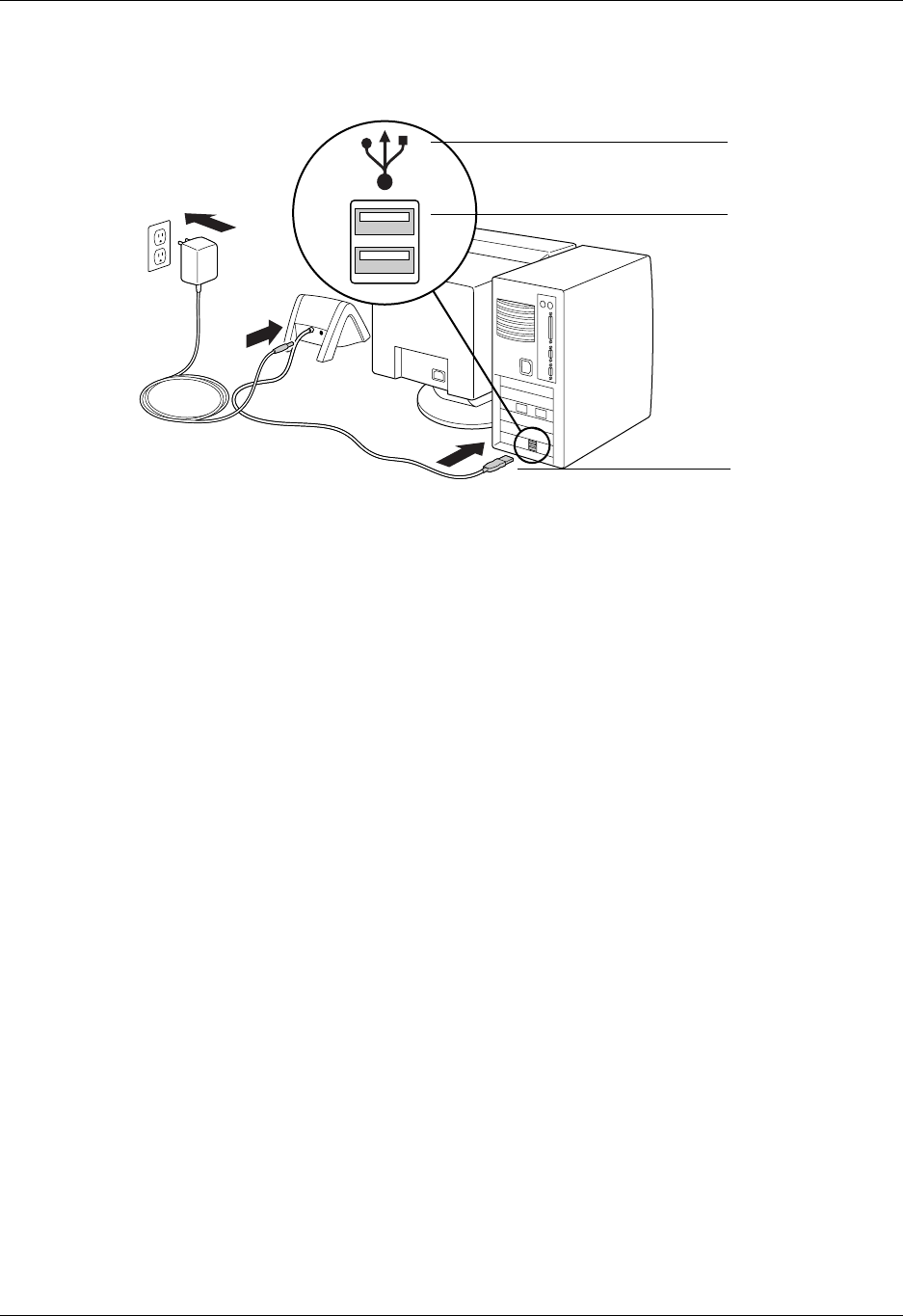
Chapter 1 Setting Up Your Palm™ Tungsten™ T Handheld
6
Windows 95 and NT users cannot use a USB cradle/cable and port. You must use
a cradle with a serial port connection (sold separately).
Step 2: Charge your handheld
a. Place your handheld in the cradle/cable for two hours for an initial charge.
Your handheld’s indicator light glows steady green when it is charging.
b. After is it is charged, remove the handheld from the cradle/cable by gently
tilting it forward and then lifting it from the cradle/cable.
Once your handheld is setup and in daily use it requires about 15 minutes of
charge time for each hour of use. To keep the battery fully charged, we recommend
placing your handheld in a cradle/cable that is connected to a power source
whenever you are not using it.
Step 3: Set up your handheld
a. Press the power button to turn on your handheld.
If your handheld did not turn on, see “Operating problems” in Appendix B.
b. Gently press the top of the stylus to release it from the slot, and then remove it
from the slot.
USB port
USB connector
USB icon
Palm, Inc. Confidential
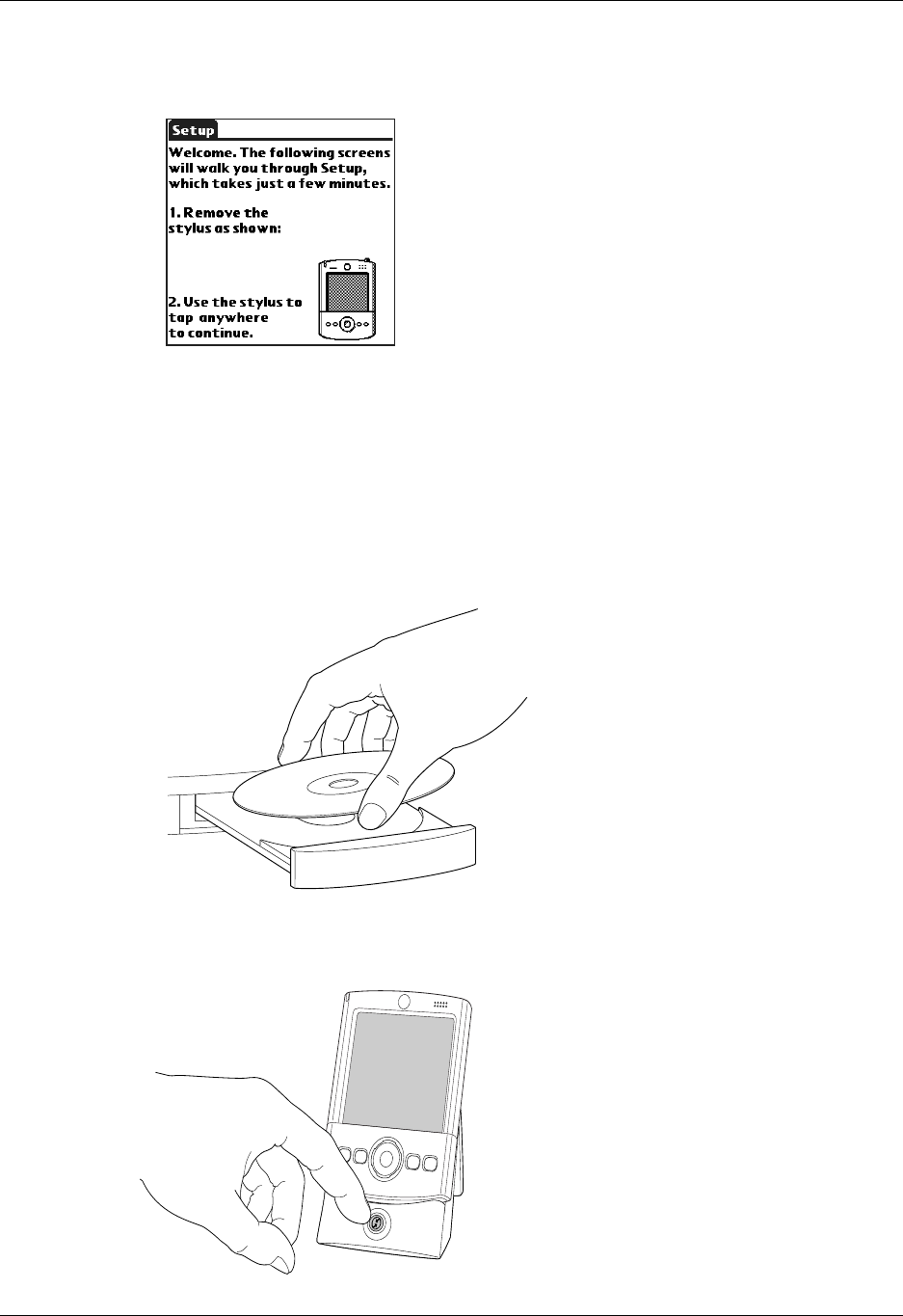
Step 4: Install software
7
c. Hold the stylus like you would a pen or pencil, and use it to follow the onscreen
directions.
Step 4: Install software
a. Insert the Desktop Software CD-ROM into your computer’s CD-ROM drive.
b. Windows: Follow the onscreen instructions which guide you through installing
Palm Desktop software and entering your handheld business card information.
Mac: Double-click the Desktop Software CD-ROM icon that appears on the
desktop, and then double-click the Palm Desktop Installer icon.
Step 5: Perform a HotSync operation
Windows: When prompted, place your
handheld in the cradle/cable and press the
HotSync button.
Mac: After the installation finishes, place
your handheld in the cradle/cable and
press the HotSync button.
Palm, Inc. Confidential

Chapter 1 Setting Up Your Palm™ Tungsten™ T Handheld
8
Step 6: Register your handheld
Windows: When the first HotSync operation is complete, the installer displays
screens where you can select product registration options. After you complete
these screens, the Congratulations! screen appears.
Congratulations!
You’ve set up your handheld, installed Palm Desktop software, and performed
your first HotSync operation. If you’re using a Windows computer, you also
installed the Palm Desktop software Quick Tour, created your handheld business
card, and registered your handheld. For comprehensive information about using
your handheld, continue reading this electronic handbook.
For more information about using Palm Desktop software, see the following:
■The online help for Palm Desktop software. To access the online help, go to the
Help menu in Palm Desktop software.
■Windows: The Palm Desktop software Quick Tour. To access the Palm Desktop
software Quick Tour, go to the Help menu in Palm Desktop software
■Mac: The electronic Palm Desktop Software for the Macintosh User’s Guide. To
access this guide, open the Palm folder, and then open the Documentation
folder. Double-click the file Palm Desktop.pdf.
Palm, Inc. Confidential

9
CHAPTER 2
Exploring Your Handheld
Your Palm™ Tungsten™ T handheld can help you stay organized, on time, and
up-to-date with daily tasks while you are away from your desk. Use your new
handheld to do the following:
■Enter your schedule in Date Book.
■Keep all your contact names, addresses, and phone numbers in Address Book.
■Prioritize and assign your tasks a due date in To Do List.
■Jot quick notes directly on the screen in Note Pad.
■Record thoughts and listen to them later in Voice Memo.
■Track your expenses and create expense reports in Expense.
■Set alarms from World Clock, Date Book, Note Pad, and Voice Memo to keep
yourself on schedule and remind yourself of appointments and notes.
■Set preferences for how you receive alarms: hearing a sound, seeing a blinking
indicator light, or feeling your handheld vibrate. Choose any combination.
■Synchronize your data with Palm™ Desktop software on your Windows or
Mac computer so you always have a backup copy.
■Insert an SD or MultiMediaCard expansion card to add more software or
memory, or to back up your data.
■Connect your handheld with a mobile phone to access the Internet and
exchange e-mail messages.
■Share information with other devices that are Bluetooth-enabled or that have an
infrared (IR) port.
When you install the software from the Software Essentials CD-ROM that comes
with your handheld, your handheld can also help you stay in touch, play games,
and access mobile office productivity tools. This additional software enables you
to use your handheld to do the following:
■Play games with Bluetooth-enabled devices.
■Compose, send, and receive e-mail and SMS messages when you connect your
handheld with a mobile phone (sold separately).
■Browse or search the Internet when you connect your handheld with a mobile
phone (sold separately).
Palm, Inc. Confidential
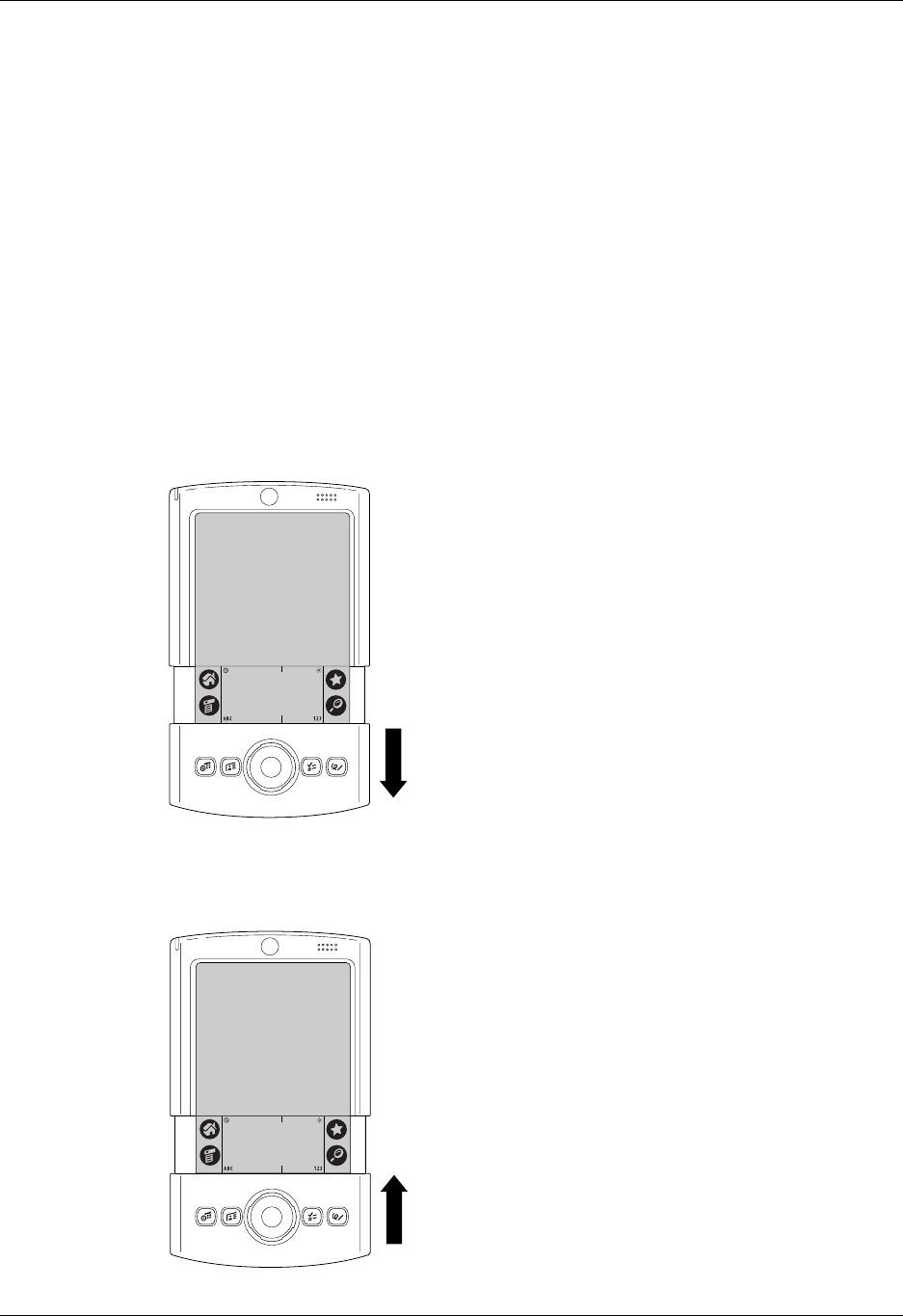
Chapter 2 Exploring Your Handheld
10
■View photographs and other images.
■Read books or other documents.
Locating handheld components
Take a few moments to learn how to access and locate the components of your
handheld.
Opening and closing your handheld
When your handheld is open, you can access additional controls on the front and
back panels. You can use your handheld in either the open or closed position.
To open your handheld:
■Slide the bottom portion of your handheld away from the screen.
To close your handheld:
■Slide the bottom portion of your handheld toward the screen.
Palm, Inc. Confidential
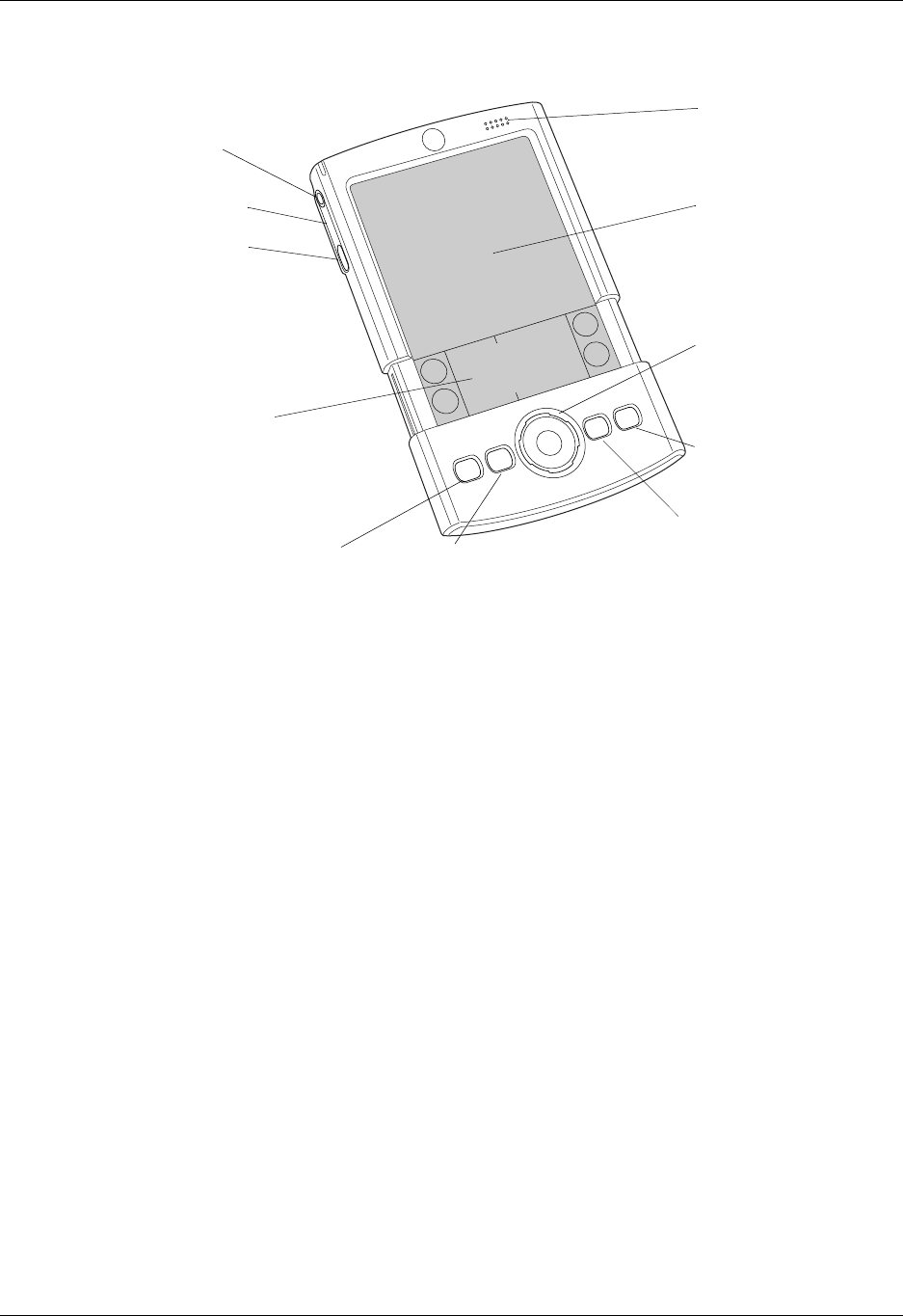
Locating handheld components
11
Locating front panel controls
Headphone jack Enables you to connect a standard 3.5mm stereo headset
(sold separately) to your handheld for use with audio
applications.
Speaker Enables you to listen to alarms, voice memos, and game
sounds on your handheld.
Microphone Serves as an audio input device for applications such as
Vo i c e M e m o .
Screen Displays the applications and information stored in your
handheld. It is touch sensitive, and it responds to the stylus.
Graffiti writing area The area where you write letters and numbers using the
Graffiti alphabet. See “Using Graffiti writing to enter data”
in Chapter 3 to learn how to write Graffiti characters.
Navigator Enables you to select and display records on your handheld
screen. See “Using the navigator” later in this chapter for
additional information, and look for tips throughout this
handbook.
Application buttons Activates the individual handheld applications that
correspond to the icons on the buttons: Date Book, Address
Book, To Do List, Note Pad, and Voice Memo. See “Buttons
Preferences” in Chapter 17 for details on reassigning these
buttons to activate any application on your handheld.
Screen
Graffiti® writing
area
Application buttons
Navigator
Headphone
jack
Date
Book Address
Book
To D o L i s t
Note Pad
Voice Memo
application button
Speaker
Microphone
Palm, Inc. Confidential
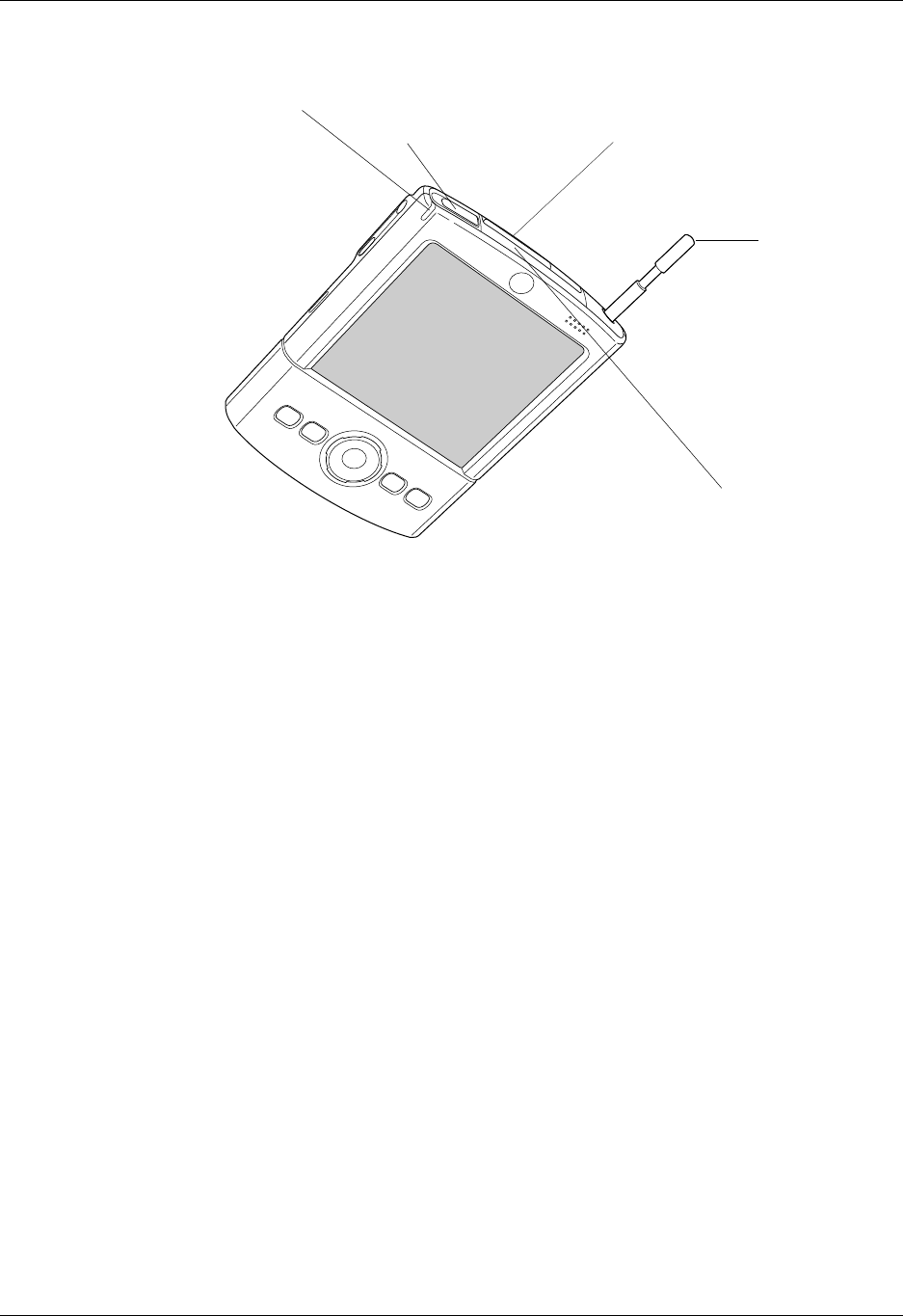
Chapter 2 Exploring Your Handheld
12
Locating top panel components
Indicator light Serves as an alert for Date Book, World Clock, Note Pad, or
Voice Memo alarms. It also indicates the battery-charging
status when your handheld is in the cradle/cable.
Power button/
backlight control Turns your handheld on or off and controls the backlight
feature. If your handheld is turned off, pressing the power
button turns the handheld on and returns you to the last
screen you viewed.
If your handheld is turned on, you can turn it off by pressing
the power button. Pressing and holding the power button for
about two seconds turns the backlight on or off.
Expansion card slot Accepts SD or MultiMediaCard expansion cards, enabling
you to back up data, add more memory, or use additional
applications.
Stylus Slides in and out of the slot on the top of your handheld. To
use the stylus, gently press the top of the stylus to release it
from the slot, and then pull it out of the slot and hold it as
you would a pen or pencil.
IR port Uses infrared technology to transmit data to and receive data
from other infrared-enabled devices and to perform
HotSync® operations. See “Beaming data” in Chapter 3 and
see “Conducting IR HotSync operations” in Chapter 16 for
more information.
Stylus
Expansion
card slot
Power button/
backlight control
IR port
Indicator light
Palm, Inc. Confidential
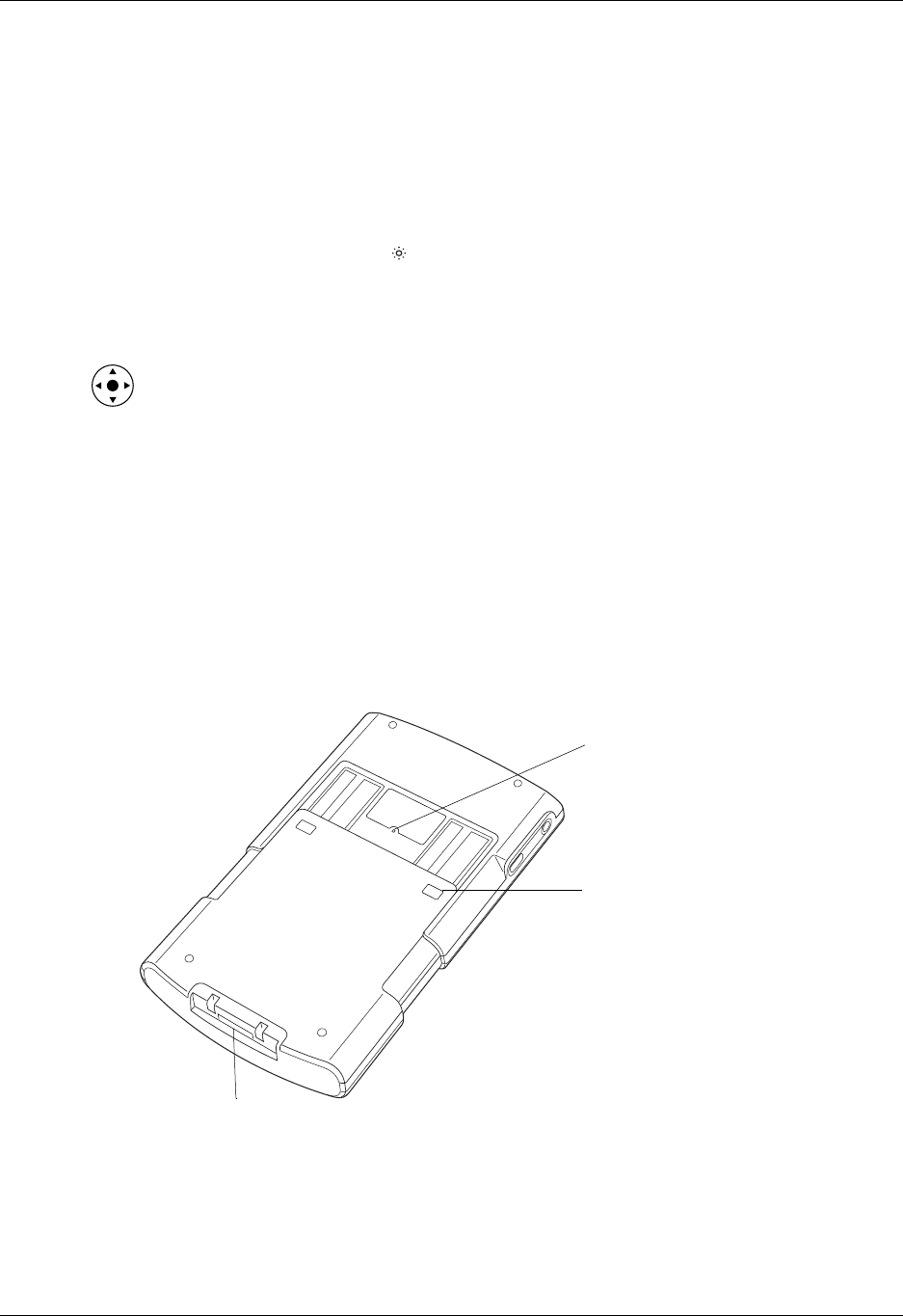
Locating handheld components
13
Using the backlight
If lighting conditions make it difficult for you to see the information on your
handheld, you can adjust the brightness of the screen backlight or turn it off. The
backlight remains on until you turn it off. Turning the backlight off conserves
battery power.
To adjust the brightness of the backlight:
1. Tap the Brightness icon in the upper-right corner of the Graffiti writing area.
2. Tap the Enable Backlight check box to select it.
3. Drag the slider to adjust the brightness.
TIP You can also press Up or Down on the navigator to adjust the brightness.
4. Tap Don e.
To turn the backlight on and off:
■Press and hold the power button for about two seconds or until the backlight
turns off or on.
TIP In addition, you can assign the full-screen pen stroke to activate the
backlight. See “Pen preferences” in Chapter 17 for details.
Locating back panel components
Universal
connector
Reset
button
Attach
points
Palm, Inc. Confidential
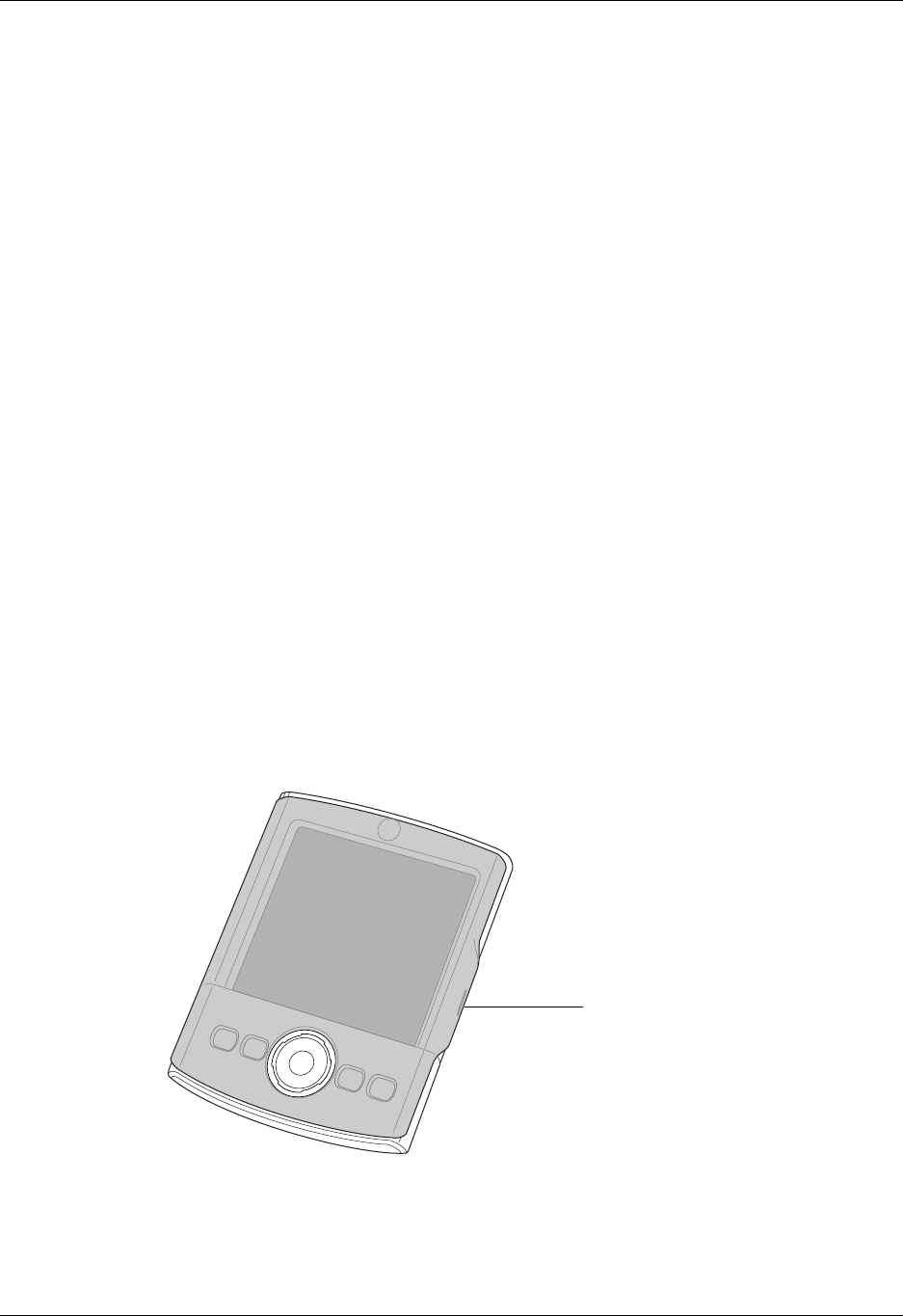
Chapter 2 Exploring Your Handheld
14
Using the protective cover
The cover protects your handheld screen when it is not in use. When the cover is
on, you can still view information on your handheld and use the navigator to
navigate through your data and accomplish tasks.
To remove the cover:
1. Gently lift one of the cover tabs from the side of your handheld.
Reset button Resets your handheld. Under normal use, you should not
have to use the reset button. See “Resetting your handheld”
in Appendix A for information about when and how to use
the reset button.
Attach points Enable you to connect optional accessories to your
handheld, such as a modem or sled. These accessories are
sold separately and are typically available from third-party
developers.
Universal connector Connects your handheld to the cradle/cable, which in turn
connects to the back of your computer and through the AC
adapter to the wall current. This enables you to recharge
your handheld as well as update the information between
your handheld and your computer, using HotSync
technology.
The universal connector also connects peripheral hardware
devices to your handheld.
Cover tab
Palm, Inc. Confidential
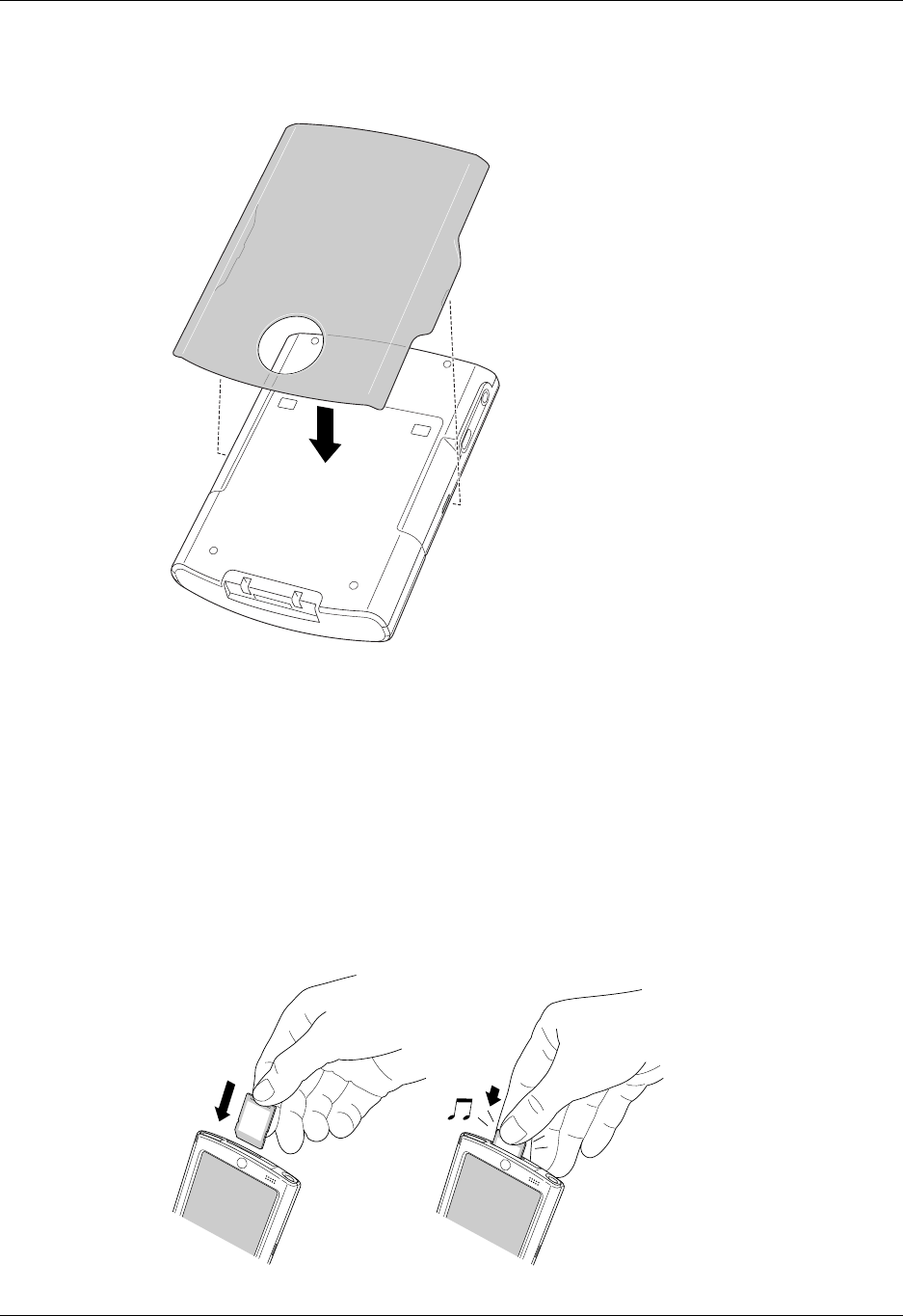
Adding an expansion card
15
2. Store the cover by aligning the cover tabs with the notches on the sides of your
handheld, and then gently pressing it onto the back of your handheld.
Adding an expansion card
An expansion card (sold separately) increases the variety of tasks you can do and
the amount of space you have to store software and data on your handheld.
To insert a card:
1. Insert the card into the expansion slot with the label side facing the display.
2. Push the card in with your thumb. You feel the card lock and hear the system
sound.
Push
Palm, Inc. Confidential

Chapter 2 Exploring Your Handheld
16
To remove a c a r d :
1. Push lightly against the card with your thumb.
When the card is released, you hear the system sound.
2. Slide the card out of the expansion slot.
For complete information about working with expansion cards, see Chapter 7.
Tapping and typing
Like using a mouse to click elements on a computer screen, using the stylus to tap
elements on your handheld screen is the basic action you use to get things done on
your handheld.
The first time you start your handheld, the setup instructions appear on the screen.
These instructions include a calibration screen. Calibration aligns the internal
circuitry of your handheld with its touch-sensitive screen so that when you tap an
element on the screen, the handheld can detect exactly which task you want to
perform.
IMPORTANT Always use the point of the stylus for tapping or for making strokes on
the handheld screen. Never use an actual pen, pencil, or other sharp object to write
on the handheld screen as this will scratch the screen.
With your handheld turned on, you can tap the handheld screen to perform many
operations, such as the following:
■Open applications.
■Select menu commands.
■Initiate a Find operation to search through applications installed on your
handheld for specific text (Find operations do not search through applications
on expansion cards).
Push
Palm, Inc. Confidential
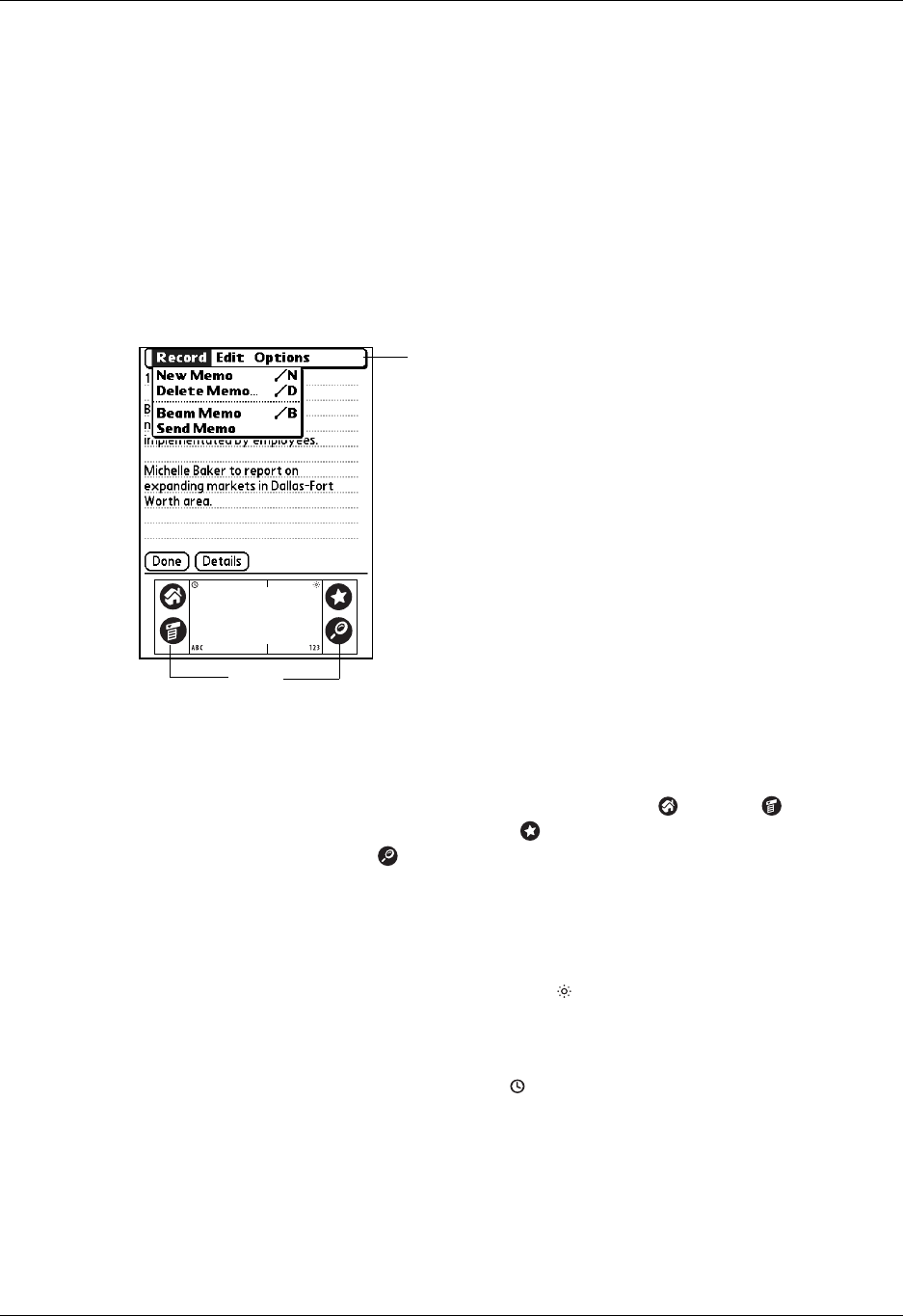
Tapping and typing
17
■Select options in dialog boxes.
■Open the onscreen keyboards.
Just as you can drag the mouse to select text or move objects on your computer,
you can drag the stylus to select text. You can also use the stylus to drag the slider
of any scroll bar.
Elements of the handheld interface
There are many common elements in the handheld interface. These elements are
described in this section.
Menu bar Use the menu bar to access a set of application-specific
commands. Not all applications have a menu bar.
Icons Tap the icons to open applications , menus , and a
favorite application , and to find text anywhere in your
data .
See “Opening applications,” “Using menus,” and “Finding
information” in Chapter 4, and “Buttons Preferences” in
Chapter 17 for more information about using these icons.
Brightness control Tap the Brightness icon to open the Adjust Brightness
dialog box. See “Using the backlight” earlier in this chapter
for instructions on adjusting the brightness.
Clock Tap the Clock icon to display the current time and date.
The display closes automatically after two seconds.
ABC With the cursor in an input field, tap ABC to activate the
alphabetic keyboard.
123 With the cursor in an input field, tap 123 to activate the
numeric keyboard.
Menu
bar
Icons
Palm, Inc. Confidential
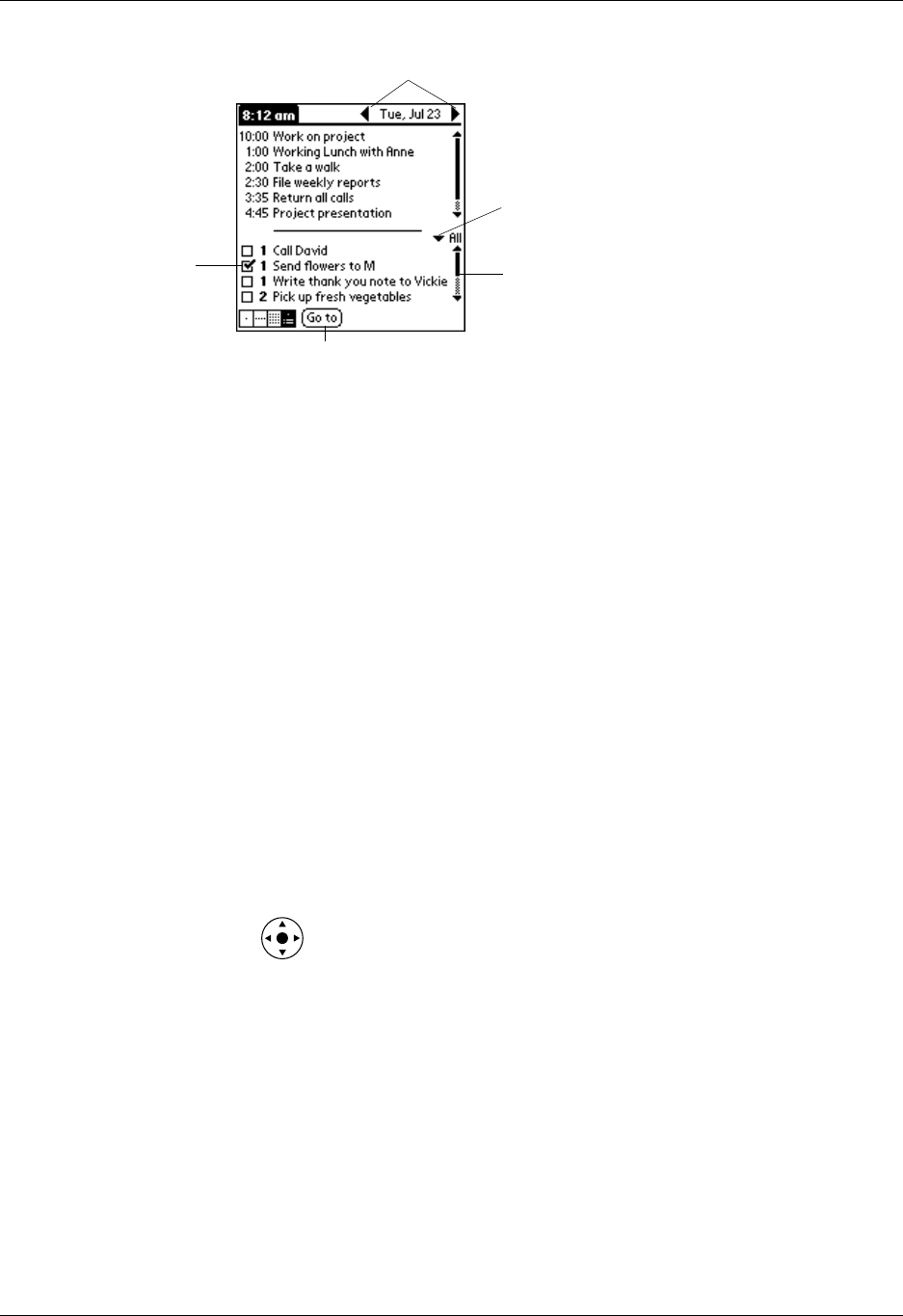
Chapter 2 Exploring Your Handheld
18
Displaying online tips
Many of the dialog boxes that appear on your handheld contain an online Tips icon
in the upper-right corner. Online tips anticipate questions you might have in a
dialog box, provide shortcuts for using the dialog box, or give you other useful
information.
Check box Tap a check box to select or deselect it. When a check box
contains a check mark, the corresponding option is selected
and active. When a check box is empty, the corresponding
option is deselected and inactive.
Command buttons Tap a button to perform a command. Command buttons
appear at the bottom of dialog boxes and application
screens.
Next/previous arrows Tap the left and right arrows to display the previous and
next records; tap the up and down arrows to display the
previous and next pages of information.
Pick list Tap the arrow to display a list of choices, and then tap an
item in the list to select it.
Scroll bar Drag the slider, or tap the top or bottom arrow, to scroll the
display one line at a time. To scroll to the previous page, tap
the scroll bar just above the slider. To scroll to the next page,
tap the scroll bar just below the slider.
You can also scroll to the previous and next pages within a
record by pressing Up and Down on the navigator.
Scroll
bar
Previous/next arrows
Check
box
Command button
Pick list
Palm, Inc. Confidential
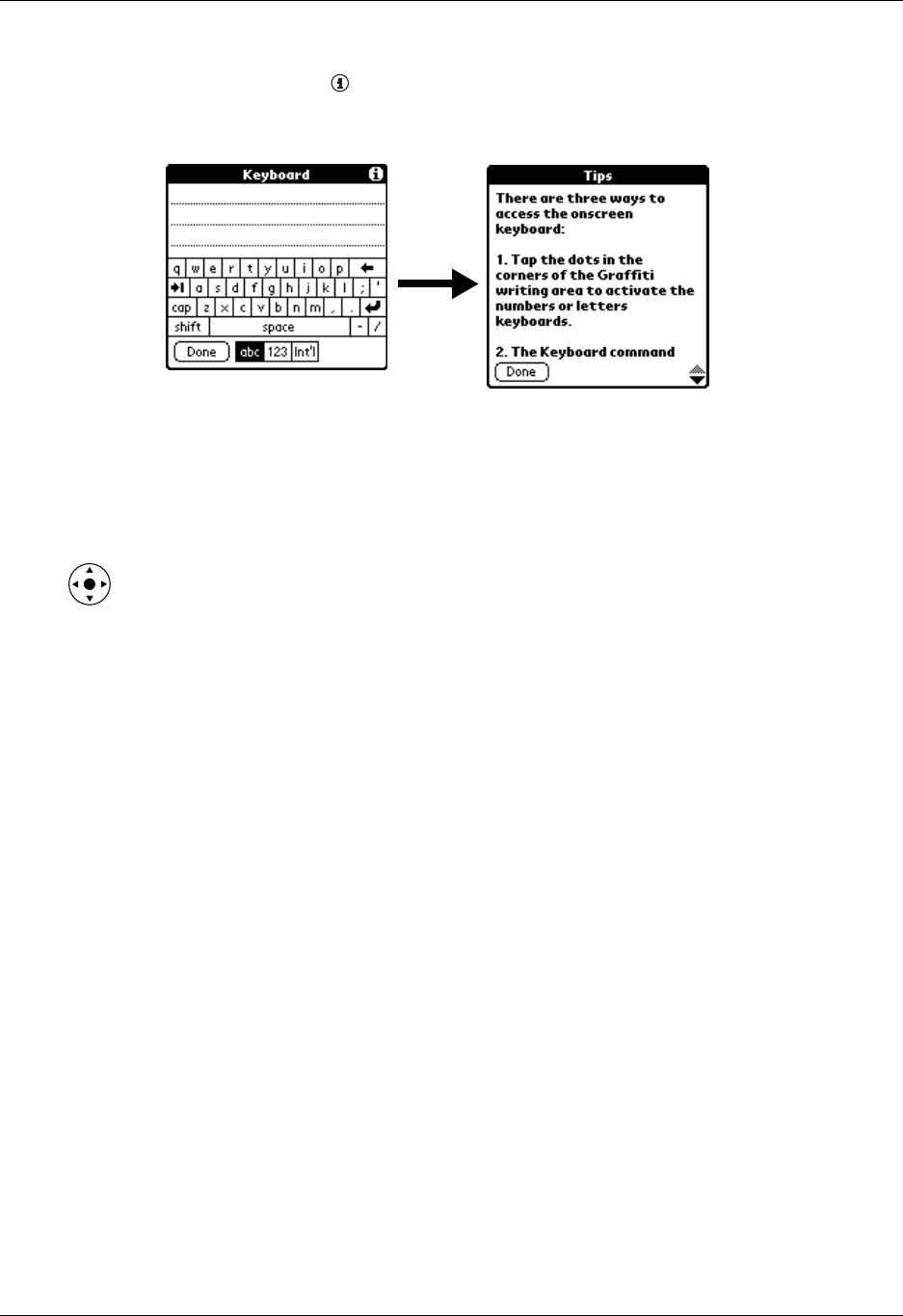
Tapping and typing
19
To display an online tip:
1. Tap the Tips icon .
2. After you review the tip, tap Done.
Using the navigator
When you work with most applications, the navigator on the front panel of your
handheld makes it easy for you to navigate among and select your entries. You can
use the navigator to perform tasks without the stylus using one hand.
Look for the navigator icon to find navigator tips throughout this guide. See
Chapter 4 and Chapter 5 for additional information about using the navigator with
Address Book, and Chapter 8 for additional information on using the navigator
with Date Book.
To navigate in list screens, do any of the following:
■Press Up or Down on the navigator to scroll an entire screen of records.
■Press and hold Up or Down on the navigator to accelerate the scrolling.
■Press Select on the navigator to insert the selection highlight. When the selection
highlight is present, you can do the following:
– Press Up or Down on the navigator to scroll to the previous or next records.
– Press Select again to view the selected record.
– Press Left on the navigator to remove the selection highlight.
To navigate in record screens:
1. Press Up or Down on the navigator to scroll within the current record.
2. Press Right or Left on the navigator to scroll to the previous or next record. (This
feature is not available in Address Book.)
3. Press Select on the navigator to return to the list screen.
Palm, Inc. Confidential

Chapter 2 Exploring Your Handheld
20
To navigate in dialog boxes:
■While a pick list is open, press Up or Down on the navigator to highlight an
item, and then press Select on the navigator to select the item.
■Press Select on the navigator to close a dialog. If there’s only one button,
pressing Select activates that button. If there’s multiple buttons, Select activates
affirming buttons such as OK, Yes, or Done.
IMPORTANT Read dialog boxes carefully. Sometimes, selecting a single button, OK
or Yes results in canceling an operation or deleting data.
Palm, Inc. Confidential

21
CHAPTER 3
Entering Data on Your Handheld
This chapter explains several ways to enter data on your handheld, and it covers
the following topics:
■Using the onscreen keyboard
■Using Graffiti® handwriting recognition
■Beaming data from a device that has an infrared (IR) port
■Sending data from another Bluetooth-enabled device
■Entering or importing data in Palm™ Desktop software and then synchronizing
with your handheld
■Using Note Pad
■Using Voice Memo
■Using a portable keyboard accessory, sold separately and attached to the
universal connector
Using the onscreen keyboard
You can open the onscreen keyboard anytime you need to enter text or numbers
on your handheld. You can also use Graffiti writing when the keyboard is open,
which makes it easy to switch between these two methods of entering data.
To use the onscreen keyboard:
1. Open any application (such as Memo Pad).
2. Tap any record, or tap New.
3. Tap ABC to open the alphabetic keyboard, or tap 123 to open the numeric
keyboard.
Tap here for
alphabetic keyboard
Tap here for
numeric keyboard
Palm, Inc. Confidential
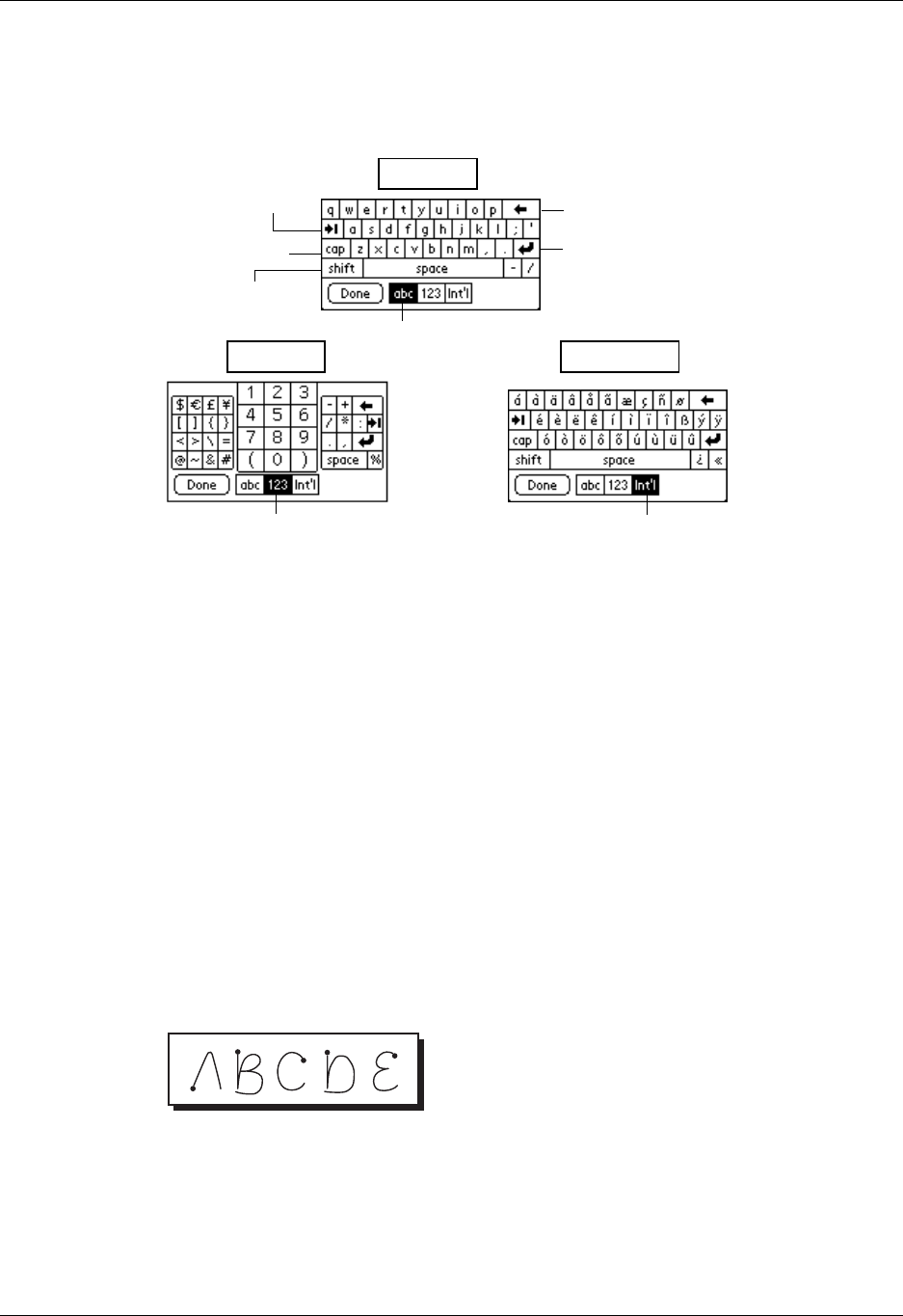
Chapter 3 Entering Data on Your Handheld
22
4. Tap the characters to enter text and numbers.
When a keyboard is open, you can tap the abc, 123, or Int’l boxes to open any of
the other keyboards, including the international keyboard.
After you finish, tap Done to close the onscreen keyboard and place the text in
the record.
Using Graffiti writing to enter data
In this section you learn the procedures for creating letters, numbers, punctuation,
and symbols, as well as some Graffiti tips and tricks.
Most people find they can enter text quickly and accurately with only minutes of
practice. Graffiti writing includes any character you can type on a standard
keyboard. The Graffiti characters closely resemble the uppercase letters of the
regular alphabet, which makes Graffiti writing easy to learn.
There are four basic concepts for success with Graffiti writing:
■If you draw the character shape exactly as shown in the tables later in this
chapter (like the shapes shown in the following diagram), you can achieve close
to 100 percent accuracy.
■The heavy dot on each shape shows where to begin the stroke. Certain
characters have similar shapes but different beginning and end points. Always
begin the stroke at the heavy dot. (You should not create the heavy dot; it is
there only to show you where to begin the stroke.)
Backspace
Carriage return
Ta b
Caps lock
Caps shift
Tap here to display
alphabetic keyboard
Tap here to display
numeric keyboard
Tap here to display
international keyboard
Alpha
Numeric International
Palm, Inc. Confidential

Using Graffiti writing to enter data
23
■Most characters require only a single stroke. When you lift the stylus from the
Graffiti writing area, your handheld recognizes and displays the text character
immediately. Some single Graffiti strokes are portions of the regular alphabet
equivalents.
■The Graffiti writing area is divided into two parts: one for writing the letters of
the alphabet and one for writing numbers. The small marks at the top and
bottom of the Graffiti writing area indicate the two areas.
To write Graffiti characters:
1. Tap the screen where you want your text to appear.
You need to tap above the Graffiti writing area, and you must see a blinking
cursor before you write the text.
2. Use the tables on the following pages to find the stroke shape for the letter you
want to create. For example, the stroke shown below creates the letter n.
Two stroke shapes are available for some letters. Choose the one that’s easiest
for you.
As you’ll see later in this chapter, you use the same shape to create both the
uppercase and lowercase version of a letter.
3. Position the stylus in the left side of the Graffiti writing area.
4. Start your stroke at the heavy dot, and draw the stroke shape as it appears in
the tables.
5. Lift the stylus from the screen at the end of the stroke shape.
When you lift the stylus from the screen, your handheld recognizes your stroke
immediately and prints the letter at the insertion point on the screen.
As soon as you lift the stylus from the screen, you can begin the stroke for the next
character you want to write.
NOTE You must begin the character strokes in the Graffiti writing area. Otherwise
your handheld does not recognize them as text characters.
W
r
i
te
l
etters
h
ere
W
r
i
te num
b
ers
h
ere
Division marks
Start stroke
at heavy dot
Lif
t sty
l
us
here
Palm, Inc. Confidential
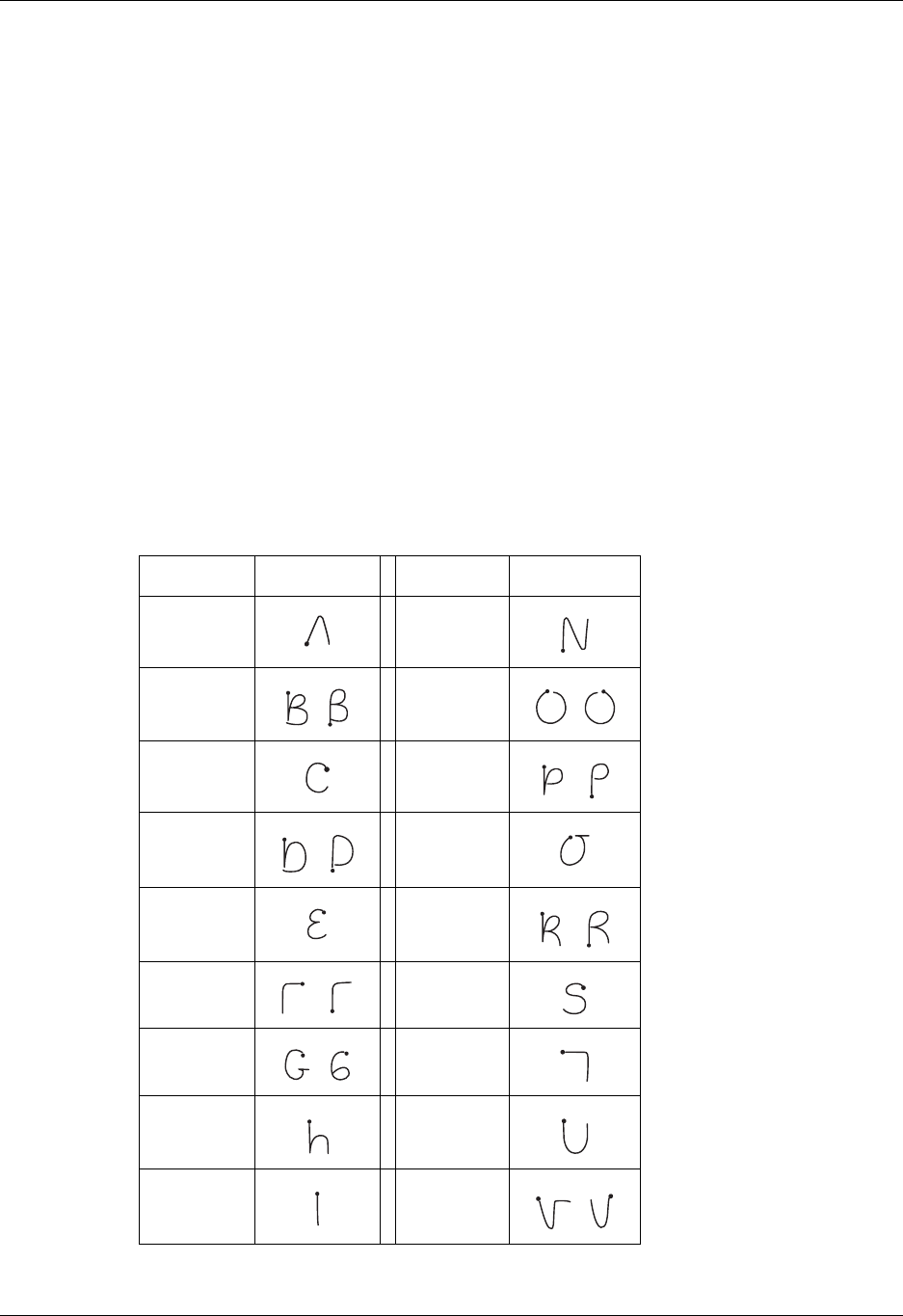
Chapter 3 Entering Data on Your Handheld
24
To delete Graffiti characters:
■Set the insertion point to the right of the character you want to delete and make
the backspace stroke (a line from right to left) in the Graffiti writing area.
Graffiti tips
When using Graffiti writing, keep these tips in mind:
■Accuracy improves when you write large characters. Draw strokes that nearly
fill the Graffiti writing area.
■Write at natural speed. Writing too slowly can generate recognition errors.
■Do not write on a slant. Vertical strokes should be parallel to the sides of the
Graffiti writing area.
■Press firmly.
Graffiti alphabet
The Graffiti alphabet consists of the following letters:
Letter Strokes Letter Strokes
AN
B O
CP
D Q
ER
F S
G T
HU
IV
or
or
or
or
or
or
or
or
Palm, Inc. Confidential
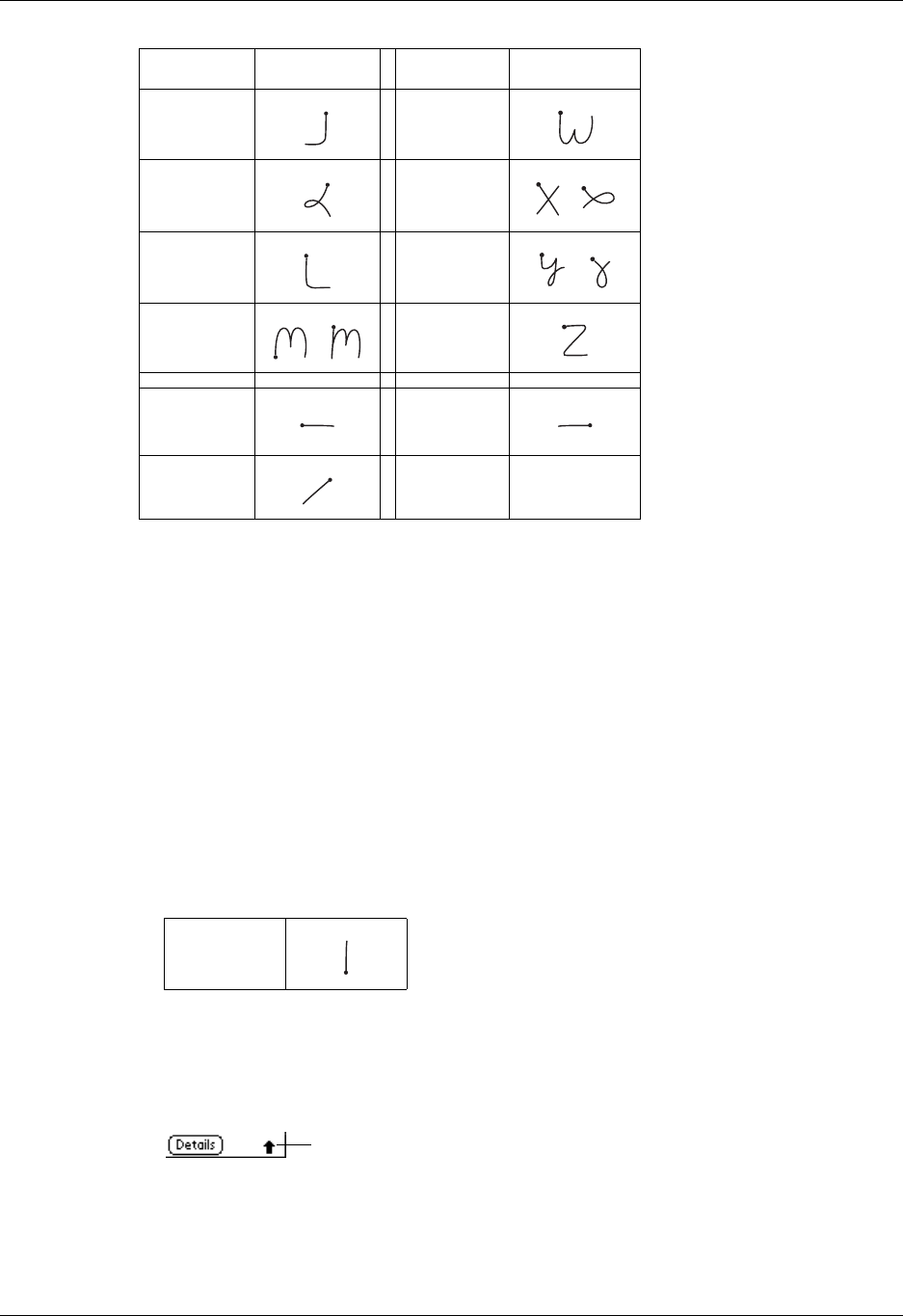
Using Graffiti writing to enter data
25
TIP A full-screen pen stroke brings up Graffiti help on your handheld. See “Pen
preferences” in Chapter 17 for details.
Capital letters
You make capital letters with the same stroke shapes as the basic alphabet
characters. You must first “shift” to caps—just as you press the Shift key on a
keyboard—and then write the character strokes.
Graffiti writing includes a feature that automatically capitalizes the first letter
when you create a new sentence or a new record (by tapping New or a blank line).
To draw the first letter of a word as a capital letter:
■Enter the Caps Shift stroke:
TIP When Caps Shift is active, an up arrow symbol appears in the lower-right
corner of the handheld screen. If you accidentally activate Caps Shift,
backspace will cancel it.
Letter Strokes Letter Strokes
JW
KX
LY
M Z
Space Backspace
Carriage
return
Period Ta p t w i c e
or
or
or
Caps
Shift
Caps Shift
Palm, Inc. Confidential
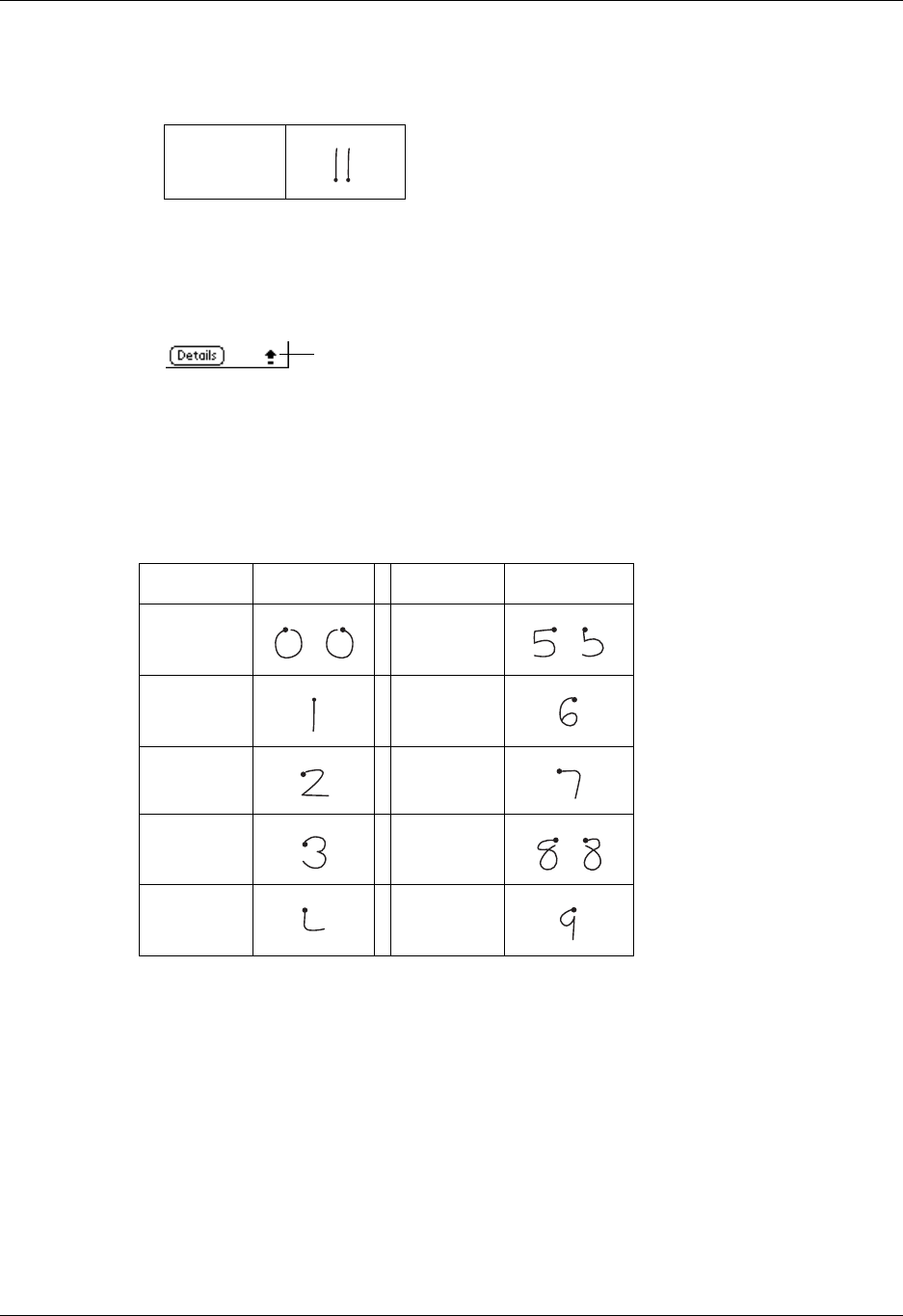
Chapter 3 Entering Data on Your Handheld
26
To enter only capital letters (Caps Lock):
■Enter the Caps Lock stroke:
TIP When Caps Lock is active, an underlined up arrow symbol appears in the
lower-right corner of the handheld screen. To return to lowercase, make the
Caps Shift stroke.
Graffiti numbers
Writing numbers with Graffiti writing is similar to writing letters of the alphabet,
except that you make the character strokes on the right side (numbers side) of the
Graffiti writing area.
Caps
Lock
Caps Lock
Number Strokes Number Strokes
0 5
1 6
27
38
4 9
or
or
or
Palm, Inc. Confidential
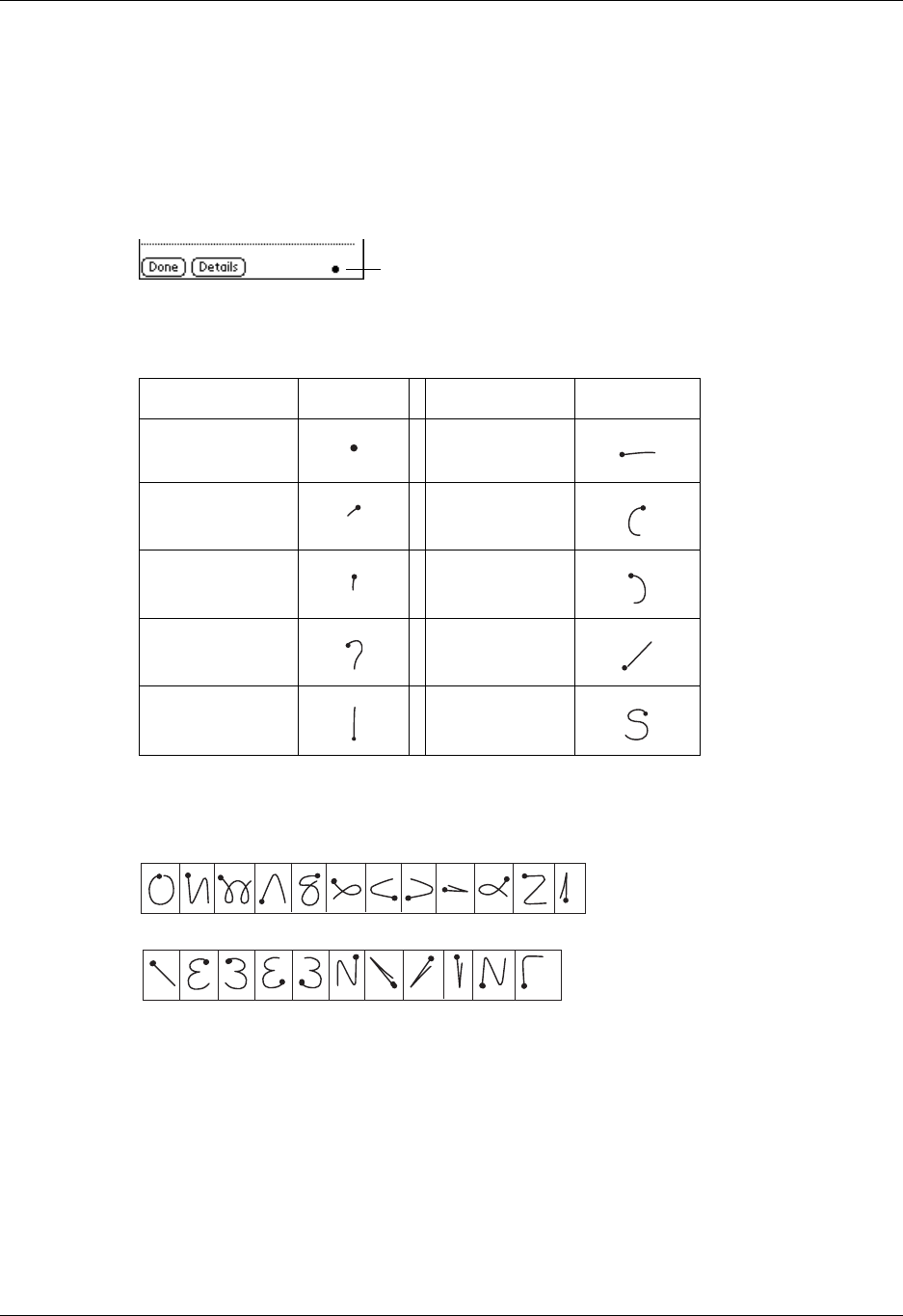
Using Graffiti writing to enter data
27
Punctuation marks
Graffiti writing can create any punctuation symbol that you can enter from a
standard keyboard. All punctuation marks begin with a single tap on the Graffiti
writing area. With this tap, you activate Punctuation Shift, and a dot appears to
show that it is active. The next stroke you make with the stylus creates a
punctuation mark.
When Punctuation Shift is active, you can make a symbol stroke anywhere in the
Graffiti writing area (the letters or numbers side).
You can also use the following additional Graffiti punctuation marks.
Symbol Stroke Symbol Stroke
Period
.
Dash
—
Comma
,
Left Paren
(
Apostrophe
'
Right Paren
)
Question
?
Slash
/
Exclamation
!
Dollar
$
Punctuation shift
@ # % ^ & * < > + = |
—
\ { } [ ] ~ ` ; : " tab
Palm, Inc. Confidential
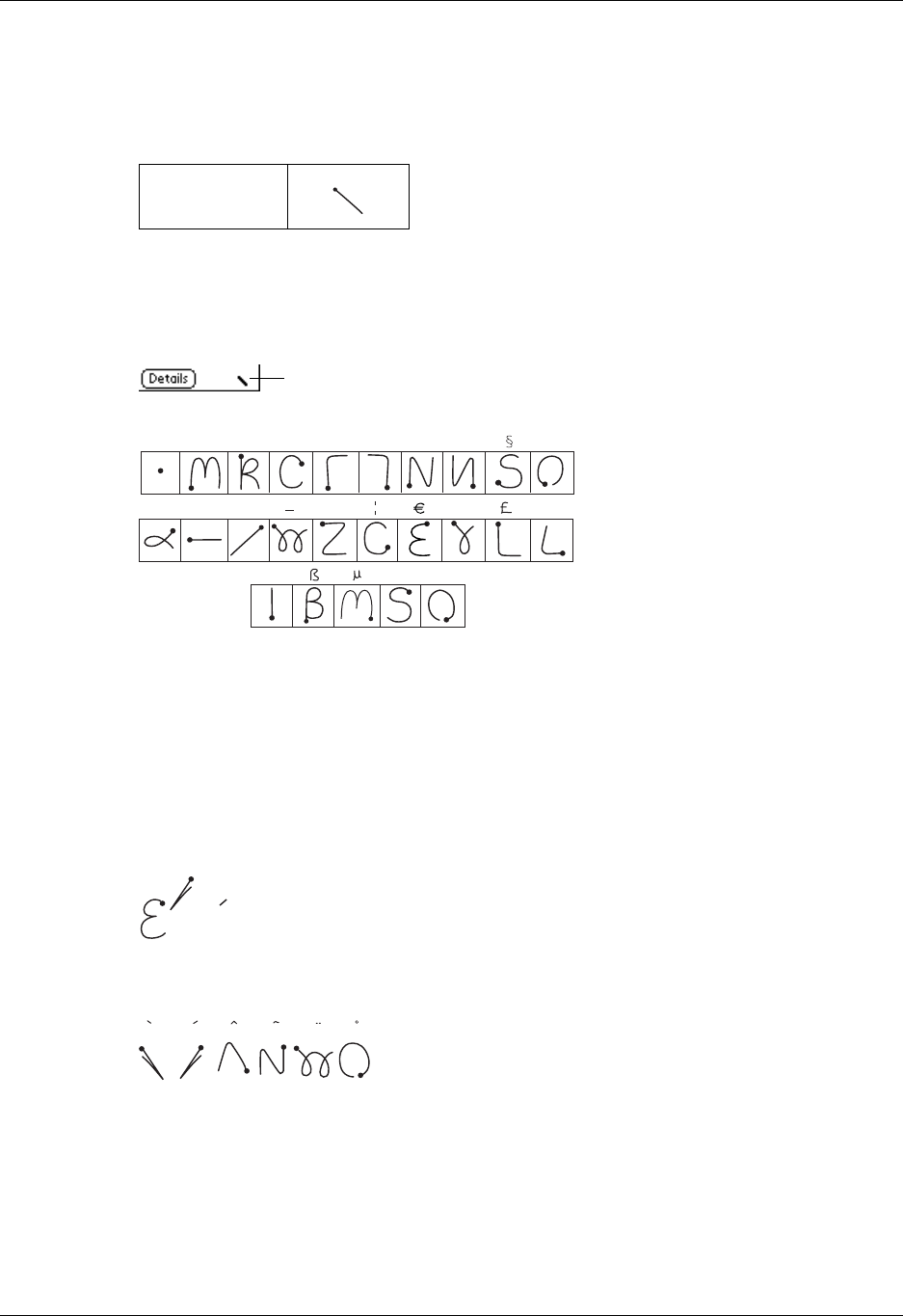
Chapter 3 Entering Data on Your Handheld
28
Symbol characters
All symbol characters begin with the symbol shift stroke in the Graffiti writing area
of your handheld.
When the Symbol Shift is active, a slanted shift symbol appears in the lower-right
corner of the screen. The next stroke that you make creates the symbol or extended
character.
Accented characters
To create accented characters, draw the stroke that is normally used to create the
letter, followed by an accent stroke. Graffiti writing then adds the accent to the
letter.
For example, the following diagram shows the strokes required to draw an
accented e.
You can use the following accent strokes in combination with Graffiti letters:
Using these accent strokes, you can write the following accented letters:
à á â ã ä å è é ê ë ì í î ï ò ó ô õ ö ù ú û ü ÿ ý ñ
Symbol
Shift
Symbol Shift
•
,
,
,
,
,°
,
+—X:==
cY
?
!
ƒ∅
= e
a a a a a a
Palm, Inc. Confidential
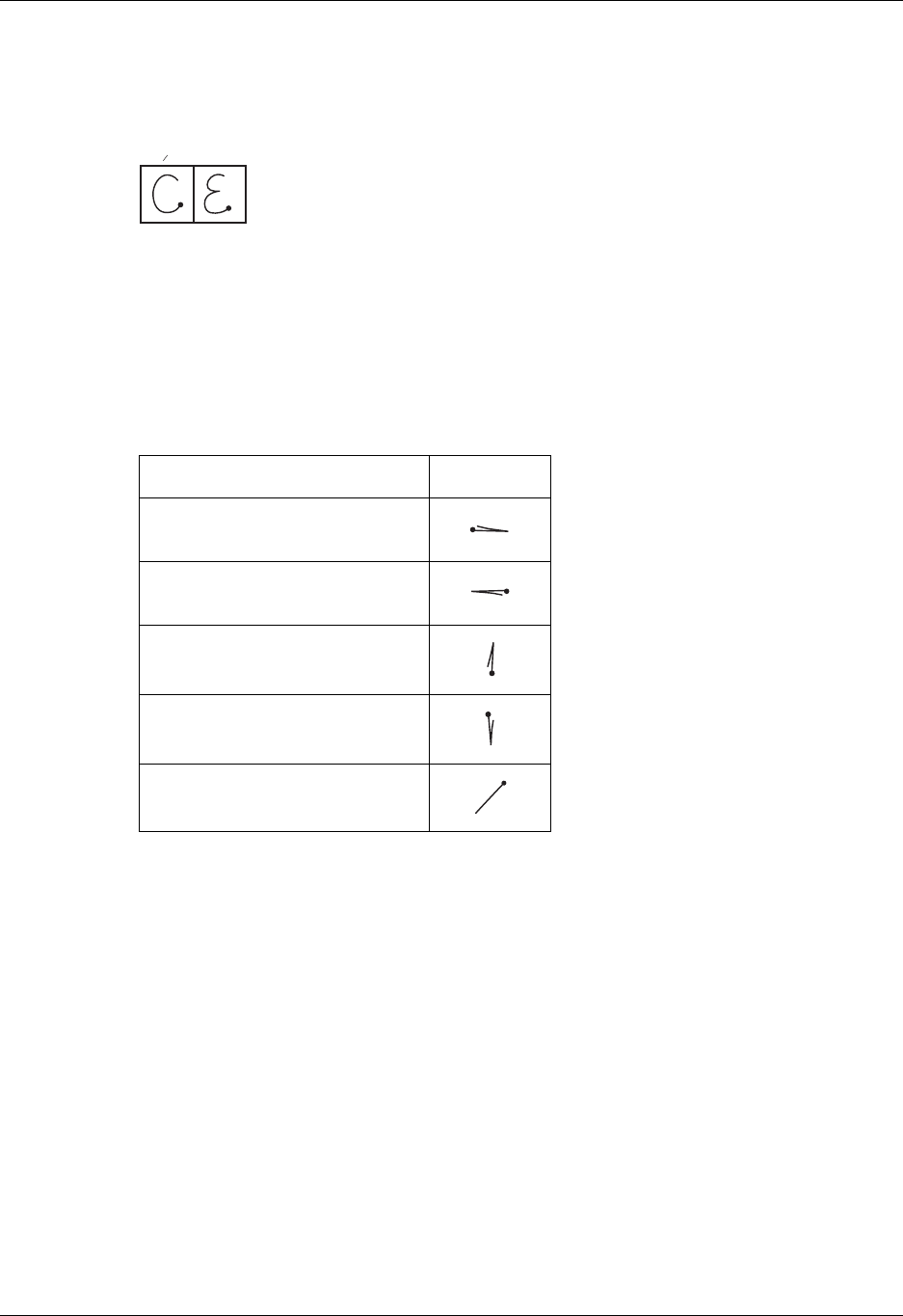
Using Graffiti writing to enter data
29
Additional non-English characters
You can write the following characters without any special punctuation or shifting:
You must write these non-English characters in the left side of the Graffiti writing
area.
Navigation strokes
In addition to character symbols, Graffiti writing includes special strokes that you
can use to navigate within text or fields in your applications.
Graffiti ShortCuts
Graffiti ShortCuts make entering commonly used words or phrases quick and
easy. ShortCuts are similar to the Glossary or Autotext features of some word
processors.
Graffiti writing comes with several predefined ShortCuts, and you can also create
your own. Each ShortCut can represent up to 45 characters. For example, you
might create a ShortCut for your name or for the header of a memo. See “ShortCuts
Preferences” in Chapter 17 to learn about creating your own ShortCuts.
cae
Command Stroke
Move cursor right
Move cursor left
Previous field
(Address Book only)
Next Field
(Address Book only)
Open Address Record
(Address Book only)
Palm, Inc. Confidential

Chapter 3 Entering Data on Your Handheld
30
To use a ShortCut, draw the ShortCut stroke followed by the ShortCut characters.
The ShortCut symbol appears at the insertion point to show that you are in
ShortCut mode.
Your handheld includes the predefined Graffiti ShortCuts shown in the following
table.
Beaming data
Your handheld is equipped with an IR port that is located at the top of the
handheld, behind the small dark shield. The IR port supports the IrCOMM
implementation of the standards for infrared communication established by the
Infrared Data Association (IrDA). This means that you can beam data to any
nearby device that supports the IrCOMM implementation of the IrDA standards
and that can read the type of data you’re beaming. For example, you can beam an
Address Book entry to a Palm OS® handheld, a mobile phone, or a computer that’s
equipped with an IR port and that can read vCard data.
You can beam the following information between devices with an IR port:
■The record currently displayed in Date Book, Address Book, To Do List, Note
Pad, Voice Memo, or Memo Pad
■All records of the category currently displayed in Address Book, To Do List,
Note Pad, Voice Memo, or Memo Pad
■A special Address Book record that you designate as your business card,
containing information you want to exchange with business contacts
ShortCut
Entry Shortcut
Date Stamp ds
Time stamp ts
Date / time stamp ds
Meeting me
Breakfast br
Lunch lu
Dinner di
Palm, Inc. Confidential

Beaming data
31
■An application installed in RAM memory
■An application installed on an expansion card that is seated in the card slot
TIP You can also perform HotSync® operations using the IR port.
See “Conducting IR HotSync operations” in Chapter 16 for more details.
To select a business card:
1. Create an Address Book record that contains the information you want on your
business card.
2. Tap the Menu icon .
3. Tap Record, and then tap Select Business Card.
4. Tap Yes.
To beam a record, business card, or category of records:
1. Locate the record, business card, or category you want to beam.
2. Tap the Menu icon .
3. Tap one of the following from the Record menu:
– The Beam command for an individual record.
– In Address Book only: Beam Business Card.
– In Note Pad only: If you are beaming to someone using an earlier version of
Note Pad, tap Compatibility, and then tap Beam.
– Beam Category.
TIP You can also press and hold the Address Book application button to
instantly beam your business card to another device with an IR port.
4. When the Beam Status dialog box appears, point the IR port directly at the IR
port of the receiving device.
For best results, Palm handhelds should be between 10 centimeters
(approximately 4 inches) and 1 meter (approximately 39 inches) apart, and the
path between the two handhelds must be clear of obstacles. The beaming
distance to other devices may be different.
5. Wait for the Beam Status dialog box to indicate that the transfer is complete
before you continue working on your handheld.
Palm, Inc. Confidential
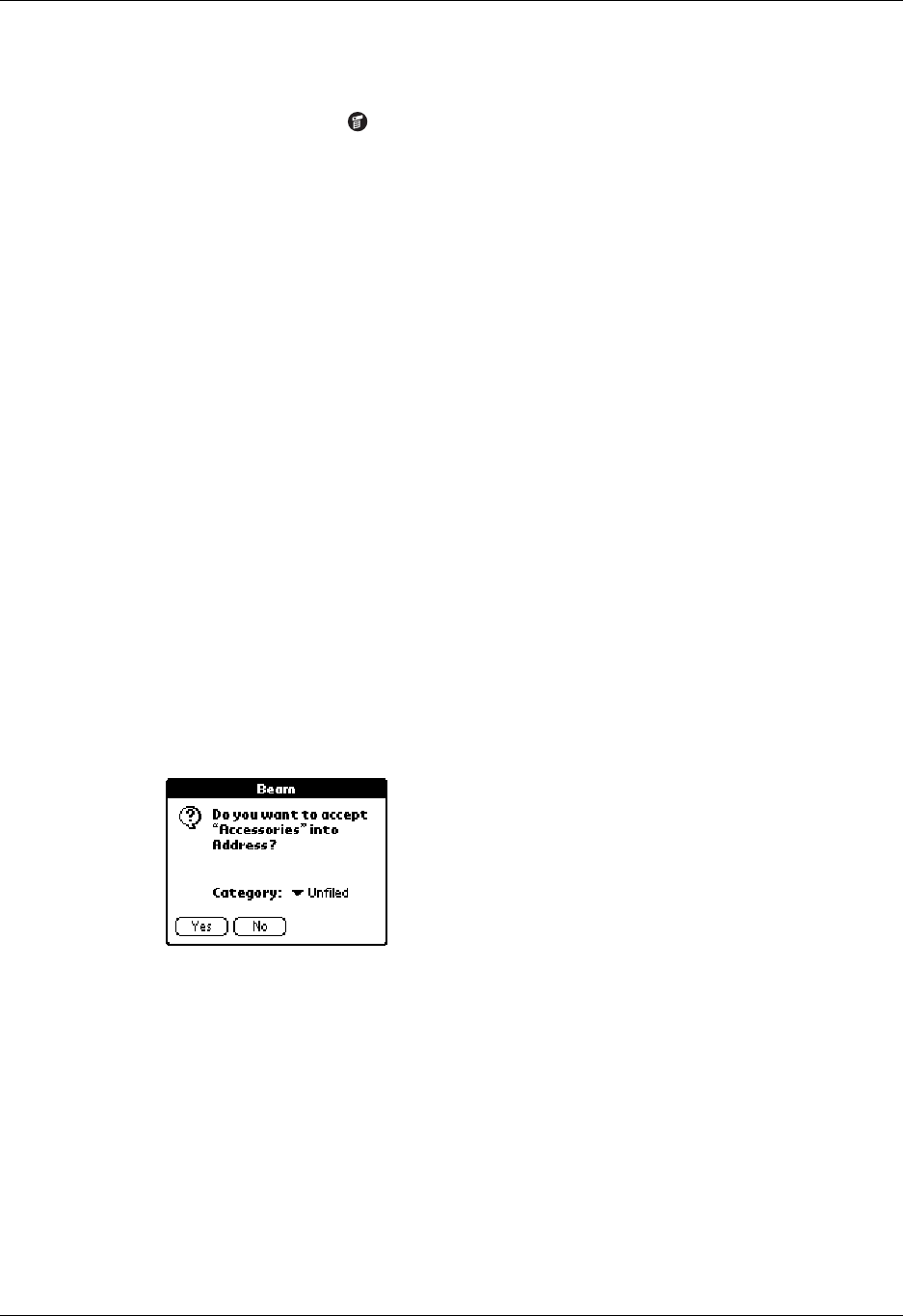
Chapter 3 Entering Data on Your Handheld
32
To beam an application:
1. Open the Applications Launcher.
2. Tap the Menu icon .
3. Tap App, and then tap Beam.
4. Tap the Beam From pick list.
5. Select either Handheld or Card.
6. Tap the application you want to transfer.
Some applications are copy-protected and cannot be beamed. These are listed
with a lock icon next to them.
7. Tap Beam.
8. When the Beam Status dialog box appears, point the IR port directly at the IR
port of the receiving device.
9. Wait for the Beam Status dialog box to indicate that the transfer is complete
before you continue working on your handheld.
To receive beamed information:
1. Turn on your handheld.
2. Point the IR port directly at the IR port of the transmitting device to open the
Beam dialog box.
3. (Optional.) Tap the category pick list and select a category for the incoming
information. You can also create a new category or leave the information
unfiled.
4. Tap Yes.
Beaming tips
■You can set the full-screen pen stroke to beam the current entry. See “Pen
preferences” in Chapter 17 for more information.
■You can draw the Graffiti Command stroke to activate the Command toolbar,
and then tap the beam icon.
■You can use the Graffiti Command stroke “/ B” to beam the current entry.
Palm, Inc. Confidential

Sending data
33
Sending data
In addition to beaming data, you can also use SMS or Bluetooth communication to
send information to and receive information from other devices. You can exchange
the following information with devices that support SMS or Bluetooth
communication:
■The record currently displayed in Date Book, Address Book, To Do List, Note
Pad, Voice Memo, or Memo Pad
■The category currently displayed in Address Book, To Do List, Note Pad, Voice
Memo, or Memo Pad
■An application installed in RAM memory
■An application installed on an expansion card that is seated in the card slot
TIP You can also perform HotSync operations using Bluetooth
communication. See “Conducting Bluetooth HotSync operations” in
Chapter 16 for more information.
When you send a record or a category of records, the receiving device must have
an appropriate application installed to read the data. When you send an
application, you cannot send applications that are locked and appear with a lock
icon next to them.
Sending data with Bluetooth communication
Your handheld is equipped with Bluetooth technology that you can use to share
information with other Bluetooth-enabled devices. To use your handheld for
Bluetooth communication, you must first turn on Bluetooth communication on the
Bluetooth Preferences screen. See “Bluetooth Preferences” in Chapter 17 for
details.
After you turn on Bluetooth communication, you can share data with Bluetooth-
enabled devices that have compatible versions of the appropriate Bluetooth-
enabled applications.
To send a record or category of records with Bluetooth communication:
1. Locate the record or category you want to send.
2. Tap the Menu icon .
3. Tap one of the following on the Record menu:
– The Send command for an individual record
– Send Category
Palm, Inc. Confidential

Chapter 3 Entering Data on Your Handheld
34
4. If the Send With dialog box appears, select Bluetooth, and then tap OK.
The Discovery Results screen appears and displays a list of Bluetooth-enabled
devices that are within range.
5. Select the device(s) to which you want to send the record or category, and then
tap OK.
If the device to which you want to send the data does not appear on the
Discovery Results list, tap Find More.
6. Wait for the Send Status dialog box to indicate that the transfer is complete
before you continue working on your handheld.
If the transfer does not complete properly, see “Beaming and sending problems”
in Appendix B for troubleshooting tips.
To send an application:
1. Open the Applications Launcher.
2. Tap the Menu icon .
3. Tap App, and then tap Send.
4. Select either Handheld or Card from the Send From pick list.
5. Tap the application you want to transfer.
Some applications are copy-protected and cannot be sent. These are listed with
a lock icon next to them.
6. Tap Send .
7. If the Send With dialog box appears, select Bluetooth, and then tap OK.
Palm, Inc. Confidential
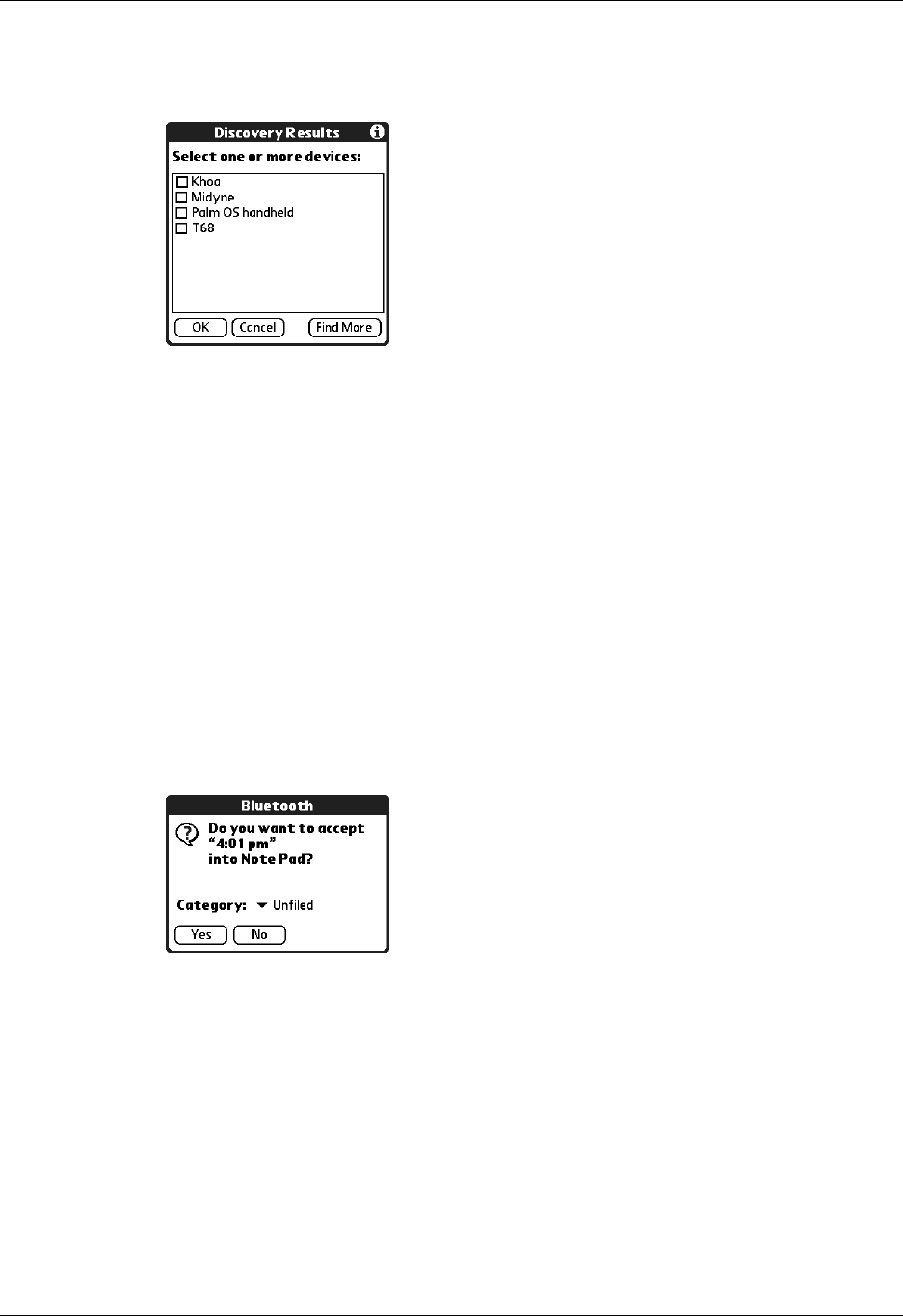
Sending data
35
The Discovery Results screen appears and displays a list of Bluetooth-enabled
devices that are within range.
8. Select the device(s) to which you want to send the application or category, and
then tap OK.
If the device to which you want to send the application does not appear on the
Discovery Results list, tap Find More.
9. Wait for the Send Status dialog box to indicate that the transfer is complete
before you continue working on your handheld.
To receive sent information:
1. Make sure your handheld is on, that Bluetooth communication is turned on,
and that your handheld is set to be Discoverable. See “Bluetooth Preferences”
in Chapter 17 for specific instructions.
2. (Optional.) Tap the category pick list and select a category for the incoming
information. You can also create a new category or leave the information
unfiled.
3. Tap Yes.
Sending data with SMS communication
The Software Essentials CD-ROM that comes with your handheld includes an SMS
application that you can use to share information with other SMS-enabled devices.
To use your handheld for SMS communication, you need a GSM mobile phone
(sold separately), you must install the SMS software from the Software Essentials
CD-ROM, and you need to use Phone Link to establish a connection with your
GSM mobile phone.
Palm, Inc. Confidential
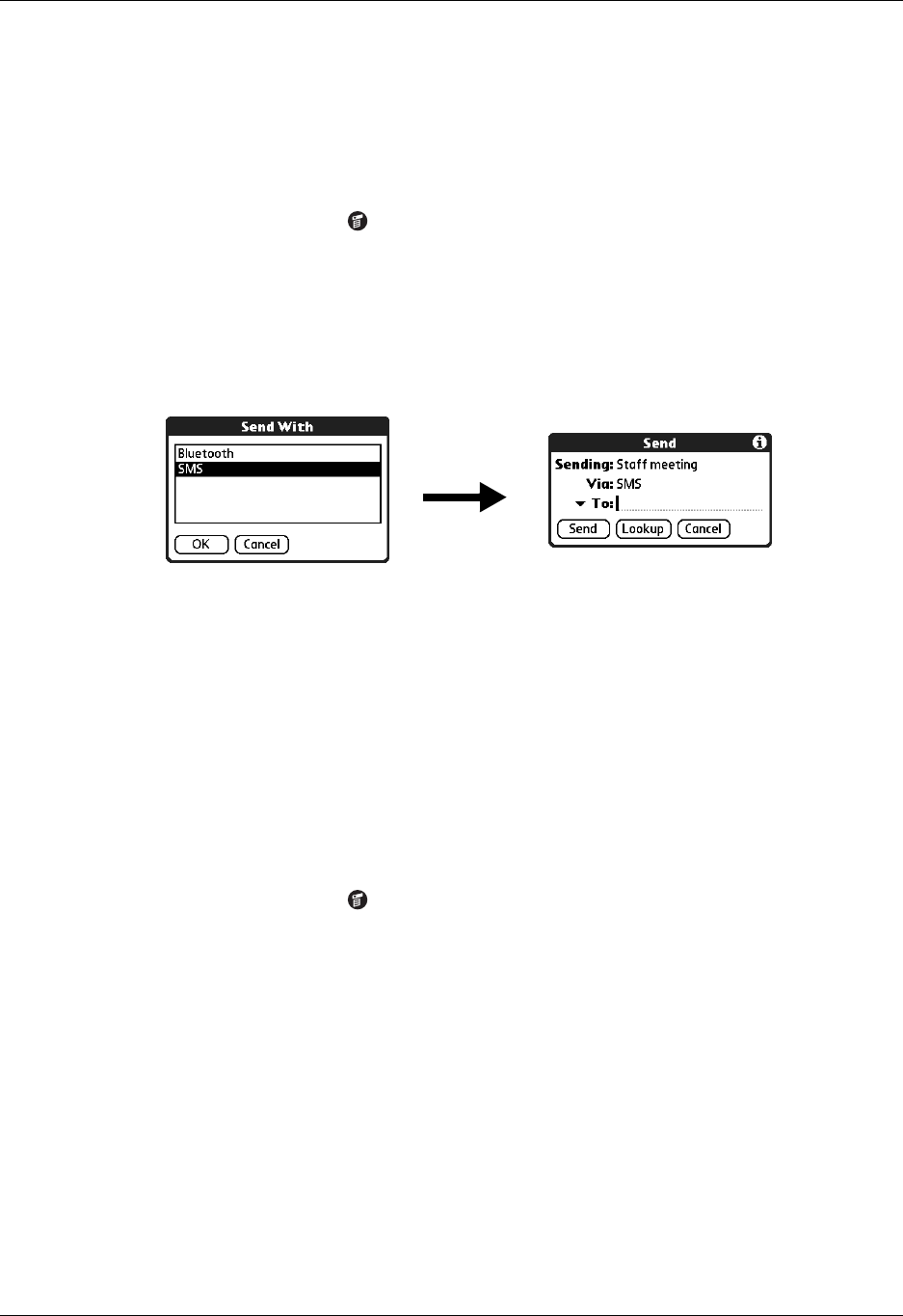
Chapter 3 Entering Data on Your Handheld
36
If the recipient receives the information on a Palm OS handheld, they can transfer
the information directly to the appropriate application. If the recipient receives the
information on another device, the data appears as text.
To send a record or category of records with SMS communication:
1. Locate the record or category you want to send.
2. Tap the Menu icon .
3. Tap one of the following on the Record menu:
– The Send command for an individual record
– Send Category
4. From the Send With dialog box, select SMS, and then tap OK.
5. Enter the recipient’s GSM mobile phone number.
TIP You can also tap To to select from a list of recent recipients, or tap Lookup
to select a number from your Address Book.
6. Tap Send .
7. Wait for the Send Status dialog box to indicate that the transfer is complete
before you continue working on your handheld.
To send an application:
1. Open the Applications Launcher.
2. Tap the Menu icon .
3. Tap App, and then tap Send.
4. Select either Handheld or Card from the Send From pick list.
5. Tap the application you want to transfer.
Some applications are copy-protected and cannot be sent. These are listed with
a lock icon next to them.
6. Tap Send .
7. From the Send With dialog box, select SMS, and then tap OK.
Palm, Inc. Confidential
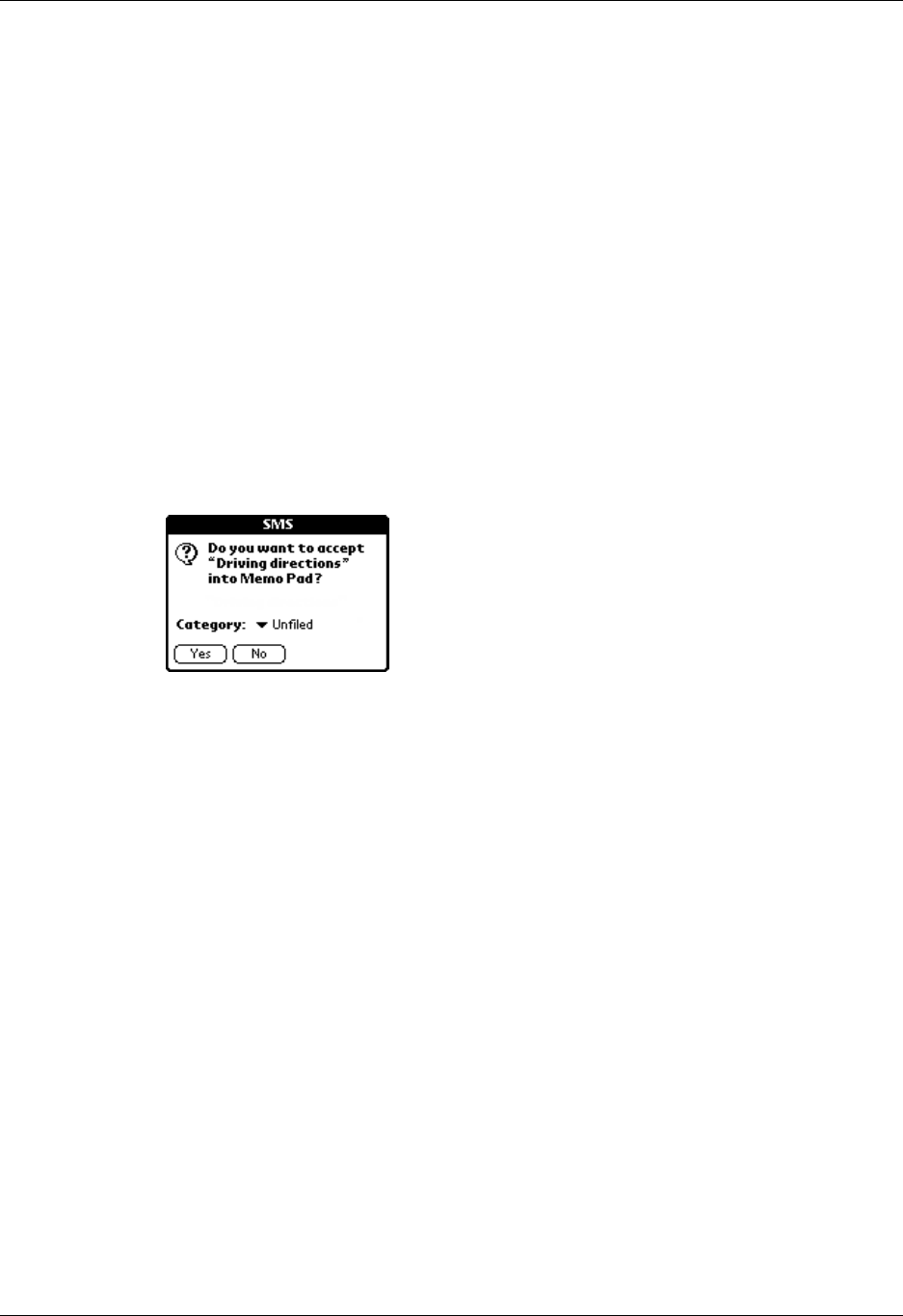
Using your computer keyboard
37
8. Enter the recipient’s GSM mobile phone number.
TIP You can also tap To to select from a list of recent recipients, or tap Lookup
to select a number from your Address Book.
9. Tap Send .
10. Wait for the Send Status dialog box to indicate that the transfer is complete
before you continue working on your handheld.
To receive sent information:
1. Connect your handheld to your GSM mobile phone.
The Send dialog appears when your handheld detects the incoming
information.
2. (Optional.) Tap the category pick list and select a category for the incoming
information. You can also create a new category or leave the information
unfiled.
3. Tap Yes.
Using your computer keyboard
If you have a lot of data to enter, or prefer to use the computer keyboard, you can
use Palm Desktop software or any supported personal information manager (PIM)
to enter information. You can then perform a HotSync operation to synchronize
the information on your computer with the information on your handheld. Many
of the applications that came with your handheld are also available in Palm
Desktop software and in most PIMs, so you don’t need to learn different
applications. For more information on entering data on your computer, refer to the
online Help in Palm Desktop software, the Palm Desktop software Quick Tour (for
Windows computers), and to the Palm Desktop Software for the Macintosh User’s
Guide on the Desktop Software CD-ROM.
Importing data
If you have data stored in computer applications such as spreadsheets and
databases, or if you want to import data from another handheld, you can transfer
the data to your handheld without having to type it. Save the data in one of the file
formats listed in the next section, import it into Palm Desktop software, and then
perform a HotSync operation to transfer the data to your handheld.
Palm, Inc. Confidential

Chapter 3 Entering Data on Your Handheld
38
Importing data from a Windows computer
Palm Desktop software can import data in the following file formats:
■Comma-delimited (.csv, .txt): Address Book and Memo Pad only
■Tab-delimited (.tab, .tsv, .txt): Address Book and Memo Pad only
■CSV (Lotus Organizer 2.x/97 Mapping): Address Book only
■vCal (.vcs): Date Book only
■vCard (.vcf): Address Book only
■Date Book archive (.dba)
■Address Book archive (.aba)
■To Do List archive (.tda)
■Memo Pad archive (.mpa)
Archive formats can be used only with Palm Desktop software. Use the archive file
formats to share information with other people who use a Palm OS handheld or to
create a copy of your important Palm Desktop information.
To import data from a Windows computer:
1. Open Palm Desktop software.
2. Click the application into which you want to import data.
3. If you are importing records that contain a field with category names, do the
following:
Select All in the Category box.
Be sure that the same categories that appear in the imported file also exist in the
application. If the categories do not exist, create them now; otherwise, the
records are imported into the Unfiled category.
4. From the File menu, select Import.
5. Select the file you want to import.
6. Click Open.
If you are importing a vCal or vCard file, skip to step 10. You do not have to
specify which fields correspond to the imported data.
7. To import data into the correct Palm Desktop fields, drag fields in the left
column so that they are opposite the corresponding imported field on the right.
8. If you don’t want to import a field, click the check box for that field to deselect it.
9. Click OK.
The imported data is highlighted in the application.
10. To add the imported data to your handheld, perform a HotSync operation.
Palm, Inc. Confidential

Importing data
39
See Palm Desktop online Help for more information on importing and exporting
data.
Using File Link
The File Link feature enables you to import Address Book and Memo Pad
information, such as a company phone list, to your handheld from a separate
external file on your Windows computer. You can configure the File Link feature
to check for changes to the external file when you perform a HotSync operation.
HotSync Manager stores the data in a separate category in Palm Desktop software
and on your handheld.
With File Link, you can import data stored in any of the following formats:
■Comma-separated (*.csv)
■Memo Pad archive (*.mpa)
■Address Book archive (*.aba)
■Text (*.txt)
For information on how to set up a file link, see the Palm Desktop online Help.
Importing data from a Mac computer
Palm Desktop software can import data from any of the following applications
when you export the data in the appropriate file format:
■Address Book Plus (text file)
■Claris Organizer (Palm Desktop software can open these files directly)
■ClarisWorks (save under new name as ASCII text file)
■DateBook Pro (text file)
■DayMaker (text file)
■Dynodex (text file)
■FileMaker Pro (tab-separated text file)
■Meeting Maker (text file)
■Newton running OS 1.0 with Newton Connection Kit:
Names, Date Book Calendar, and Notepad (text file)
■Now Contact (text file)
■Now Up-to-Date (text file)
■QuickDex (text file)
■TouchBase Pro (text file)
■vCal (.vcs)/vCard (.vcf) compatible PIMs
■Other applications that can export a tab-delimited file such as Microsoft Excel
Palm, Inc. Confidential

Chapter 3 Entering Data on Your Handheld
40
To import data from a Mac computer:
1. Open Palm Desktop software.
2. From the File menu, select Import.
3. Select the file you want to import.
4. Click Open.
5. If you want to change the order of the fields you’re importing, point to a field,
wait for the cursor to change to a double arrow, and then drag the field to a new
location.
6. If you do not want to import a field, click the arrow between the field names.
7. From the Fields pop-up menu, select the appropriate field.
8. From the Delimiters pop-up menu, select the appropriate delimiter.
9. Click OK.
10. To add the imported data to your handheld, perform a HotSync operation.
See Palm Desktop online Help for more information on importing and exporting
data.
Using Note Pad
In addition to using Graffiti characters and the onscreen keyboard, you can enter
data on your handheld using the Note Pad application. When you use Note Pad,
you write quick notes directly on the handheld screen in your own handwriting.
See Chapter 11 for more information and instructions.
Using Voice Memo
In addition to making visual entries, you can record voice entries on your
handheld using the Voice Memo application. When you use Voice Memo, you
speak into your handheld’s microphone and record quick notes in your own voice.
See Chapter 14 for more information and instructions.
Using a portable keyboard
You can connect a portable keyboard accessory to the universal connector on your
handheld so that you can type data directly into your handheld. Portable
keyboards are very helpful when you need to enter large amounts of data quickly
and accurately while you are away from your computer. For additional
information about this optional accessory, go to the web site www.palm.com.
Palm, Inc. Confidential
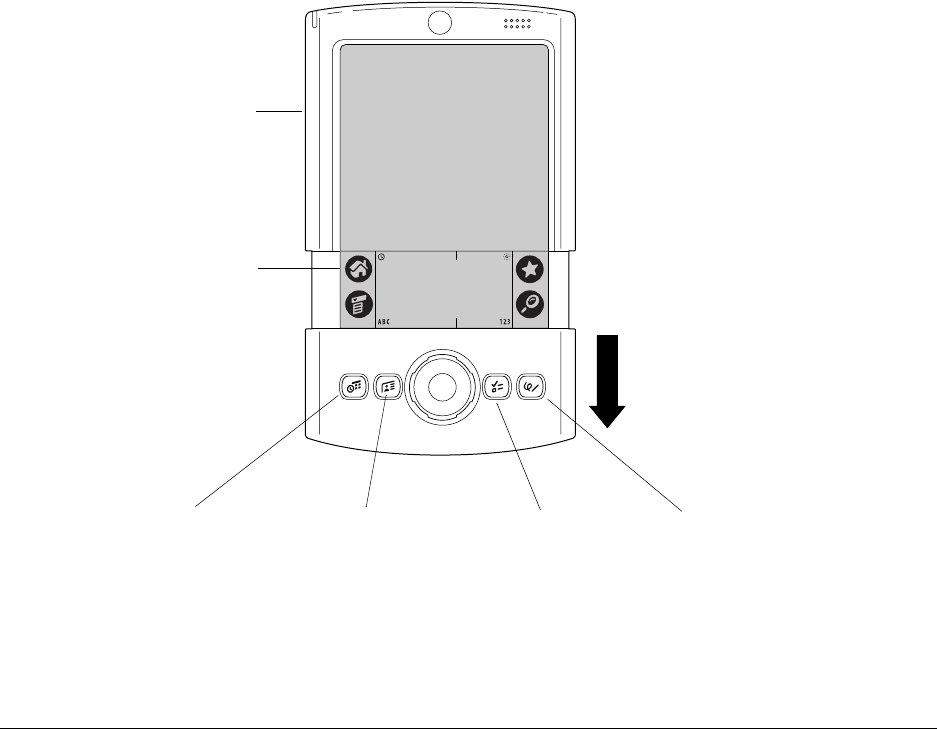
41
CHAPTER 4
Working with Applications
This chapter explains how to open and switch between applications on your
handheld, how to change application settings so they are personalized to your
work methods, and how to categorize applications so you view them in related
groups.
Opening applications
You can use the Applications Launcher to open any application installed on your
handheld or an expansion card. You can also open Date Book, Address Book, To
Do List, Note Pad, and Voice Memo with the application buttons on your
handheld.
In addition to providing a way for you to open applications, the Applications
Launcher displays the current time, battery level, and application category.
Applications
Launcher
Address BookDate Book Note PadTo D o L i s t
Voice Memo
Palm, Inc. Confidential
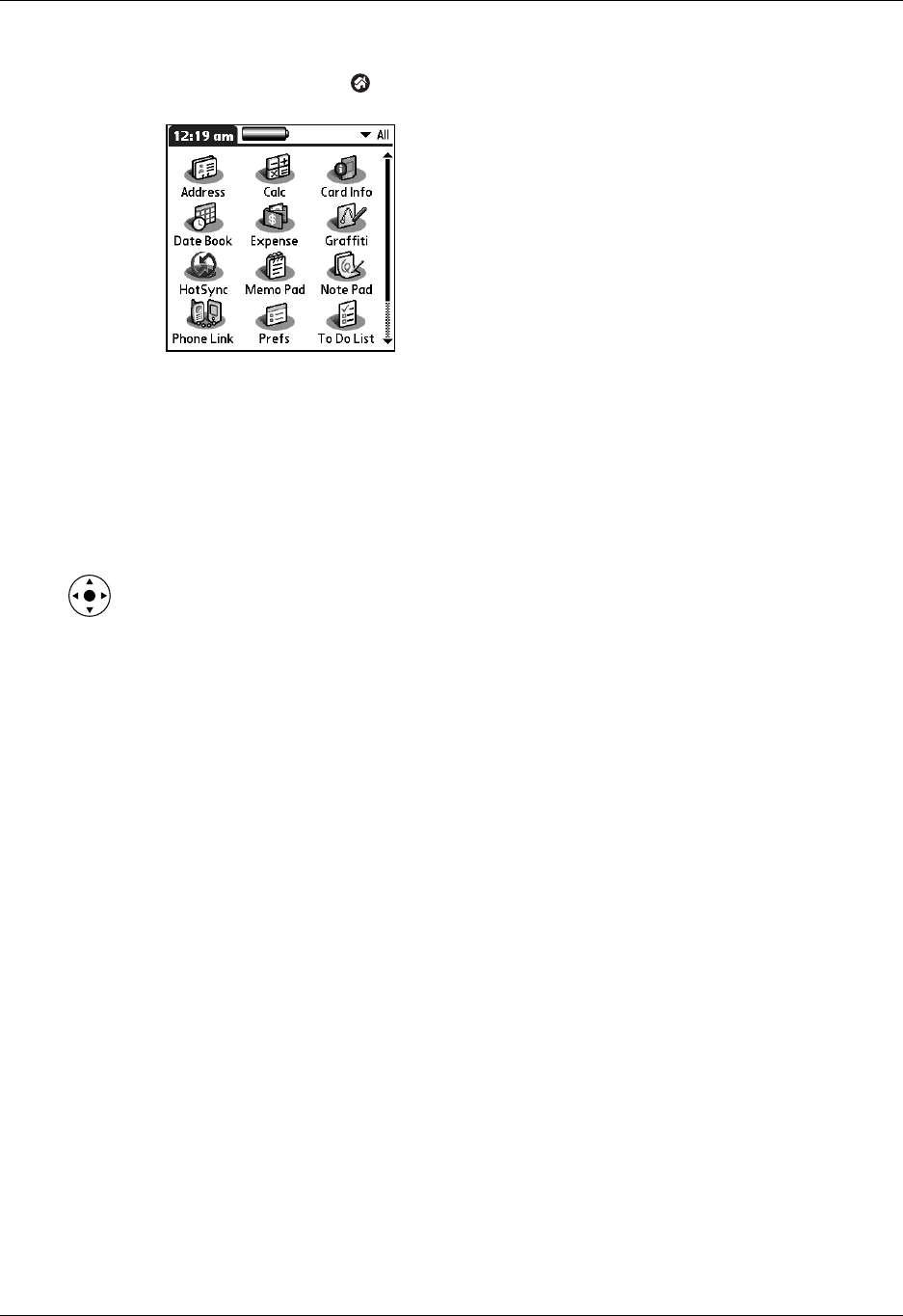
Chapter 4 Working with Applications
42
To open an application on your handheld:
1. Tap the Home icon .
2. Tap the icon of the application that you want to open. If you have many
applications installed on your handheld, tap the scroll bar to see all your
applications.
Other ways to open applications
You can also open applications on your handheld in either of the following ways:
■Press and hold Select on the navigator to open the Applications Launcher. Press
Select on the navigator to insert the highlight. Press Up, Down, Right, and Left
on the navigator to highlight the icon of the application you want to open. Press
Select on the navigator to open the application.
■In the Applications Launcher, write the Graffiti® character for the first letter of
its name. The Applications Launcher scrolls to the first application with a name
that begins with that letter.
Opening expansion card applications
When an expansion card is properly seated in the expansion card slot, your
handheld responds based on the contents of the card and the application that is
active when you insert the card. In some cases the application on the card opens
automatically upon insertion, or if you insert a card containing data from the
current application, the application displays the data on the card. In other cases the
Applications Launcher switches to the card and displays its contents, and the pick
list in the upper-right corner of the screen displays the name of the card.
Palm, Inc. Confidential
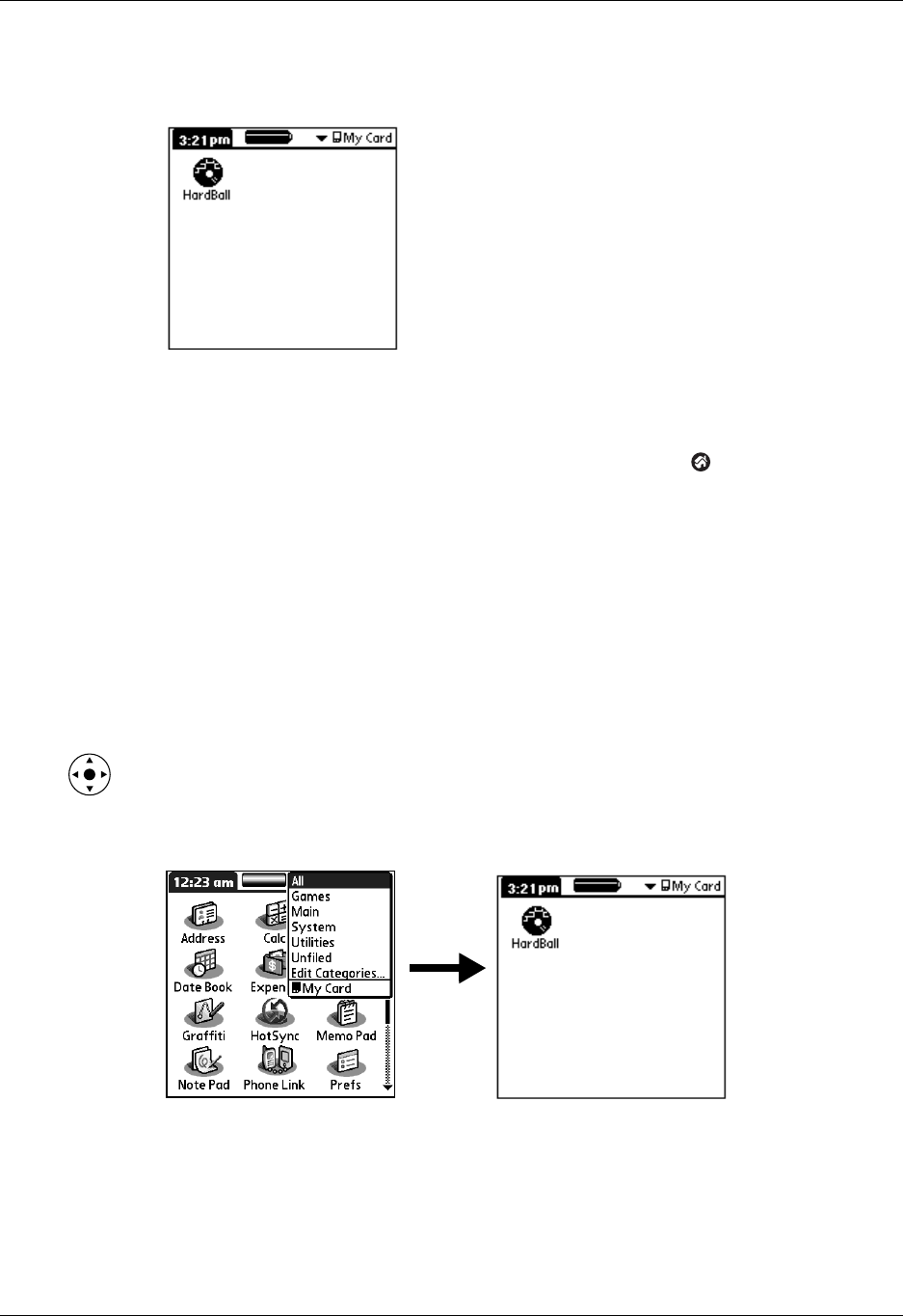
Switching between applications
43
To open an application on an expansion card:
■Select the icon of the application that you want to open.
Switching between applications
When working with any application, select the Home icon or press an
application button on your handheld to switch to another application. Your
handheld automatically saves your work in the current application and displays it
when you return to that application.
When you use an expansion card, your handheld creates and displays a new
category that matches the name of the expansion card. You can easily switch
between applications installed on your handheld and on the expansion card.
To switch to an expansion card:
1. Tap the pick list in the upper-right corner.
TIP When the highlight in the Applications Launcher is not active, you can also press
and hold Select on the navigator to open the category pick list.
2. Select the category item that matches the name of the expansion card.
Palm, Inc. Confidential
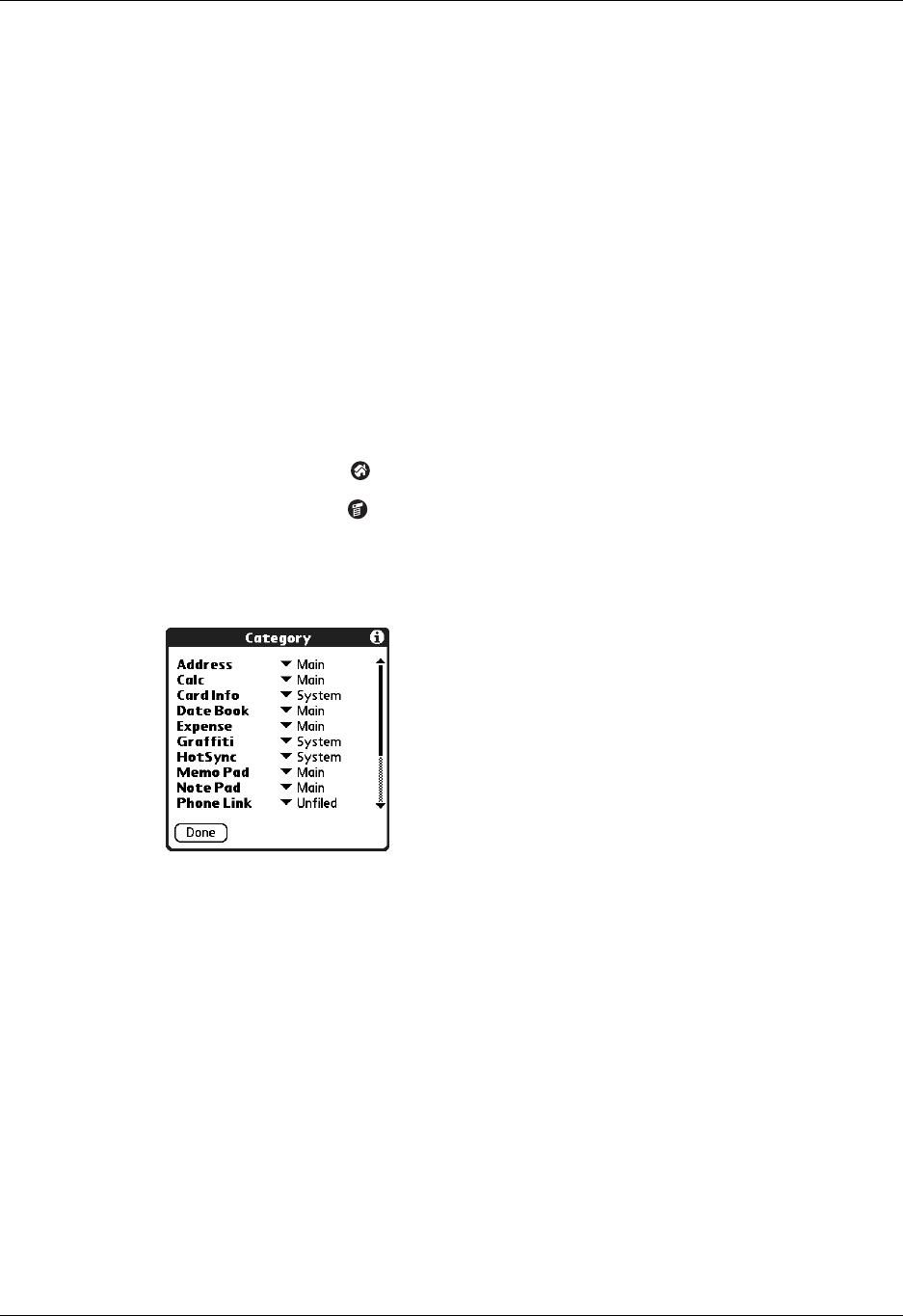
Chapter 4 Working with Applications
44
Categorizing applications
The category feature enables you to manage the number of application icons that
appear onscreen in the Applications Launcher. You can assign an application to a
category and then display a single category or all your applications.
By default, your handheld includes system-defined categories, such as All and
Unfiled, and user-defined categories, such as Games, Main, and System.
You cannot modify the system-defined categories, but you can rename and delete
the user-defined categories. In addition, you can create your own user-defined
categories. You can have a maximum of 15 user-defined categories.
When you have an expansion card properly seated in the expansion card slot, the
last item in the category pick list becomes the name of the expansion card. You
cannot otherwise categorize applications that reside on an expansion card.
To categorize an application:
1. Tap the Home icon .
2. Tap the Menu icon .
3. Select Category on the App menu.
4. Tap the pick list next to each application to select a category.
TIP To create a new category, tap Edit Categories from the pick list. Tap New,
enter the category name, and then tap OK to add the category. Tap OK again to
close the Edit Categories dialog box.
5. Tap Don e.
Palm, Inc. Confidential
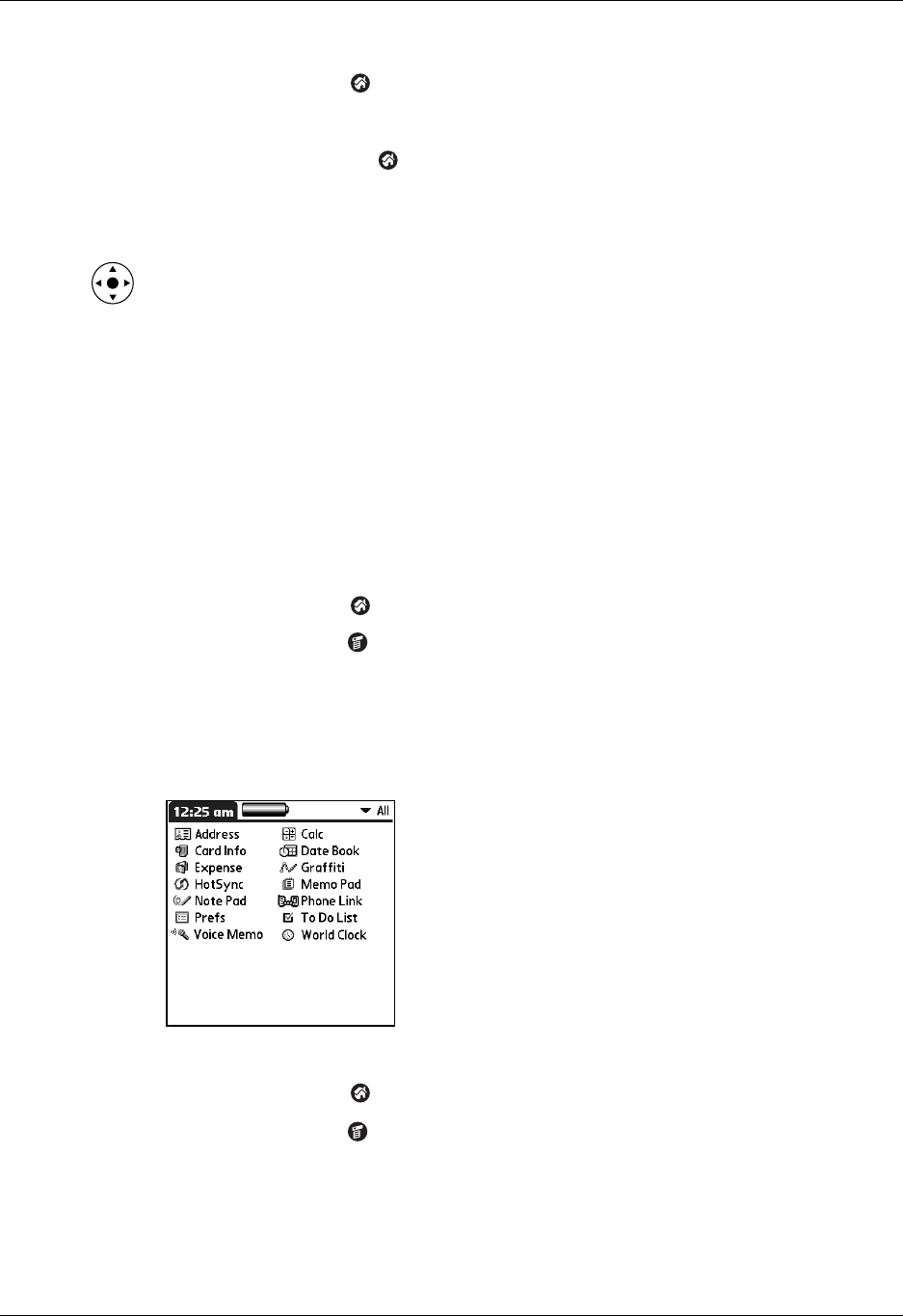
Changing the Applications Launcher display
45
To display applications by category:
1. Tap the Home icon .
2. Do one of the following:
– Tap the Home icon repeatedly to cycle through all your categories.
– Tap the pick list in the upper-right corner of the screen, and select the
category you want to display.
– When the highlight in the Applications Launcher is not active, press and
hold Select on the navigator to open the category list, press Up or Down on
the navigator to highlight a category, and then press Select on the navigator
to view that category.
Changing the Applications Launcher display
By default, the Applications Launcher displays each application as an icon. As an
alternative, you can choose to show a list of applications. You can also choose to
view the same category of applications each time you open the Applications
Launcher.
To change the Applications Launcher display:
1. Tap the Home icon .
2. Tap the Menu icon .
3. Select Options, and then select Preferences.
4. Tap the View By pick list and select List.
5. Tap OK.
To open the Applications Launcher to the last opened category:
1. Tap the Home icon .
2. Tap the Menu icon .
3. Select Options, and then select Preferences.
4. Tap the Remember Last Category check box to select it.
5. Tap OK.
Palm, Inc. Confidential
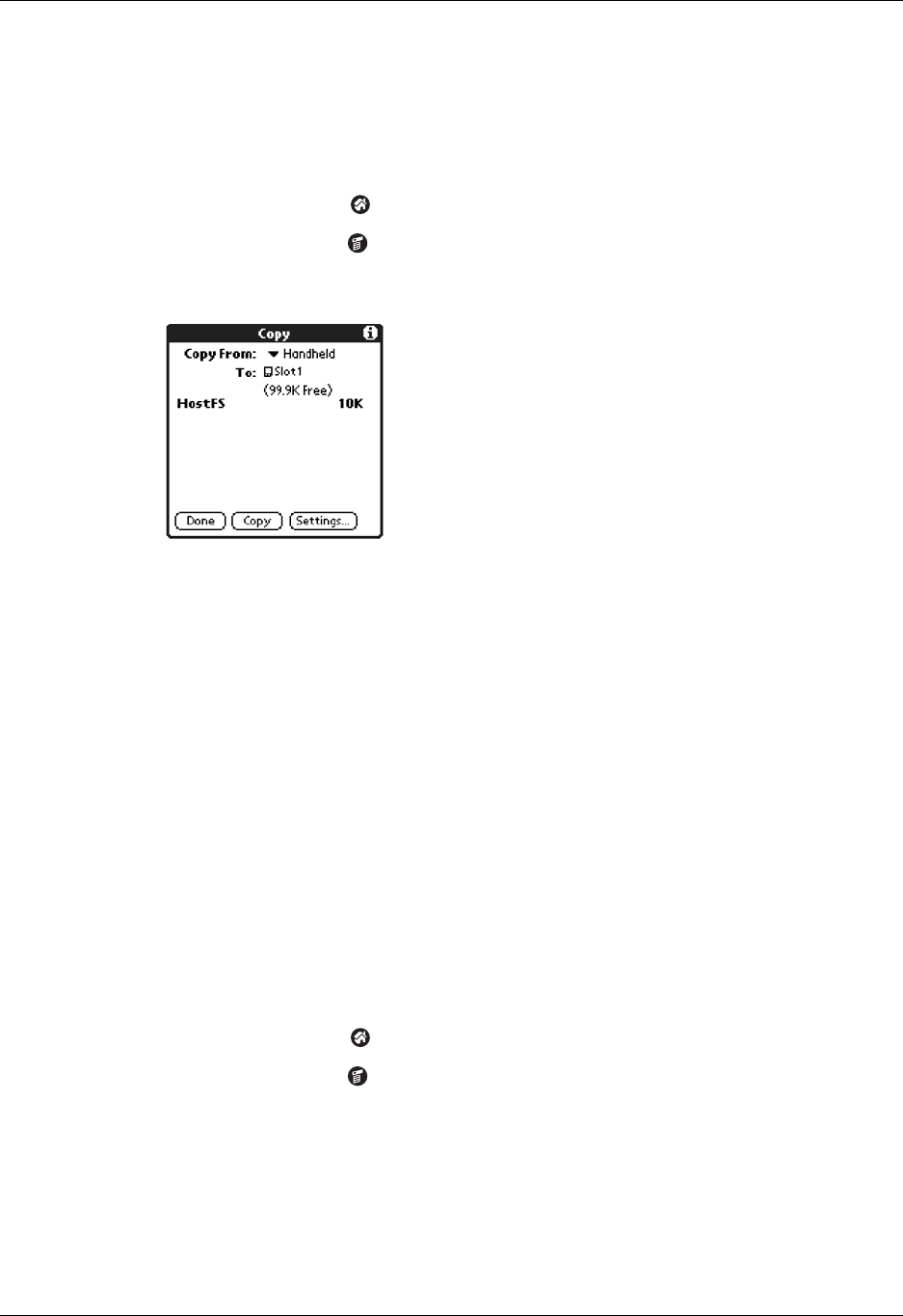
Chapter 4 Working with Applications
46
Copying applications to or from an expansion card
You can copy applications from your handheld to an expansion card, or from an
expansion card to your handheld.
To copy an application to an expansion card:
1. Tap the Home icon .
2. Tap the Menu icon .
3. Select Copy on the App menu.
4. Tap the Copy From pick list and select Handheld.
5. Tap the Copy To pick list and select the card name.
The Copy To pick list appears only if there are multiple cards available.
6. Tap an application to copy.
7. Tap Copy.
8. Tap Don e.
You can install applications to a card that is seated in the expansion card slot
during a HotSync® operation. See “Installing add-on applications” later in this
chapter for details.
NOTE If you view your applications on the card using a Card Reader on your
Windows or Mac computer, the actual file names may differ from those displayed in
the Applications Launcher.
To copy an application from an expansion card:
1. Tap the Home icon .
2. Tap the Menu icon .
Palm, Inc. Confidential
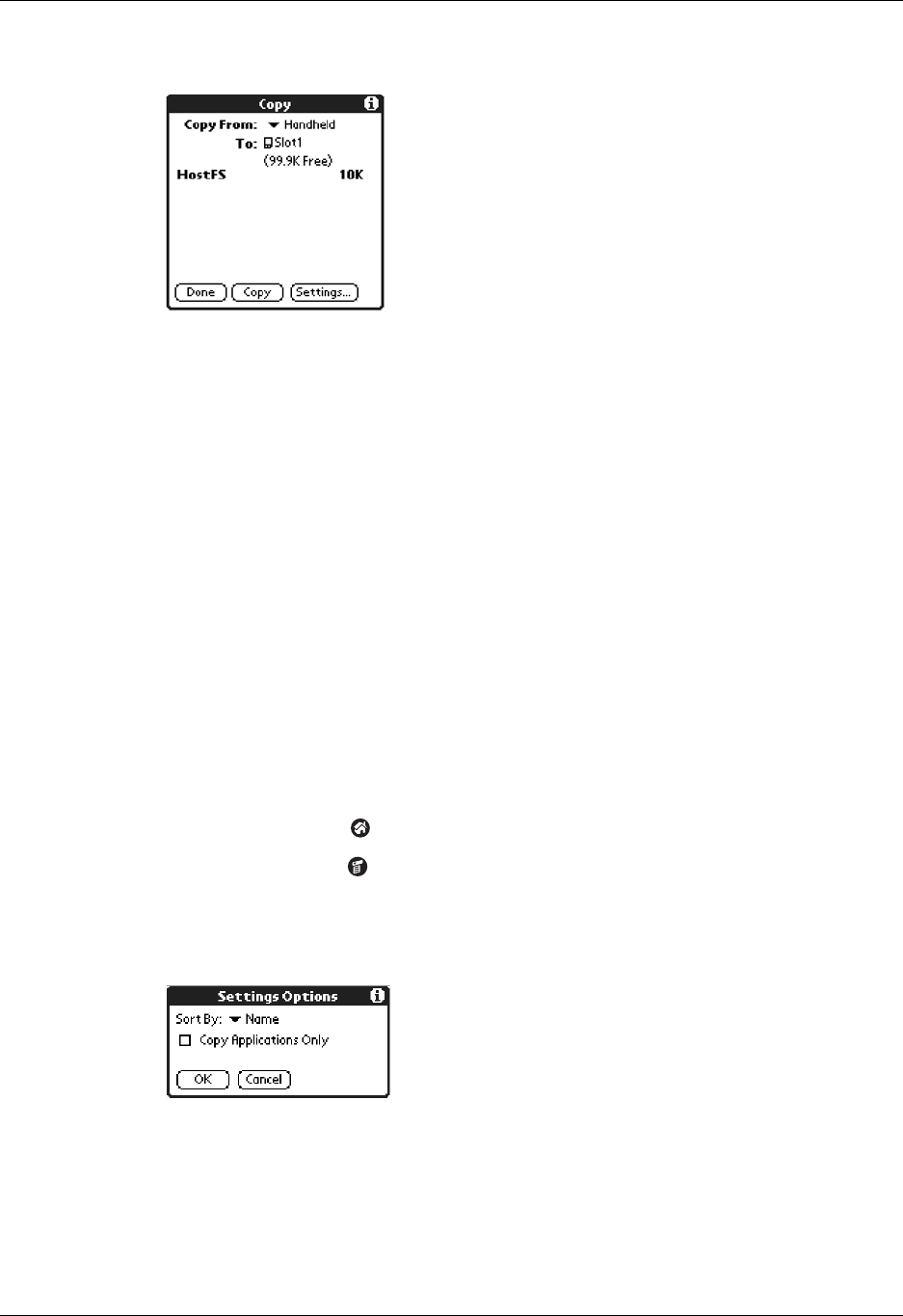
Selecting copy settings
47
3. Select Copy on the App menu.
4. Tap the Copy From pick list and select the card name.
5. Tap the Copy To pick list and select Handheld.
6. Tap the application you want to copy.
7. Tap Copy.
8. Tap Don e.
You can also beam applications from expansion cards to your handheld.
See “Beaming data” in Chapter 3 for details.
Selecting copy settings
When using the copy feature, you can set the following:
■How applications are sorted and listed
■Whether to copy only the application or both the application and its data files
To select copy settings:
1. Tap the Home icon .
2. Tap the Menu icon .
3. Select Copy on the App menu.
4. Tap Settings.
5. Tap the Sort By pick list and select Name or Size.
6. Tap the Copy Application Only check box to select it if you want to copy only
the application files. Leave it deselected if you want to copy both the application
file and its associated data file(s).
7. Tap OK.
Palm, Inc. Confidential
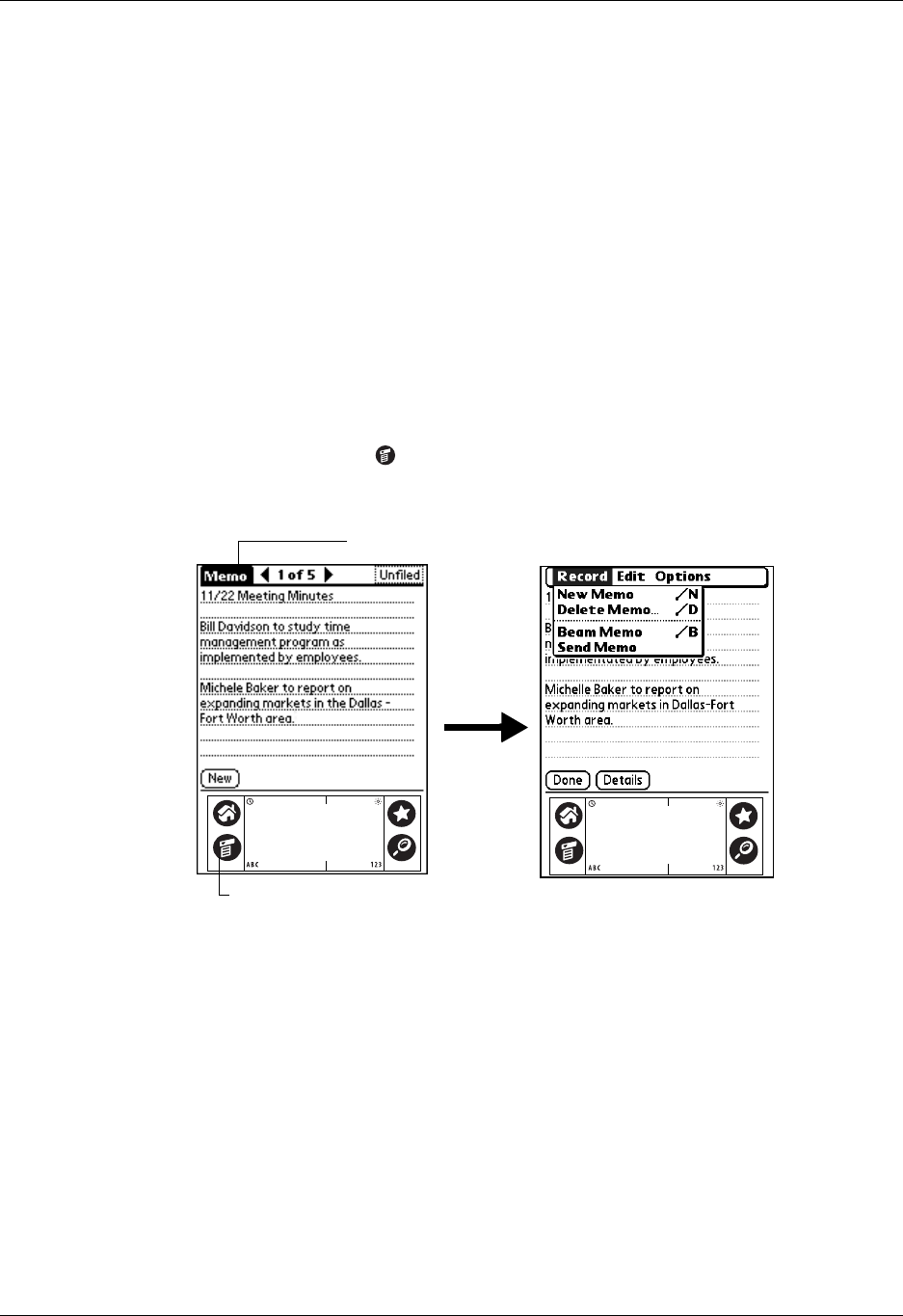
Chapter 4 Working with Applications
48
NOTE The Sort By setting is in effect each time you use the copy feature. Each time
you want to copy an application only, you must select the Copy Applications Only
check box.
Using menus
Menus on your handheld are easy to use. Once you have mastered them in one
application, you can use them the same way in all other applications.
The menus of each application are illustrated in the chapter that discusses that
application.
To open the menu bar:
1. Open an application (such as Memo Pad).
2. Do one of the following:
– Tap the Menu icon .
– Tap the inverted title area at the top of the screen.
In this example, three menus are available: Record, Edit, and Options. The Record
menu is selected and contains the commands New Memo, Delete Memo, Beam
Memo, and Send Memo.
Choosing a menu
The menus and menu commands that are available depend on the application that
is currently open. Also, the menus and menu commands vary depending on which
part of the application you’re currently using. For example, in Memo Pad, the
menus are different for the Memo list screen and the Memo record screen.
Tap the Menu icon
T
ap t
h
e t
i
t
l
e area
Palm, Inc. Confidential
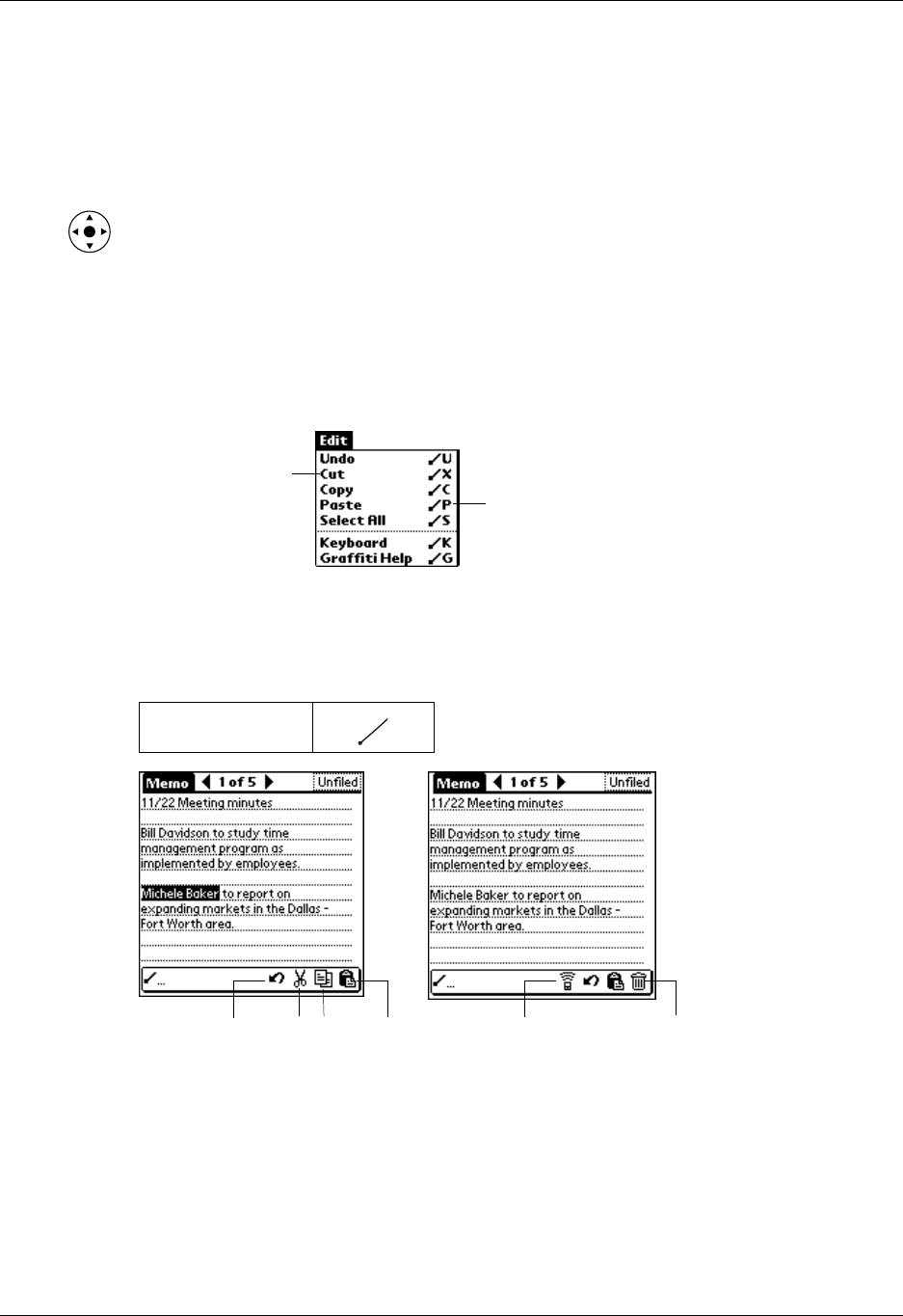
Using menus
49
To select a menu command with the stylus:
1. Open the menu bar for an application.
2. Tap the menu that contains the command you want to use.
3. Tap the command you want to use.
TIP After you open the menu bar, you can also press Right and Left on the navigator
to select a menu, press Down on the navigator to select the command you want to
use, and then press Select on the navigator to run the command.
Graffiti menu commands
Most menu commands have an equivalent Graffiti Command stroke, which is
similar to the keyboard shortcuts used to execute commands on computers. The
command letters appear to the right of the command names.
When you draw the Command stroke anywhere in the Graffiti area, the Command
toolbar appears just above the Graffiti writing area to indicate that you are in
Command mode.
The Command toolbar displays context-sensitive menu commands for the active
screen. For example, if text is selected, the menu icons displayed may be Undo,
Cut, Copy, and Paste. Tap an icon to select the command, or immediately write
the corresponding command letter for an appropriate command in the Graffiti
writing area.
For example, to select Paste from the Edit menu, draw the Command stroke,
followed by the letter p.
Command
Command letters
Menu commands
CutUndo Copy Paste Beam Delete
Palm, Inc. Confidential

Chapter 4 Working with Applications
50
Command mode is active only for a short time, so you must tap an icon or write
the command letter immediately to select the menu command.
Choosing application preferences
You can set options that affect an entire application in the application’s Preferences
dialog box.
To change preferences for an application:
1. Open an application.
2. Tap the Menu icon .
3. Select Options, and then select Preferences.
NOTE Not all applications have a Preferences command.
4. Make changes to the settings.
5. Tap OK.
Performing common tasks
The tasks described in this section use the term records to refer to an individual item
in any of the applications: a single Date Book event, Address Book entry, To Do List
item, Note Pad note, Voice Memo voice memo, Memo Pad memo, or Expense item.
Creating records
You can use the following procedure to create a new record in Date Book, Address
Book, To Do List, Note Pad, Memo Pad, and Expense.
To create a record:
1. Select the application in which you want to create a record.
2. Tap N ew.
3. In Date Book only: Select start and end times for your appointment, and tap OK.
4. Enter text for the record.
5. (Optional) Tap Details to select attributes for the record. (In Note Pad the Details
command is located on the Options menu.)
6. In Address Book, Note Pad, and Memo Pad only: Tap Done.
There’s no need to save the record because your handheld saves it automatically.
Palm, Inc. Confidential
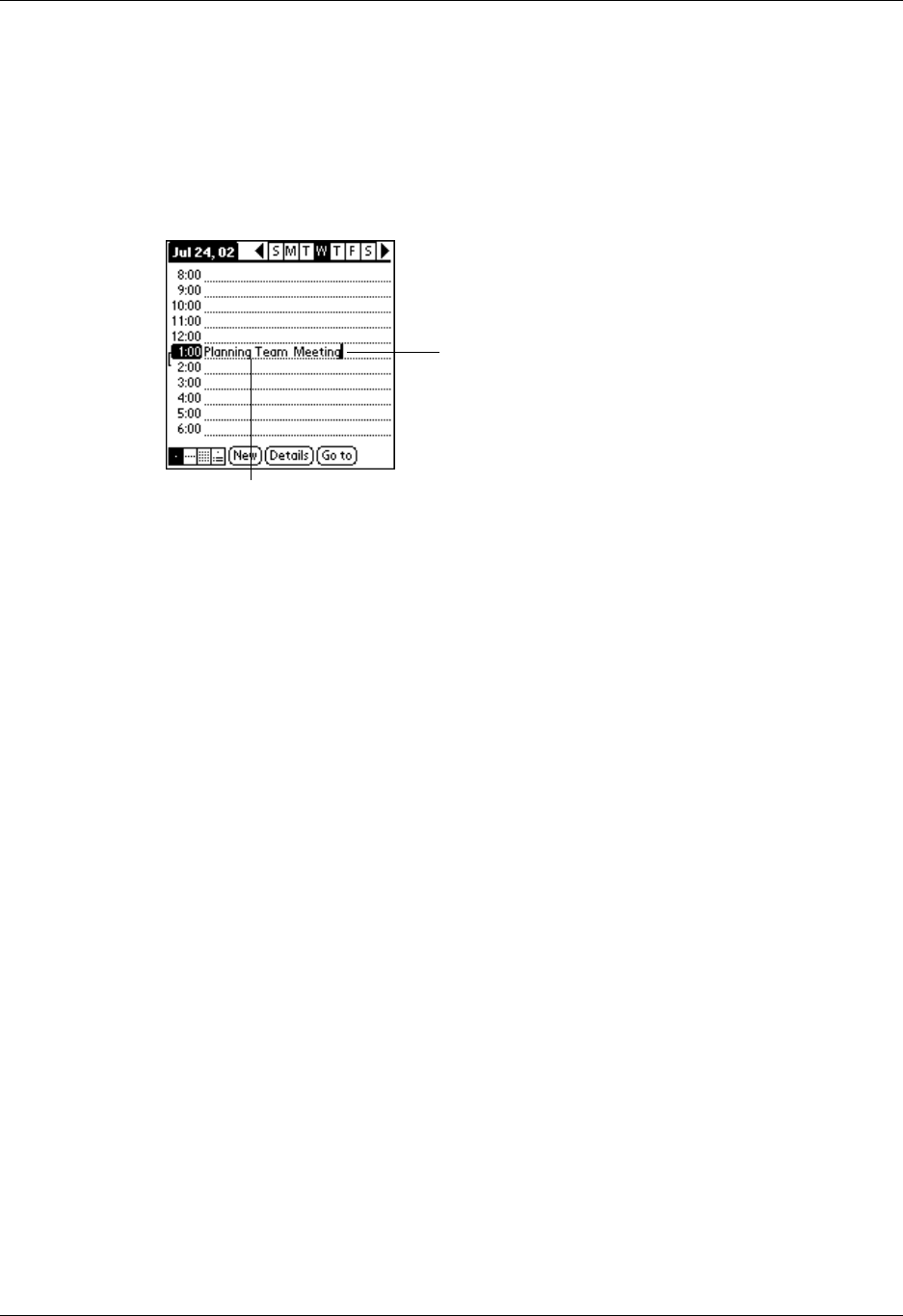
Performing common tasks
51
Editing records
After you create a record, you can change, delete, or enter new text at any time.
Two screen features tell you when your handheld is in Edit mode:
■A blinking cursor
■One or more dotted edit lines
NOTE In Note Pad you can write anywhere on the screen. Therefore, you will
not see an edit line or blinking cursor unless the cursor is in the title line.
Entering text
For information on how to enter text using Graffiti writing, the onscreen keyboard,
or the keyboard attached to your computer, see Chapter 3. For information on
entering text in Note Pad, see Chapter 11.
Using the Edit menu
The Edit menu is available with any screen where you enter or edit text. In general,
commands available in the Edit menu apply to text that you select in an application.
To select text in an application:
1. Tap the beginning of the text that you want to select.
2. Drag the stylus over the text to highlight it (in yellow).
NOTE You can also double-tap to select a word, or triple-tap to select a line of
text. You can also drag across the text to select additional words, or drag down
to select a group of lines.
Edit line
Blinking cursor
Palm, Inc. Confidential

Chapter 4 Working with Applications
52
The following commands may appear in an Edit menu:
Deleting records
To delete a record:
1. Select the record you want to delete.
2. Tap the Menu icon .
3. Select the Delete command on the Record menu. In Voice Memo, the delete
command is on the V Memo menu:
Date Book: Delete Event
Address Book: Delete Address
To Do List: Delete Item
Note Pad: Delete Note
Voice Memo: Delete V Memo
Memo Pad: Delete Memo
Expense: Delete Item
Undo Reverses the action of the last edit command. For example, if you
used Cut to remove text, Undo restores the text you removed. Undo
also reverses deletions you made using backspace.
Cut Removes the selected text and stores it temporarily in the memory
of your handheld. You can paste the text you cut into another area
of the current application or into a different application.
Copy Copies the selected text and stores it temporarily in the memory of
your handheld. You can paste the text that you copy into another
area of the current application or into a different application.
Paste Inserts the text that you cut or copied at the selected point in a
record. The text you paste replaces any selected text. If you did not
previously cut or copy text, Paste does nothing.
Select All Selects all of the text in the current record or screen. This enables
you to cut or copy all of the text and paste it elsewhere.
Keyboard Opens the onscreen keyboard. After you finish with the onscreen
keyboard, tap Done.
Graffiti Help Opens screens that show all the Graffiti character strokes. Use this
command anytime you forget a stroke for a character.
Palm, Inc. Confidential

Performing common tasks
53
A confirmation dialog box appears. If you want to save a copy of the deleted
item to an archive file in Palm™ Desktop software, be sure that the check box is
selected. If you don’t want to save a copy, tap the check box to deselect it. (The
archive option is not available in Note Pad and Voice Memo.)
4. Tap OK.
If you chose to save a copy of the selected item, your handheld transfers it to the
archive file on your desktop the next time you perform a HotSync operation.
To delete a record with alternate methods:
■Delete the text of the record.
■In Date Book, Address Book, To Do List, and Memo Pad, open the Details dialog
box for the record, tap Delete, and then tap OK.
NOTE When deleting a repeating event in Date Book, you can choose to delete
the current repeating event, current and future events, or all instances of that
event.
■In Note Pad and Voice Memo, open the note or voice memo you want to delete,
and then tap Delete.
Purging records
Over time, as you use Date Book, To Do List, and Expense, you’ll accumulate
records in these applications that have outlived their usefulness. For example,
events that occurred months ago remain in the Date Book, and To Do List items
that you marked as completed remain in the list, as do Expense items.
All these outdated records take up memory on your handheld, so it’s a good idea
to remove them by using Purge. If you think Date Book or To Do List records might
prove useful later, you can purge them from your handheld and save them in an
archive file on your computer.
Purging is not available in Address Book, Note Pad, Voice Memo, or Memo Pad.
You must delete outdated records manually from these applications.
To purge records:
1. Open the application.
2. Tap the Menu icon .
3. Select Purge on the Record menu.
A confirmation dialog box appears.
Date Book: Tap the pick list and select how old a record must be to be purged.
Purge deletes repeating events if the last of the series ends before the date that
you purge records.
Palm, Inc. Confidential

Chapter 4 Working with Applications
54
Date Book, To Do List: If you want to save a copy of the purged records to an
archive file on your desktop, be sure that the check box is selected. If you don’t
want to save a copy, tap the check box to deselect it.
Expense: Select the category you want to purge. All data in the selected category
will be purged and there is no archive option.
4. Tap OK, or in Expense, tap Purge.
If you chose to save a copy of the purged records, your handheld transfers them to
an archive file on your desktop the next time you perform a HotSync operation.
NOTE Purging does not happen automatically. You must select the command to
make it happen.
Categorizing records
You can categorize records in the Address Book, To Do List, Note Pad, Voice Memo,
Memo Pad, and Expense applications so that they are grouped logically and are
easy to review.
When you create a record, your handheld automatically places it in the category
that is currently displayed. If the category is All, your handheld assigns it to the
Unfiled category. You can leave an entry as Unfiled or assign it to a category at any
time.
By default, your handheld includes system-defined categories, such as All and
Unfiled, and user-defined categories, such as Business and Personal.
You cannot modify the system-defined categories, but you can rename and delete
the user-defined categories. In addition, you can create your own user-defined
categories. You can have a maximum of 15 user-defined categories in each
application.
When you have an expansion card properly seated in the expansion card slot, the
last item in the category pick list becomes the name of the expansion card. You
cannot otherwise categorize applications that reside on an expansion card.
Address Book contains the QuickList user-defined category, in which you can store
the names, addresses, and phone numbers you might need in emergencies (doctor,
fire department, lawyer, and so on).
Expense contains two user-defined categories, New York and Paris, to show how
you might sort your expenses according to different business trips.
The illustrations in this section come from Address Book, but you can use these
procedures in all the applications in which categories are available.
To move a record into a category:
1. Select the record you want to categorize.
2. In Address Book only: Tap Edit.
3. Tap Details.
Palm, Inc. Confidential
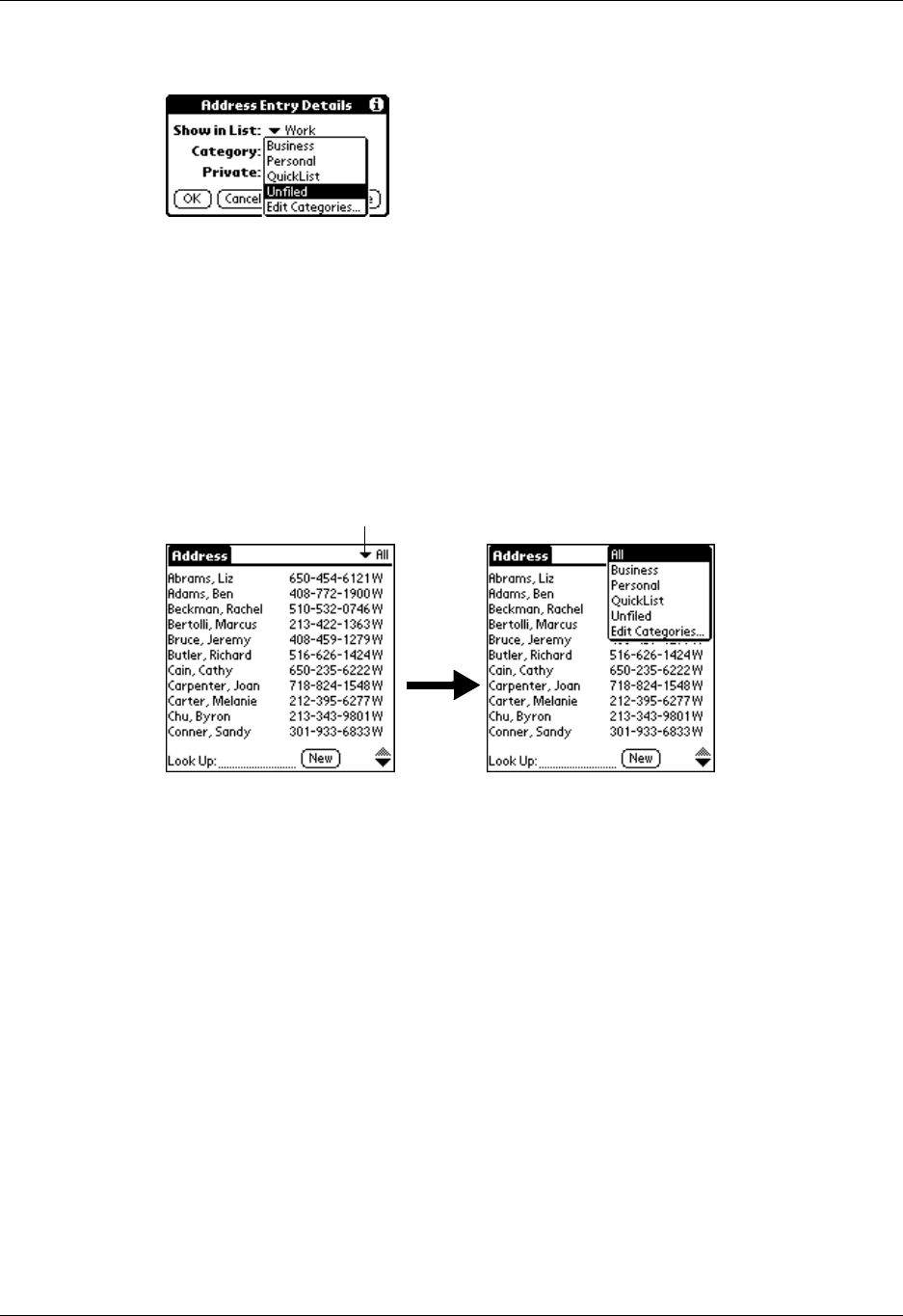
Performing common tasks
55
4. Tap the Category pick list to display the list of available categories.
5. Select the category for the record.
6. Tap OK.
NOTE In Address Book, Note Pad, Voice Memo, and Memo Pad you can select
the category name in the upper-right corner of the screen to assign the item to
a different category.
To display a category of records:
1. Tap the category pick list in the upper-right corner of the list screen.
NOTE In the Date Book Agenda view, the pick list is in the upper right of the
To Do list.
2. Select the category you want to view.
The list screen now displays only the records assigned to that category.
TIP Pressing an application button on your handheld scrolls through all the
categories of that application except for Unfiled. This feature is not available in
Date Book.
T
ap
h
ere
Palm, Inc. Confidential
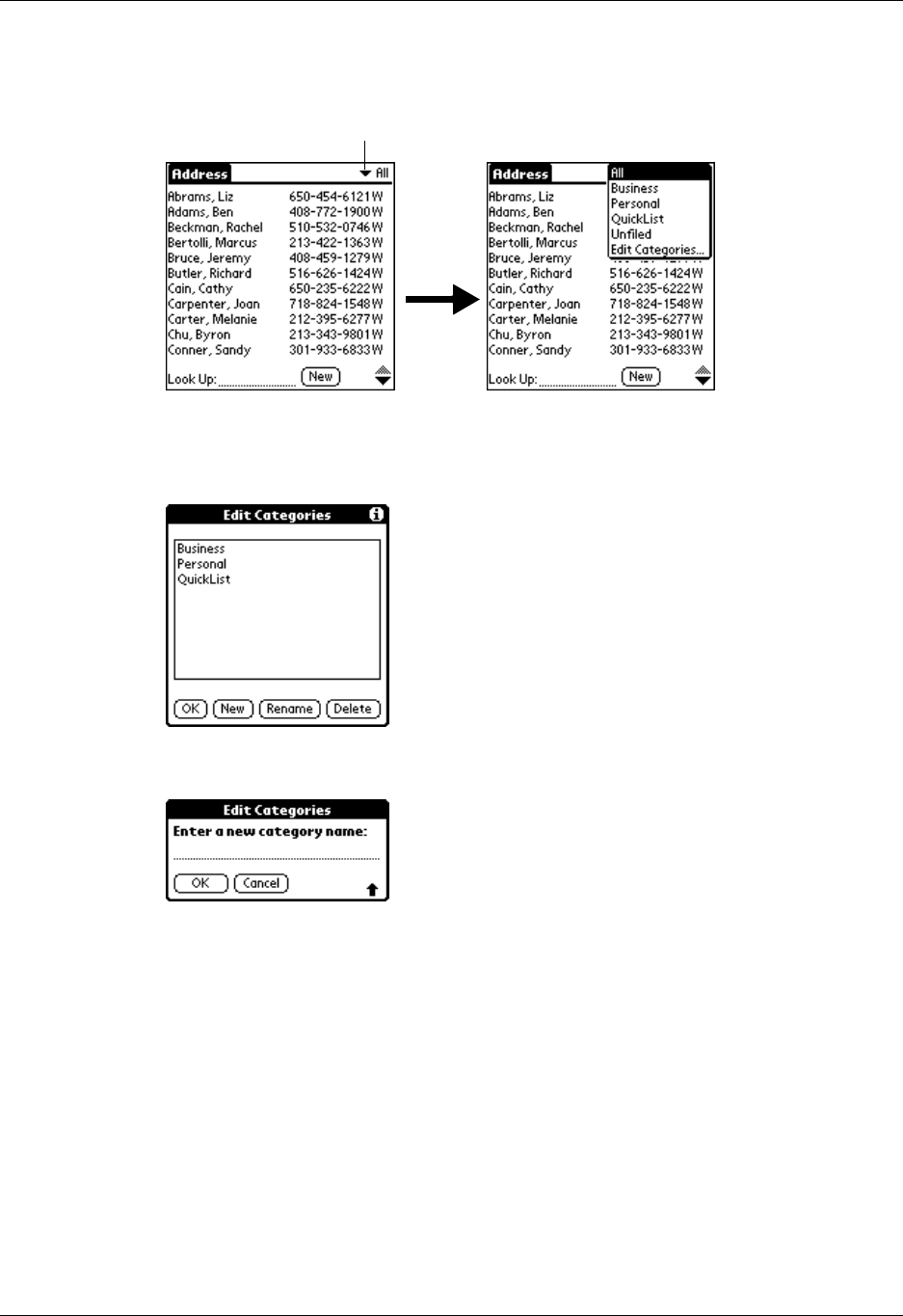
Chapter 4 Working with Applications
56
To define a new category:
1. Tap the category pick list in the upper-right corner of the screen or list.
2. Select Edit Categories.
3. Tap N ew.
4. Enter the name of the new category, and then tap OK.
5. Tap OK.
You can assign any of your records to the new category.
T
ap
h
ere
Palm, Inc. Confidential
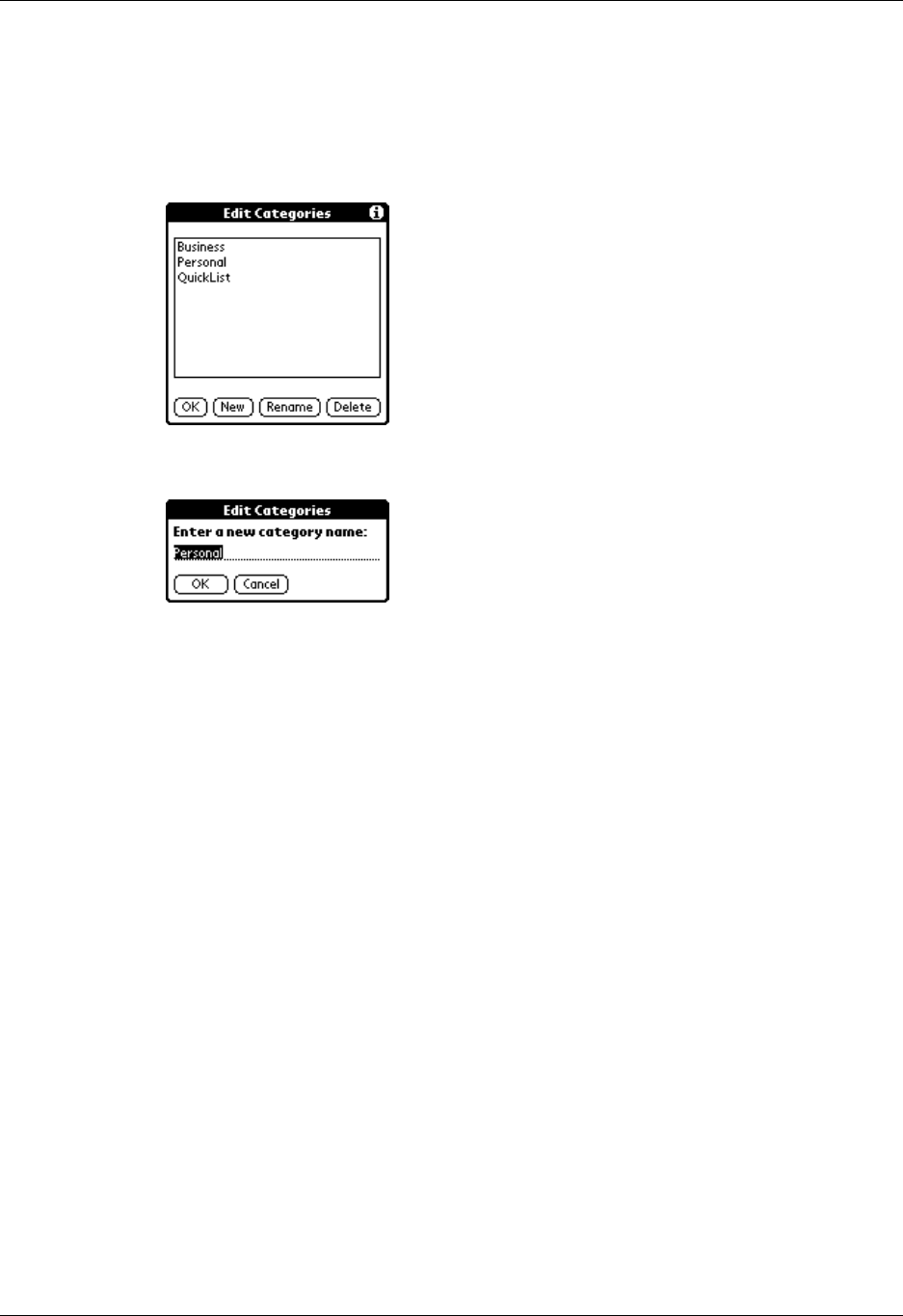
Performing common tasks
57
To rename a category:
1. Tap the category pick list in the upper-right corner of the screen or list.
2. Select Edit Categories.
3. Select the category that you want to rename, and then tap Rename.
4. Enter the new name for the category, and then tap OK.
5. Tap OK.
TIP You can group the records within two or more categories into one
category by giving the categories the same name. For example, if you change
the name of the Personal category to Business, all records formerly in the
Personal category appear in the Business category.
Finding information
Your handheld offers several ways for you to find information quickly:
■All applications that reside on your handheld: Find locates any text that you
specify, always starting with the current application. However, Find does not
search through applications on expansion cards.
■Date Book, To Do List, Memo Pad: Phone Lookup displays the Address list
screen and enables you to add to a record the information that appears in
this list.
■Address Book: The Look Up line enables you to scroll immediately to a name
when you enter the first letters of that name.
■Expense: Lookup displays the names in your Address Book that have data in the
Company field. You can add these names to a list of attendees associated with
an Expense record.
Palm, Inc. Confidential
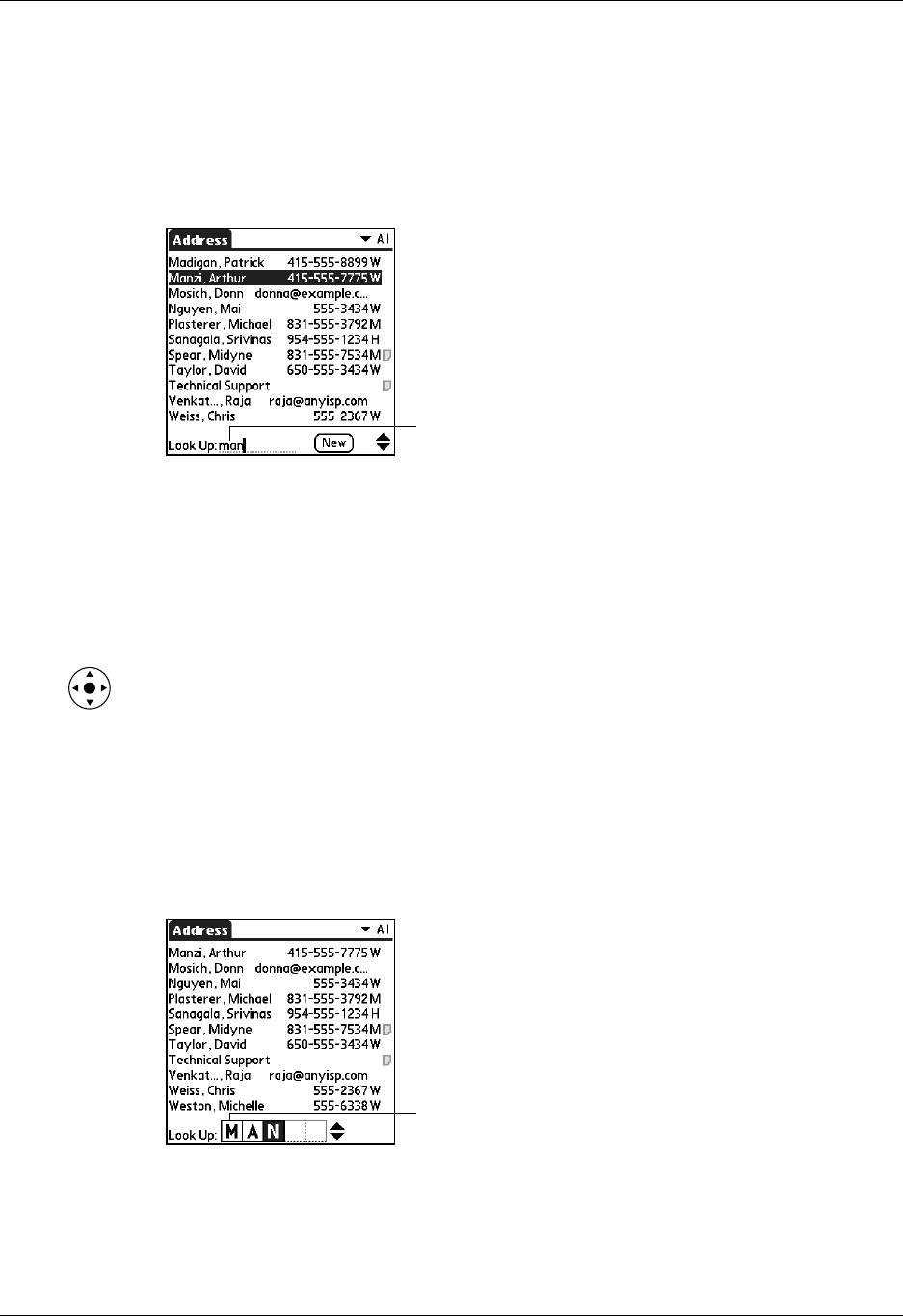
Chapter 4 Working with Applications
58
Looking up Address Book records
In Address Book you can use the Look Up line with the stylus or navigator to look
up and quickly scroll to any of your Address Book entries.
To look up an Address Book record with the stylus:
1. From the Address list screen, enter the first letter of the name you want to find.
The list scrolls to the first entry that begins with that letter. If you write another
letter, the list scrolls to the first entry that starts with those two letters. For
example, writing an s scrolls to “Sands,” and writing sm scrolls further to
“Smith.” If you sort the list by company name, the Look Up feature scrolls to the
first letter of the company name.
2. Tap the record to view its contents.
To look up an Address Book record with the navigator:
1. From the Address list screen, press Right on the navigator to display the Quick
Look Up line.
2. Press Up and Down on the navigator to select the first letter of the name you
want to find.
The list scrolls to the first entry that begins with that letter.
3. Press Right on the navigator to move to the next letter box.
The Quick Look Up line displays only letters that are a possible match for that
position. For example, in the screen shown here, if you enter c in the first box,
only the letters a, h, and o appear in the second box.
Look Up line
Quick Look Up line
Palm, Inc. Confidential
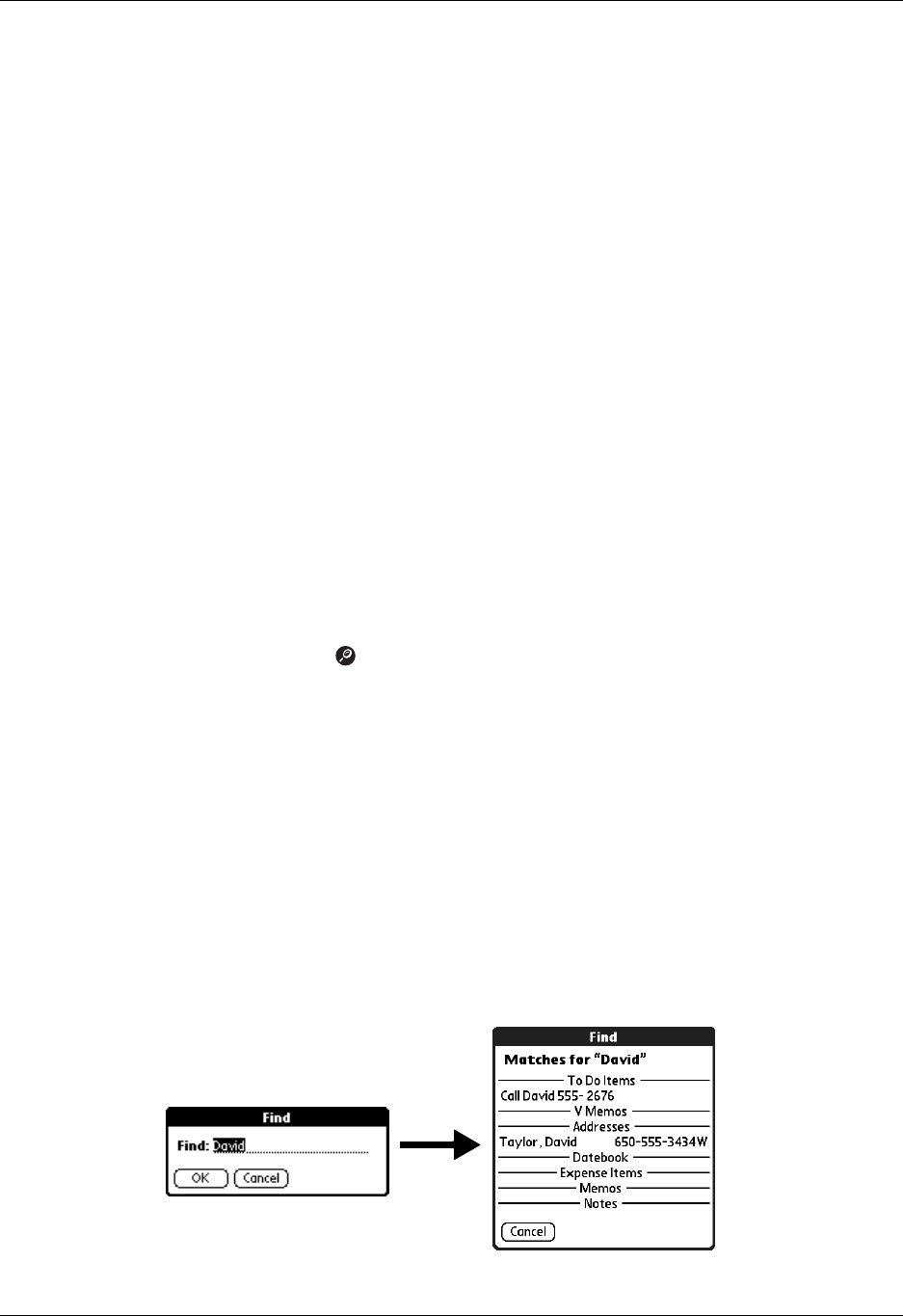
Performing common tasks
59
If there is only one possible match for a particular position, the highlight jumps
to the next position.
4. Press Up or Down on the navigator to select the next letter of the name you want
to find.
The list then scrolls to the first entry that starts with those two letters. For
example, selecting s scrolls to “Sands,” and selecting sm scrolls further to
“Smith.” If you sort the list by company name, the Quick Look Up feature
scrolls to the matches for the company name.
5. Repeat steps 4 and 5 until the entry you want appears in the list.
6. Press Select on the navigator to highlight the record you want.
7. Press Select on the navigator to view the contents of the selected record.
TIP If there is only one possible match for the letters you selected, the contents
of the record automatically display.
Using Find
You can use Find to locate any text that you specify, in any application that resides
on your handheld. Find does not search applications that reside on an expansion
card.
To use Find:
1. Tap the Find icon .
TIP If you select text in an application before you tap Find, the selected text
automatically appears in the Find dialog box.
2. Enter the text that you want to find.
Find is not case sensitive. For example, searching for the name “davidson” also
finds “Davidson.”
Find locates any words that begin with the text you enter. For example,
searching for “plane” finds “planet” but not “airplane.”
3. Tap OK.
Find searches for the text in all records and all notes.
Palm, Inc. Confidential
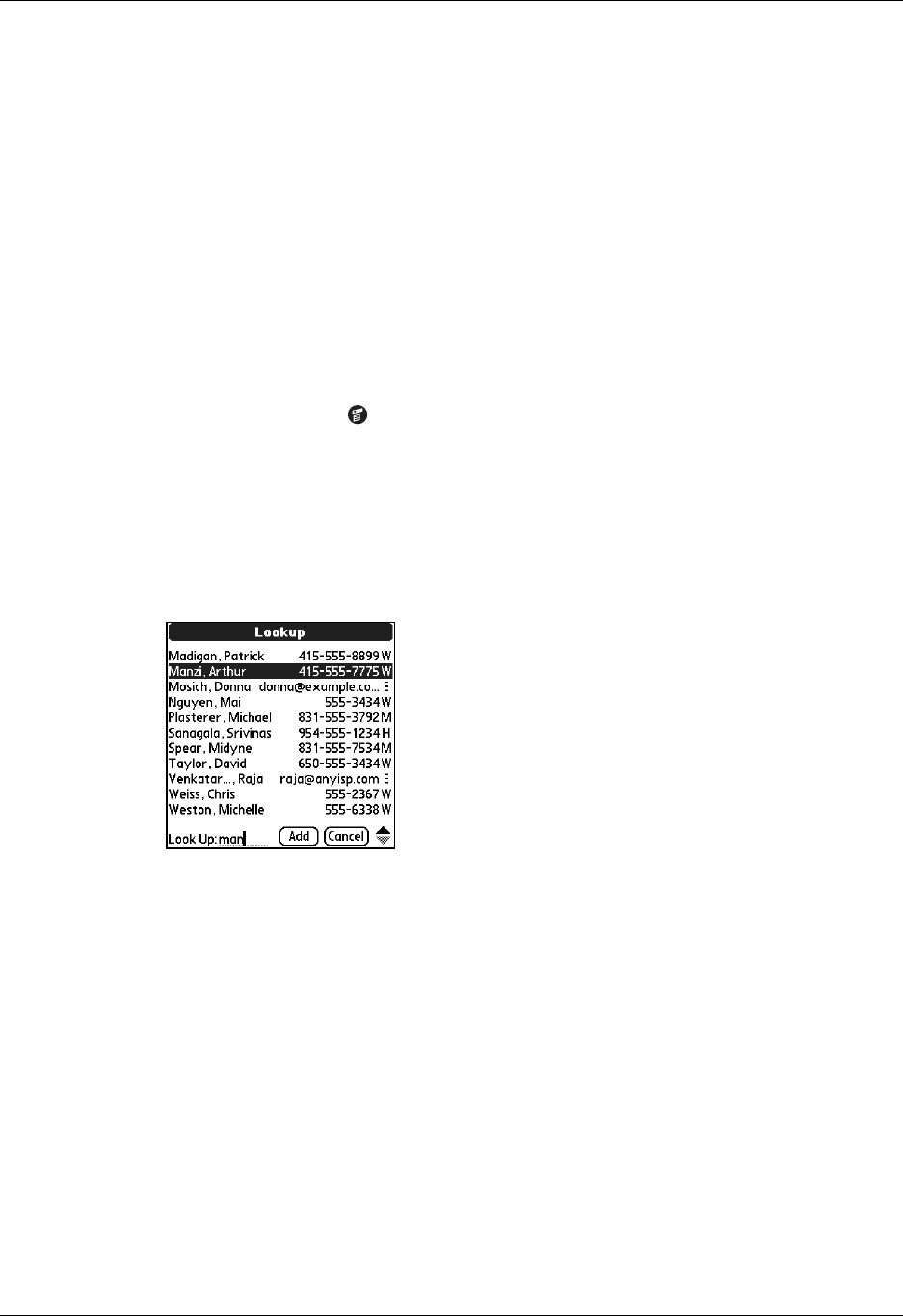
Chapter 4 Working with Applications
60
As your handheld searches for the text, you can tap Stop at any time. You may
want to do this if the entry you want appears before your handheld finishes the
search. To continue the search after you tap Stop, tap Find More.
4. Tap the text that you want to review.
Using Phone Lookup
Phone Lookup displays the Address list screen. You can add to a record the
information that appears in this list.
To use Phone Lookup:
1. Display the record in which you want to insert a phone number. The record can
be in Date Book, To Do List, Memo Pad, or any other application that takes
advantage of this feature.
2. Tap the Menu icon .
3. Select Options, and then select Phone Lookup.
4. Begin to spell the last name of the name you want to find.
The list scrolls to the first record in the list that starts with the first letter you
enter. Continue to spell the name you’re looking for, or when you see the name,
tap it.
5. Tap Add.
The name you selected, along with the information associated with it, is pasted
into the record you selected in step 1.
Using Graffiti commands with Phone Lookup
Write the Graffiti Command stroke “/L” to activate the Phone Lookup feature.
You can also activate it in the following circumstances:
■While entering text: For example, to insert the full name and phone number for
someone with the last name Williams, write the Graffiti characters for Wi and
then the Phone Lookup Command stroke “/L.”
If you have only one Address Book record that begins with Wi, your handheld
inserts the full name, such as Fred Williams (and its associated information). If
Palm, Inc. Confidential
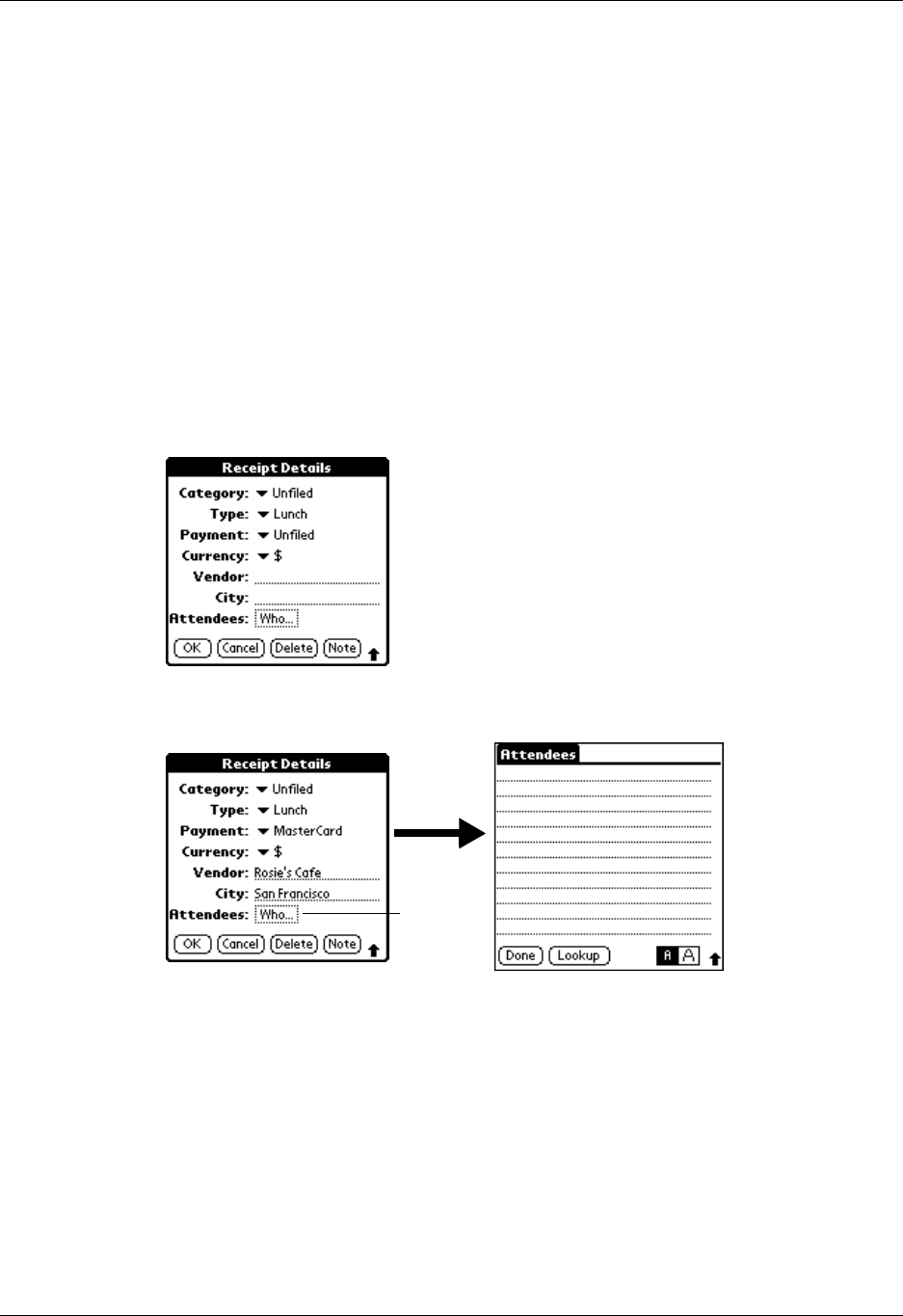
Performing common tasks
61
you have more than one name that begins with Wi, the Phone Lookup screen
appears and highlights the first record that begins with Wi.
■For selected text: Drag to highlight the text, and then write the Phone Lookup
Command stroke “/L.” Your handheld replaces the selected text and adds the
name and its associated information.
Looking up names to add to Expense records
In Expense, Lookup displays the names in your Address Book that have data in the
Company field. You can add these names to a list of attendees associated with an
Expense record.
To add names to an Expense record:
1. Tap the Expense record to which you want to add names.
2. Tap Details.
3. Tap Who.
4. Tap Lookup.
The Attendees Lookup screen displays all the names in your Address Book that
have data in the Company field.
5. Select the name you want to add, and then tap Add.
The name appears in the Attendees screen.
6. Repeat steps 4 and 5 to add more names.
7. Tap Don e.
8. Tap OK.
Ta p h e r e
Palm, Inc. Confidential
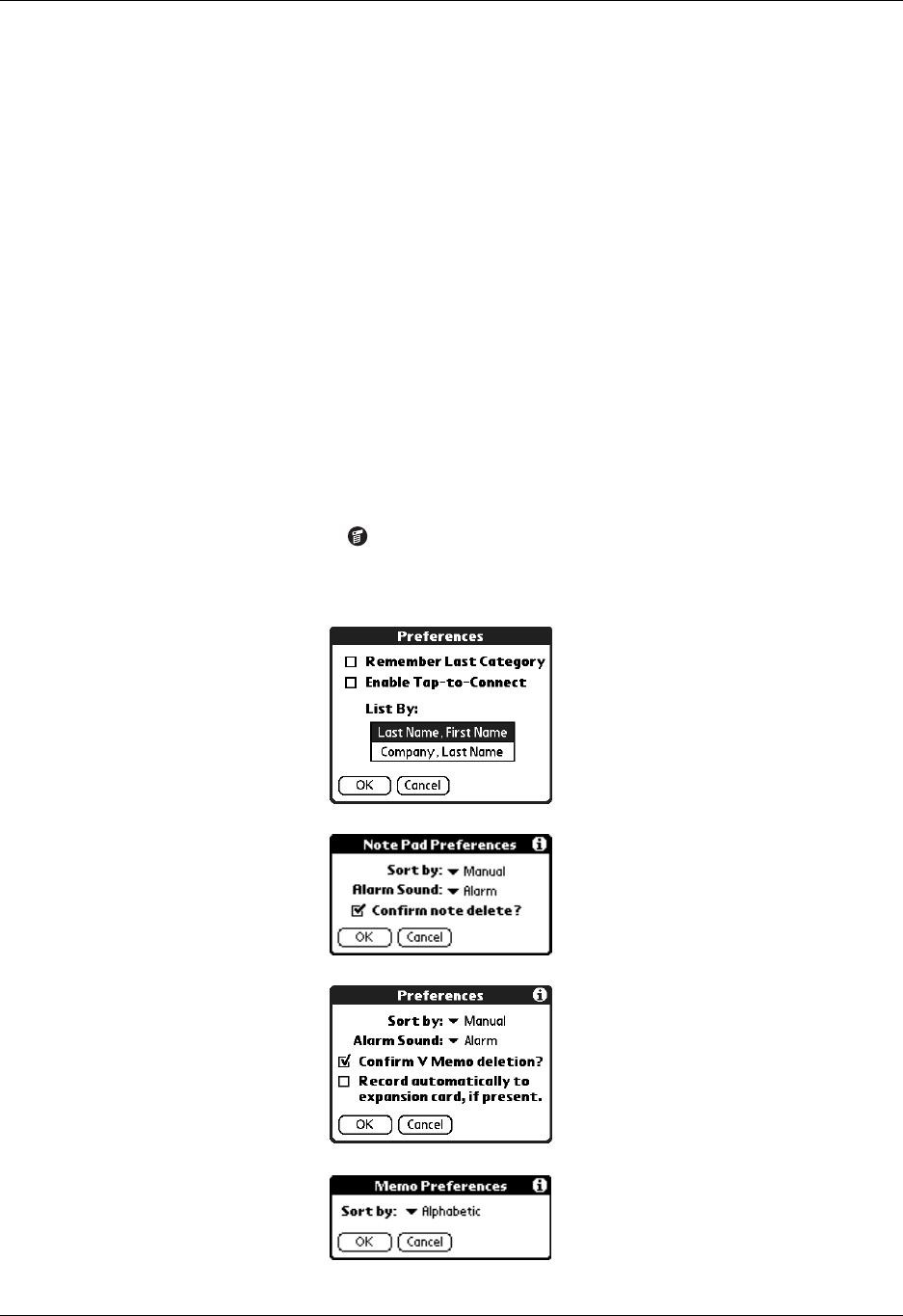
Chapter 4 Working with Applications
62
Sorting lists of records
You can sort lists of records in various ways, depending on the application. Sorting
is available in applications that have list screens: Address Book, To Do List, Note
Pad, Voice Memo, Memo Pad, and Expense.
NOTE You can also assign records to categories. See “Categorizing records” earlier
in this chapter.
To sort records in To Do List and Expense:
1. Open the application to display the list screen.
2. Tap Show.
3. Tap the Sort by pick list and select an option.
4. Tap OK.
To sort records in Address Book, Note Pad, Voice Memo, and Memo Pad:
1. Open the application to display the list screen.
2. Tap the Menu icon .
3. Select Options, and then select Preferences.
Address Book
Note Pad
Voice Memo
Memo Pad
Palm, Inc. Confidential
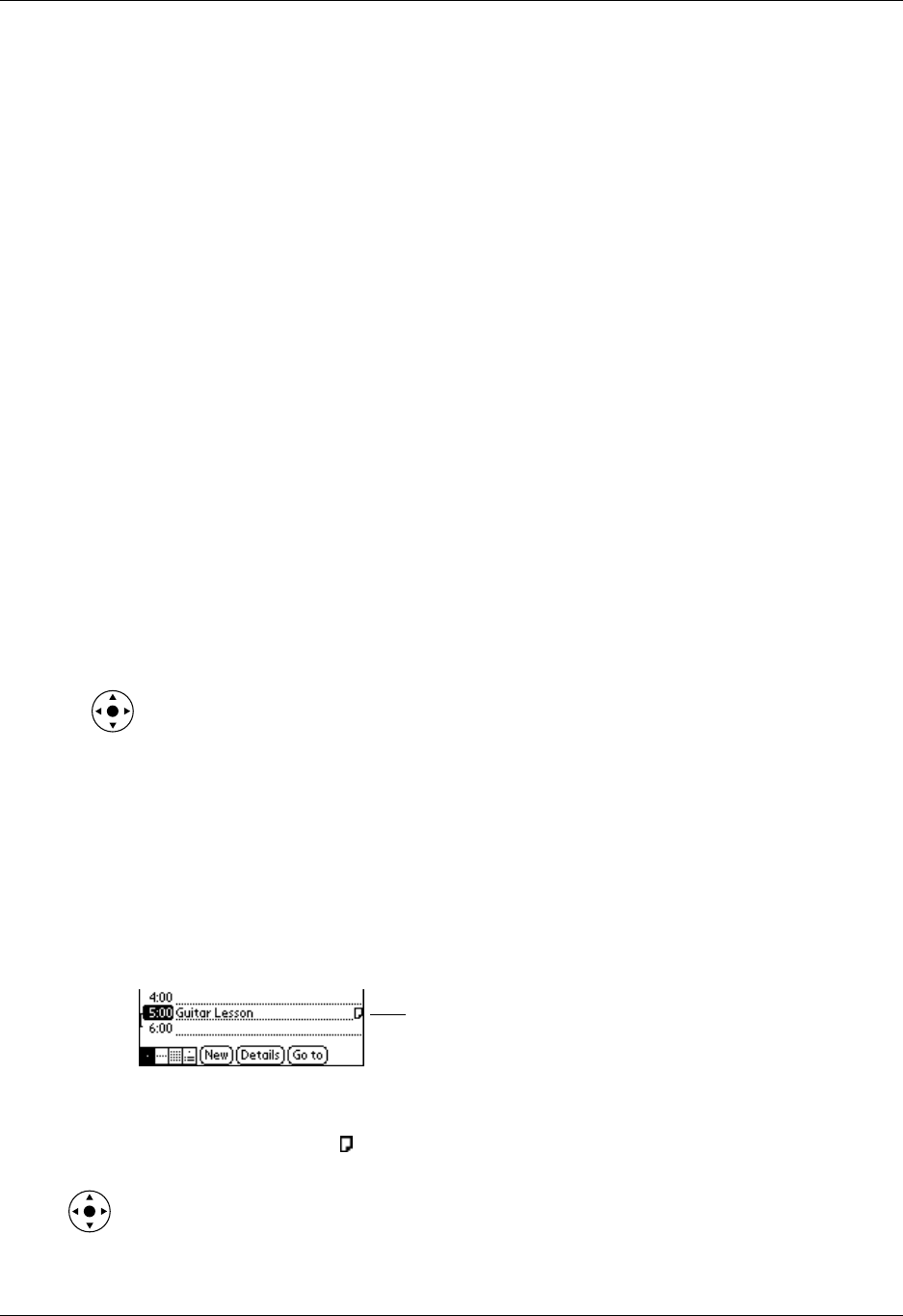
Performing common tasks
63
4. Do one of the following:
Address Book: Tap the setting you want.
Note Pad: Tap the Sort by pick list and select Alphabetic, Date, or Manual.
Voice Memo: Tap the Sort by pick list and select Date, Alphabetic, Duration, or
Manual.
Memo Pad: Tap the Sort by pick list and select Alphabetic or Manual.
5. Tap OK.
To sort the Note Pad, Voice Memo, or Memo list manually, tap and drag a note,
voice memo, or memo to a new location in the list.
To make the list appear in Palm Desktop software as you manually sorted it on
your handheld, open the application in Palm Desktop software and click Sort
by. Then select Order on Handheld.
Attaching notes
In Address Book, Date Book, To Do List, and Expense, you can attach a note to a
record. A note can be up to several thousand characters long. For example, for an
appointment in Date Book, you can attach a note with directions to the location.
To attach a note to a record:
1. Display the entry to which you want to add a note.
To display an entry, tap it or press Up or Down on the navigator to highlight it,
and then press Select on the navigator.
2. In Address Book only: Tap Edit.
3. Tap Details.
4. Tap N o te.
5. Enter your note.
6. Tap Don e.
A small note icon appears at the right side of any item that has a note.
To review or edit a note:
■Tap the Note icon .
TIP In Date Book, you can also highlight the event that contains the note, press
Select on the navigator to open the note, and then press Select on the navigator again
to close the note.
Note icon
Palm, Inc. Confidential
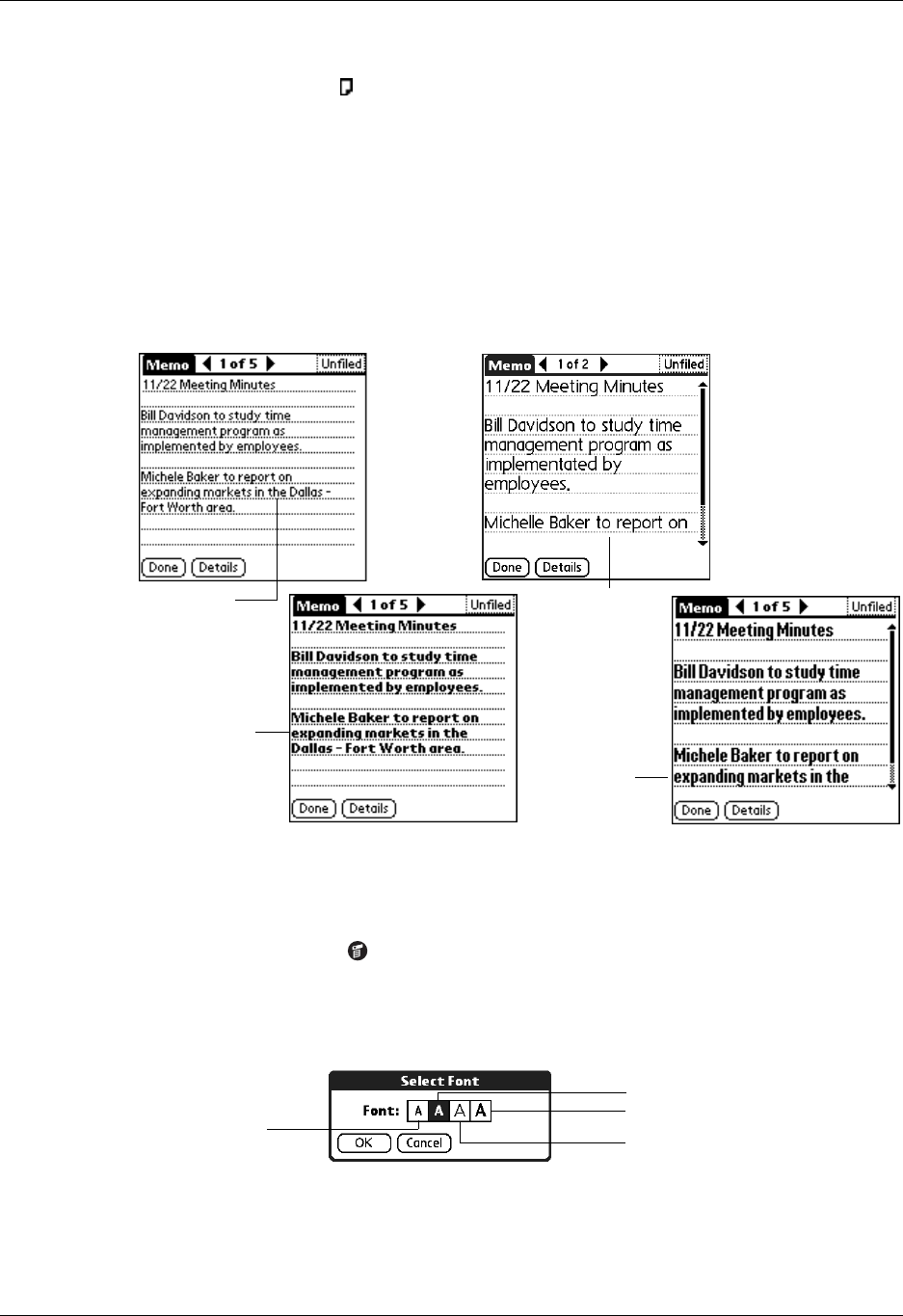
Chapter 4 Working with Applications
64
To delete a note:
1. Tap the Note icon .
2. Tap Delete.
3. Tap Yes.
Choosing fonts
In many applications, you can change the font style to make text easier to read. You
can choose small, small bold, large, or large bold fonts in each application that
enables you to change the font style.
To change the font style:
1. Open an application.
2. Tap the Menu icon .
3. Select Options, and then select Font.
4. Tap the font style you want to use.
5. Tap OK.
Small font Large font
Small bold
font
Large bold
font
Tap here for
small font
Tap here for small bold font
Tap here for large bold font
Tap here for large font
Palm, Inc. Confidential
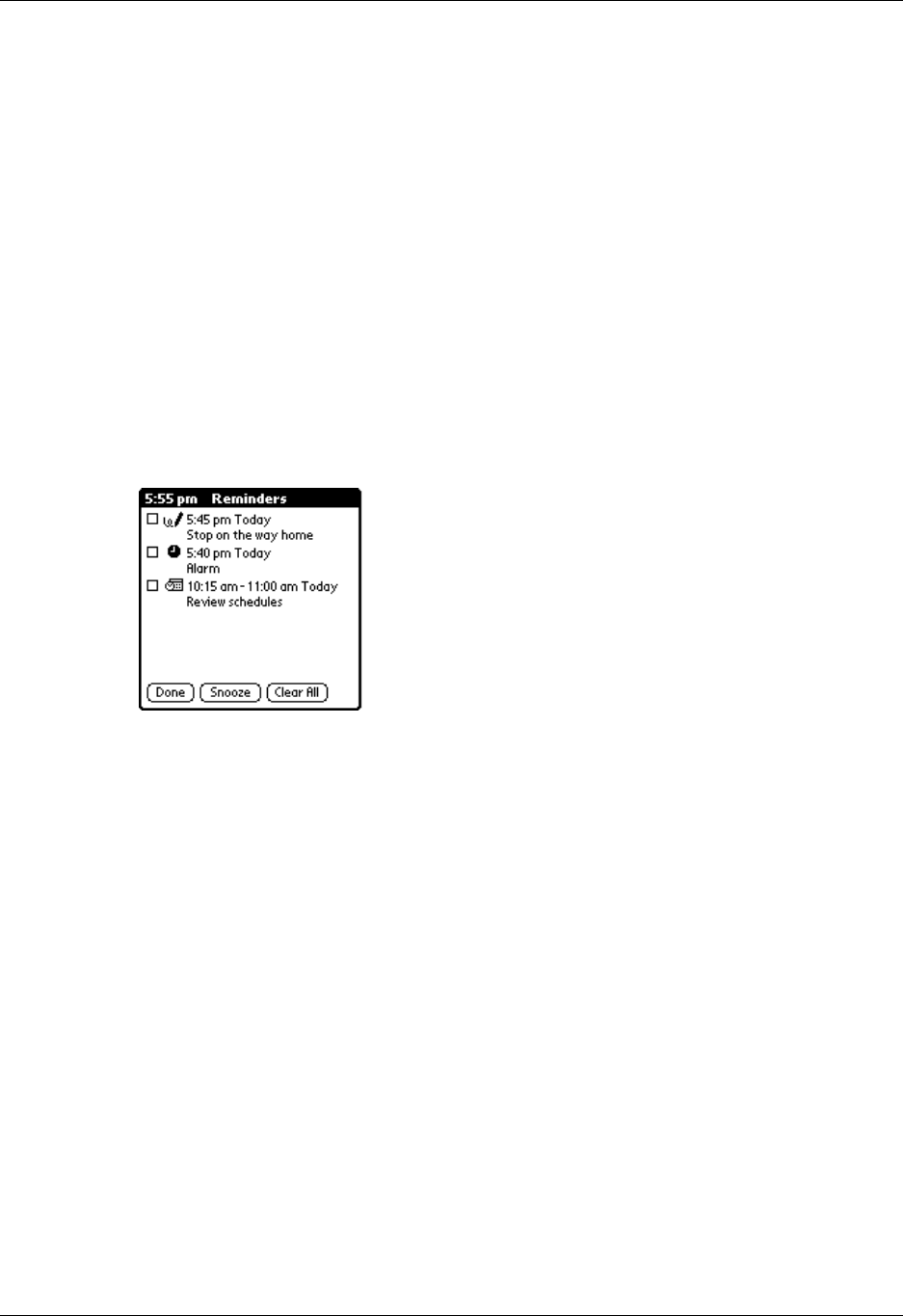
Performing common tasks
65
Receiving and alerts
You can receive alerts on your handheld and in Palm Desktop software.
Receiving alerts on your handheld
When you use certain application settings, your handheld can alert you to any of
the following:
■An appointment set in Date Book
■A note created in Note Pad
■A voice memo created in Voice Memo
■An alarm set in World Clock
When an alert occurs, your handheld displays a reminder message. If you tap
Snooze in response to an alert message, your handheld reminds you of the item
again in five minutes. The Reminder screen displays alerts that await attention.
To respond to alerts, do one of the following:
■Select an item’s check box to clear the item.
■Tap an item (either the icon or the text description) to open the application
where the alarm was set. The application opens to the entry associated with the
alarm.
■Tap Done to close the reminder list and return to the current screen. An
attention indicator will blink in the upper-left corner of the screen; tap it to view
the alert list again.
■Tap Snooze to see the list again in five minutes.
If you tap Done or Snooze and view the reminder list later, the current time
appears in the Reminder bar and the original alert time appears with each list
item.
■Tap Clear All to dismiss all alerts in the list.
Palm, Inc. Confidential

Chapter 4 Working with Applications
66
Receiving alerts from Palm Desktop software
You can also set an option to receive Date Book event alerts from Palm Desktop
software. The feature is disabled by default, so you must enable it within Palm
Desktop software.
To enable an event alert from Palm Desktop software:
1. Double-click the Palm Desktop icon.
2. From the Tools menu, select Options, and then select Alarms.
3. Set Alarm Configuration options, either Always Available or Available only
when the Palm Desktop is running.
4. (Optional) To hear an alert sound as well as receive an alert message, select the
check box Play audible notification with alarm dialog box.
5. Click OK.
Hiding or masking private records
You can use the Security application to set a password and select whether to mask
your private records or hide them completely. See “Security Preferences” in
Chapter 17 for details.
Installing and removing applications
This section explains how to install and remove applications on your handheld or
on an expansion card, and how to remove Palm Desktop software from your
computer.
Installing add-on applications
Your handheld comes with applications installed and ready to use, but you can
also install additional applications, such as games and other software, on your
handheld or on a card that is seated in the expansion card slot. Applications or
games that you install on your handheld reside in RAM memory, and you can
delete them at any time.
The Install Tool makes it easy to install software during a HotSync operation. There
are a variety of third-party applications available for your handheld. To learn more
about these applications, go to the web site: www.palm.com.
NOTE Palm works with developers of third-party add-on applications to ensure the
compatibility of these applications with your new Palm handheld. Some third-party
applications, however, may not have been upgraded to be compatible with your new
Palm handheld.
If you suspect that a third-party application is adversely affecting the operation of
your handheld, contact the developer of the application. In addition, Palm, Inc. has
information about some applications' compatibility with your handheld. To find this
information, do one of the following:
Palm, Inc. Confidential
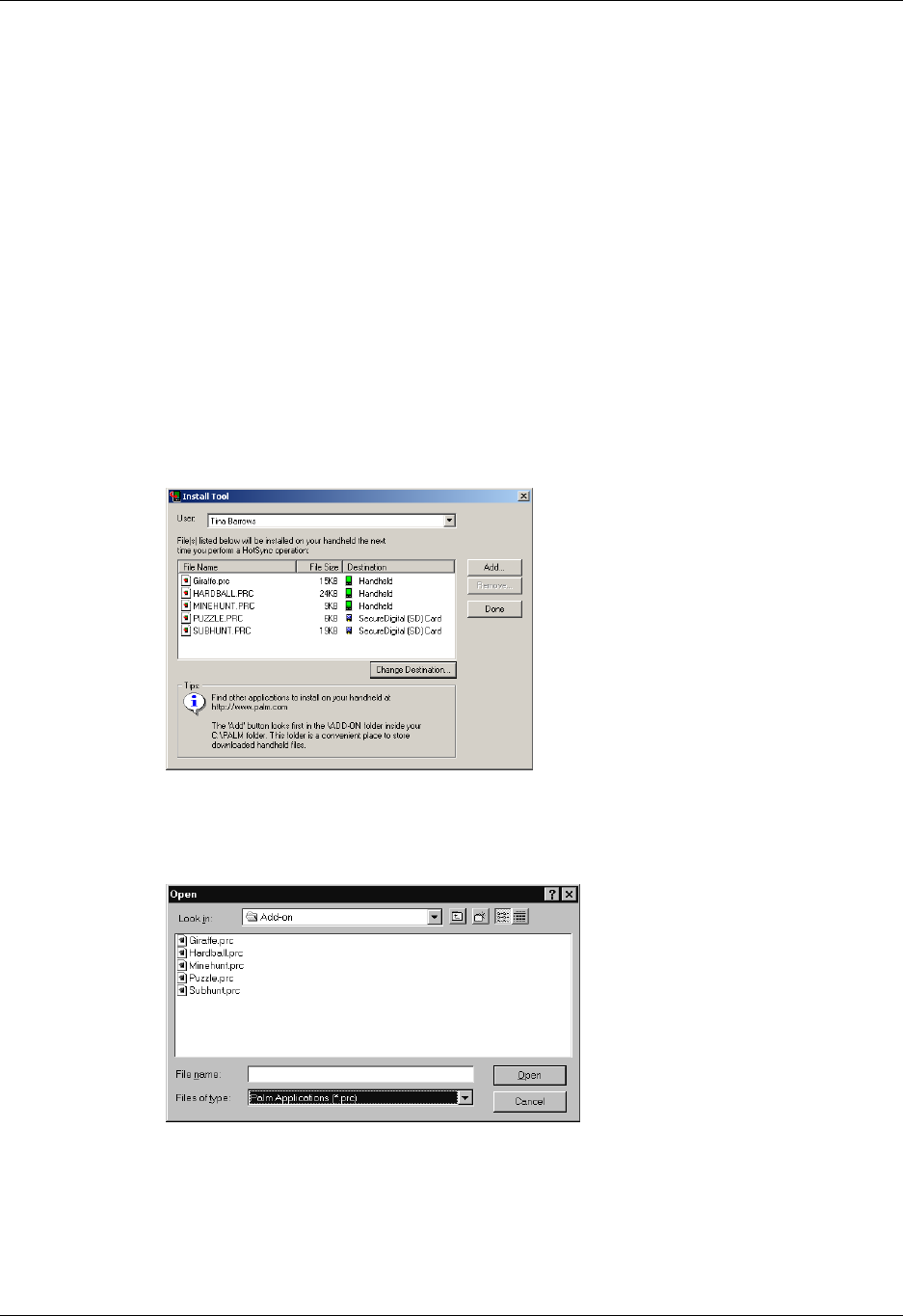
Installing and removing applications
67
■Go to www.palm.com/support. Click the link for information about your handheld,
and then find the information on compatibility of third-party applications.
■Read the readme file for your handheld. After you install Palm Desktop software
on your computer, open the Palm folder. The readme file is located in the Helpnote
folder.
To install add-on software on your handheld using a Windows computer:
1. On your computer, copy or download the application you want to install into
the add-on folder in your Palm Desktop directory on your computer.
2. Double-click the Palm Desktop icon on your desktop.
3. Click Install.
TIP You can also access the Install Tool dialog box by selecting Install Tool
from the Palm Desktop program group or by double-clicking any file with a
PRC, PDB, PQA, PNC, or SCP file extension.
4. In the User drop-down list, select the name that corresponds to your handheld.
5. Click Add.
6. Select the application(s) that you want to install.
7. Click Open.
Palm, Inc. Confidential
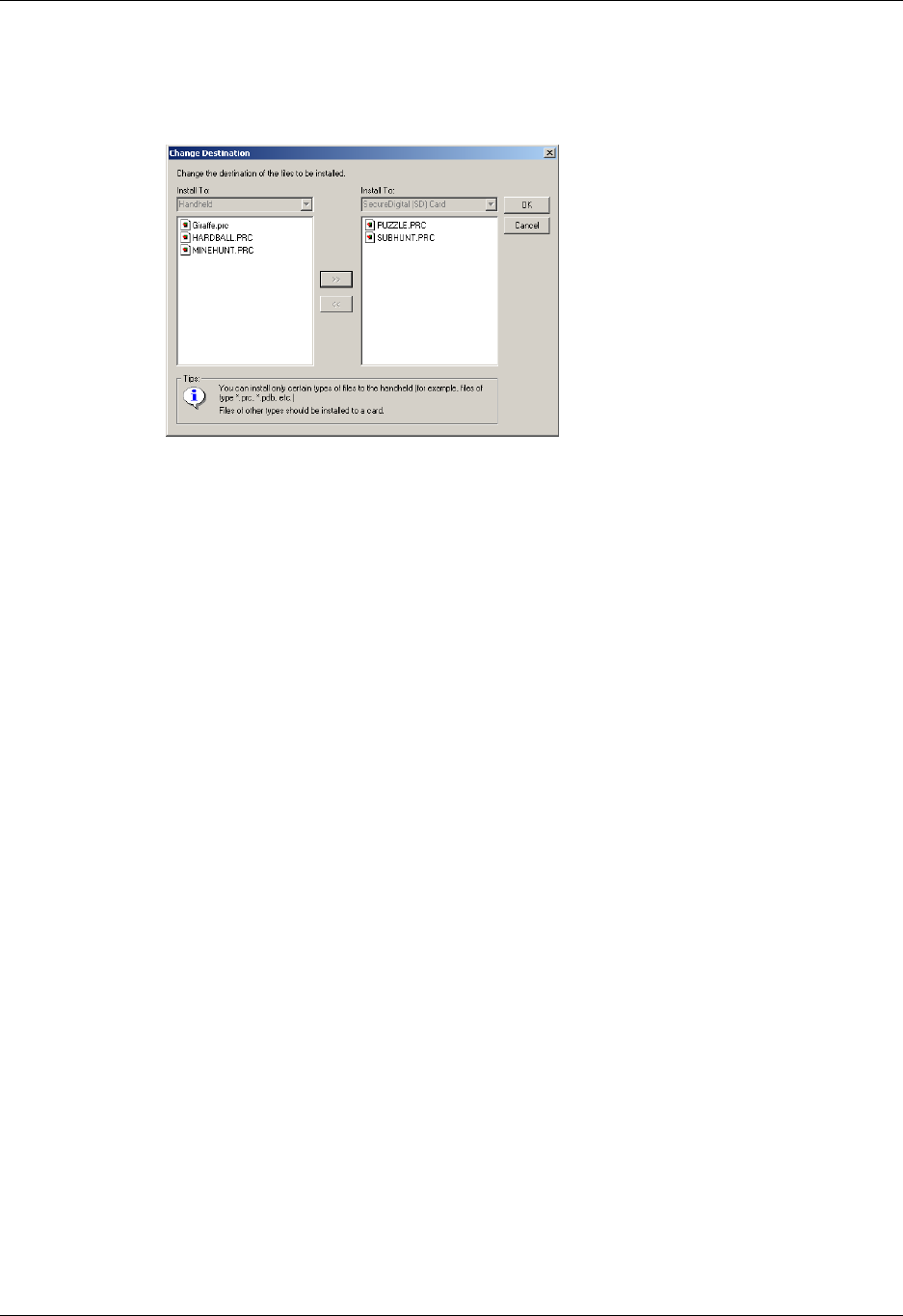
Chapter 4 Working with Applications
68
8. If you need to change the destination of the application you are installing, click
Change Destination on the Install Tool window, and then use the arrows to
move applications between your handheld and an expansion card.
9. Click OK to close the Change Destination window.
10. Click Done to close the Install Tool window.
11. Perform a HotSync operation to install the selected application(s).
See “Conducting cradle/cable HotSync operations” in Chapter 16 for details.
NOTE Files that remain in the list after you perform a HotSync operation were
not installed. This can happen if the file type was not recognized during the
HotSync operation. Expansion cards may hold applications that use files other
than the Palm™ application files. For your handheld to recognize such a file,
you must first launch the associated application at least once.
To install add-on software on your handheld using a Mac computer:
1. On your Mac computer, copy or download the application you want to install
into the Add-on folder in your Palm folder.
2. Double-click the HotSync Manager icon in the Palm folder.
3. From the HotSync menu, select Install Handheld Files.
Palm, Inc. Confidential
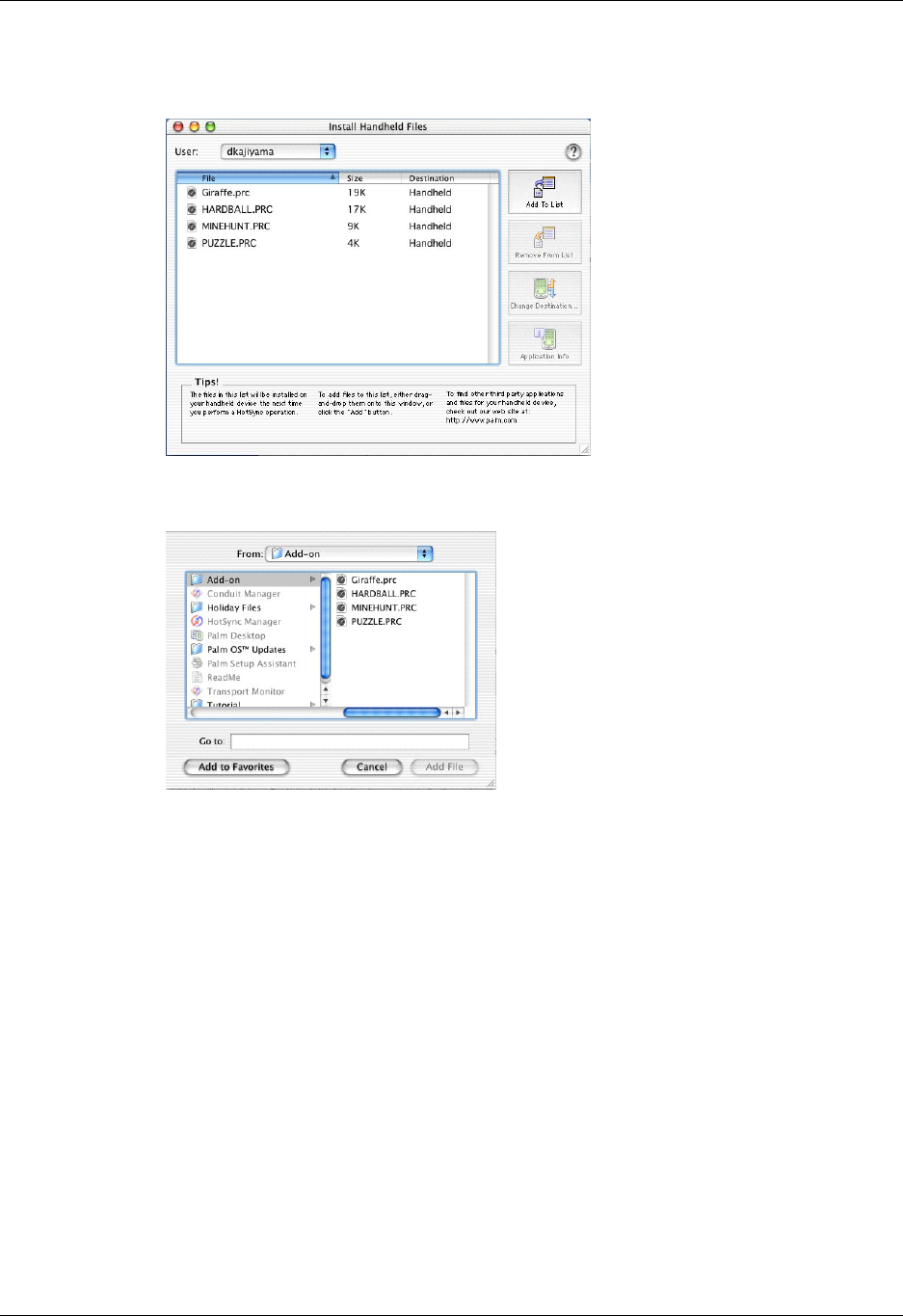
Installing and removing applications
69
4. From the User pop-up menu, select the name that corresponds to your
handheld.
5. Click Add To List.
If the file you want to install is not listed in the dialog box, go to the folder to
which you copied the file. Most handheld application files have the extension
PRC, PDB, PQA, or SCP.
6. Select the application(s) you want to install.
7. Click Add File to add the selected application to the Install Handheld Files list.
TIP You can also drag files or folders of files to the list in the Install Handheld
Files dialog box. The files are copied to the Files To Install folder.
Palm, Inc. Confidential

Chapter 4 Working with Applications
70
8. If you need to change the destination of the application you are installing, click
Change Destination in the Install Handheld Files window, and then use the
arrows to move applications between your handheld and an expansion card.
9. Click OK to close the Change Destination window.
10. Close the Install Handheld Files window.
11. Perform a HotSync operation to install the selected application(s) on your
handheld. See “Conducting cradle/cable HotSync operations” in Chapter 16
for details.
NOTE Files that remain in the list after you perform a HotSync operation were
not installed. This can happen if the file type was not recognized during the
HotSync operation. Expansion cards may hold applications that use files other
than the Palm application files. For your handheld to recognize such a file, you
must first launch the associated application at least once.
Removing applications
If you run out of memory or decide that you no longer need an application you
installed, you can remove applications from your handheld or from an expansion
card. From your handheld, you can remove only add-on applications, patches, and
extensions that you install; you cannot remove the applications that reside in the
ROM portion of your handheld.
To remove an add-on application:
1. Tap the Home icon .
2. Tap the Menu icon .
3. Select Delete on the App menu.
4. Tap the Delete From pick list and select either Handheld or Card. If you want
to delete applications from a card, the card must be seated in the expansion
card slot.
Palm, Inc. Confidential

Installing and removing applications
71
5. Tap the application that you want to remove.
6. Tap Delete.
7. Tap Yes.
8. Tap Don e .
Removing Palm Desktop software
If you no longer want to use Palm Desktop software, you can remove it from your
computer.
This process removes only the application files. The data in your Users folder
remains untouched.
NOTE You may need to modify the steps shown here to accommodate the version
of the operating system installed on your computer.
To remove Palm Desktop software from a Windows computer:
1. From the Windows Start menu, select Settings and then click Control Panel.
2. Double-click the Add/Remove Programs icon.
3. Click the Change or Remove Programs button.
4. Select Palm Desktop.
5. Click Change/Remove.
This process removes only the application files. The data in your Users folder
remains untouched.
6. Click Yes in the Confirm File Deletion box.
7. Click OK.
8. Click Close.
NOTE If you want to synchronize data with another personal information manager
(PIM) you need to install the HotSync Manager from the Desktop Software CD-ROM.
During the installation select the Custom option and then choose to install only
HotSync Manager.
Palm, Inc. Confidential

Chapter 4 Working with Applications
72
To remove Palm Desktop software from a Mac computer:
1. Insert the Desktop Software CD-ROM in the CD-ROM drive on your computer.
2. Double-click the Desktop Software CD-ROM icon on your desktop.
3. Double-click the Palm Desktop Installer icon.
4. From the Easy Install screen, select Uninstall from the pop-up menu.
5. Select the software you want to remove.
6. Click Uninstall.
7. Select the folder that contains your Palm Desktop software files.
8. Click Remove.
9. Restart your computer.
Palm, Inc. Confidential

73
CHAPTER 5
Using Address Book
Address Book enables you to keep names, addresses, phone numbers, and
other information about your personal or business contacts. Use Address
Book to do the following:
■Quickly look up or enter names, addresses, phone numbers, and other
information. See “Finding information” in Chapter 4 for details.
■Enter up to five phone numbers (home, work, mobile, fax, and so on) or e-mail
addresses for each name.
■Define which phone number appears in the Address list for each Address Book
entry.
■Attach a note to each Address Book entry, in which you can enter additional
information about the entry.
■Assign Address Book entries to categories so that you can organize and view
entries in logical groups.
■Create your own digital business card that you can beam to other devices with
an infrared (IR) port and an application that can read the data.
To open Address Book:
■Press the Address Book application button on the front panel of your handheld.
Address Book opens to display the list of all your records.
TIP Press the Address Book application button repeatedly to cycle through the
categories in which you have records. You can also press and hold the Address Book
application button to instantly beam your business card to another device with an IR
port. The receiving device must also have an application that can read the Address
Book data.
Address Book button
Palm, Inc. Confidential
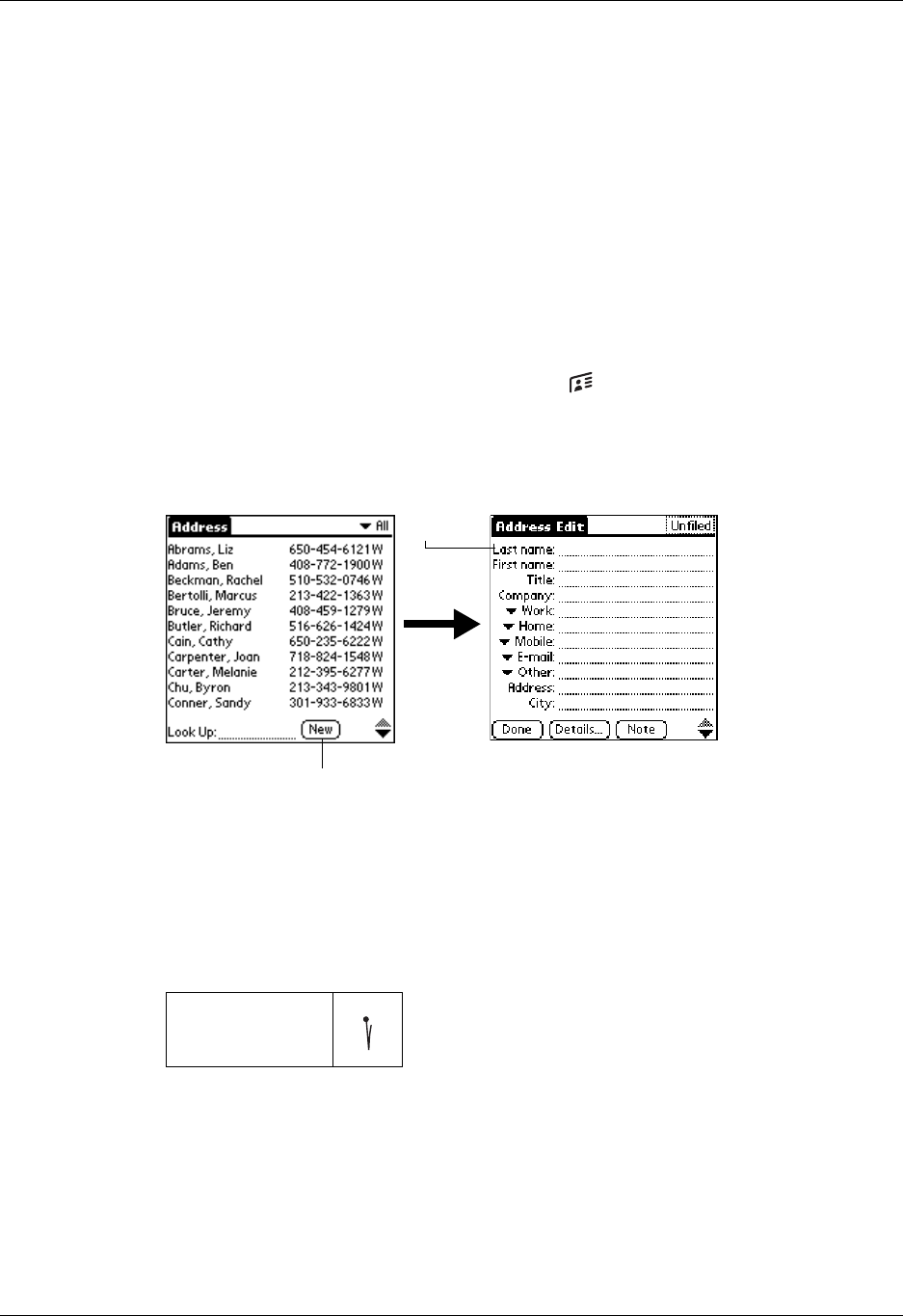
Chapter 5 Using Address Book
74
Creating an Address Book entry
A record in Address Book is called an entry. You can create entries on your
handheld, or you can use Palm™ Desktop software to create entries on your
computer and then transfer the entries to your handheld with your next HotSync®
operation.
Palm Desktop software also has data import capabilities so that you can load
database files into Address Book on your handheld.
See “Importing data” in Chapter 3 and Palm Desktop online Help for more
information.
To create a new Address Book entry:
1. Press the Address Book application button on the front of your handheld to
display the Address list.
2. Tap N ew.
3. Enter the last name of the person you want to add to your Address Book.
The handheld automatically capitalizes the first letter of each field (except
numeric and e-mail fields). You do not have to use the Graffiti® capital stroke to
capitalize the first letter of the name.
4. Use the Next Field Graffiti stroke to move to the First Name field.
TIP You can also move to any field by tapping it directly.
5. Enter the first name of the person in the First Name field.
6. Enter the other information that you want to include in this entry.
As you enter letters in the Title, Company, City, and State fields, text appears for
the first logical match that exists in your Address Book. As you enter more
Next Field
Ta p N e w
C
ursor
at Last
name
Palm, Inc. Confidential
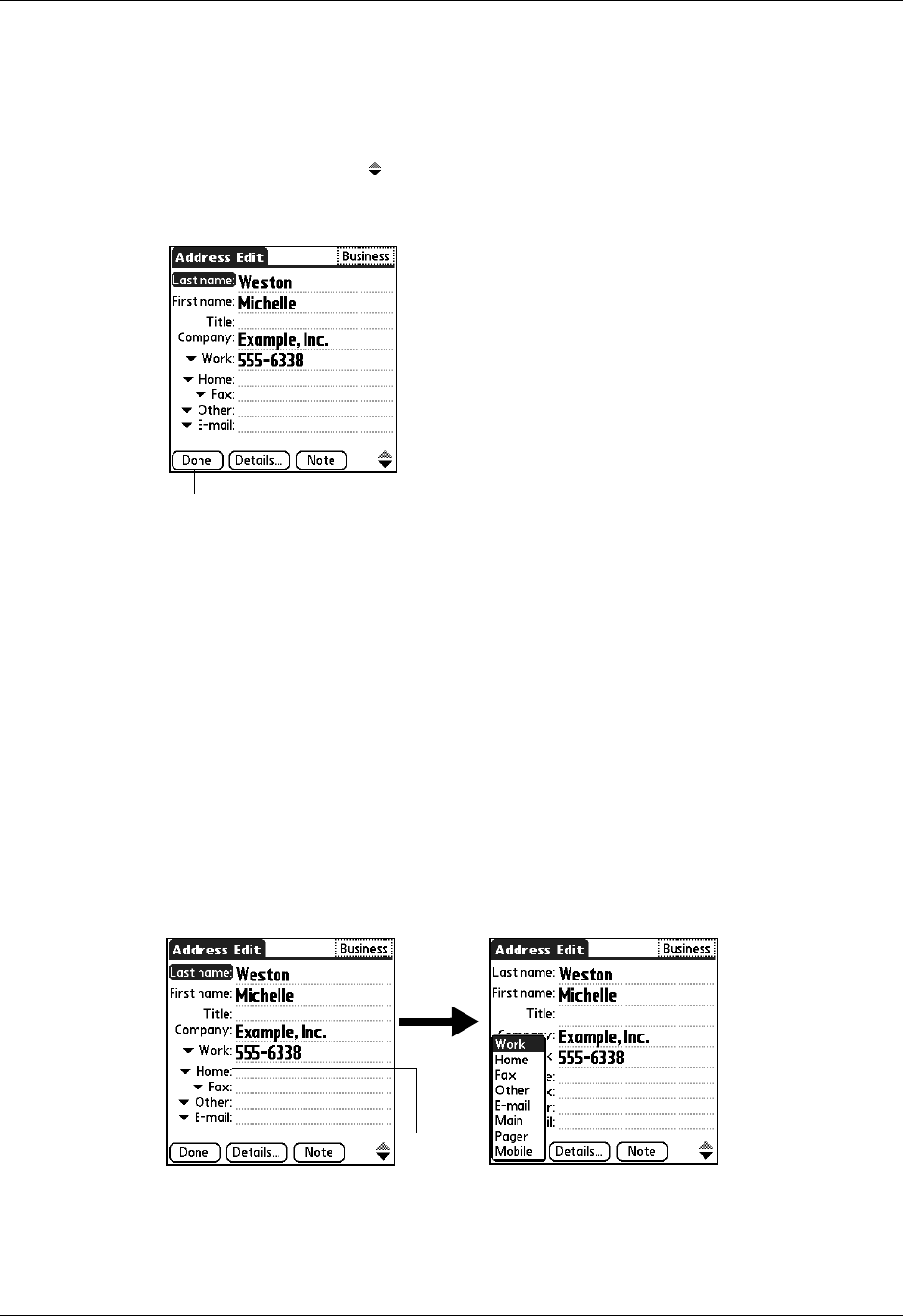
Creating an Address Book entry
75
letters, a closer match appears. For example, you may already have Sacramento
and San Francisco in your Address Book. As you enter S, Sacramento appears,
and as you continue entering a and n, San Francisco replaces Sacramento. As
soon as the word you want appears, tap the next field to accept the word.
7. Tap the scroll arrows to move to the next page of information.
8. After you finish entering information, tap Done.
TIP To create an entry that always appears at the top of the Address list, begin the
Last name or Company field with a symbol, as in *If Found Call*. This entry can
contain contact information in case you lose your handheld.
Selecting types of phone numbers
You can select the types of phone numbers or e-mail addresses that you associate
with an Address Book entry. Any changes you make apply only to the current
entry.
To select other types of phone numbers in an entry:
1. Tap the entry that you want to change.
2. Tap Edit.
3. Tap the pick list next to the label you want to change.
4. Select a new label.
Tap Done
Ta p
triangle
Palm, Inc. Confidential
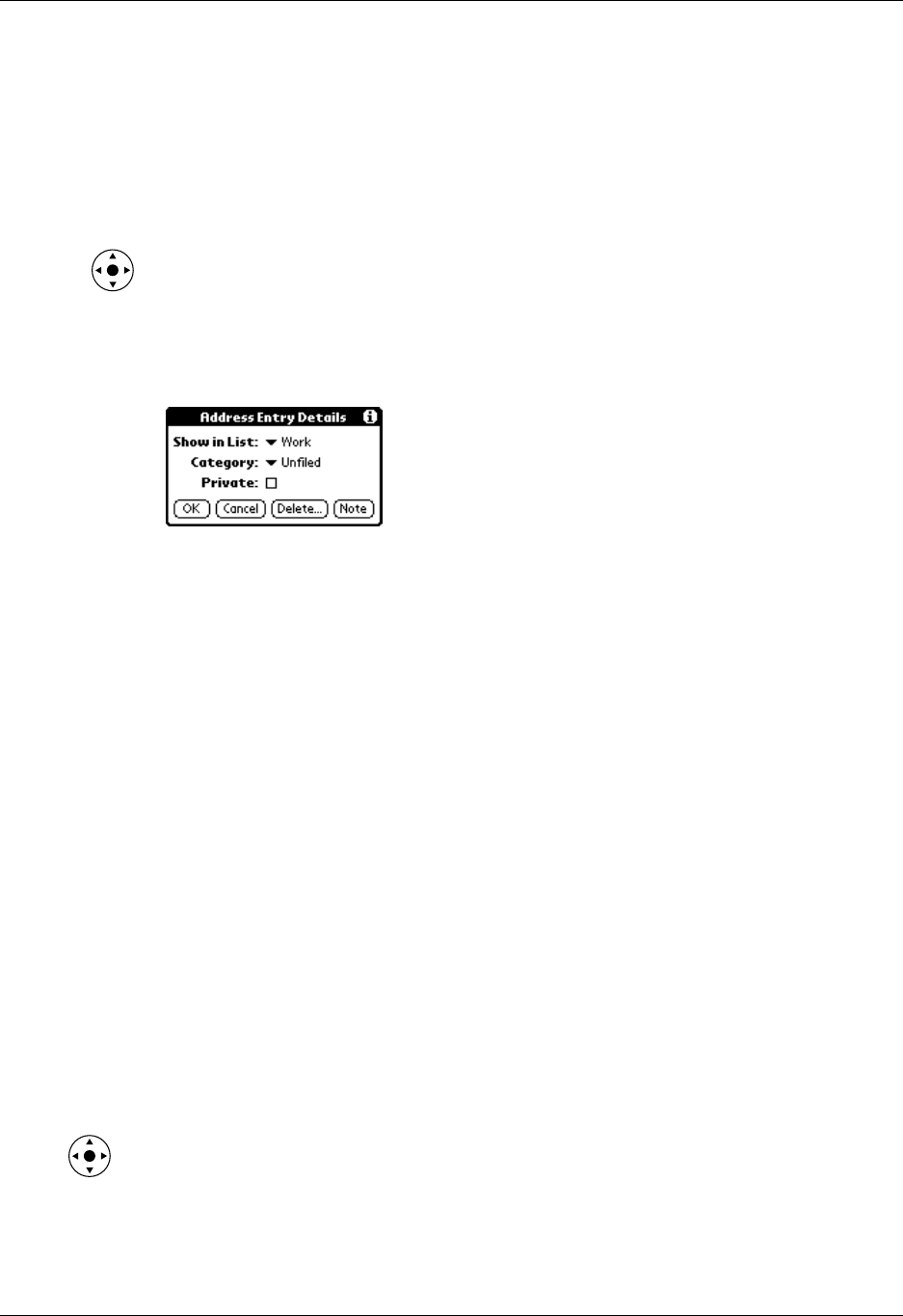
Chapter 5 Using Address Book
76
Changing Address Entry details
The Address Entry Details dialog box provides a variety of options that you can
associate with an entry.
To open the Address Entry Details dialog box:
1. Tap the entry whose details you want to change.
TIP You can also use the navigator to open an Address entry. See “Using the
navigator” in Chapter 2 for instructions.
2. Tap Edit.
3. Tap Details.
4. Select any of the following settings:
Making connections from Address Book
You can use the entries in your Address Book to launch applications that perform
tasks such as dialing a phone number or creating an e-mail or SMS message.
Some of the applications you can launch are included on the Software Essentials
CD-ROM that comes with your handheld, and others may be available from third-
party developers and are sold separately. Most of these applications require a GSM
mobile phone or an optional modem accessory that is compatible with your
handheld (mobile phone and modem accessory sold separately).
Quick Connect
You can use Quick Connect to select an entry and initiate a related task with one
hand, using the navigator. You can also configure which application opens when
you choose a specific Address record field, and whether to add a prefix to all phone
numbers.
Show in List Select which type of phone or other information appears in
the Address list screen. Your options are Work, Home, Fax,
Other, E-mail, Main, Pager, and Mobile. The identifying
letters W, H, F, O, M, or P appear next to the record in the
Address list, depending on which information is displayed.
If you select E-mail, no identifying letter is displayed.
Category Assign the entry to a category.
Private Hide this entry when Security is turned on.
Palm, Inc. Confidential
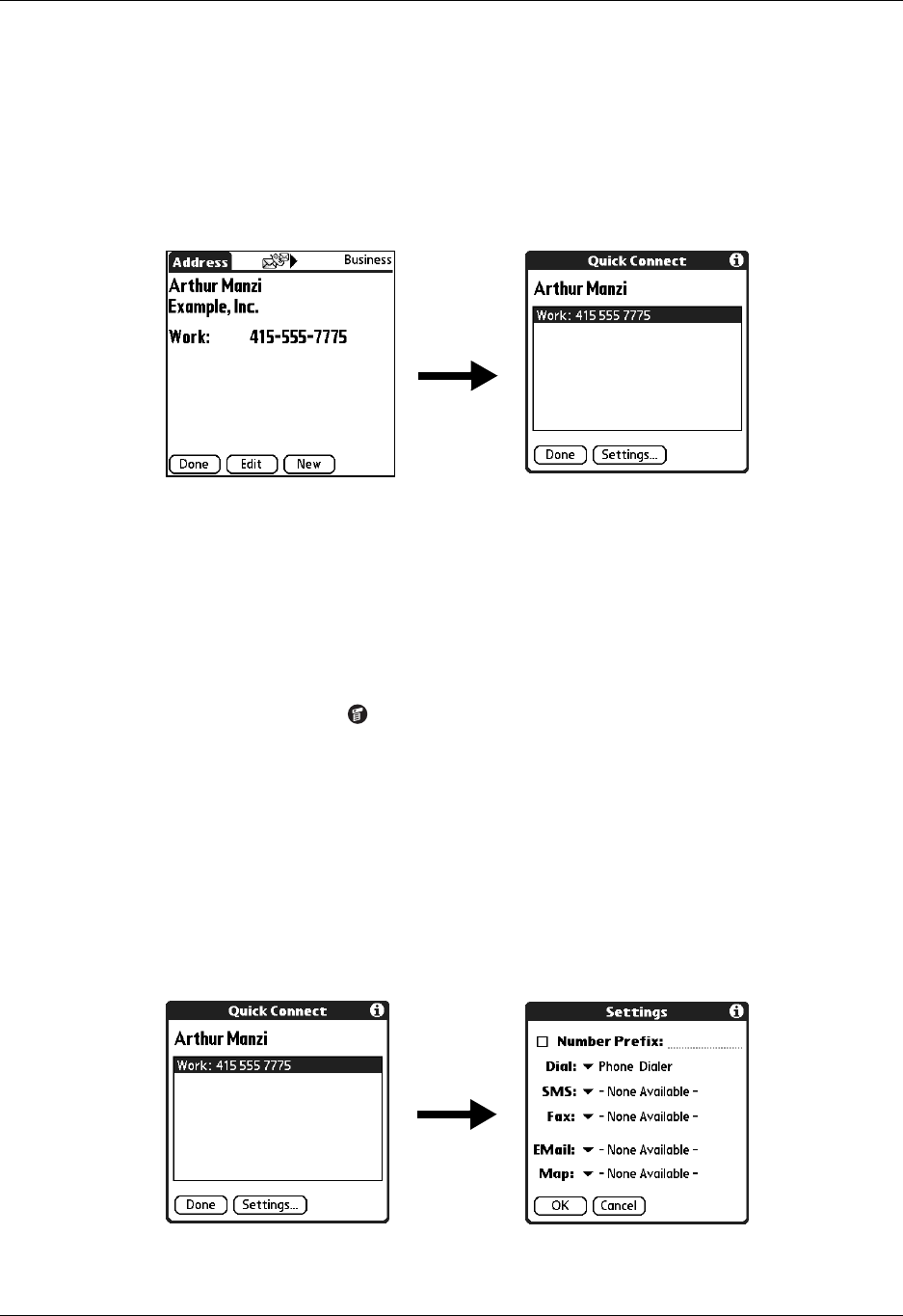
Creating an Address Book entry
77
To use Quick Connect from an Address entry:
1. Open the Address entry to which you want to connect.
2. Press Right on the navigator to open the Quick Connect dialog box.
TIP You can also tap the Quick Connect icon in the title bar of the Address
record.
3. Select the method you want to use to connect.
Quick Connect initiates the related task. For example, if you tap a phone
number, Quick Connect sends the selected phone number to your mobile
phone.
To use Quick Connect from the Address list:
1. Highlight the Address entry to which you want to connect.
2. Tap the Menu icon .
3. Select Connect on the Record menu.
4. Select the method you want to use to connect.
Quick Connect initiates the related task. For example, if you tap a phone
number, Quick Connect sends the selected phone number to your mobile
phone.
To configure Quick Connect settings:
1. From the Quick Connect dialog box, tap Settings.
Palm, Inc. Confidential
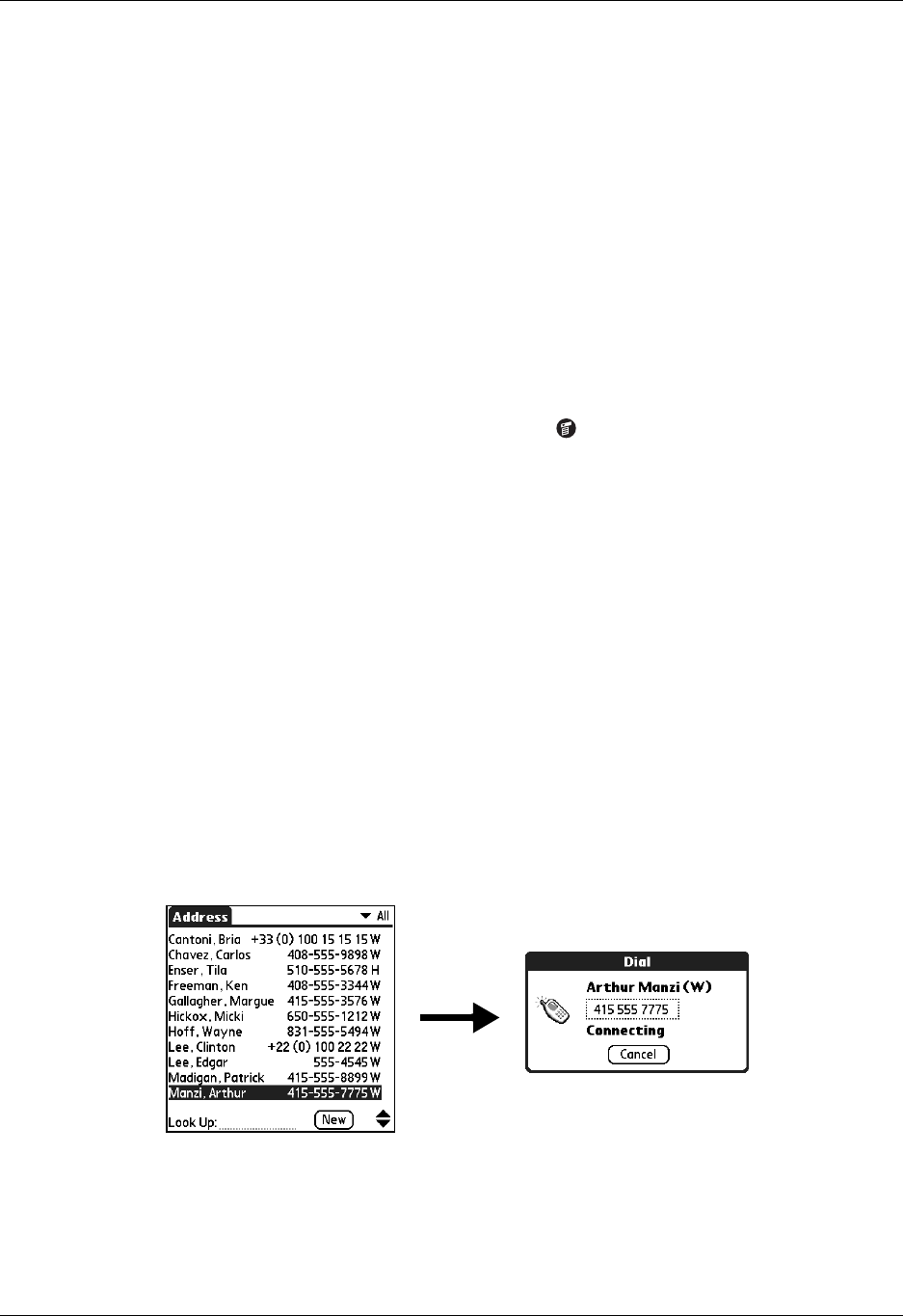
Chapter 5 Using Address Book
78
2. (Optional) Tap the Number Prefix check box and enter a prefix.
For example, to dial 1 before all phone numbers, select this check box and enter
a “1” in this field. The prefix is not added to a number that begins with the “+”
character.
3. Tap each of the pick lists and select the application you want to associate with
that task.
4. Tap OK.
Tap-to-Connect
With Tap-to-Connect you can select an entry and initiate a related task by tapping
it with the stylus. By default, Tap-to-Connect is not enabled.
To enable Tap-to-Connect:
1. From the Address list, tap the Menu icon .
2. Select Option, and then select Preferences.
3. Tap Enable Tap-to-Connect.
4. Tap OK.
TIP You can also configure which application opens when you tap a specific Address
record field, and whether to add a prefix to all phone numbers. See “Quick Connect”
earlier in this chapter to learn how to configure these settings.
To make a connection with Tap-to-Connect:
1. From the Address list, tap the entry to which you want to connect.
2. Tap an item.
For example, to dial a phone number, tap the number you want to dial. To
address an e-mail message, tap an e-mail address.
3. (Optional) Tap the number to edit it.
For example, you might want to add an area code, a “1,” or a country code
before a phone number.
Palm, Inc. Confidential
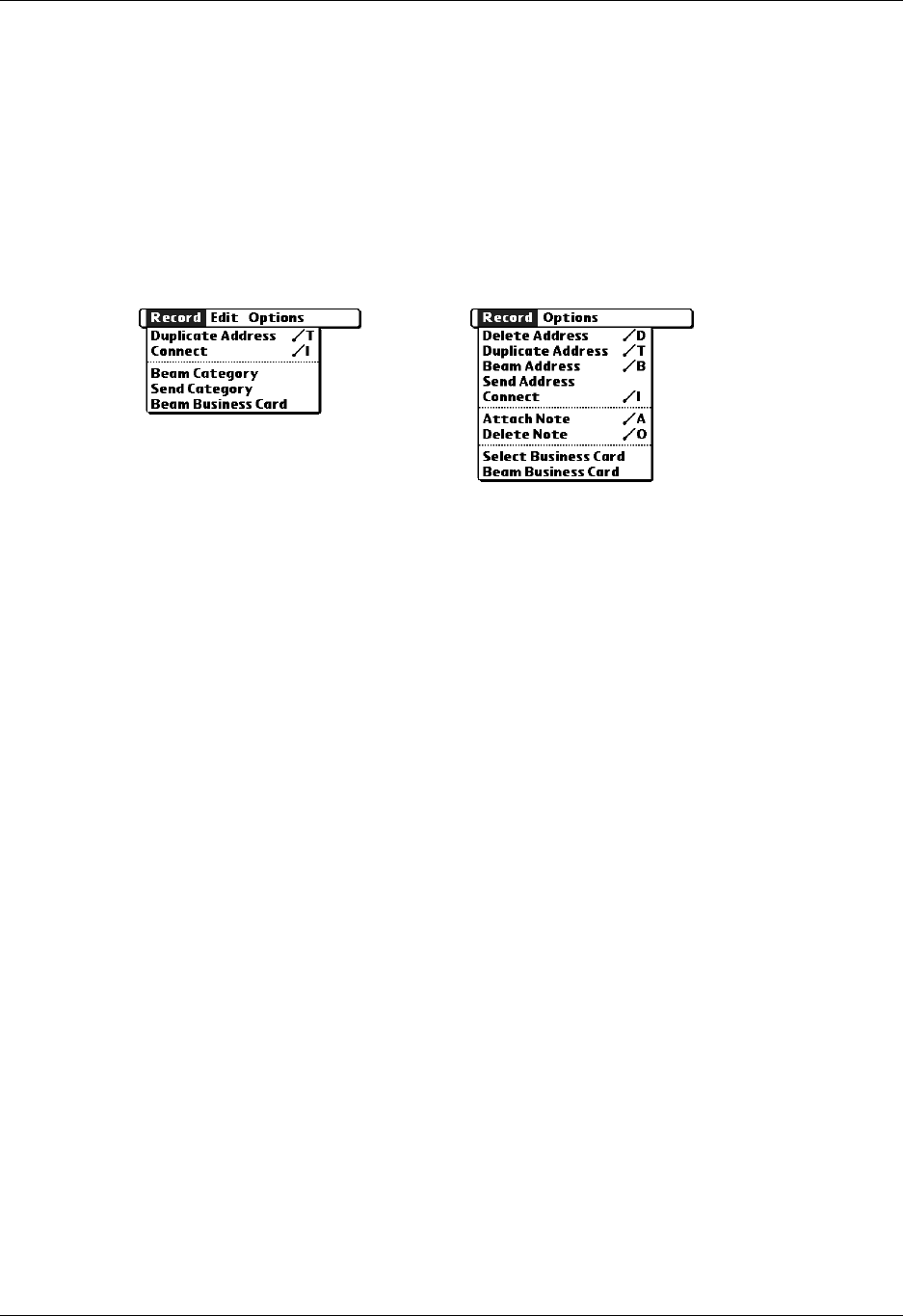
Creating an Address Book entry
79
Using Address Book menus
Address Book menus are shown here for your reference, and Address Book
features that are not explained elsewhere in this book are described here.
See “Using menus” in Chapter 4 for information about selecting menu commands.
The Record and Options menus differ depending on whether you’re displaying
the Address list screen or the Address view screen.
Record menus
Duplicate
Address Makes a copy of the current record and displays the copy in
Address Edit so you can make changes to the copied record. The
copy has the same category and attached notes as the original
record.
Connect Opens the Quick Connect dialog box, where you can choose
which application you want to use to make the connection.
Send Category Opens a dialog box where you can choose how you want to send
all records in the selected category to another device. The
options available depend on the software installed on your
handheld.
Send Address Opens a dialog box where you can choose how you want to send
the selected entry to another device. The options available
depend on the software installed on your handheld.
Address list
Address view
Palm, Inc. Confidential
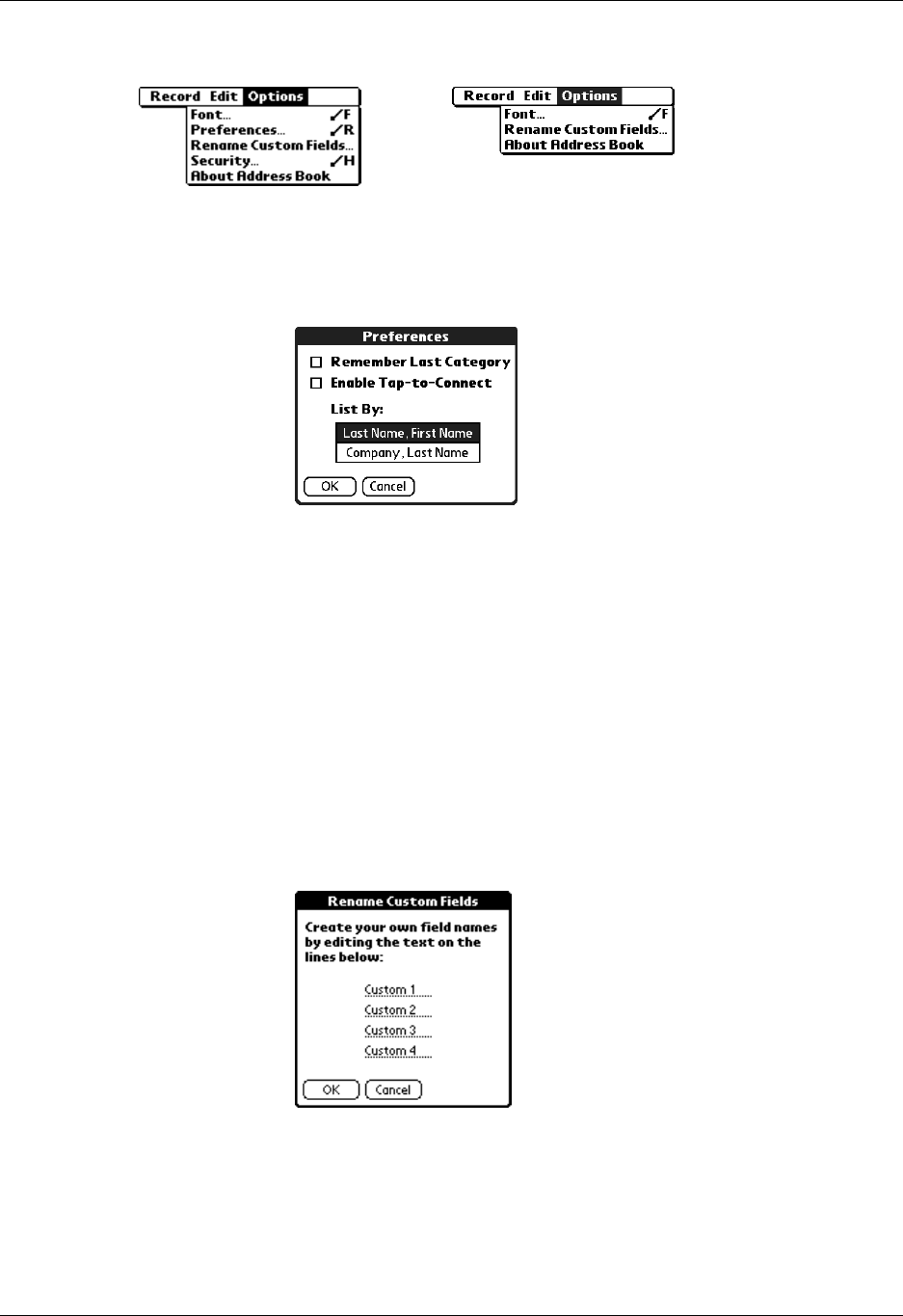
Chapter 5 Using Address Book
80
Options menus
Preferences Opens a dialog box where you can choose Address Book
display options.
Remember last category. Determines how Address Book
appears when you return to it from another application. If
you select this check box, Address Book shows the last
category you selected. If you deselect it, Address Book
displays the All category.
Rename Custom
Fields These custom fields appear at the end of the Address Edit
screen. Rename them to identify the kind of information
you enter in them. The names you give the custom fields
appear in all entries.
You can use these custom fields to track additional
information in your Address records such as names of
spouses, children, or any other details.
About Address
Book Shows version information for Address Book.
Address list
Address Edit view
Palm, Inc. Confidential
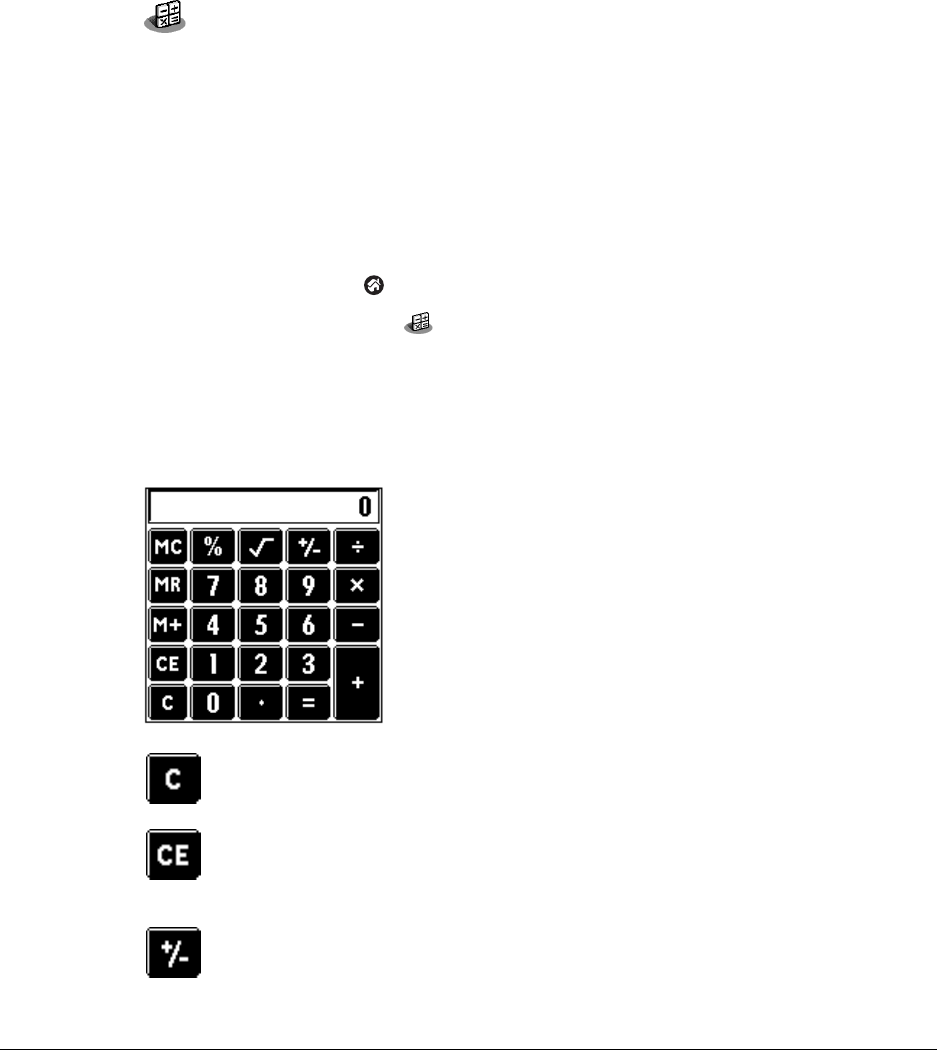
81
CHAPTER 6
Using Calculator
Calculator enables you to perform basic calculations. Use Calculator to do
the following:
■Perform addition, subtraction, multiplication, division, and square root
operations.
■Store and retrieve values.
■Display the last series of calculations, which is useful for confirming a series of
“chain” calculations.
To open Calculator:
1. Tap the Home icon .
2. Tap the Calculator icon .
Performing calculations
The Calculator includes several buttons to help you perform calculations.
Clears the entire calculation so that you can begin a fresh calculation.
Clears the last number you entered. If you make a mistake while
entering a number in the middle of a calculation, you can use this
button to reenter the number without starting the calculation over.
Toggles the current number between a negative and positive value.
If you want to enter a negative number, enter the number first and
then press the +/- button.
Palm, Inc. Confidential
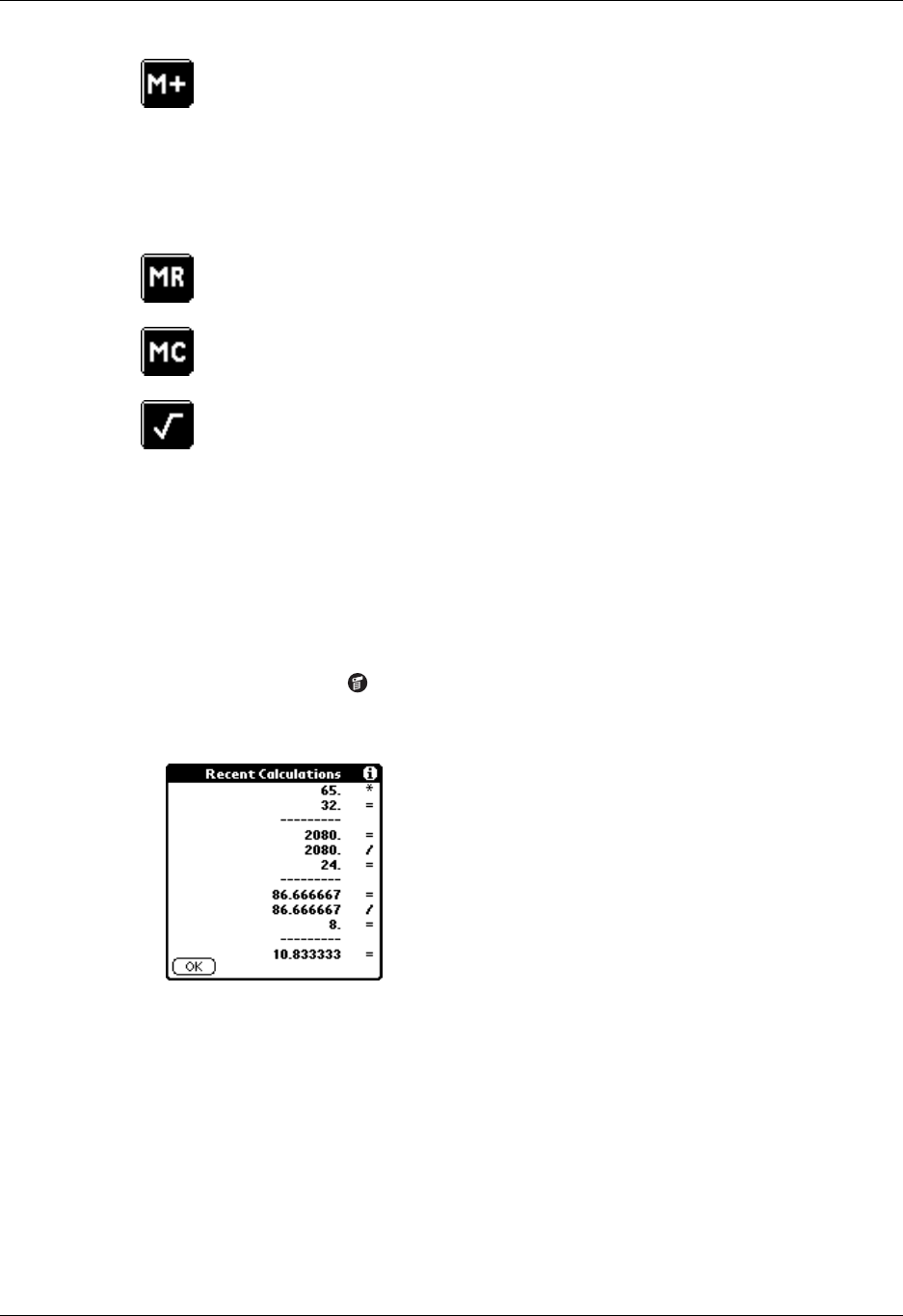
Chapter 6 Using Calculator
82
Viewing Recent Calculations
The Recent Calculations command enables you to review the last series of
calculations and is particularly useful for confirming a series of “chain”
calculations.
To display recent calculations:
1. Tap the Menu icon .
2. Select Options, and then select Recent Calculations.
3. After you finish reviewing the calculations, tap OK.
Places the current number into memory. Each new number you
enter with the M+ button is added to the total already stored in
memory. The number that you add can be either a calculated value
or any number you enter by pressing the number buttons. Pressing
this button has no effect on the current calculation (or series of
calculations); it merely places the value into memory until it is
recalled.
Recalls the stored value from memory and inserts it in the current
calculation.
Clears any value that is stored in the Calculator memory.
Calculates the square root of a number. Enter the number, and then
tap the square root button.
Palm, Inc. Confidential

Using Calculator menus
83
Using Calculator menus
The Calculator menu is shown here for your reference, and Calculator features that
are not explained elsewhere in this book are described here.
See “Using menus” in Chapter 4 for information about choosing menu commands.
Options menu
About Calculator Shows version information for Calculator.
Palm, Inc. Confidential

Chapter 6 Using Calculator
84
Palm, Inc. Confidential
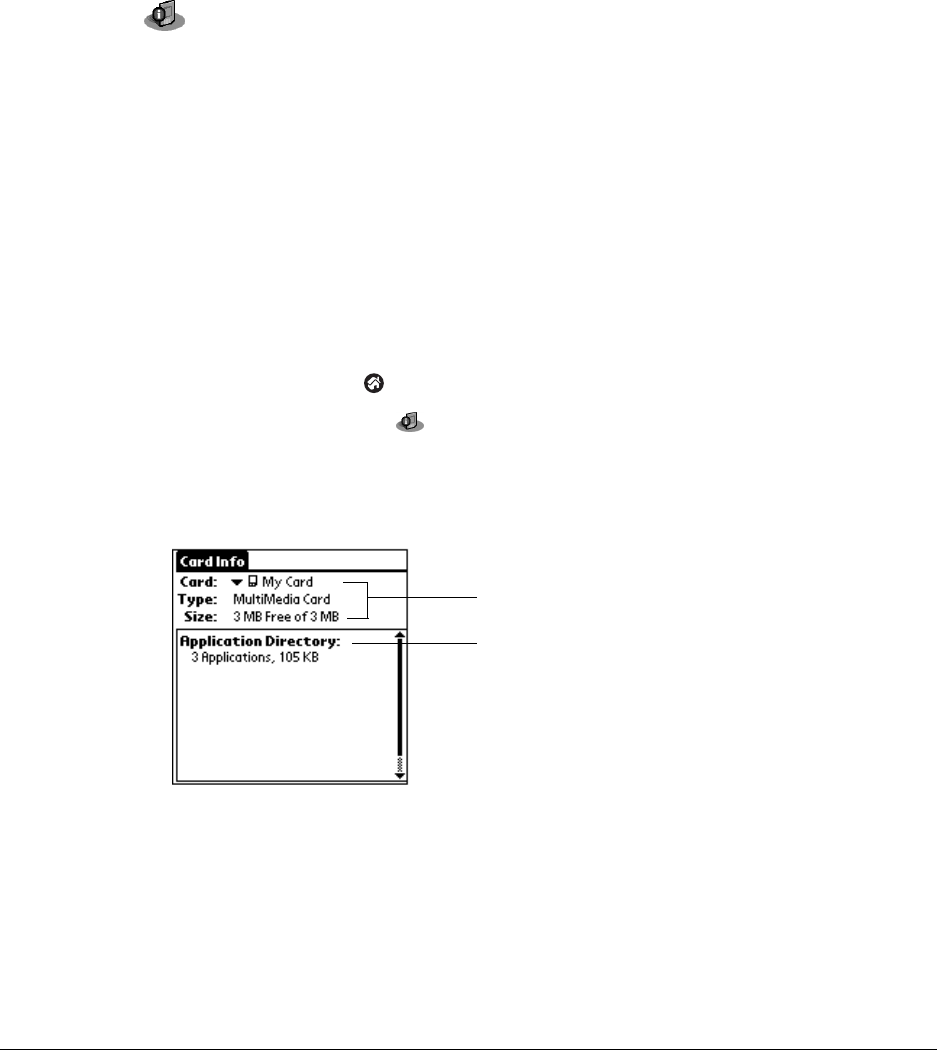
85
CHAPTER 7
Using Card Info
Card Info enables you to review general information about an expansion
card. Use Card Info to do the following:
■Review card contents.
■Rename a card.
■Format a card.
Reviewing Card Information
You can view the card name, type, available storage space, and a summary of its
contents.
To review Card Information:
1. Tap the Home icon .
2. Tap the Card Info icon .
3. Review Card name, Type, and Size.
4. Review card contents summarized by directory.
Review card information
Review summarized
card contents
Palm, Inc. Confidential
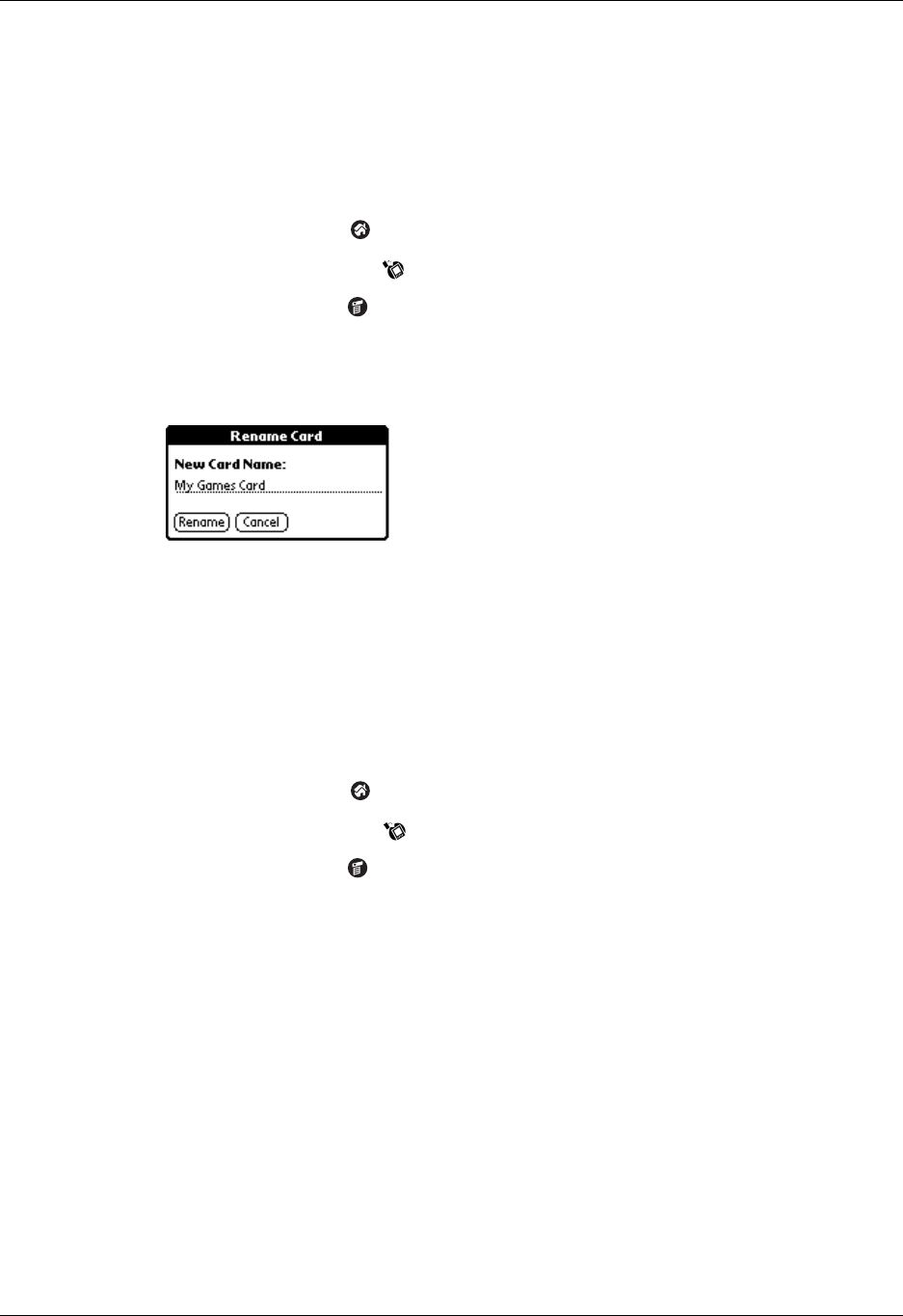
Chapter 7 Using Card Info
86
Renaming a card
The expansion card name appears in the Category pick list and other lists that
enable you to choose where to information on your handheld. You can assign a
name to each expansion card that indicates its contents.
To rename a card:
1. Tap the Home icon .
2. Tap the Card Info icon .
3. Tap the Menu icon .
4. Select Rename Card from the Card menu.
5. Enter the new name for the card.
6. Tap Rena me.
Formatting a card
Formatting a card destroys all its data and prepares it to accept new applications
and data.
To format a card:
1. Tap the Home icon .
2. Tap the Card Info icon .
3. Tap the Menu icon .
4. Select Format Card from the Card menu.
5. Tap OK.
Palm, Inc. Confidential
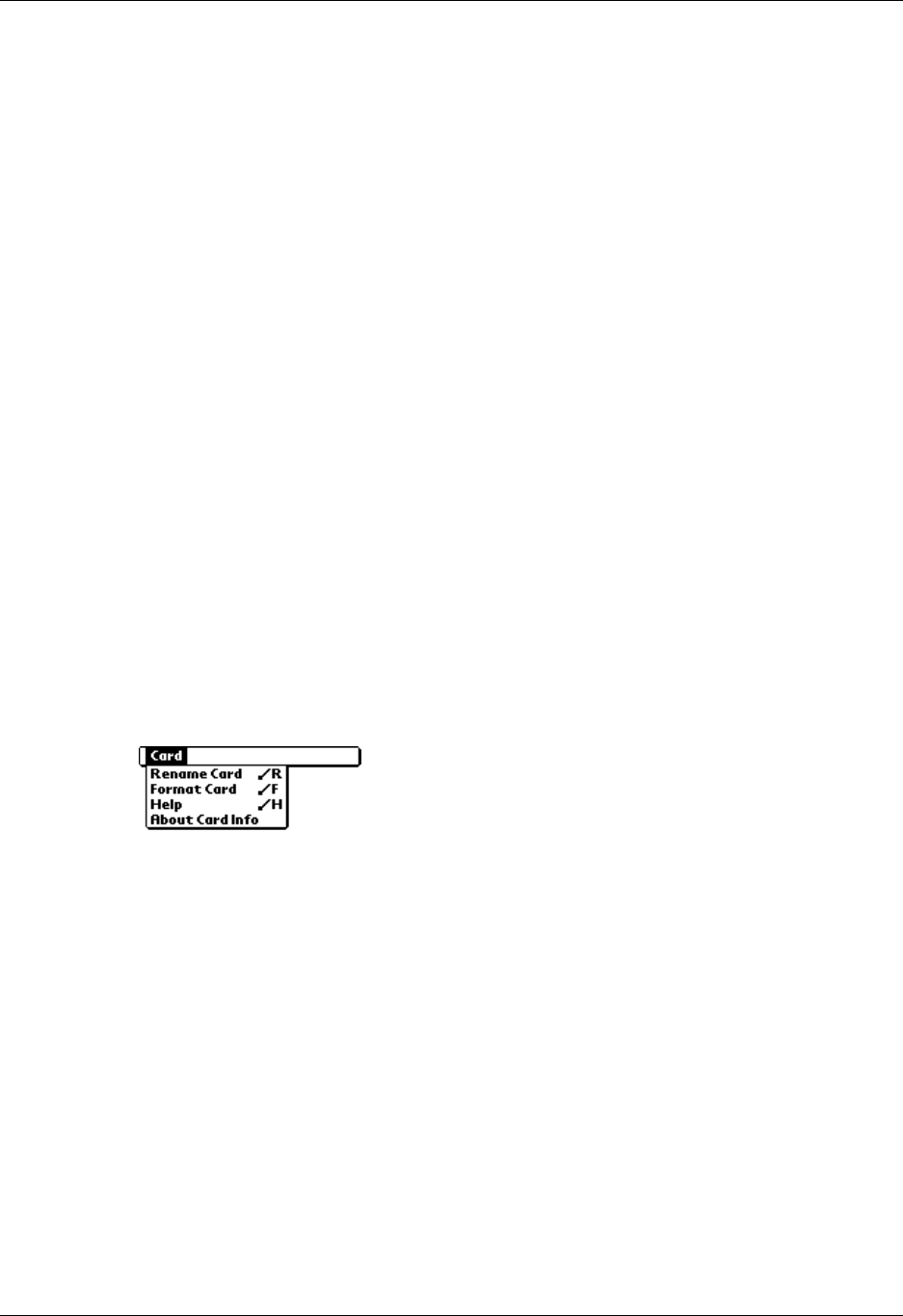
Managing expansion cards
87
Managing expansion cards
■When writing data to an expansion card, wait for your handheld to complete
the operation before removing the card from the slot. This prevents data
corruption or accidental damage to the expansion card.
■You can install applications to an expansion card after performing an initial
HotSync® operation. See “Installing add-on applications” in Chapter 4 for
information. For optimal performance, we recommend that you do not install
more than fifty applications to a single expansion card.
■Reading and writing information on an expansion card uses more battery
power than performing the same task on your handheld. If you have ample
storage space on your handheld, consider copying the information to your
handheld.
■When your handheld’s battery level becomes very low, access to the expansion
card may be disabled to protect your data. If this occurs, recharge your
handheld as soon as possible.
Using Card Info menus
The Card Info menu is shown here for your reference, and Card Info features that
are not explained elsewhere in this book are described here.
See “Using menus” in Chapter 4 for information about selecting menu commands.
Card menu
Help Provides help text.
About Card Info Shows version information for Card Info.
Palm, Inc. Confidential

Chapter 7 Using Card Info
88
Palm, Inc. Confidential

89
CHAPTER 8
Using Date Book
Date Book enables you to quickly and easily schedule appointments or any
kind of activity associated with a time and date. Use Date Book to do the
following:
■Enter a description of your appointment, and assign it to a specific time and
date.
■Display a chart of your appointments for an entire week. The Week View makes
it easy to spot available times and potential scheduling overlaps or conflicts.
■Display a monthly calendar to quickly spot days where you have morning,
lunch, or afternoon appointments.
■Display an agenda showing appointments, untimed events, and your To Do
items for the day.
■Set an alarm to notify you of the scheduled activity.
■Create reminders for events that are based on a particular date, rather than on
time of day. Birthdays and anniversaries are easy to track with your handheld.
■Attach notes to individual events for a description or clarification of the entry
in your Date Book.
To open Date Book:
■Press the Date Book application button on the front panel of your handheld.
Date Book opens to today’s schedule.
TIP Press the Date Book application button repeatedly to cycle through the
Day, Week, Month, and Agenda views.
When you open Date Book, the screen shows the current date and a list of times for
a normal business day.
Date Book button
Palm, Inc. Confidential
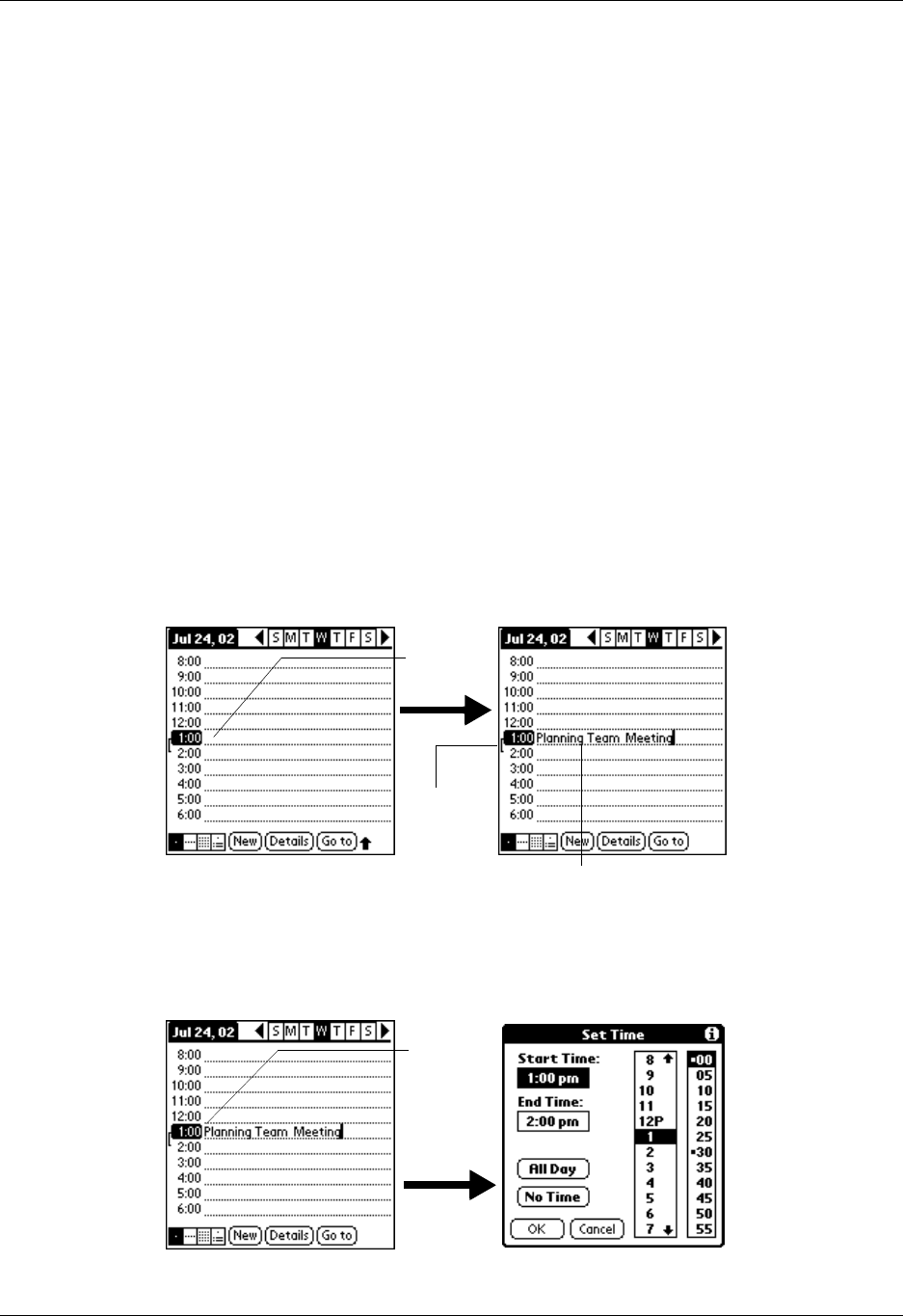
Chapter 8 Using Date Book
90
Scheduling an event
A record in Date Book is called an event. An event can be any kind of activity that
you associate with a day. You can enter a new event on any of the available time
lines.
When you schedule an event, its description appears on the time line, and its
duration is automatically set to one hour. You can easily change the start time and
duration for any event.
It’s possible to schedule events that overlap, but Date Book makes it easy to find
such conflicts. See “Spotting event conflicts” later in this chapter.
You can also schedule events in your Date Book that occur on a particular date but
have no specific start or end times, such as birthdays, holidays, and anniversaries.
These are referred to as “untimed events.” Untimed events appear at the top of the
list of times, marked with a diamond. You can have more than one untimed event
on a particular date.
You can also schedule a repeating event, such as a weekly meeting, and continuous
events, such as a three-day conference or a vacation.
To schedule an event for the current day:
1. Tap the time line that corresponds to the beginning of the event.
2. Enter a description of the event. You can enter up to 255 characters.
3. If the event is one hour long, skip to step 5. If the event is longer or shorter than
an hour, tap the time of the event to open the Set Time dialog box.
Ta p a
time line
Enter event
Time bar
shows
duration
Ta p t h e
time of an
event
Palm, Inc. Confidential
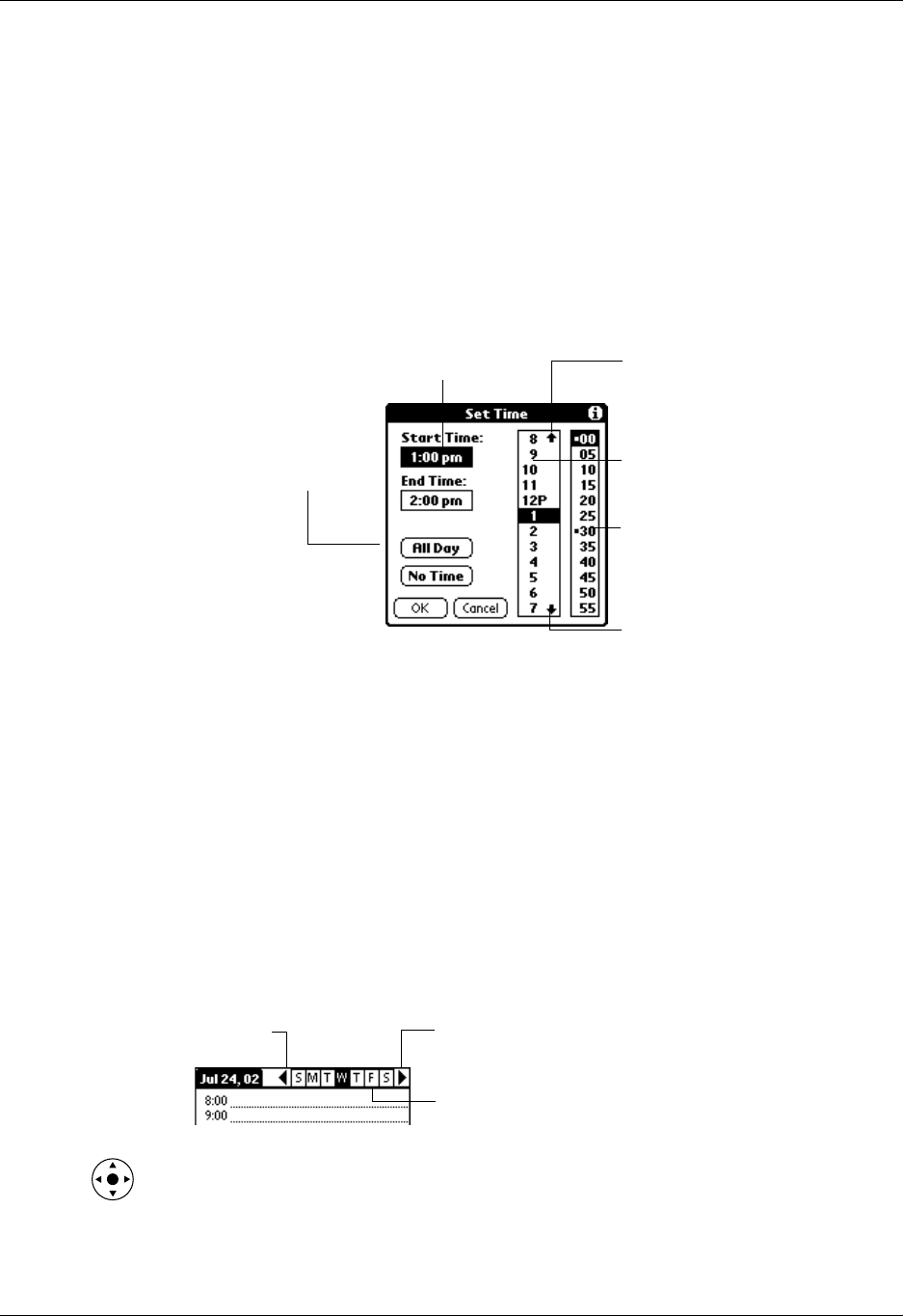
Scheduling an event
91
TIP You can also use the Graffiti® writing area to open the Set Time dialog box.
Make sure that no event is selected, and then on the number side of the
Graffiti® writing area, write a number for the start time of the event.
4. Do one of the following:
– Tap the time columns on the right side of the Set Time dialog box to set the
start time, and then tap the End Time box and tap the time columns to set the
end time.
– Tap All Day to automatically insert the start and end time of the event as
defined in your Date Book preferences.
5. Tap OK.
6. Tap a blank area of the screen to deselect the event. A vertical line appears next
to the time, indicating the duration of the event.
If two or more events have the same start and end time, the time appears only
once.
To schedule an event for another day:
1. Select the date you want for the event by doing one of the following:
– Tap the day of the week that you want in the date bar at the top of the screen.
If necessary, tap the Previous week or Next week scroll arrows to move to
another week.
– Press Right or Left on the navigator to scroll to the next or previous day.
S
tart
Ti
me
highlighted
T
ap to scro
ll
to
earlier hours
Tap to scroll to
later hours
Tap to change
hours
Tap to change
minutes
Tap to automatically
fill the start and end
times
P
rev
i
ous
week
N
ext
week
Tap to select a day of
the current week
Palm, Inc. Confidential
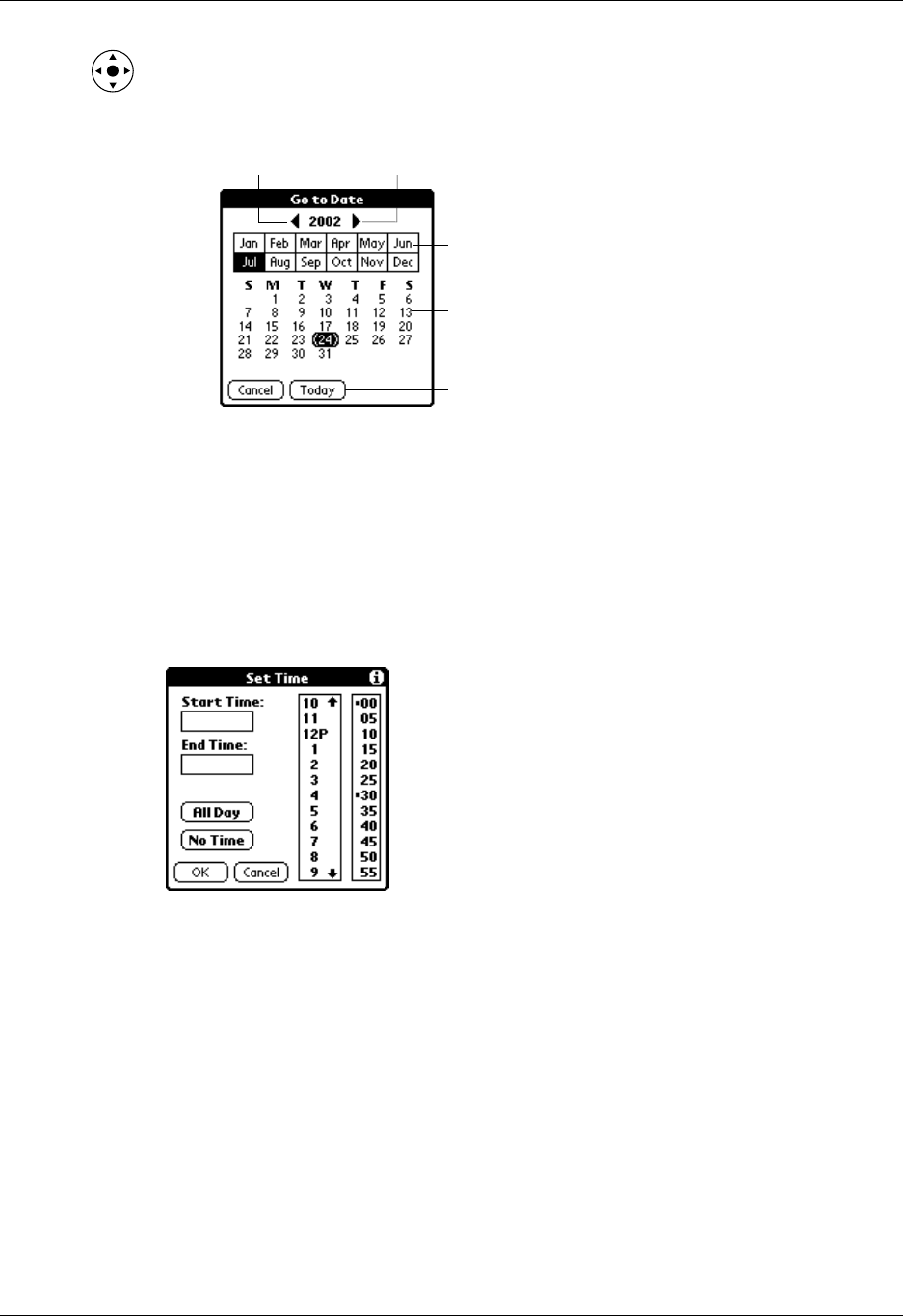
Chapter 8 Using Date Book
92
– Press Up or Down on the navigator to scroll within the current day.
– Tap Go To at the bottom of the screen to open the Go to Date dialog box.
Select a date by tapping a year, month, and day in the calendar.
2. After you locate the date, follow the steps for scheduling an event for the
current day.
To schedule an untimed event:
1. Select the date that you want for the event.
2. Tap N ew.
3. Tap No Time, so that no start or end times are defined for the new event.
TIP You can also create a new untimed event by making sure no event is
selected and then writing letters in the Graffiti writing area.
P
rev
i
ous year
N
ext year
Tap to select
current date
Tap to select a
month
Tap to select a
day
Palm, Inc. Confidential
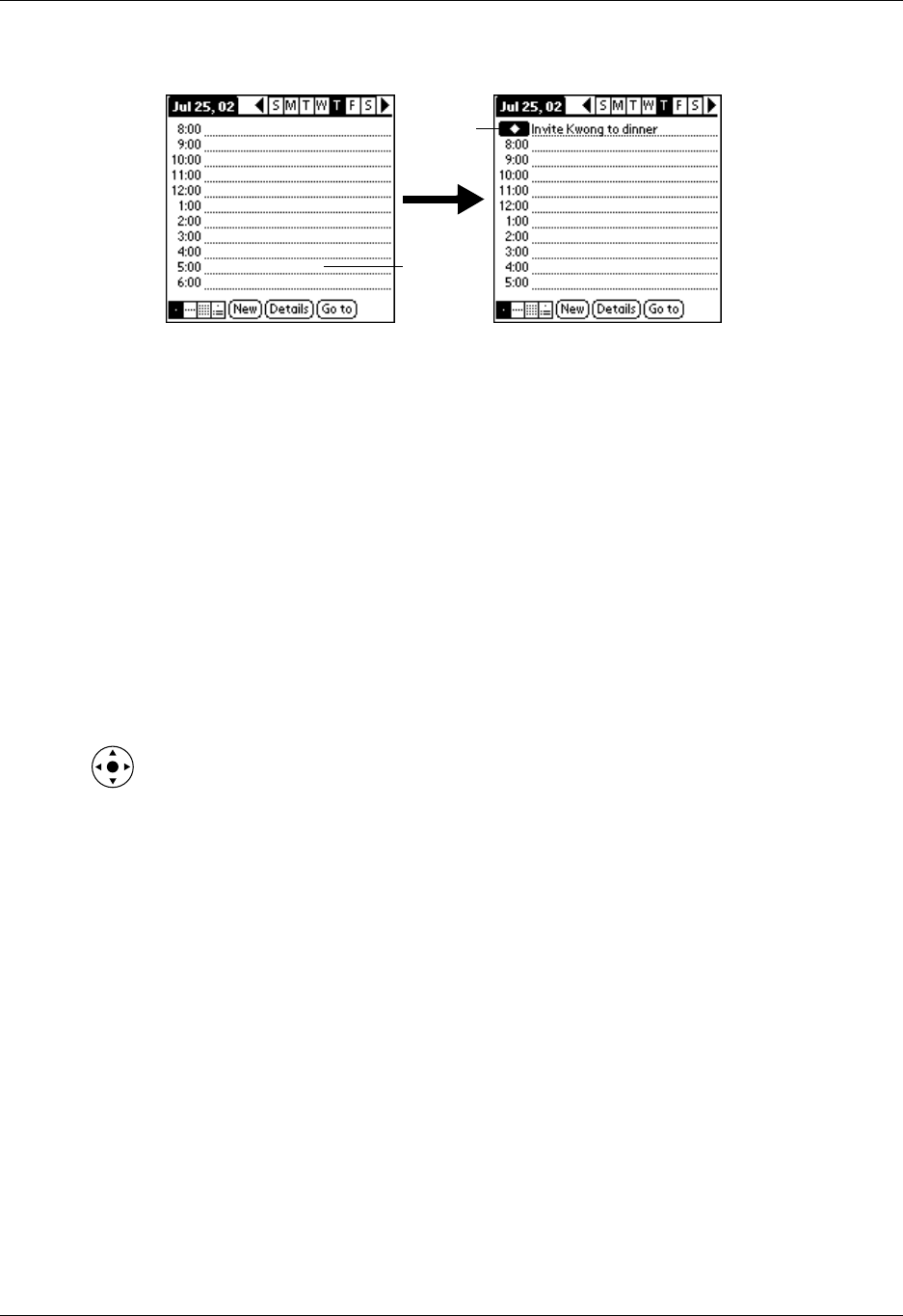
Selecting an event
93
4. Enter a description of the event.
5. Tap a blank area on the screen to deselect the untimed event.
If you create an event and decide later that there is no particular start or end time,
you can easily change it to an untimed event. Tap the time of the event in the Date
Book screen, tap No Time, and then tap OK.
Selecting an event
After you create an event, you can select an event to view its contents, reschedule
it, make it a repeating event, and add alarms or notes.
To select an event:
1. Go to the day on which the event is scheduled.
2. Tap the event.
TIP You can also press Select on the navigator to insert the highlight on the
next event in the current day or on the first event of another day. To scroll
through the events in the selected day, press Up and Down on the navigator.
Rescheduling an event
You can easily make changes to your schedule with your handheld.
To reschedule an event:
1. Select the event you want to reschedule.
2. Tap Details.
3. To change the time, tap the Time box and tap a new time.
4. To change the date, tap the Date box and tap a new date.
5. Tap OK.
No time
selected
New
untimed
event
Palm, Inc. Confidential
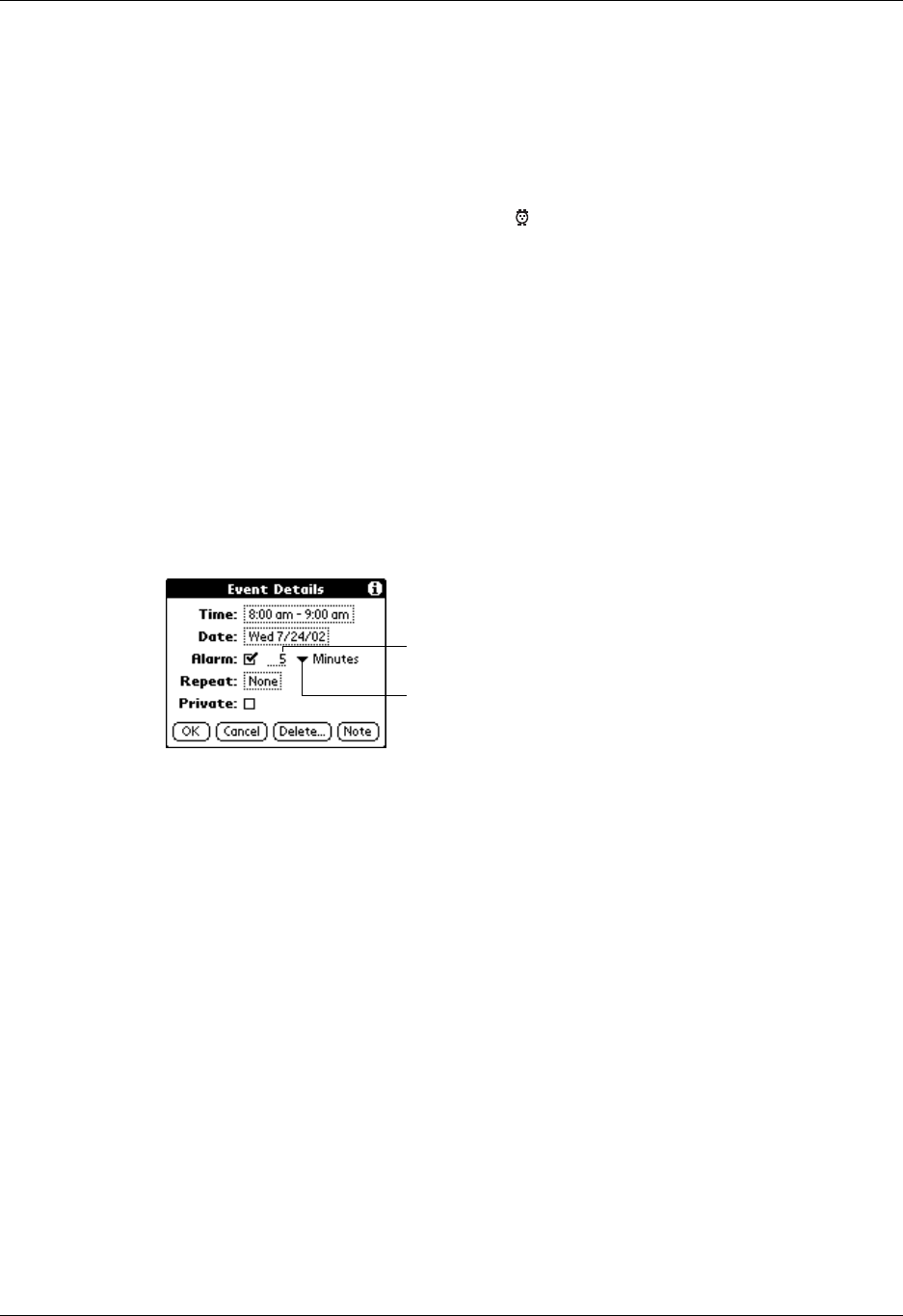
Chapter 8 Using Date Book
94
Setting an alarm for an event
The Alarm setting enables you to set an alarm for events in your Date Book. You
can set an alarm to notify you minutes, hours, or days before an event. The default
Alarm setting is 5 minutes before the time of the event, but you can change this to
any number of minutes, hours, or days.
When you set an alarm, the Alarm icon appears at the far right of the event.
When the alarm is triggered, a reminder message also appears onscreen.
To set an alarm for an event:
1. Select the event to which you want to assign an alarm.
2. Tap Details.
3. Tap the Alarm check box to select it.
The default setting, 5 Minutes, appears.
4. Tap the pick list to select Minutes, Hours, or Days.
5. Select the 5 and enter any number from 0 to 99 (inclusive) as the number of time
units.
6. Tap OK.
7. When the reminder message appears onscreen, do one of the following:
– Tap OK to permanently dismiss the reminder and return to the current
screen.
– Tap Snooze to dismiss the reminder and return to the current screen. An
attention indicator blinks in the upper-left corner of the screen to remind you
of the pending alarm, and the reminder message appears again five minutes
later.
Tap here to
select unit of time
Enter number of
time units here
Palm, Inc. Confidential

Scheduling repeating or continuous events
95
– Tap Go To to open Date Book. Date Book will open and display the event
associated with the alarm.
Alarm for untimed events: You can set a silent alarm for an untimed event. In this
case the alarm is triggered at the specified period of minutes, hours, or days before
midnight (beginning) of the day of the untimed event. When the alarm is triggered,
the reminder list displays the alarm message until you clear it. See “Receiving and
alerts” in Chapter 4 for details.
For example, you set an alarm for an untimed event that occurs on February 4. If
the alarm is set for 5 minutes, the reminder message appears at 11:55 PM on
February 3. The reminder remains in the reminder list until you turn on your
handheld and dismiss it.
Scheduling repeating or continuous events
The Repeat function enables you to schedule events that recur at regular intervals
or that extend over a period of consecutive days.
A birthday is a good example of an event that repeats annually. Another example
is a weekly guitar lesson that falls on the same day of the week and the same time
of day.
A business trip or a vacation is an example of a continuous event.
To schedule a repeating or continuous event:
1. Select the event.
2. Tap Details.
Palm, Inc. Confidential
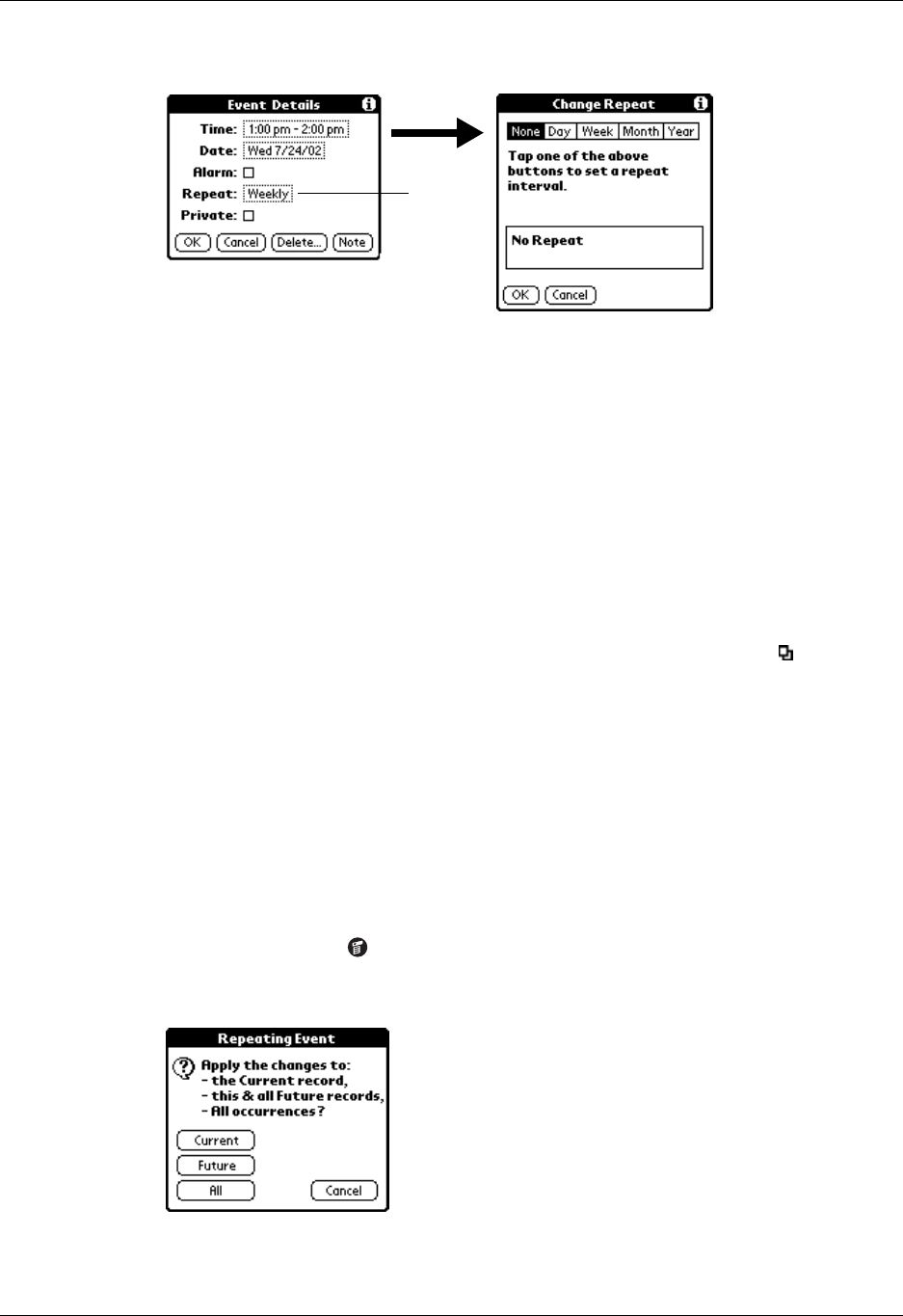
Chapter 8 Using Date Book
96
3. Tap the Repeat box to open the Change Repeat dialog box.
4. Tap Day, Week, Month, or Year to set how often the event repeats.
For a continuous event, tap Day.
5. On the Every line, enter a number that corresponds to how often you want the
event to repeat
For example, if you select Month and enter the number 2, the event repeats
every other month.
6. To specify an end date for the repeating or continuous event, tap the End on
pick list and tap Choose Date. Use the date picker to select an end date.
7. Tap OK.
After you schedule a repeating or continuous event, the Repeat icon appears at
the far right of the event.
Changing repeating or continuous events
When you make changes to a repeating or continuous event, such as deleting or
adding notes or changing the time of an event, you can decide which of the events
you want to change—all events in the series, just the current event, or the current
and future events.
To delete repeating events:
1. Select the record you want to delete.
2. Tap the Menu icon .
3. Select Delete Event from the Record menu.
Ta p t h e
Repeat
box
Palm, Inc. Confidential

Changing the Date Book view
97
4. Do one of the following:
– Tap Current to delete only the current event item.
– Tap Future to delete the current and all future event items and reset the end
date of the repeating event to the last shown date.
– Tap All to delete all occurrences of the repeating event.
5. Tap OK.
Considerations for repeating or continuous events
Keep the following points in mind:
■If you change the start date of a repeating event, your handheld calculates the
number of days you moved the event. Your handheld then automatically
changes the end date to maintain the duration of the repeating event.
■If you change the repeat interval of a repeating event (such as from daily to
weekly) previous occurrences of that event are not changed, and your handheld
creates a new repeating event.
■If you change the date of an occurrence of a repeating event (such as from
January 14 to January 15) and apply the change to all occurrences, the new date
becomes the start date of the repeating event. Your handheld adjusts the end
date to maintain the duration of the event. If you apply the change to current
and future occurrences, past occurrences are not changed.
■If you change other settings of a repeating event (such as time, alarm, private)
and apply the change to all occurrences, your handheld creates a new event.
The start date of this new event is the day on which the setting is changed.
■If you apply a change to a single occurrence of a repeating event (such as time),
that occurrence no longer shows the Repeat icon .
Changing the Date Book view
In addition to displaying the time list for a specific day, you can also display a
whole week, a month, or an agenda.
To cycle through Day, Week, Month, and Agenda views:
■Press the Date Book application button repeatedly to display the next view.
■Tap the appropriate view icon in the lower-left corner of Date Book.
Palm, Inc. Confidential
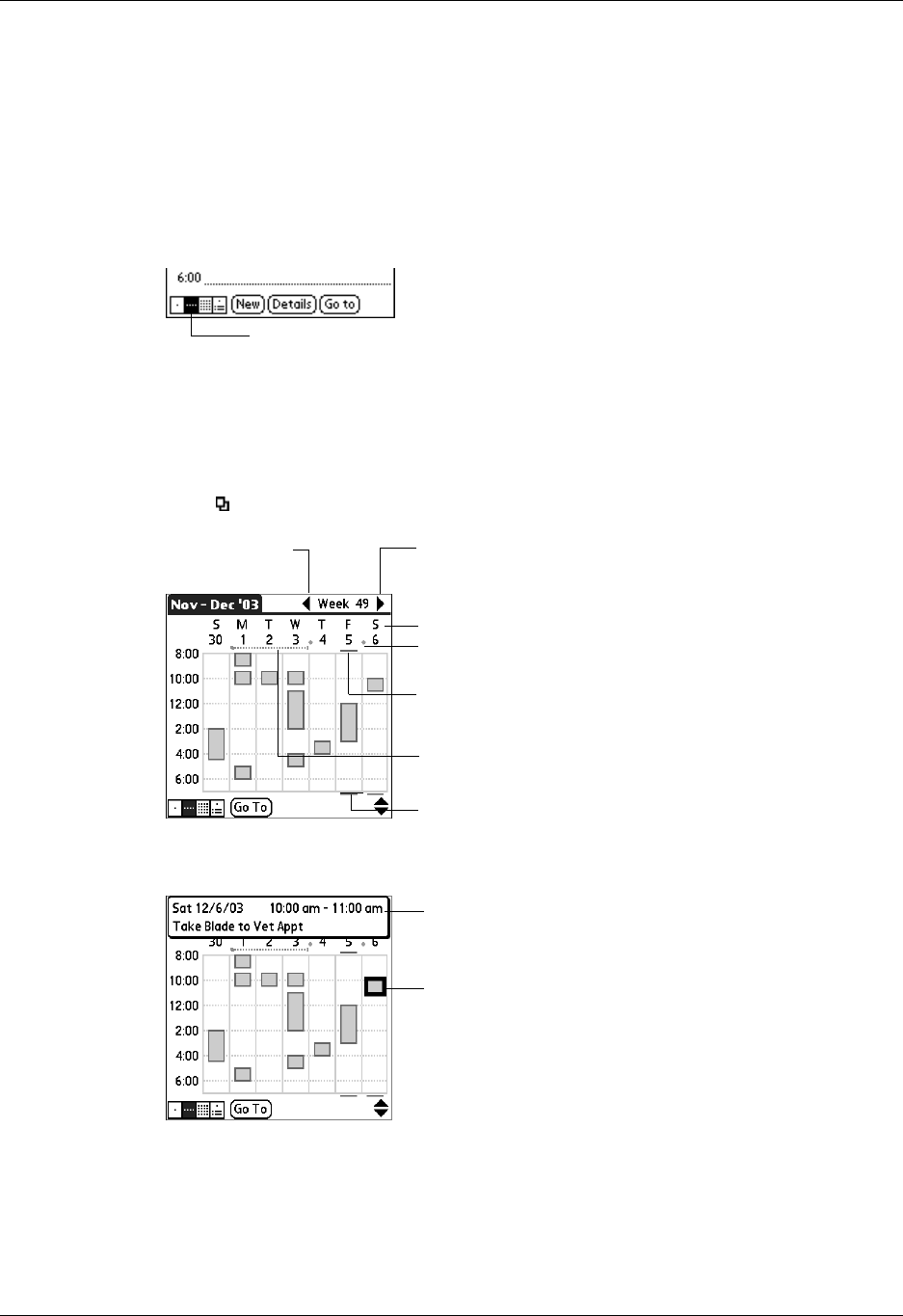
Chapter 8 Using Date Book
98
Working in Week View
Week View shows the calendar of your events for an entire week. You can use this
view to quickly review your appointments and available time slots. In addition,
the graphical display helps you spot overlaps and conflicts in your schedule.
To display the Week View:
1. Tap the Week View icon.
2. Tap the navigation controls to move forward or backward a week at a time, or
tap on a column to display details of an event.
The Week View also shows untimed events and events that are before and after
the range of times shown. Continuous events appear in green with the Repeat
icon .
3. Tap an event to show a description of the event.
Keep the following points in mind:
■To reschedule an event, tap and drag the event to a different time or day.
■Tap a blank time on any day to move to that day and select that time for a new
event.
Week View
P
rev
i
ous
week
N
ext wee
k
Tap for that day
Bar indicates earlier event
Bar indicates later event
Diamond indicates untimed event
Dashed line indicates continuous event
Event details
Tap to show event details
Palm, Inc. Confidential
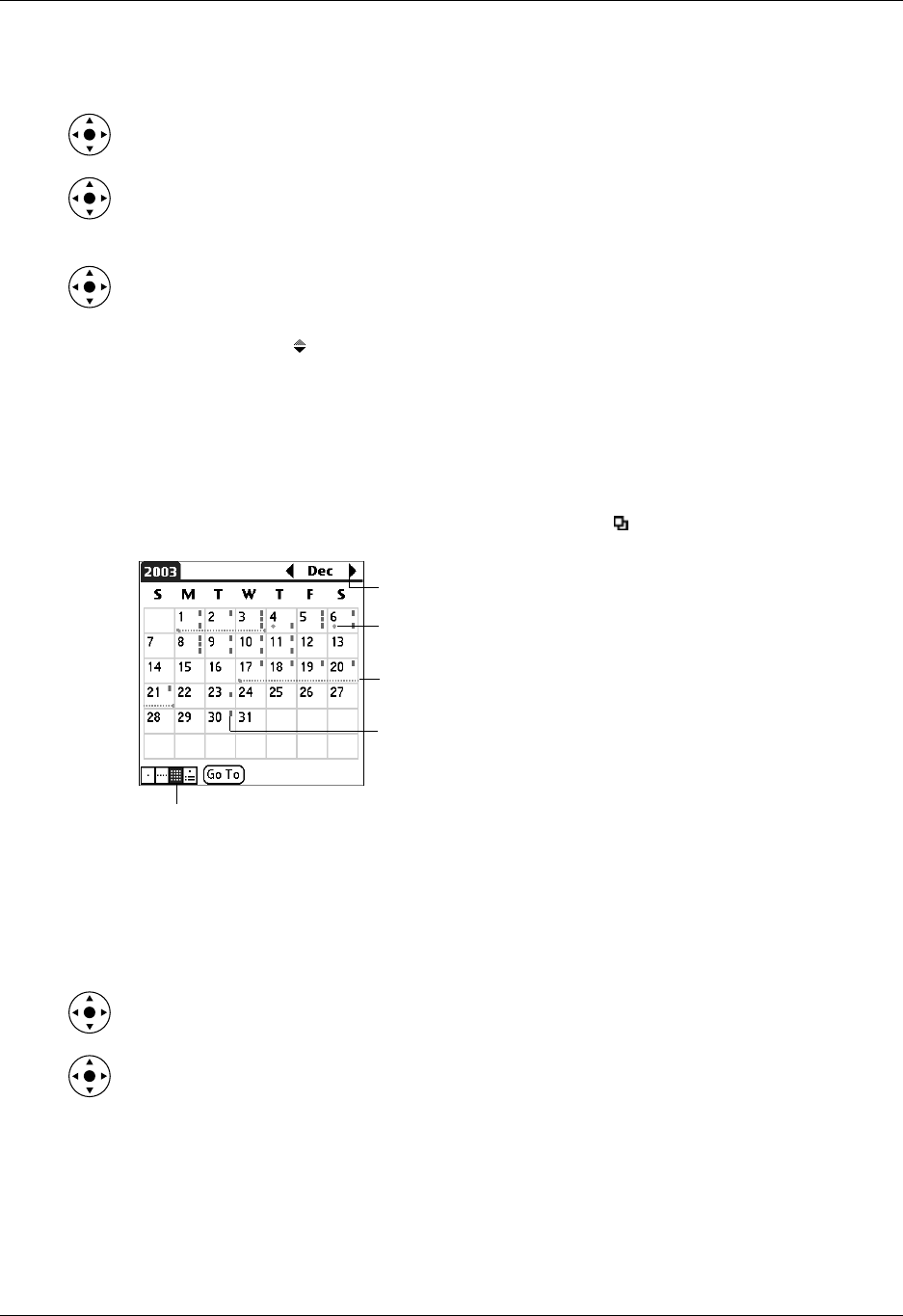
Changing the Date Book view
99
■Tap any day or date that appears at the top of the Week View to move directly
to that day without selecting an event.
■Press Right and Left on the navigator to scroll to the next or previous
week.
■Press Select on the navigator to insert the highlight, and then press Right and
Left to select a day within the selected week. To view the events on the selected
day, press Select on the navigator again.
■The Week View shows the time span defined by the Start Time and End Time in
the Date Book Preferences settings. If you have an event before or after this time
span, a bar appears at the top or bottom of that day’s column. Use the onscreen
scroll arrows to scroll to the event, or press Up and Down on the navigator to
scroll to earlier and later time slots within the selected week.
Working in Month View
The Month View screen shows which days have events scheduled. Lines in the
Month View indicate events and repeating events. Diamonds indicate untimed
events, and green dashed lines with a Repeat icon indicate continuous events.
You can control the types of events that appear in the Month View. See “Display
Options” later in this chapter.
Keep the following points in mind:
■Tap a day in the Month View to display that day in the Day View.
■Tap the scroll arrows in the upper-right corner, or press Left or Right on the
navigator to move forward or backward a month.
■Press Select on the navigator to insert the highlight, and then press Left or Right
on the navigator to scroll to a specific day. Press Select on the navigator to
display that day in the Day View.
Previous/next month
Dashed line below date indicates continuous event
Diamond below date indicates untimed event
Month View button
Dashes on right side indicate events
Palm, Inc. Confidential
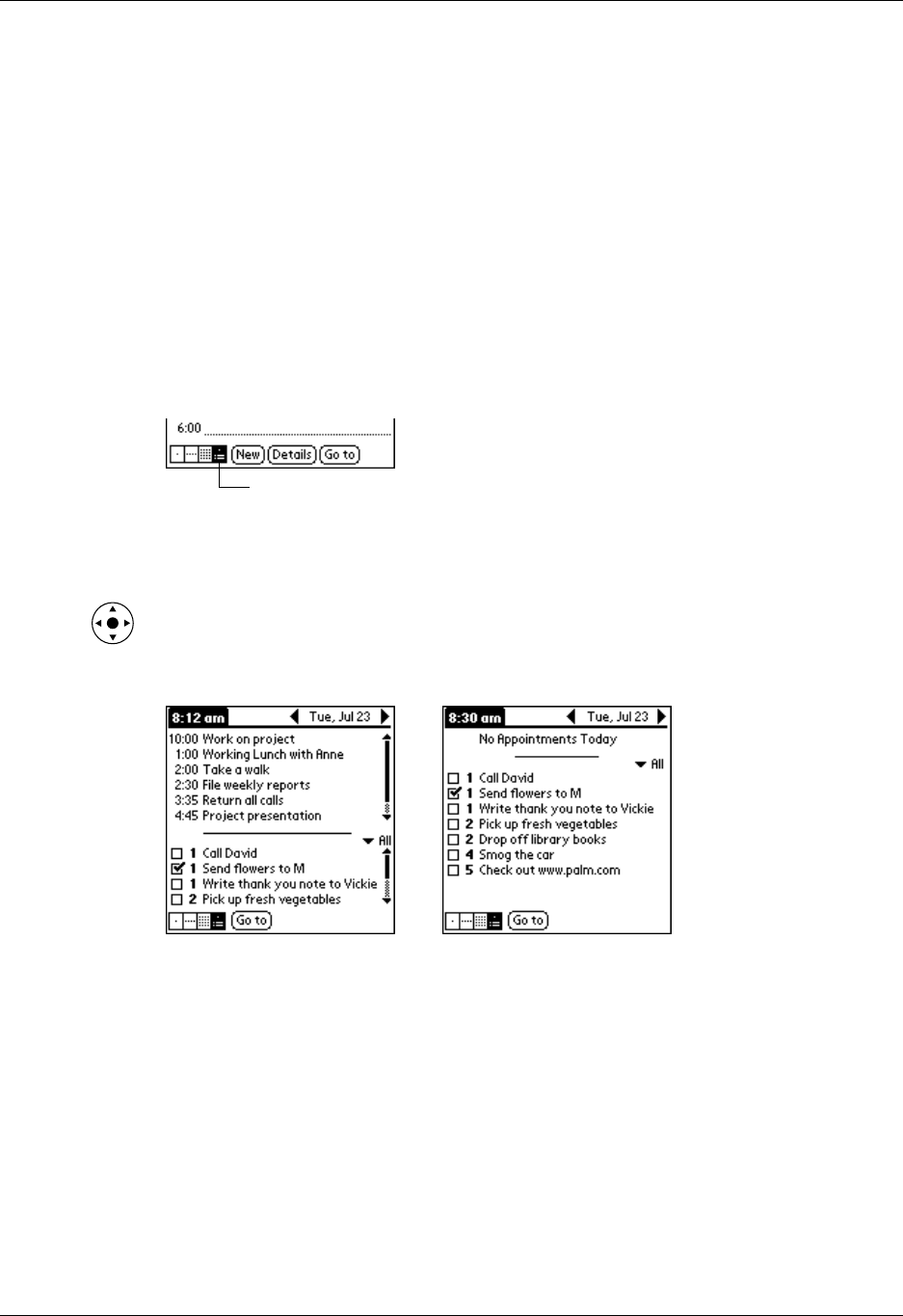
Chapter 8 Using Date Book
100
Working in Agenda View
The Agenda View shows you your untimed events, appointments, and To Do
items in one screen. When you tap on an untimed event or appointment in the
Agenda View, the Day View appears so that you can see more detailed information
about the event. You can tap the check box next to a To Do item to mark it as
completed. When you tap a To Do item, your To Do list appears.
NOTE Which To Do items appear and how you can change them depend on the
settings in your To Do preferences. See “Setting To Do Preferences” in Chapter 13 for
more information.
To display the Agenda View:
1. Tap the Agenda View icon.
2. Tap the navigation controls to move forward or backward a day at a time, or to
display more events and To Do items.
TIP You can also press Up and Down on the navigator to scroll through the
events on the selected day, or press Right or Left on the navigator to scroll to
the next or previous day.
NOTE You can also change the category of To Do items shown. Tap the pick list
to select another category. See Chapter 13 for more information on working
with To Do items.
Agenda View
Palm, Inc. Confidential
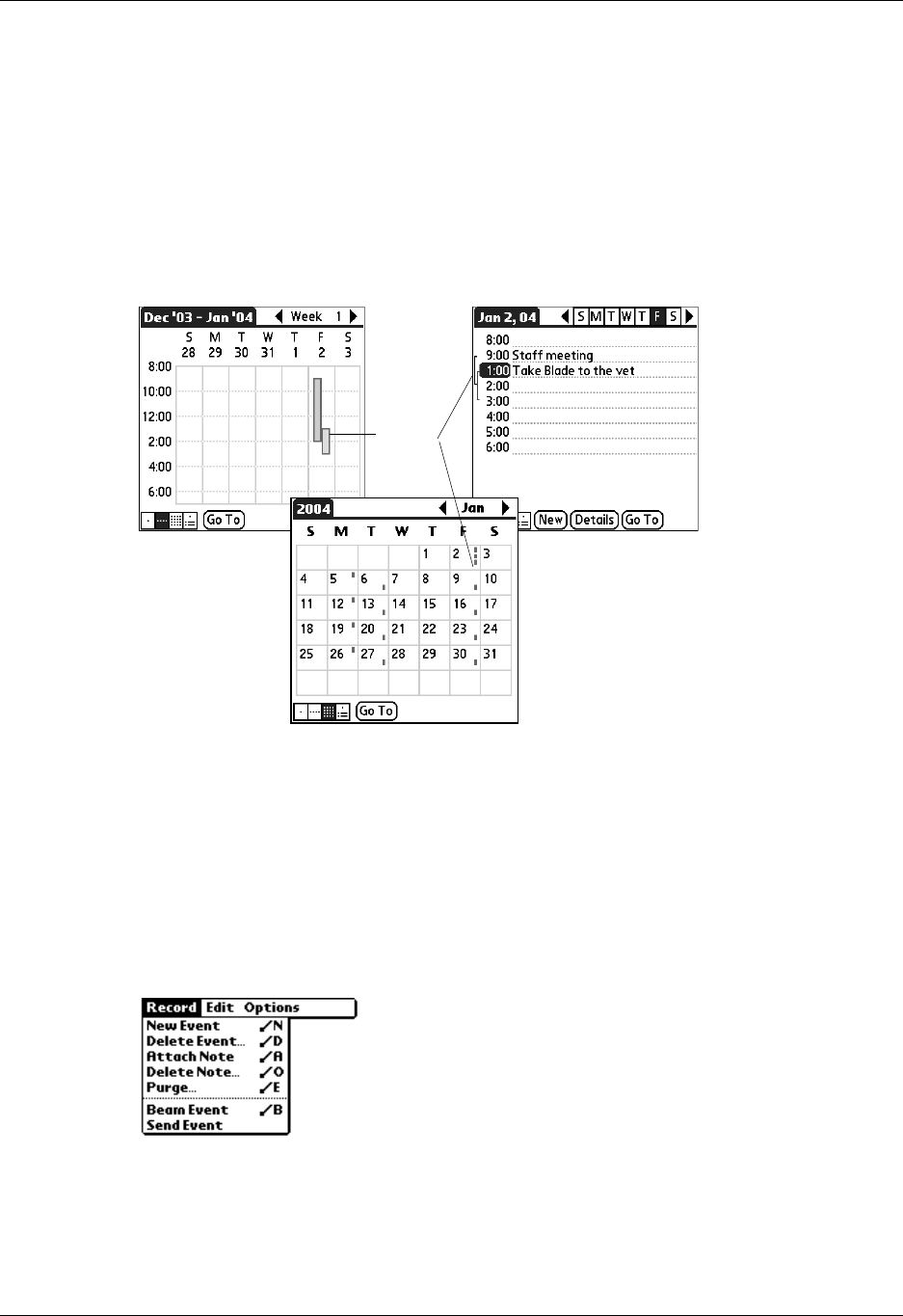
Spotting event conflicts
101
Spotting event conflicts
With the ability to define specific start and end times for any event, it’s possible to
schedule events that overlap (an event that starts before a previous event finishes).
An event conflict (time overlap) appears in the Week View as overlapping bars.
The first event created appears as a gray bar, and any subsequent conflicting events
appear as a single red bar. The Day View displays overlapping red brackets to the
left of the conflicting times. The Month View displays conflicting appointments
in red.
Using Date Book menus
Date Book menus are shown here for your reference, and Date Book features that
are not explained elsewhere in this book are described here.
See “Using menus” in Chapter 4 for information about choosing menu commands.
Record menu
Event
conflict
Send Event Opens a dialog where you can choose how you want to send the
selected event to another device. The options available depend
on the software installed on your handheld.
Palm, Inc. Confidential
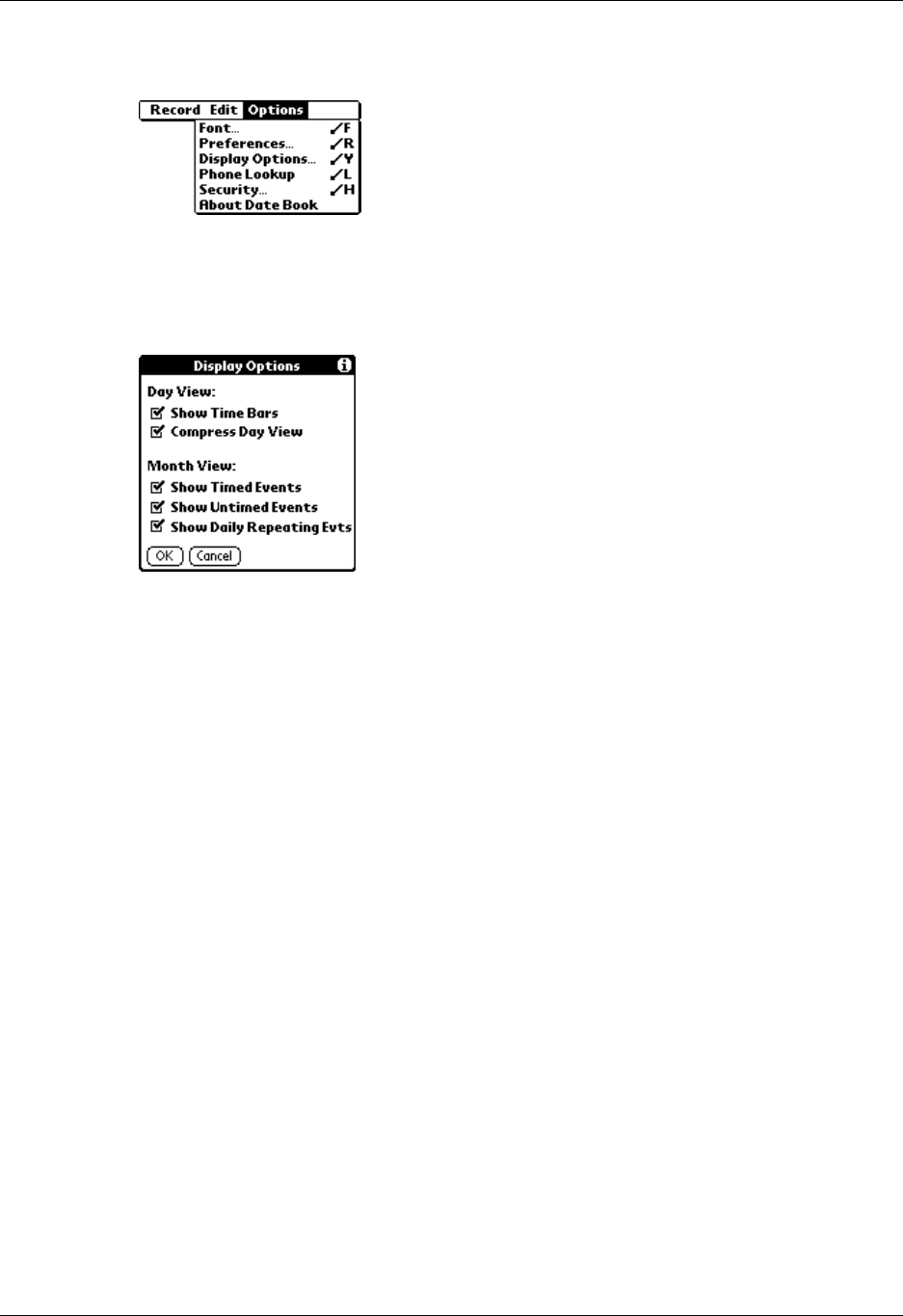
Chapter 8 Using Date Book
102
Options menu
Display Options
Opens the Display Options dialog box where you can change the appearance of
Date Book’s Day View and control which type of events appear in Month View.
Show Time Bars Activates the time bars that appear in the Day View. The
time bars show the duration of an event and illustrate
event conflicts.
Compress Day View Controls how times appear in the Day View. When
Compress Day View is off, all time slots appear. When it is
on, start and end times appear for each event, but blank
time slots toward the bottom of the screen disappear to
minimize scrolling.
Month View settings Applies to the Month View of Date Book. You can deselect
any or all of these check boxes to hide Timed, Untimed, or
Daily Repeating events in the Month View only.
Palm, Inc. Confidential

Using Date Book menus
103
Preferences
Opens the Preferences dialog box where you can customize Date Book’s default
time display and alarm settings.
About Date Book
Shows version information for Date Book.
Start/End Time Defines the start and end times for Date Book screens. If the
time slots you select do not fit on one screen, you can tap the
scroll arrows to scroll up and down.
Alarm Preset Automatically sets an alarm for each new event. The silent
alarm for untimed events is defined by minutes, days, or hours
before midnight at the beginning of the date of the event.
Alarm Sound Sets the tone of the alarm.
Remind Me Defines how many times the alarm will occur after the initial
occurrence. The choices are Once, Twice, 3 Times, 5 Times, and
10 Times.
Play Every Defines how often the alarm sounds. The choices are Minute,
5 minutes, 10 minutes, and 30 minutes.
Palm, Inc. Confidential

Chapter 8 Using Date Book
104
Palm, Inc. Confidential
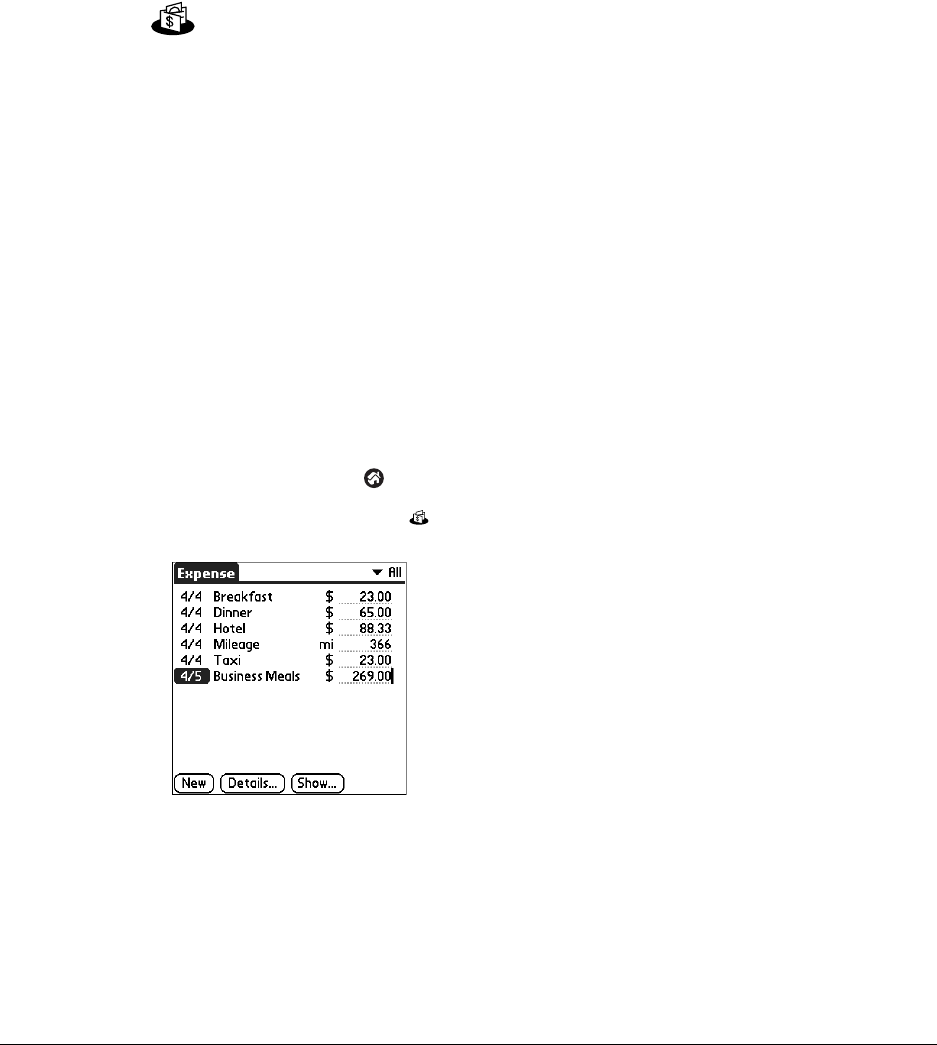
105
CHAPTER 9
Using Expense
Expense enables you to keep track of your expenses and then transfer the
information to a spreadsheet on your computer. In Expense you can do the
following:
■Record dates, types of expenses, amount spent, payment method, and other
details associated with any money that you spend.
■Assign expense items to categories so that you can organize and view them in
logical groups.
■Keep track of vendors (companies) and people involved with each expense.
■Log miles traveled for a particular date or expense category.
■Sort your expenses by date or expense type.
■Send or export your expense information to popular computer applications,
such as Microsoft Excel or Microsoft Word, using Palm™ Desktop software and
HotSync® technology on a Windows computer.
To open Expense:
1. Tap the Home icon .
2. Select the Expense icon .
Palm, Inc. Confidential
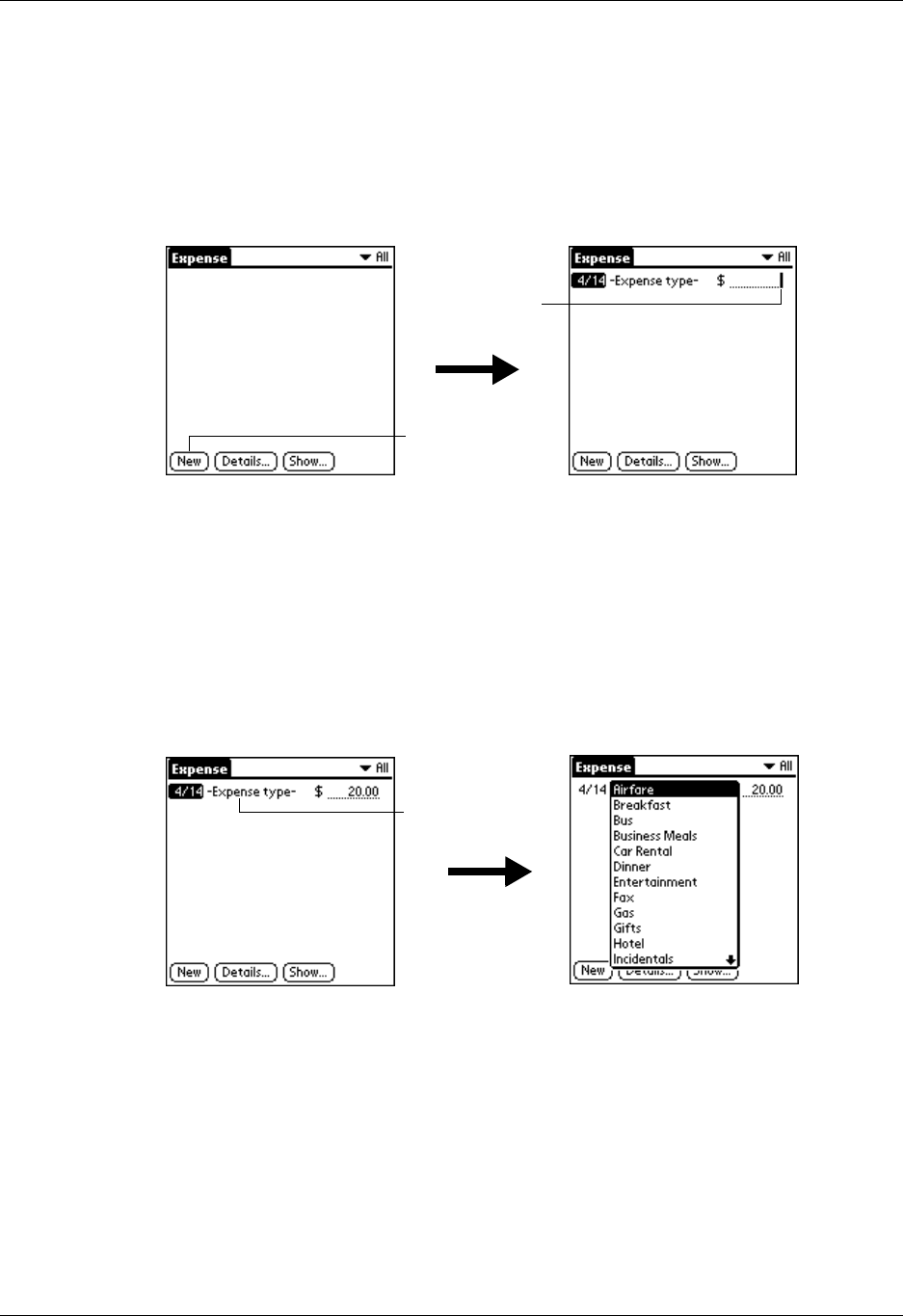
Chapter 9 Using Expense
106
Adding expense items
A record in Expense is called an item. You can sort your Expense items into
categories or add other information that you want to associate with the item.
To add an expense item:
1. Tap N ew.
TIP You can also create a new Expense item by writing on the number side of
the Graffiti writing area while in the Expense list screen. The first number you
write begins the amount of your new Expense item.
2. Enter the amount of the expense.
3. Tap the Expense type pick list and select a type from the list.
As soon as you select an expense type, your handheld saves your entry. If you
do not select an expense type, it does not save the entry.
TIP Another quick way to create a new Expense item is to make sure that no
Expense item is selected in the Expense list, write the first letter(s) of the
expense type, and then write the numerical amount of the Expense item. This
technique takes advantage of the automatic fill feature. See “Options menu”
later in this chapter for details.
Ta p N e w
Cursor of
new item
Tap here
Palm, Inc. Confidential
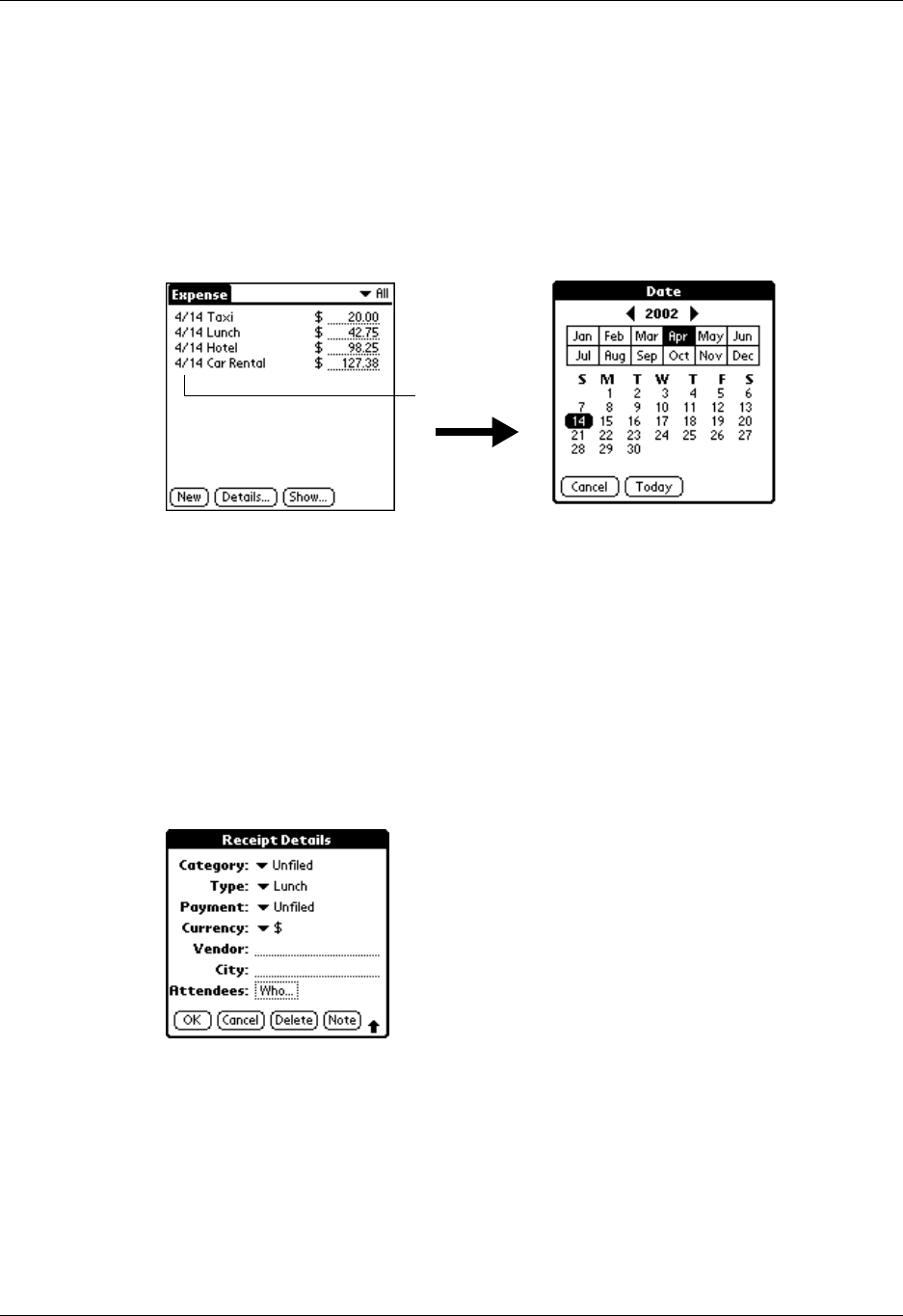
Adding expense items
107
Changing the date of an Expense item
Initially, Expense items appear with the date on which you enter them. You can
change the date associated with any Expense item.
To change the date of an Expense item:
1. Tap the Expense item you want to change.
2. Tap the date of the selected item.
3. Tap the new date.
Entering receipt details
Expense provides a variety of options that you can associate with an item. These
options appear in the Receipt Details dialog box.
To open the Receipt Details dialog box:
1. Tap the Expense item to which you want to assign details.
2. Tap Details.
3. Select any of the following options:
Ta p d a t e
Category Opens a pick list of system and user-defined categories.
See “Categorizing records” in Chapter 4 for more information.
Ty p e Opens a pick list of expense types.
Palm, Inc. Confidential
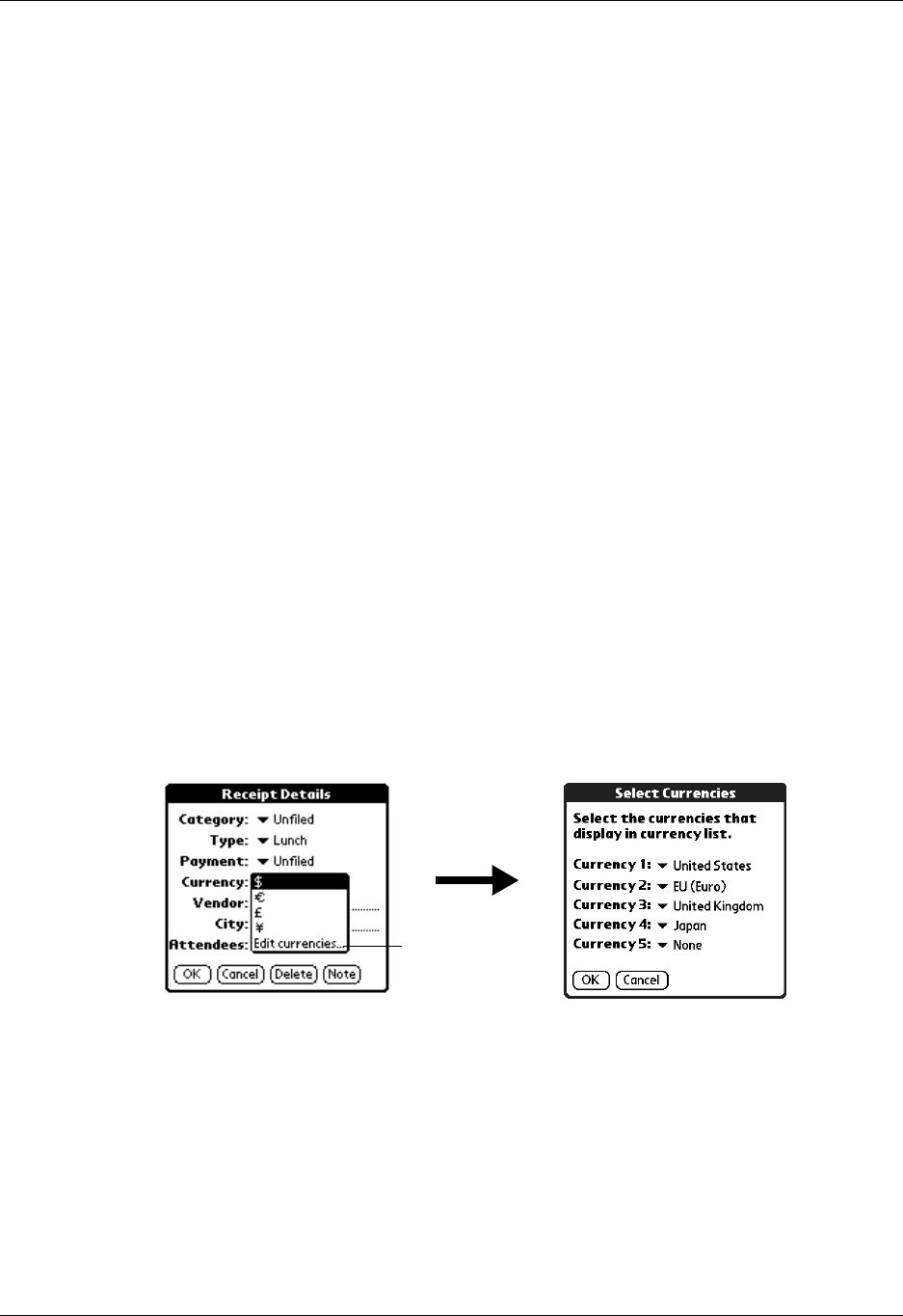
Chapter 9 Using Expense
108
4. Tap OK.
Customizing the Currency pick list
You can select the currencies and symbols that appear in the Currency pick list.
To customize the Currency pick list:
1. Tap the Currency pick list in the Receipt Details dialog box, and then select Edit
currencies.
2. Tap each Currency pick list and select the country whose currency you want to
display on that line.
3. Tap OK to close the Select Currencies dialog box.
4. Tap OK.
Payment Enables you to choose the payment method for the Expense item.
If the item is prepaid (such as airline tickets supplied by your
company), you can choose Prepaid to place your expense in the
appropriate company-paid cell of your printed expense report.
Currency Enables you to choose the type of currency used to pay the
Expense item. The default currency unit is defined in the
Preferences dialog box. You can also display up to four other
common types of currency. See “Customizing the Currency pick
list” later in this chapter for more information.
Vendor and
City Enables you to record the name of the vendor (usually a company)
associated with the expense and the city where the expense was
incurred. For example, a business lunch might be at Rosie’s Cafe
in San Francisco.
Attendees See “Looking up names to add to Expense records” in Chapter 4
for more information.
Tap Edit
currencies
Palm, Inc. Confidential
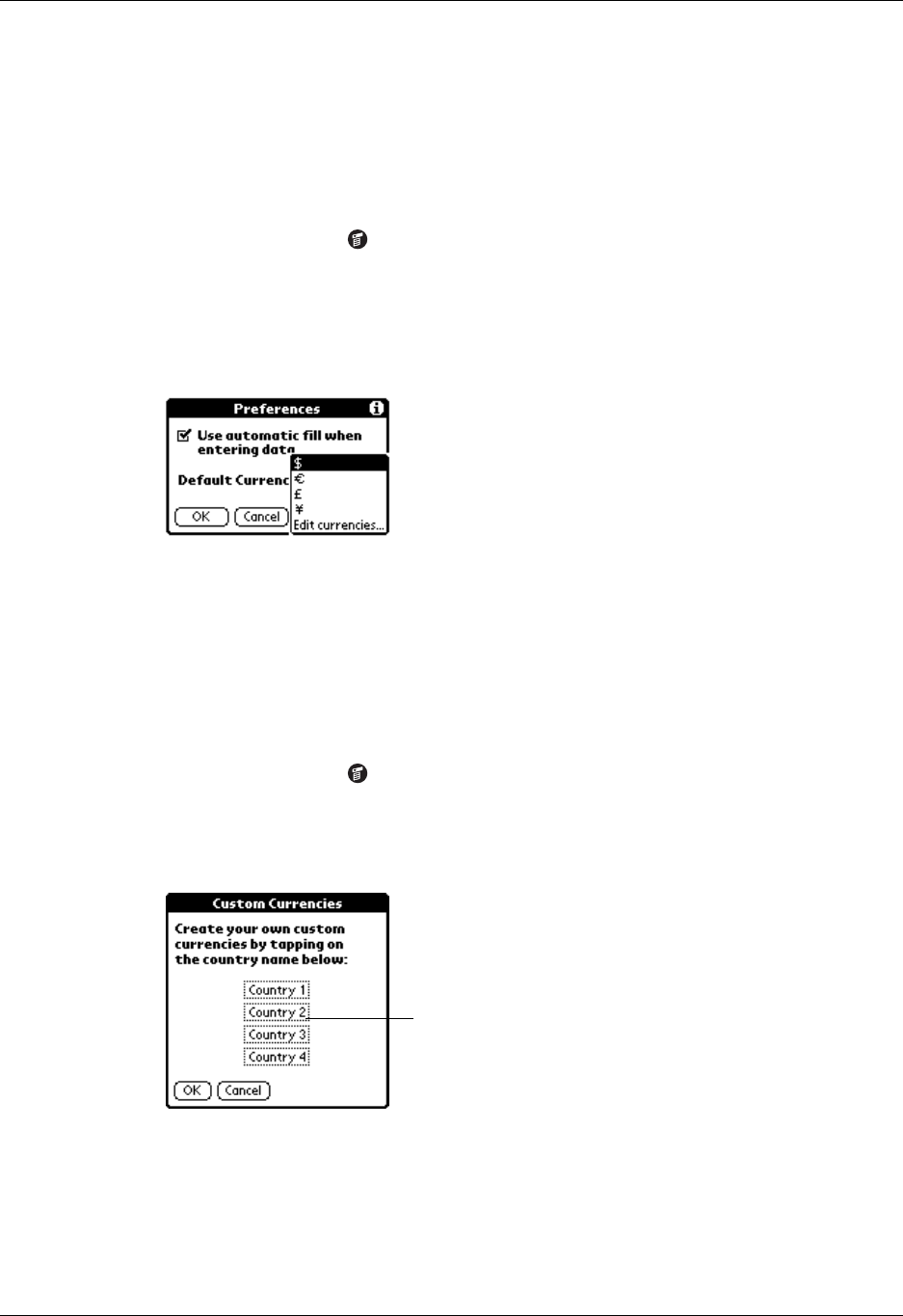
Customizing the Currency pick list
109
Changing the default currency
You can select which currency appears by default when you’re entering Expense
items. You can override this setting when entering individual expense items.
To change your default currency:
1. Open Expense.
2. Tap the Menu icon .
3. Select Options, and then select Preferences.
4. Tap the Default Currency pick list.
5. Tap the currency symbol you want to appear in Expense.
6. Tap OK.
Defining a custom currency symbol
If the currency you want to use is not in the list of countries, you can create your
own custom country and currency symbol.
To define a custom currency symbol:
1. Tap the Menu icon .
2. Select Options, and then select Custom Currencies.
3. Tap one of the four Country boxes.
Tap a Country
box
Palm, Inc. Confidential
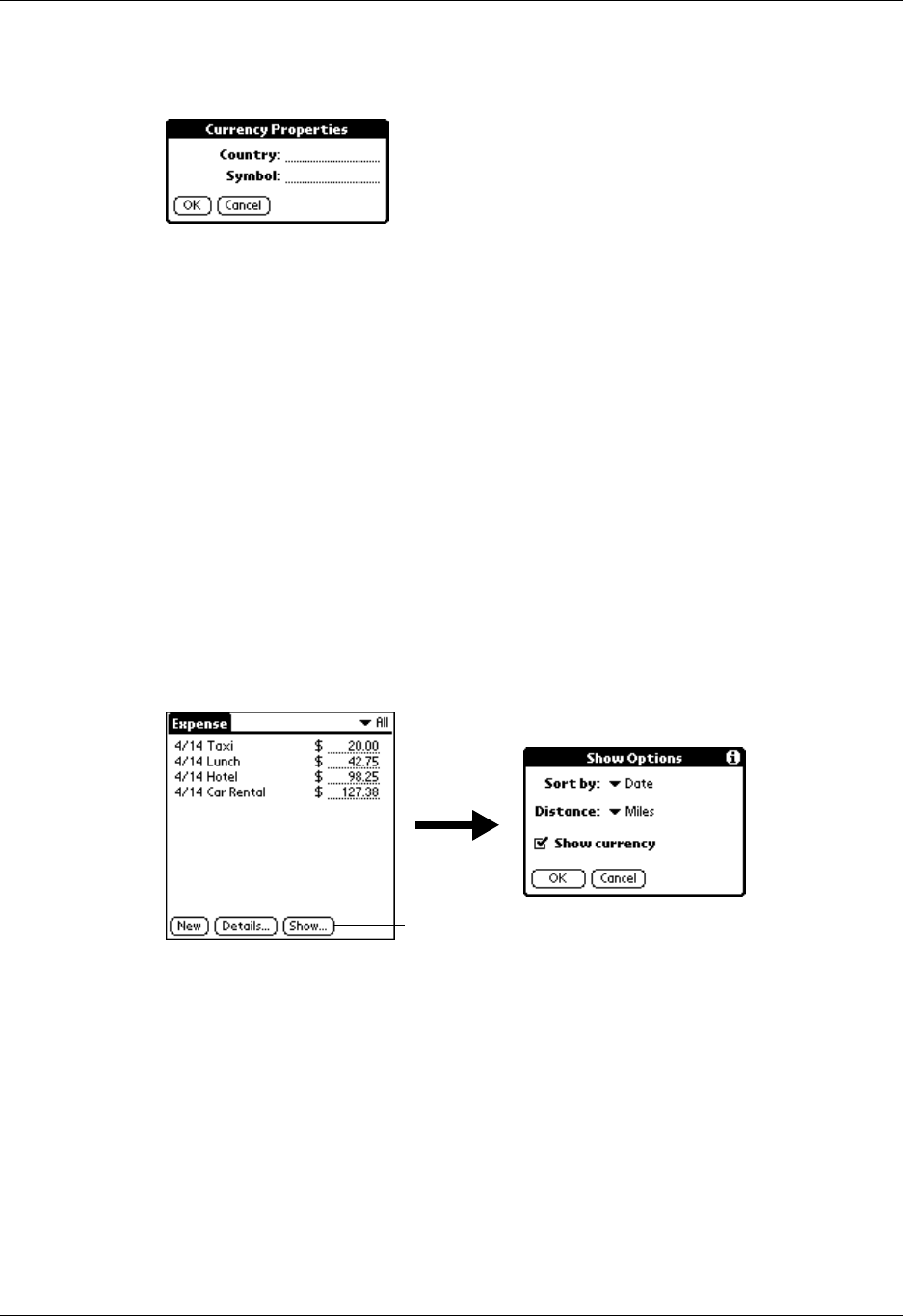
Chapter 9 Using Expense
110
4. Enter the name of the country and the symbol that you want to appear in
Expense.
5. Tap OK to close the Currency Properties dialog box.
6. Tap OK.
NOTE If you want to use your custom currency symbol as the default for all Expense
items, select the symbol in the Preferences dialog box. If you want to use your
custom currency symbol only for a particular Expense item, select the symbol in the
Receipt Details dialog box associated with that item.
Setting Show Options
Show Options defines the sort order and other settings that relate to your Expense
items.
To open the Show Options dialog box:
1. In the Expense list, tap Show.
2. Select any of the options.
3. Tap OK.
Sort by Enables you to sort expense items by date or type.
Distance Enables you to display Mileage entries in miles or kilometers.
Show currency Shows or hides the currency symbol in the Expense list.
Tap Show
Palm, Inc. Confidential

Working with Expense data on your computer
111
Working with Expense data on your computer
After you enter your expenses into the Expense application on your handheld and
perform a HotSync operation, Palm Desktop software enables you to do any of the
following on your Windows computer. See the Palm Desktop software online help
for details. This feature is not available on Mac computers.
■Add, modify, and delete your Expense data.
■Organize your Expense data by category, amount, date, type, or notes.
■View Expense data in various formats: List, Large Icons, or Small Icons.
■Record individual expenses in various currencies and display the total in one
selected currency type.
■Print Expense reports.
■Transfer Expense data to other applications, such as Microsoft Excel, using the
Send command or Export command, and import data in popular file formats.
Displaying the euro on your computer
When you perform a HotSync operation, the euro symbol is transferred to Palm
Desktop software like any other piece of data on your handheld. The symbol
appears in Palm Desktop software, however, only if you are using fonts that
support the euro symbol.
These fonts are part of the operating system on your computer. They do not reside
with your Desktop application, and they are not produced by Palm, Inc. For more
information, refer to the documentation that accompanies your desktop
computer’s operating system.
Printing the euro
Even with operating system support, problems may arise when you print
documents that contain the euro. When a font is present on both the printer and
the computer, the printer font is used by default to increase printing speed. If the
printer font does not include the euro, a box is printed instead of the euro symbol.
You can work around this problem by transferring the expense data to another
application and inserting a bitmap image of the euro into the document in the
appropriate places, or by not using the printer’s built-in fonts (if allowed).
Palm, Inc. Confidential
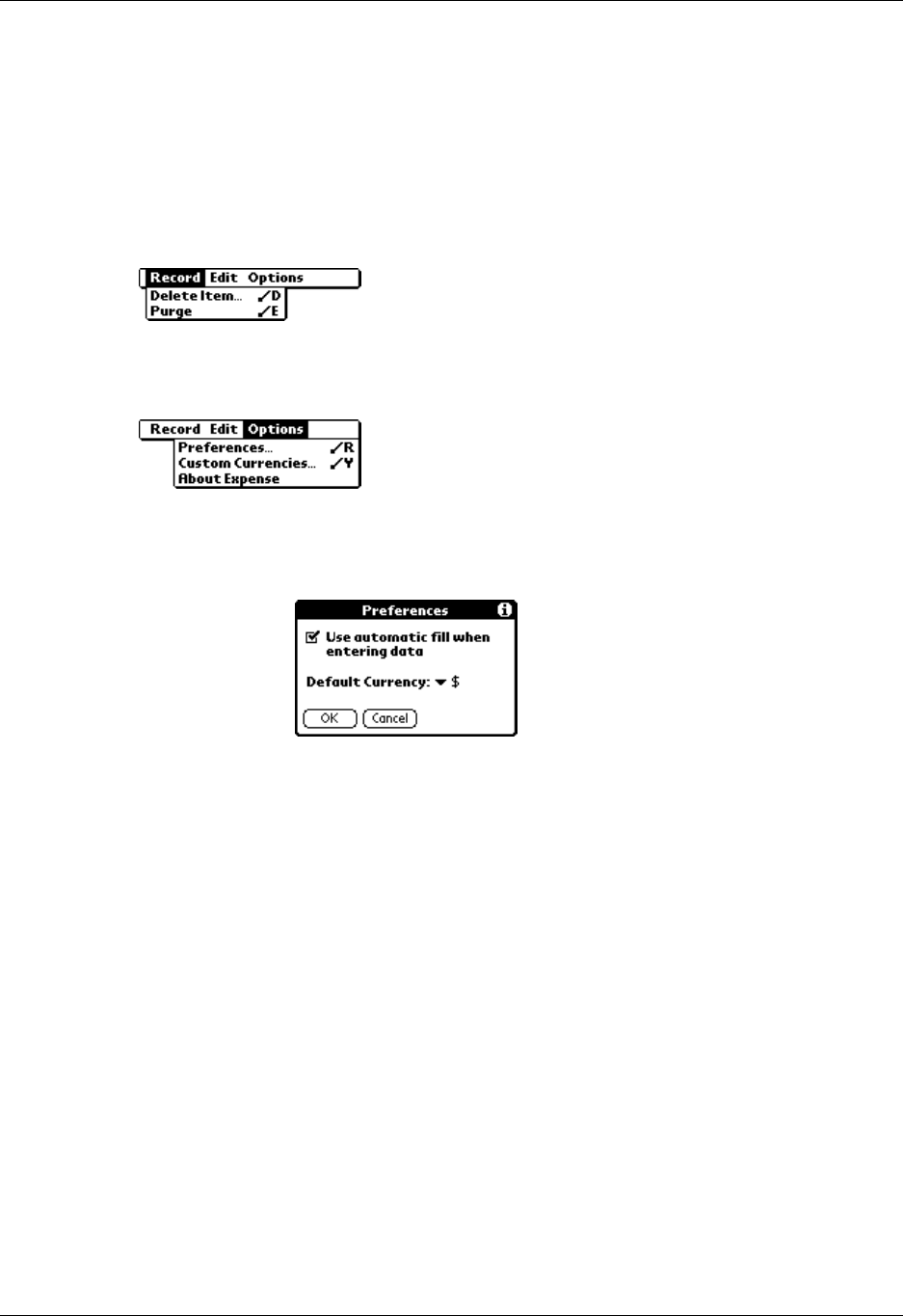
Chapter 9 Using Expense
112
Using Expense menus
Expense menus are shown here for your reference, and Expense features that are
not explained elsewhere in this book are described here.
See “Using menus” in Chapter 4 for information about selecting menu commands.
Record menu
Options menu
Preferences Opens the Preferences dialog box where you can select
automatic fill and default currency options.
Use automatic fill. Enables you to select an expense type by
writing the first letter of an expense type in the Graffiti writing
area. For example, if you write the letter T, it enters the “Taxi”
expense type. Writing T and then E enters “Telephone” which is
the first expense type beginning with the letters TE.
About Expense Shows version information for Expense.
Palm, Inc. Confidential

113
CHAPTER 10
Using Memo Pad
Memo Pad provides you with a place to take notes that are not associated
with records in Date Book, Address Book, or To Do List. The number of
memos you can store depends only on the memory available on your
handheld. Use Memo Pad to do the following:
■Use Graffiti® characters to store memos, lists, or any other text message on your
handheld.
■Send memos to popular computer applications like Microsoft Word when you
synchronize using Palm™ Desktop software and HotSync® technology.
■Assign memos to categories so that you can organize and view them in logical
groups.
■Write down phone numbers and other types of information that you can later
copy and paste into other applications.
To open Memo Pad:
1. Tap the Home icon .
2. Select the Memo Pad icon .
Creating memos
A record in Memo Pad is called a memo. You can assign memos to categories and
mark them private as described in Chapter 4. This section covers how to create a
memo.
Palm, Inc. Confidential
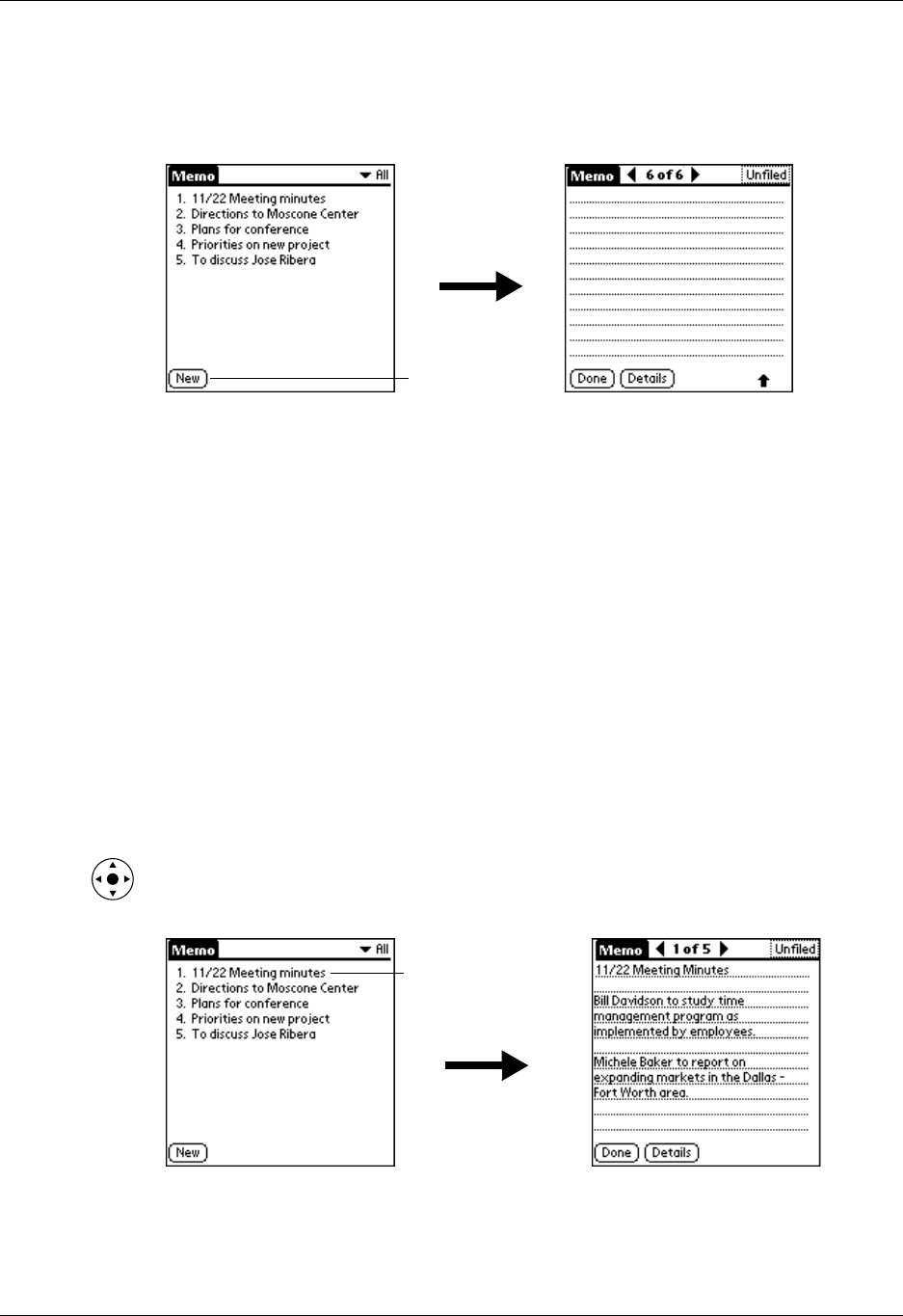
Chapter 10 Using Memo Pad
114
To create a new memo:
1. Open Memo Pad.
2. Tap N ew.
TIP In the Memo list screen, you can also begin writing in the Graffiti writing
area to create a new memo. The first letter is automatically capitalized and
begins your new memo.
3. Enter the text you want to appear in the memo. Use the carriage return stroke
to move down to new lines in the memo.
4. Tap Done.
Reviewing memos
The first line of a memo appears in the Memo list. This makes it easy to locate and
review your memos.
To rev iew a me m o :
1. From the Memo list, select the text of the memo.
TIP You can also select, review, and move between memos with the navigator.
See “Using the navigator” in Chapter 2 for details.
2. Review or edit the text in the memo.
3. Tap Don e.
Ta p N e w
Select a memo
to review
Palm, Inc. Confidential
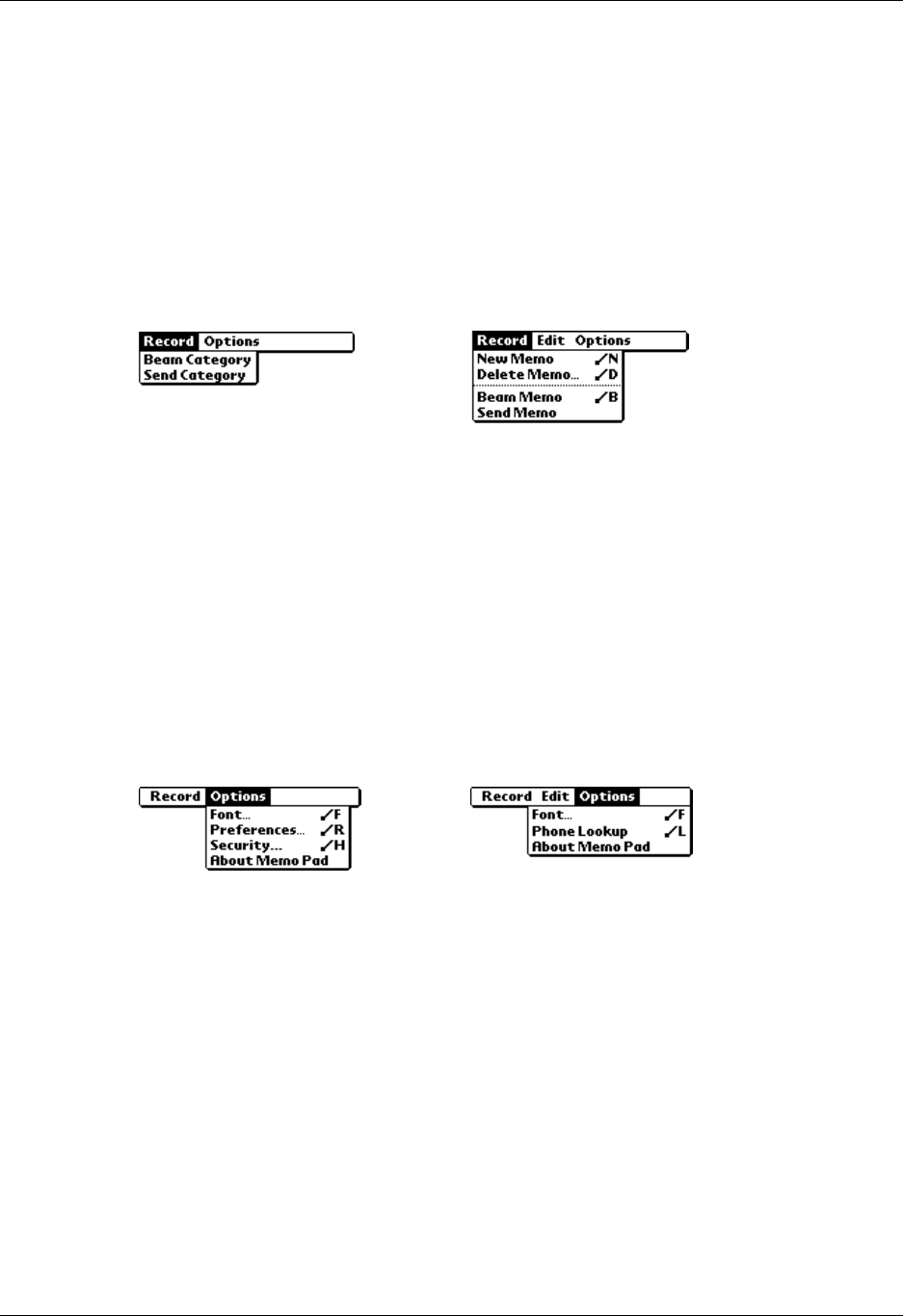
Using Memo Pad menus
115
Using Memo Pad menus
Memo Pad menus are shown here for your reference, and Memo Pad features that
are not explained elsewhere in this book are described here.
See “Using menus” in Chapter 4 for information about selecting menu commands.
The Record and Options menus differ depending on whether you’re displaying the
Memo list or an individual memo.
Record menus
Options menus
Send Category Opens a dialog box where you can choose how you want to
send all records in the selected category to another device. The
options available depend on the software installed on your
handheld.
Send Memo Opens a dialog box where you can choose how you want to
send the selected memo to another device. The options
available depend on the software installed on your handheld.
Memo list
Memo screen
Preferences Displays the Memo Preferences dialog box, where you define
the sort order for memos.
About Memo Pad Shows version information for Memo Pad.
Memo list Memo screen
Palm, Inc. Confidential

Chapter 10 Using Memo Pad
116
Palm, Inc. Confidential

117
CHAPTER 11
Using Note Pad
Note Pad provides a place to take notes in your own handwriting. You can
use Note Pad to do everything you might do with a piece of paper and a
pencil. Use Note Pad to do the following:
■Take notes, draw a sketch, or write any kind of message directly on your
handheld screen. Later, you can enter this information into other applications.
■Set an alarm to use your notes as reminder messages.
■Assign notes to categories so that you can organize and view them in logical
groups.
■Exchange notes with other devices that have Note Pad 2.0 installed and that use
SMS or Bluetooth technology.
■Use Palm™ Desktop software and HotSync® technology to copy and paste
notes into popular computer applications like Microsoft Word, or to send notes
as e-mail attachments.
To open Note Pad:
■Press the Note Pad application button on the front panel of your handheld.
Note Pad opens to display the list of all your records.
TIP Press the Note Pad application button repeatedly to cycle through the categories
in which you have records.
Note Pad button
Palm, Inc. Confidential
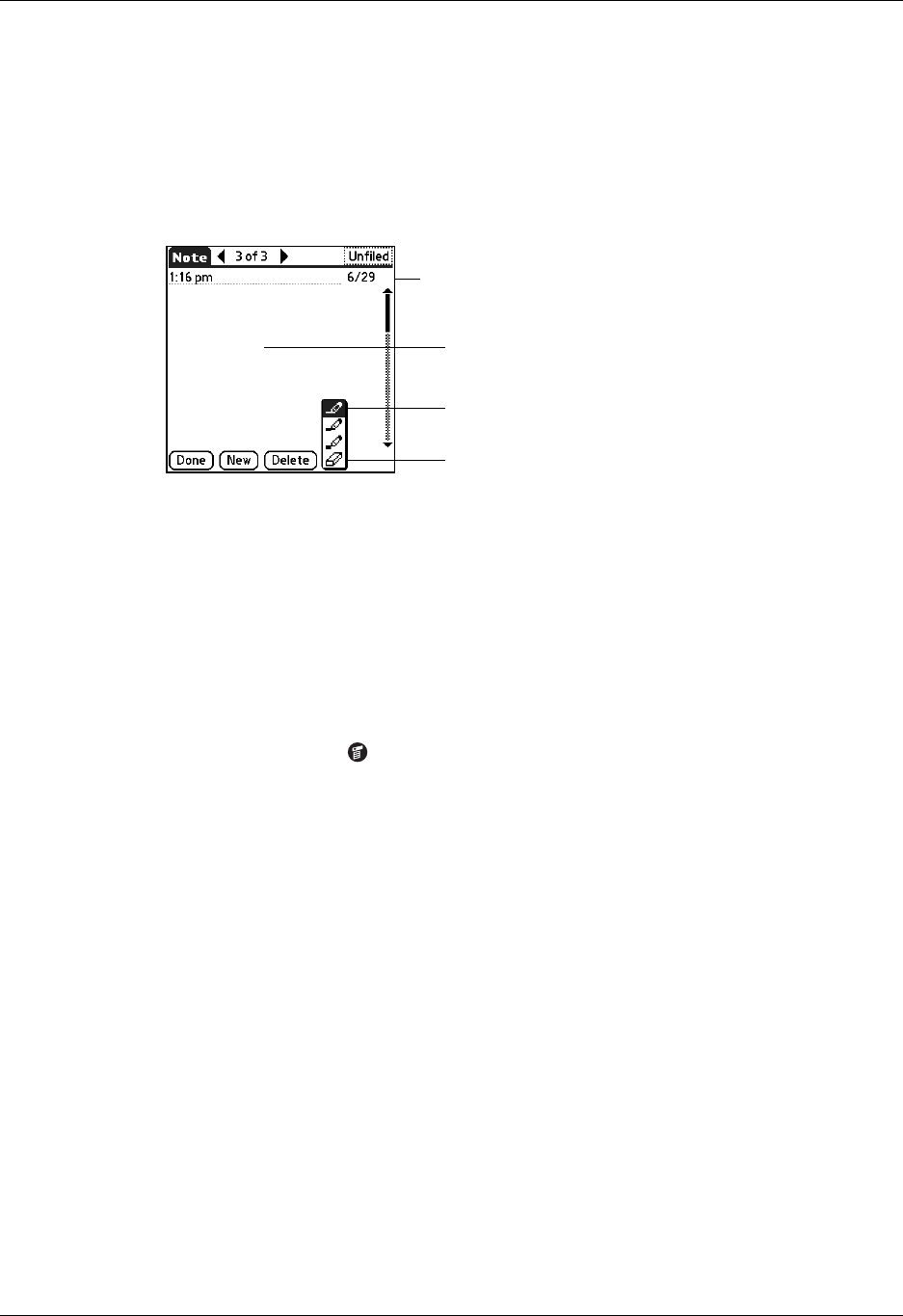
Chapter 11 Using Note Pad
118
Creating a note
A record in Note Pad is called a note. You can assign notes to categories and mark
them private as described in Chapter 4. This section covers how to create a note.
To create a new note:
1. Tap New.
2. Write the information directly on the handheld screen.
Tap the pen selector to select a different pen width, or select the eraser to
remove unwanted strokes.
3. (Optional) Select the time at the top of the screen, and then enter a title using
Graffiti® writing.
4. Tap Don e.
To clear the screen:
1. Tap the Menu icon .
2. Select Edit, and then select Clear Note.
Reviewing notes
The note title and the date you created the note appear in the Note Pad list. If you
did not assign a title to your note, the time you created the note appears as the note
title. This makes it easy to locate and review your notes.
Pen selector
Write
information
here
Enter title here
Eraser
Palm, Inc. Confidential
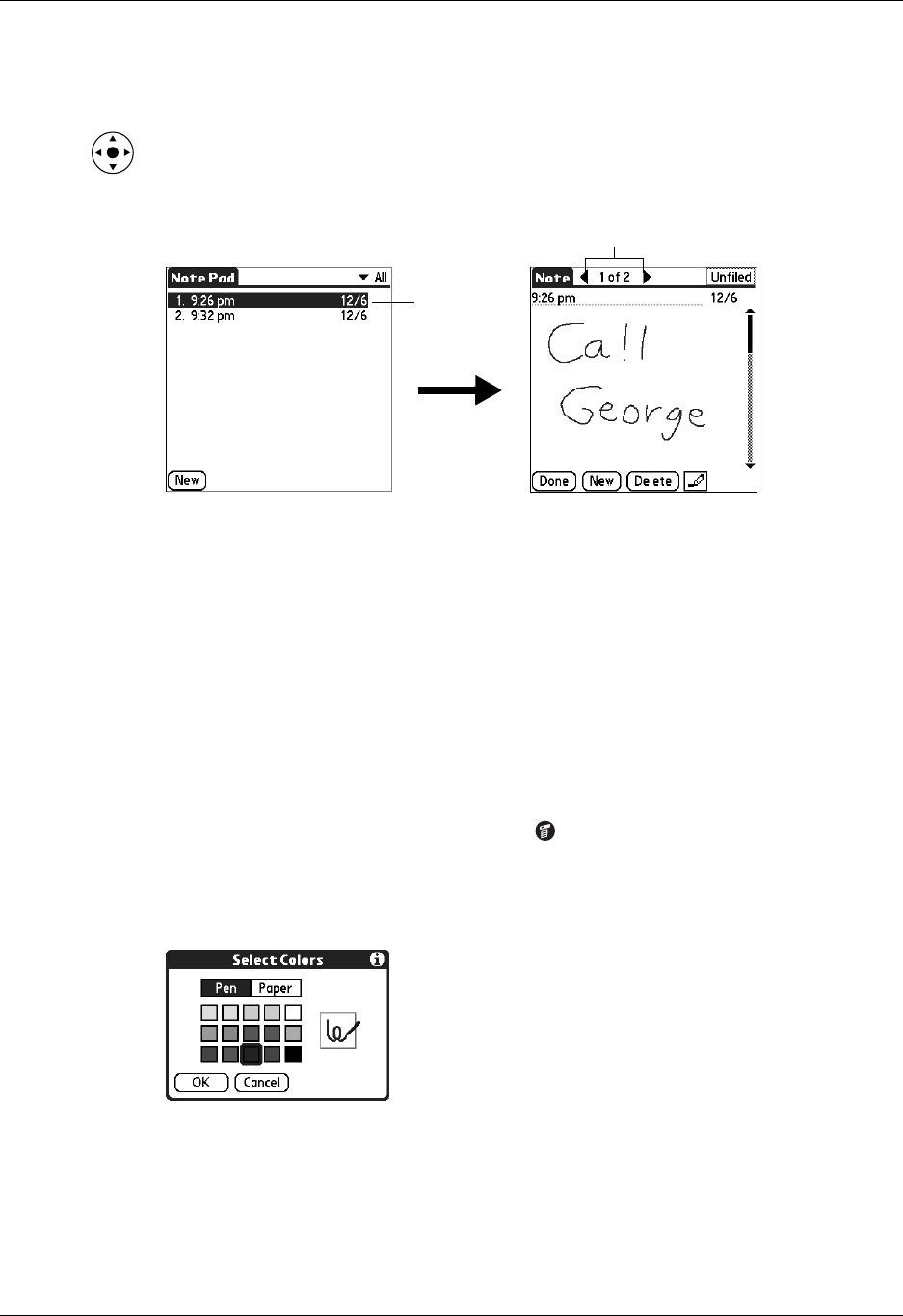
Changing Note Pad color settings
119
To review a note:
1. In the Note Pad list, select the note title.
TIP You can also select, review, and move between notes with the navigator.
See “Using the navigator” in Chapter 2 for details.
2. Review or edit the contents of the note.
3. Tap Don e.
Changing Note Pad color settings
By default, your notes appear with a white “paper” background, and the ink from
the pen is blue. You can change the color of both the paper and the ink from the
pen. Your color selections apply to all your notes. You cannot change the color
settings for individual notes.
To set the colors:
1. In the Note Pad list, tap the Menu icon .
2. Select Options, and then select Preferences.
3. Tap Color.
4. Tap Pen, and then tap the color of ink you want to use.
5. Tap Paper, and then tap the color of paper you want to use.
6. Tap OK.
T
ap arrows to scro
ll
to
next and previous notes
Select a
note to view
Palm, Inc. Confidential
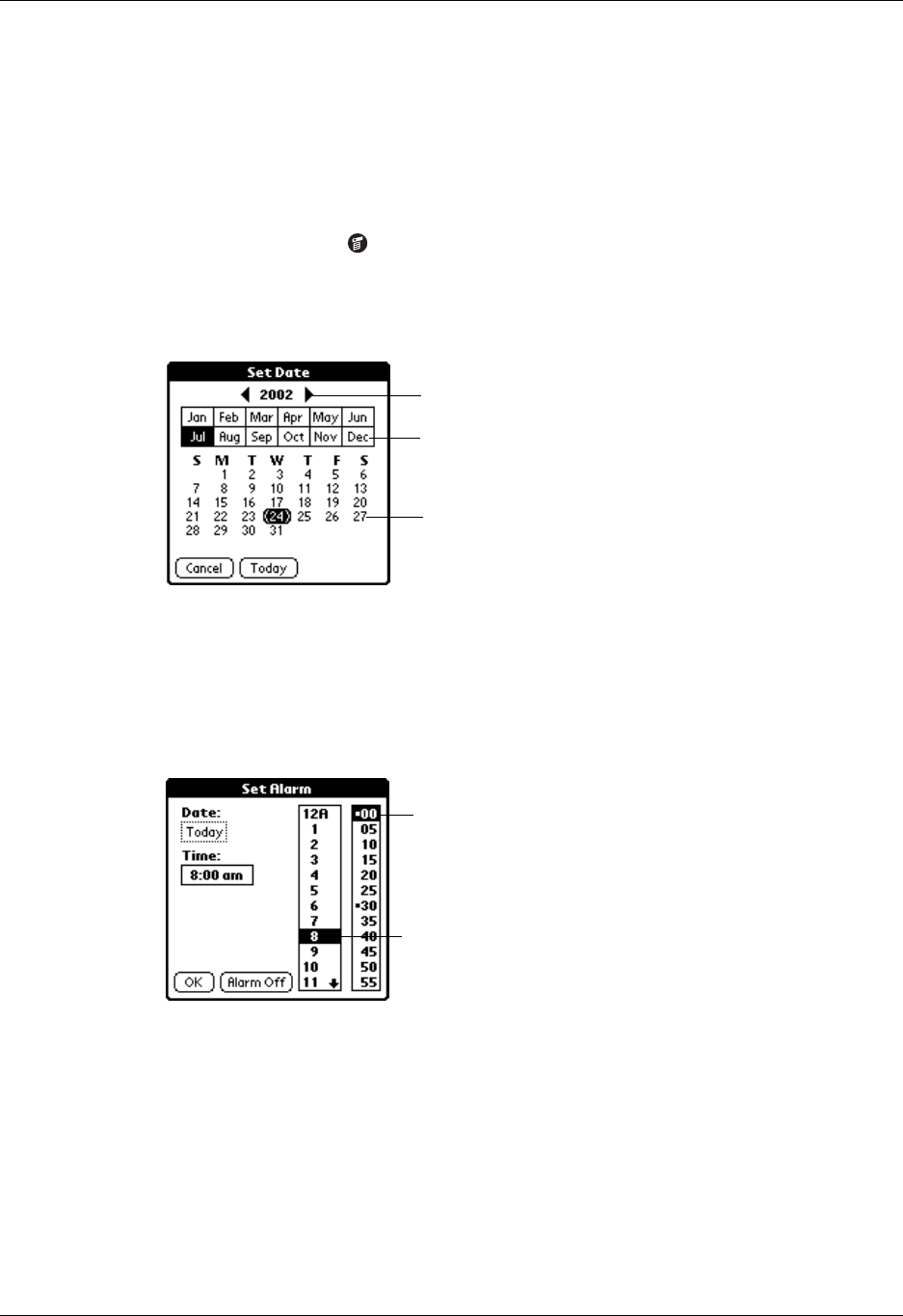
Chapter 11 Using Note Pad
120
Setting an alarm for a note
You can set an alarm for a specific time and date to remind you to follow up on
anote.
To set an alarm for a note:
1. Tap the note to which you want to assign an alarm.
2. Tap the Menu icon .
3. Select Options, and then select Alarm.
4. Tap the Date box.
5. Tap the year, month, and date you want the alarm to sound.
After you tap the date, the Set Alarm dialog box reappears.
6. Tap the Time box.
7. Tap the hour and minute columns to select the time you want the alarm to occur.
8. Tap OK.
9. When the alarm goes off and the reminder message appears onscreen, do one of
the following:
– Tap OK to permanently dismiss the reminder and return to the current
screen.
– Tap Snooze to dismiss the reminder and return to the current screen. An
attention indicator blinks in the upper-left corner of the screen to remind
you of the pending alarm, and the reminder message appears again in
Tap here to select month
Tap here to select year
Tap here to select date
Tap here to
select minutes
Tap here to
select hour
Palm, Inc. Confidential
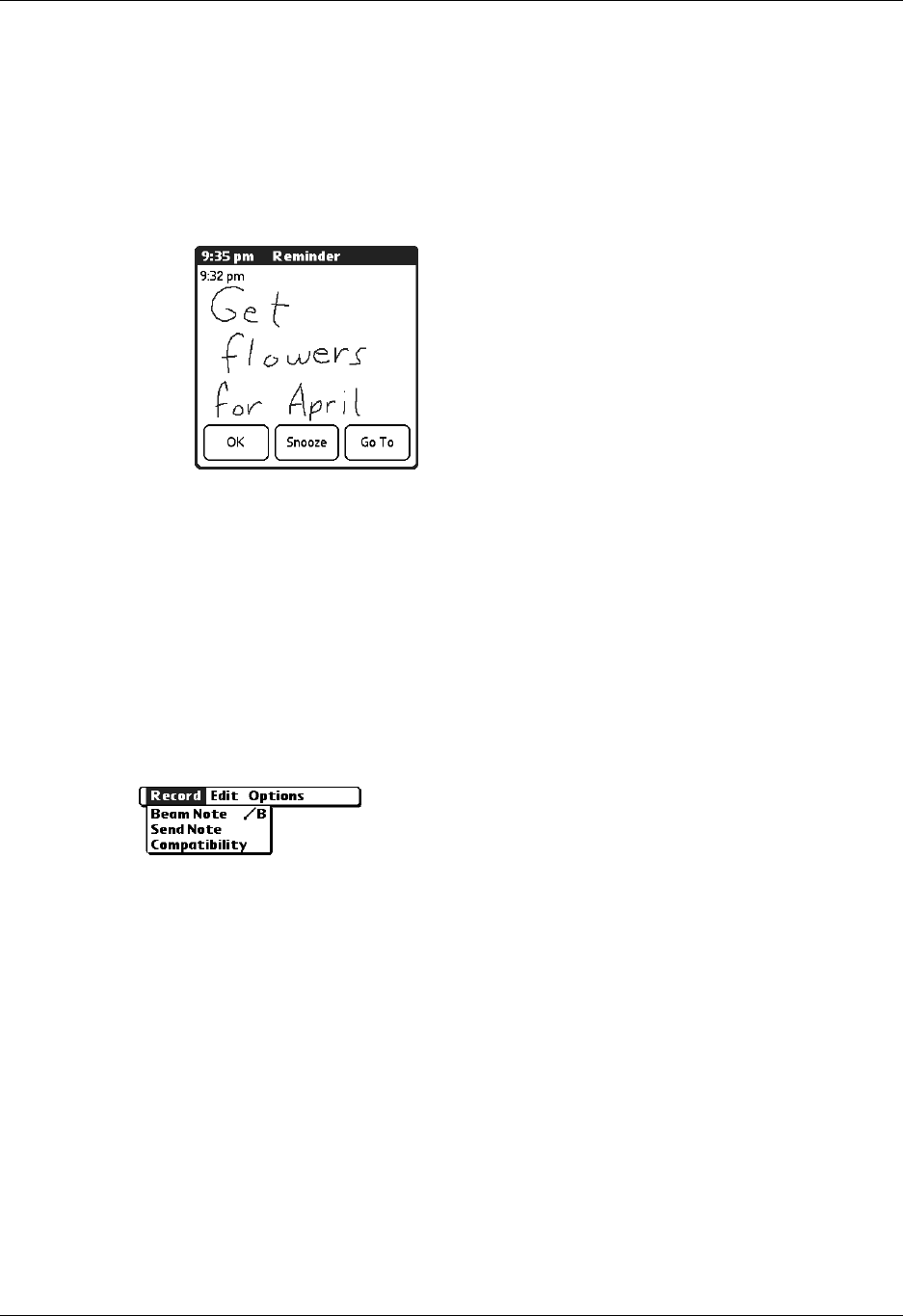
Using Note Pad menus
121
five minutes. When the reminder message reappears, the current time
appears in the Reminder bar and the note title appears on the screen.
– If you did not title the note, the time the note was created appears on the
screen.
– Tap Go To to open Note Pad. Note Pad will open and display the note
associated with the alarm.
Using Note Pad menus
Note Pad menus are shown here for your reference, and Note Pad features that are
not explained elsewhere in this book are described here.
The Record menu is the same when you’re viewing the Note Pad list and an
individual note. The Options menu differs depending on whether you’re viewing
the Note Pad list or an individual note.
Record menu
Send Category Opens a dialog box where you can choose how you want to
send all records in the selected category to another device. The
options available depend on the software installed on your
handheld.
Send Note Opens a dialog box where you can choose how you want to
send the selected note to another device. The options available
depend on the software installed on your handheld.
Compatibility Displays the Compatibility dialog box, where you can choose to
beam notes to a previous version of Note Pad.
Palm, Inc. Confidential

Chapter 11 Using Note Pad
122
Options menus
Preferences Displays the Note Pad Preferences dialog box, where you
define the pen and paper color, the sort order for notes, and the
alarm sound.
Details Displays the Note Details dialog box, where you assign a
category and privacy option for a note.
About Note Pad Shows version information for Note Pad.
Note Pad list Note screen
Palm, Inc. Confidential

123
CHAPTER 12
Using Phone Link
Phone Link helps you configure a connection between your handheld and
a compatible mobile phone. You can connect to a compatible mobile phone
using any of the following methods:
■Bluetooth technology: A wireless link that enables you to connect to a
Bluetooth-enabled mobile phone that is within 10 meters (approximately
30 feet) of your handheld. See “Bluetooth Preferences” in Chapter 17 for
additional information on Bluetooth technology.
■Infrared communication: A wireless link that enables you to connect to an
infrared-enabled mobile phone within 1 meter (approximately 39 inches) of
your handheld. The infrared ports on the two devices must be aligned and the
path between the two devices must be clear of obstacles. See “Beaming data” in
Chapter 3 for more information about your handheld’s infrared capabilities.
■A serial cable connection: A wire-based link that connects your handheld to a
mobile phone with a physical cable.
Serial cables and mobile phones that are enabled with infrared or Bluetooth
technology are sold separately.
What can you do with a phone connection?
When your handheld is linked to a mobile phone and your mobile phone carrier
supports the required services, you can do the following:
■Access the Internet: Use a high-speed wireless data service (such as GPRS), or
data services and an Internet service provider (ISP) dial-up account, to access
the Internet. To browse the web, you must install the web browser application
from the Software Essentials CD-ROM. Refer to the Palm Web Browser Pro
Handbook for information on using this application.
■Check and send e-mail: Use a high-speed wireless data service, or data services
and a dial-up connection to access your POP3 or IMAP e-mail account. To use
the e-mail features, you must install the e-mail application from the Software
Essentials CD-ROM. Refer to the Palm™ VersaMail™ Personal E-mail Software
Handbook for information on using this application.
Palm, Inc. Confidential

Chapter 12 Using Phone Link
124
■Exchange SMS messages: Use a GSM mobile phone carrier service to send and
receive short text messages. To use this feature you must install the SMS
message application from the Software Essentials CD-ROM. Refer to the SMS
Handbook for information on using this application.
■Dial telephone numbers from your Address Book: Use the Quick Connect and
Tap-to-Connect features with a GSM mobile phone to dial directly from your
Address Book. See “Making connections from Address Book” in Chapter 5 for
details.
■Use a dial pad on your handheld to dial numbers on your phone: Send telephone
numbers from your handheld to your GSM mobile phone. To use this feature
you must install the Dialer application from the Software Essentials CD-ROM.
Refer to the Dialer Handbook for information on using this application.
■Perform wireless HotSync® operations: Use your mobile phone as a modem, and
synchronize data with your computer from anywhere within your mobile
phone service area. To use this feature, your mobile phone service must include
data services. See “Conducting modem HotSync operations” in Chapter 16 for
additional information.
A GSM mobile phone, GSM network service, data service, high-speed wireless
data service, and an ISP account with a dial-up connection are not included with
your handheld.
Setting up a phone connection
To set up a phone connection, you must configure connection information on your
handheld. If you want to connect to the Internet and send and receive e-mail, you
must also configure the network service settings. The Phone Link and Phone Link
Updater applications guide you through this process. For information on how to
enter or modify these settings manually, see “Setting Communication
Preferences” in Chapter 17 and “Network preferences” in Chapter 17.
The instructions in this section assume that you already installed the desktop
software that came with your handheld and performed at least one HotSync
operation.
To configure a phone connection on your handheld:
1. If you are establishing a Bluetooth connection with a phone, you must first turn
on Bluetooth communication and turn on the Discoverable setting on your
handheld. See “Bluetooth Preferences” in Chapter 17 for instructions.
2. Tap the Home icon .
3. Select the Phone Link icon .
Palm, Inc. Confidential
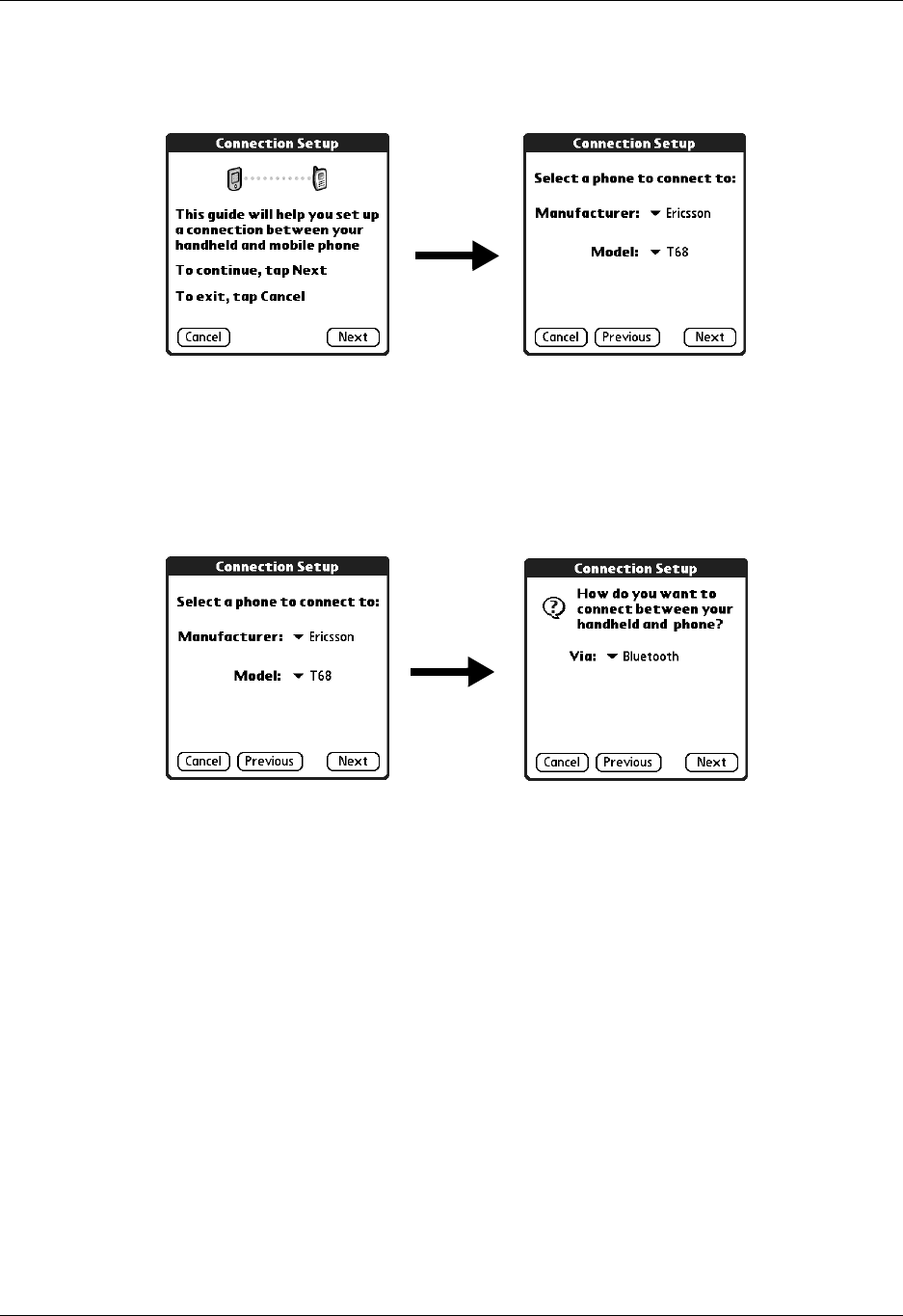
Setting up a phone connection
125
4. Tap the Phone Connection box.
The Connection Setup screen appears.
5. Tap the Manufacturer pick list and select your phone’s manufacturer.
6. Tap the Model pick list and select your phone model.
If your phone model does not appear on the list, you either need to download
and install a driver for your phone (see “Updating the phone files on your
handheld” later in this chapter) or your phone is not supported at this time.
7. Tap N ex t.
8. Tap the Via pick list and select the method you want to use to connect:
Bluetooth, Infrared, or Cable.
The Via pick list options will vary based on the phone model.
9. Tap N ex t.
10. If you selected Infrared or Cable in step 8, skip to “Configuring network service
settings for your phone” later in this chapter. If you selected Bluetooth in step
8, complete the steps in the procedure that follows.
Palm, Inc. Confidential
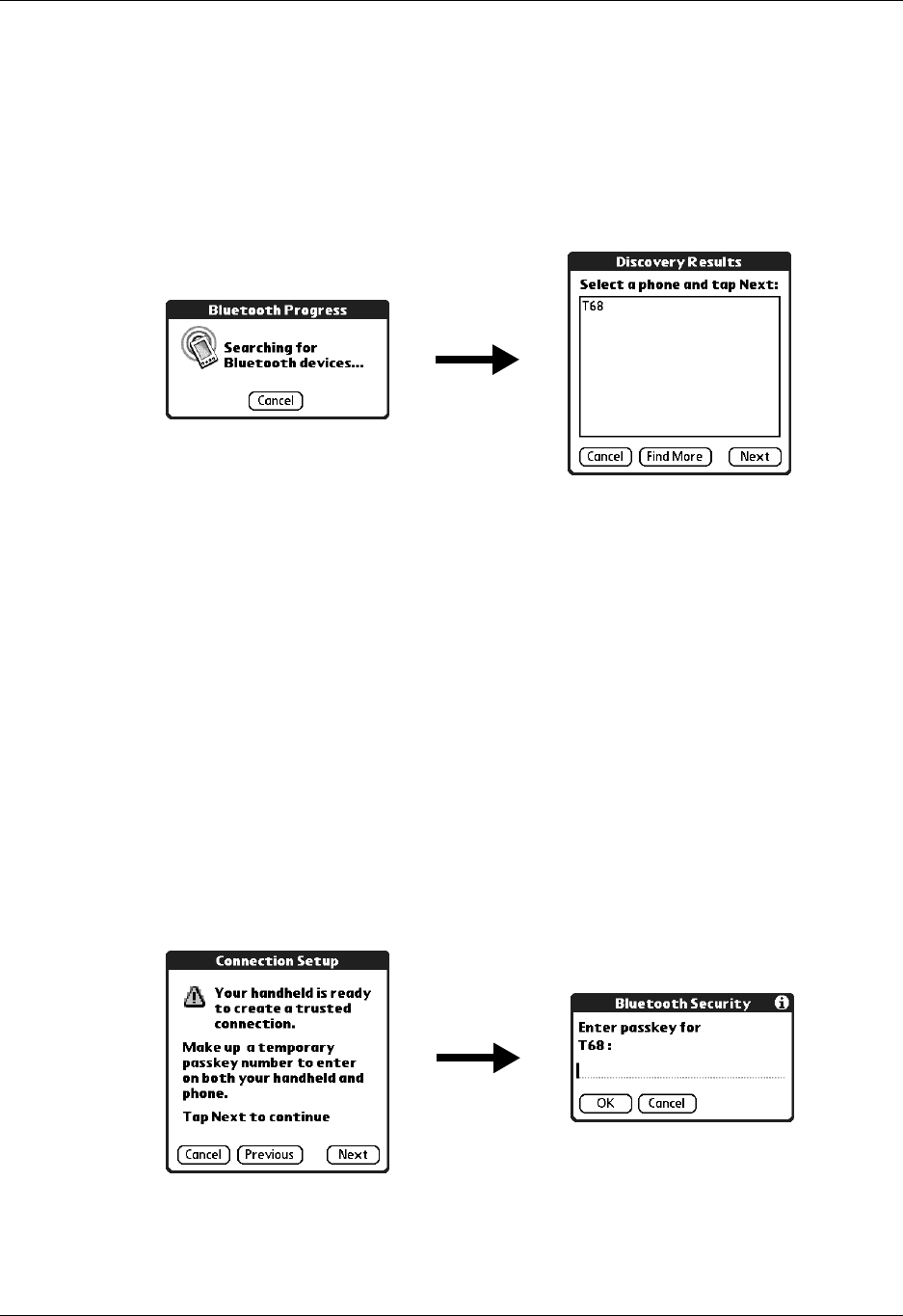
Chapter 12 Using Phone Link
126
To configure Bluetooth settings for your phone connection:
1. Place your phone into the mode where it can accept Bluetooth pairing from
another device. See the documentation that came with your phone for details.
2. Wait for your handheld to discover your phone.
When your handheld discovers a Bluetooth phone, it displays a screen similar
to the screen that follows.
3. Select your phone from the list.
If your phone doesn’t appear on the list, tap Find More, and select your phone’s
name when it appears on the list.
4. Tap N ex t.
Your handheld connects to your phone.
5. When prompted to create a trusted connection, tap Next.
6. Enter a passkey for this connection on your phone, and then tap OK.
A passkey is a unique identifier that enables secure data exchange between two
Bluetooth-enabled devices that have formed a connection with one another. The
passkey is stored on both devices. If Phone Link is unable to validate the same
passkey on both your handheld and your phone, an error message appears and
you are given the option to try connecting again. If you need additional
information about connecting your phone, refer to the Phone Pairing Handbook
for Palm™ Tungsten™ T Handheld at www.palm.com/support.
7. When prompted, to create a trusted connection, tap Next.
8. Enter a passkey for this connection on your handheld, and then tap OK.
Palm, Inc. Confidential
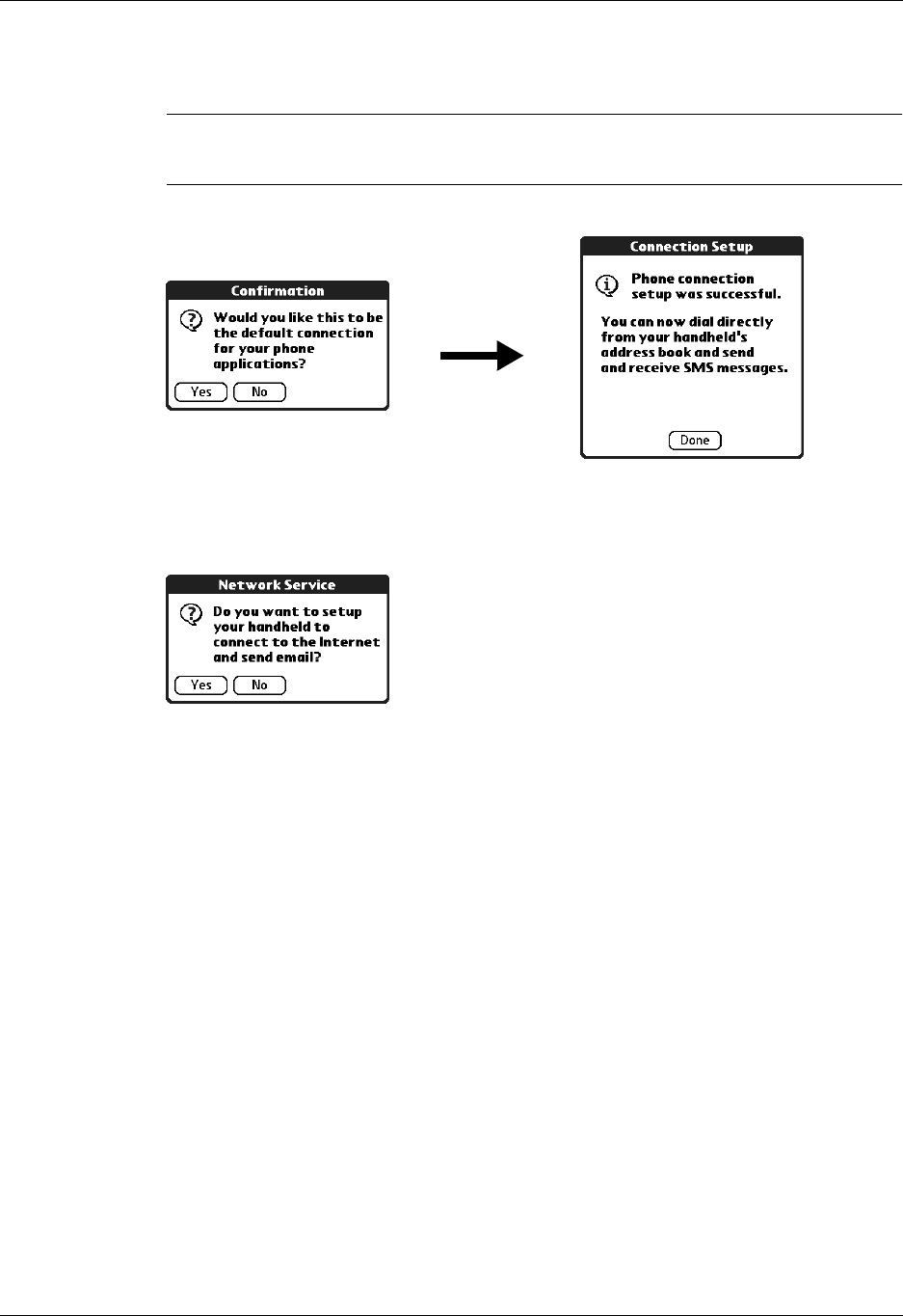
Setting up a phone connection
127
9. When the Confirmation dialog box appears, tap Yes.
IMPORTANT If you tap No in the Confirmation dialog box, the link between your
phone and handheld will not work.
10. Tap D o n e.
The Network Service dialog box appears.
11. Tap Yes, and then follow the instructions in the next section to set up network
services for your phone.
Configuring network service settings for your phone
If you want to use your handheld to connect to the Internet, and to send and
receive e-mail, you must configure network service settings for your phone. To
connect to the Internet, your mobile phone carrier must support data services and
you must also have one of the following:
■Access to a general packet radio service (GPRS) high-speed wireless data
service network
■A dial-up account with an ISP
■Dial-up or Bluetooth access to a corporate network with Internet access
Palm, Inc. Confidential
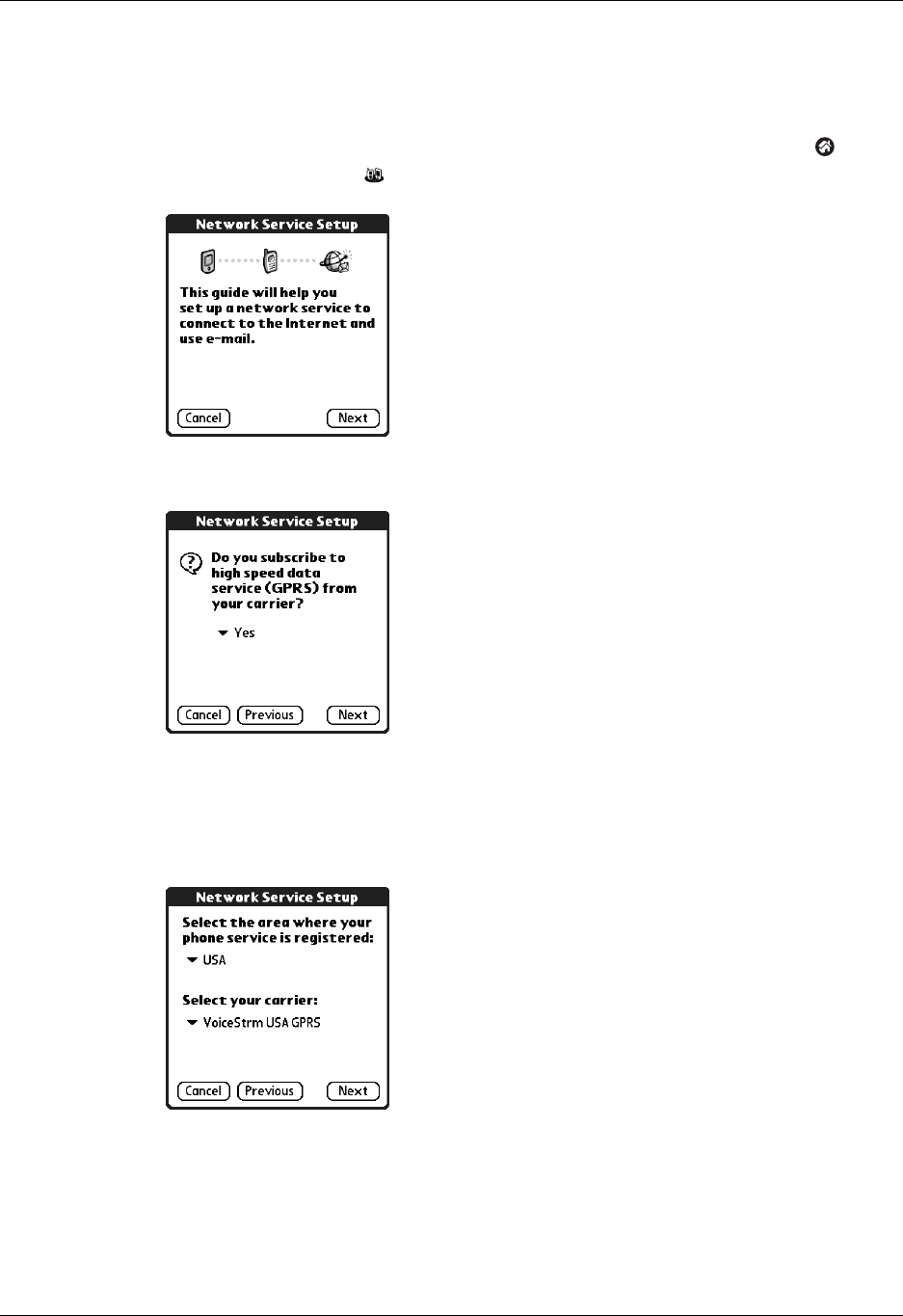
Chapter 12 Using Phone Link
128
To configure a GPRS high-speed wireless data service connection for your phone:
1. After completing step 11 in the preceding procedure, tap Next on the Network
Service Setup screen.
If you do not see the Network Service Setup screen, tap the Home icon , select
the Phone Link icon , and then tap the Network Service box.
2. Tap Yes when asked if you subscribe to a high-speed data service.
3. Tap N ex t.
4. Tap the Select the area... pick list and select your mobile phone carrier’s location.
5. Tap the Select your carrier pick list and select your mobile phone carrier.
If your mobile phone carrier does not appear on the list, you either need to
download and install the settings for your mobile phone carrier (see “Updating
the phone files on your handheld” later in this chapter) or your carrier is not
supported at this time.
Palm, Inc. Confidential
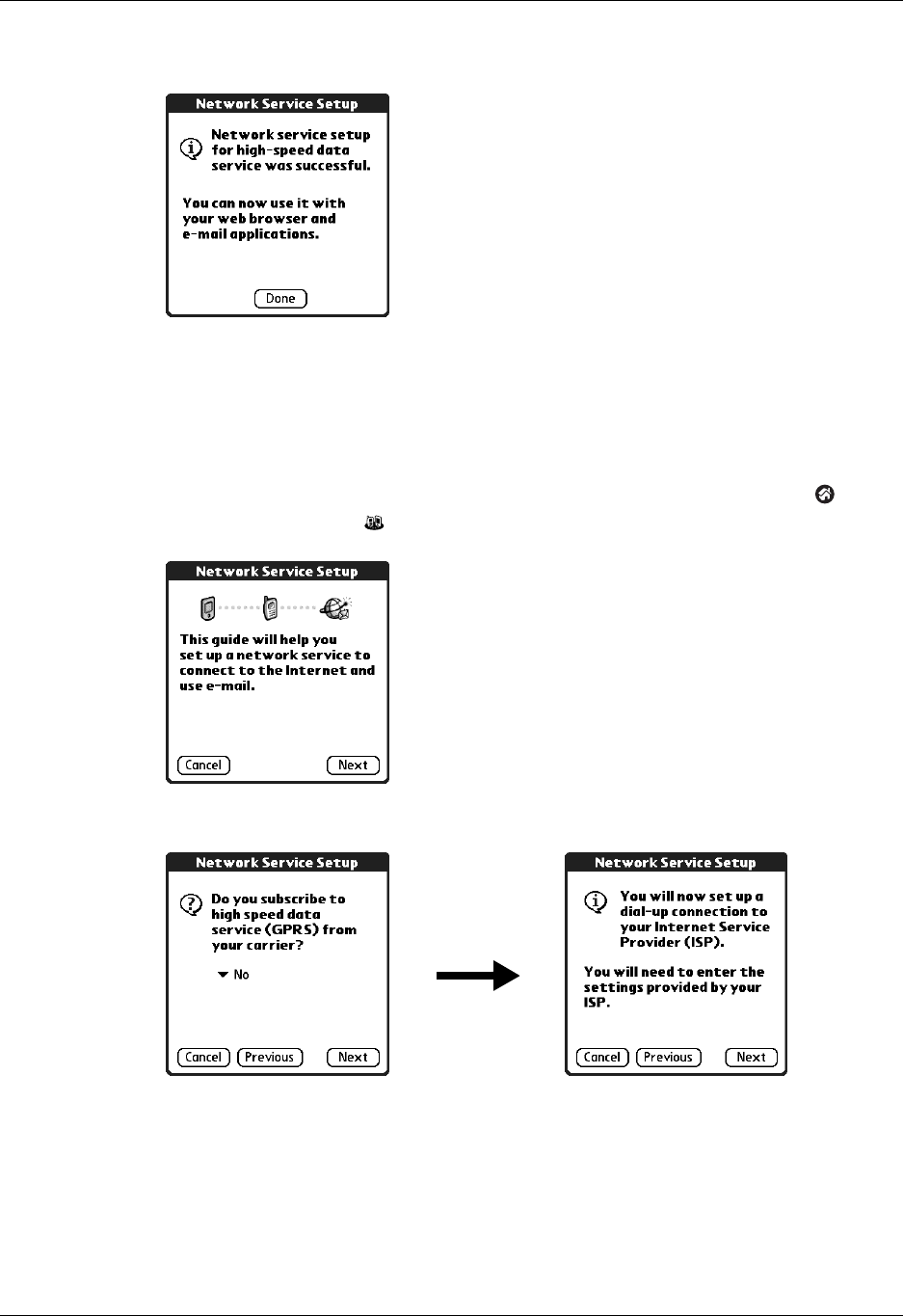
Setting up a phone connection
129
6. Tap N ex t.
7. Tap Don e.
To configure a dial-up connection:
1. After completing step 11 of the “To configure Bluetooth settings for your phone
connection:” procedure, tap Next on the Network Service Setup screen.
If you do not see the Network Service Setup screen, tap the Home icon , select
the Phone Link icon , and then tap the Network Service box.
2. Tap No when asked if you subscribe to a high-speed data service.
3. Tap N ex t.
A screen appears to inform you that you are about to set up a dial-up connection
for your ISP.
4. Tap N ex t.
Palm, Inc. Confidential
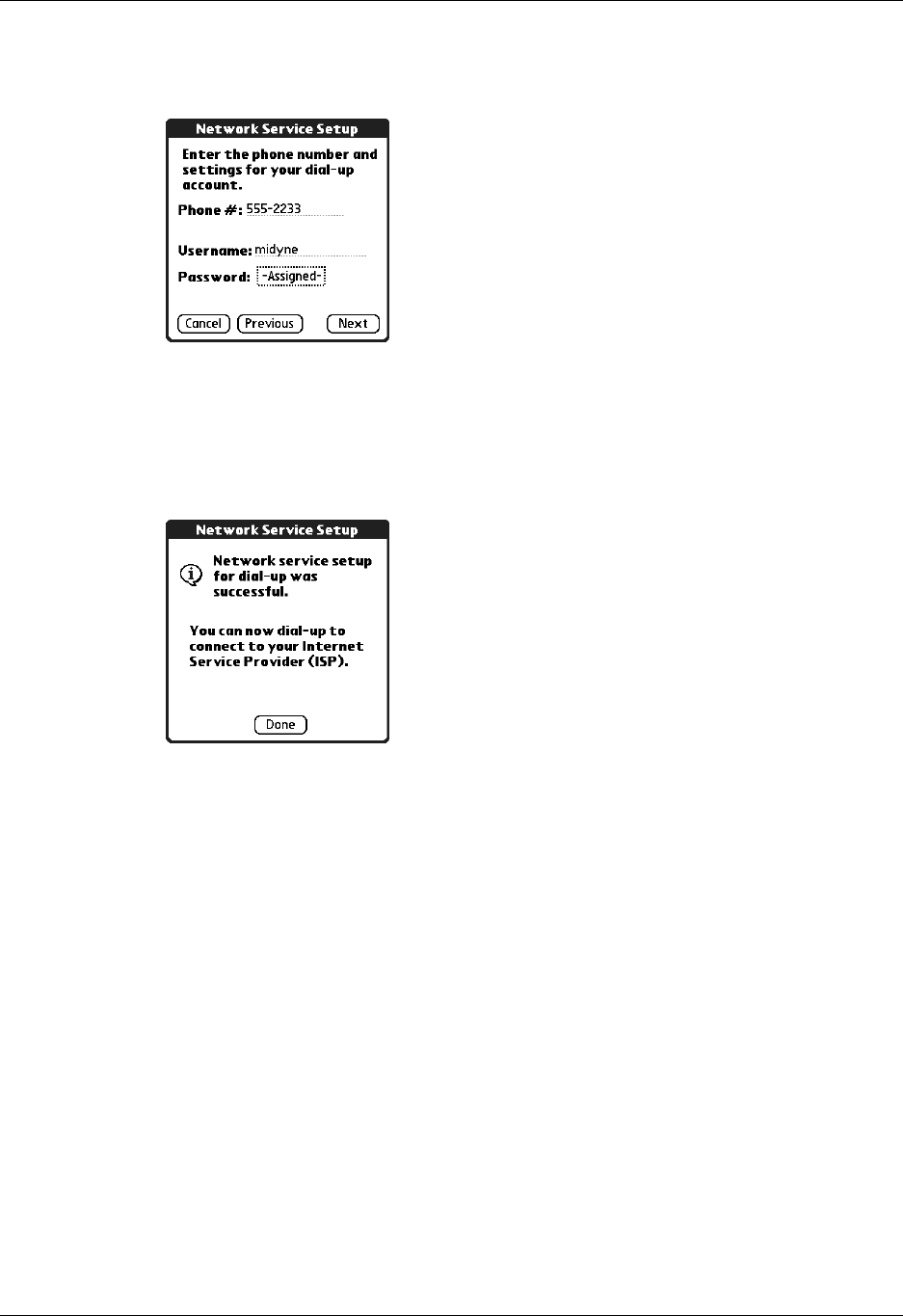
Chapter 12 Using Phone Link
130
5. Tap the Phone # field and enter the phone number you use to connect to
your ISP.
6. Tap the Username field and enter the name you use when you log into your ISP
account.
7. Tap the Password box and enter the password for your ISP account.
8. Tap N ex t.
9. Tap Don e.
Updating the phone files on your handheld
The Phone Link Updater application on your computer guides you through the
process of updating the telephony files on your handheld.
The instructions in this section assume that you have already installed the desktop
software that came with your handheld and have performed at least one HotSync
operation. You will also need Internet access to download the most recent phone
files during the installation.
To install the phone files from your Windows computer:
1. If you are establishing a Bluetooth connection with a phone, you must first turn
on Bluetooth communication and turn on the Discoverable setting on your
handheld. See “Bluetooth Preferences” in Chapter 17 for instructions.
2. From the Windows Start menu, select Programs, select Palm Desktop, and then
click Phone Link Updater.
Palm, Inc. Confidential

Using phone connections
131
3. Follow the instructions on the screen and click Next and Back to navigate
between the screens as you do the following:
a. Download phone driver updates from the Internet.
b. Select your phone’s manufacturer and model.
If your phone is not listed, you cannot create a connection to your phone at
this time; try running Phone Link Updater again at a later date to see if a new
driver is available.
c. Select the region where you are located.
d. Select your mobile phone carrier service.
e. Select your handheld’s user name.
4. When prompted, perform a HotSync operation.
After the HotSync operation is complete, the phone files are now installed on
your handheld.
5. Click Finish.
If you need additional information about connecting your phone, refer to the Phone
Pairing Handbook for Palm™ Tungsten™ T Handheld at www.palm.com/support.
To install the phone files from your Mac computer:
1. If you are establishing a Bluetooth connection with a phone, you must first turn
on Bluetooth communication and turn on the Discoverable setting on your
handheld. See “Bluetooth Preferences” in Chapter 17 for instructions.
2. Download the correct driver for your phone from www.palm.com/support.
3. Install the phone driver as you would install any other add-on application.
See “Installing add-on applications” in Chapter 4 for details.
4. Perform a HotSync operation.
If you need additional information about connecting your phone, refer to the Phone
Pairing Handbook for Palm™ Tungsten™ T Handheld at www.palm.com/support.
Using phone connections
After you install the phone files and configure a link between your handheld and
your phone, you are ready to make connections. Depending on the type of link you
configured (infrared, cable, or Bluetooth), refer to the appropriate set of
instructions below.
By default, your handheld disconnects automatically when the connection is
inactive for 1 minute.
If you used the Network Preferences screen to set up multiple network service
profiles, you can choose a different service when you establish a connection.
See “Network preferences” in Chapter 17 for information on setting up multiple
network service profiles.
Palm, Inc. Confidential

Chapter 12 Using Phone Link
132
To make an infrared connection:
1. Turn on your handheld and your mobile phone.
2. Activate the infrared port on your phone.
3. Align the infrared port on your handheld with the infrared port on your phone.
4. Launch the application that requires the phone connection.
For example, to access the Internet, launch a web browser application.
To make a cable connection:
1. Connect the cable to your handheld and mobile phone.
2. Turn on your handheld and your mobile phone.
3. Launch the application that requires the phone connection.
For example, to access the Internet, launch a web browser application.
To make a Bluetooth connection:
1. Turn on your handheld and your mobile phone.
2. Activate Bluetooth on your handheld and phone.
3. Make sure your phone is within 10 meters (approximately 30 feet) of your
handheld.
4. Launch the application that requires the phone connection.
For example, to access the Internet, launch a web browser application.
Palm, Inc. Confidential

133
CHAPTER 13
Using To Do List
To Do List is a convenient place to create reminders and prioritize the things
you need to do. Use To Do List for the following:
■Make a quick and convenient list of things to do.
■Assign a priority level to each task.
■Assign a due date for any or all of your To Do List items.
■Assign To Do List items to categories so that you can organize and view them
in logical groups.
■Sort your To Do List items by due date, priority level, or category.
■Attach a note to an individual To Do List item for a description or clarification
of the task.
To open To Do List:
■Press the To Do List application button on the front panel of your handheld. To
Do List opens to display the list of all your records.
TIP Press the To Do List application button repeatedly to cycle through the
categories in which you have records.
To Do List button
Palm, Inc. Confidential
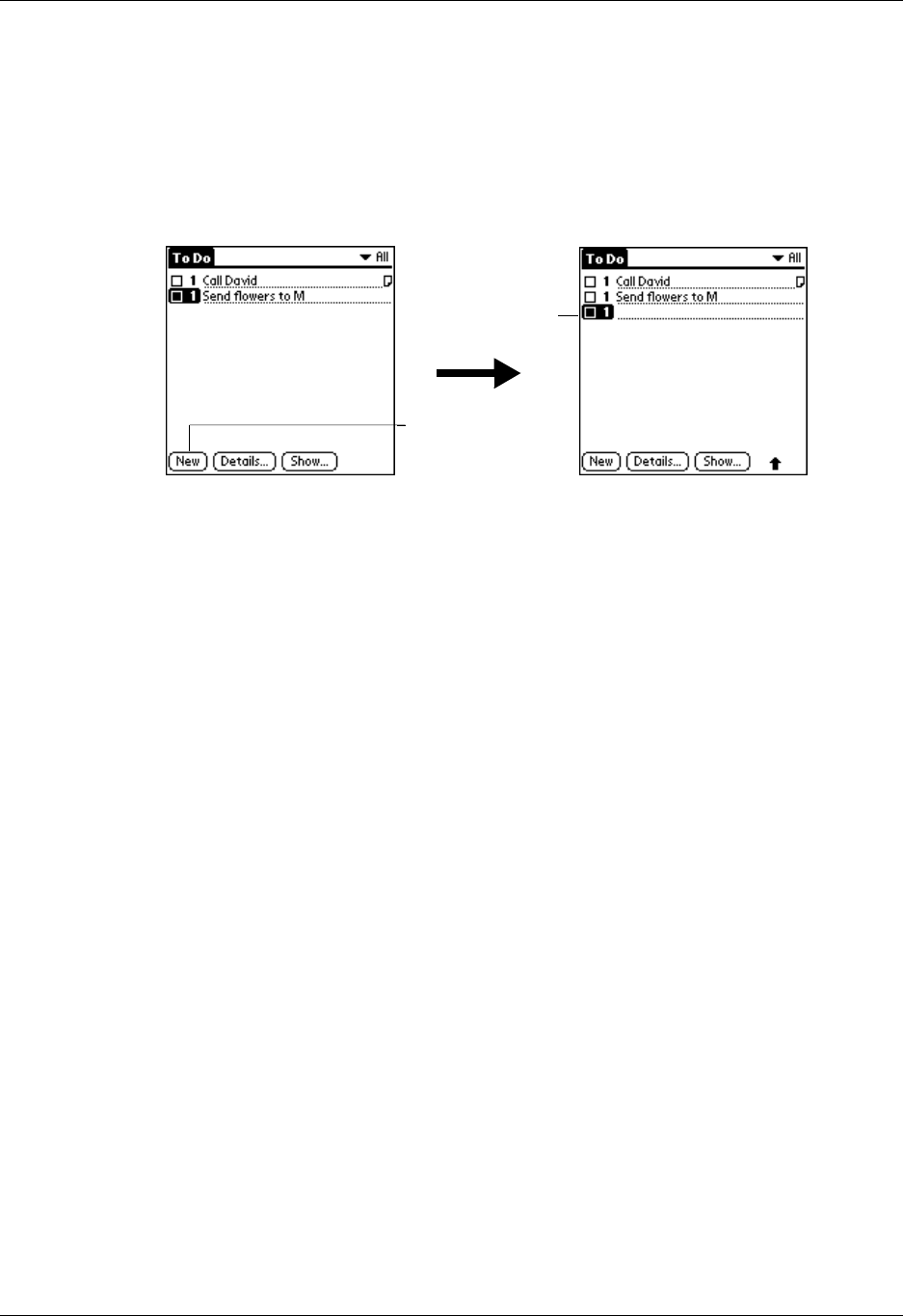
Chapter 13 Using To Do List
134
Creating list items
A To Do List item is a reminder of a task that you must complete. A record in To
Do List is called an item.
To create a To Do List item:
1. Tap N ew.
2. Enter the text of the To Do List item. The text can be longer than one line.
3. Tap anywhere onscreen to deselect the To Do List item.
TIP If no To Do List item is currently selected, writing in the Graffiti® writing
area automatically creates a new item.
Setting priority
You can use the priority setting for items to arrange the tasks in your To Do List
according to their importance or urgency. The default setting for the To Do List is
to arrange items by priority and due date, with priority 1 items at the top. If you
have a number of items in your list, changing an item’s priority setting may move
its position in the list.
When you create a new To Do List item, its priority is automatically set to level 1,
the highest (most important) level. If you select another item first, however, the
item you create appears beneath the selected item and is given the same priority as
the selected item.
Ta p N e w
New To Do
item
Palm, Inc. Confidential
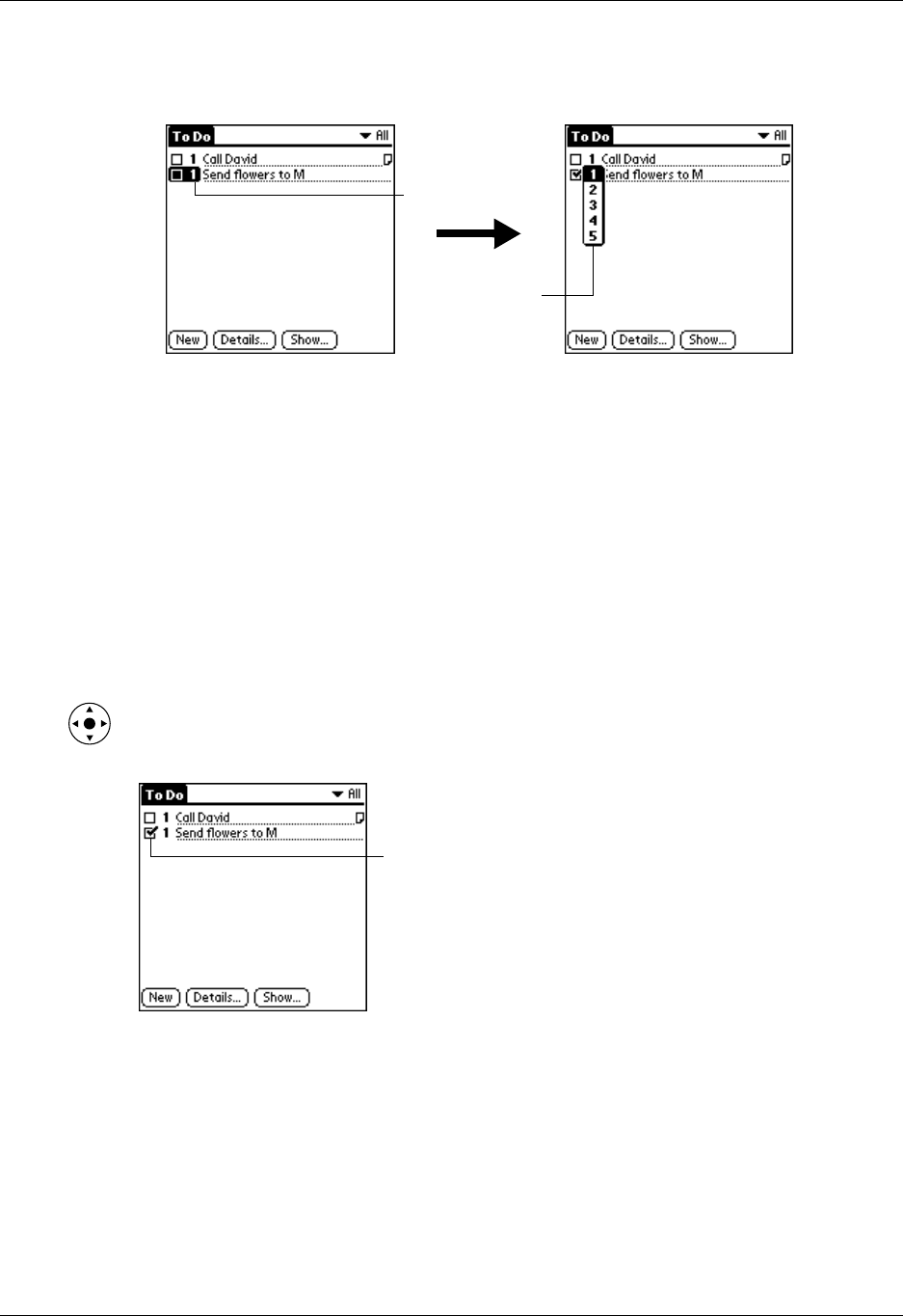
Checking off a To Do List item
135
To set the priority of a To Do List item:
1. Tap the Priority number on the left side of the To Do List item.
2. Select the Priority number that you want to set (1 is most important).
Checking off a To Do List item
You can check off a To Do List item to indicate that you’ve completed it. You can
set the To Do List to record the date that you complete the To Do item, and you can
show or hide completed items. See “Setting To Do Preferences” later in this
chapter.
To check off a To Do List item:
■Tap the check box on the left side of the item.
TIP You can also highlight the item you want to check off, and then press Select on
the navigator.
Select
priority
Tap here
Completed
To Do item
Palm, Inc. Confidential
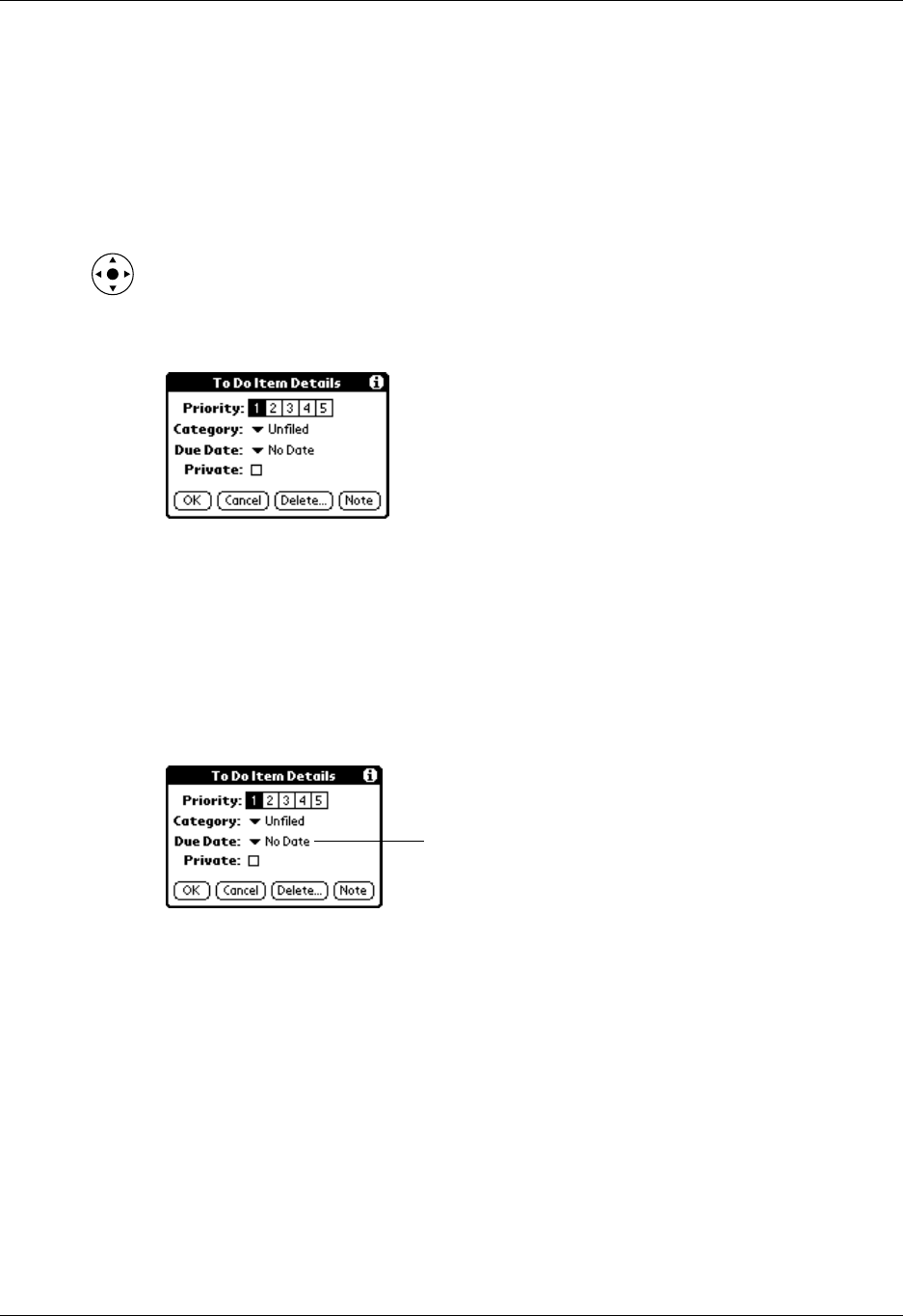
Chapter 13 Using To Do List
136
Changing To Do List item details
The To Do Item Details dialog box enables you to change settings for individual
items.
To display the To Do Item Details dialog box:
1. Tap the text of the item whose details you want to change.
TIP You can also select an item with the navigator. See “Using the navigator”
in Chapter 2 for details.
2. Tap Details.
Setting a due date
You can associate a due date with any To Do List item. You can also sort the items
based on their due dates.
To set a due date for a To Do List item:
1. In the Details dialog box, tap No Date to open the Due Date pick list.
2. Tap the date that you want to assign the item:
Today Assigns the current date.
To m o r r o w Assigns tomorrow’s date.
One week later Assigns the date exactly one week from the current date.
No Date Removes the due date from the item.
Choose date Opens the date selector, where you can choose any date
that you want for the item.
Ta p h e r e
Palm, Inc. Confidential
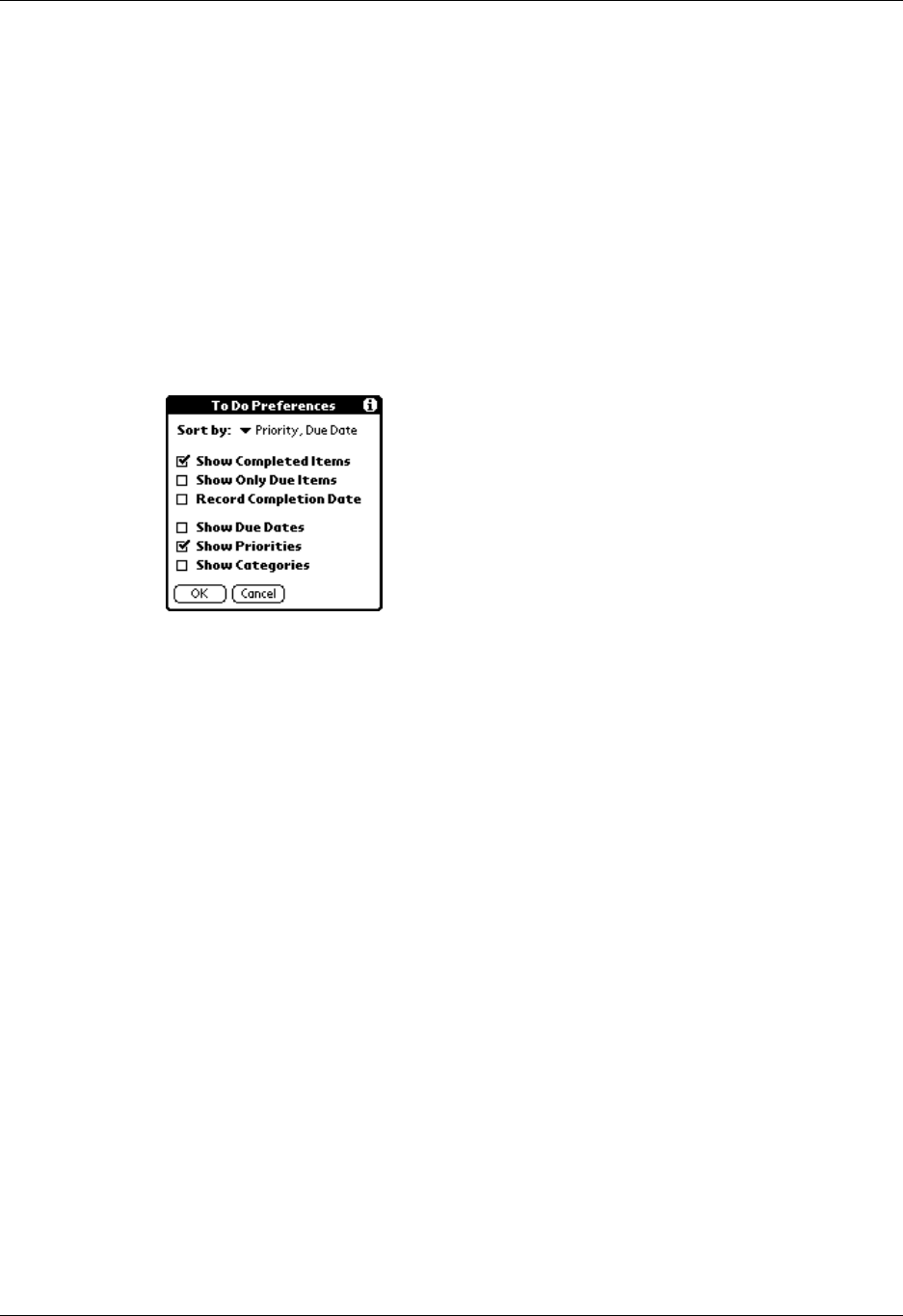
Changing To Do List item details
137
3. Tap OK.
TIP If you turn on the Show Due Dates option in the To Do Preferences dialog
box, you can tap directly on the due date in the To Do List to open the pick list
shown in step 2.
Setting To Do Preferences
The To Do Preferences dialog box enables you to control the appearance of To Do
List, and To Do items in Date Book Agenda view.
To change the Preferences settings:
1. In To Do List, tap Show.
2. Select any of the following settings:
Show Completed
Items Displays your completed items in the To Do List. If you turn
off this setting, your To Do items disappear from the list when
you complete (check) them.
Items that no longer appear on the list because you turn off
this setting have not been deleted. They are still in the
memory of your handheld. You can purge completed items to
remove them from memory.
Show Only Due
Items Shows only the items that are currently due, past due, or have
no due date specified. When this setting is active, items that
are not yet due do not appear in the list until their due date.
Record
Completion Date Replaces the due date with the actual date when you
complete (check) the item. If you do not assign a due date to
an item, the completion date still records when you complete
the item.
Show Due Dates Displays the due dates associated with items in the To Do List
and displays an exclamation mark next to items that remain
incomplete after the due date passes.
Palm, Inc. Confidential
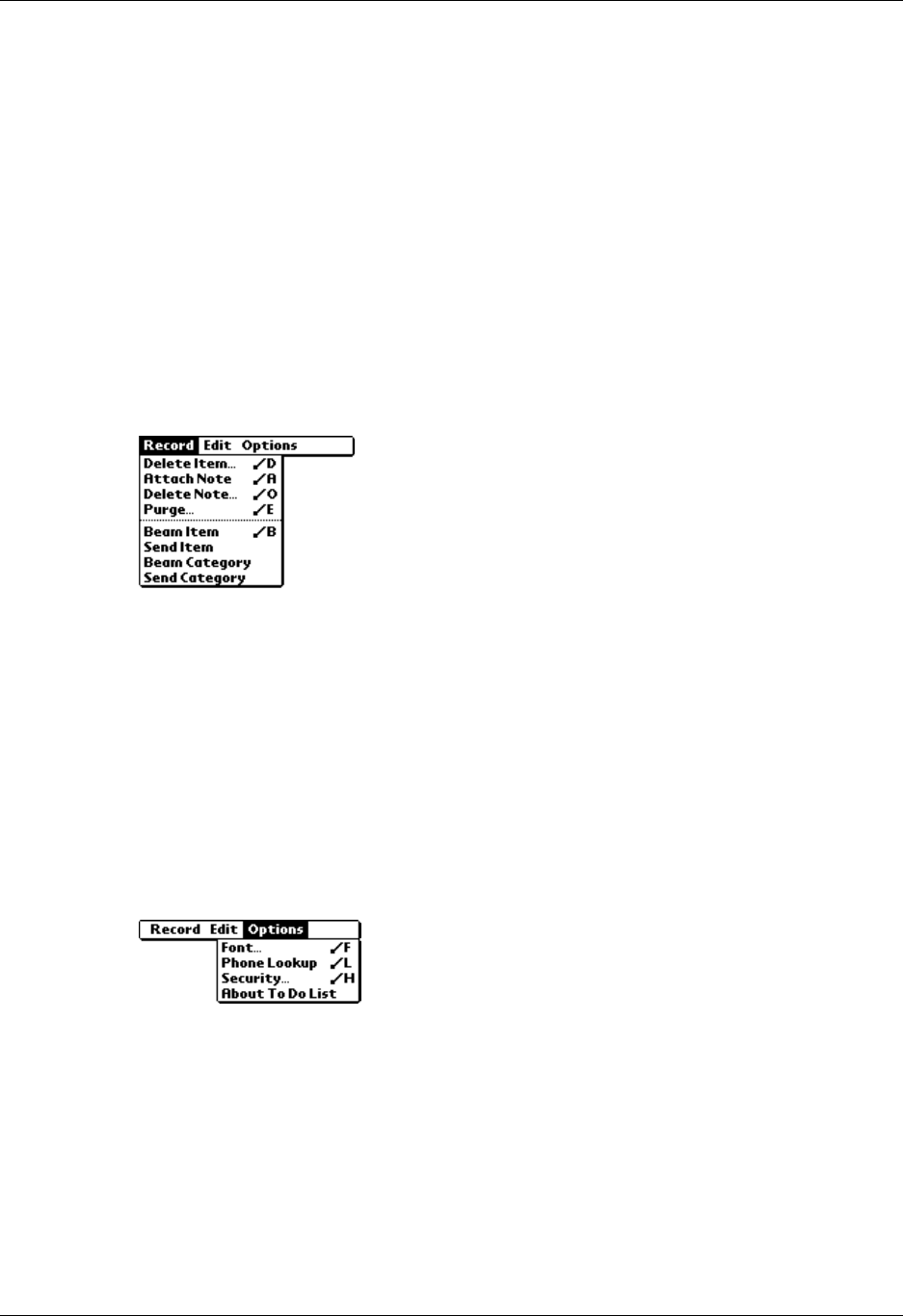
Chapter 13 Using To Do List
138
3. Tap OK.
Using To Do List menus
To Do List menus are shown here for your reference, and To Do List features that
are not explained elsewhere in this book are described here.
See “Using menus” in Chapter 4 for information about selecting menu commands.
Record menu
Options menu
Show Priorities Shows the priority setting for each item.
Show Categories Shows the category for each item.
Send Item Opens a dialog box where you can choose how you want to
send the selected item to another device. The options available
depend on the software installed on your handheld.
Send Category Opens a dialog box where you can choose how you want to
send all records in the selected category to another device. The
options available depend on the software installed on your
handheld.
About To Do List Shows version information for To Do List.
Palm, Inc. Confidential
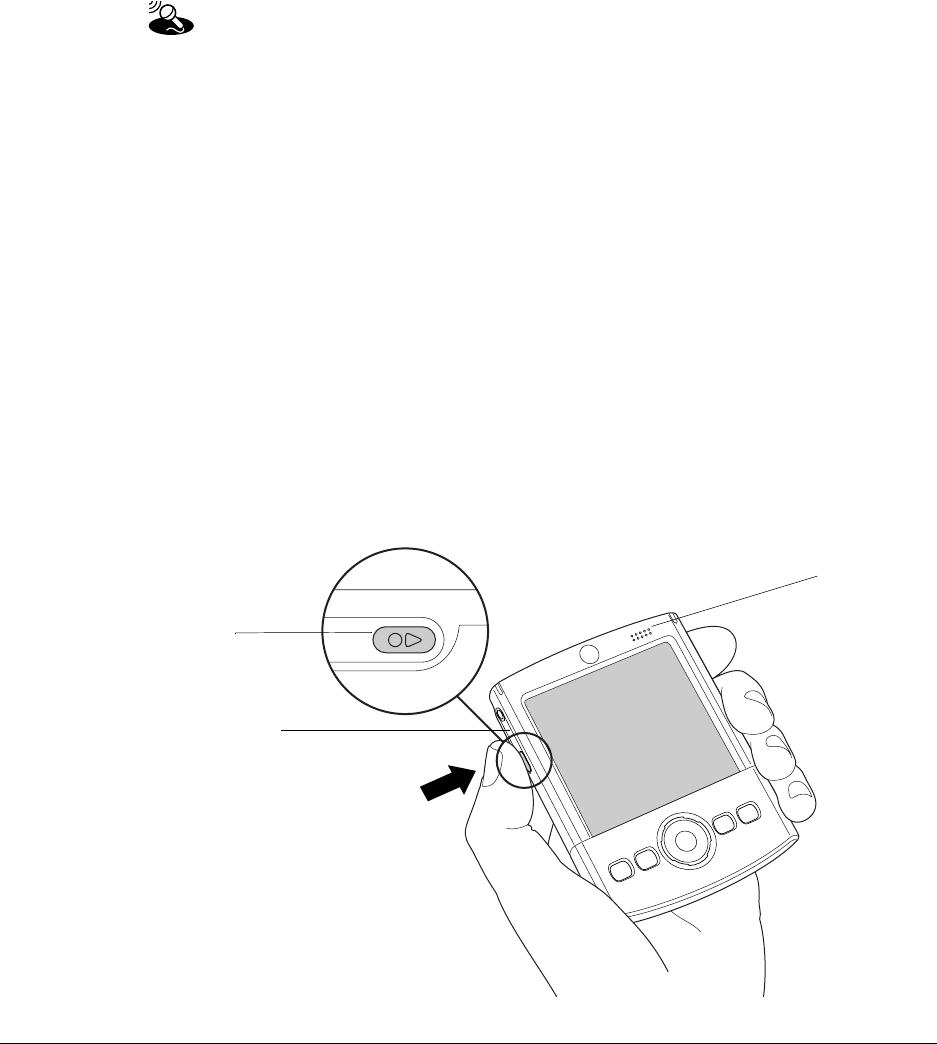
139
CHAPTER 14
Using Voice Memo
Voice Memo provides a place for you to record your thoughts while you’re
on the go. You can use Voice Memo to do things you might do with a voice
recorder, and more:
■Record and play back voice memos directly on your handheld.
■Set an alarm to use your voice memos as reminder messages.
■Assign your voice memos to categories so that you can organize and view them
in logical groups.
■Synchronize with your computer using Palm™ Desktop software and
HotSync® technology, and then listen to voice memos on your computer or send
them as e-mail attachments.
■Share voice memos with other people when you use the Send or Beam
commands.
■Conserve space on your handheld by storing voice memos on expansion cards.
To open Voice Memo:
■Press the Voice Memo application button on the side panel of your handheld.
Voice Memo opens to display the list of all your voice memos.
Voice Memo
button
Speaker
Microphone
Palm, Inc. Confidential

Chapter 14 Using Voice Memo
140
Creating a voice memo
To record a voice memo, you can use the Voice Memo application button or the
onscreen controls. To pause and resume while recording a voice memo, you must
use the onscreen controls. After you finish recording a voice memo, you cannot
add to or change the content, but you can assign the voice memo to a category or
change the voice memo title.
To conserve storage space on your handheld, you can also store your voice memos
on an expansion card.
Recording a voice memo
This section covers how to record a voice memo using the Voice Memo application
button.
To record a voice memo on your handheld:
1. Press and hold the Voice Memo application button .
IMPORTANT Continue holding the Voice Memo application button until you finish
recording. If you are recording a long voice memo and don’t want to continue
holding the Voice Memo application button, see “Pausing and resuming a voice
memo recording” later in this chapter to make a recording with the onscreen
controls. For optimum results, hold your handheld within 30 centimeters
(approximately 1 foot) of your face while recording.
A tone sounds to indicate that recording has started.
2. Face your handheld and begin speaking.
3. Release the Voice Memo application button to stop recording.
A tone sounds to indicate that recording has stopped.
4. (Optional) Select the time at the top of the screen and enter a title.
Palm, Inc. Confidential
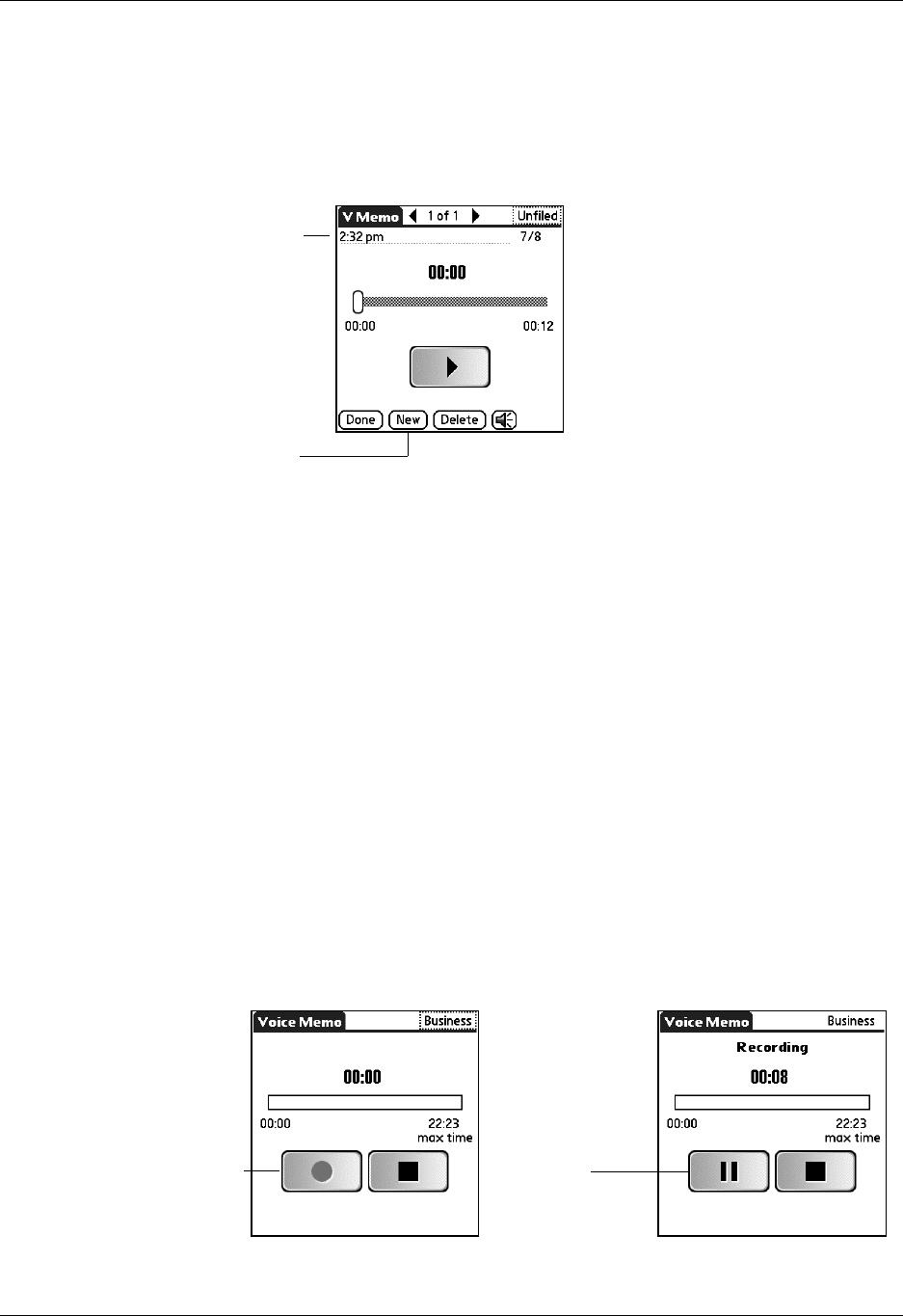
Creating a voice memo
141
5. (Optional) Tap the category pick list in the upper-right corner and select the
category where you want to store the voice memo.
TIP To automatically store voice memos on an expansion card, see “Storing
voice memos on an expansion card” later in this chapter.
6. Tap Don e.
Pausing and resuming a voice memo recording
To pause and resume while recording a voice memo, you must use the onscreen
controls. This section covers how to use the onscreen controls to pause and resume
while recording a voice memo.
To pause and restart while creating a voice memo:
1. In the Voice Memo list, tap New.
2. (Optional) Tap the category pick list in the upper-right corner and select the
category in which you want to store the voice memo.
TIP To automatically store voice memos on an expansion card, see “Storing
voice memos on an expansion card” later in this chapter.
3. Tap Record .
A tone sounds to indicate that recording has started.
4. Face your handheld and begin speaking.
Tap to create
another voice
memo
Enter title here
Pause
Record
Palm, Inc. Confidential
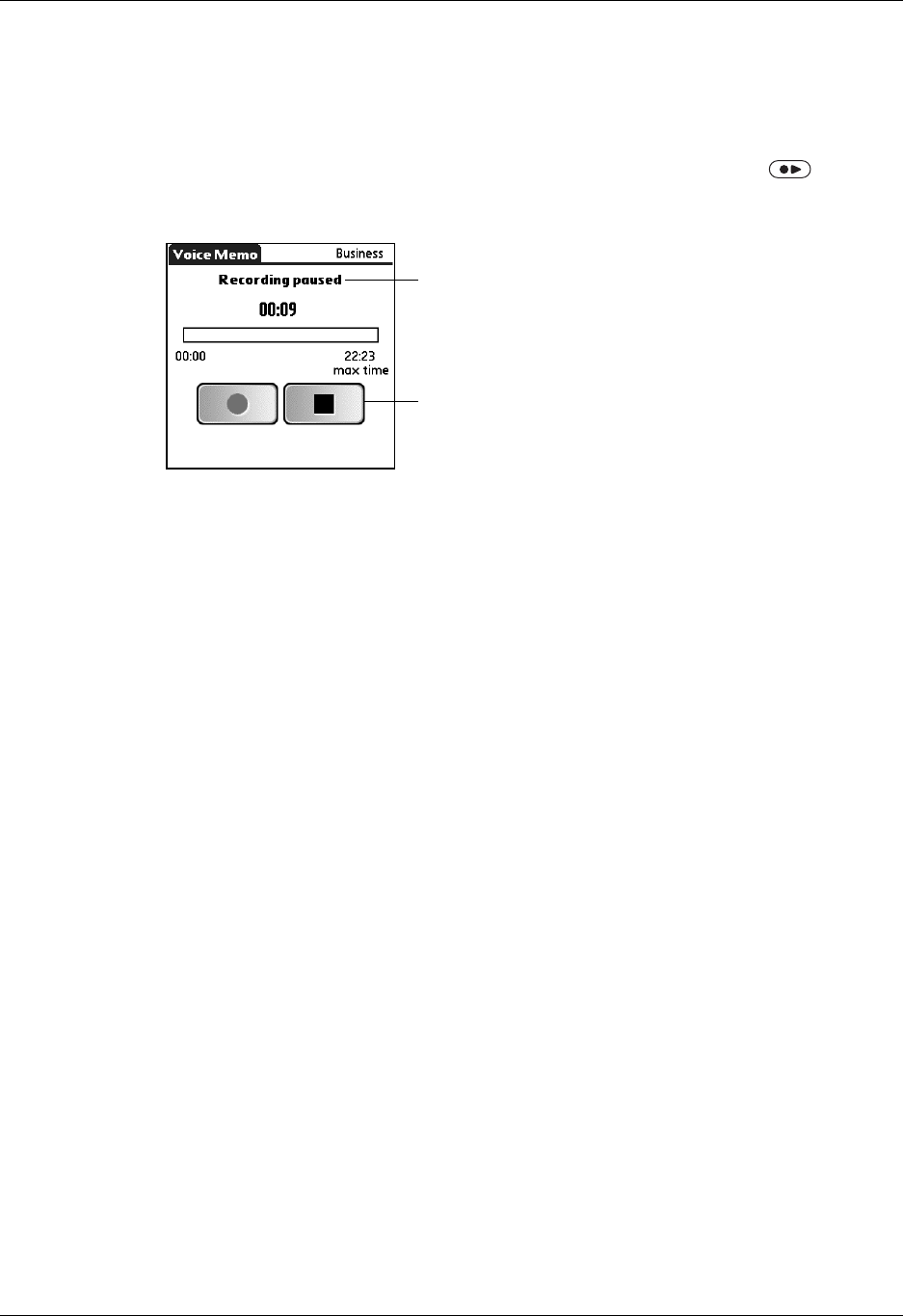
Chapter 14 Using Voice Memo
142
5. Tap Pause to stop recording.
A tone sounds to indicate that recording has paused.
NOTE If you use other applications on your handheld while pausing the
recording, press (and release) the Voice Memo application button to
resume recording later.
6. Tap Record .
A tone sounds to indicate that recording has restarted.
7. Tap Stop.
A tone sounds to indicate that recording has stopped.
8. (Optional) Select the time at the top of the screen and enter a title.
9. Tap Don e.
Storing voice memos on an expansion card
You can conserve storage space on your handheld, or create voice memos for
others, by storing your voice memos on an expansion card. Voice Memo enables
you to store specific voice memos on an expansion card, or to configure your
handheld to always store voice memos on an expansion card when one is present.
Keep in mind that when you store voice memos on an expansion card, they do not
appear in the Voice Memo portion of Palm Desktop software after a HotSync
operation and are not backed up. So, if you give your expansion card to a friend,
you do not have another copy of your voice memo(s). You must use a card reader
(sold separately) to view the contents of the expansion card on your computer, and
use a third-party application to back up data stored on an expansion card.
Additionally, you cannot mark voice memos private or attach alarms to voice
memos that are stored on an expansion card.
To store specific voice memos on an expansion card:
1. Create or open a voice memo.
2. Tap the category pick list in the upper-right corner and select Card.
3. Tap Don e.
Recording status
Stop
Palm, Inc. Confidential
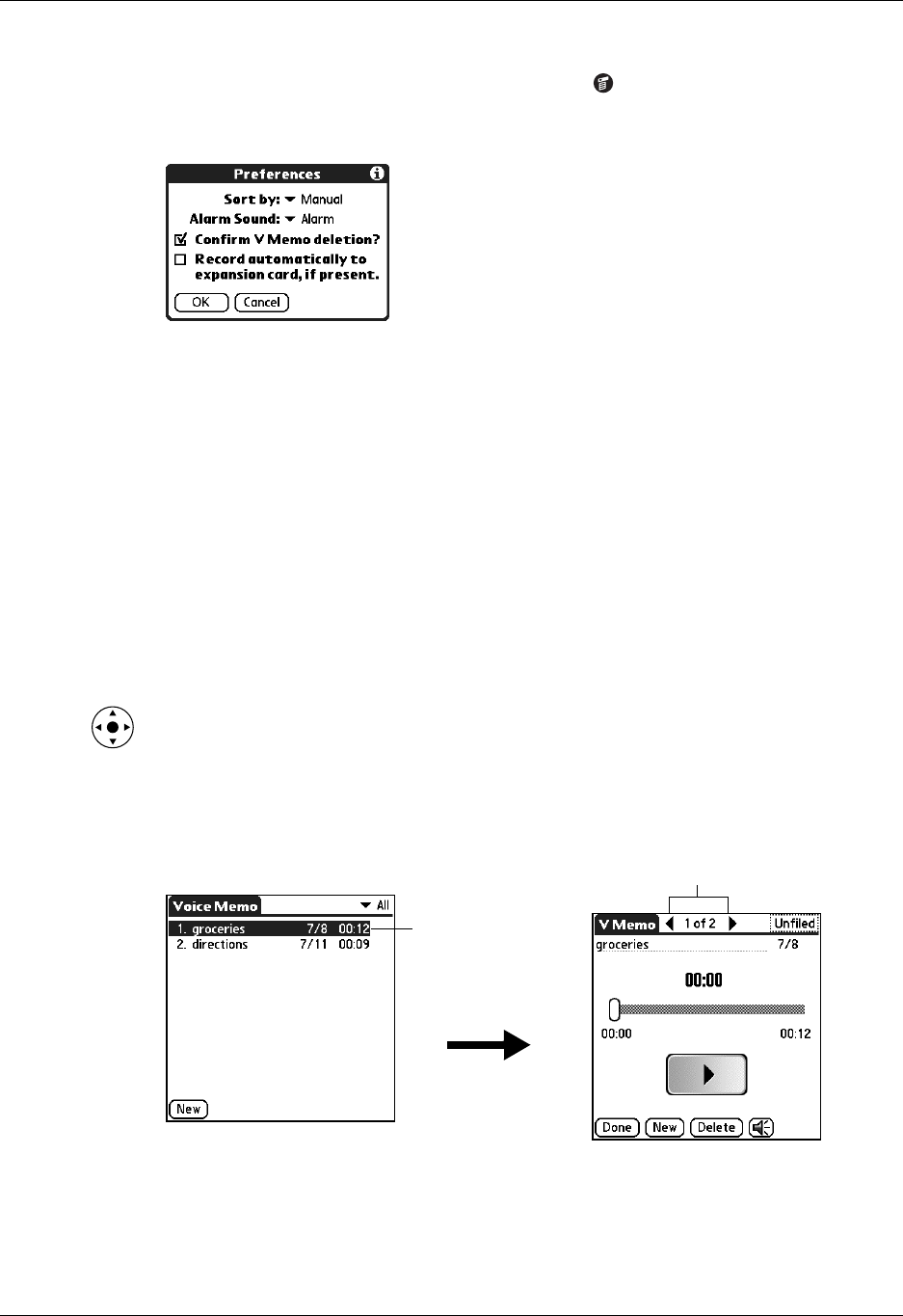
Listening to voice memos
143
To automatically store voice memos on an expansion card:
1. From the Voice Memo list, tap the Menu icon .
2. Select Options, and then select Preferences.
3. Select the check box Record automatically to expansion card, if present.
4. Tap OK.
Listening to voice memos
The Voice Memo list displays the title, creation date, and duration of each voice
memo. If you did not assign a title to a voice memo, the title appears as the time
you created the voice memo. This makes it easy to locate and listen to your voice
memos.
To listen to a voice memo:
1. In the Voice Memo list, select the voice memo title.
TIP You can also select a voice memo with the navigator. See “Using the
navigator” in Chapter 2 for details.
The voice memo begins to play after a few seconds. To start playing
immediately, tap Play.
2. Tap the arrows at the top of the screen to listen to the next or previous voice
memo.
T
ap arrows to scro
ll
to next
and previous voice memos
Select a
voice
memo
to hear
Palm, Inc. Confidential
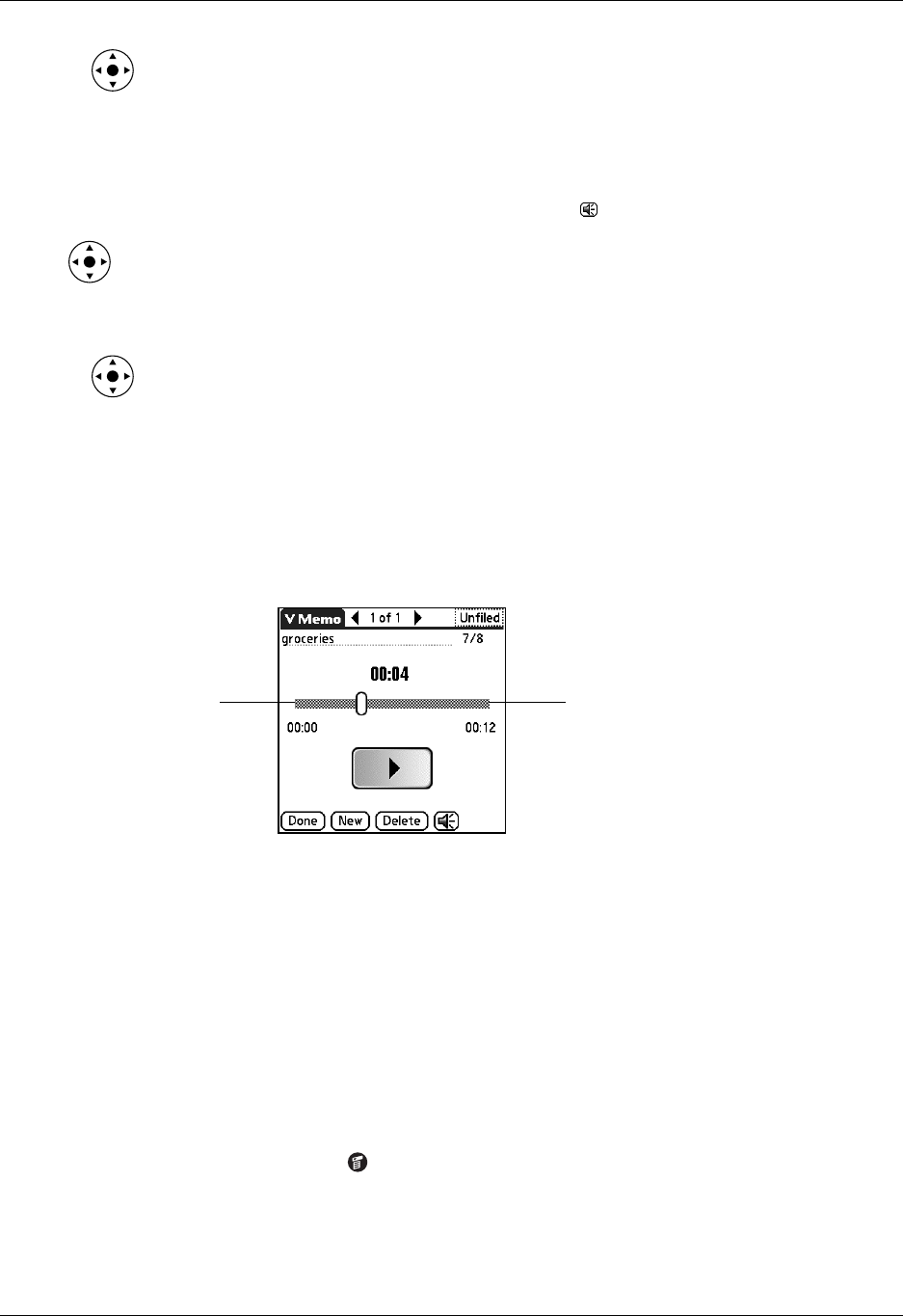
Chapter 14 Using Voice Memo
144
TIP You can also press Right or Left on the navigator to listen to the next or
previous voice memo.
3. Tap Don e.
To adjust the volume:
1. In the V Memo screen, tap the Speaker icon .
2. Drag the slider or press Up or Down on the navigator to adjust the
volume.
3. Tap Don e.
TIP When a voice memo is playing, you can also press Up on the navigator to
increase the volume or press Down to decrease the volume.
To play a portion of a voice memo:
1. In the Voice Memo list, select the voice memo title.
2. Drag the slider to the portion you want to hear.
TIP You can also tap the slider bar to jump the slider to that position.
3. Tap Play.
4. Tap Don e.
Setting an alarm for a voice memo
You can set an alarm for a specific time and date to remind you to follow-up on a
voice memo.
To set an alarm for a voice memo:
1. Select the voice memo to which you want to assign an alarm.
2. Tap the Menu icon .
3. Select Options, and then select Alarm.
Slider bar
Slider
Palm, Inc. Confidential
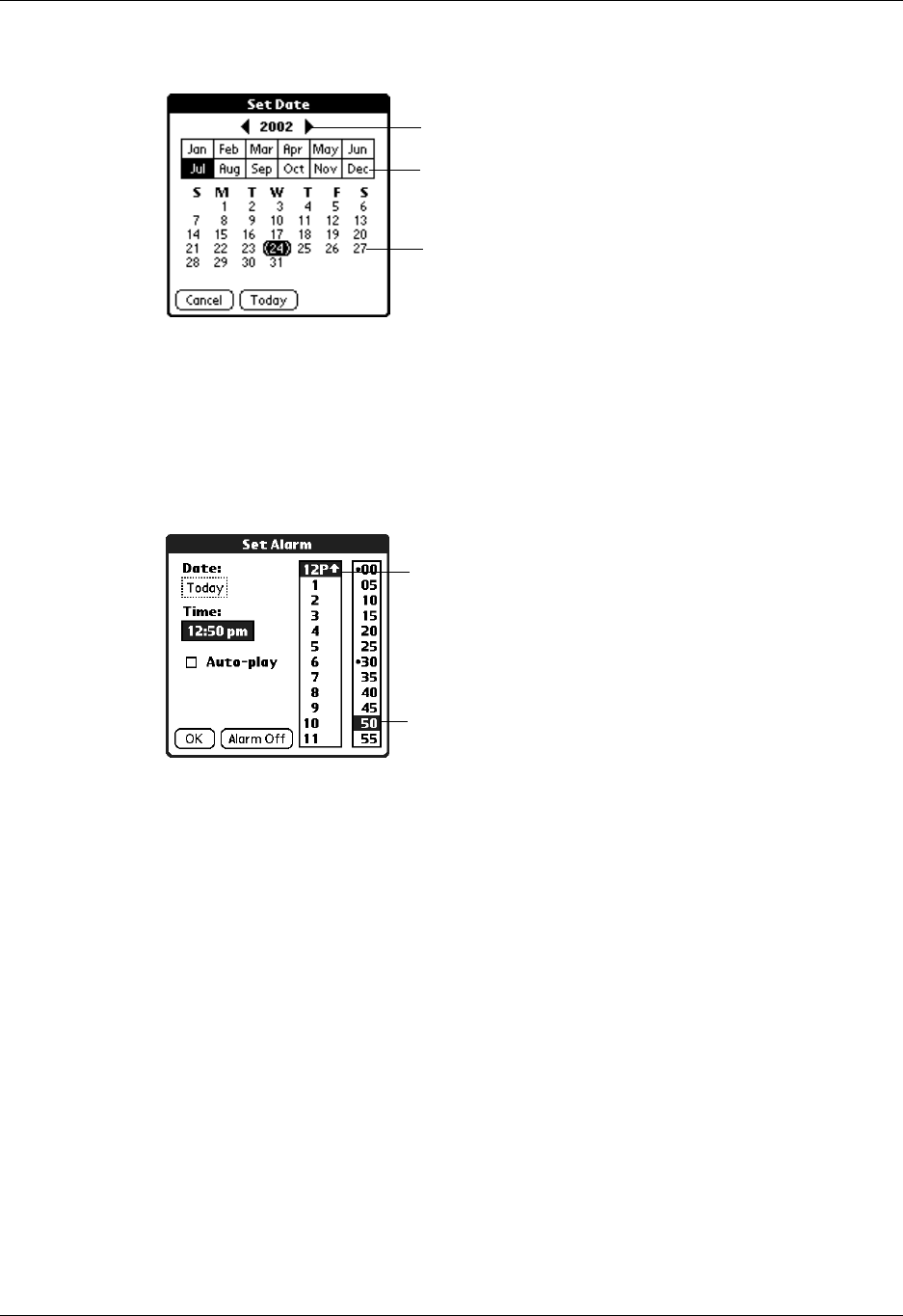
Setting an alarm for a voice memo
145
4. Tap the Date box.
5. Tap the year, month, and date you want the alarm to sound.
After you tap the date, the Set Alarm dialog box reappears.
6. Tap the Time box.
7. Tap the hour and minute columns to select the time you want the alarm to
occur.
8. (Optional) Tap the Auto-play check box to automatically play the voice memo
when the alarm goes off.
9. Tap OK.
10. When the alarm goes off and the reminder message appears onscreen, do one
of the following:
– Tap OK to permanently dismiss the reminder and return to the current
screen.
– Tap Snooze to dismiss the reminder and return to the current screen. An
attention indicator blinks in the upper-left corner of the screen to remind you
of the pending alarm, and the reminder message appears again in five
minutes. When the reminder message reappears, the current time appears in
the Reminder bar and the voice memo title appears on the screen. If you did
not title the voice memo, the time the voice memo was created appears on
the screen.
Tap here to select month
Tap here to select year
Tap here to select date
Tap here to
select minutes
Tap here to
select hour
Palm, Inc. Confidential
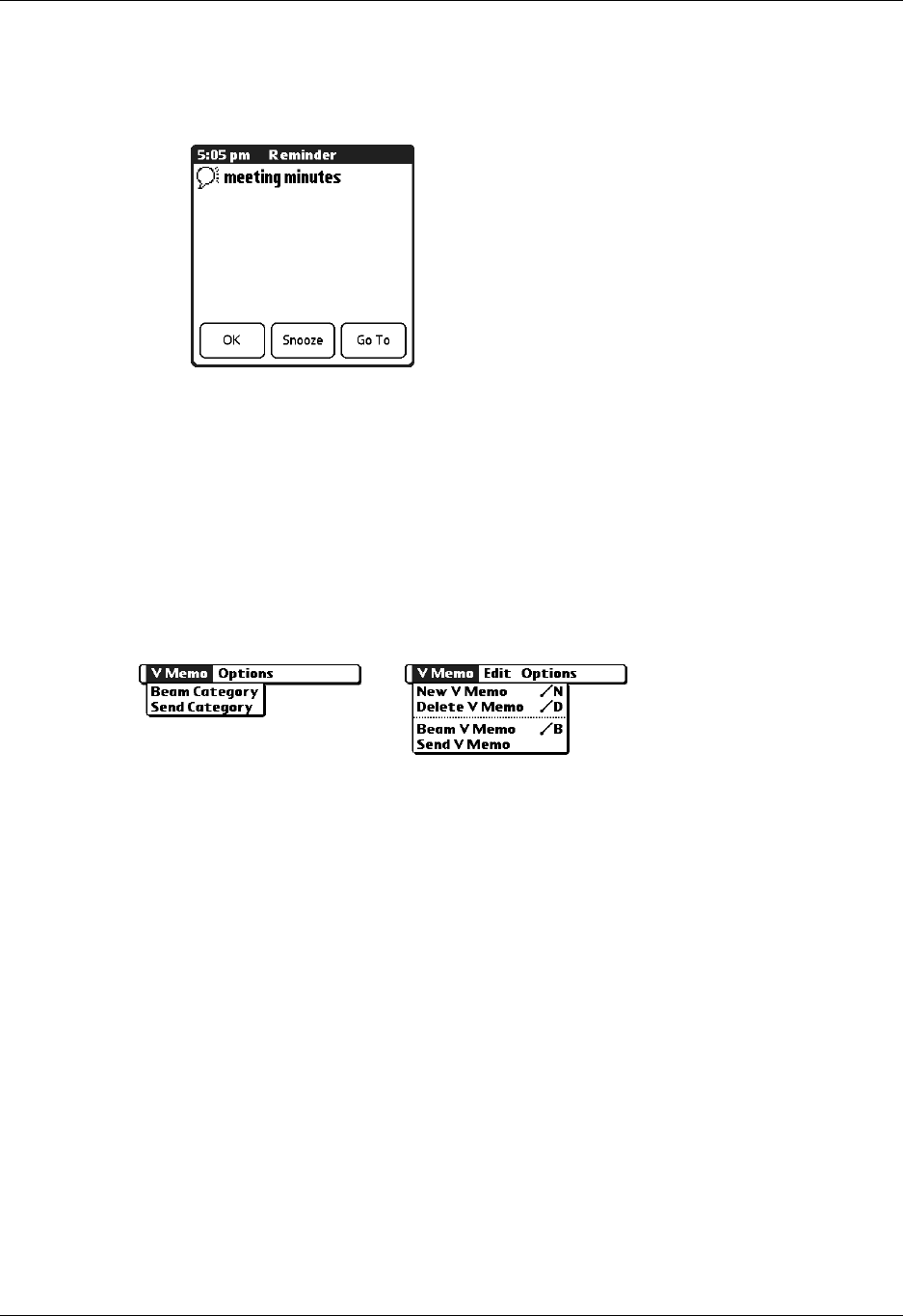
Chapter 14 Using Voice Memo
146
– Tap Go To to open Voice Memo. Voice Memo opens and displays the voice
memo associated with the alarm. Wait a moment for the voice memo to begin
playback, or tap Play.
Using Voice Memo menus
Voice Memo menus are shown here for your reference, and Voice Memo features
that are not explained elsewhere in this book are described here.
The Voice Memos and Options menus differ depending on whether you’re
displaying the Voice Memo list or an individual voice memo.
V Memo menus
Send Category Opens a dialog box where you can choose how to send the
category. The options available vary, based on the applications
installed on your handheld.
Send V Memo Opens a dialog box where you can choose how to send the voice
memo. The options available vary, based on the applications
installed on your handheld.
Voice Memo list
V Memo screen
Palm, Inc. Confidential

Using Voice Memo menus
147
Options menus
Preferences Displays the Voice Memo Preferences dialog box, where you
define the sort order for voice memos, the alarm sound,
deletion confirmation setting, and whether to automatically
store voice memos on an expansion card if one is present.
Security Displays the Change Security dialog box, where you set a
privacy option for all voice memos.
Details Displays the V Memo Details dialog box, where you assign a
category and privacy option for a voice memo.
About Voice
Memo Shows version information for Voice Memo.
Voice Memo list V Memo screen
Palm, Inc. Confidential

Chapter 14 Using Voice Memo
148
Palm, Inc. Confidential
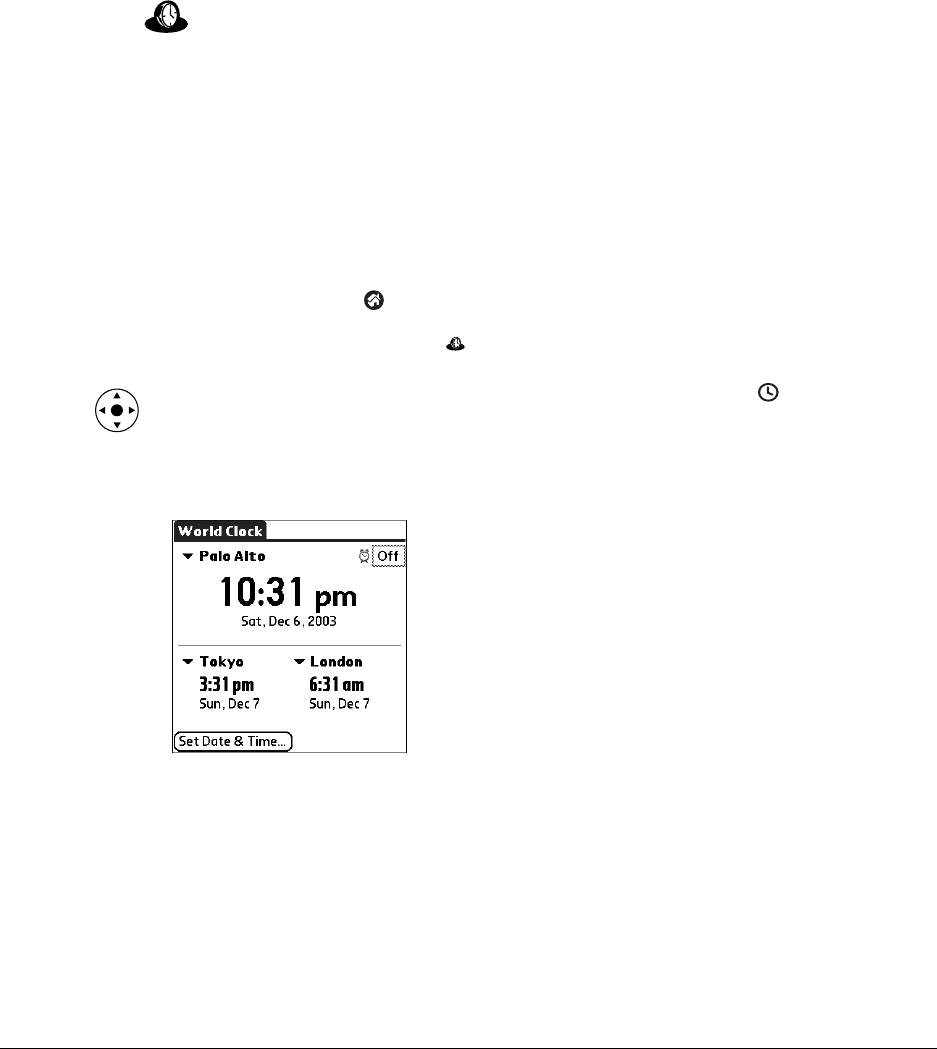
149
CHAPTER 15
Using World Clock
World Clock enables you to view the current time and date in multiple
locations and to set an alarm. Use World Clock to do the following:
■View the current time and date in three locations.
■Open a preferences screen where you can set the time and date for all the
applications on your handheld.
■Set an alarm.
■Set Daylight Saving options.
To open World Clock:
1. Tap the Home icon .
2. Select the World Clock icon .
TIP You can also open World Clock by tapping the Clock icon in the upper-
left corner of the Graffiti® writing area and then tapping Go to Clock, or when
your handheld is off, you can press Select on the navigator and then tap Go to
Clock.
Palm, Inc. Confidential
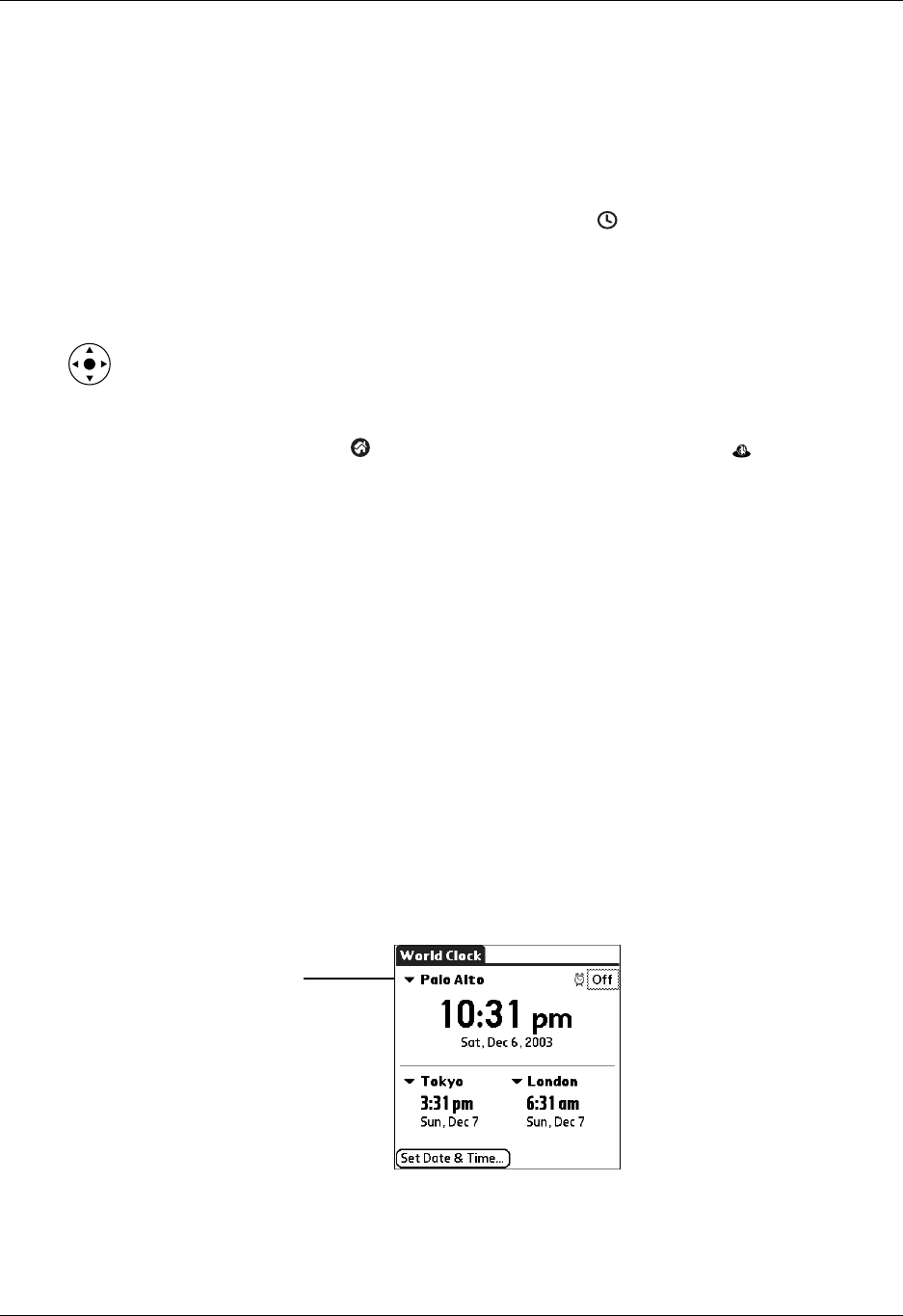
Chapter 15 Using World Clock
150
Viewing the time
There are several ways for you to easily check the current time and date.
To view the time:
Do one of the following:
■When your handheld is on, tap the Clock icon in the upper-left corner of the
Graffiti writing area.
Your handheld displays the time for two seconds and then returns to the
previous application.
■When your handheld is off, press Select on the navigator.
Your handheld turns on, displays the time, and then turns off after a few
seconds.
■Tap the Home icon , and then select the World Clock icon .
Setting the primary location
You can use World Clock to select the location, date and time for the primary
location. Keep in mind that the primary location settings are also your system date
and time and that these settings are used by all the applications on your handheld.
The primary Location settings also appear in the Date & Time Preferences screen.
Similarly, if you change the settings in the Date & Time Preferences screen, those
settings become your system date and time and also appear under the primary
location in World Clock. The primary Location settings also serve as a point of
reference for the secondary locations.
The following steps show you how to set the location, date and time from within
World Clo c k. See “Date & Time Preferences” in Chapter 17 for details on changing
these settings from the Preference screen.
To set the primary location:
1. Tap the primary location pick list.
Primary location
pick list
Palm, Inc. Confidential
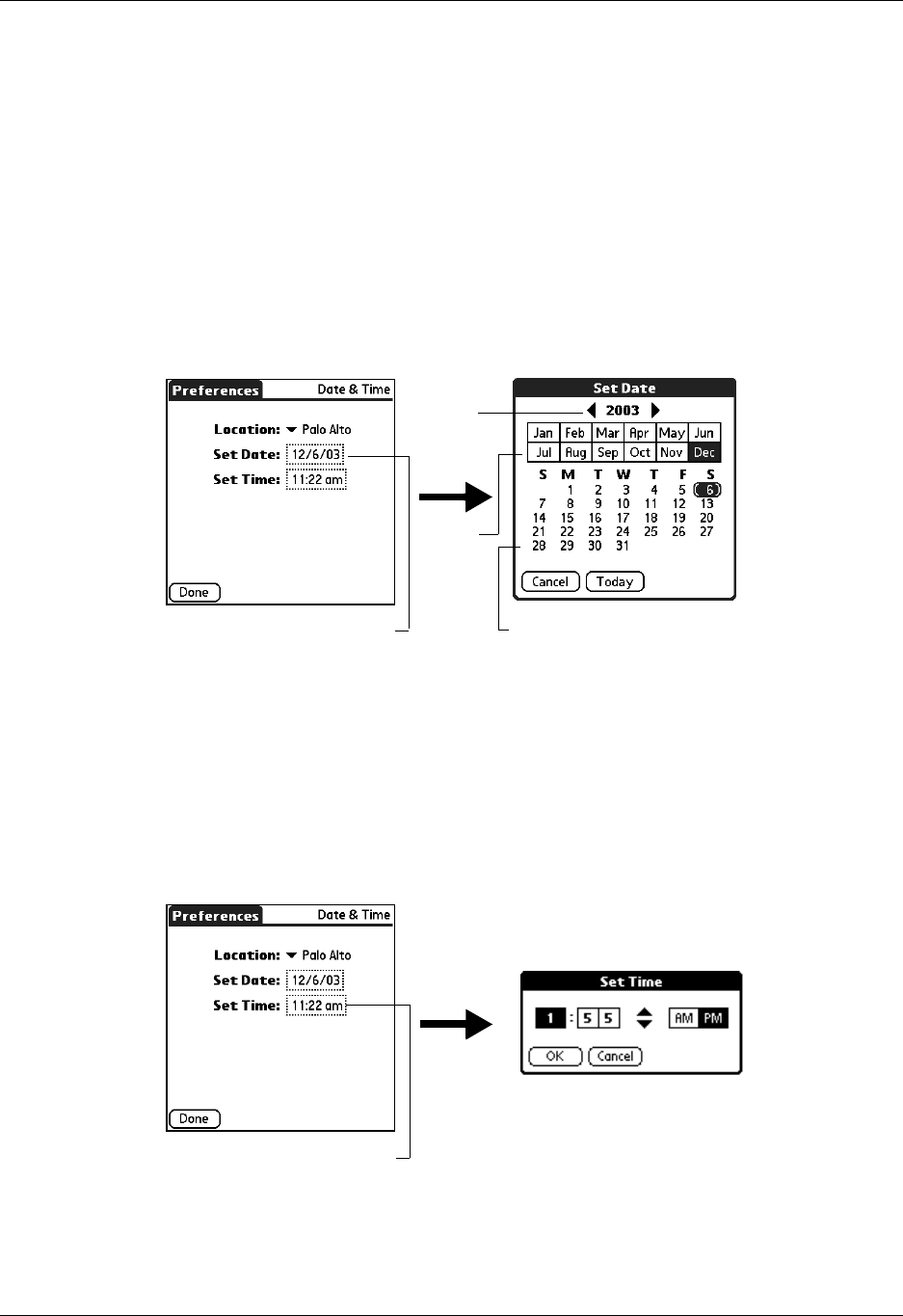
Setting the primary location
151
2. Tap the location you want to use as the primary location.
The location you select is typically a large city in the same time zone as the one
where you live. If an appropriate choice does not appear in the list, see “Adding
a location” later in this chapter to create a new location.
3. Tap OK.
To set the date:
1. Tap Set Date & Time.
2. Tap the Set Date box.
3. Tap the arrows to select the current year.
4. Tap the current month.
5. Tap the current date.
6. Tap Don e.
To set the time:
1. Tap Set Date & Time.
2. Tap the Set Time box.
Tap to set date
Ta p
arrows
to
select
year
Tap to
select
month
Tap to select date
Tap to set time
Palm, Inc. Confidential
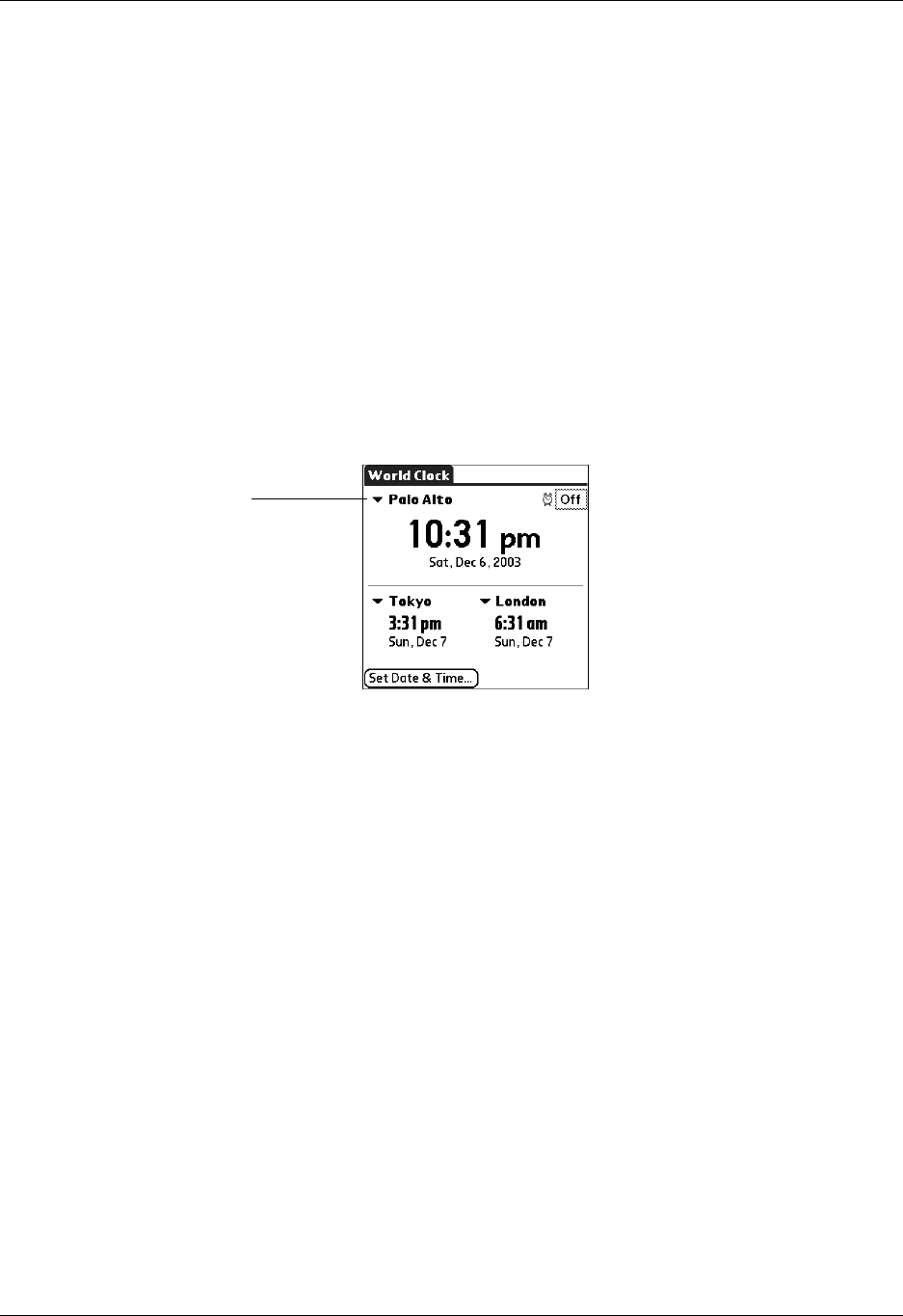
Chapter 15 Using World Clock
152
3. Tap the up or down arrows to change the hour.
4. Tap each number of the minute, and then tap the arrows to change the minutes.
5. Tap OK.
6. Tap Don e.
Choosing a different primary location
If you travel to another location and you want alerts to appear based on local time,
you need to change the primary location to update the system time. You may
prefer, however, to use the secondary locations to view the local date and time, and
to leave the primary location unchanged.
To change the primary location:
1. Tap the pick list next to the current primary location.
2. Tap the location you want to use as the new primary location.
If the new location is in another time zone, World Clock automatically updates the
date and time in all the applications on your handheld.
Setting the secondary locations
The secondary locations display the date and time in two locations other than the
primary location. You can use the secondary locations to view the time in places to
which you travel or need to contact people.
The date and time in the secondary locations are based on the date and time
settings in the primary location.
Primary
location
pick list
Palm, Inc. Confidential
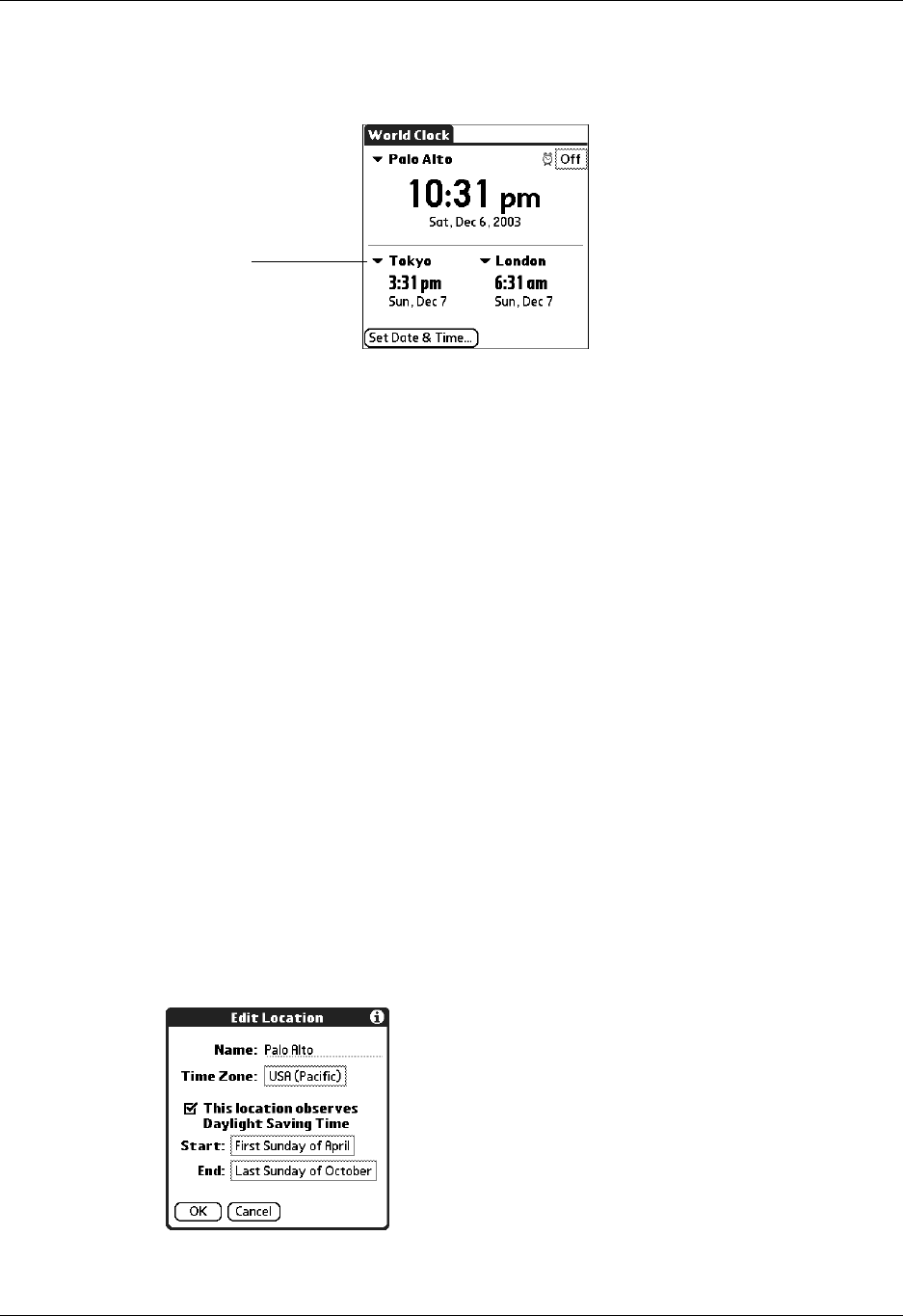
Adding a location
153
To select the secondary locations:
1. Tap the pick list next to the secondary location.
2. Tap the location you want to use as the new secondary location.
If an appropriate location does not appear in the list, see “Adding a location” later
in this chapter to create a new location.
Adding a location
If an appropriate location does not appear in the Location pick list, you can add a
new location to the list. When you add a location, the default Time Zone and
Daylight Saving settings are usually correct. However, you can adjust these
settings if necessary. When the Daylight Saving options are active, the time change
automatically occurs at 1:00 AM on the selected start and end dates.
To add a location:
1. Tap a Location pick list.
2. Select Edit List.
3. Tap Add.
4. Select a location that is in the same time zone as the city you want to add.
5. Tap OK.
6. (Optional) Tap the Name field and modify the location name.
7. (Optional) Tap the Time Zone box and select a time zone.
Secondary
location
pick list
Palm, Inc. Confidential
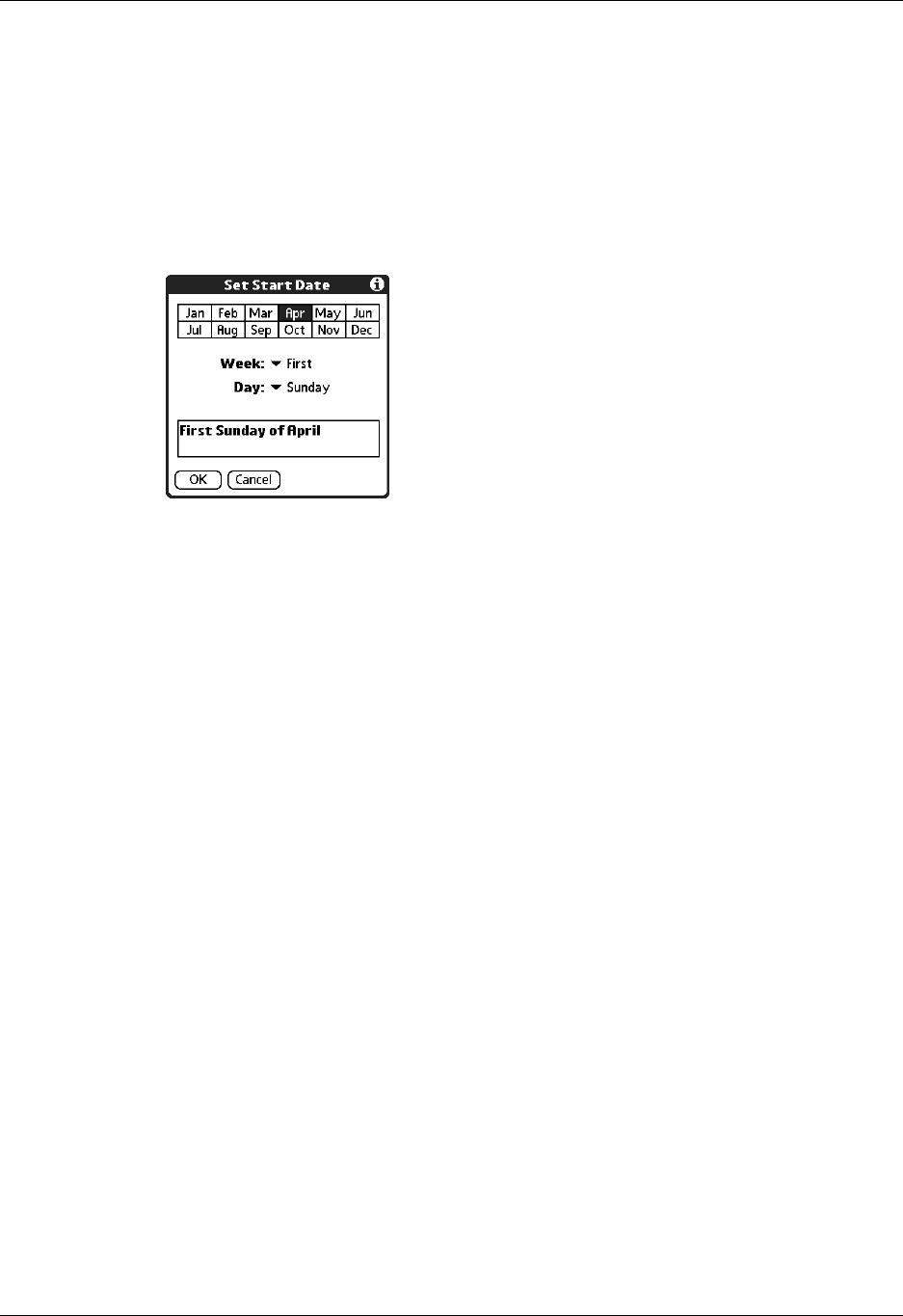
Chapter 15 Using World Clock
154
8. Tap OK.
9. Tap Don e .
To set Daylight Saving options:
1. From the Edit Location dialog box, tap the This location observes Daylight
Saving Time check box to select it.
2. Tap the Start box.
3. Tap the month when daylight saving begins.
4. Tap the Week pick list.
5. Select the week when daylight saving begins within the selected month.
6. Tap the Day pick list.
7. Select the day of the week when daylight saving begins within the selected
week.
8. Tap OK.
9. Tap the End box and repeat steps 3 through 8 to select when daylight saving
ends.
10. Tap O K.
Modifying a location
If you add a location and later realize you did not use the correct settings, you can
modify the location.
To modify a location:
1. Tap a Location pick list.
2. Select Edit List.
3. Select the location you want to modify.
4. Tap Edit.
5. Adjust the settings. See “Adding a location” earlier in this chapter for details.
Palm, Inc. Confidential
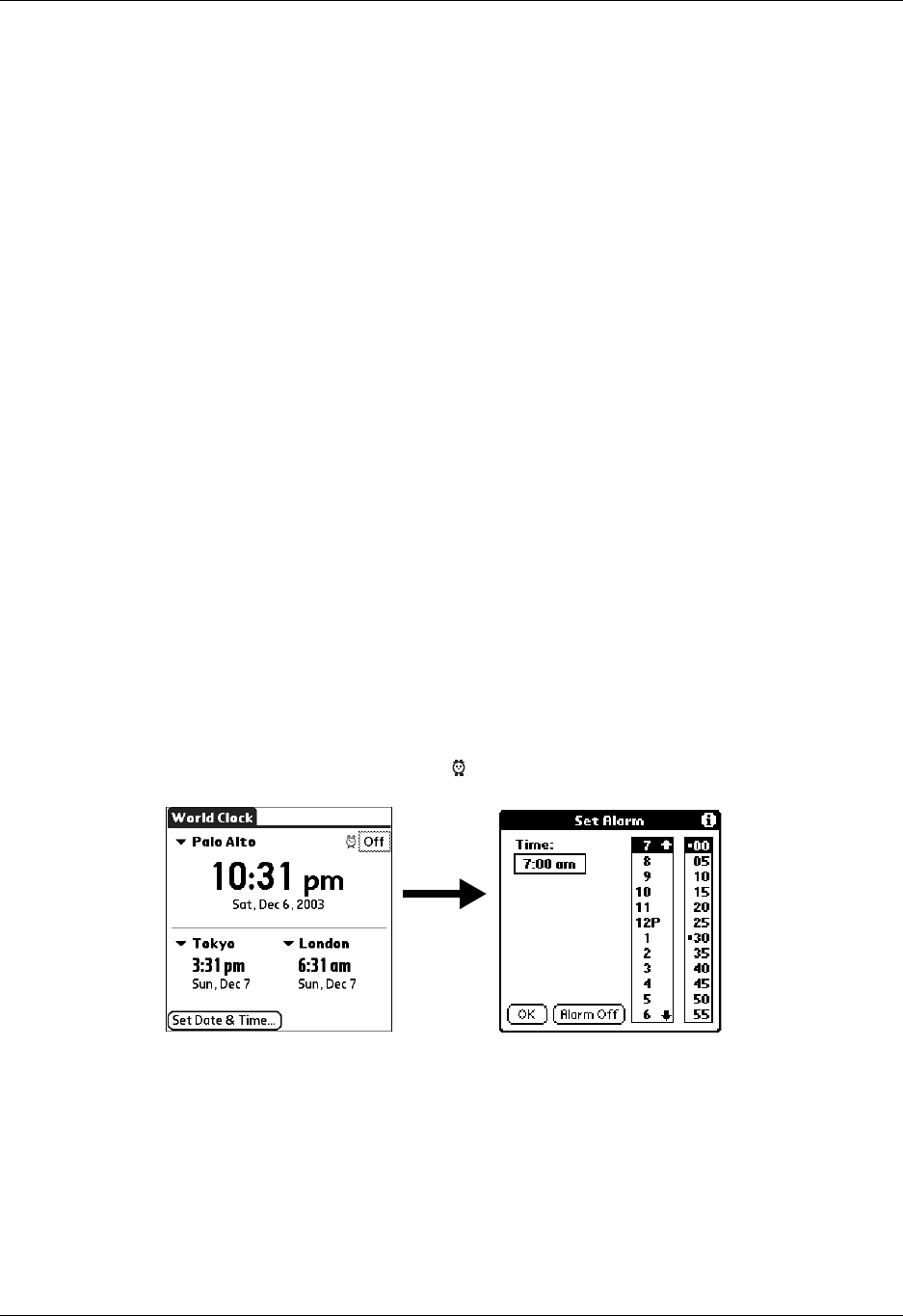
Removing a location
155
6. Tap OK.
7. Tap Don e.
Removing a location
If you no longer need a location that appears on the Location list, you can remove
it. However, you cannot remove a location that is currently assigned to the primary
location.
To remove a location:
1. Tap a Location pick list.
2. Select Edit List.
3. Select the location you want to remove.
4. Tap Remov e .
5. Tap OK to confirm the deletion.
6. Tap Don e.
Setting an alarm
In addition to setting and displaying the date and time, World Clock also provides
a convenient travel alarm feature. You can set an alarm to sound during the next
24-hour period.
To set an alarm:
1. Tap the box next to the Alarm icon to open the Set Alarm dialog box.
2. Tap the time columns to set the hour and minute.
3. Tap OK.
4. When the alarm reminder message appears, do one of the following:
Tap OK to permanently dismiss the reminder and return to the current screen.
Tap Snooze to dismiss the reminder and return to the current screen. An
attention indicator blinks in the upper-left corner of the screen to remind you of
Palm, Inc. Confidential
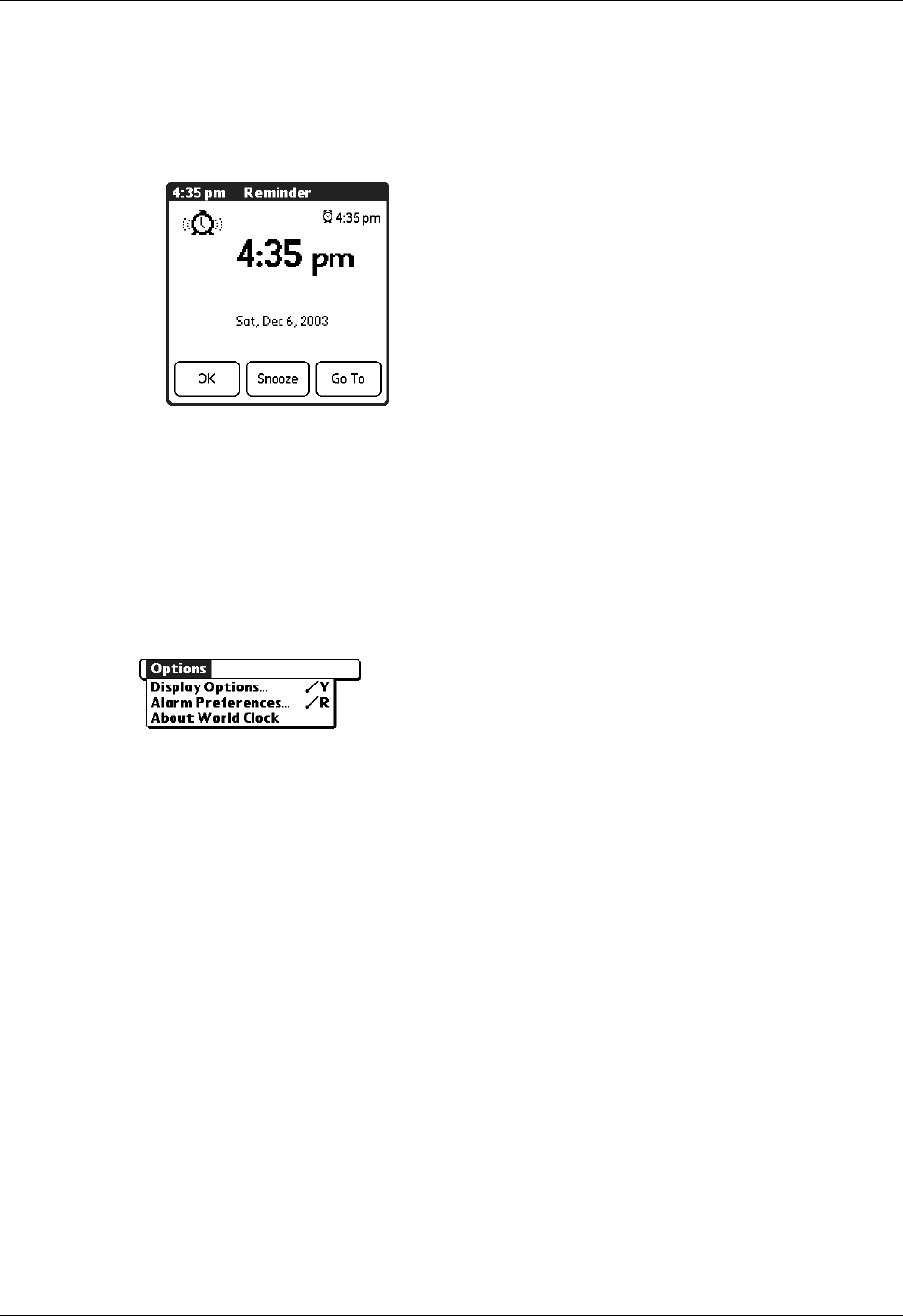
Chapter 15 Using World Clock
156
the pending alarm, and the reminder message appears again in five minutes.
When the reminder message reappears, the current time appears in the
Reminder bar and the alarm time appears on the screen.
5. Tap Go To to open World Clock.
Using World Clock menus
World Clock menus are shown here for your reference, and World Clock features
that are not explained elsewhere in this book are described here.
See “Using menus” in Chapter 4 for information about choosing menu commands.
Options menu
Display Options Opens a dialog box where you can choose which information
appears on the World Clock screen.
Show Multiple Locations: Activates the secondary location
displays. When it is selected, the secondary locations appear
below the primary location.
Date: Activates the date display. When it is selected, the date
appears below the time for each location.
Alarm
Preferences Sound: Sets the sound of the alarm. The choices are Alarm,
Bumble Bee, Reveille, Sonata, Wake Up, and Warbler.
Volume: Defines how loud the alarm sounds. The choices are
Low, Medium, and High.
About World
Clock Shows version information for World Clock.
Palm, Inc. Confidential
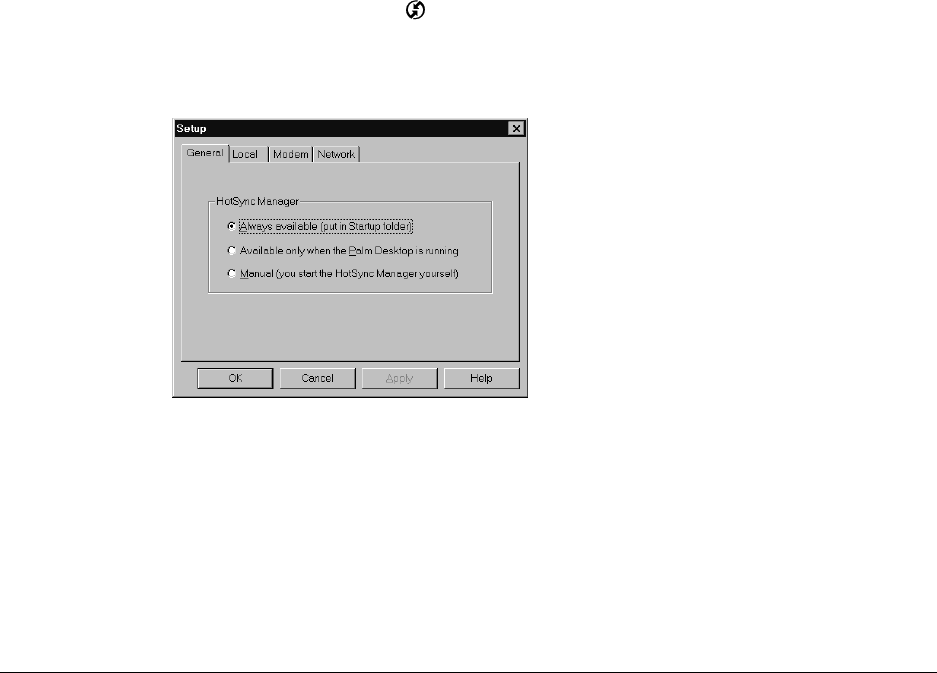
157
CHAPTER 16
Performing HotSync® Operations
HotSync® technology enables you to synchronize data between one or more
Palm OS® handhelds and Palm™ Desktop software or another personal
information manager (PIM) such as Microsoft Outlook. To synchronize data, you
must connect your handheld and your computer either directly or indirectly.
Direct methods include placing your handheld in the cradle/cable attached to
your computer, using infrared communications, or using a Bluetooth connection.
Indirect methods include using a modem or network HotSync technology.
Selecting HotSync setup options
You can choose when HotSync Manager will run. If necessary, you can adjust the
local and modem HotSync settings as well.
To set the HotSync options on a Windows computer:
1. Click the HotSync icon ™ in the Windows system tray (bottom-right corner
of the taskbar).
2. Select Setup.
3. Click the General tab, and select one of the following options:
Always available Adds HotSync Manager to the Startup folder and
constantly monitors the communication port for
synchronization requests from your handheld. With this
option the HotSync Manager synchronizes data even
when Palm Desktop software is not running.
Palm, Inc. Confidential
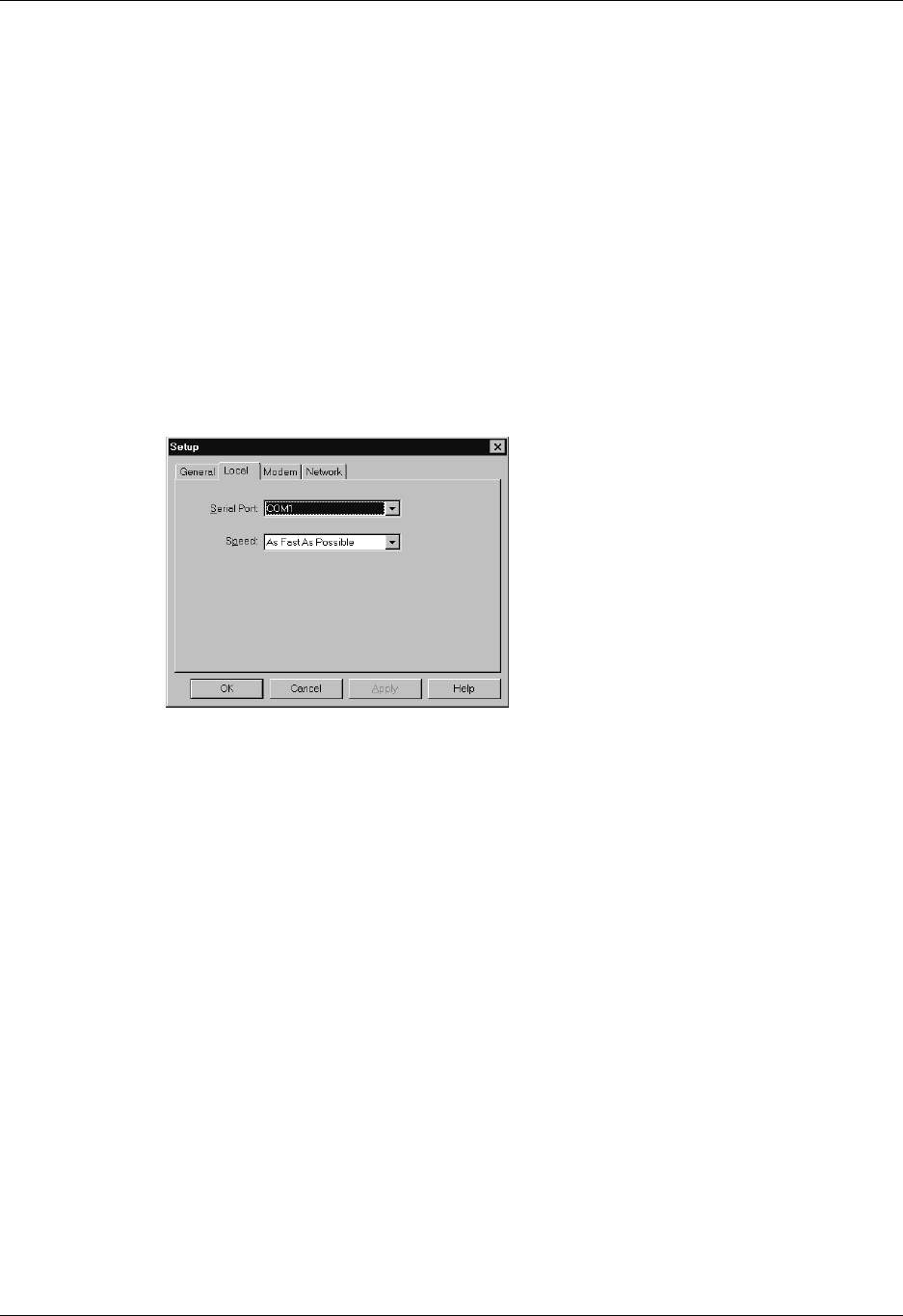
Chapter 16 Performing HotSync® Operations
158
If you’re not sure which option to use, keep the default setting: Always
available.
4. If you are using a serial cradle/cable, click the Local tab to display the settings
for the connection between your computer and the handheld cradle/cable, and
adjust the following options as needed.
If you are using the USB cradle/cable, you do not need to use the settings on the
Local tab for a direct HotSync operation.
5. Click the Modem tab to display the modem settings and adjust the options as
needed. For more information, see “Conducting modem HotSync operations”
later in this chapter.
6. If you are attached to a network, click the Network tab to display the network
settings and adjust the options as needed. For more information, see
“Conducting network HotSync operations” later in this chapter.
7. Click OK.
Available only when
the Palm Desktop
software is running
Starts HotSync Manager and monitors requests
automatically when you open Palm Desktop software.
Manual Monitors requests only when you select HotSync Manager
from the Start menu.
Serial Port Identifies the port that HotSync Manager uses to
communicate with the cradle/cable. If necessary, you can
change the port selection.
Your handheld cannot share this port with an internal
modem or other device.
Speed Determines the speed at which data is transferred between
your handheld and Palm Desktop software. Try the As Fast
As Possible rate first, and adjust downward if you experience
problems. This setting allows your handheld to synchronize
with computer at the fastest speed possible.
Palm, Inc. Confidential

Selecting HotSync setup options
159
To set the HotSync options on a Mac computer:
1. Double-click the HotSync Manager icon in the Palm folder.
2. Click the HotSync Controls tab, and select any of the following options.
3. If you are using the USB cradle/cable, you do not need to adjust the settings on
the Connection Settings tab for a direct HotSync operation; they are set
automatically when you perform the first HotSync operation.
HotSync Enabled/
Disabled Activates the transport monitor and prepares your Mac
computer to synchronize with your handheld. By default,
the transport monitor is enabled listen on USB and
PalmConnect whenever you start your computer.
If you use an optional serial HotSync cradle/cable and you
use the same serial port for other devices besides the
HotSync cradle/cable, disable the transport monitor and
then enable it manually only when you connect the cradle/
cable to perform a HotSync operation.
Enable HotSync
software at system
startup
Activates the transport monitor automatically each time
you start your computer. If this option is not selected, you
must open HotSync Manager and select the Enabled option
before you can perform a HotSync operation.
Show more detail
in HotSync Log Includes more troubleshooting information in the log that is
generated when you perform a HotSync operation.
Palm, Inc. Confidential

Chapter 16 Performing HotSync® Operations
160
If you are using the optional serial cradle/cable, click the Connection Settings
tab and select the port where you attached the cradle/cable.
.
You can set both Modem and Printer port settings and prepare your computer
to synchronize with your handheld using the HotSync cradle/cable or a
modem. However, choosing both setups prevents you from using either port for
other operations such as printing, faxing, or AppleTalk networking.
4. Close the HotSync Software Setup window.
Customizing HotSync application settings
For each application, you can define a set of options that determines how records
are handled during synchronization. These options are called a conduit. By default,
a HotSync operation synchronizes all files between the handheld and Palm
Desktop software.
In general, you should leave the settings to synchronize all files. The only reason
you might want to change these settings is to overwrite data on either your
handheld or Palm Desktop software, or to avoid synchronizing a particular type of
file because you don’t use it.
In addition to the conduits for Date Book, Address Book, To Do List, Memo Pad,
Note Pad, and Voice Memo, Palm Desktop software includes System and Install
conduits. The System conduit backs up the system information stored on your
handheld, including Graffiti® ShortCuts. The Install conduit installs add-on
applications on your handheld.
To customize HotSync application settings on a Windows computer:
1. Click the HotSync icon in the Windows system tray (bottom-right corner of
the taskbar).
You can also click the HotSync command on the Palm Desktop software
menu bar.
2. From the HotSync Manager menu, select Custom.
3. Select the appropriate user name from the list.
4. Select an application in the Conduit list.
Palm, Inc. Confidential
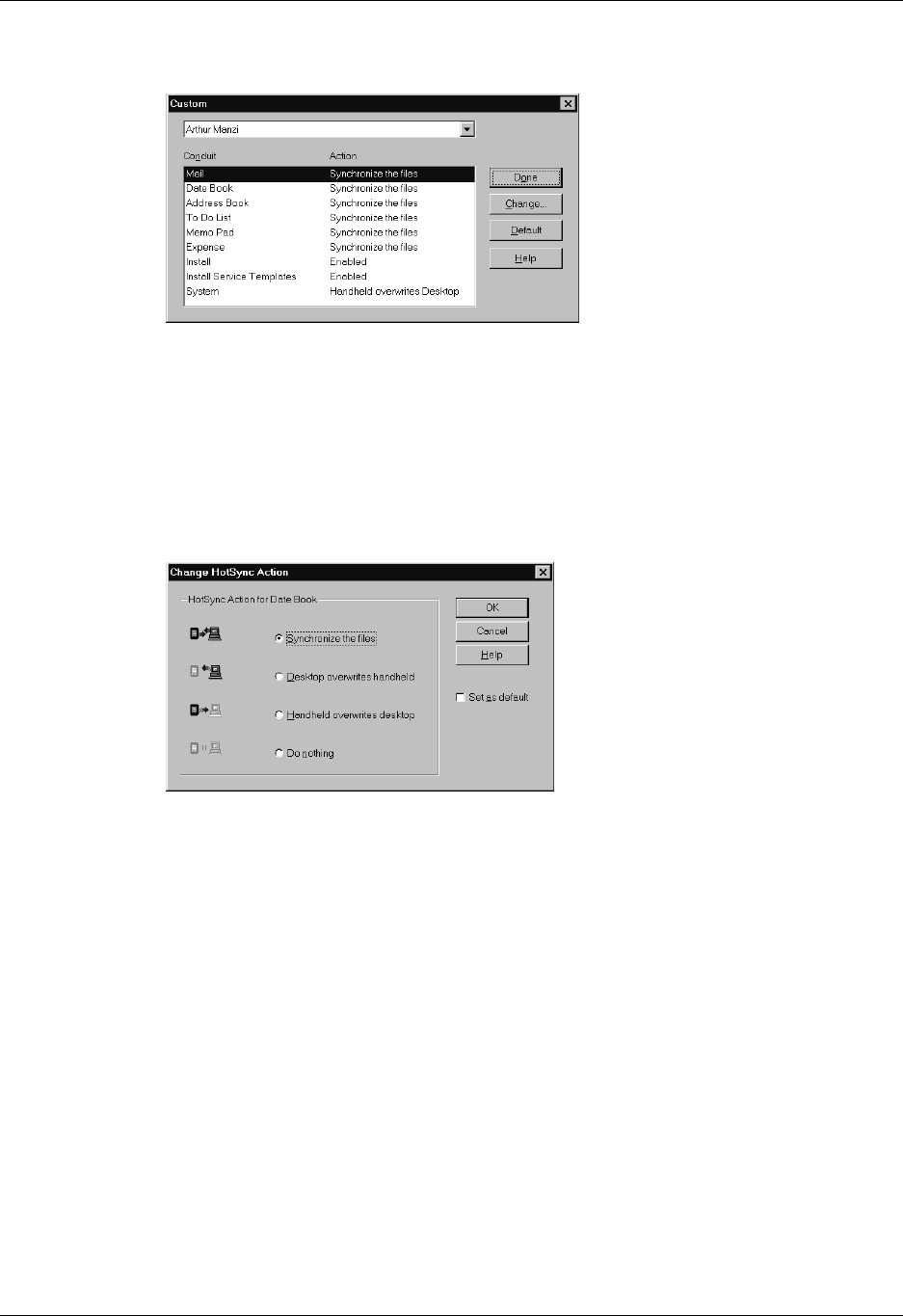
Customizing HotSync application settings
161
5. Click Change.
6. For each application, click the direction in which you want to write data, or click
Do Nothing to skip data transfer for an application.
Changing the HotSync setting from the default affects only the next HotSync
operation. Thereafter, the HotSync Actions revert to their default settings. To
use a new setting on an ongoing basis, select the Set As Default box. Thereafter,
whatever you selected as the default setting is used when you click the Default
button in the Custom dialog box.
7. Click OK.
8. Click Done to activate your settings.
To customize HotSync application settings on a Mac computer:
1. Double-click the Palm Desktop icon in the Palm folder.
2. From the HotSync menu, select Conduit Settings.
3. From the User pop-up menu, select the appropriate user name.
4. Select an application in the Conduit list.
Palm, Inc. Confidential
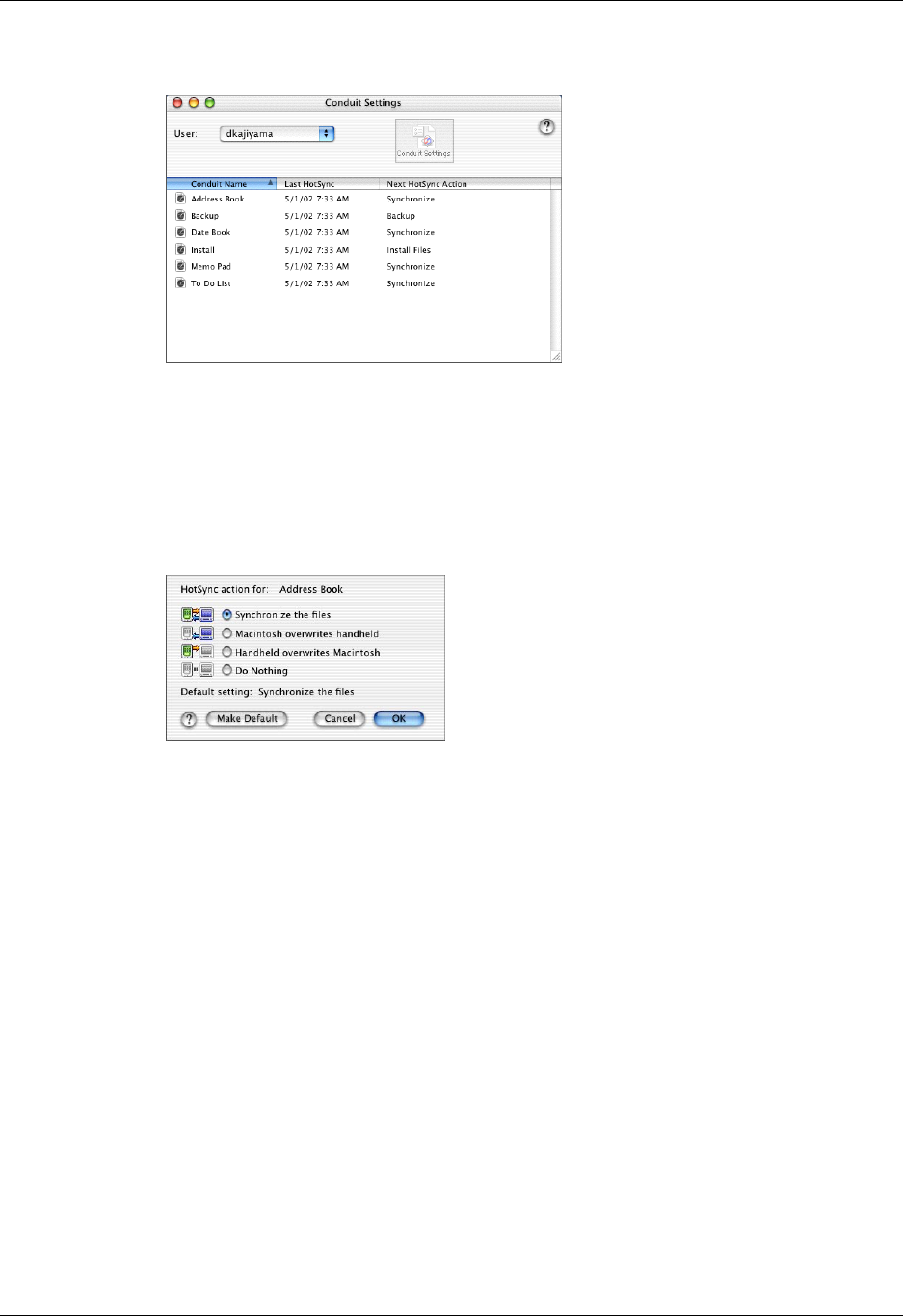
Chapter 16 Performing HotSync® Operations
162
5. Click Conduit Settings.
6. For each application, click the direction in which you want to write data, or click
Do Nothing to skip data transfer for an application.
Changing the HotSync setting from the default affects only the next HotSync
operation. Thereafter, the HotSync Actions revert to their default settings. To
use a new setting on an ongoing basis, click Make Default. Thereafter, whatever
you selected as the default setting is used for HotSync operations.
7. Click OK.
8. Close the Conduit Settings window.
Conducting cradle/cable HotSync operations
The simplest way to synchronize data is to perform a direct HotSync operation by
seating your handheld in the cradle/cable and pressing the HotSync button.
Performing a cradle/cable HotSync operation: Windows computers
The first time you synchronize your data, you need to enter user information on
Palm Desktop software. After you enter this information and synchronize with
your handheld, the HotSync Manager recognizes your handheld and doesn’t ask
for this information again.
Palm, Inc. Confidential
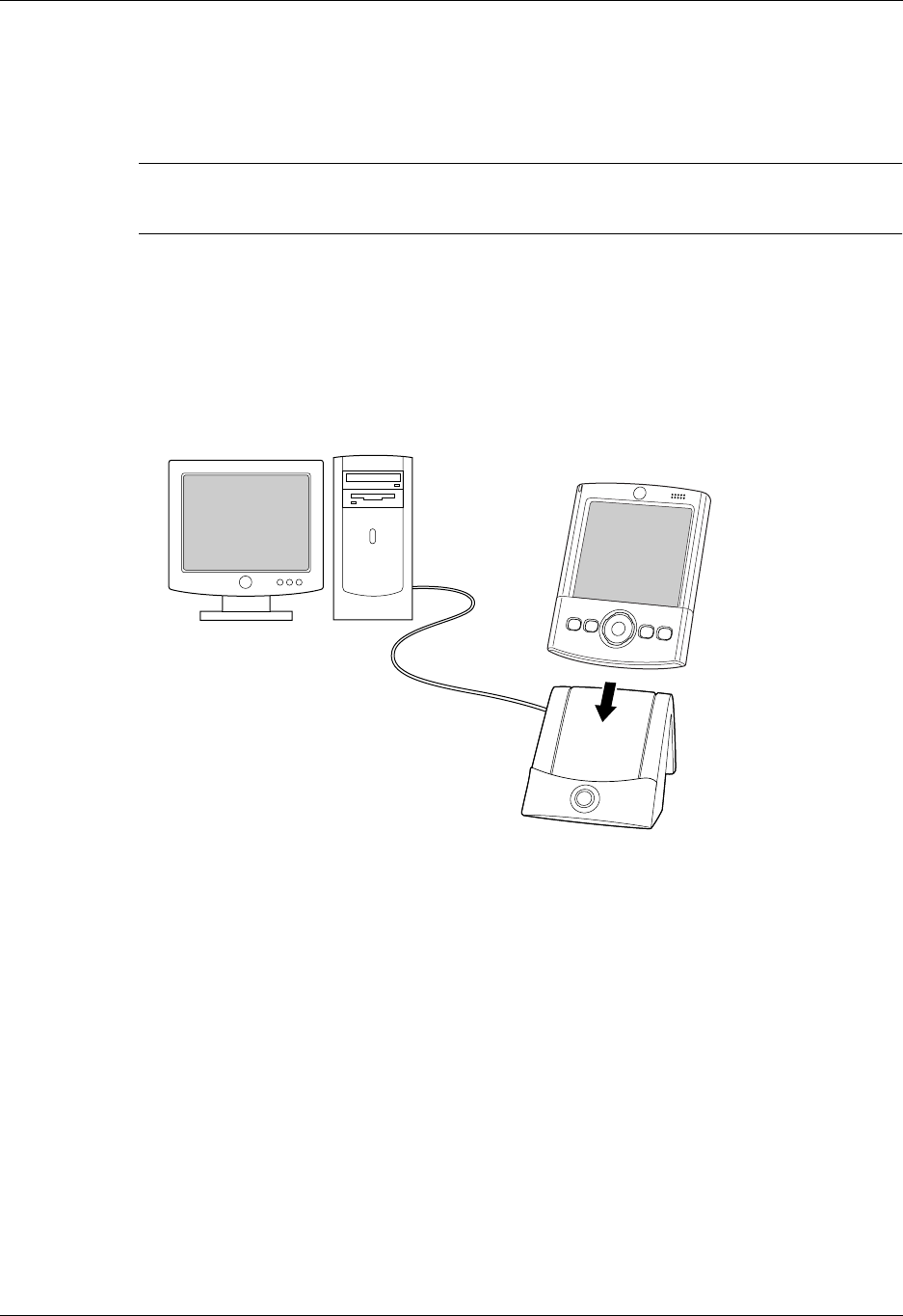
Conducting cradle/cable HotSync operations
163
If you are a system administrator preparing several handhelds for a group of users,
you may want to create a user profile. See “Creating a user profile” later in this
chapter before performing the following steps.
IMPORTANT You must perform your first HotSync operation with a local, direct
connection or with infrared communication, rather than with a modem or network.
The following steps assume that you have already installed Palm Desktop
software. If you have not installed this software, see “Step 4: Install software” in
Chapter 1 for instructions.
To perform a local HotSync operation on a Windows computer:
1. Place your handheld in the cradle/cable.
2. If the HotSync Manager is not running, start it: On the Windows desktop, click
Start, and then select Programs. Navigate to the Palm Desktop software
program group, and select HotSync Manager. Alternatively, you can start the
Palm Desktop software, which automatically opens the HotSync Manager.
Palm, Inc. Confidential
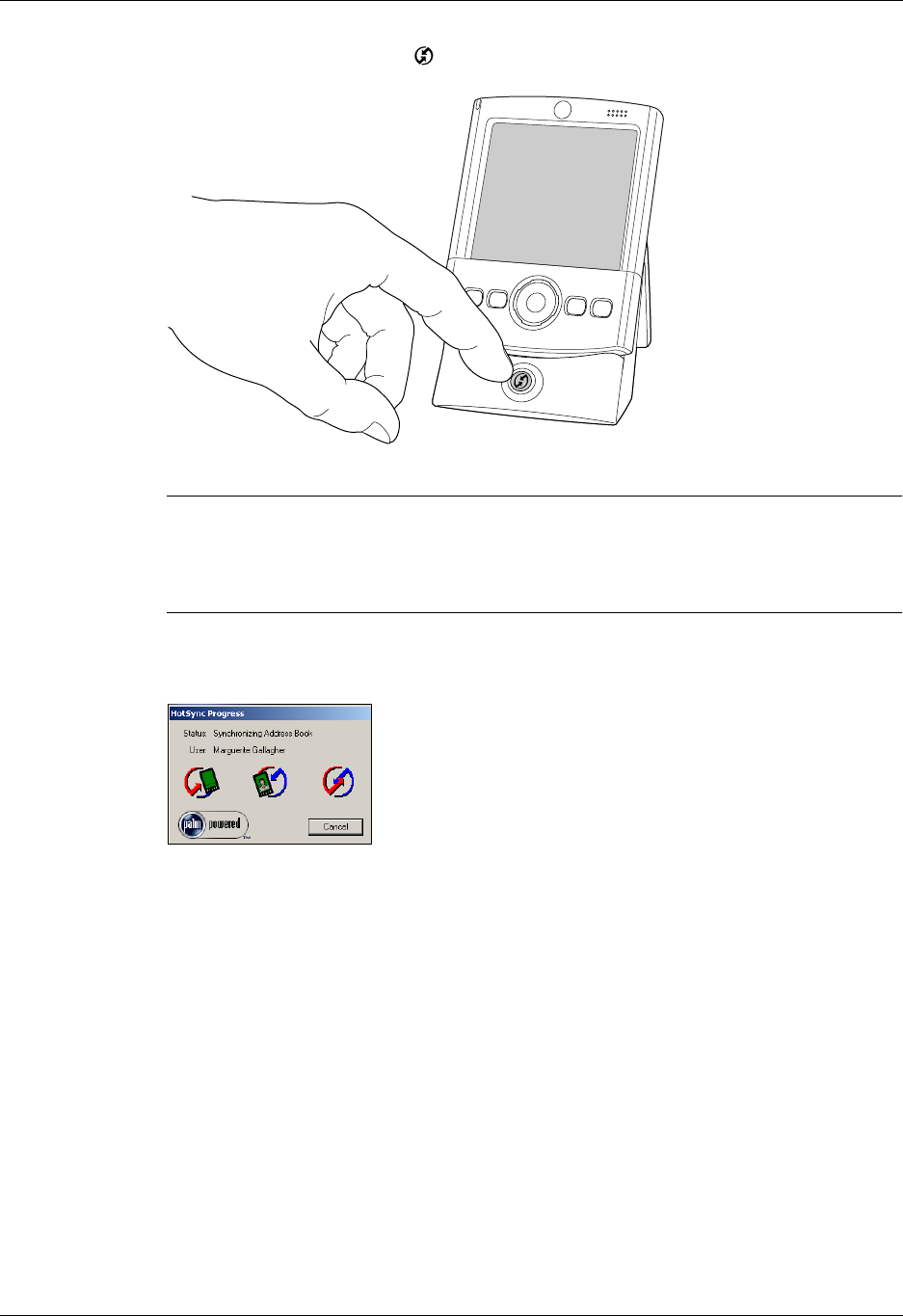
Chapter 16 Performing HotSync® Operations
164
3. Press the HotSync button on the cradle/cable.
IMPORTANT The first time you perform a HotSync operation, you must enter a
user name in the New User dialog box and click OK. Every handheld should have
a unique name. To prevent loss of a user’s records, never try to synchronize more
than one handheld to the same user name.
The HotSync Progress dialog box appears, and synchronization begins.
4. Wait for a message on your handheld indicating that the process is complete.
After the HotSync process is complete, you can remove your handheld from the
cradle/cable. Gently tilt your handheld forward in the cradle/cable, and then
lift it up to remove it.
Palm, Inc. Confidential
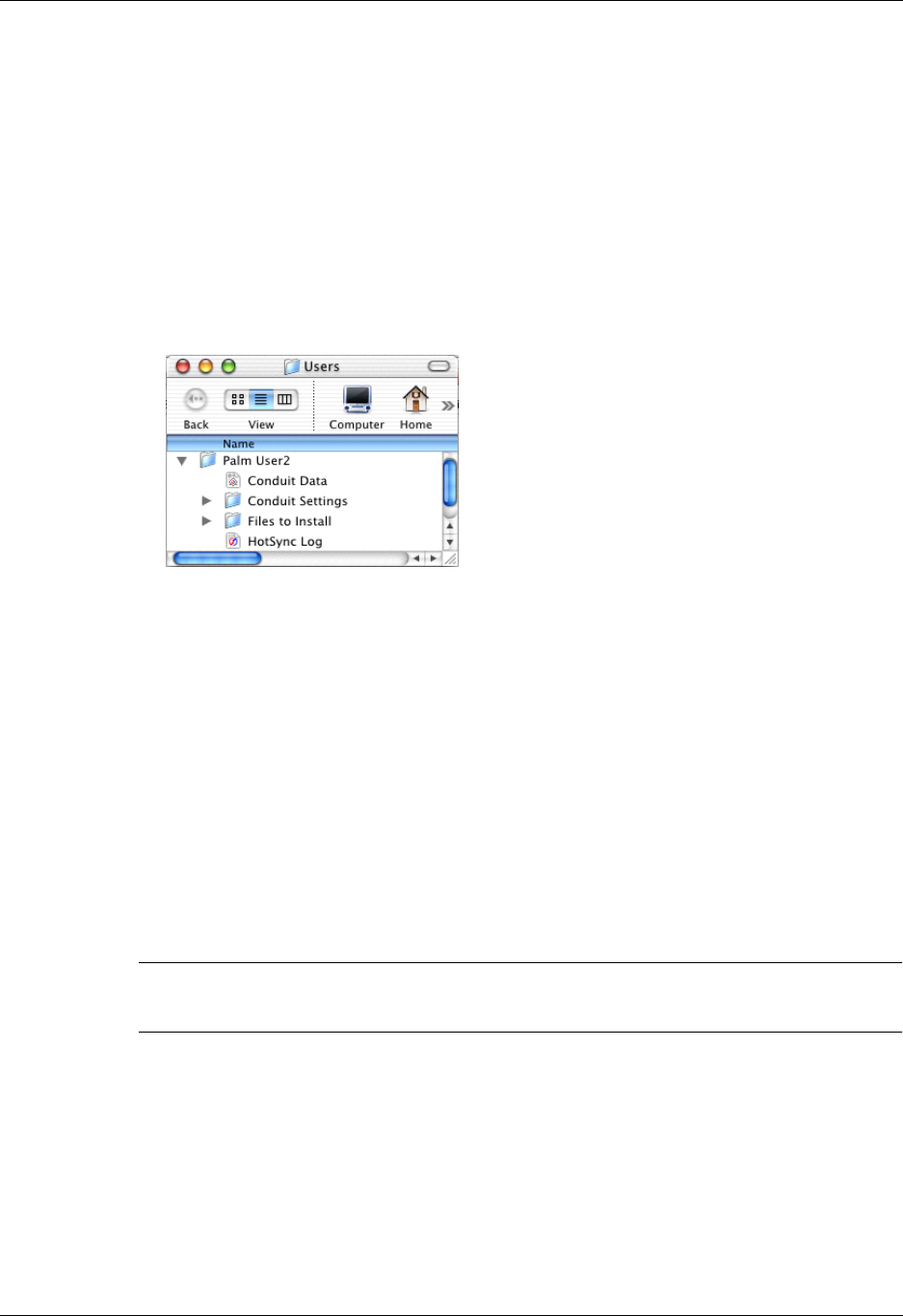
Conducting cradle/cable HotSync operations
165
Performing a direct HotSync operation: Mac computers
When you installed Palm Desktop software, you entered a user name. This user
name is the connection between your handheld and your computer.
The first time you perform a HotSync operation the Palm Desktop software does
the following:
■Adds a user name to your handheld.
■Creates a folder for the user name in the Users folder inside the Palm folder. For
example, if you entered Jane Garcia as your user name, a folder named Jane
Garcia is created in the Users folder.
■Creates a file named User Data in your user name folder.
User names appear in the User pop-up menu on the right side of the toolbar. You
can change users by selecting a new name in the pop-up menu.
Each subsequent time you perform a HotSync operation, HotSync Manager reads
the user name from your handheld and synchronizes the data in the folder of the
same name.
Be sure you select the correct user name from the User pop-up menu before
entering data on Palm Desktop or performing a HotSync operation.
If you are a system administrator preparing several handhelds for a group of users,
you may want to create a user profile. See “Creating a user profile” later in this
chapter before performing the following steps.
IMPORTANT You must perform your first HotSync operation with a local, direct
connection or with infrared communication, rather than with a modem.
The following steps assume that you have already installed Palm Desktop
software. See “Step 4: Install software” in Chapter 1 if you have not installed this
software.
Palm, Inc. Confidential
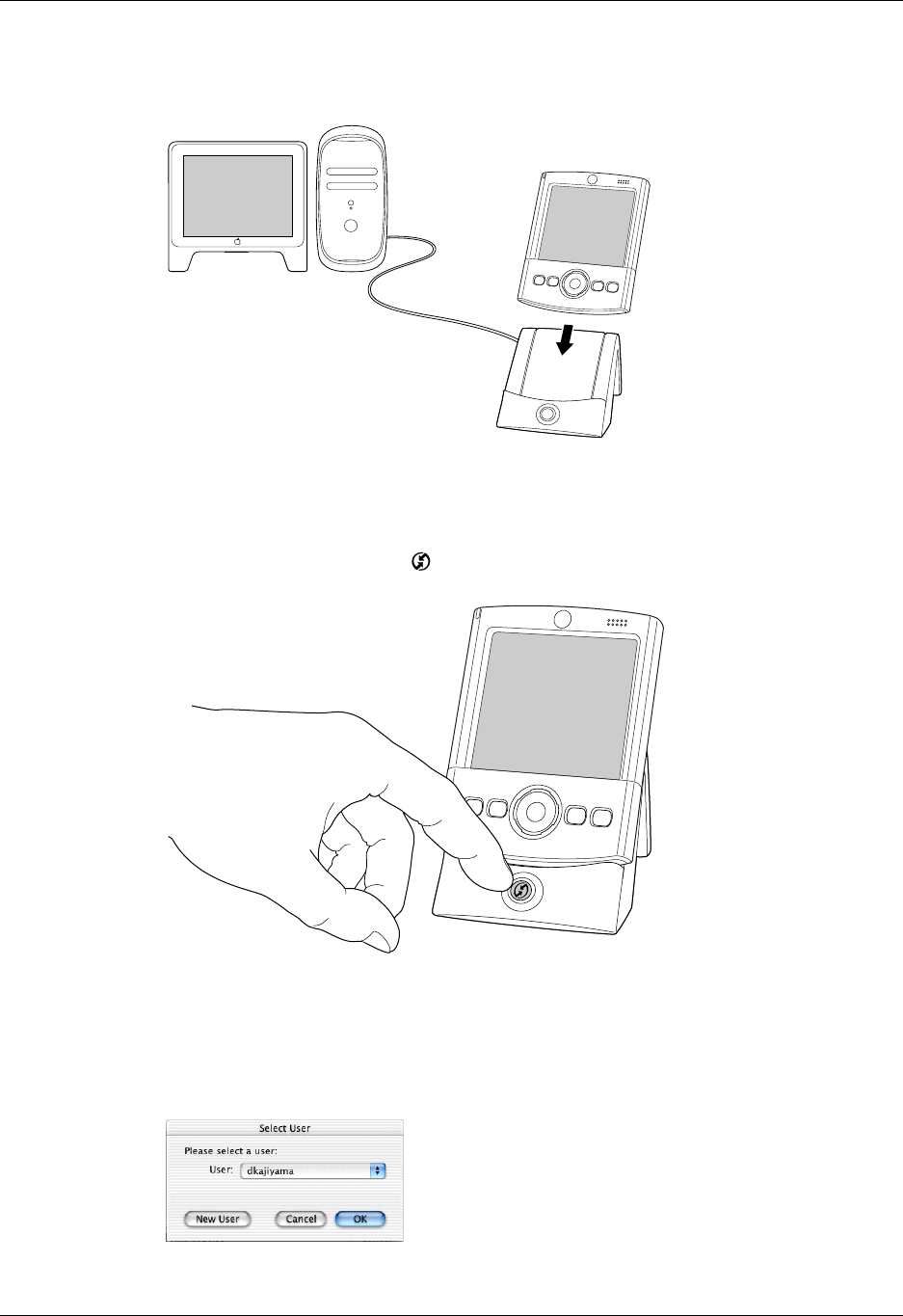
Chapter 16 Performing HotSync® Operations
166
To perform a local HotSync operation on a Mac computer:
1. Place your handheld in the HotSync cradle/cable.
2. Make sure that HotSync Manager is enabled: Double-click the HotSync
Manager icon in the Palm folder. Click the HotSync Controls tab, and make sure
the Enabled option is selected.
3. Press the HotSync button on the cradle/cable.
The HotSync Progress dialog box appears, followed by the Select User
dialog box.
4. In the Select User dialog box, select the user name you entered when you
installed the Palm Desktop software, and click OK.
Palm, Inc. Confidential

Conducting IR HotSync operations
167
The HotSync Progress dialog box reappears, and synchronization begins.
5. Wait for a message on your handheld indicating that the process is complete.
After the HotSync process is complete, you can remove your handheld from the
cradle/cable. Gently tilt your handheld forward in the cradle/cable, and then
lift it up to remove it.
Conducting IR HotSync operations
You can use the infrared (IR) port on your handheld to perform HotSync
operations. When you perform an IR HotSync operation, you don’t need your
cradle/cable. However, you must have a computer that’s equipped with an IR port
and that supports the IrCOMM implementation of the Infrared Data Association
(IrDA) standards. This is especially useful if you travel with an infrared-enabled
laptop. You simply enable infrared communication on your laptop and handheld
and follow the steps in “Performing an IR HotSync operation” later in this section.
Preparing your computer for infrared communication
Before you can perform a HotSync operation using the IR port, the computer with
which you want to synchronize must fulfill these requirements:
■Your computer must support the IrCOMM implementation of the IrDA
standards.
■Your computer must have an enabled infrared port that’s built into the
computer, or an enabled infrared device attached to the computer.
■Some desktop computers may require an infrared device attached to a physical
COM port. Laptops are likely to have a built-in IR port, so no external device is
necessary.
■Your computer must have an installed infrared driver.
■If you have an external infrared device attached to your computer, a driver is
probably included with the device. Consult the documentation included with
the device for information on installing the required driver.
Check your computer’s documentation to learn if the computer supports infrared
communication.
Palm, Inc. Confidential
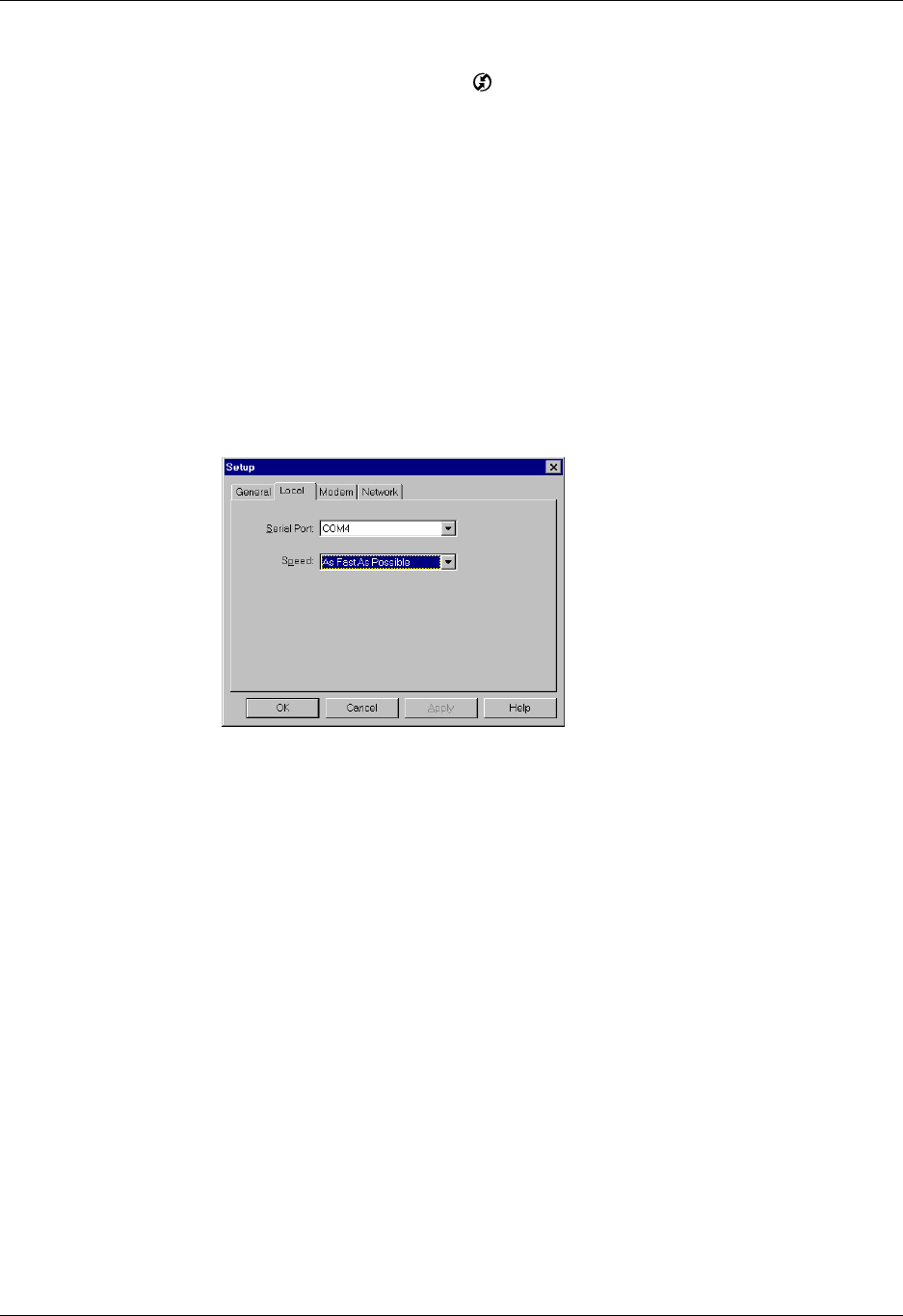
Chapter 16 Performing HotSync® Operations
168
To configure HotSync Manager for infrared communication on a Windows computer:
■Click the HotSync Manager icon in the Windows system tray, and make sure
that Infrared is selected.
– If you have an Infrared option on the HotSync Manager menu, and that
option is selected, skip to “Performing an IR HotSync operation.”
– If you do not have an Infrared option on the HotSync Manager menu,
complete the following steps:
a. Make sure that Local Serial is selected on the menu.
b. From the HotSync Manager menu, select Setup.
c. Click the Local tab.
d. In the Serial Port drop-down box, select the simulated port that your
computer uses for infrared communication.
See the documentation for your operating system for instructions on
finding the simulated port. This information is usually located in the
Control Panel.
e. Click OK.
NOTE If your cradle/cable is connected to a USB port, you can continue using the
cradle/cable while HotSync Manager is configured for infrared communication. If
your cradle/cable is connected to a serial port, you cannot use your HotSync cradle/
cable again until you reconfigure the HotSync Manager to communicate with the port
defined for cradle/cable synchronization.
To configure HotSync Manager for infrared communication on a Mac computer:
1. Double-click the HotSync Manager icon in the Palm folder.
2. In the HotSync Controls tab, select Enabled.
3. Click the Connection Settings tab.
Palm, Inc. Confidential
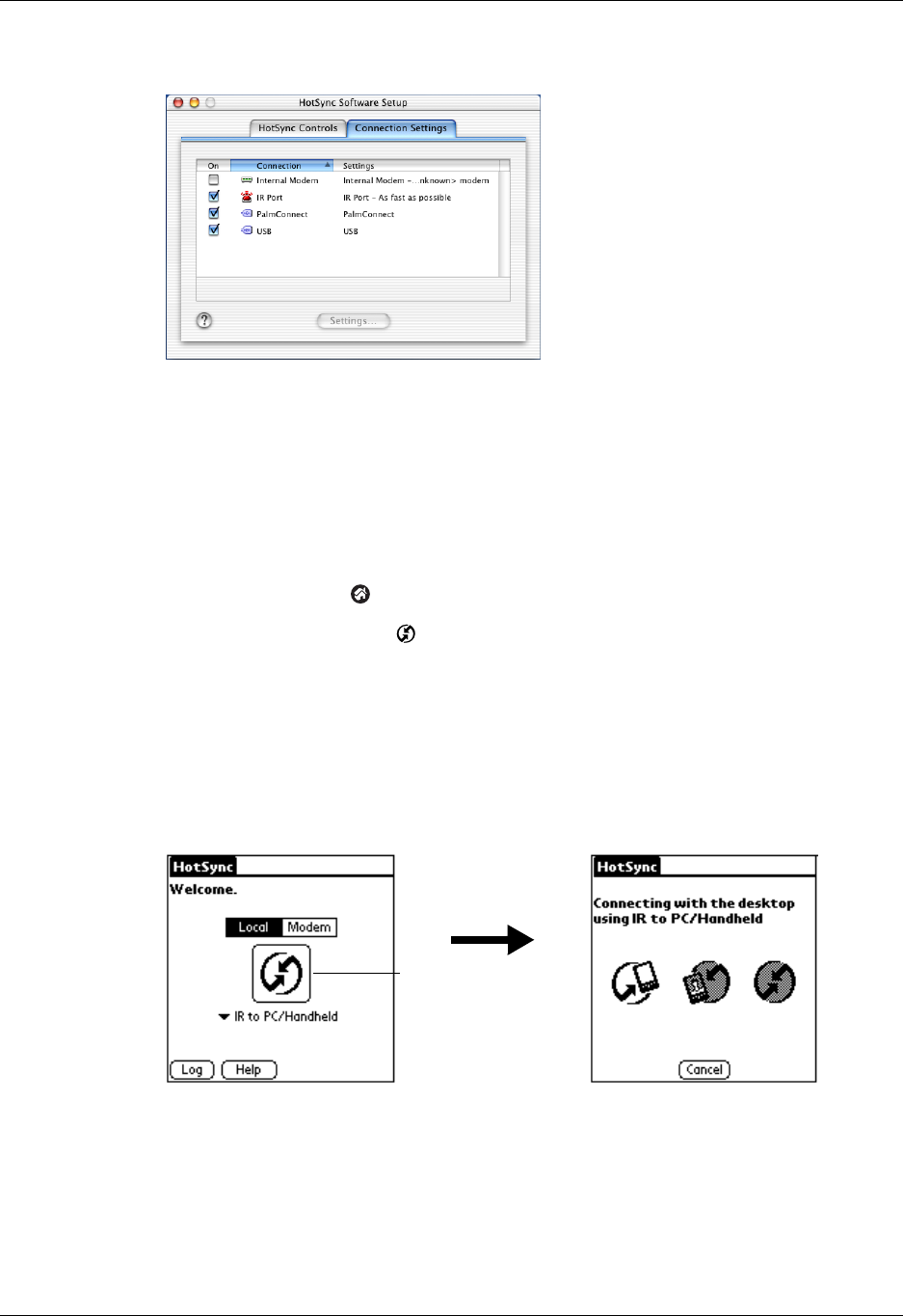
Conducting IR HotSync operations
169
4. Select the On check box next to IR port.
5. Close the HotSync Software Setup window.
Performing an IR HotSync operation
After you complete the steps to prepare for performing an IR HotSync operation,
it’s easy to perform the actual operation.
To perform an IR HotSync operation:
1. Tap the Home icon .
2. Select the HotSync icon .
3. Tap Local.
4. Tap the pick list below the HotSync icon and select IR to a PC/Handheld.
5. Position the IR port of your handheld within a couple of inches of the infrared
port of your computer.
6. Tap the HotSync icon to start the IR HotSync operation.
Tap here to start
IR HotSync
operation
Palm, Inc. Confidential

Chapter 16 Performing HotSync® Operations
170
Returning to cradle/cable HotSync operations
It’s easy to return to using the cradle/cable for HotSync operations.
If your cradle/cable is connected to a USB port, you can continue using it while
HotSync Manager is configured for infrared communication. Use the following
instructions to return to Local USB cradle/cable HotSync operations only when
necessary, such as when you have disconnected the cradle/cable from the
USB port.
To return to local USB cradle/cable HotSync operations on a Windows computer:
1. If necessary, connect the cradle/cable to the USB port of the computer you use
for HotSync operations.
2. Click the HotSync Manager icon in the Windows system tray, and select
Local USB if it is not already selected.
To return to local Serial cradle/cable HotSync operations on a Windows computer:
1. If necessary, connect the cradle/cable to the port of the computer you use for
HotSync operations.
2. Click the HotSync Manager icon in the Windows system tray.
3. Select Setup, and then click Local.
4. Select the COM port where your cradle/cable is connected.
5. Click OK.
On a Mac computer, the HotSync Manager software monitors all ports at the same
time. However, you may want to turn off the IR port when you’re not using it to
improve performance of HotSync operations.
To return to local serial cradle/cable HotSync operations on a Mac computer:
1. If necessary, connect the cradle/cable to a serial port on your computer.
2. Double-click the HotSync Manager icon in the Palm folder.
3. In the HotSync Controls tab, select Enabled.
4. Click the Connection Settings tab, and select the correct connection.
5. Close the HotSync Software Setup window.
The next time you want to perform a HotSync operation, just press the HotSync
button on the cradle/cable, as you always did before.
Palm, Inc. Confidential

Conducting modem HotSync operations
171
Conducting modem HotSync operations
You can use a modem to synchronize your handheld when you are away from
your computer.
IMPORTANT You must perform the first HotSync operation by using a local, direct
connection or infrared communication. After that, you can perform a modem
HotSync operation.
To perform a modem HotSync operation you need the following:
■A modem connected to your computer.
■Palm Desktop software configured for use with the modem.
■A modem connected to your handheld.
■A configuration for the kind of modem connection you want to make.
See “Connection Preferences” in Chapter 17 for more information.
Preparing your computer for a modem HotSync operation
There are a few steps you must perform to prepare your computer for a modem
HotSync operation. Be sure to perform these steps before you leave your office so
that your computer is ready to receive a call from your handheld.
To prepare a Windows computer for a modem HotSync operation:
1. Confirm that the computer modem is connected and turned on and that no
communications applications, such as fax or telephony software, are running
on a COM port.
Make sure the computer is disconnected from all online services, such as
America Online (AOL). This helps to avoid conflicts with the COM port.
2. Start HotSync Manager if it is not already running, and from the HotSync
Manager menu, select Modem.
Palm, Inc. Confidential

Chapter 16 Performing HotSync® Operations
172
3. Adjust the following options as needed.
4. Click OK.
To prepare a Mac computer for a modem HotSync operation:
1. Confirm that the computer modem is connected and turned on, and that no
communications applications, such as fax or telephony software, or AppleTalk
networking are running on that serial port.
Make sure your computer is disconnected from all online services, such as
CompuServe and America Online (AOL). This helps to avoid conflicts with the
serial port. In addition, your computer must be on, and it should not be in sleep
mode when receiving a call from a remote handheld.
2. Double-click the HotSync Manager icon in the Palm folder.
3. Click the HotSync Controls tab and enable the Transport Monitor, if it is not
already enabled.
4. Click the Connection Settings tab.
Serial Port Identifies the port for the modem. If you are unsure of the port
assignment, look at the Modem Properties in the Windows
Control Panel.
Speed Determines the speed at which data is transferred. Try the As
Fast As Possible rate first, and adjust downward if you
experience problems. This setting allows your handheld to
synchronize with your computer at the fastest speed possible.
Modem Identifies the modem type or manufacturer. Refer to your
modem manual or faceplate for its type or settings. If you’re not
sure of your modem type or if your modem doesn’t match any
that appear in the list, select Hayes Basic.
Setup String Identifies the setup string for your particular modem. Not all
modems require a setup string. Refer to your modem manual,
and enter the setup string if it is recommended by the
manufacturer.
Palm, Inc. Confidential
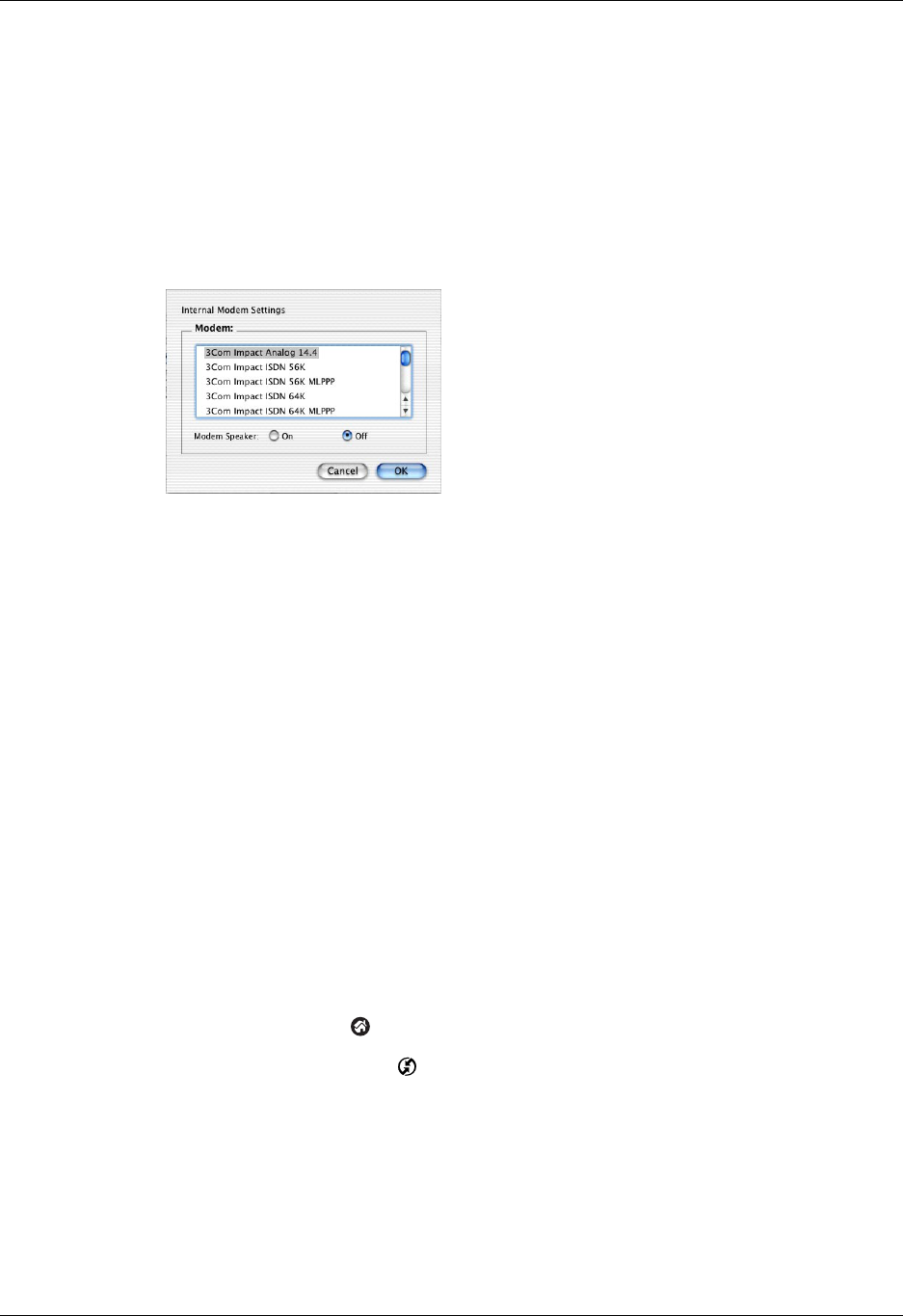
Conducting modem HotSync operations
173
5. Select the On check box for the modem connection you’re using, and then click
Settings.
6. In the Settings dialog box, select Modem as the connection type, if it is not
already selected.
NOTE This step is not necessary for internal modems.
7. Adjust the following options as needed.
8. Click OK.
9. Close the HotSync Software Setup window.
Preparing your handheld for a modem HotSync operation
There are a few steps you must perform to prepare your handheld for a modem
HotSync operation.
To prepare your handheld for a modem HotSync operation:
1. Tap the Home icon .
2. Select the HotSync icon .
3. Tap Mode m .
Modem Identifies the type of modem connected to your computer. If
your modem does not appear on the list, use the Hayes Basic
setting, or select Custom to enter a command string. Refer to
the manual that came with your modem to find the
appropriate command string.
Modem Speaker Activates the modem’s speaker. If you are having trouble
connecting, turn on this option to make sure that the modem
connected to your computer is responding to incoming calls.
Palm, Inc. Confidential
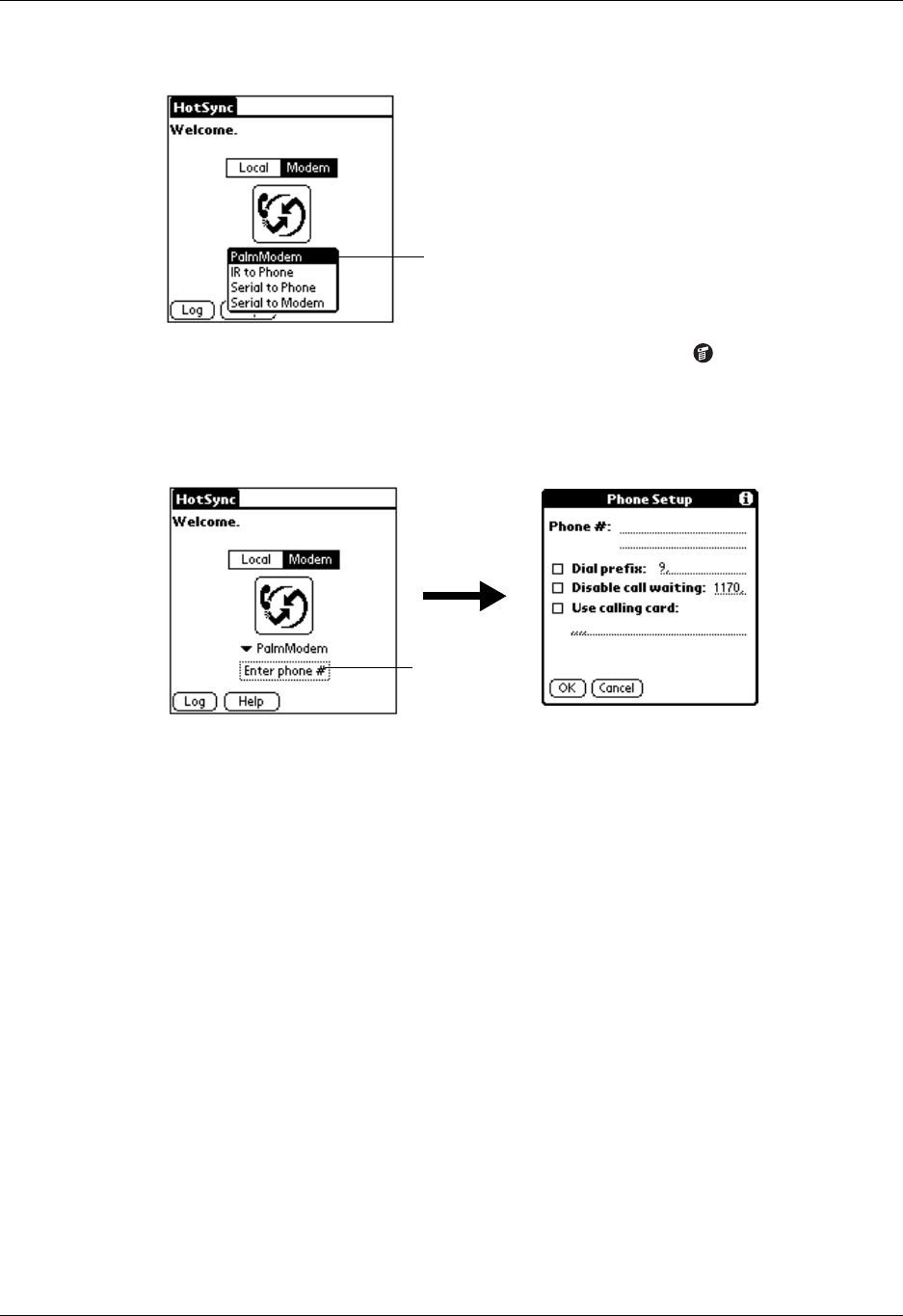
Chapter 16 Performing HotSync® Operations
174
4. Tap the pick list below the icon and select a modem configuration.
If you need to create a configuration, tap the Menu icon and then select
Connection Setup on the Options menu. See “Connection Preferences” in
Chapter 17 for more information.
5. Tap the Enter phone # field.
If you plan to connect to your company’s dial-in server (network modem)
instead of connecting to a computer modem, see “Conducting network
HotSync operations” later in this chapter.
6. Enter the telephone number to access the modem connected to your computer.
7. If necessary, enter a dial prefix (such as “9”) to access an outside line, and then
tap the Dial Prefix check box.
TIP You can enter a comma in the field to introduce a “pause” in the dialing
sequence. Each comma equals a two-second pause.
8. If the phone line you’re using for the handheld has Call Waiting, select the
Disable call waiting check box to avoid an interruption during the modem
HotSync operation.
9. If you want to use a calling card to place the call, select the check box and enter
the calling card number.
10. Tap O K .
Select a modem
configuration
Ta p h e r e
Palm, Inc. Confidential
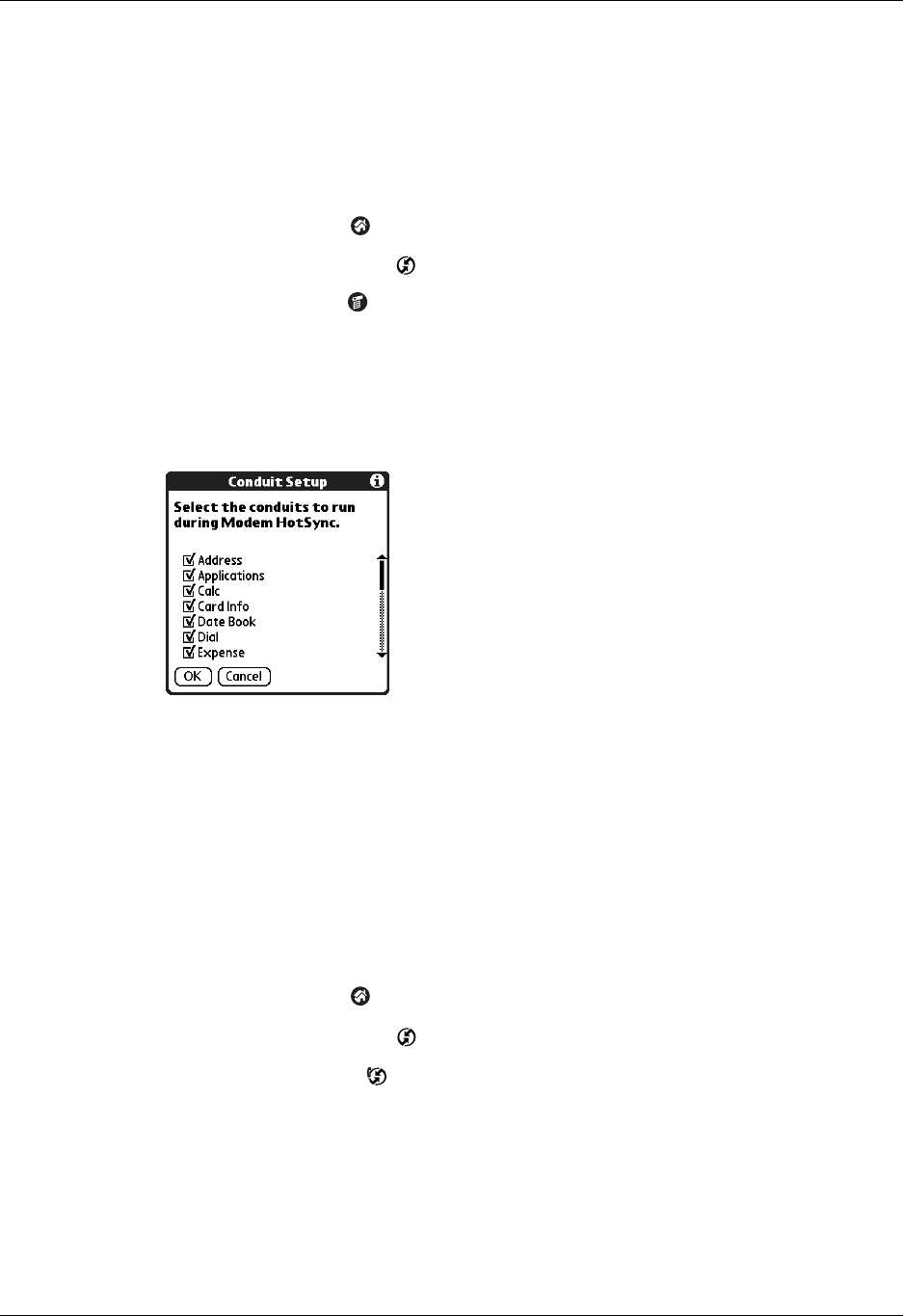
Conducting modem HotSync operations
175
Selecting the conduits for a modem HotSync operation
The Conduit Setup dialog box on your handheld enables you to define which files
and/or applications synchronize during a modem HotSync operation. You can use
these settings to minimize the time required to synchronize data with a modem.
To change the Conduit Setup for a modem HotSync operation:
1. Tap the Home icon .
2. Select the HotSync icon .
3. Tap the Menu icon .
4. Select Conduit Setup on the Options menu.
5. Tap the check boxes to deselect the files and applications that you do not want
to synchronize during a modem HotSync operation. The default setting is to
synchronize all files.
Applications that do not have a database (such as games) do not synchronize,
even if you select the item in the Conduit Setup dialog box.
6. Tap OK.
Performing a modem HotSync operation
After you prepare your computer and your handheld and select your Conduit
Setup options, you are ready to perform a modem HotSync operation.
To perform a modem HotSync operation:
1. Tap the Home icon .
2. Select the HotSync icon .
3. Tap the Modem icon to dial the Palm Desktop modem and synchronize the
applications.
4. Wait for the HotSync operation to complete. If you have any problems
conducting a successful HotSync operation, see “HotSync problems” in
Appendix B.
Palm, Inc. Confidential
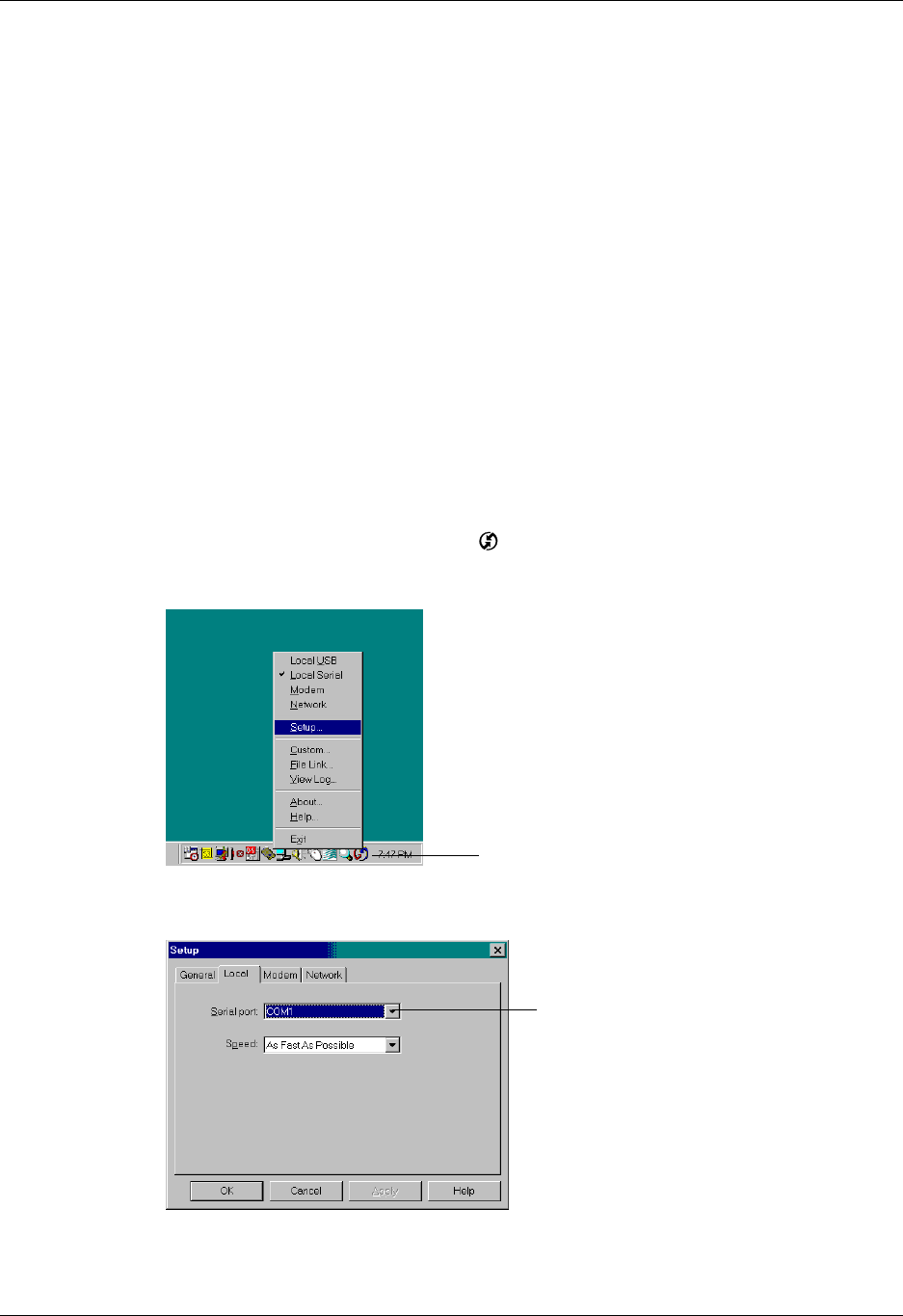
Chapter 16 Performing HotSync® Operations
176
Conducting Bluetooth HotSync operations
If you have a Bluetooth-enabled computer running Windows 98/2000 or
Mac OS X, version 10.1.2 or later with the Apple Bluetooth software, you can use
Bluetooth technology to perform wireless HotSync operations.
NOTE Go to the web site www.palm.com/support for additional information on
compatibility with other versions of the Windows operating system.
Preparing your computer for a Bluetooth HotSync operation
There are a few steps you must perform to prepare your computer for a Bluetooth
HotSync operation.
To prepare your Windows computer for a Bluetooth HotSync operation:
1. Use the Bluetooth setup software on your computer to open or create a virtual
serial port for Bluetooth communication. See the documentation included with
your computer for instructions on changing port settings or configuring the
Bluetooth serial host.
2. Click the HotSync Manager icon in the Windows system tray, and then
select Setup.
3. Click the Local tab.
Click the HotSync Manager icon
Select the port from the
drop-down list
Palm, Inc. Confidential
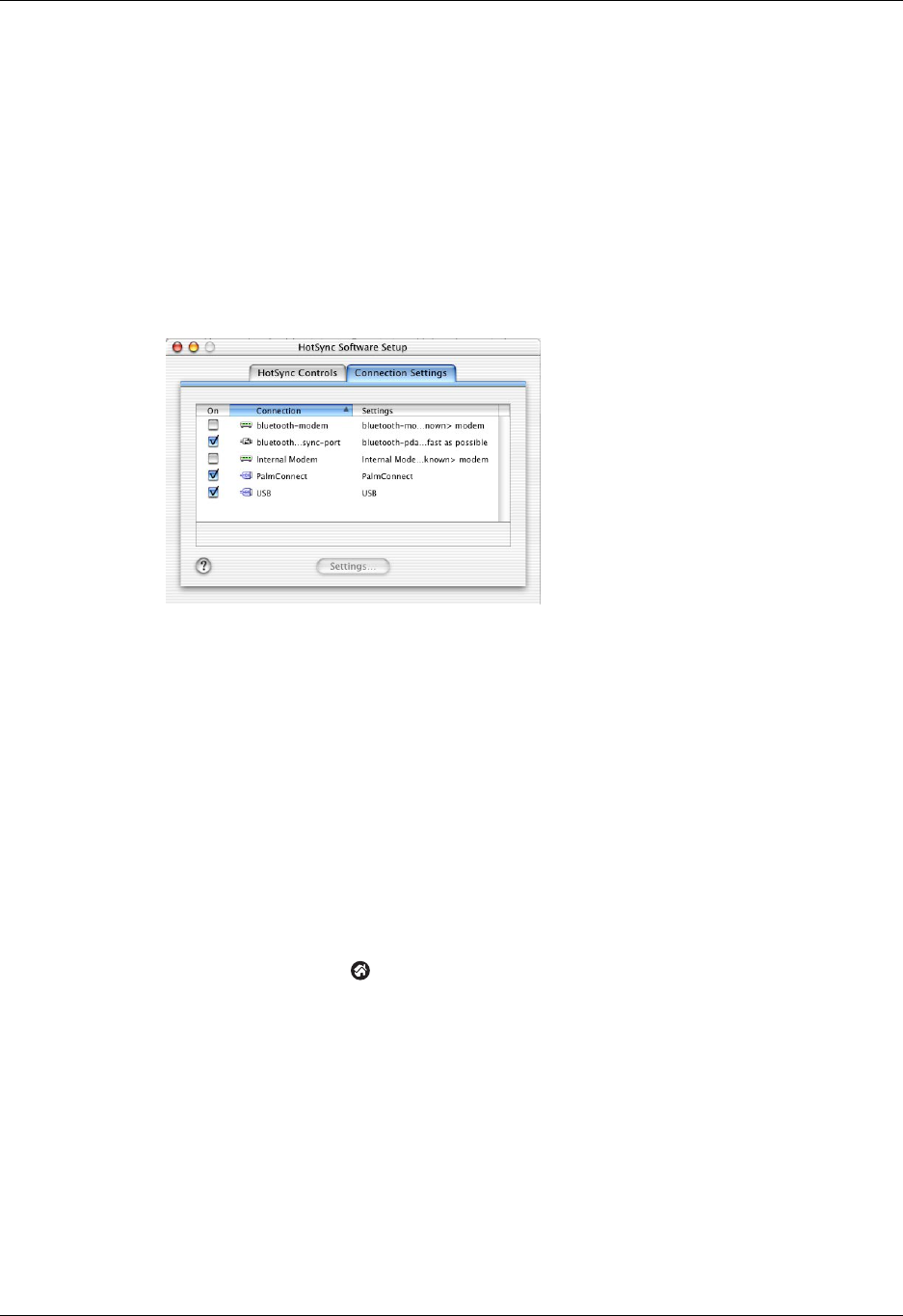
Conducting Bluetooth HotSync operations
177
4. In the Serial port drop-down box, select the virtual serial port you chose or
created in step 1.
5. Click OK.
To prepare your Mac computer for a Bluetooth HotSync operation:
1. Double-click the HotSync Manager icon in the Palm folder.
2. In the HotSync Controls tab, select Enabled.
3. Click the Connection Settings tab, and select the On check box next to bluetooth-
pda-sync-port.
4. Close the HotSync Software Setup window.
Preparing your handheld for a Bluetooth HotSync operation
There are a few steps you must perform to prepare your handheld for a Bluetooth
HotSync operation.
To prepare your handheld for a Bluetooth HotSync operation:
1. Create a trusted pair with your computer. See “Adding trusted devices” in
Chapter 17 for details.
2. Create a connection with your computer. See “Creating Bluetooth connections”
in Chapter 17 for details.
3. Tap the Home icon .
Palm, Inc. Confidential
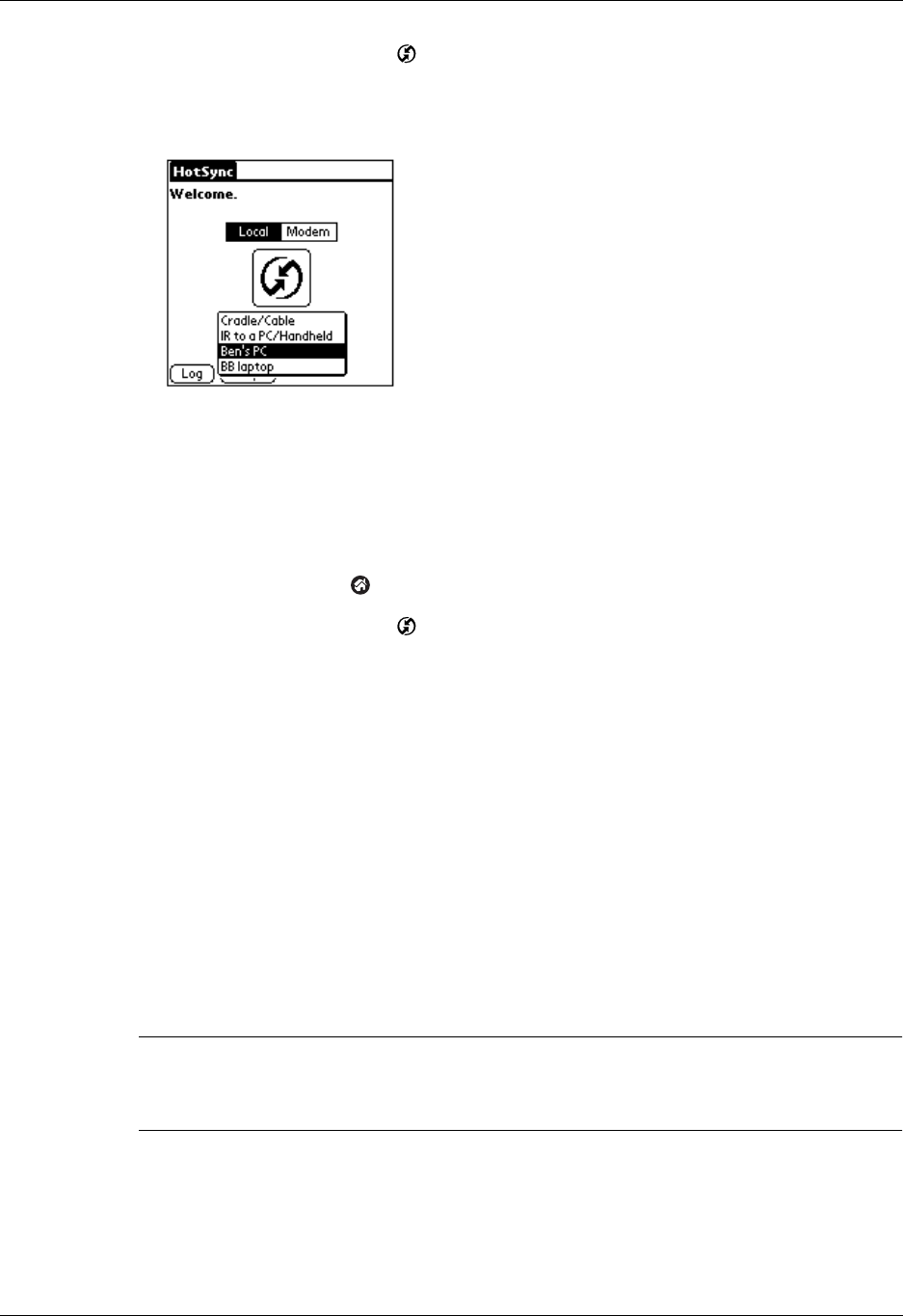
Chapter 16 Performing HotSync® Operations
178
4. Select the HotSync icon .
5. Tap the pick list in the center of the screen and select the connection settings you
just created.
Performing a Bluetooth HotSync operation
After you prepare your computer and your handheld, you are ready to perform a
Bluetooth HotSync operation.
To perform a Bluetooth HotSync operation:
1. Tap the Home icon .
2. Select the HotSync icon .
3. Tap the HotSync icon in the center of the screen.
Conducting network HotSync operations
When you use the network HotSync technology, you can take advantage of the
LAN and WAN connectivity available in many office environments. Network
HotSync technology enables you to perform a HotSync operation by using
Bluetooth technology or an 802.11 accessory to make a wireless connection to a
network, by dialing in to a network, or by using a cradle/cable that is connected to
any computer on your LAN or WAN (provided that the computer connected to the
cradle/cable also has the network HotSync technology installed, your computer is
on, and the HotSync Manager is running). Network HotSync technology is
available only on Windows computers.
IMPORTANT You must perform the first HotSync operation by using a local, direct
connection or infrared communication. After that, you can perform a network
HotSync operation.
Palm, Inc. Confidential
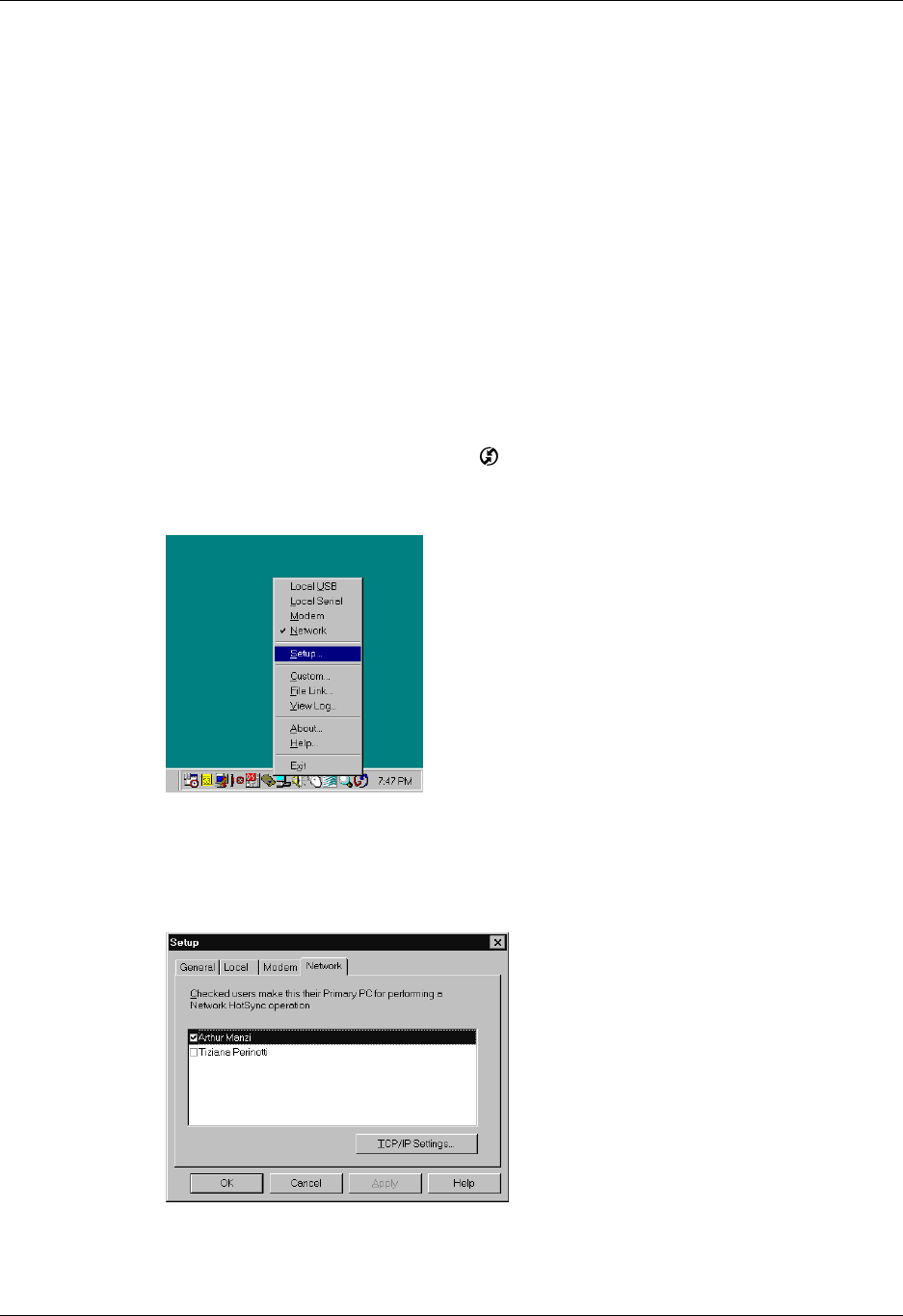
Conducting network HotSync operations
179
Connecting to your company’s dial-in server
A network HotSync operation requires the following (consult your system
administrator for assistance):
■Your computer has TCP/IP support installed.
■Both your company’s network system and its remote access server support
TCP/IP.
■You have a remote access account.
Everything you need for connecting to your company’s dial-in server (network
modem) is included with Palm Desktop software and handheld software. You
need to activate the feature, however, on both Palm Desktop software and your
handheld.
To prepare your computer for a network HotSync operation:
1. Click the HotSync Manager icon in the Windows system tray.
2. From the HotSync Manager menu, select Network.
3. From the HotSync Manager menu, select Setup.
4. Click the Network tab and make sure your user name has a checkmark next to
it. If the checkmark is not there, click the check box next to your user name.
Palm, Inc. Confidential
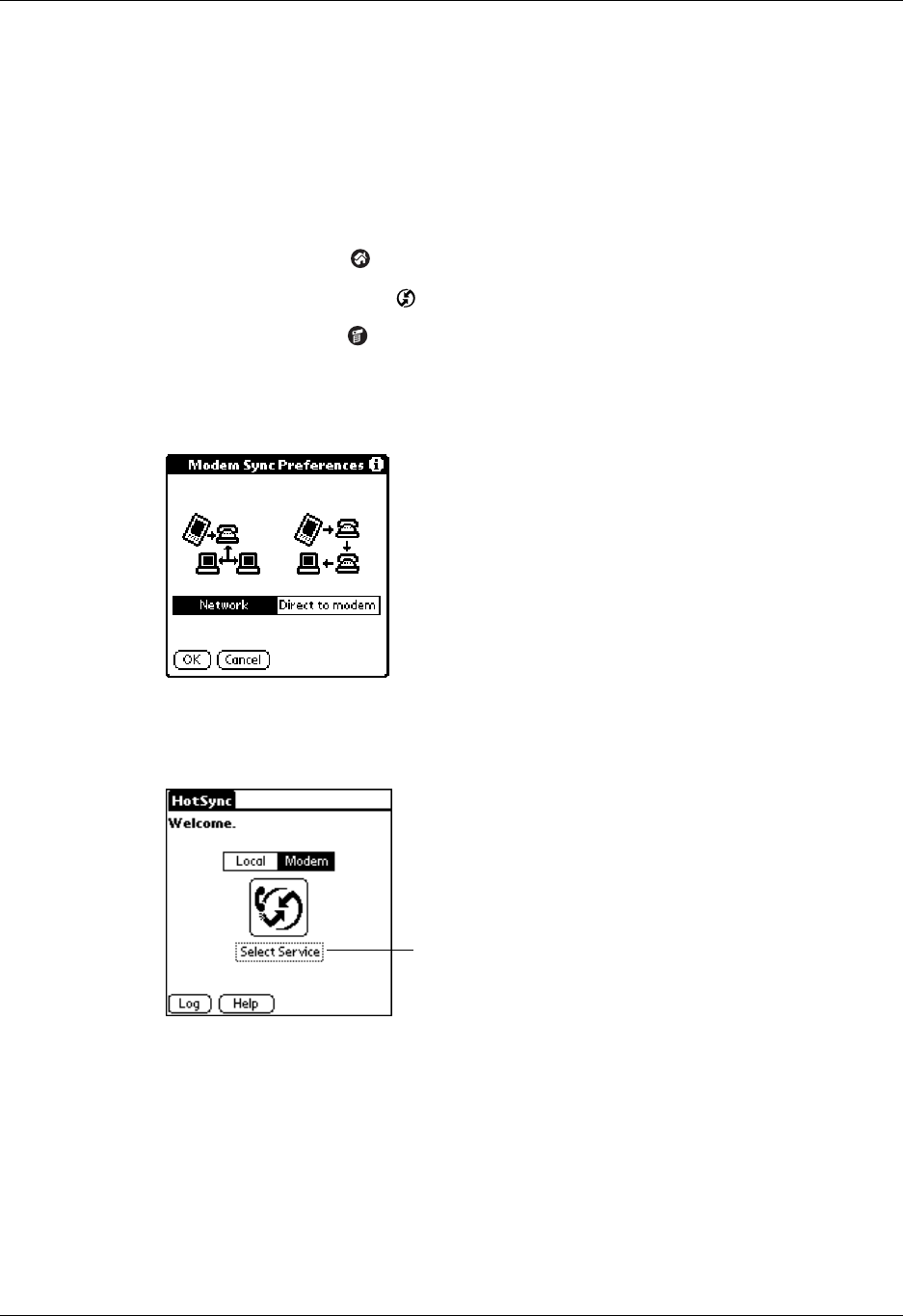
Chapter 16 Performing HotSync® Operations
180
5. Click OK.
6. Put your handheld in the cradle/cable, and perform a HotSync operation.
The HotSync operation records network information about your computer on
your handheld. With this information, your handheld can locate your computer
when you perform a HotSync operation over the network.
To prepare your handheld for a network HotSync operation:
1. Tap the Home icon .
2. Select the HotSync icon .
3. Tap the Menu icon .
4. Select Modem Sync Prefs on the Options menu.
5. Tap Network.
6. Tap OK.
7. Tap Select Service.
NOTE See “Network preferences” in Chapter 17 for information on creating a
network or Bluetooth connection.
Ta p h e r e
Palm, Inc. Confidential
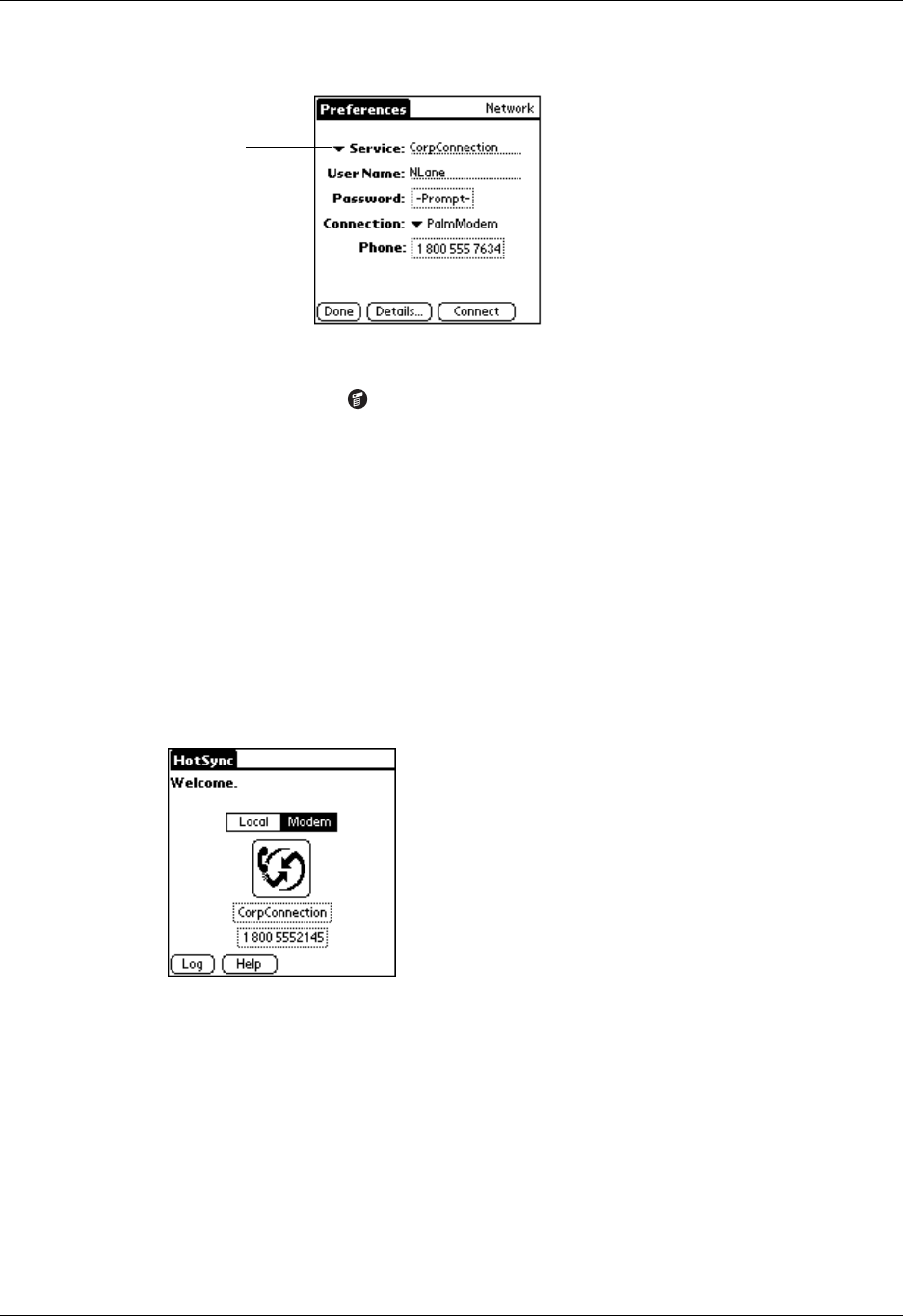
Using File Link
181
8. Tap Service and select a service.
9. Tap Don e.
10. Tap the Menu icon .
11. Select Conduit Setup on the Options menu.
For instructions, see “Selecting the conduits for a modem HotSync operation”
earlier in this chapter.
Performing a network HotSync operation
After you prepare your computer and your handheld and select your Conduit
Setup options, you are ready to perform a network HotSync operation.
To perform a network HotSync operation:
■Tap the modem HotSync icon to begin the operation.
Using File Link
The File Link feature enables you to import Address Book and Memo Pad
information onto your handheld from a separate external file such as a company
phone list. HotSync Manager stores the data in a separate category on your Palm
Desktop software and your handheld. You can configure the File Link feature to
check for changes to the external file when you perform a HotSync operation.
Tap here
Palm, Inc. Confidential

Chapter 16 Performing HotSync® Operations
182
With File Link you can import data stored in any of the following formats:
■Comma-separated (*.csv)
■Memo Pad archive (*.mpa)
■Address Book archive (*.aba)
■Text (*.txt)
For information on how to set up a file link, see the Palm Desktop online Help.
NOTE The File Link feature is not available in Palm Desktop software for Mac.
Creating a user profile
A user profile enables you to install the same set of data onto multiple Palm OS
handhelds before each handheld is individualized with a specific user name and
data file.
A handheld that is preconfigured with a user profile can be given to anyone
because the handheld is not yet identified by a unique user name. The handheld
acquires a unique user name when the new user performs his or her first local
HotSync operation.
For example, suppose a sales organization wants to distribute two dozen
handhelds that all have a common company phone list, a set of memos, and several
key applications. A user profile can be created to install the common data before
the handhelds are distributed to the employees who will use them. Then when the
employees perform their first HotSync operation, the common data becomes part
of their individual data file.
NOTE The handhelds that are synchronized with a user profile must be either new
ones that have never been synchronized or handhelds that have had their user names
and data removed by a hard reset.
To create a user profile on a Windows computer:
1. Open Palm Desktop software.
2. From the Tools menu, select Users.
3. Click Profiles.
Palm, Inc. Confidential
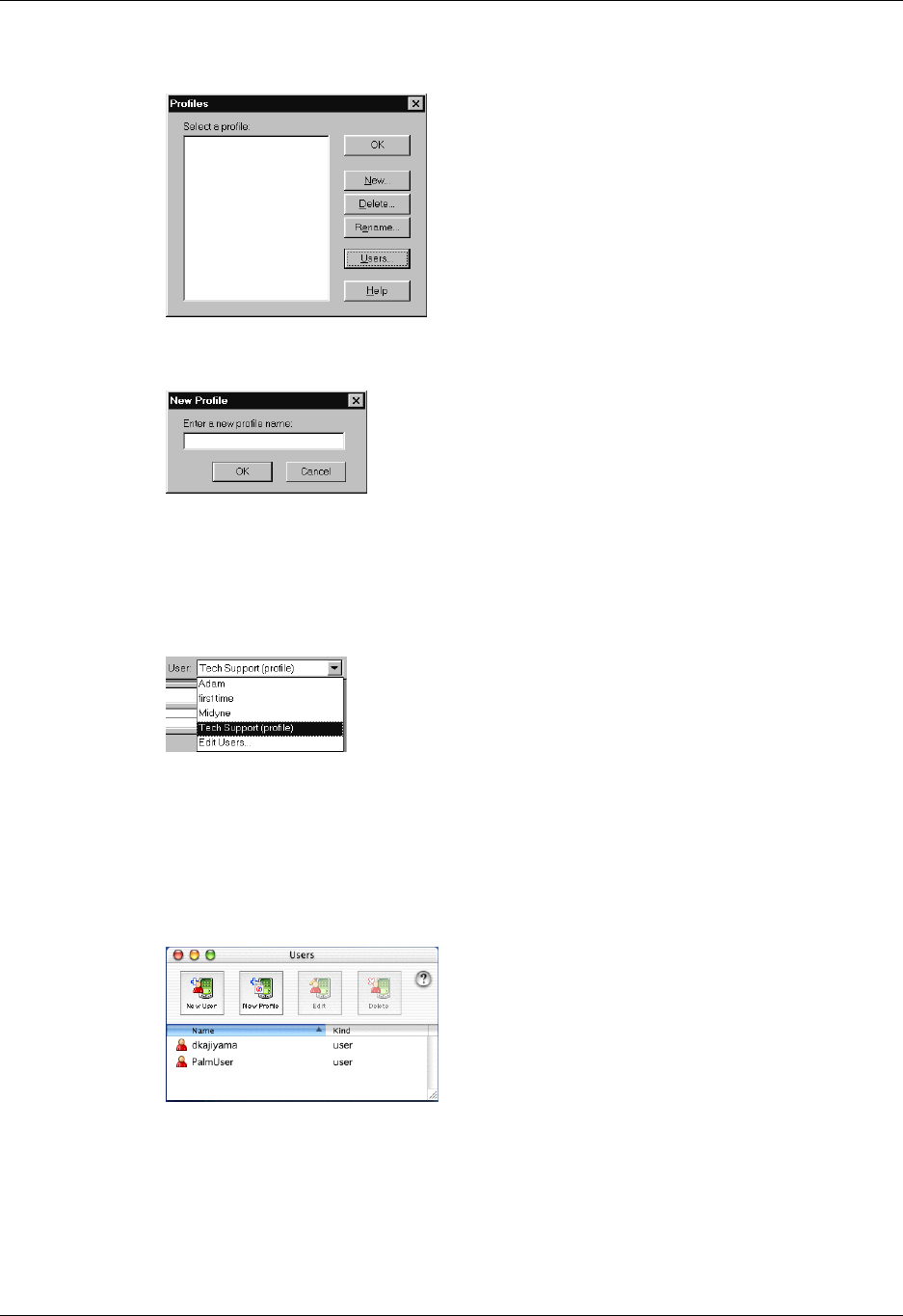
Creating a user profile
183
4. Click New.
5. Enter a unique name for the profile, and click OK.
6. Repeat steps 3 and 4 for each profile that you want to create, and then click OK
to return to Palm Desktop software.
7. Select the profile from the User list, and create the data for the profile (such as
a company phone list, and so on).
To create a user profile on a Mac computer:
1. Open Palm Desktop software.
2. From the User pop-up menu, select Edit Users.
3. Click New Profile.
Palm, Inc. Confidential
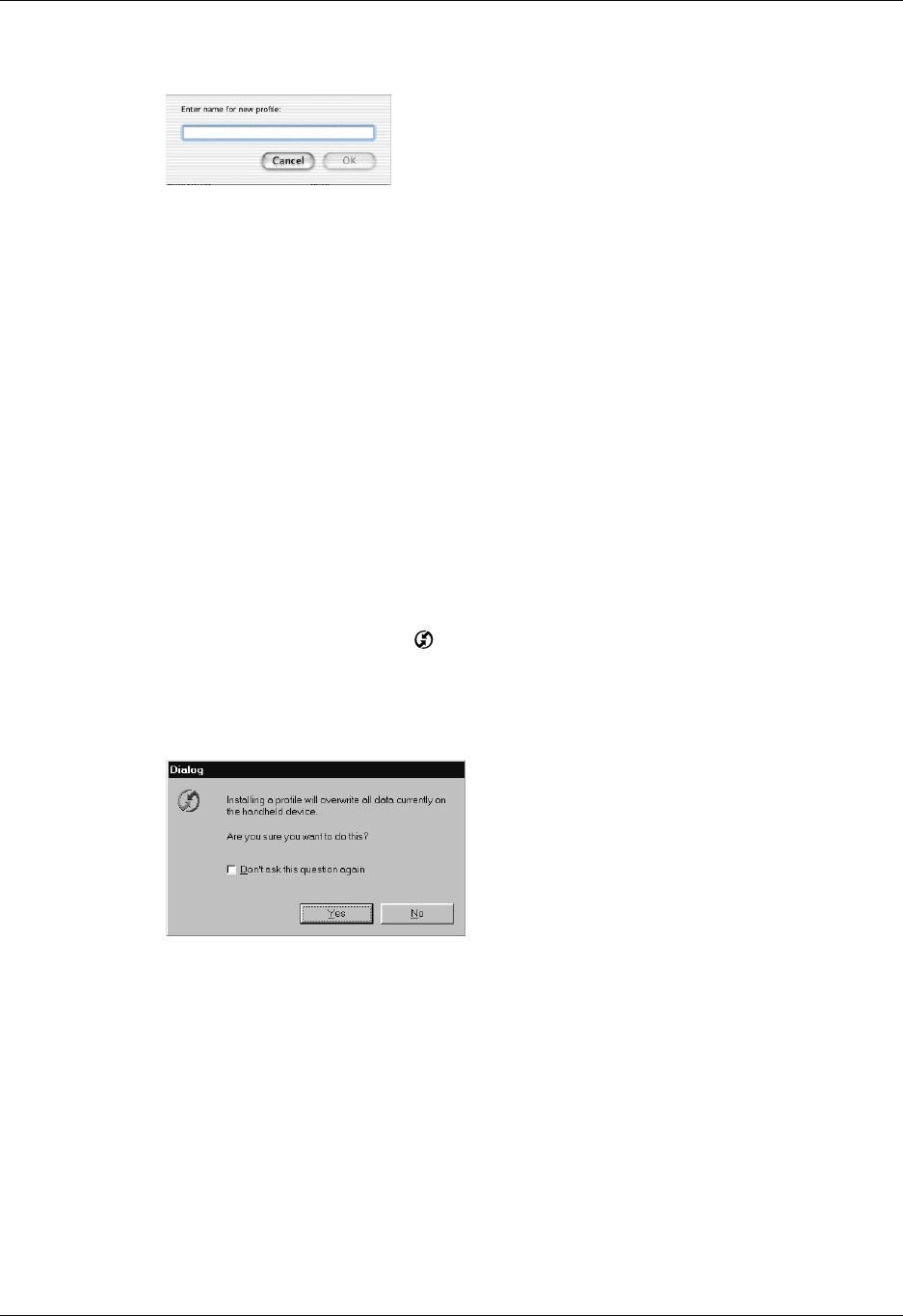
Chapter 16 Performing HotSync® Operations
184
4. Enter a unique name for the profile, and click OK.
5. Close the Users window.
6. From the User pop-up menu, select the new profile.
7. Create the data for the profile (such as a company phone list).
8. From the HotSync menu, select Conduit Settings.
9. Select the conduit settings for the profile. For details, see “Customizing HotSync
application settings” earlier in this chapter.
Performing the first HotSync operation with a user profile
After you create a user profile, you are ready to transfer the information to the new
handheld during the first HotSync operation.
To use a profile for a first-time HotSync operation on a Windows computer:
1. Place the new handheld in the cradle/cable.
2. Press the HotSync button on the cradle/cable.
3. Click Profiles.
4. Select the profile you want to load on the handheld, and click OK.
5. Click Yes to transfer all the profile data to the handheld.
The next time you perform a HotSync operation, Palm Desktop software prompts
you to assign a user name to the handheld.
Palm, Inc. Confidential

Creating a user profile
185
To use a profile for a first-time HotSync operation on a Mac computer:
1. Connect the new handheld to the HotSync cradle/cable.
2. Press the HotSync button on the cradle/cable.
3. Select the profile you want to load on the handheld, and click OK to transfer all
the profile data to the handheld.
The next time you perform a HotSync operation, Palm Desktop software prompts
you to assign a user name to the handheld.
Palm, Inc. Confidential

Chapter 16 Performing HotSync® Operations
186
Palm, Inc. Confidential

187
CHAPTER 17
Setting Preferences for Your Handheld
Preferences enable you to customize the configuration options on your handheld.
The options are grouped into four categories: General, Communication, Personal,
and Other. Each category provides access to a list of relevant Preferences screens.
Use Preferences to do the following:
■Access the General Preferences screens to customize any of the following
settings:
■Access the Communication Preferences screens to customize any of the
following settings:
Date & Time Set the location, date, and time.
Digitizer Calibrate the screen on your handheld.
Formats Set the country default and the formats for times, dates,
calendar, and numbers.
Power Set these features: auto-shutoff interval, Stay on in cradle,
Beam receive, Power on when opened, and Power off when
closed.
Security Set a password, privacy options, and locking options.
Sounds & Alerts Select system, game, and alarm options from three profiles:
Custom, Silent, and All Off.
Bluetooth Turn Bluetooth communication on and off, assign a name to
your handheld, and configure device discovery and wakeup
settings.
Connection Configure communication settings.
Network Configure your handheld for use with a network.
Phone Select a connection for use with wireless data and phone
applications on your handheld.
Palm, Inc. Confidential
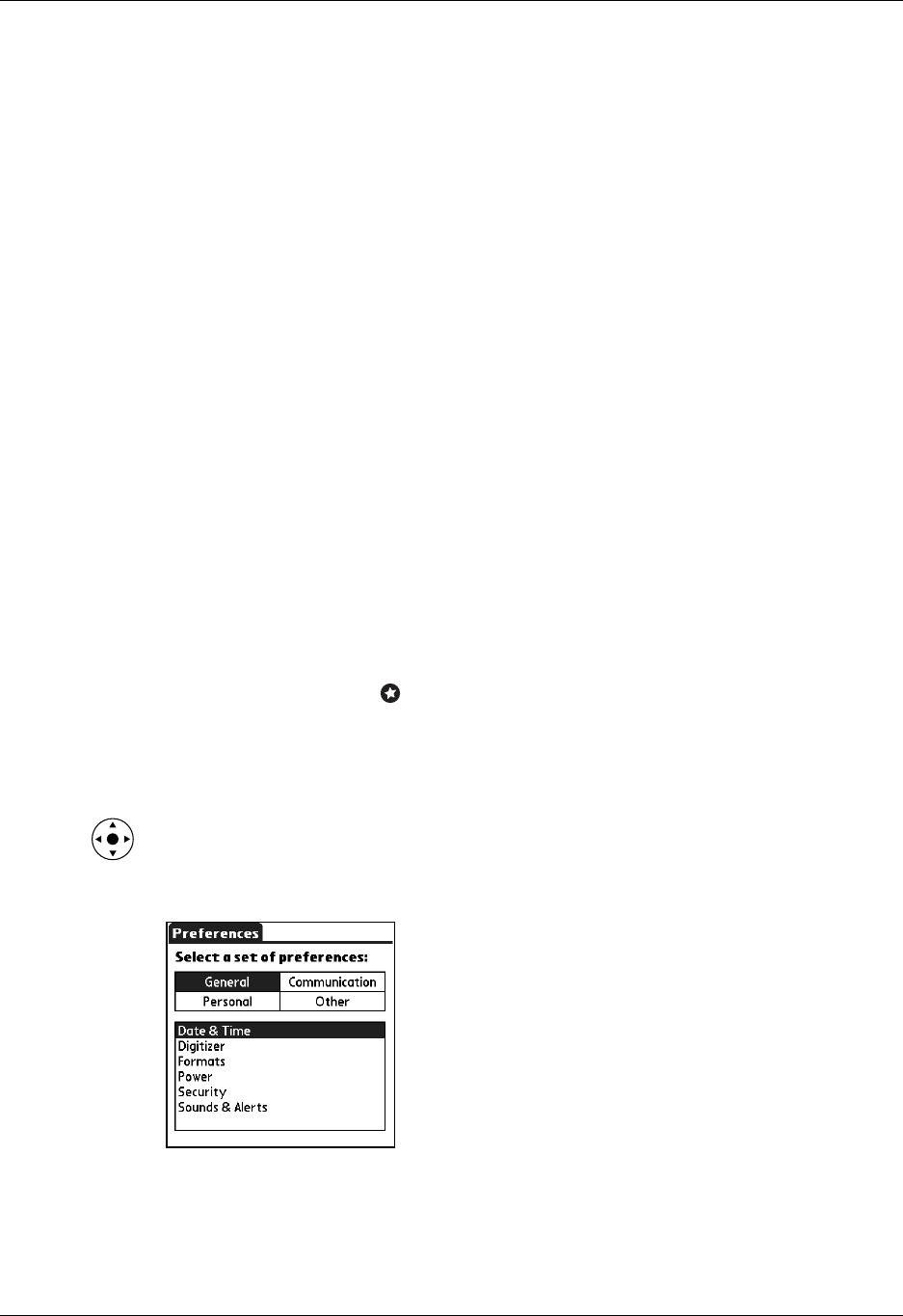
Chapter 17 Setting Preferences for Your Handheld
188
■Access the Personal Preferences screens to customize any of the following
settings:
■Access the Other Preferences category to customize settings for any third-party
applications you installed on your handheld. The Other Preferences category is
empty unless you installed a third-party application that includes a Preferences
screen.
Setting General Preferences
The General Preferences category enables you to access screens where you can
modify Date & Time, Digitizer, Formats, Power, Security, and Sounds & Alerts
settings. This section provides details about each of these screens.
To open the General Preferences screens:
1. Tap the Favorites icon .
2. Tap General.
3. Select the name of the Preferences screen you want to view.
TIP You can also select the Preferences category by pressing Left and Right on
the navigator, and select a Preferences screen by pressing Up and Down on the
navigator.
Buttons Assign an application to the Favorites icon. Reassign various
applications to the following: the application buttons on the
front and side panels of your handheld, the HotSync® button
on the cradle/cable, and the full-screen pen stroke command.
Owner Enter your name, phone number, and other owner information
to your handheld.
ShortCuts Define a list of Graffiti® abbreviations.
Palm, Inc. Confidential
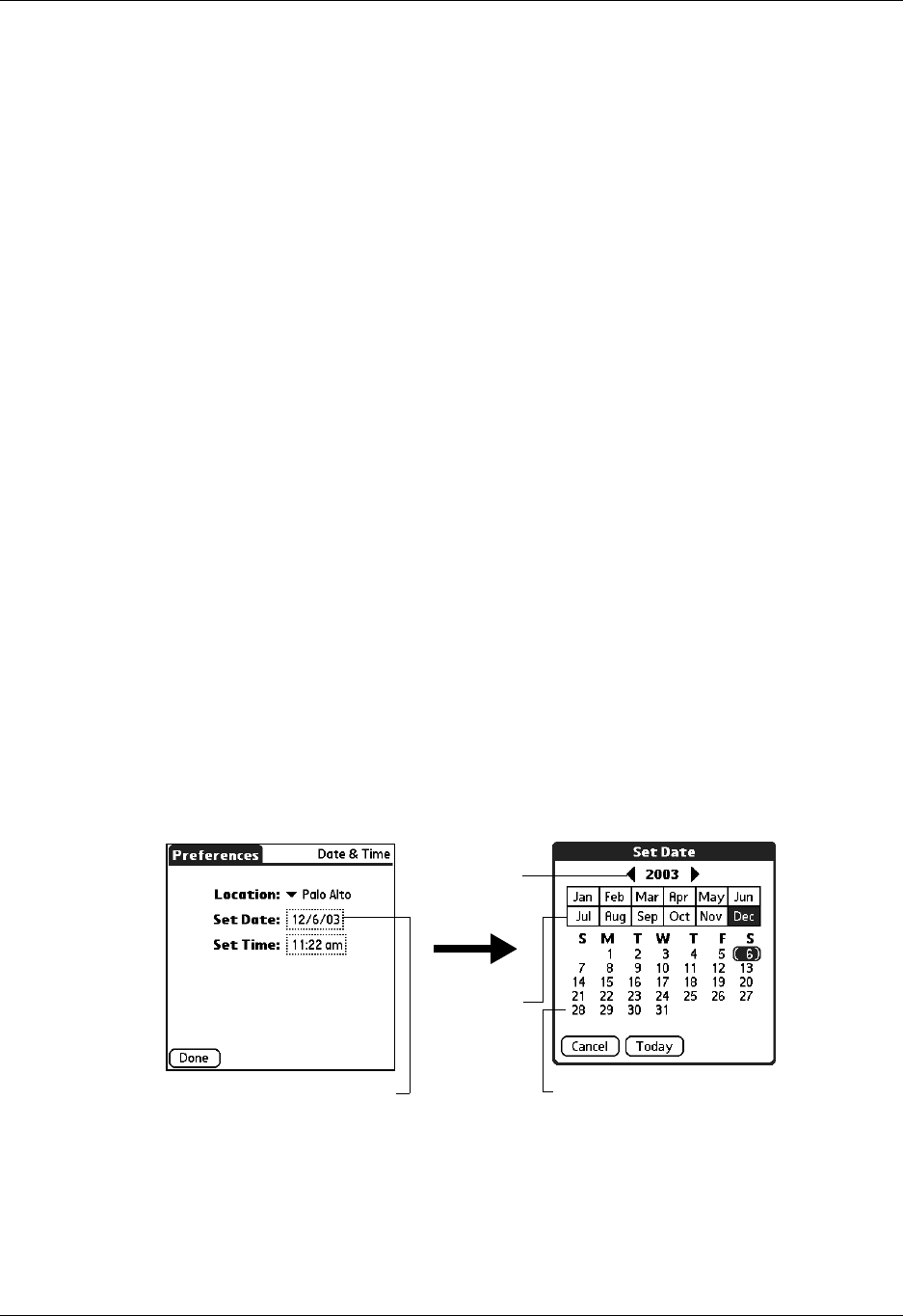
Setting General Preferences
189
Date & Time Preferences
The Date & Time Preferences screen enables you to choose a primary location and
to set the date, time, and time zone for that location. You can also indicate whether
this location observes daylight saving time and the dates daylight saving time
starts and ends. All of these settings also appear as the primary location in the
World Clock application and are used by all the applications on your handheld.
Although you can change the primary location settings from the Date & Time
Preferences screen, we recommend that you use the World Clock application to
change these settings. See “Setting the primary location” in Chapter 15 for details.
To set the location:
1. From the General Preferences screen, select Date & Time.
2. Tap the Location pick list and select the location you want to use as your
primary location.
The location you select should be a large city in the same time zone as the one
where you live. If an appropriate choice does not appear in the list, see “Adding
a location” in Chapter 15 to create a new location.
3. Tap Don e.
When you travel, changing the primary Location setting automatically resets
the date and time on your handheld based on the local time zone, but it does not
change the time of appointments set in Date Book.
To set the date:
1. From the General Preferences screen, select Date & Time.
2. Tap the Set Date box.
3. Tap the arrows to select the current year.
4. Tap the current month.
5. Tap the current date.
6. Tap Don e.
Tap to set date
Ta p a rr o w s
to select
year
Tap to select
month
Tap to select date
Palm, Inc. Confidential

Chapter 17 Setting Preferences for Your Handheld
190
To set the time:
1. From the General Preferences screen, select Date & Time.
2. Tap the Set Time box.
3. Tap the up or down arrows to change the hour.
4. Tap each minute number, and then tap the arrows to change them.
5. Tap OK.
6. Tap Don e.
To set the time zone and daylight saving time:
1. From the General Preferences screen, select Date & Time.
2. Tap the Location pick list.
3. Select Edit List.
4. Select the location where you want to set the time zone.
5. Tap Edit to open the Edit Location dialog box.
6. Follow the steps under “Adding a location” in Chapter 15 to select the time zone
and daylight saving time settings.
7. Tap Done.
Digitizer Preferences
The Digitizer Preferences screen opens the digitizer calibration screen. This is the
same screen that appears when you start your handheld for the first time.
You can recalibrate your screen after a hard reset or if your digitizer drifts. You
may need to repeat this process a few times until the calibration registers.
To calibrate your handheld screen:
1. From the General Preferences screen, select Digitizer.
2. Tap the targets as indicated on the screen as precisely as possible.
TIP Remember that you can also select the Preferences category by pressing Left
and Right on the navigator, and that you can select a Preferences screen by pressing
Up and Down on the navigator.
Palm, Inc. Confidential
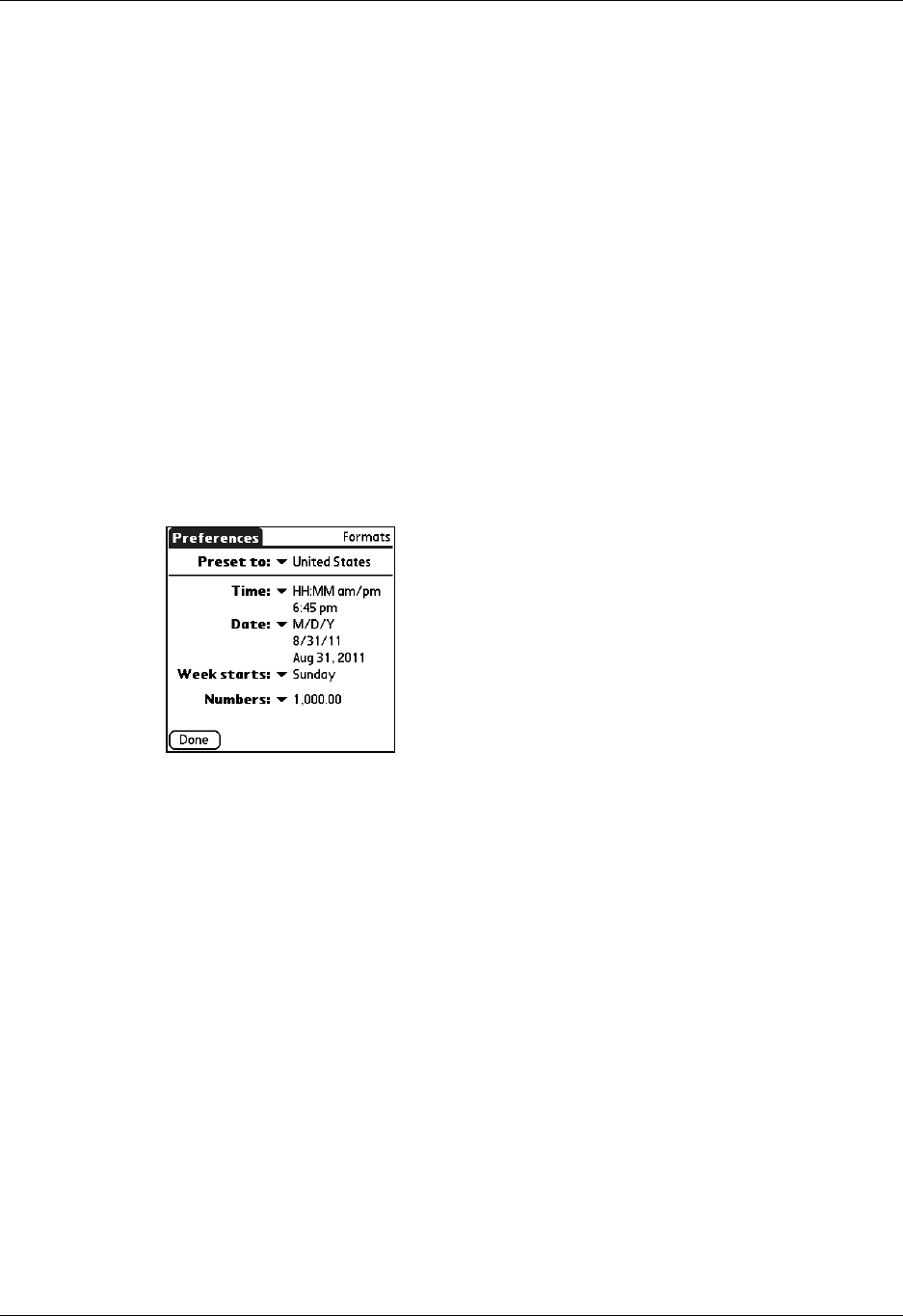
Setting General Preferences
191
Formats Preferences
Use the Formats Preferences screen to set the country default and the display
format of the dates, times, and numbers on your handheld.
Country default
The country default sets date, time, week start day, and number conventions based
on geographic regions where you might use your handheld. For example, in the
United Kingdom, time often is expressed using a 24-hour clock. In the United
States, however, time is expressed using a 12-hour clock with an AM or PM suffix.
All your handheld applications use the Country default settings. You can,
however, customize your own preferences as described in “Time, date, week start,
and numbers formats” later in this chapter.
To set the country default:
1. From the General Preferences screen, select Formats.
2. Tap the country name pick list.
3. Select the setting you want to use.
4. Tap Don e.
Time, date, week start, and numbers formats
The Time setting defines the format for the time of day. The time format that you
select appears in all applications on your handheld.
To select the time, date, week start, and numbers format:
1. From the General Preferences screen, select Formats
2. Tap the Time pick list and select a format.
3. Tap the Date pick list and select a format.
4. Tap the Week starts pick list, and select whether you want the first day of the
week to be Sunday or Monday.
This setting controls the Day, Week, and Month views in Date Book and all
other aspects of your handheld that display a calendar.
Palm, Inc. Confidential
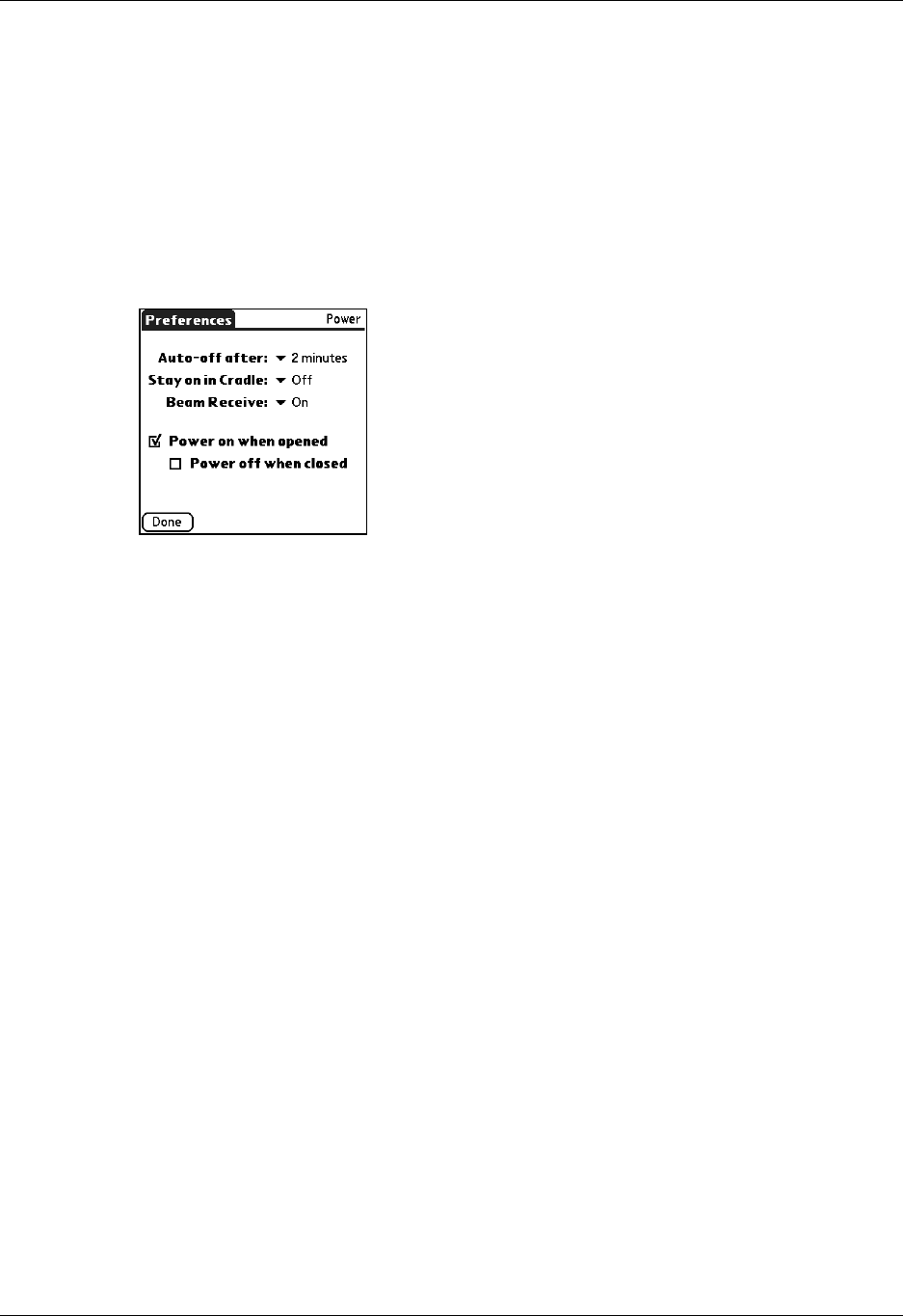
Chapter 17 Setting Preferences for Your Handheld
192
5. Tap the Numbers pick list, and select formats for the decimal point and
thousands separator.
6. Tap Don e.
Power Preferences
The Power Preferences screen enables you to set power consumption options. You
can control when your handheld turns on or automatically turns off, and whether
to receive beamed information.
Auto-off after
Your handheld has an automatic shutoff feature that turns off the power and
backlight after a period of inactivity. This feature helps conserve battery power in
case you forget to turn off your handheld.
If you find that your handheld shuts itself off before you finish reviewing the
information on the screen, you can increase the time setting of the automatic
shutoff feature.
To set the Auto-off after interval:
1. From the General Preferences screen, select Power.
2. Tap the Auto-off after pick list.
3. Select the setting you want to use for the automatic shutoff feature: 30 seconds,
1 minute, 2 minutes, or 3 minutes.
4. Tap Don e.
Stay on in Cradle
You can choose to leave your handheld on when it is in the cradle/cable, so you
can continue to view your data. By default, your handheld remains on when in the
cradle/cable and connected to a power source.
To change the cradle/cable setting:
1. From the General Preferences screen, select Power.
2. Tap the Stay on in Cradle pick list.
Palm, Inc. Confidential

Setting General Preferences
193
3. Select Off to turn off your handheld when it is in the cradle/cable.
4. Tap Don e.
Beam Receive
You can choose to turn off the Beam Receive feature. This prohibits anyone from
beaming information to your handheld. It also results in a slight saving of battery
power. By default, Beam Receive is enabled.
To turn off the Beam Receive feature:
1. From the General Preferences screen, select Power.
2. Tap the Beam Receive pick list.
3. Select Off to disable receiving beamed information.
4. Tap Don e.
Power on when opened and Power off when closed
You can choose to automatically turn your handheld on and off when you open
and close the Graffiti writing area. By default, your handheld turns on when you
open it and remains on when you close it. The power off option is available only
when the Power on when opened setting is active.
To change the power on setting:
1. From the General Preferences screen, select Power.
2. Tap the check box, Power on when opened, to deselect it.
3. Tap Don e .
To change the power off setting:
1. From the General Preferences screen, select Power.
2. Tap the check box, Power off when closed, to select it.
3. Tap Don e.
Security Preferences
The Security Preferences help you prevent unauthorized users from viewing
entries that you want to protect. Use the Security Preferences to do the following:
■Lock and turn off your handheld so that it does not operate until you enter the
correct password.
■Mask all records that you mark as private so that the information appears as
gray bars.
■Hide all records that you mark as private so that they do not appear on any
screen.
Palm, Inc. Confidential
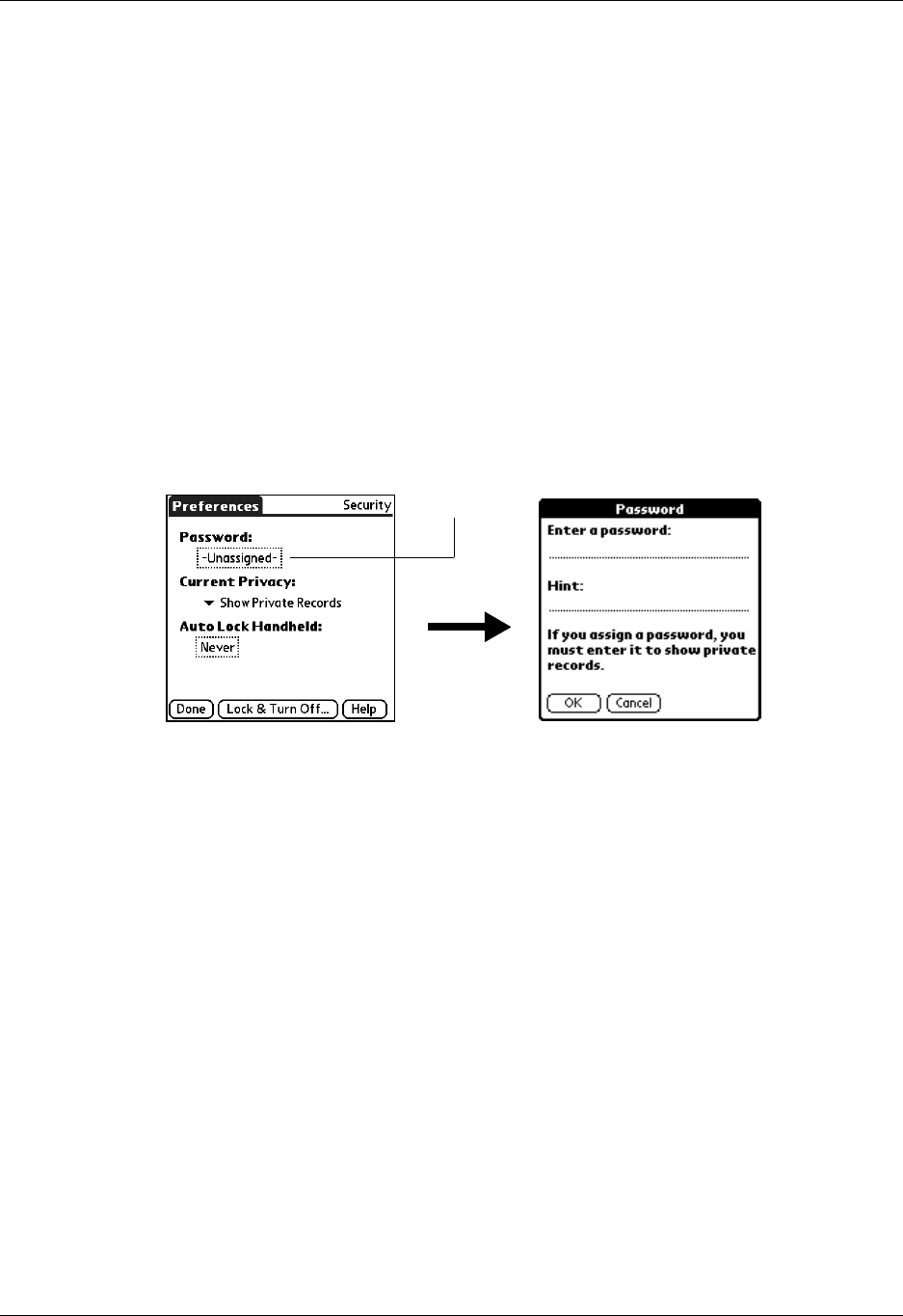
Chapter 17 Setting Preferences for Your Handheld
194
You can mask and hide private records with or without a password. Without a
password, private records are hidden or masked until you set the Security
Preferences to show them. With a password, you must enter the password to view
the private entries.
Assigning a password
You can assign a password to protect your private records and to lock your
handheld.
To assign a password:
1. From the General Preferences screen, select Security.
2. Tap the Password box.
3. Enter a password.
4. Enter a hint to help you remember your password if you forget it. This is
optional.
5. Tap OK.
6. Enter the same password a second time, and tap OK.
7. Tap Don e.
Changing or deleting a password
Once you define a password for your handheld, you can change or delete it at any
time. You must enter the current password before you can change or delete it.
To change or delete your password:
1. From the General Preferences screen, select Security.
2. Tap the Password box.
Tap here
Palm, Inc. Confidential
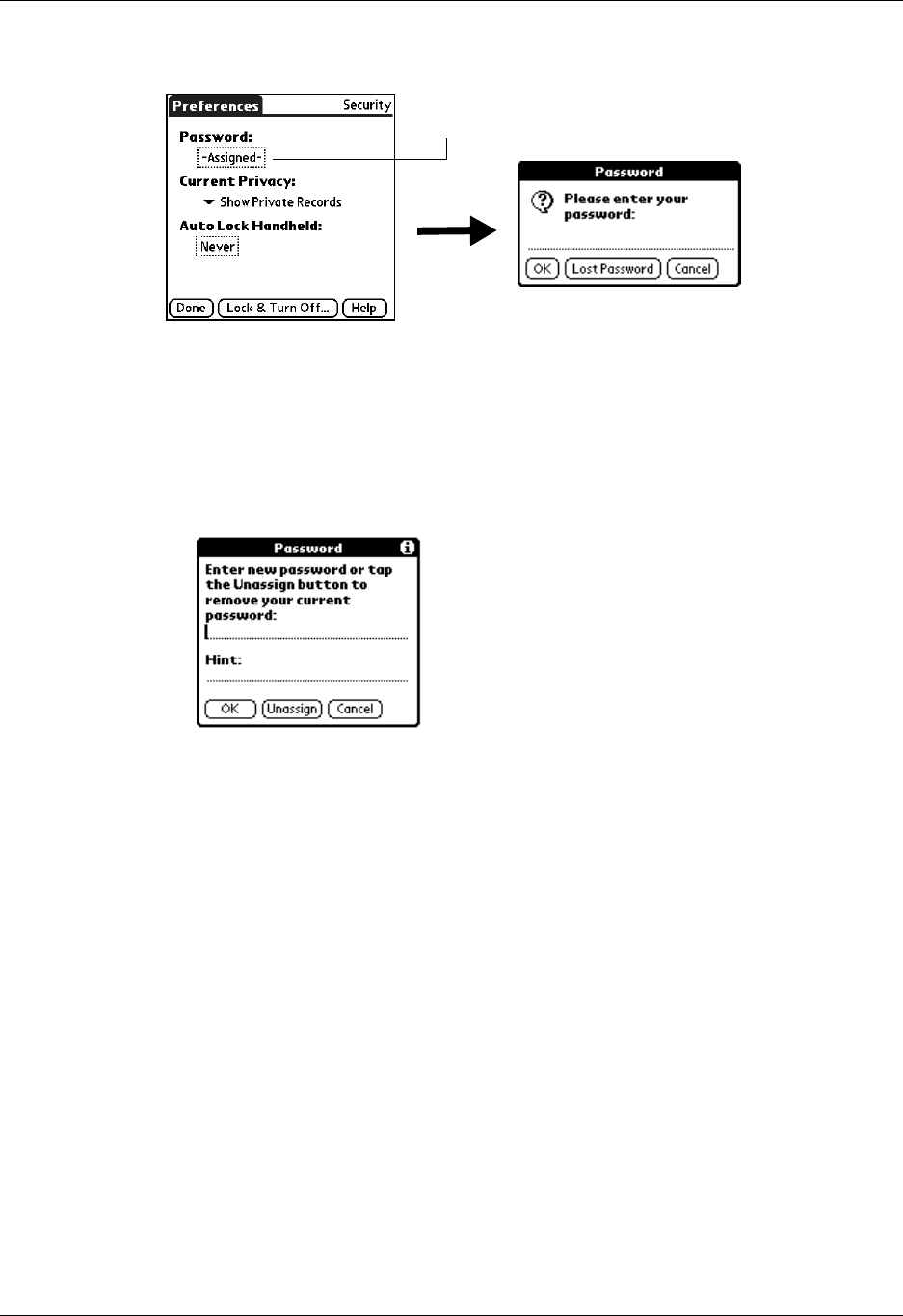
Setting General Preferences
195
3. Enter the current password.
4. Tap OK.
5. Do one of the following:
– To change the password and hint, enter the new password and hint, and
tap OK.
– To remove the password, tap Unassign.
6. Tap Don e.
Locking your handheld
You can lock your handheld so that it cannot be operated until your password is
entered. In the event that your handheld is lost or stolen, this helps protect your
data from unauthorized use. You can set your handheld to lock automatically, or
you can lock it manually.
You can set your handheld to lock automatically when any one of the following
occurs:
■When you turn off the power
■At a time you specify
■After a period of inactivity you specify
Tap here
Palm, Inc. Confidential
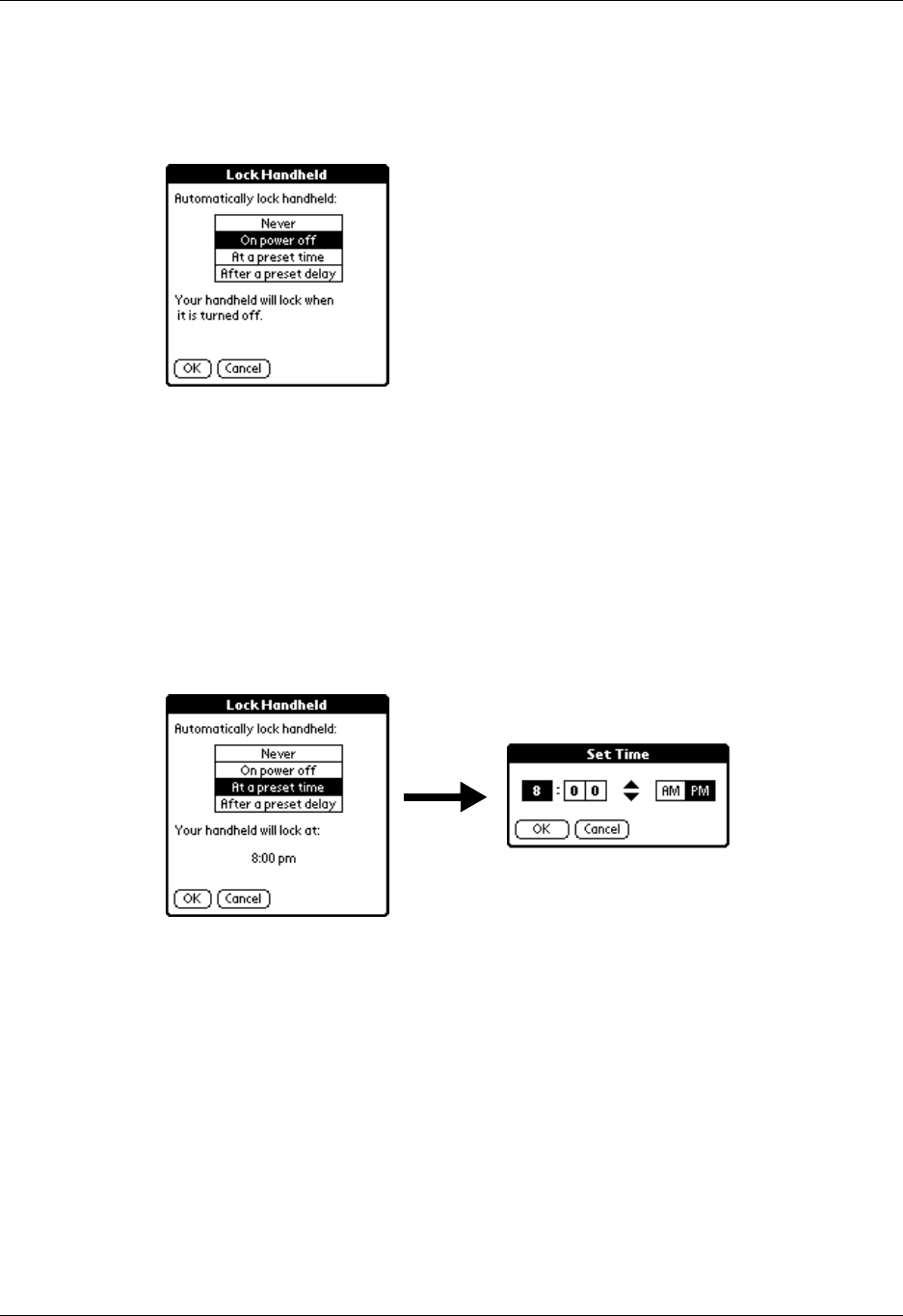
Chapter 17 Setting Preferences for Your Handheld
196
To set your handheld to lock when you turn it off:
1. From the General Preferences screen, select Security.
2. Tap the Auto Lock Handheld box, and then enter your password.
3. Select On power off.
4. Tap OK.
5. Tap Don e.
To set your handheld to lock at a preset time:
1. From the General Preferences screen, select Security.
2. Tap the Auto Lock Handheld box, and then enter your password.
3. Select At a preset time, and then use the arrows to set the time.
4. Tap OK.
5. Tap Don e.
Palm, Inc. Confidential
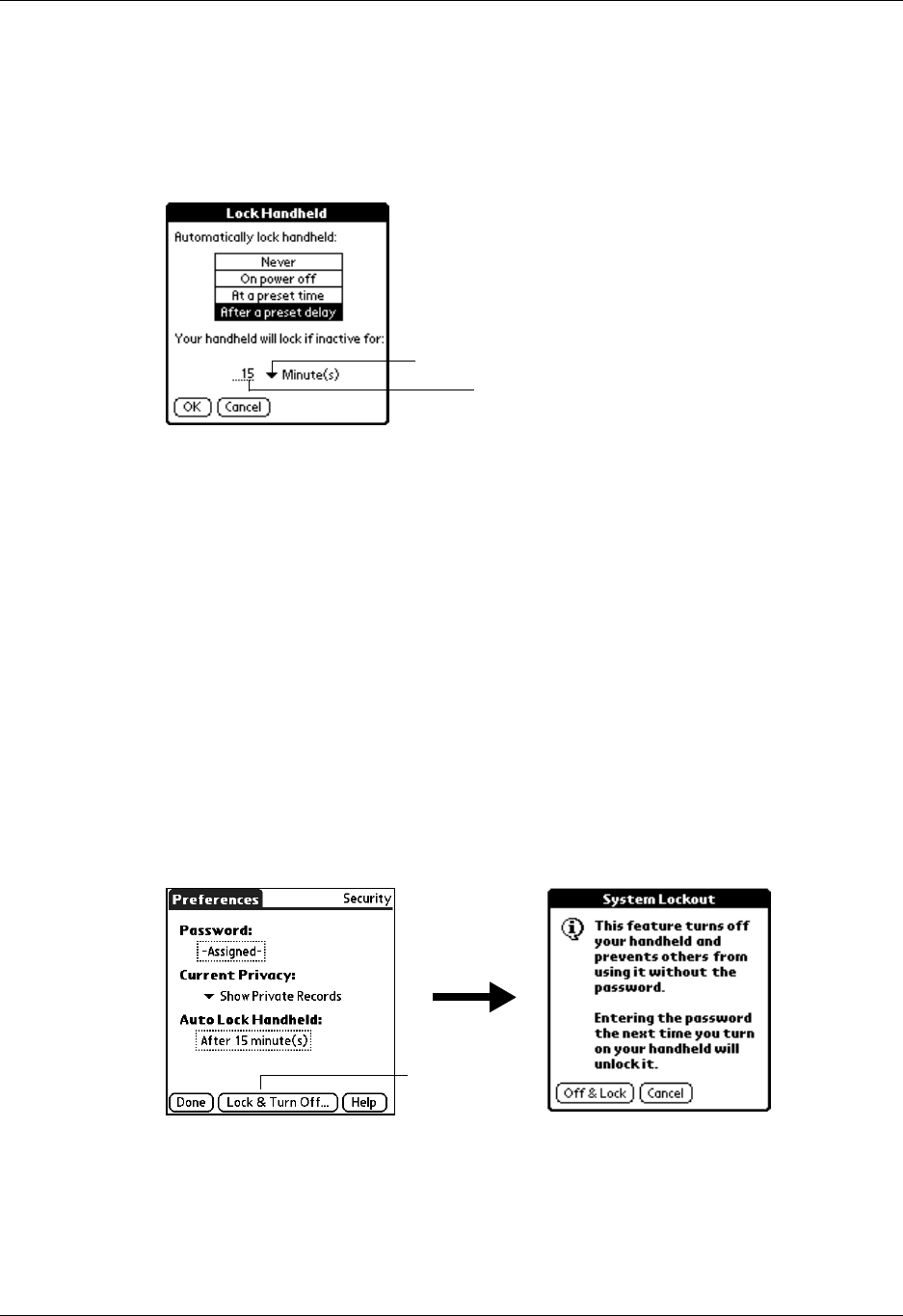
Setting General Preferences
197
To set your handheld to lock after a period of inactivity:
1. From the General Preferences screen, select Security.
2. Tap the Auto Lock Handheld box, and then enter your password.
3. Select After a preset delay.
4. Enter the inactive period, and then select Minute(s) or Hour(s) from the pick list.
5. Tap OK.
6. Tap Don e.
CAUTION If you lock your handheld, you must enter the exact password to re-
activate your handheld. If you forget the password, your handheld will present
the hint you have entered to help you remember the password. If you still
cannot remember the password, you must perform a hard reset to resume
using your handheld. Performing a hard reset deletes all the records in your
handheld; however, you can restore all synchronized data at the next HotSync
operation. See “Performing a hard reset” in Appendix A for more information.
To lock and turn off your handheld manually:
1. From the General Preferences screen, select Security.
2. Tap Lock & Turn Off.
3. Tap Off & Lock .
4. To start your handheld, turn it on and then enter the password.
5. Tap Don e.
Tap to select Minutes or Hours
Enter the amount of time
Ta p L o ck a n d
Tu r n O ff
Palm, Inc. Confidential
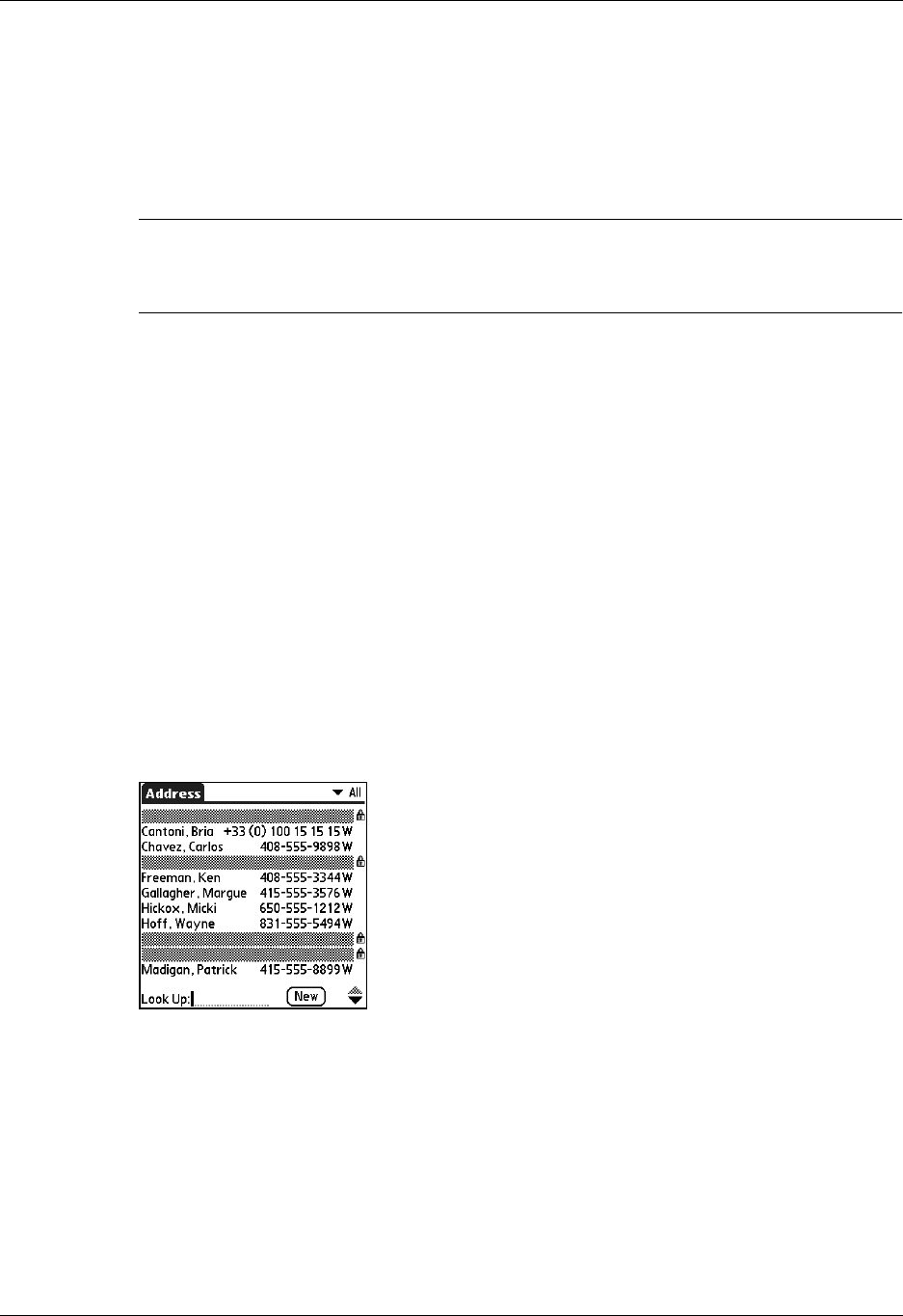
Chapter 17 Setting Preferences for Your Handheld
198
Recovering from a forgotten password
If you forget your password, your handheld will display the password hint, if you
entered one, to help you remember the password. If you are still unable to
remember the password, you can delete it from your handheld. Deleting a
forgotten password also deletes all entries and files marked as Private.
IMPORTANT If you synchronize with your computer before deleting a forgotten
password, your handheld restores your private entries the next time you perform a
HotSync operation, but it does not restore the password.
To delete a forgotten password:
1. From the General Preferences screen, select Security.
2. Tap the Password box.
3. Tap Lost Password.
4. Tap Yes.
Making records private
In many applications, you can make individual records private. Private records
remain visible and accessible, however, until you select the Security setting to hide
or mask all private records. Masked records appear as gray placeholders in the
same position in which they would appear if they were not masked, and are
marked with a lock icon. Hidden records disappear completely from the screen. If
you define a password for your handheld, you must enter it to display private
records.
Palm, Inc. Confidential
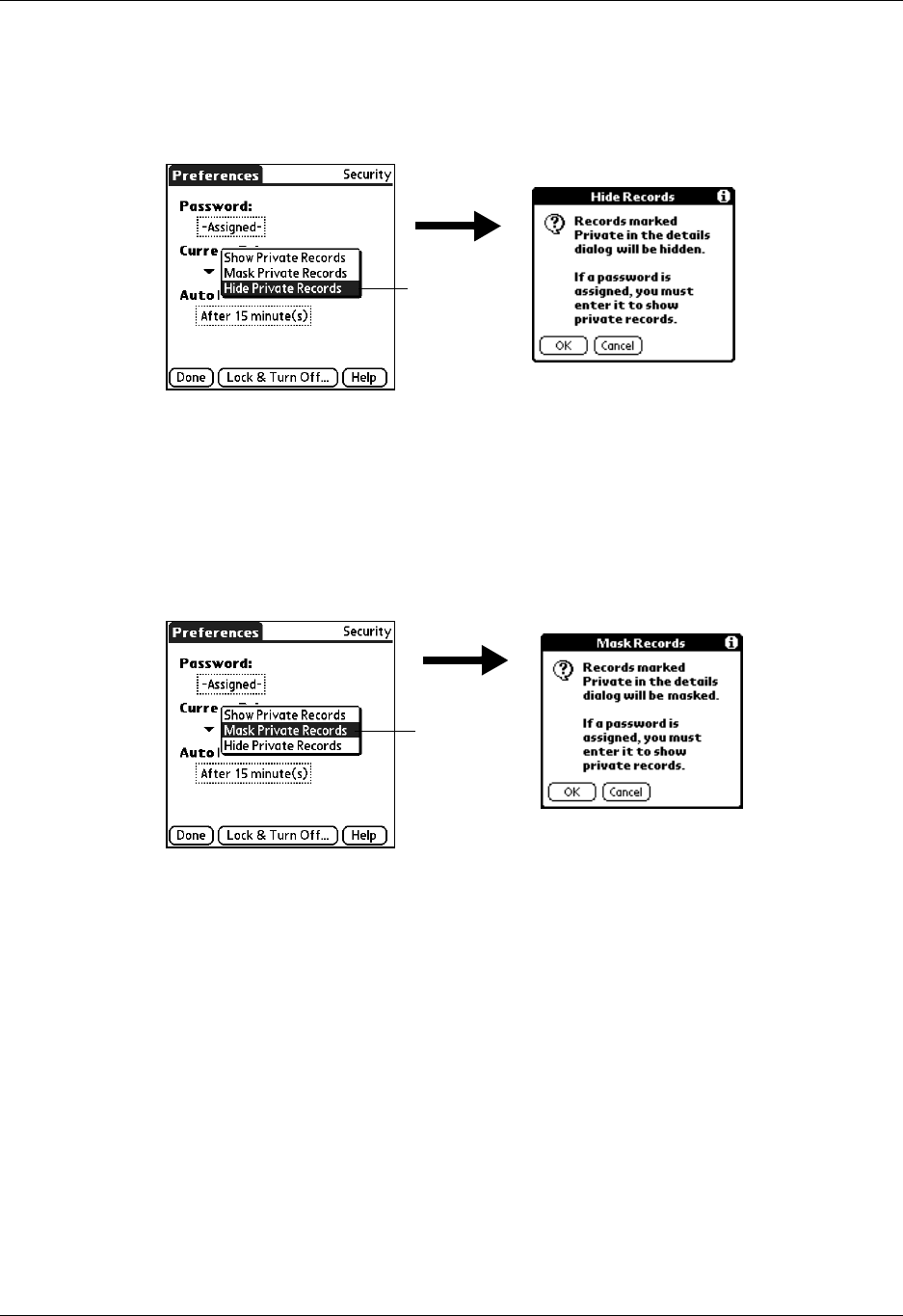
Setting General Preferences
199
To hide all private records:
1. From the General Preferences screen, select Security.
2. Tap the Current Privacy pick list and select Hide Private Records.
.
3. Tap OK to confirm that you want to hide private records.
4. Tap Don e.
To mask all private records:
1. From the General Preferences screen, select Security.
2. Tap the Current Privacy pick list and select Mask Private Records.
3. Tap OK to confirm that you want to mask private records.
4. Tap Don e.
To display all private records:
1. From the General Preferences screen, select Security.
2. Tap the Current Privacy pick list and select Show Private Records.
If you do not have a password, hidden and masked records become visible.
If you have a password, the Show Private Records dialog box appears. Go to
step 3.
Tap Hide
Private
Records
Ta p M a s k
Private
Records
Palm, Inc. Confidential
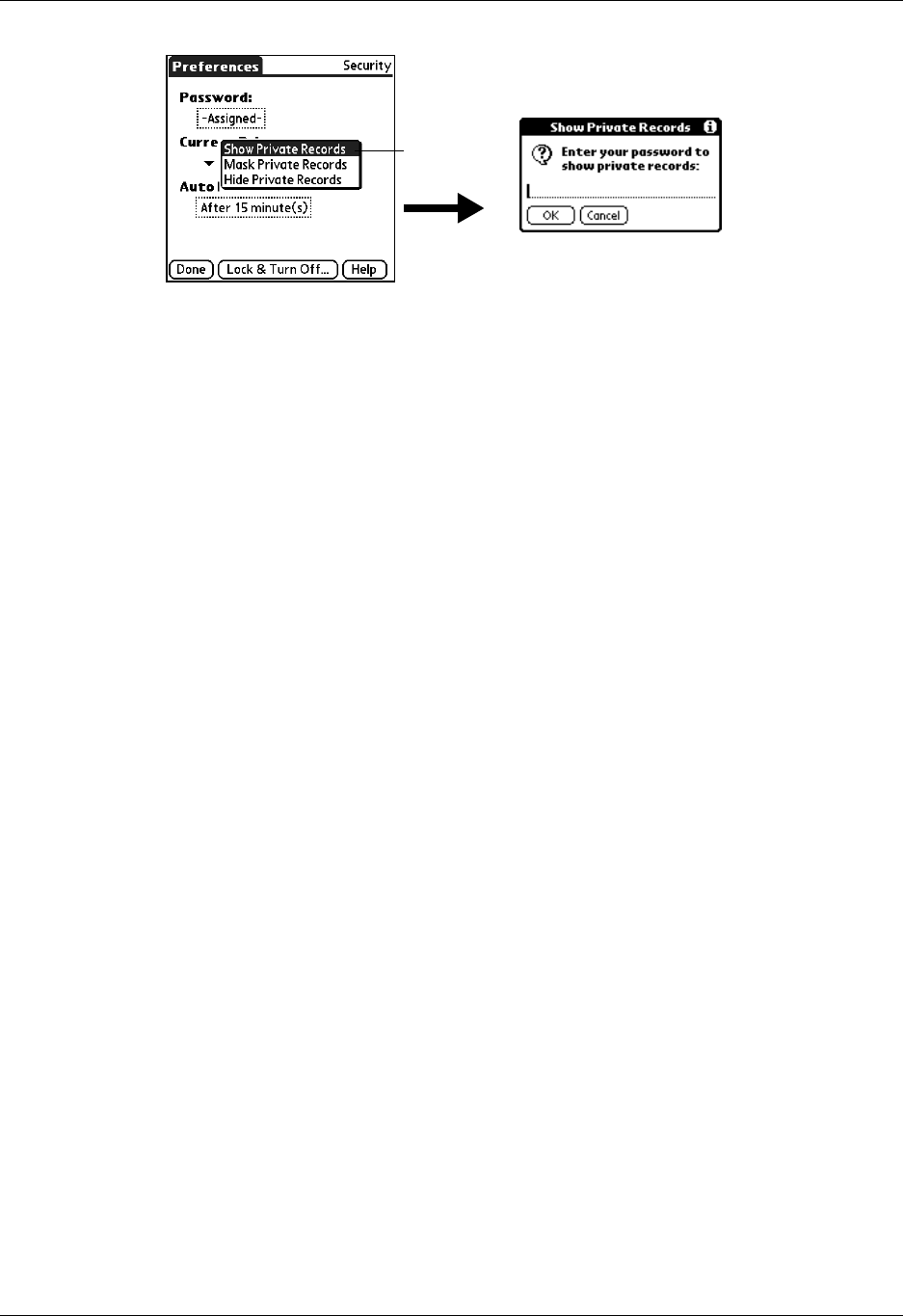
Chapter 17 Setting Preferences for Your Handheld
200
3. Enter your password, and then tap OK.
4. Tap Don e.
To unmask individual records:
1. Select a masked record.
If you do not have a password, a masked record becomes visible.
If you have a password, the Show Private Records dialog box appears. Go to
step 3.
2. Enter your password, and then tap OK.
To make a record private:
1. Display the entry that you want to make private.
2. Tap Details.
3. Tap the Private check box to select it.
4. Tap OK.
Sounds & Alerts Preferences
You can choose from three Sound & Alert profiles:
TIP When you connect a headset to your handheld, the external speaker is
automatically silenced, the Sounds & Alerts settings are maintained, and all volume
levels are automatically adjusted for use with a headset.
Tap Show
Private
Records
Custom Configure this profile with your own personal settings.
Silent Select this profile to use the vibrate and indicator light alerts
without sound.
All Off Select this profile to turn off all sounds and alerts.
Palm, Inc. Confidential
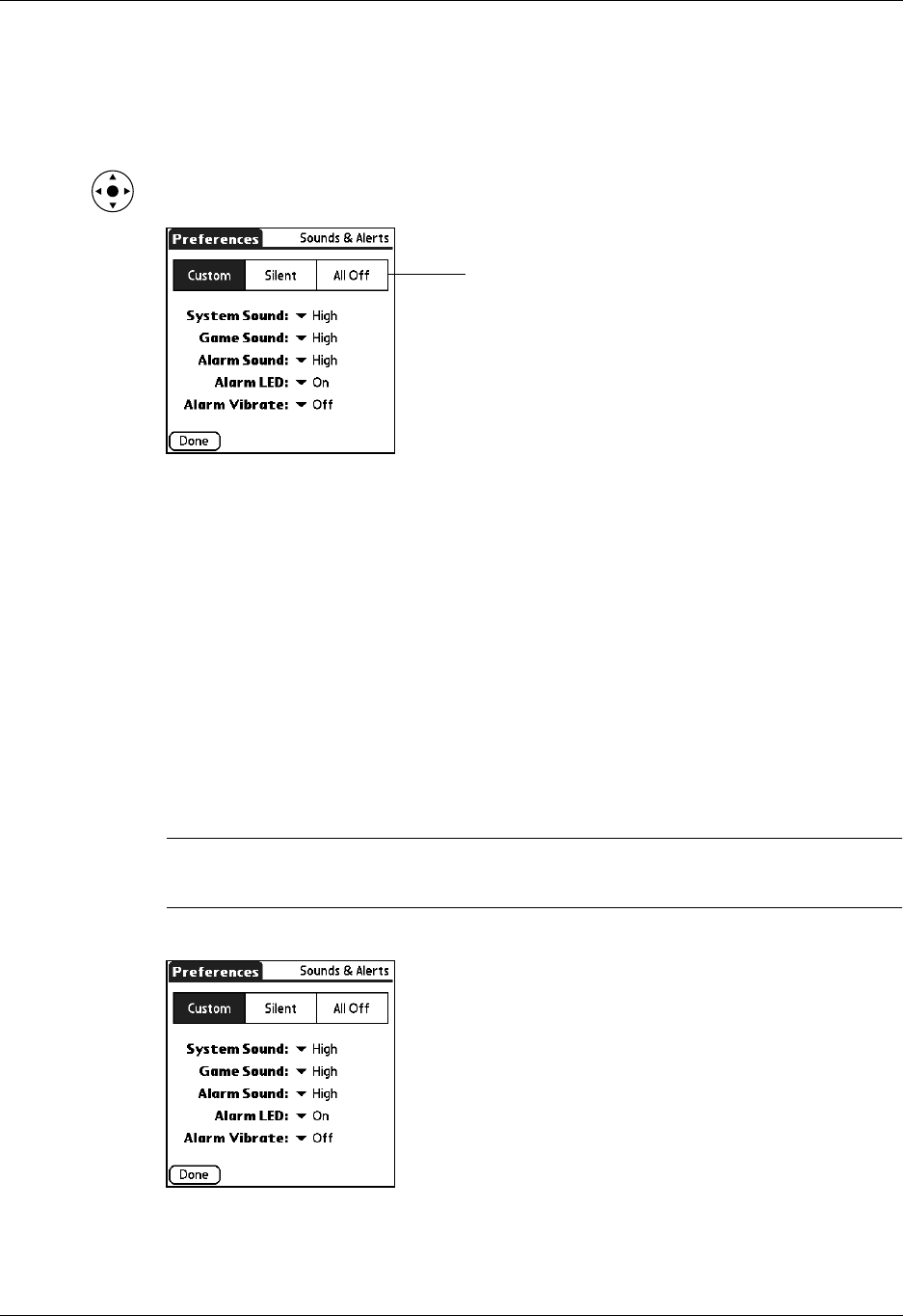
Setting General Preferences
201
To select a profile:
1. From the General Preferences screen, select Sound & Alerts.
2. Tap the Custom, Silent, or All Off profile box.
TIP You can also press Right or Left on the navigator to select a profile box.
3. Tap Don e.
System Sound, Game Sound, and Alarm Sound settings
Your handheld uses a variety of sounds. The System Sound, Game Sound, and
Alarm Sound settings enable you to turn the sounds on or off and to adjust the
volume level.
To set the sound settings:
1. From the General Preferences screen, select Sound & Alerts.
2. Tap Custom.
3. Tap the System Sound pick list and select the sound level.
IMPORTANT When you turn off the System Sounds, you also turn off the “chime”
tones associated with the HotSync operation.
Profile boxes
Palm, Inc. Confidential
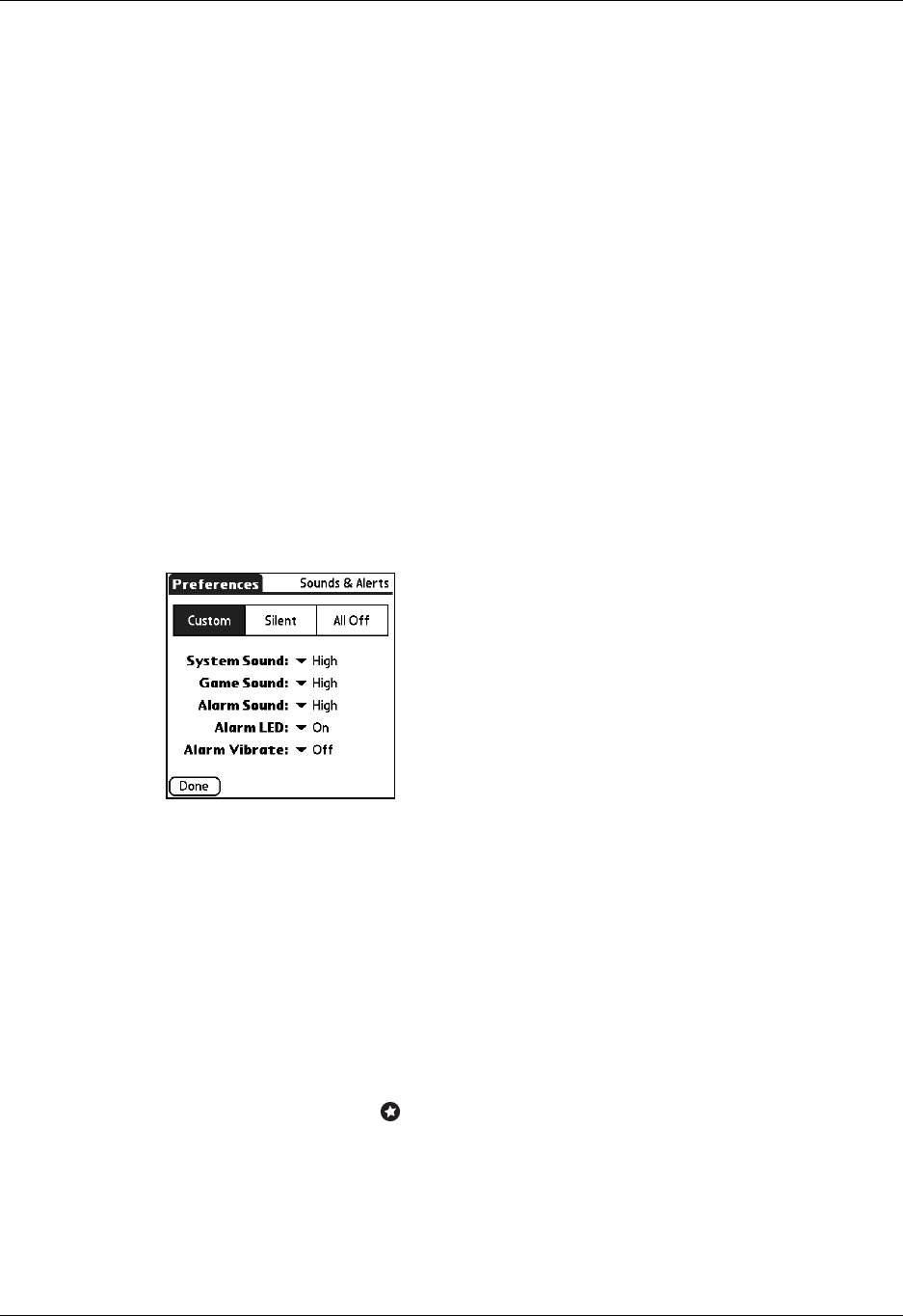
Chapter 17 Setting Preferences for Your Handheld
202
4. Tap the Game Sound pick list and select the sound level.
5. Tap the Alarm Sound pick list and select the sound level.
6. Tap Don e.
The Game Sound setting works only with games that are programmed to
respond to this setting. Older games typically do not respond to this setting.
Alarm LED and Alarm Vibrate settings
You can set alarms in Date Book, World Clock, Note Pad, and Voice Memo to
remind yourself of important meetings or notes. When you enable the Alarm
Vibrate and indicator light settings, your handheld vibrates and the indicator light
blinks to notify you of alarms. This is useful when you want to turn the Alarm
Sound off but still be notified by alarms.
To set the Alarm LED and Alarm Vibrate settings:
1. From the General Preferences screen, select Sound & Alerts.
2. Tap Custom.
3. Tap the Alarm LED pick list and select On or Off.
4. Tap the Alarm Vibrate pick list and select On or Off.
5. Tap Don e.
Setting Communication Preferences
The Communication Preferences category enables you to access screens where you
can modify Bluetooth, Connection, Network, and Phone settings. This section
provides details about each of these screens.
To open the Communication Preferences screens:
1. Tap the Favorites icon .
2. Tap Communication.
3. Select the name of the Preferences screen you want to view.
Palm, Inc. Confidential

Setting Communication Preferences
203
TIP You can also select the Preferences category by pressing Left and Right on
the navigator, and select a Preferences screen by pressing Up and Down on the
navigator.
Bluetooth Preferences
When another Bluetooth-enabled device is within 10 meters (approximately
30 feet) of your handheld, you can connect your handheld with Bluetooth-enabled
devices such as:
■Mobile phones
■Computers
■LAN access points
■Palm OS® handhelds
The Bluetooth Preferences screen enables you to configure settings that determine
how your handheld communicates with other Bluetooth-enabled devices. You can
turn Bluetooth communication on and off, assign a name to your handheld for
Bluetooth communication, and choose device discovery and wakeup settings.
Turning Bluetooth communication on and off
By default, the Bluetooth communication feature on your handheld is turned off.
The default setting is designed to conserve battery power. When Bluetooth
communication is off, you cannot communicate with other Bluetooth-enabled
devices. You must turn on Bluetooth communication to use any of the Bluetooth
communication features. Keep in mind that when Bluetooth communication is on,
your battery will drain more quickly than when Bluetooth communication is off.
Palm, Inc. Confidential
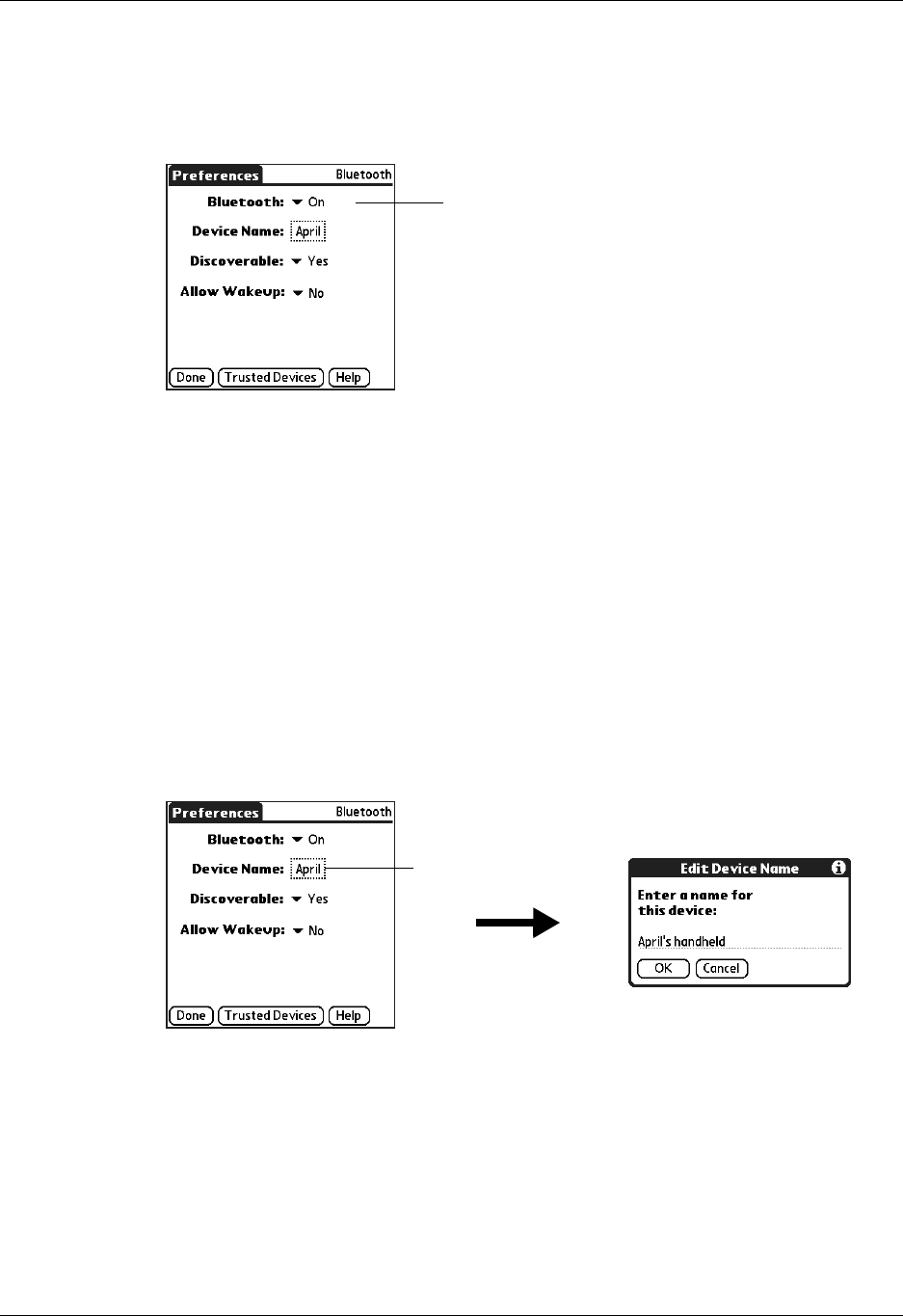
Chapter 17 Setting Preferences for Your Handheld
204
To turn on Bluetooth communication:
1. From the Communications Preferences screen, select Bluetooth.
2. Tap the Bluetooth pick list and select On.
3. Tap Don e.
Assigning a Bluetooth device name
The Bluetooth device name is similar to wearing a name tag. The name you assign
to your handheld identifies you to other Bluetooth devices. When other users
search for Bluetooth devices, your Bluetooth device name appears on their screen
as a discovered device. If you do not enter a device name, your handheld sends the
default name Palm OS handheld.
To assign a Bluetooth name to your handheld:
1. From the Communications Preferences screen, select Bluetooth.
2. Tap the Device Name box.
3. Enter a name for your device.
4. Tap OK.
5. Tap Don e.
Setting device discovery
Discovery is the process that Bluetooth devices use to find each other when they
are within range of each other. When you initiate the discovery process, you find
and select the devices with which you want to connect.
Bluetooth pick list
Device Name box
Palm, Inc. Confidential

Setting Communication Preferences
205
The discovery process is typically initiated by an application. For example, when
you connect your handheld with a mobile phone using the Phone Link application,
Phone Link discovers phones equipped with Bluetooth technology within range in
order to connect with one of those phones.
You can use the Discoverable and Bluetooth settings to achieve three discovery
states on your handheld. The following is a description of setting combinations
and the resulting discovery states.
■Bluetooth Off: When the Bluetooth setting is off, other users cannot discover
your handheld. This is similar to locking your door with a dead bolt, a security
chain, and disabling the door bell. When Bluetooth is off, you cannot access the
Discoverable setting. See “Turning Bluetooth communication on and off”
earlier in this chapter for instructions on turning Bluetooth communication on
and off.
■Bluetooth On and Discoverable No: When your handheld and Bluetooth are on
and the Discoverable setting is set to No, you can receive connections only from
devices with which you have previously formed a trusted pair. This is similar
to locking your door with a dead bolt and disabling the door bell, but any
friends who already have the key can enter. By default, the Discoverable setting
is enabled when Bluetooth is on.
■Bluetooth On and Discoverable Yes: When your handheld is on, Bluetooth is on,
and the Discoverable setting is set to Yes, you can receive connections from any
Bluetooth device. You are automatically connected with devices with which
you have previously formed a trusted pair, but you can refuse invitations to
connect with unrecognized devices. This is similar to locking your front door
with a dead bolt and enabling the door bell. Friends who already have the key
can enter freely, and if someone without a key rings the bell to request a
connection, you can choose to open the door or ignore the request.
To disable discovery:
1. From the Communications Preferences screen, select Bluetooth.
2. Tap the Discoverable pick list and select No.
3. Tap Don e.
Discoverable pick list
Palm, Inc. Confidential
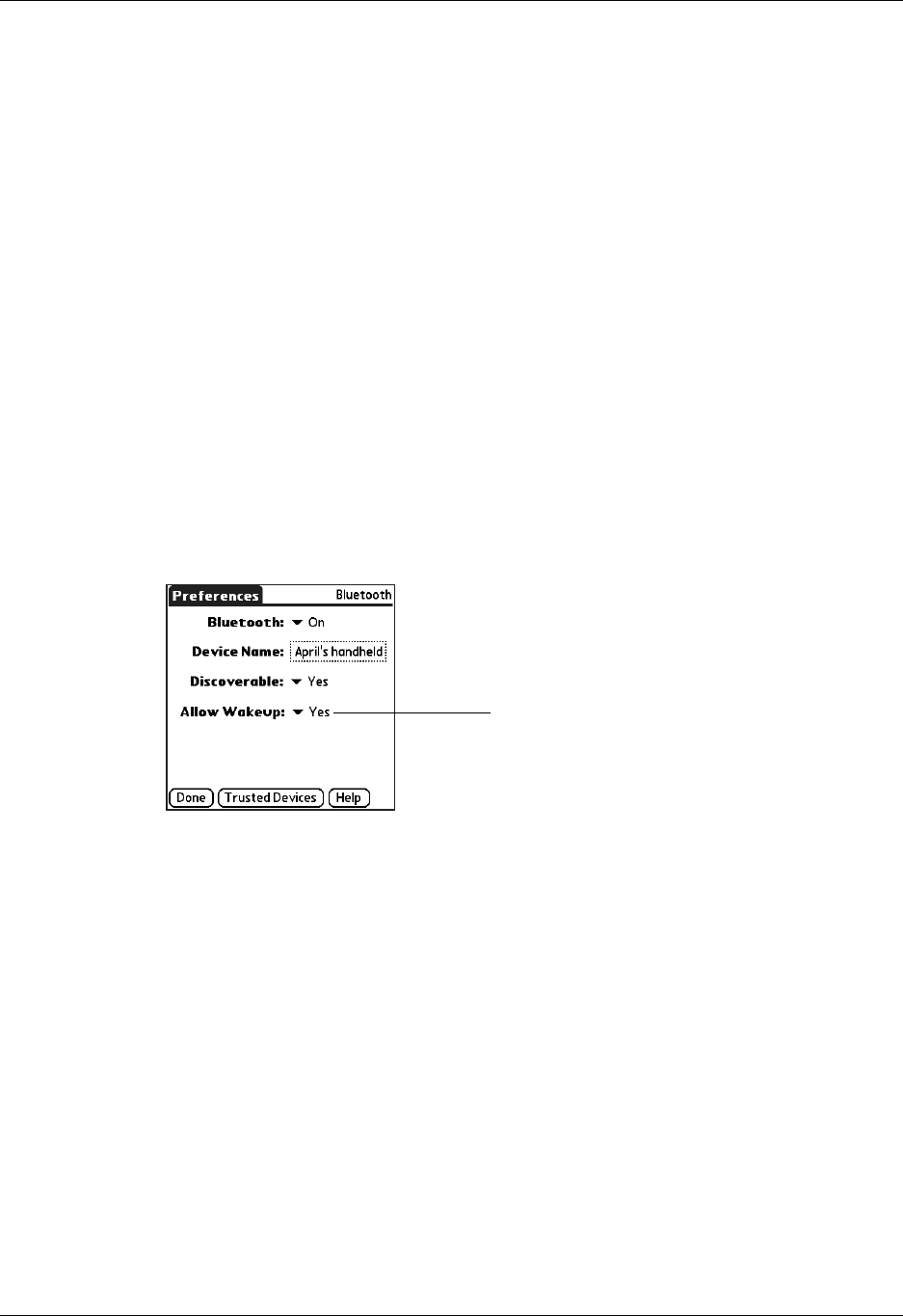
Chapter 17 Setting Preferences for Your Handheld
206
Allowing Wakeup
When your handheld is off, the Allow Wakeup setting determines whether your
handheld wakes up when you receive a connection request from another
Bluetooth device that knows your device name. When this setting is enabled, you
can receive requested information when your handheld is off, and then review it
later. You can allow wakeup at any time, during specific hours of the day, or not
at all. By default, your handheld is set to not wake up.
For another Bluetooth-enabled device or application to wake up your handheld,
the application must “remember” your device name. The BlueBoard and BlueChat
applications on the Software Essentials CD-ROM can remember device names;
however, Address Book, Memo Pad, Note Pad, and To Do List cannot remember
device names and therefore cannot wake up another handheld.
NOTE Enabling the Allow Wakeup setting uses battery power even when your
handheld is turned off. Be sure to monitor your battery level.
To enable wakeup:
1. From the Communications Preferences screen, select Bluetooth.
2. Tap the Allow Wakeup pick list and select Yes.
3. Tap Don e.
To enable wakeup during specific hours:
1. From the Communications Preferences screen, select Bluetooth.
2. Tap the Allow Wakeup pick list.
Allow Wakeup
pick list
Palm, Inc. Confidential
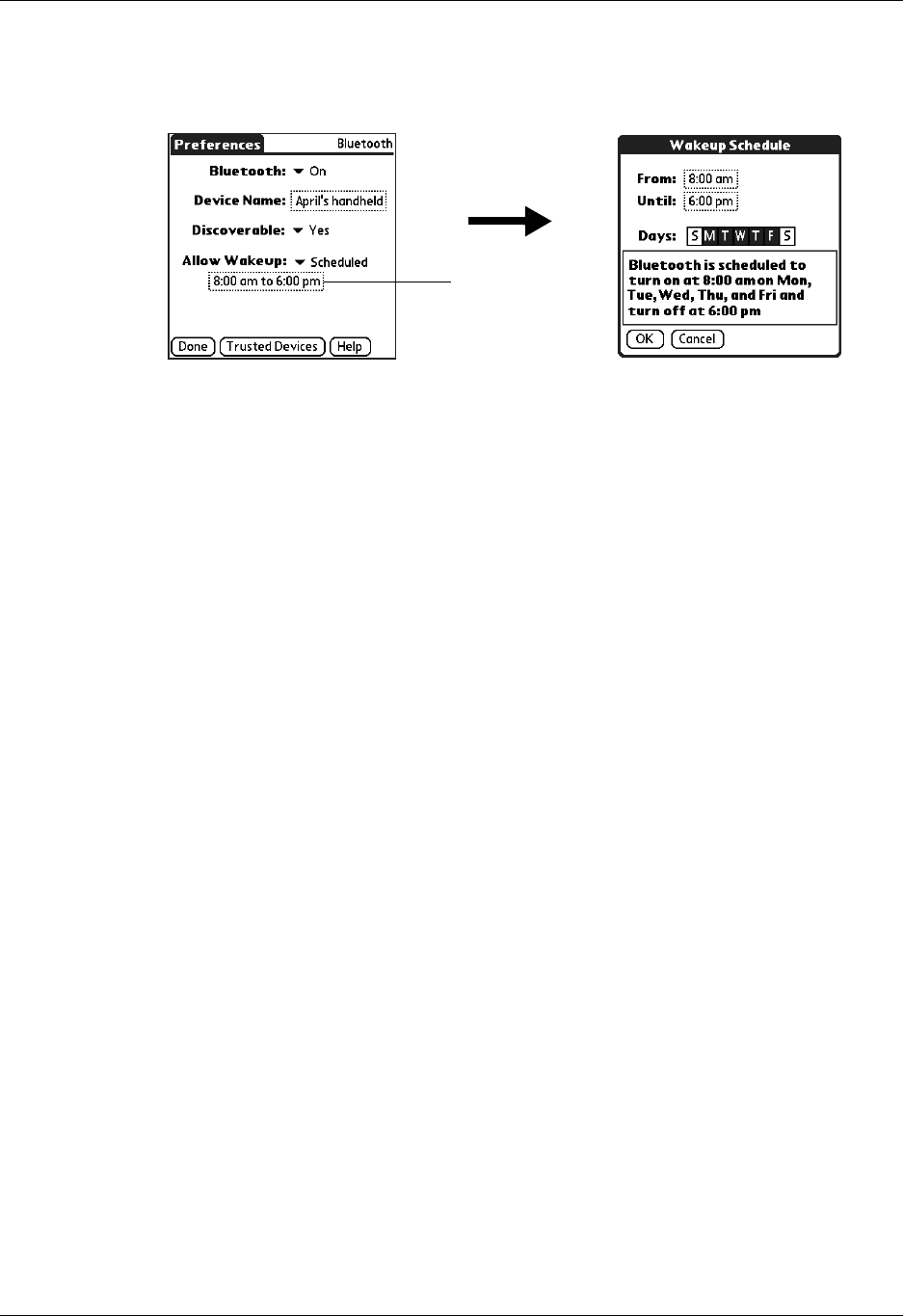
Setting Communication Preferences
207
3. Select Scheduled.
4. Tap the hours box.
5. Tap the From box, select the start time, and then tap OK.
6. Tap the Until box, select the end time, and then tap OK.
7. Tap the Days boxes to select the days when you want the wakeup feature to be
active.
8. Tap OK.
9. Tap Don e.
Adding trusted devices
When you create a trusted pair, you enter an identical secret code on both devices.
This secret code is called a passkey. The passkey enables you to create a list of
Bluetooth devices from which you automatically accept communication. If a
device with a recognized passkey attempts to communicate with your handheld,
it bypasses the discovery and authentication process and automatically accepts the
communication. If a device without a recognized passkey attempts to
communicate with your handheld, it goes through the discovery and
authentication process, and you can choose to accept or reject the communication.
To add a trusted device:
1. From the Communications Preferences screen, select Bluetooth.
2. Tap Trusted Devices.
3. Tap Add Device.
Hours box
Palm, Inc. Confidential
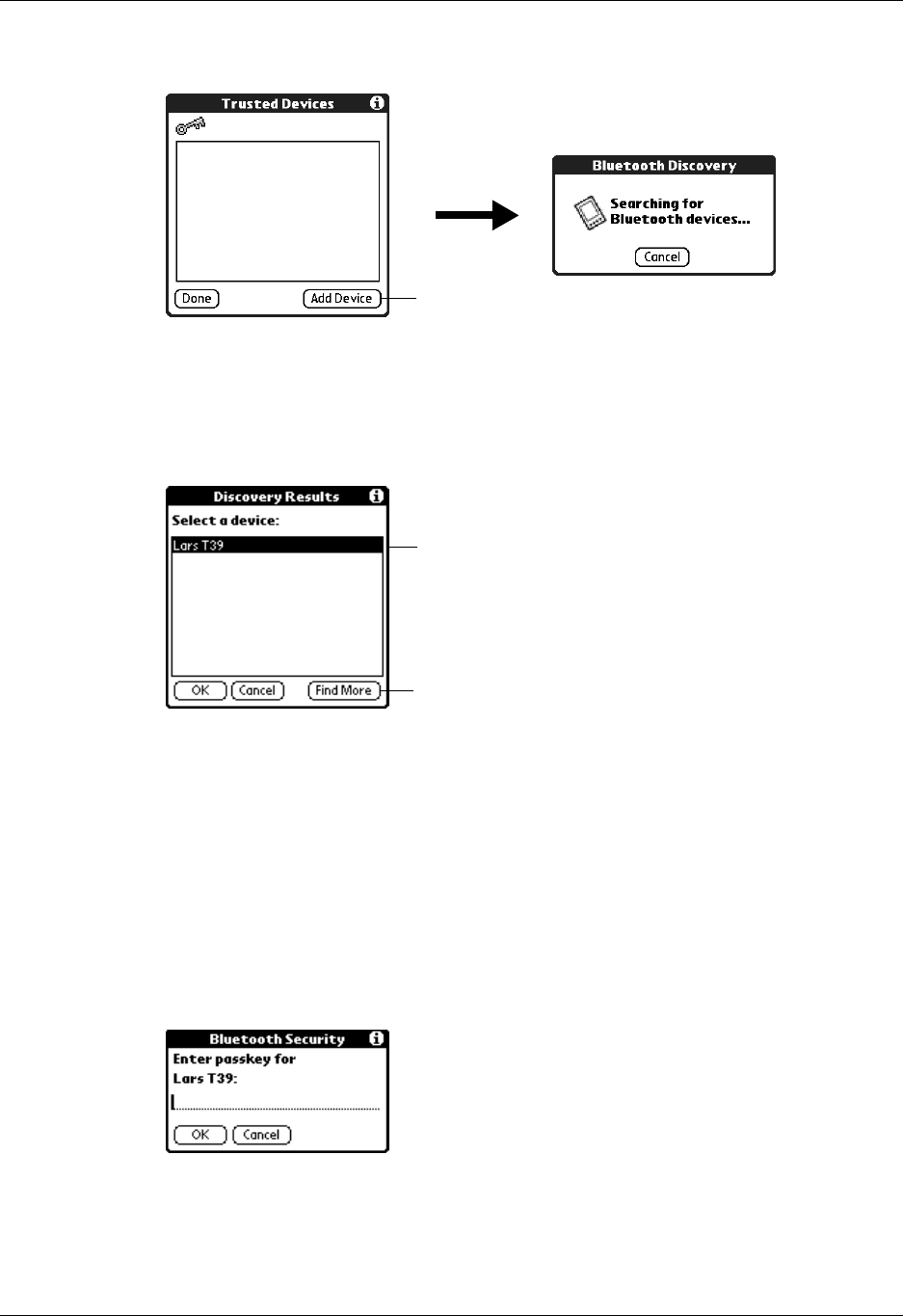
Chapter 17 Setting Preferences for Your Handheld
208
The discovery process begins, and the discovery screens appear.
4. When the Discovery Results screen appears, select the device you want to add
as a trusted device.
If the device you want to add as a trusted device does not appear on the
discovery results list, tap Find More.
5. Tap OK.
6. Enter the same passkey on your handheld and the trusted device.
Some Bluetooth devices have a built-in passkey; others enable you to choose the
passkey; see the documentation included with your Bluetooth device for
information. In either case you must use the same passkey for both the device
and your handheld.
Many phones also require you to put the phone into a mode where it can accept
a key exchange for bonding in a trusted pair. See the documentation included
with your phone for information.
7. Tap OK.
8. Tap Done to return to the Bluetooth Preferences screen.
9. Tap Done again.
Tap here
Tap device to add it as a trusted device
Tap Find More to discover additional
devices
Palm, Inc. Confidential
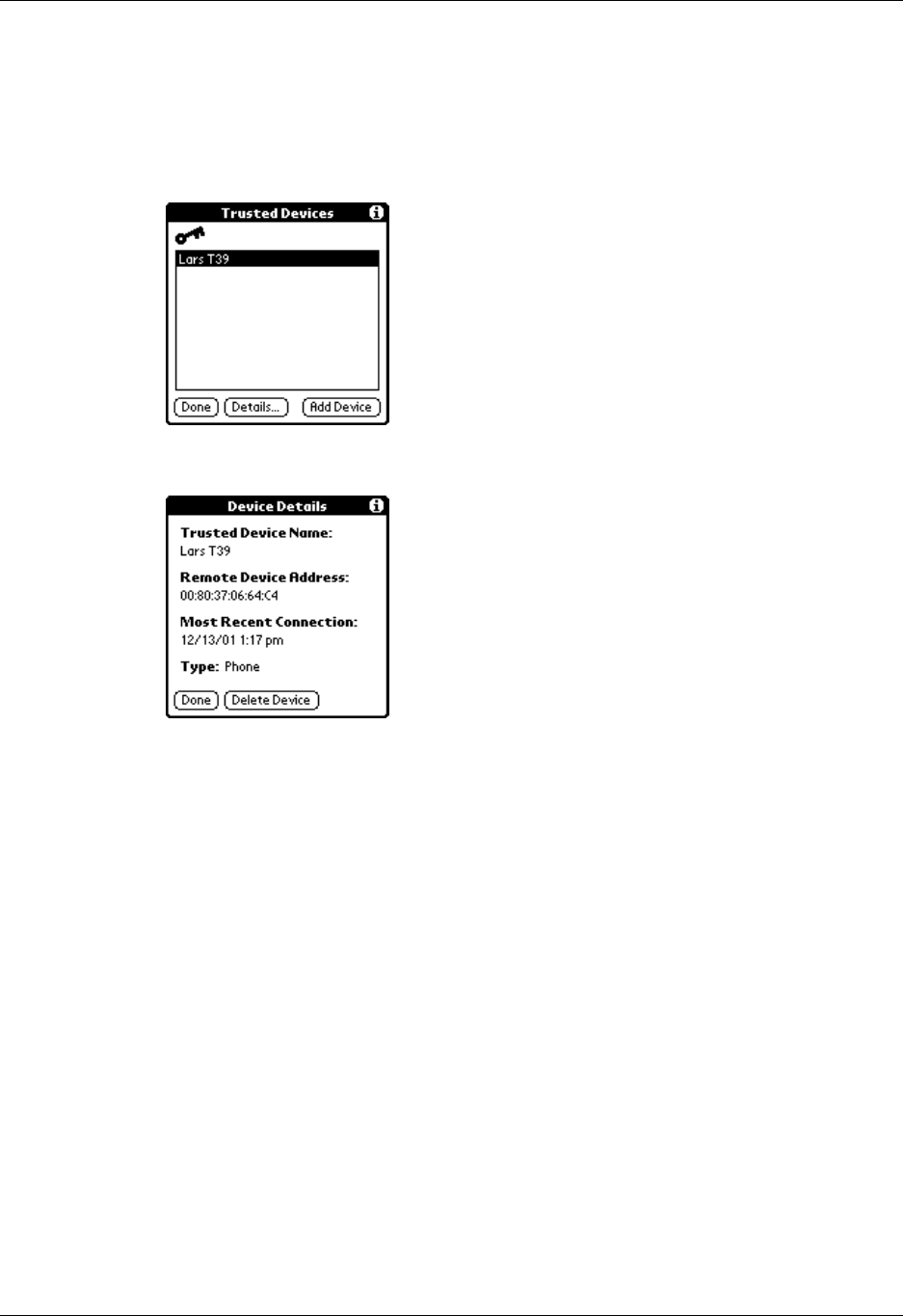
Setting Communication Preferences
209
To view details about a trusted device:
1. From the Communications Preferences screen, select Bluetooth.
2. Tap Trusted Devices.
3. Select the device you want to view.
4. Tap Details.
5. Tap Done to return to the Trusted Devices screen.
6. Tap Done again to return to the Bluetooth Preferences screen.
7. Tap Done again.
To delete a trusted device:
1. From the Communications Preferences screen, select Bluetooth.
2. Tap Trusted Devices.
3. Select the device you want to delete.
Palm, Inc. Confidential
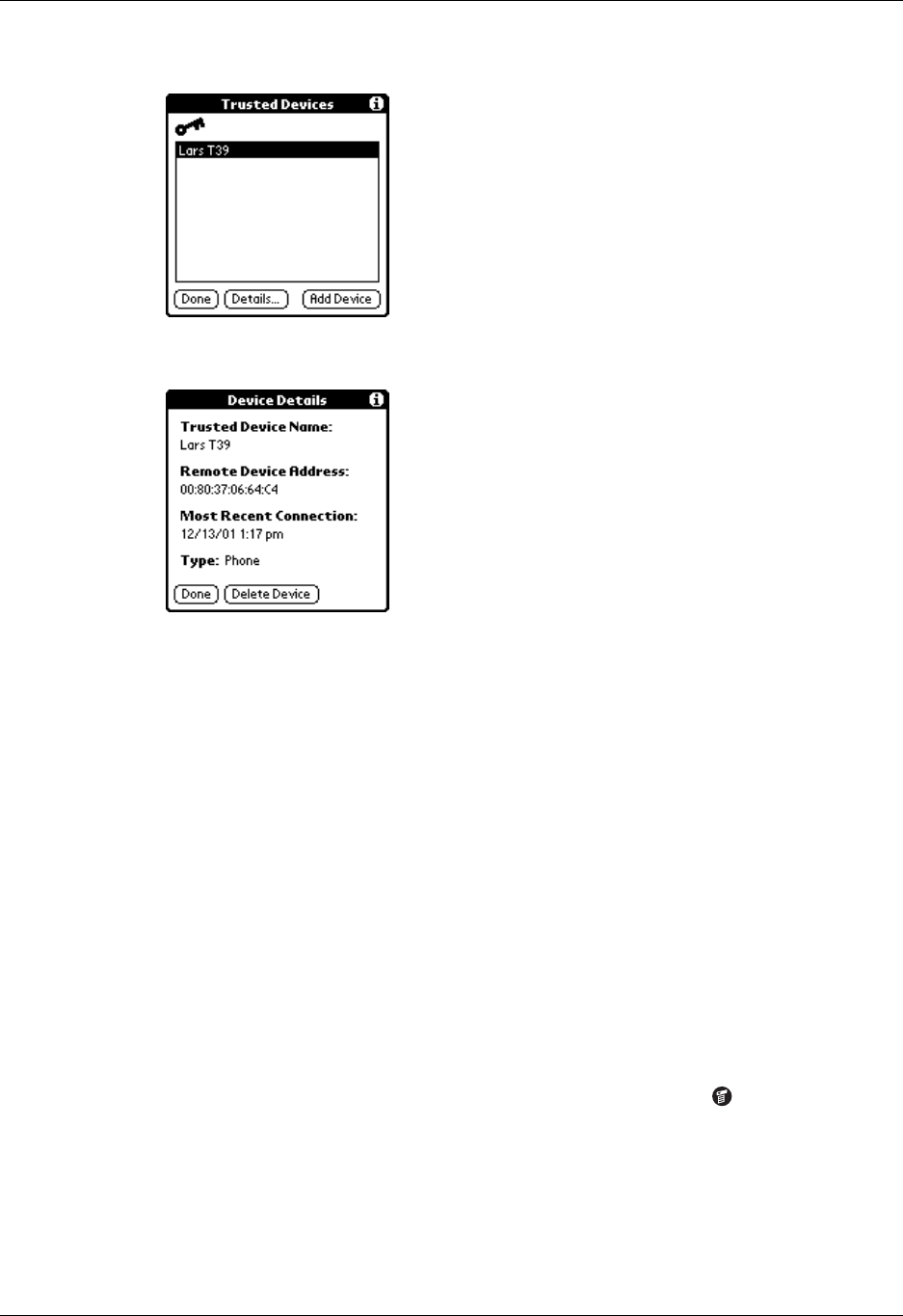
Chapter 17 Setting Preferences for Your Handheld
210
4. Tap Details.
5. Tap Delete Device.
6. Tap OK.
7. Tap Done to return to the Bluetooth Preferences screen.
8. Tap Done again.
Enabling/disabling the user cache
When you enable or disable the user cache you control whether or not your
handheld retrieves the names of remote devices each time the discovery process
takes place. By default, the user cache is enabled. This means that the names of
devices found during one round of discovery are stored in your handheld’s user
cache. The next time your handheld discovers a device that is listed in the user
cache, the device name appears very quickly.
Using cached names saves time, because it eliminates the extra step of retrieving a
name remotely. Disabling this feature is useful only if the name of a remote device
has changed, because it forces your handheld to retrieve the new device name.
To disable the user cache:
1. From the Bluetooth Preferences screen, tap the Menu icon .
2. Select Disable device name cache from the Options menu.
Palm, Inc. Confidential

Setting Communication Preferences
211
Making Bluetooth connections
There are several ways you can make Bluetooth connections. The method you use
determines the types of devices your handheld can discover. The following
methods enable you to discover the types of Bluetooth devices that are within
range:
■Using an Internet application: Access the Internet using the Palm Web Browser
Pro and the Palm WAP Browser applications included on the Software
Essentials CD-ROM. See “Accessing the Internet with a Bluetooth phone or
LAN access point” later in this chapter and the Palm Web Browser Pro Handbook
and the Palm WAP Browser Handbook on the Software Essentials CD-ROM for
details.
■Using the Send command: Connect to a Palm OS handheld or a computer to
exchange data or applications. See “Sending data” in Chapter 3 for details on
using this method.
■Using HotSync Manager software: Connect to your computer to synchronize
data with your handheld. See “Conducting Bluetooth HotSync operations” in
Chapter 16 for details.
■Using a collaborative application: Connect to a Palm OS handheld using
applications such as BlueBoard and BlueChat included on the Software
Essentials CD-ROM. See the BlueBoard 2.0 Handbook and the BlueChat 2.0
Handbook on the Software Essentials CD-ROM to learn more about these
applications. Other third-party applications may be available. Visit
www.palm.com for information about downloading third-party applications,
and refer to the documentation that comes with these applications for details on
using them.
Connection Preferences
The Connection Preferences screen enables you to define the settings used to
connect your handheld to other devices. The screen displays a list of available
configurations that are ready to be further defined; the list varies depending on the
kind of software you’ve added to your handheld.
For example, a modem connection appears on the list. If you have this modem, you
need only to specify the phone setup (and network connection, if required) to
complete the configuration.
Palm, Inc. Confidential
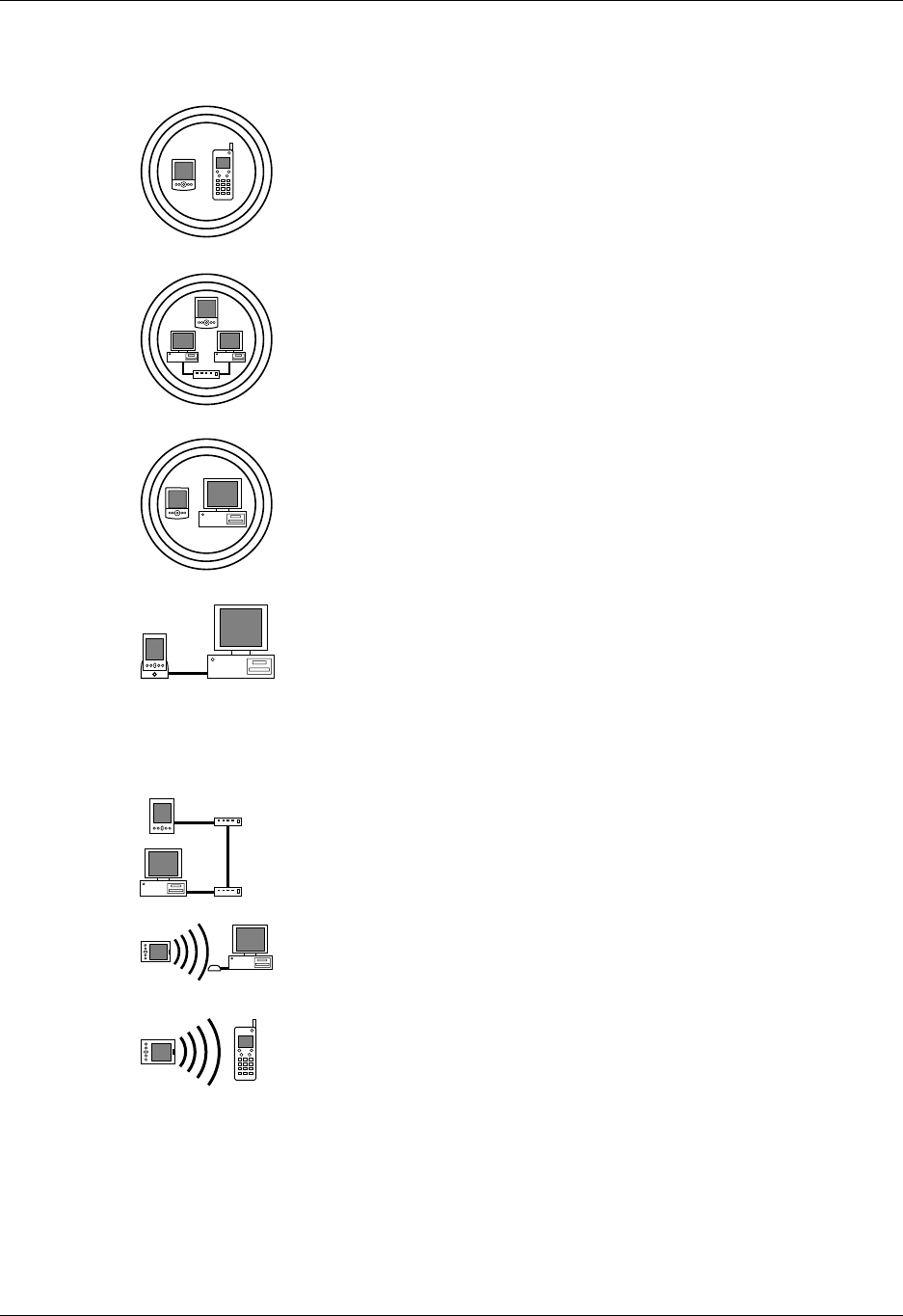
Chapter 17 Setting Preferences for Your Handheld
212
You can also create custom configurations, which include the following:
Phone to Bluetooth: A connection between your handheld and
a Bluetooth-enabled phone.
LAN to Bluetooth: A connection between your handheld and a
Bluetooth-enabled Local Area Network.
PC to Bluetooth: A connection between your handheld and a
Bluetooth-enabled computer or laptop.
PC to Cradle/Cable: A local HotSync connection—the direct
connection between your handheld and your desktop
computer. Your handheld is connected by its universal
connector to the cradle/cable, and the cradle/cable is attached
to a USB port of your desktop computer. (If you are using the
optional serial cradle/cable, the cradle attaches to a serial
[COM] port of your computer.)
Modem to Universal connector: A cable connection between
your handheld’s universal connector and a modem for dialing
in to a modem that is part of your computer or laptop.
PC to Infrared: A connection between the IR port of your
handheld and the infrared device of your computer or laptop.
Modem to Infrared: A connection between the IR port of your
handheld and a modem. The modem can be attached to or
within a mobile phone or other device containing an IR port.
(Some IR phones contain modems.)
Palm, Inc. Confidential
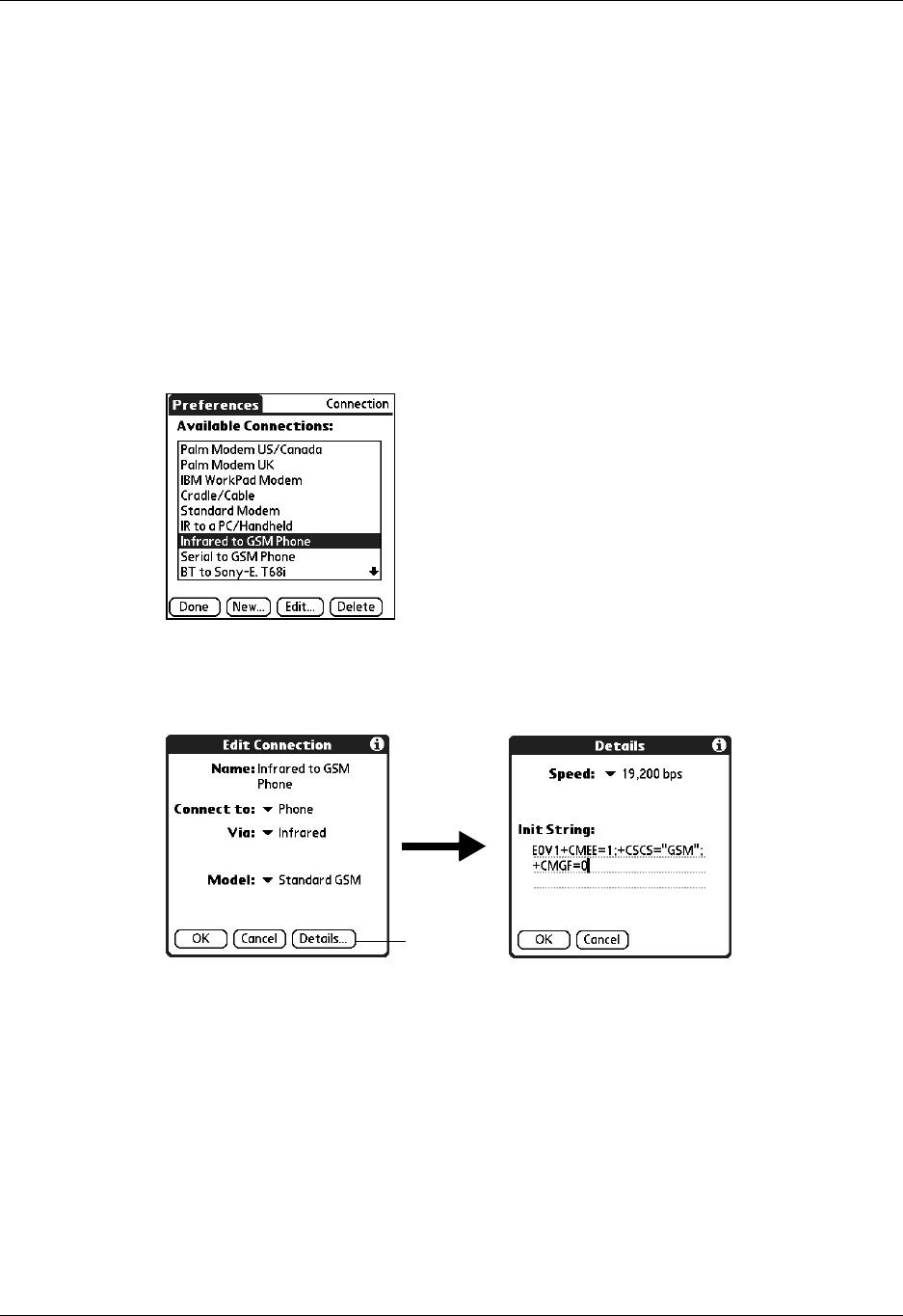
Setting Communication Preferences
213
Editing connections
The following example shows you how to edit the IR to GSM Phone connection to
adjust the communication speed; you can similarly edit other connections or
settings or create a custom connection. You can use the IR to GSM Phone
connection to perform a remote IR HotSync operation. To accomplish the HotSync
operation, your handheld sends data through its IR port to a modem within your
mobile phone, which then dials a modem attached to or within your desktop
computer, to synchronize with your Desktop application.
To edit the IR to Phone connection:
1. From the Communications Preferences screen, select Connection.
2. Select the IR to GSM Phone connection.
3. Tap Edit.
4. Tap Details.
5. Tap the Speed pick list and select the appropriate speed.
6. Enter the initialization string supplied by the documentation for the modem in
your mobile phone, if necessary.
7. Tap OK.
8. Tap OK again to save the configuration.
After you create the configuration, you need to set up the HotSync Manager of
your Desktop application and the HotSync application of your handheld to
perform a modem HotSync operation.
Ta p h e r e
Palm, Inc. Confidential
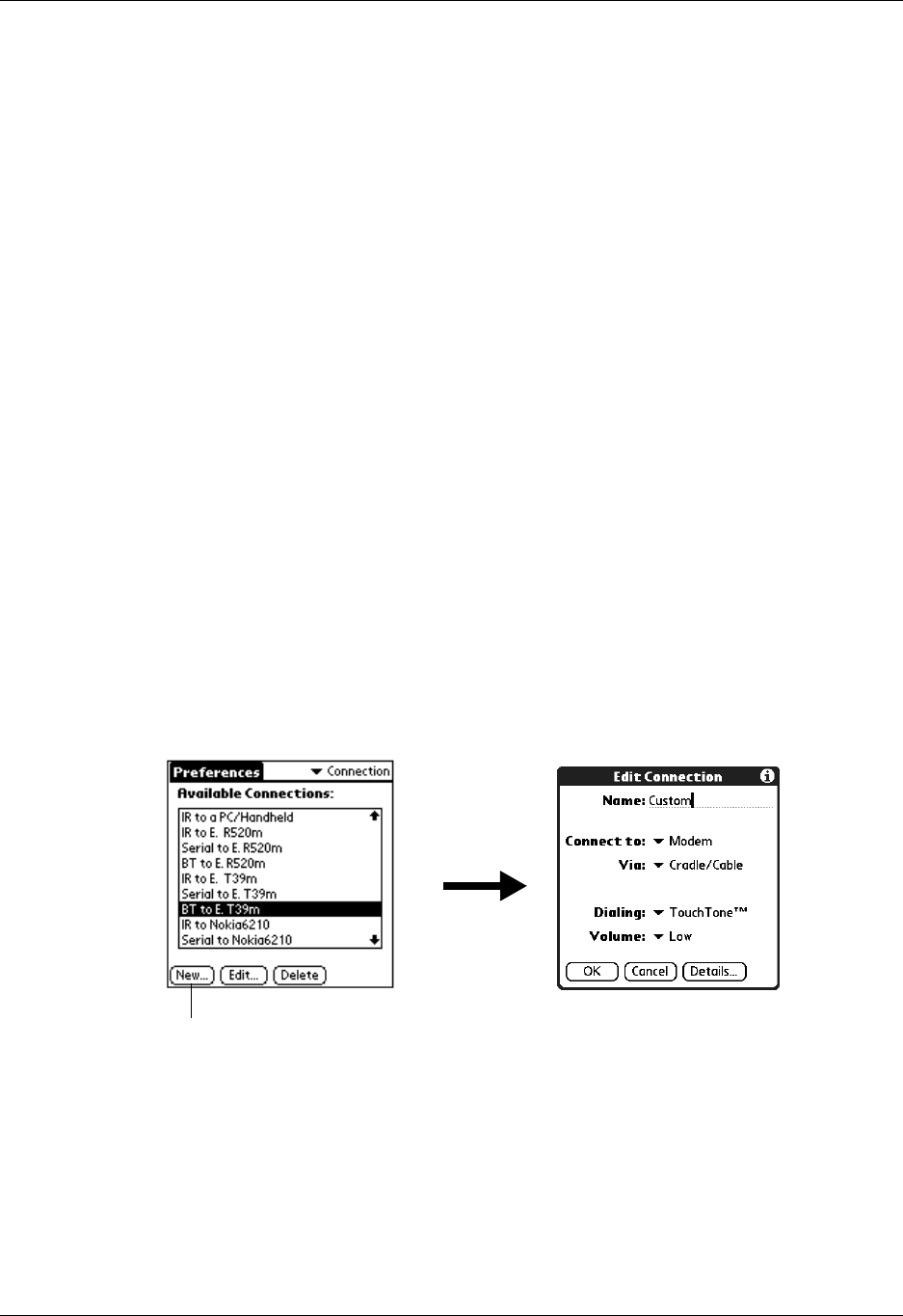
Chapter 17 Setting Preferences for Your Handheld
214
Creating Bluetooth connections
You can use the Connection Preferences screen to create connections to the
following types of Bluetooth-enabled devices:
■GSM mobile phones (See “Connecting to non-GSM phones” later in this chapter
for information on connecting to other mobile phones.)
■Computers
■LAN access points
■High-speed wireless data networks [such as a General Packet Radio Service
(GPRS) network]
High-speed wireless data networks provide an “always on” network connectivity
and high-speed wireless data transmission. To connect to a high-speed wireless
data network, you must have a GSM mobile phone, the correct driver for your
phone, a subscription to high-speed wireless data network services with your
mobile phone carrier, and the correct high-speed wireless data network settings
for your carrier.
TIP You can also create a connection with a GSM phone using the Phone Link
application. We recommend using Phone Link to create phone connections. See
Chapter 12 for details. Use the steps described in these sections only if you are unable
to create a connection with Phone Link.
To create a Bluetooth to LAN connection:
1. From the Communications Preferences screen, select Connection.
2. Tap N ew.
3. Enter a name for the connection, such as BT to LAN.
4. Tap the Connect to pick list and select Local Network.
5. Tap the Via pick list and select Bluetooth.
6. Make sure the network access point is ready to accept a Bluetooth connection.
Tap here
Palm, Inc. Confidential
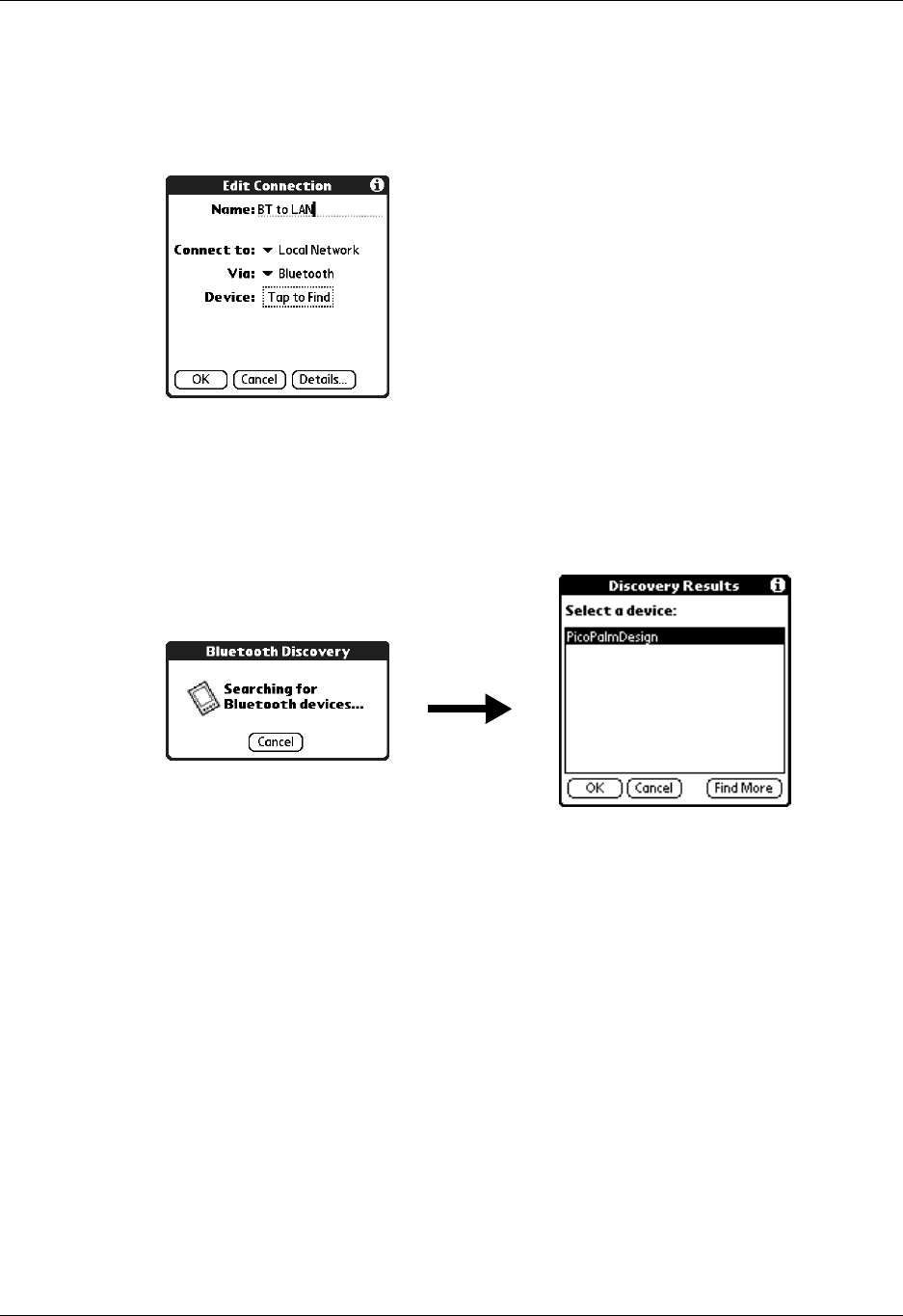
Setting Communication Preferences
215
NOTE See the documentation included with the network access point device
for information on how to prepare it to accept a Bluetooth connection. The
documentation might refer to a Bluetooth connection as a Bluetooth pairing or
a Bluetooth link.
7. Tap the Device box.
The discovery process begins, and the discovery screen appears.
8. When the Discovery Results screen appears, select the device to which you
want to connect.
If the device to which you want to connect does not appear on the discovery
results list, tap Find More.
9. Tap OK.
If prompted, create a trusted pair with the device. See “Adding trusted devices”
earlier in this chapter for details.
Connecting to non-GSM phones
If you have a non-GSM phone enabled with Bluetooth technology, you can connect
with the phone from your handheld to access the Internet and use Internet-based
applications such as e-mail or a web browser. To access the Internet and use
Internet-based applications, you must subscribe to data services from your mobile
phone carrier and must also have an Internet access account. These services are not
included with your handheld.
Palm, Inc. Confidential
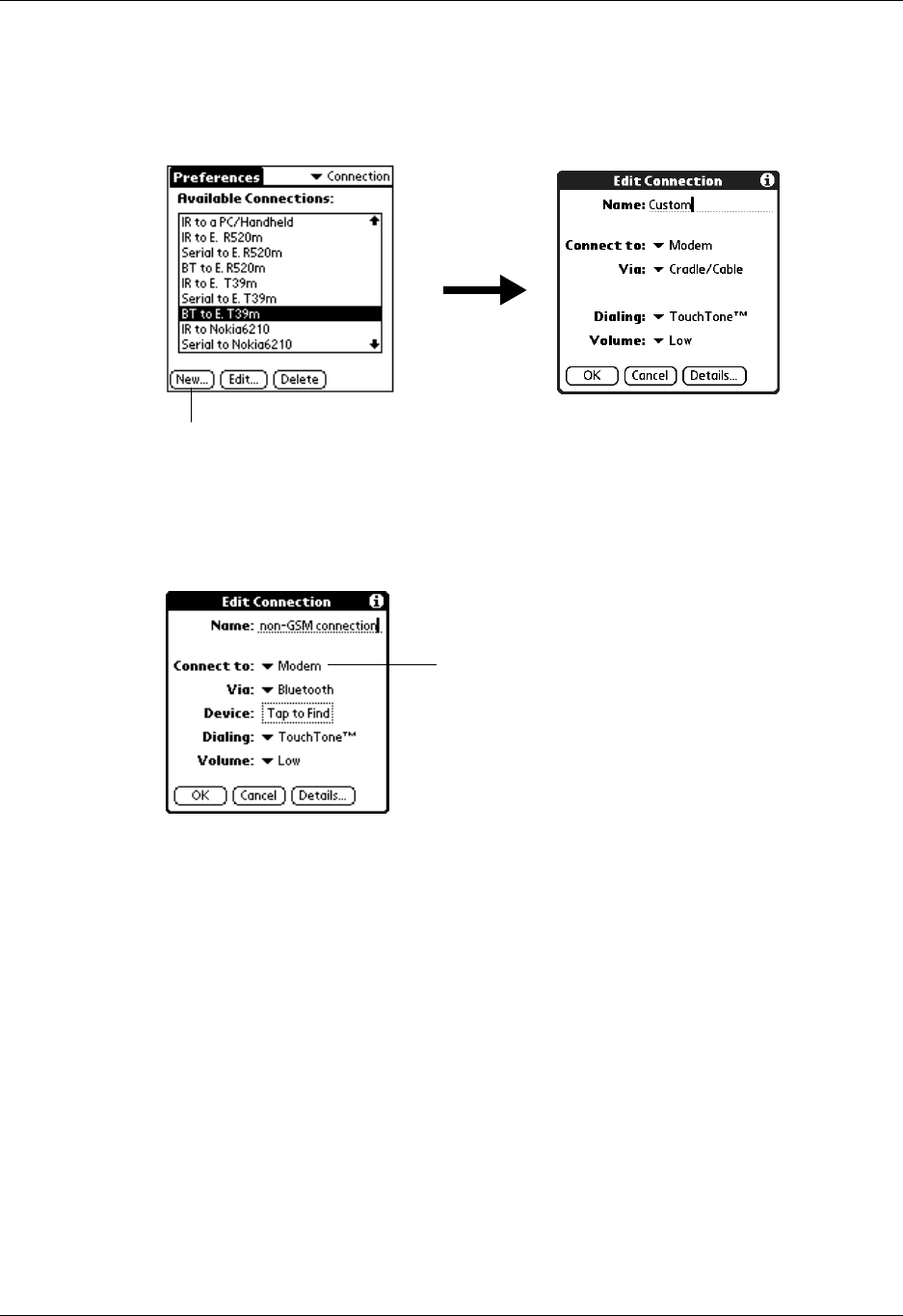
Chapter 17 Setting Preferences for Your Handheld
216
To create a connection with a non-GSM phone:
1. From the Communications Preferences screen, select Connection.
2. Tap N ew.
3. Enter a name for the connection.
4. Tap the Connect to pick list and select Modem.
5. Tap the Via pick list and select Bluetooth.
6. Prepare your phone to accept a Bluetooth connection.
NOTE See the documentation that was included with your phone for how to
prepare your phone to accept a Bluetooth connection. The documentation
might refer to a Bluetooth connection as a Bluetooth pairing or a Bluetooth link.
7. Tap the Device box.
The discovery process begins, and the discovery screen appears.
Tap here
You must select Modem rather than Phone
in the Connect to field to connect with a
non-GSM phone
Palm, Inc. Confidential

Setting Communication Preferences
217
8. When the Discovery Results screen appears, select the phone with which you
want to connect, and then tap OK.
9. Create a trusted pair with the phone. See “Adding trusted devices” earlier in
this chapter for details.
Network preferences
You can use your handheld’s Bluetooth technology and the software that is
included in the handheld operating system to connect with Internet service
providers (ISPs) or dial-in (remote access) servers using a mobile phone or optional
modem accessory. Your mobile phone must be equipped with one of the
following: an IR port, Bluetooth technology, or a serial cable that connects to your
handheld’s universal connector. You also need an ISP account or corporate remote
access account and a mobile phone carrier account that supports dial-up
connections, or a mobile phone carrier account with high-speed wireless data
network services.
You can also use your handheld’s Bluetooth technology and the software that is
included in the handheld operating system to connect with a LAN access point
To use the e-mail or web browser software included with your handheld, you must
create a configuration in Connection Preferences and then create Network
Preferences settings. See “Connection Preferences” earlier in this chapter for a
complete explanation of how to define Connection configurations that enable your
handheld to communicate with remote devices.
After you configure both the Connection and Network Preferences, you can
establish a PPP (Point-to-Point Protocol) connection with your ISP or dial-in
server. You can do this either by using menu commands from the Network
Preferences screen or by using a third-party application.
NOTE The Network Preferences settings give you the ability to connect to your ISP
or dial-in server with applications that support viewing the transmitted data. Visit the
web site www.palm.com for information on third-party applications that take
advantage of TCP/IP.
Tap here to select the phone with which you
want to connect
Tap Find More to discover additional phones
Palm, Inc. Confidential
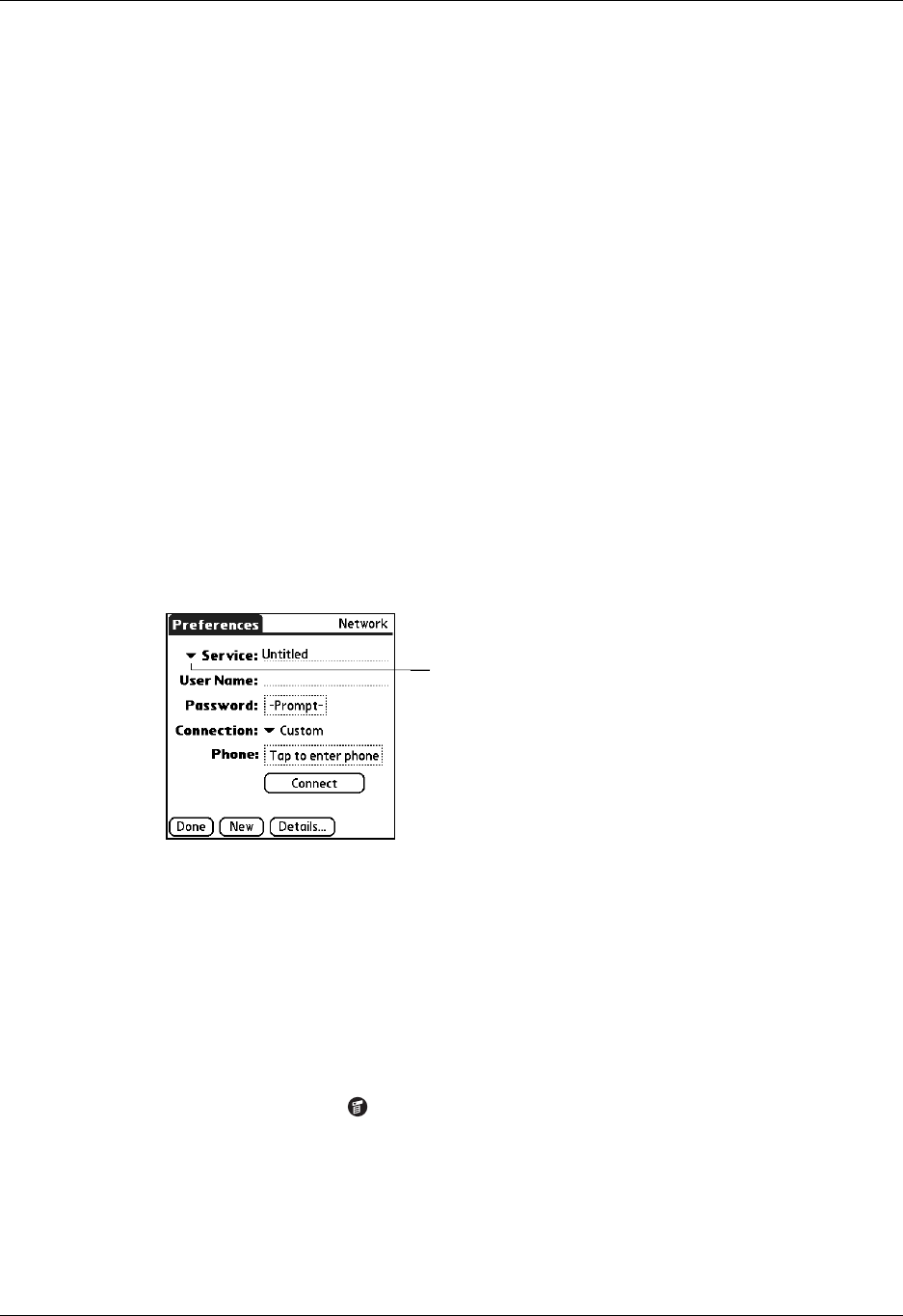
Chapter 17 Setting Preferences for Your Handheld
218
Creating and selecting network service profiles
Use network service profiles to store the configuration settings for your ISP or a
dial-in server. You can create, save, and reuse network service profiles. You can
create additional network service profiles from scratch or by duplicating existing
profiles and editing information. After you create a new or duplicate profile, you
can add and edit settings. You can also duplicate and rename a profile that you
created with Phone Link. This preserves the current Phone Link settings when you
use Phone Link to create a new phone connection. Otherwise, Phone Link erases
the current settings when it creates the new settings.
To add a new network service profile:
1. From the Communications Preferences screen, select Network.
2. Tap N ew.
An Untitled network service profile appears in the Service pick list.
3. Tap Don e.
To select a network service profile:
1. From the Communications Preferences screen, select Network.
2. Tap the Service pick list.
3. Select the network service profile you want to use.
4. Tap Don e .
To duplicate an existing network service profile:
1. From the Communications Preferences screen, select Network.
2. Tap the Service pick list.
3. Select the predefined network service profile you want to duplicate.
4. Tap the Menu icon .
5. Select Service, and then select Duplicate.
A copy of the network service profile is added to the Service pick list.
Tap here to display a
list of network
service profiles
Palm, Inc. Confidential
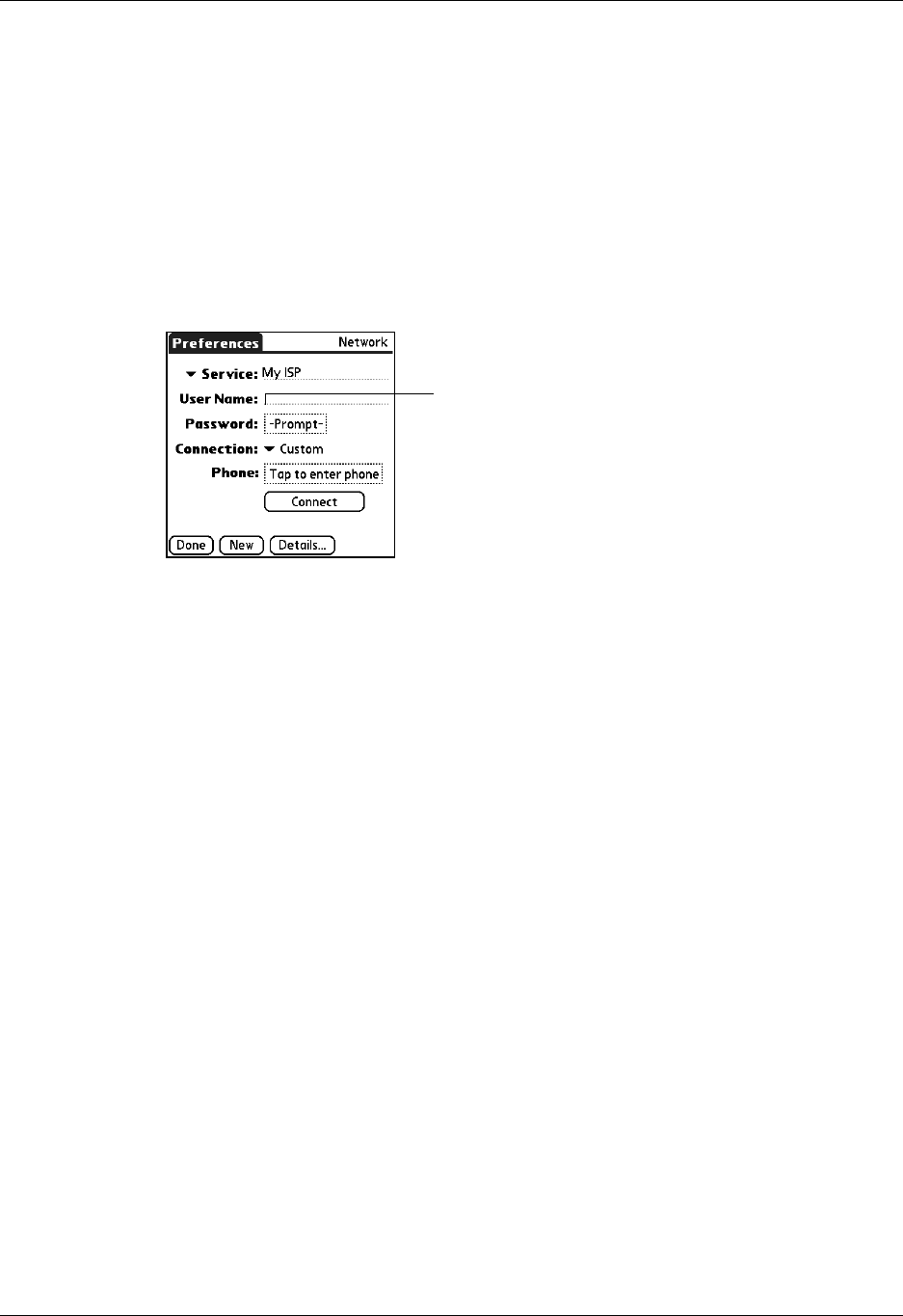
Setting Communication Preferences
219
Entering a user name
The User Name setting identifies the name you use when you log into your ISP or
your dial-in server. Although this field can contain multiple lines of text, only two
lines appear onscreen.
To enter a user name:
1. From the Communications Preferences screen, select Network.
2. Tap the User Name field.
3. Enter your user name.
NOTE Most dial-in servers do not accept spaces in the user name.
4. Tap Don e.
Entering a password
The Password box identifies the password you use to log into your server or ISP.
Your entry in this field determines whether your handheld prompts you to enter a
password each time you log into your network.
■If you do not enter a password, your handheld displays the word “Prompt” in
this field and asks you to enter a password during the login procedure. If you
are concerned about security, select the Prompt option.
■If you enter a password, your handheld displays the word “Assigned” in this
field and does not prompt you to enter a password during the login procedure.
To enter a password:
1. From the Communications Preferences screen, select Network.
2. Tap the Password field.
Enter your user
name here
Palm, Inc. Confidential
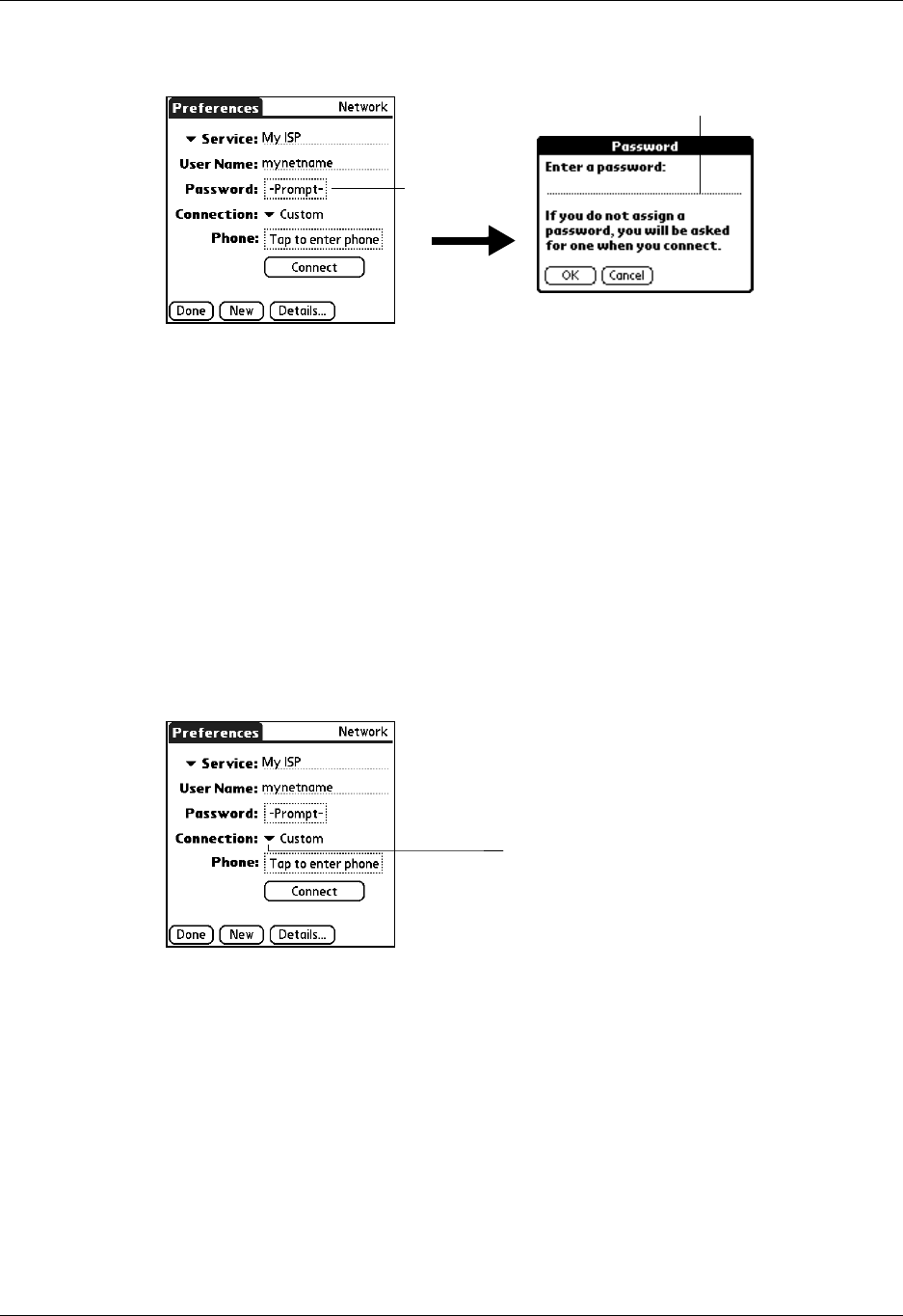
Chapter 17 Setting Preferences for Your Handheld
220
3. Enter the password you use to log into your server.
.
4. Tap OK.
The word “Assigned” appears in the Password field.
5. Tap Don e.
Selecting a connection
Use the Connection setting to select the method you want to use to connect to your
ISP or to a dial-in server. See “Connection Preferences” earlier in this chapter for
information about creating and configuring connection settings.
To select a connection:
1. From the Communications Preferences screen, select Network.
2. Tap the Connection pick list.
3. Select the connection you want to use.
4. Tap Don e.
Adding telephone settings
The Phone field enables you to store the telephone number you use to connect with
your ISP or dial-in server. You can also define a prefix, disable Call Waiting, and
give special instructions for using a calling card.
E
nter passwor
d
h
ere
Tap here
Tap here to display a
list of available
connections
Palm, Inc. Confidential
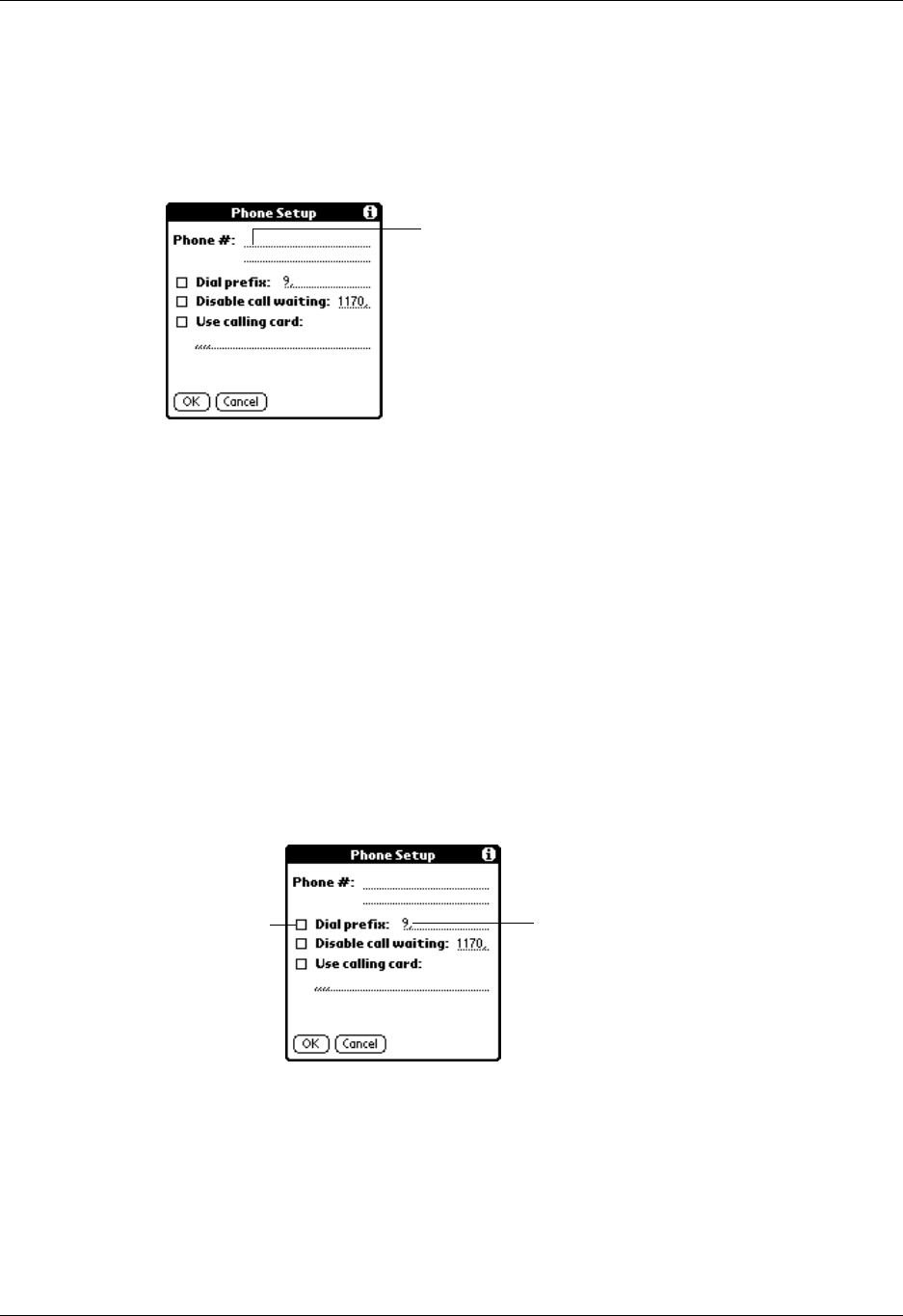
Setting Communication Preferences
221
To enter your server phone number:
1. From the Communications Preferences screen, select Network.
2. Tap the Phone box.
3. Enter the phone number for your ISP or dial-in server.
4. If you need to enter a prefix or to disable Call Waiting, skip to those procedures.
Otherwise, tap OK.
5. Tap Don e.
Entering a prefix
A prefix is a number that you dial before the telephone number to access an outside
line. For example, many offices require that you first dial “9” to dial a number
outside the building.
To enter a prefix:
1. From the Communications Preferences screen, select Network.
2. Tap the Phone box.
3. Tap the Dial Prefix check box to select it.
4. Enter the prefix.
5. Tap OK.
6. Tap Don e.
Enter your ISP phone
number here
Enter your
prefix here
Select this
box if you
need to use a
prefix
Palm, Inc. Confidential
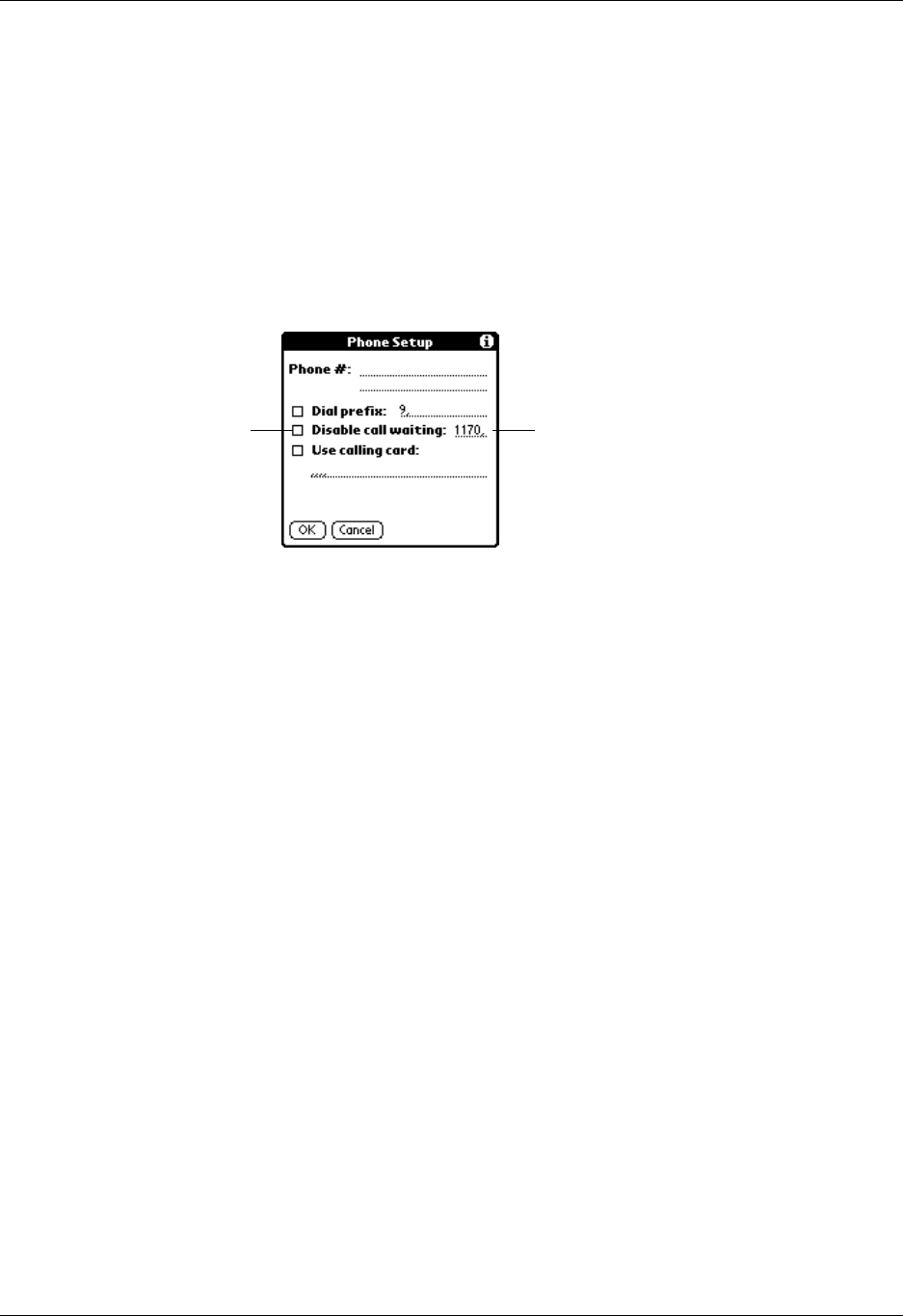
Chapter 17 Setting Preferences for Your Handheld
222
Disabling Call Waiting
Call Waiting can cause your session to terminate if you receive a call while you are
connected. If your telephone has Call Waiting, you need to disable this feature
before logging into your ISP or dial-in server.
To disable Call Waiting:
1. From the Communications Preferences screen, select Network.
2. Tap the Phone box.
3. Tap the Disable call waiting check box to select it.
4. Enter the code to disable Call Waiting on the Disable call waiting line.
Each telephone company assigns a code to disable Call Waiting. Contact your
local telephone company for the code that is appropriate for you.
5. Tap OK.
6. Tap Don e.
Using a calling card
The Use calling card field enables you to use your calling card when dialing your
ISP or Intranet server. Keep in mind that there is usually a delay before you enter
your calling card number. When you define your calling card number, you need to
add commas at the beginning to compensate for this delay. Each comma delays
transmission of your calling card number for two seconds.
Enter your disable
code here
Select this
box if you
need to
disable Call
Waiting
Palm, Inc. Confidential
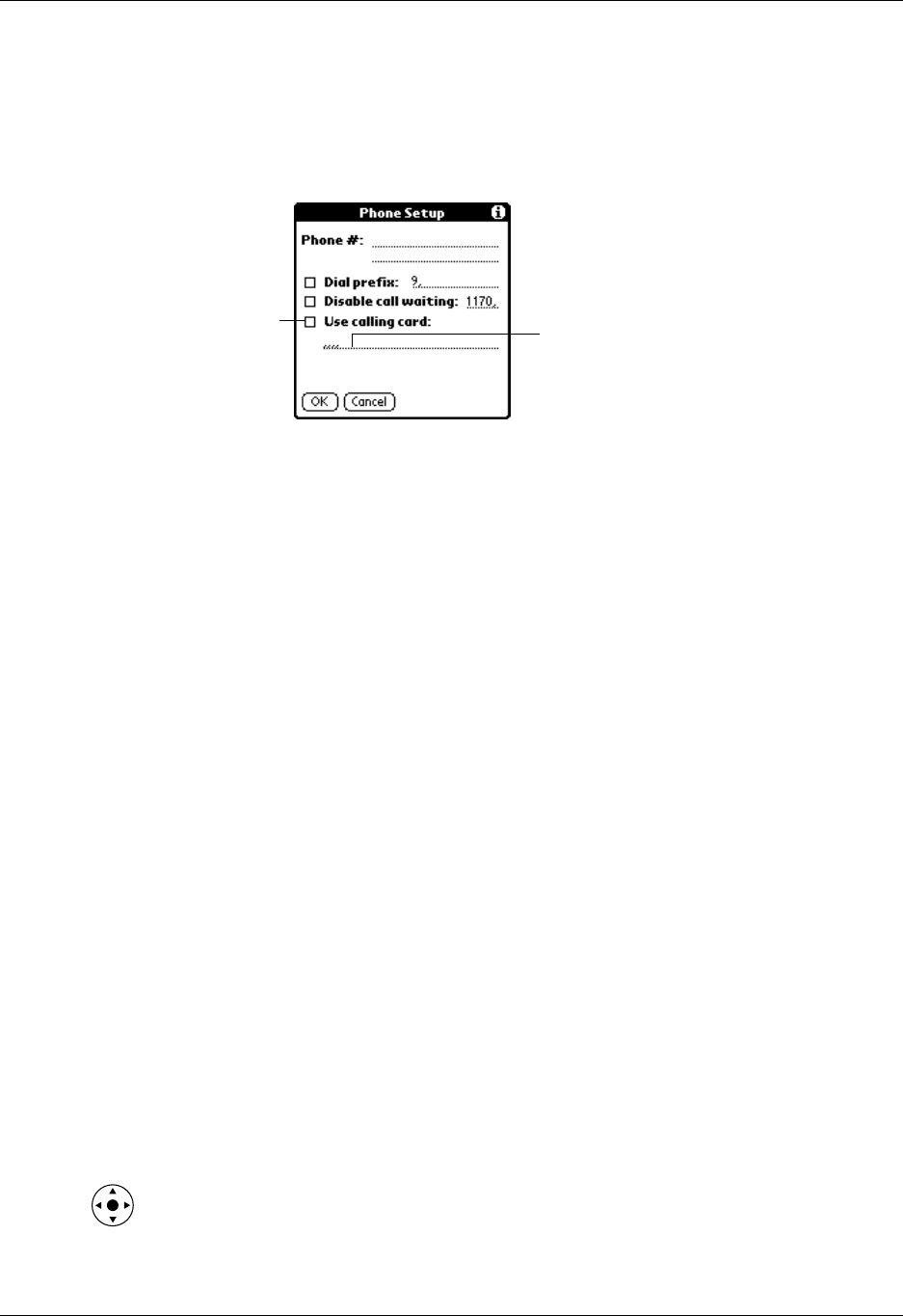
Setting Communication Preferences
223
To use a calling card:
1. From the Communications Preferences screen, select Network.
2. Tap the Phone box.
3. Tap the Use calling card check box to select it.
4. Enter your calling card number on the Use calling card line.
NOTE The Phone Setup dialog box works correctly for AT&T and Sprint long-
distance services. However, because MCI works differently, MCI customers
need to enter the calling card number in the Phone # field and the phone
number in the Use calling card field.
TIP It’s a good idea to add at least three commas before your calling card
number to compensate for the cue delay.
5. Tap OK.
6. Tap Don e.
Connecting to your service
After you set your Connection and Network Preferences, establishing a connection
to your ISP or your company’s network (dial-in server) is easy.
NOTE If you are connecting to an ISP, you need a third-party application, such as a
web browser or news reader, to take advantage of this connection. For information
about third-party applications that support TCP/IP, check the web site www.palm.com.
To establish a connection:
1. From the Communications Preferences screen, select Network.
2. Tap Connect to dial the current service and display the Service Connection
Progress messages.
3. (Optional) From the Service Connection Progress dialog box, tap the box that
displays the service name, select another service, and then tap Done.
To see expanded Service Connection Progress messages, press Down on the
navigator.
4. Tap Don e.
Enter your
calling card
number here
Select this
box to use a
calling card
Palm, Inc. Confidential

Chapter 17 Setting Preferences for Your Handheld
224
To close a connection:
1. From the Communications Preferences screen, select Network.
2. Tap Disconnect to terminate the connection between your handheld and your
service.
3. Tap Don e.
LAN access points
A LAN access point enabled with Bluetooth technology provides an entry point
into a local area network. You can log onto these networks from your handheld to
access services such as e-mail and the Internet.
LAN access points can be located in private, corporate or in public areas. In some
cases there may be a fee to use a LAN access point. To access a LAN access point
from your handheld, you must set your Network Preferences as described in the
sections that follow.
Accessing the Internet with a Bluetooth phone or LAN access point
With your handheld’s built-in Bluetooth technology, you can connect to the
Internet using a Bluetooth-enabled mobile phone or a LAN access point. To
connect to a Bluetooth-enabled mobile phone or LAN access point, you must be
within range of these devices. If you have a GSM mobile phone and subscribe to
high-speed wireless data services with your mobile phone carrier, you can use
these services to connect to the Internet when you are within range of the high-
speed wireless data network.
You can also configure Internet access with a GSM phone or high-speed wireless
data network using the Phone Link application. We recommend using Phone Link
to enter these settings. See “Setting up a phone connection” in Chapter 12 for
details. Use the steps described in this section only if you are unable to create a
connection with Phone Link and you have already used the Connection
Preferences screen to create a trusted pair for your phone, high-speed data
network, or LAN access point. See “Creating Bluetooth connections” earlier in this
chapter for additional information.
To configure Internet access with a Bluetooth phone or LAN access point:
1. From the Communications Preferences screen, select Network.
2. Tap the Service pick list and select the name of your ISP or network service. See
“To select a network service profile:” earlier in this chapter for details.
If the name of your service does not appear on the list, see “Adding detailed
information to a network service profile” later in this chapter for information on
adding an item to the Service pick list.
Palm, Inc. Confidential
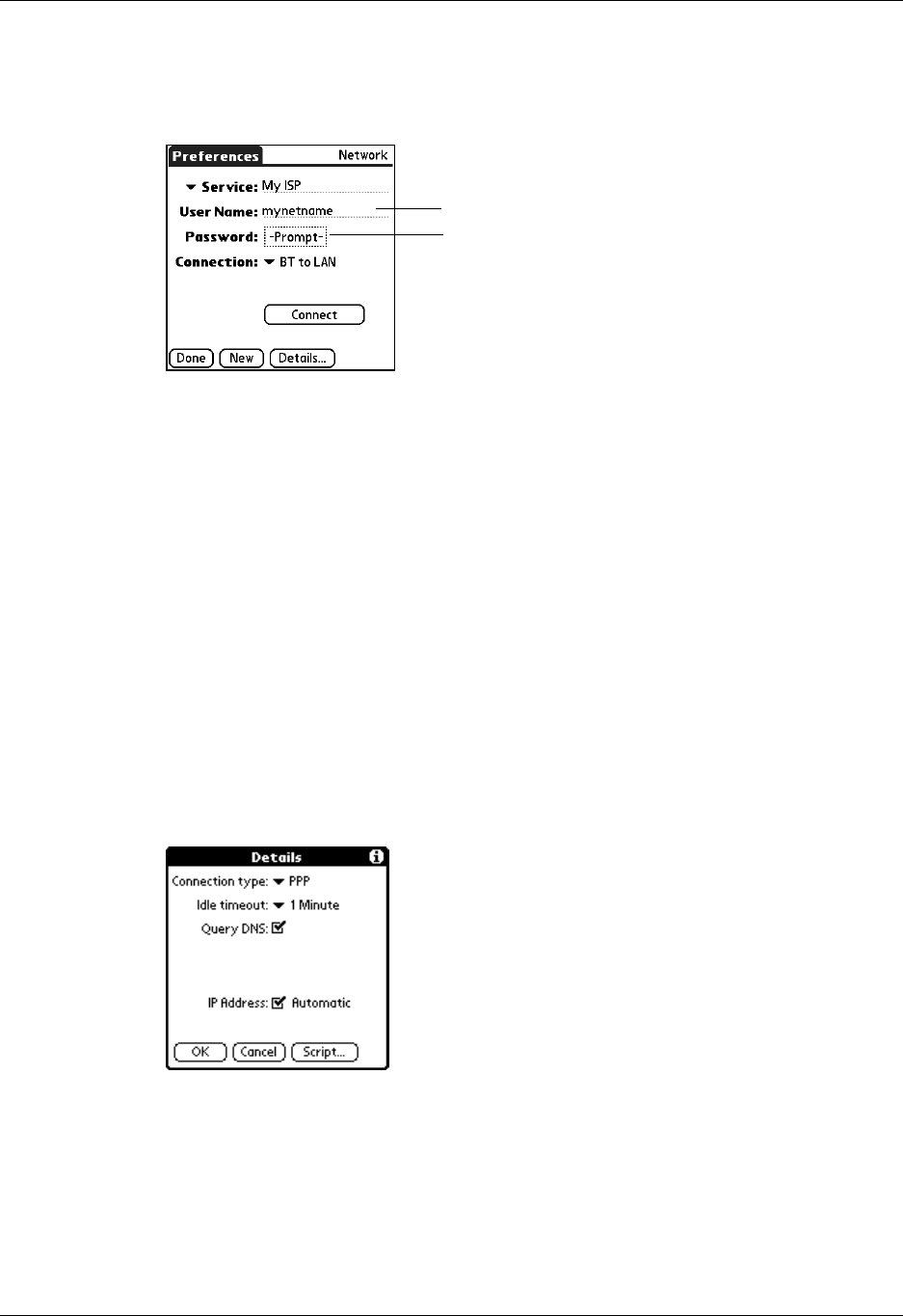
Setting Communication Preferences
225
3. Enter your User Name and Password for your ISP or network service. See
“Entering a user name” and “Entering a password” earlier in this chapter for
details.
4. Tap the Connection pick list and select a connection to a Bluetooth-enabled
GSM phone, a high-speed wireless data network, or a LAN access points for
which you have already created a trusted pair. The Connection name is based
on the model of your phone (if you used Phone Link to create the connection)
or the name you assigned to the high-speed wireless data network or LAN
access point connection when you created it.
5. If you selected a Bluetooth phone connection in step 4, tap Phone and enter the
dial-up connection number for your ISP, and then tap OK. See “Adding
telephone settings” earlier in this chapter for details.
If you are using a Bluetooth Phone or LAN access point, you can now connect and
disconnect as described earlier in this chapter. If you are using a high-speed
wireless data network connection, you must send an initialization (INIT) string as
described in the following procedure.
To enter an INIT string for a high-speed wireless data network connection:
1. After completing step 5 in the preceding procedure, tap Details.
Enter the user name and password
you use to connect with your ISP
Palm, Inc. Confidential
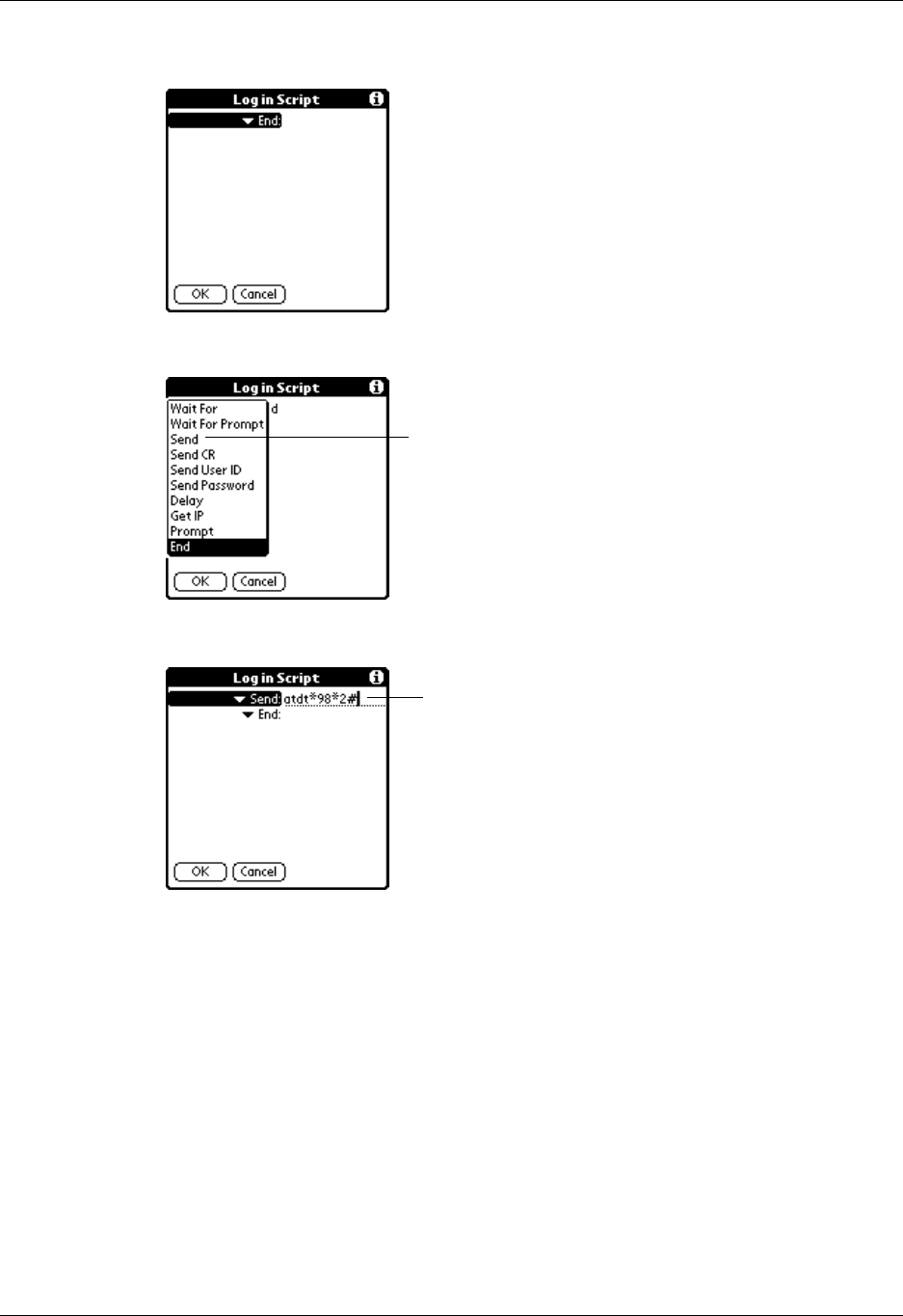
Chapter 17 Setting Preferences for Your Handheld
226
2. Tap Script.
3. Tap End to expand the pick list, and then tap Send.
4. In the Send field, enter the INIT string provided by your wireless operator.
5. Tap OK.
High-speed wireless data network services are not available in all locations. If you
pass from an area with coverage into one without coverage, you will lose your
network connection with no notice.
If your network connection drops unexpectedly, check your phone to see if a high-
speed wireless data network is active and available for the area you are in. If a
high-speed wireless data network is available, reconnect to the network using the
preceding steps.
If a high-speed wireless data network is not available, you must switch your phone
to a standard (non-GPRS) phone connection and access the Internet using your ISP.
You can do this only if you have previously created a standard connection with
your phone. For instructions on creating a standard connection, see “Setting up a
phone connection” in Chapter 12.
Tap here to send INIT string
Enter INIT string here
Palm, Inc. Confidential
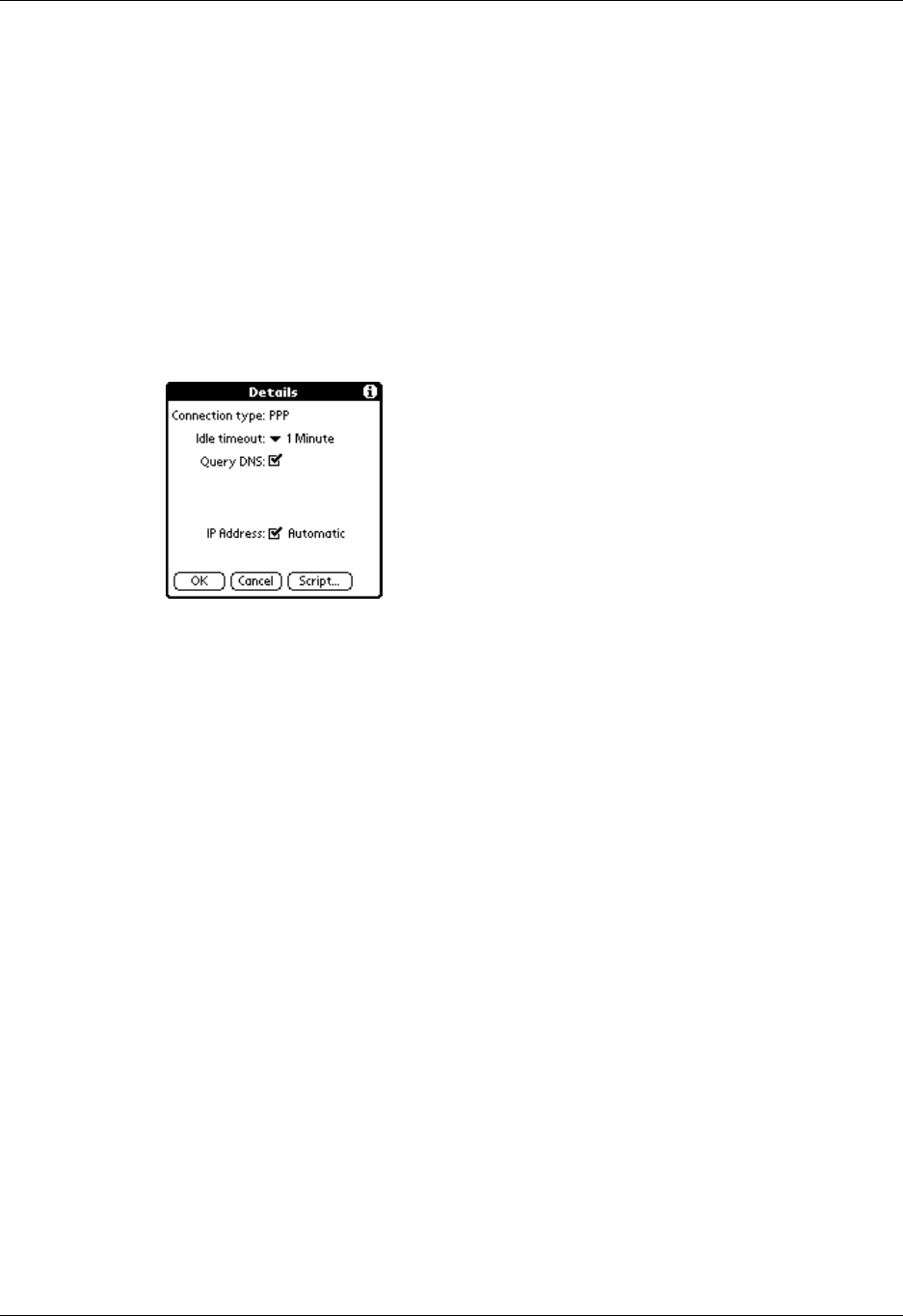
Setting Communication Preferences
227
Adding detailed information to a network service profile
If you are using one of the predefined network service profiles, you probably need
to enter only your user name, password, and telephone number. If you are creating
a new network service profile, you may need to provide additional information to
your ISP or dial-in server. You use the Details dialog box to add more information
to a selected network service profile.
To add connection details:
1. From the Communications Preferences screen, select Network.
2. Tap the service field.
3. Tap Details.
Idle timeout
The Idle timeout setting defines how long your handheld waits before dropping
the connection with your ISP or dial-in server when you switch out of a TCP/IP
application.
To set the Idle timeout:
1. Tap the Idle timeout pick list and select one of the following options:
2. Tap OK.
1 minute Waits one minute for you to open another application before
it drops the connection.
2 minutes Waits two minutes.
3 minutes Waits three minutes.
Never Keeps your PPP or SLIP connection until you turn off your
handheld (or until it times out).
Palm, Inc. Confidential

Chapter 17 Setting Preferences for Your Handheld
228
Defining primary and secondary DNS
The domain name system (DNS) is a mechanism in the Internet for translating the
names of host computers into IP addresses. When you enter a DNS number (or IP
address), you are identifying a specific server that handles the translation services.
Each IP address has four sections, separated by periods. In the Details dialog box,
you enter each section separately. Each section of an IP address is made up of a
number from 0 to 255; numbers are the only allowable characters in this field.
Ask your ISP or system administrator for the correct primary or secondary DNS IP
address.
Many systems do not require that you enter a DNS IP address. If you are not sure,
leave the DNS field blank.
To enter a primary and secondary DNS:
1. Tap the Query DNS check box to deselect it.
2. Tap the space to the left of the first period in the Primary DNS field, and then
enter the first section of the IP address.
Each section must be a number from 0 to 255.
3. Repeat step 2 for the second, third, and last sections of the Primary DNS field.
4. Repeat steps 2 and 3 for the Secondary DNS field.
5. Tap OK.
IP address
Everyone who logs on to the Internet needs to have a unique identifier (an IP
address), whether permanent or temporary. Some networks dynamically assign a
temporary IP address when clients log in. You can use the IP Address field to
indicate whether your network provides automatic (dynamic) temporary IP
addressing.
If your IP address is permanently assigned, you need to get that information from
your system administrator. If you are not sure, select Automatic.
To identify dynamic IP addressing:
■Tap the IP Address check box to select it.
Tap to select automatic IP
address
Palm, Inc. Confidential
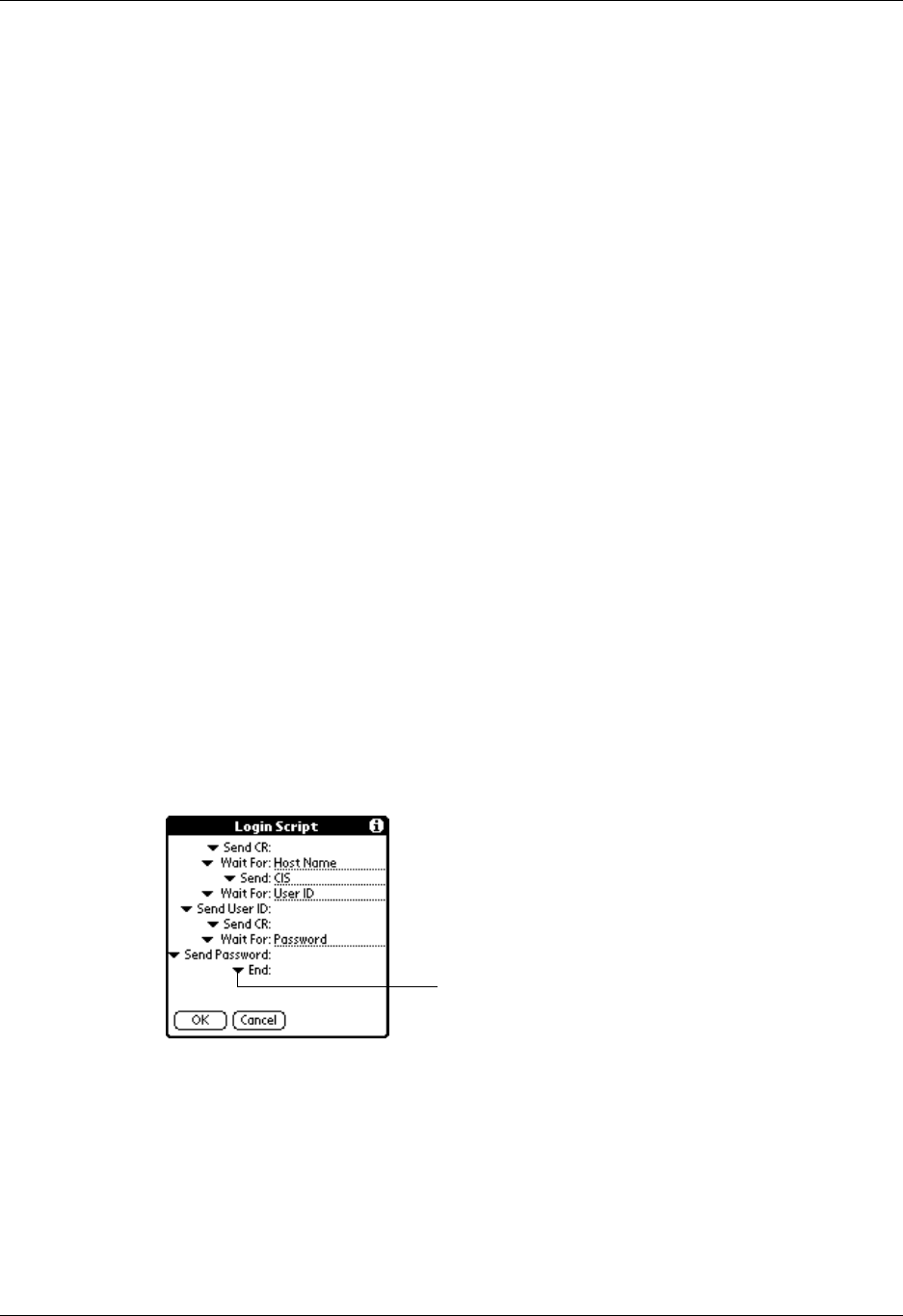
Setting Communication Preferences
229
To enter a permanent IP address:
1. Tap the IP Address check box to deselect it and to display a permanent IP
address field below the check box.
2. Tap the space to the left of the first period, and then enter the first section of the
IP address.
Each section must be a number from 0 to 255.
3. Tap and enter the remaining sections of the IP address.
4. Tap OK.
Login scripts
A login script is a series of commands that automates logging in to a network
server—for example, your corporate network or your ISP. A login script is
associated with a specific network service profile created in Network Preferences.
A login script is something that you are likely to receive from your system
administrator if your company has a system in which you log in to the corporate
servers from your handheld using a modem or network connection. The script is
generally prepared by the system administrator and distributed to users who need
it. It automates the events that must take place to establish a connection between
your handheld and the corporate servers.
You can create login scripts in two ways:
■In a text editor on your desktop computer, in which you create a file with the
extension PNC, which you then install on your handheld using the Install Tool.
(This method is not available to Mac computer users.)
■In the Login Script dialog box on your handheld, accessed from the Details
dialog box in Network Preferences.
NOTE You can also use non-ASCII and literal characters in your login script.
Creating a login script on your handheld
You can create login scripts by selecting commands from the Command pick list in
the Login Script dialog box. Some commands, such as Send, require you to supply
additional information. Those commands have a parameter field so that you can
add the necessary data.
Tap here to see the list of
available commands
Palm, Inc. Confidential

Chapter 17 Setting Preferences for Your Handheld
230
To create a login script:
1. Tap Script.
2. Tap the End pick list.
3. Select the command you want from the Command list. If the command requires
additional information, a field appears to the right of it for you to enter the
information. The following commands are available:
Wait For Tells your handheld to wait for specific characters from the
TCP/IP server before executing the next command.
Wait For Prompt Detects a challenge-response prompt coming from the server
and then displays the dynamically generated challenge
value. You then enter the challenge value into your token
card, which in turn generates a response value for you to
enter on your handheld. This command takes two
arguments, separated by a vertical bar (|) on the input line.
Send Transmits specific characters to the TCP/IP server to which
you are connecting.
Send CR Transmits a carriage return or line feed (LF) character to the
TCP/IP server to which you are connecting.
Send User ID Transmits the user ID information entered in the User ID
field of the Network Preferences screen.
Send Password Transmits the password entered in the Password field of the
Network Preferences screen. If you did not enter a password,
this command prompts you to enter one. The Password
command is usually followed by a Send CR command.
Delay Tells your handheld to wait a specific number of seconds
before executing the next command in the login script.
Get IP Reads an IP address and uses it as the IP address for your
handheld. This command is used with SLIP connections.
Ta p h e r e
Palm, Inc. Confidential

Setting Communication Preferences
231
4. Repeat steps 2 and 3 until the login script is complete.
5. Tap OK.
Plug-in applications
You can create plug-in applications containing script commands that extend the
functionality of the built-in script commands. A plug-in application is a standard
PRC application that you install on your handheld just like any other application.
After you install the plug-in application, you can use the new script commands in
a login script.
Plug-in applications have the following characteristics:
■Written in C language
■Compiled into a device executable
■Called properly from a login script
■Able to return control to a login script after it terminates
■Created using a development environment that supports Palm OS software,
such as Metrowerks CodeWarrior for Palm™ Platform.
For additional information on creating plug-in applications, send e-mail to Palm
Developer Support at devsupp@palm.com.
Deleting a network service profile
There is only one way to delete a network service profile: Use the Delete command
from the Service menu.
To delete a network service profile:
1. From the Communications Preferences screen, select Network.
2. Tap the Service pick list.
3. Select the network service profile you want to delete.
4. Tap the Menu icon .
5. Select Delete from the Service menu.
6. Tap OK.
7. Tap Don e.
Prompt Opens a dialog box and prompts you to enter certain text (for
example, a password or a security code).
End Identifies the last line in the login script.
Palm, Inc. Confidential
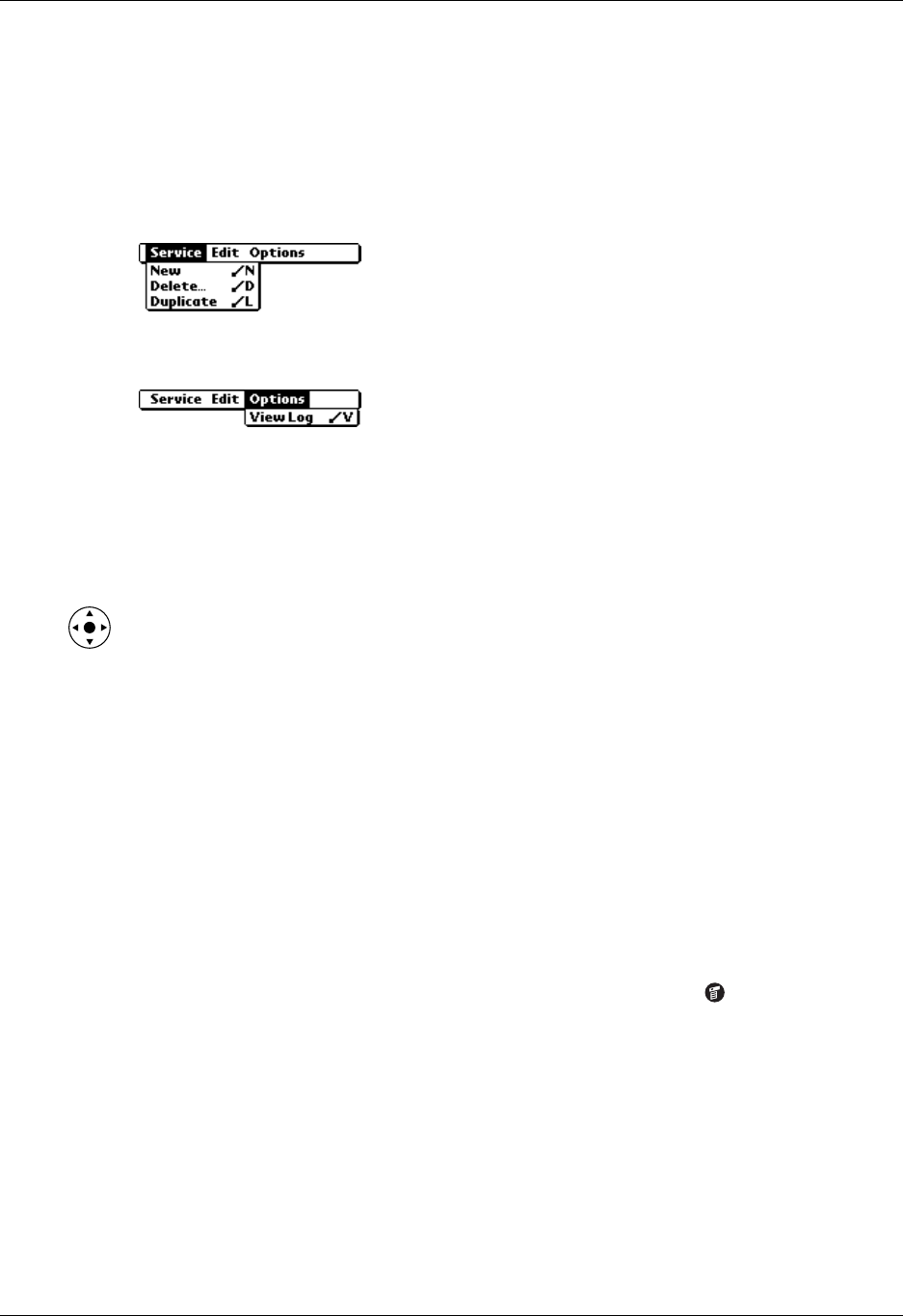
Chapter 17 Setting Preferences for Your Handheld
232
Network preferences menu commands
The Network Preferences screen includes menu commands to make it fast and
easy to create and edit network service profiles. TCP/IP application menus are
shown here for your reference. See “Using menus” in Chapter 4 for more
information about choosing menu commands.
Service menu
Options menu
TCP/IP troubleshooting
If you have problems establishing a network connection using TCP/IP, check the
troubleshooting tips in this section and try the suggestions listed.
Displaying expanded Service Connection Progress messages
It’s helpful to identify at what point in the login procedure the connection fails. An
easy way to do this is to display the expanded Service Connection Progress
messages. These messages describe the current stage of the login procedure. Press
Down on the navigator at any point during login to display these messages.
Viewing the Network Log
If viewing the expanded Service Connection Progress messages does not give you
enough information to find out why you cannot connect to your ISP or dial-in
server, take a look at the Network Log. The Network Log lists all of the
communication that occurs between your modem and your dial-in server during
the login procedure. The information in the Network Log can help your ISP or
your system administrator pinpoint where the login procedure communication
fails and why.
To view the Network Log:
1. From the Network Preferences screen, tap the Menu icon .
2. Select Options, and then select View Log.
3. Tap the up and down arrows of the scroll bar to see the entire Network Log.
4. Tap Don e.
Adding a DNS number
If your ISP or dial-in server requires a DNS number and you did not enter that
information in the Network Preferences screen, it will appear that you successfully
logged into your network. When you try to use an application or look up
Palm, Inc. Confidential
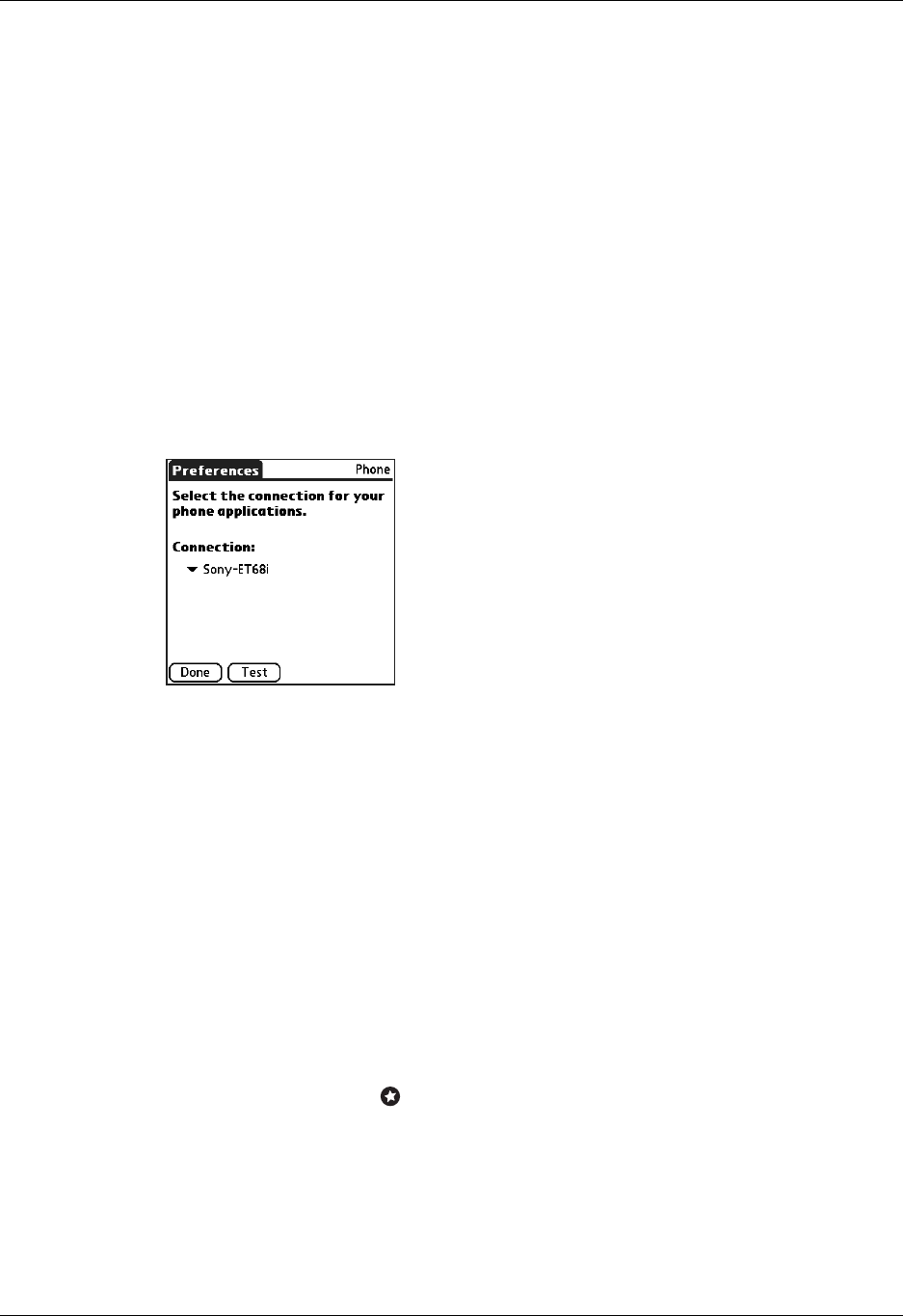
Setting Personal Preferences
233
information, however, the connection fails. If this occurs, try adding a DNS IP
address. Ask your ISP or your system administrator for the correct primary and
secondary DNS IP address.
Phone Preferences
The Phone Preferences setting enables you to configure your handheld to
exchange SMS messages and dial phone numbers when your handheld is
connected to a GSM mobile phone (sold separately). To use this feature, you must
first install the appropriate files for your carrier and phone and the SMS
application from the Software Essentials CD-ROM.
To set Phone Preferences:
1. From the Communications Preferences screen, select Phone.
2. Tap the Connection pick list.
3. Select the appropriate connection for your phone.
If you do not see a connection for your phone, see “Setting up a phone
connection” in Chapter 12 for instructions.
4. Tap Test to confirm that the selected driver works properly with your phone.
5. Tap Don e.
Setting Personal Preferences
The Personal Preferences category enables you to access screens where you can
customize the buttons, owner information, and Graffiti shortcuts on your
handheld. This section provides details about each of these screens.
To open the Personal Preferences screens:
1. Tap the Favorites icon .
2. Tap Personal.
3. Select the name of the Preferences screen you want to view.
Palm, Inc. Confidential
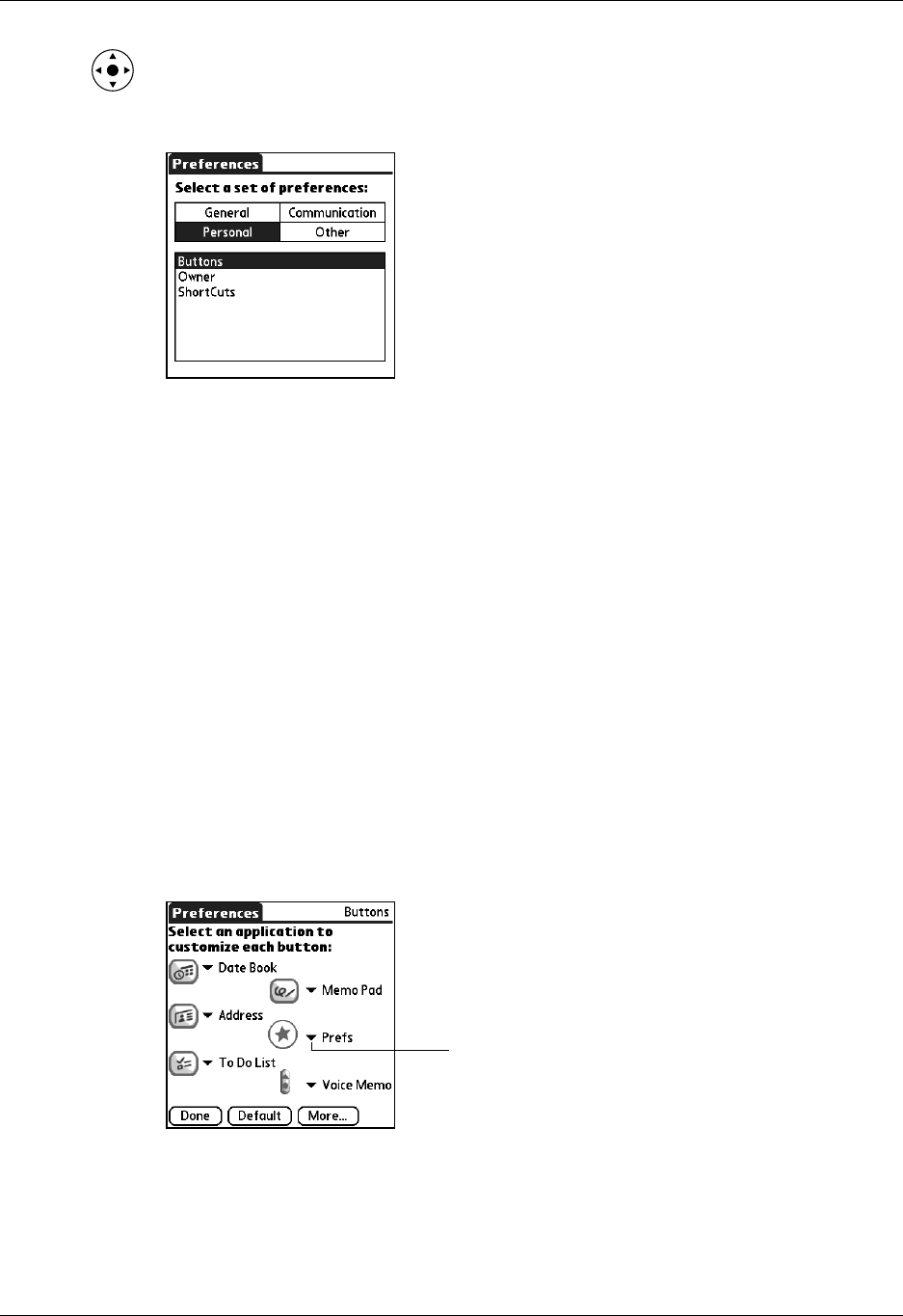
Chapter 17 Setting Preferences for Your Handheld
234
TIP You can also select the Preferences category by pressing Left and Right on
the navigator, and select a Preferences screen by pressing Up and Down on the
navigator.
Buttons Preferences
The Buttons Preferences screen enables you to assign a frequently used application
to the Favorite icon, and to associate various applications with the buttons on the
front and side of the handheld.
Preferences is assigned to the Favorite icon by default. But if you use Memo Pad
more frequently, you can assign Memo Pad to the icon so that you don’t have to
scroll through the Applications Launcher whenever you want to use Memo Pad.
Any changes you make in the Buttons Preferences screen become effective
immediately; you do not have to change to a different screen or application.
If you assign a different application to a button, you can still access the original
application using the Applications Launcher.
To change the Buttons preferences:
1. From the Personal Preferences screen, select Buttons
2. Tap the pick list next to the button you want to reassign.
3. Select the application that you want to assign to the button.
To restore all the buttons to their factory settings, tap Default.
4. Tap Don e.
Ta p a rr o w t o
show pick list
Palm, Inc. Confidential
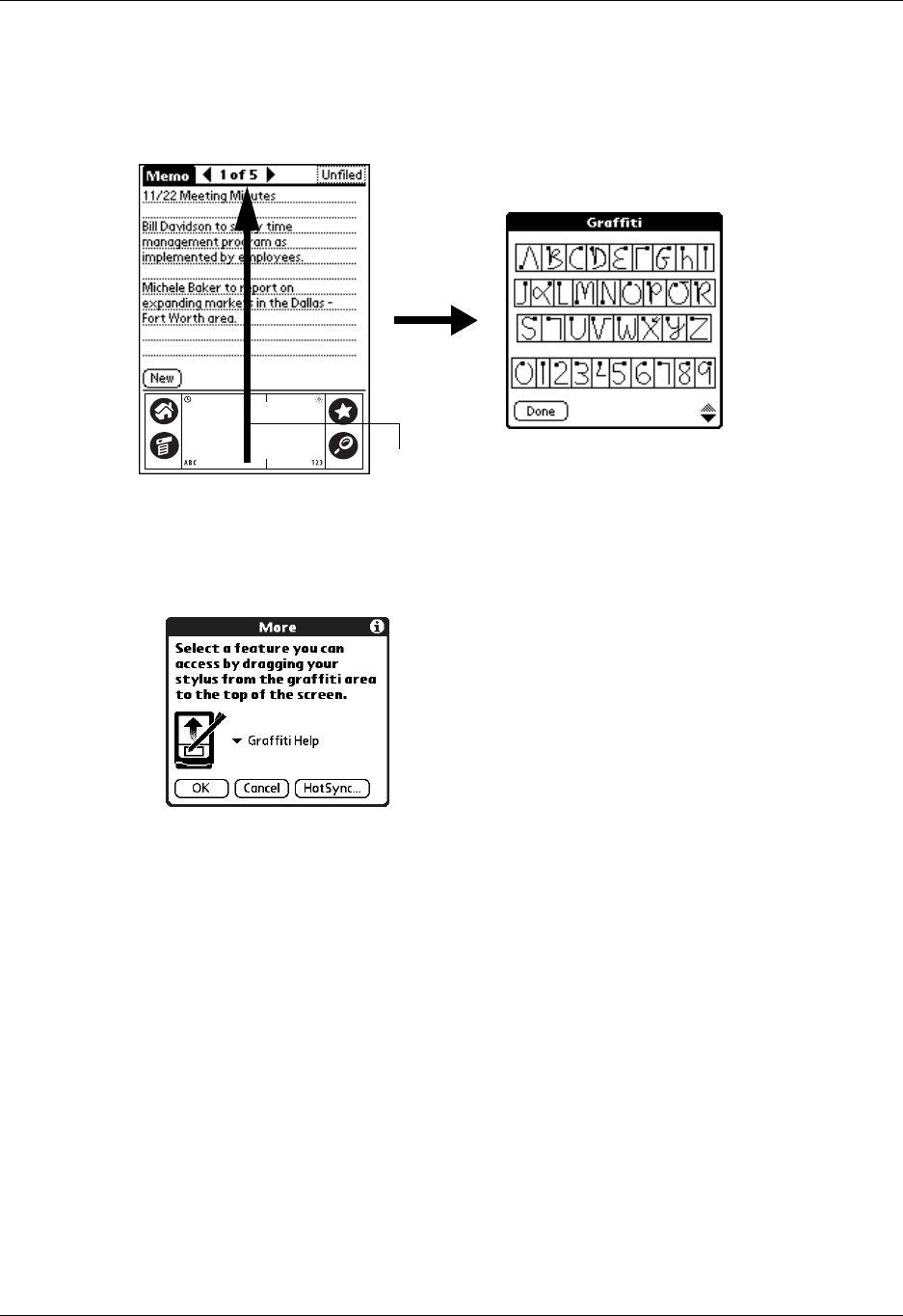
Setting Personal Preferences
235
Pen preferences
The Buttons Preferences screen enables you to change the assignment of the full-
screen pen stroke. By default, the full-screen pen stroke activates Graffiti Help.
To change the pen preferences:
1. From the Personal Preferences screen, select Buttons.
2. Tap More .
3. Tap the pick list and select one of the following settings for the full-screen pen
stroke:
Backlight Toggles the backlight on your handheld on and off.
Keyboard Opens the onscreen keyboard for entering text characters.
Graffiti Help Opens a series of screens that show the complete Graffiti
character set.
Turn Off & Lock Turns off and locks the handheld. You must assign a
password to lock the handheld. When it is locked, you
need to enter the password to use your handheld.
Beam Data Beams the current record to another device with an IR port.
Drag to top of screen
Palm, Inc. Confidential
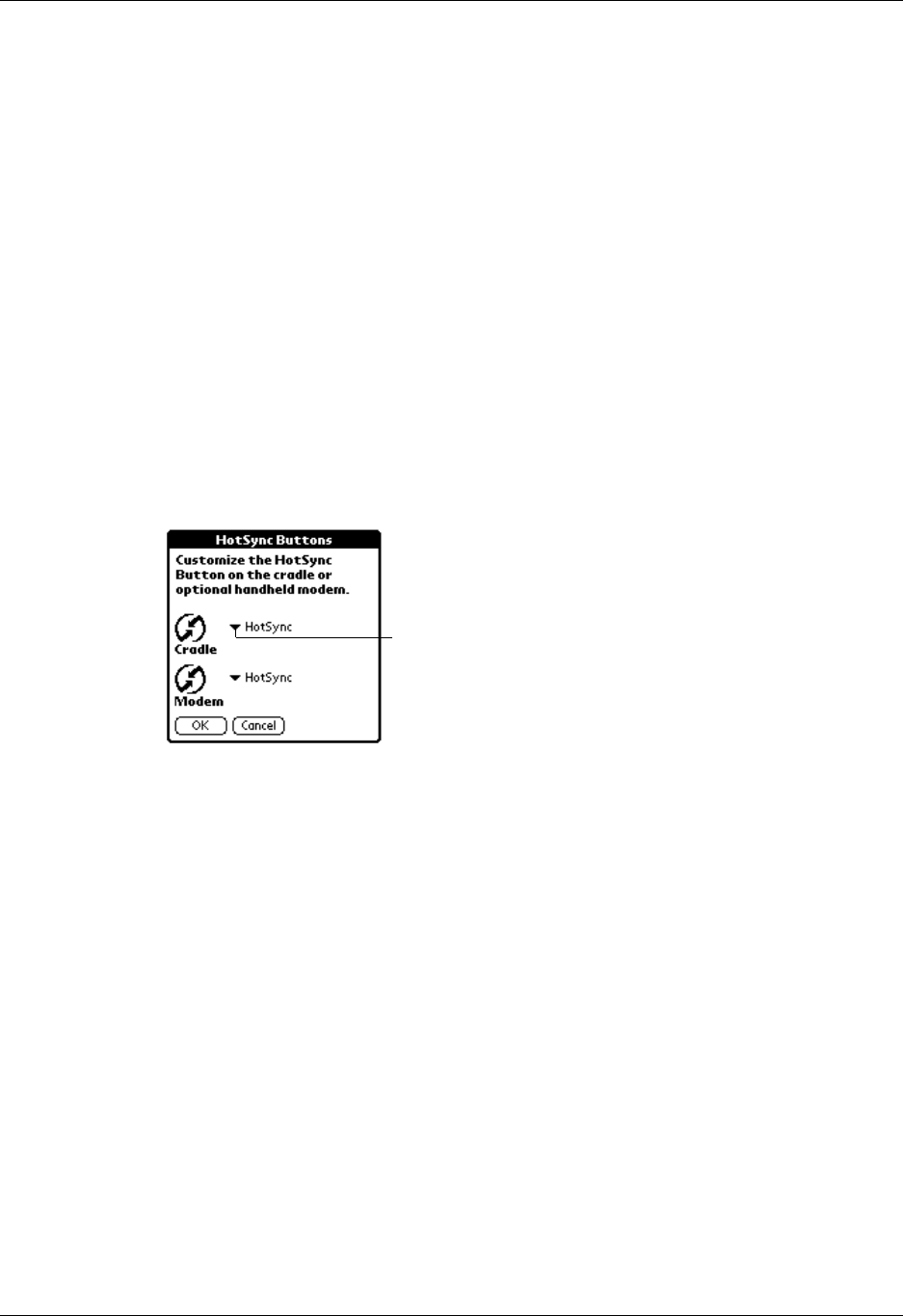
Chapter 17 Setting Preferences for Your Handheld
236
4. Tap OK.
5. Tap Don e.
HotSync buttons preferences
The Buttons Preferences screen also enables you to associate various applications
with the HotSync button on the cradle/cable and the HotSync button on an
optional modem accessory. Any changes that you make in the HotSync Buttons
dialog box become effective immediately; you do not have to change to a different
screen or application.
To change the HotSync buttons preferences:
1. From the Personal Preferences screen, select Buttons.
2. Tap More .
3. Tap HotSync.
4. Tap the pick list next to the button you want to assign.
5. Select the application that you want to assign to each button.
The default setting for each button is the HotSync setting, which means that the
cradle/cable and optional modem accessories perform their normal HotSync
functions.
6. Tap OK twice to return to the Buttons Preferences screen.
7. Tap Don e.
Owner preferences
The Owner Preferences screen enables you to update the name, company name,
phone number, or any other information that you want to associate with your
handheld. This information could help someone contact you if you ever lose your
handheld and there is sufficient battery power to turn it on.
By default the Owner Preferences screen contains the information that you
supplied when you installed the Palm Desktop software and set up your
handheld.
Ta p a rr o w
to show
pick list
Palm, Inc. Confidential
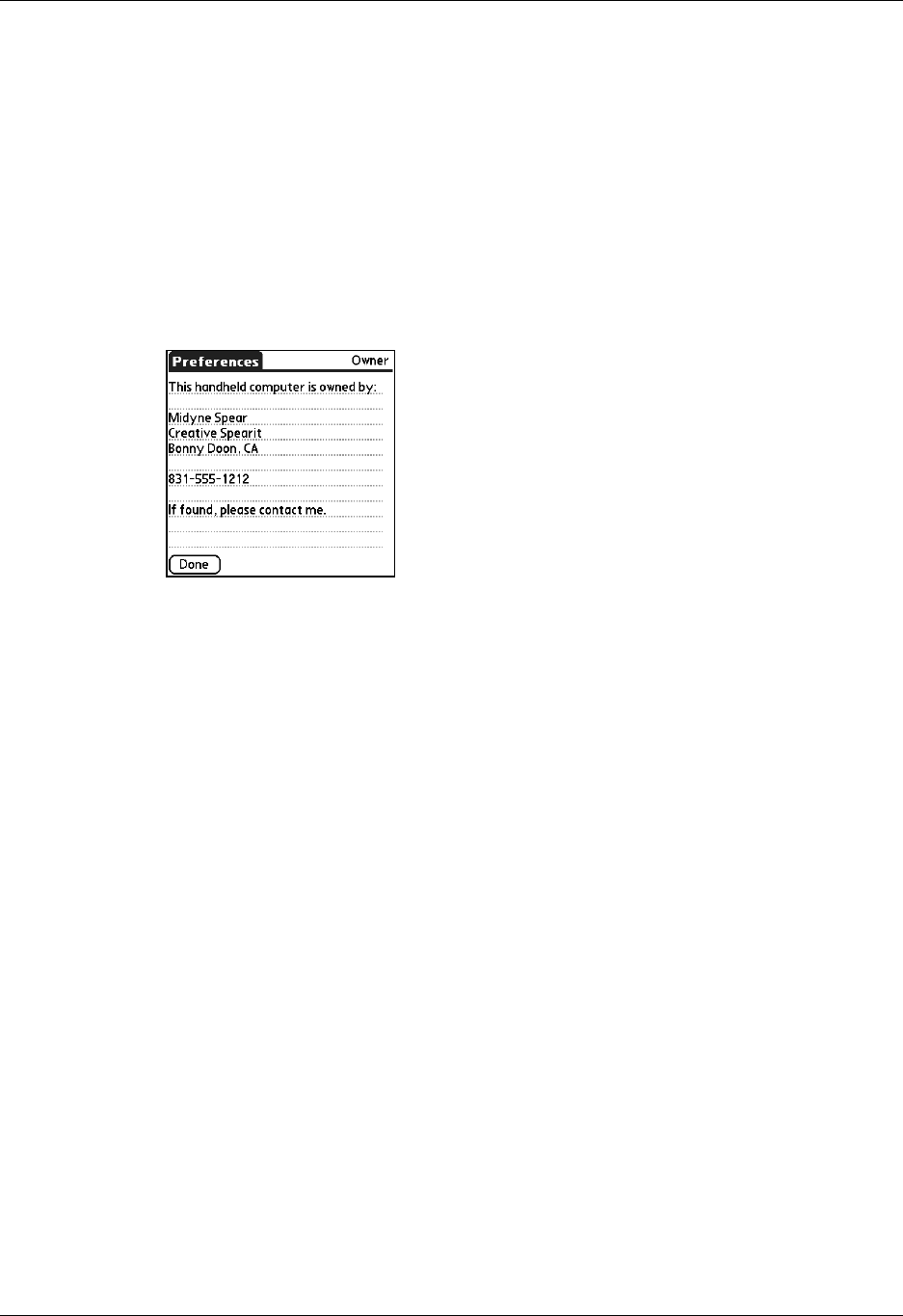
Setting Personal Preferences
237
If you use the Security application to turn off and lock your handheld with a
password, information that you entered in the Owner Preferences appears the next
time you turn on your handheld. See “Security Preferences” earlier in this chapter
for additional information.
To customize the Owner preferences:
1. From the Personal Preferences screen, select Owner.
2. Modify or enter the text that you want to associate with your handheld.
If you enter more text than can fit on one screen, a scroll bar automatically
appears on the right side of the screen.
If you assign a password with the Security application, the information on the
Owner Preferences screen cannot be changed. In this case an Unlock button
appears at the bottom of the screen.
3. Tap Don e.
To unlock the Owner Preferences screen:
1. From the Personal Preferences screen, select Owner.
2. Tap Unl o ck.
3. Enter the password that you defined in the Security application.
4. Tap OK.
5. Tap Don e.
ShortCuts Preferences
The ShortCuts Preferences screen enables you to define abbreviations for entering
text with Graffiti strokes. This section describes how to create, edit, and delete a
ShortCut.
Creating a ShortCut
You can create a ShortCut for any words, letters, or numbers. All ShortCuts you
create appear on the list in the ShortCut Preferences screen. All the ShortCuts are
available in any of your handheld applications and are backed up on your
computer when you perform a HotSync operation.
Palm, Inc. Confidential
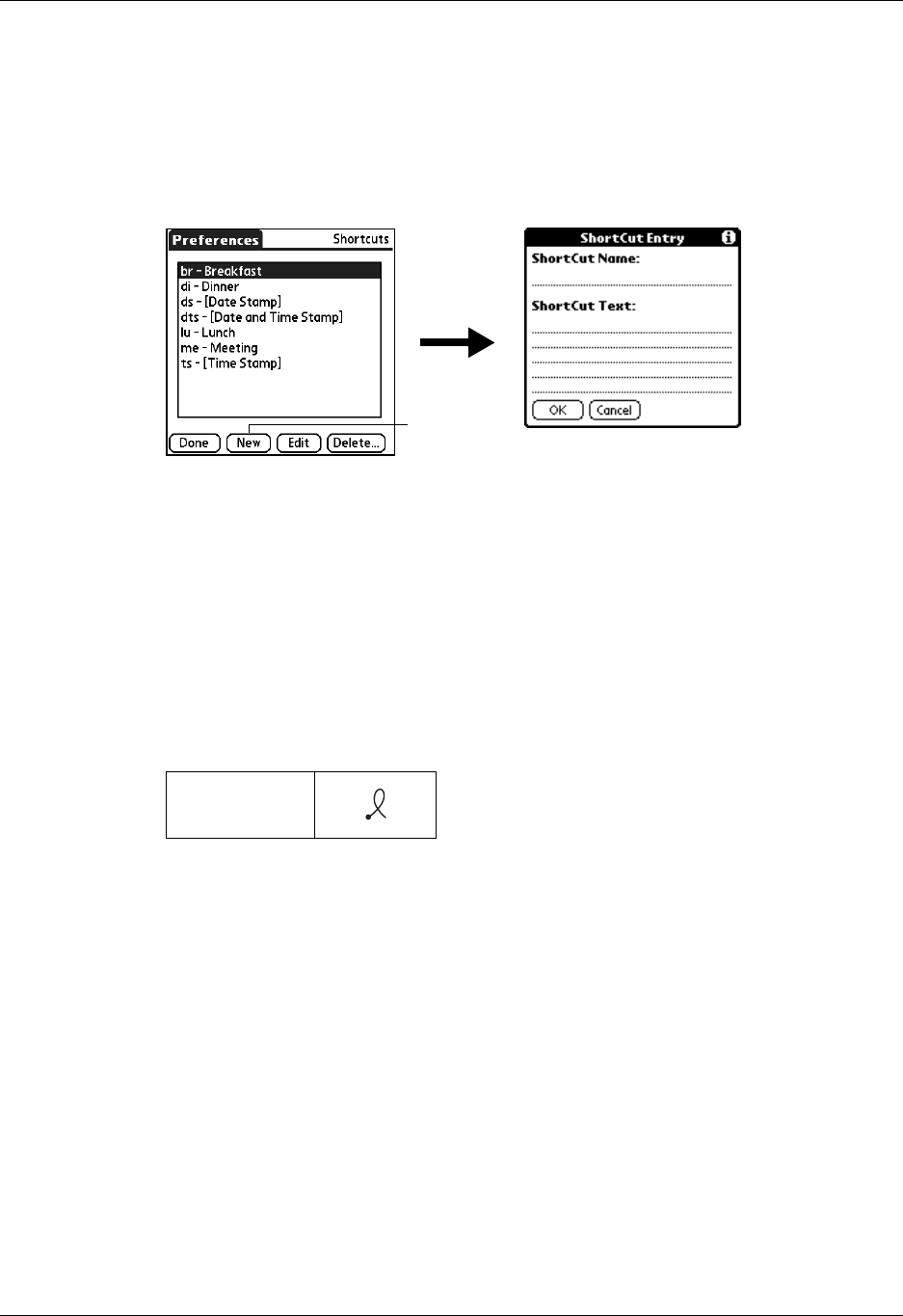
Chapter 17 Setting Preferences for Your Handheld
238
To create a ShortCut:
1. From the Personal Preferences screen, select Shortcuts.
2. Tap N ew.
3. On the ShortCut name line, enter the letters you want to use to activate the
ShortCut.
4. Tap the ShortCut Text area, and enter the text that you want to appear when
you write the ShortCut characters.
TIP You may want to add a space character after the last word in your ShortCut
text. This way, a space automatically follows the ShortCut text.
5. Tap OK.
To use a ShortCut, draw the ShortCut stroke followed by the ShortCut
characters. When you draw the ShortCut stroke, the ShortCut symbol appears
at the insertion point to show that you are in ShortCut mode.
6. Tap Don e.
Editing a ShortCut
After you create a ShortCut, you can modify it at any time.
To edit a ShortCut:
1. From the Personal Preferences screen, select Shortcuts.
2. Select the ShortCut you want to edit.
3. Tap Edit.
4. Make the changes you want.
5. Tap OK.
6. Tap Don e.
ShortCut
Ta p N e w
Palm, Inc. Confidential

Setting Personal Preferences
239
Deleting a ShortCut
If you no longer need a ShortCut, you can delete it from the list of ShortCuts.
To delete a ShortCut:
1. From the Personal Preferences screen, select Shortcuts.
2. Select the ShortCut you want to delete.
3. Tap Delete.
4. Tap Yes.
5. Tap Don e.
Palm, Inc. Confidential

Chapter 17 Setting Preferences for Your Handheld
240
Palm, Inc. Confidential

241
APPENDIX A
Maintaining Your Handheld
This chapter provides information on the following:
■Caring for your handheld
■Prolonging battery life
■Resetting your handheld
Caring for your handheld
Your handheld is designed to be rugged and reliable and to provide years of
trouble-free service. Observe the following general tips when using your
handheld:
■Take care not to scratch the screen of your handheld. Keep the screen clean.
When working with your handheld, use the supplied stylus or plastic-tipped
pens intended for use with a touch-sensitive screen. Never use an actual pen or
pencil or other sharp object on the surface of the handheld screen.
■Your handheld is not waterproof and should not be exposed to rain or moisture.
Under extreme conditions, water may enter the circuitry through the front
panel buttons. In general, treat your handheld as you would a pocket calculator
or other small electronic instrument.
■Take care not to drop your handheld or subject it to any strong impact. Do not
carry your handheld in your back pocket; if you sit on it, you may damage it.
■Protect your handheld from temperature extremes. For example, do not leave
your handheld on the dashboard of a car on a hot day or on a day when
temperatures are below freezing, and keep it away from heaters and other heat
sources.
■Do not store or use your handheld in any location that is extremely dusty,
damp, or wet.
■Use a soft, damp cloth to clean your handheld. If the surface of the handheld
screen becomes soiled, clean it with a soft cloth moistened with a diluted
window-cleaning solution.
Palm, Inc. Confidential

Appendix A Maintaining Your Handheld
242
Prolonging battery life
Note the following considerations for the battery in your handheld:
■Under normal conditions your handheld battery should remain charged when
you place it in the cradle/cable for just a few minutes each day. You can
conserve battery life by doing any of the following:
– Turn off or reduce the brightness of the backlight feature. See “Using the
backlight” in Chapter 2 for more information.
– Change the Auto-off setting that automatically turns the handheld off after
a period of inactivity. See “Auto-off after” in Chapter 17 for more
information.
– Turn off the Bluetooth feature when you’re not using it. See “Bluetooth
Preferences” in Chapter 17 for more information.
– Minimize accessing the expansion card slot.
■If the battery becomes low in the course of normal use, an alert appears on the
handheld screen, describing the low battery condition. If this alert appears,
perform a HotSync® operation to back up your data; then leave your handheld
in the cradle/cable to recharge the unit. This helps prevent accidental data loss.
■If the battery drains to the point where your handheld does not operate, it stores
your data safely for about a week. In this case there is enough residual energy
in the battery to store the data, but not enough to turn on your handheld. If your
handheld does not turn on when you press the power button, you should
recharge the unit immediately. The battery may not have enough residual
energy to power the indicator light, which is normally green when the battery
is charging.
■If your battery drains and you have the unit in an uncharged state for an
extended period of time, you can lose all your stored data.
■There are no serviceable parts inside your handheld, so do not attempt to open
the unit.
■If you ever dispose of your handheld, please dispose of it without damaging the
environment. Take your handheld to your nearest environmental recycling
center.
Resetting your handheld
Under normal circumstances you will not have to use the reset button. On rare
occasions, however, your handheld may no longer respond to buttons or to the
screen. In this case you need to perform a reset to get your handheld running
again.
Palm, Inc. Confidential
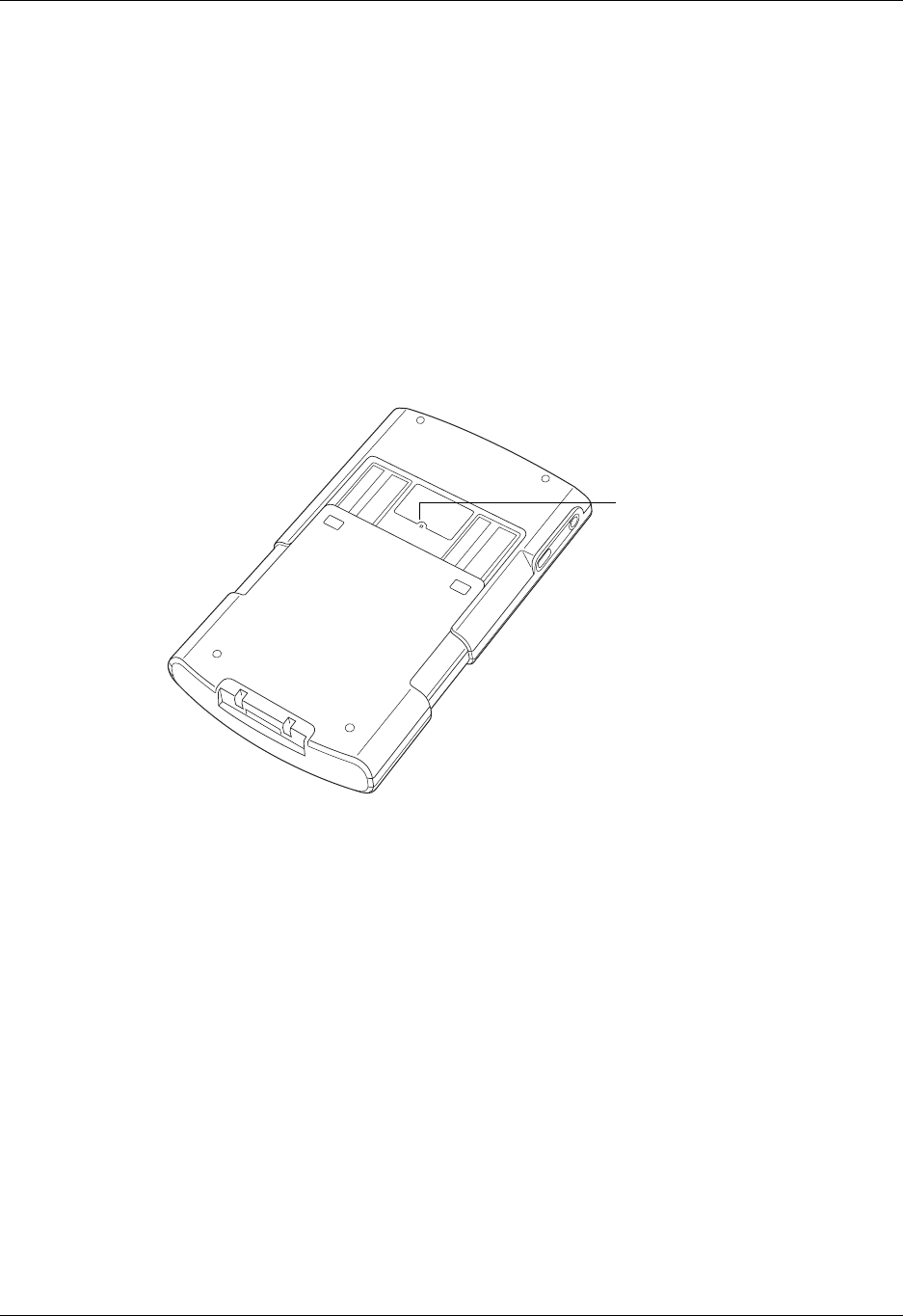
Resetting your handheld
243
Performing a soft reset
A soft reset tells your handheld to stop what it’s doing and start over again. All
records and entries stored in your handheld are retained with a soft reset. After a
soft reset, the Preferences screen appears and the Date and Time option is
highlighted so you can reset the date and time if needed.
To perform a soft reset:
1. Open your handheld. See “Opening and closing your handheld” in Chapter 2
for details.
2. Use the tip of your stylus or an unfolded paper clip (or similar object without a
sharp tip), to gently press the reset button inside the hole on the back panel of
your handheld.
Performing a hard reset
With a hard reset, all records and entries stored in your handheld are erased.
Never perform a hard reset unless a soft reset does not solve your problem.
NOTE You can restore any data previously synchronized with your computer during
the next HotSync operation.
To perform a hard reset:
1. Open your handheld. See “Opening and closing your handheld” in Chapter 2
for details.
2. Press and hold the power button on the top panel of the handheld.
3. While holding the power button, use the tip of your stylus or an unfolded paper
clip (or similar object without a sharp tip) to gently press and release the reset
button.
Reset button
Palm, Inc. Confidential
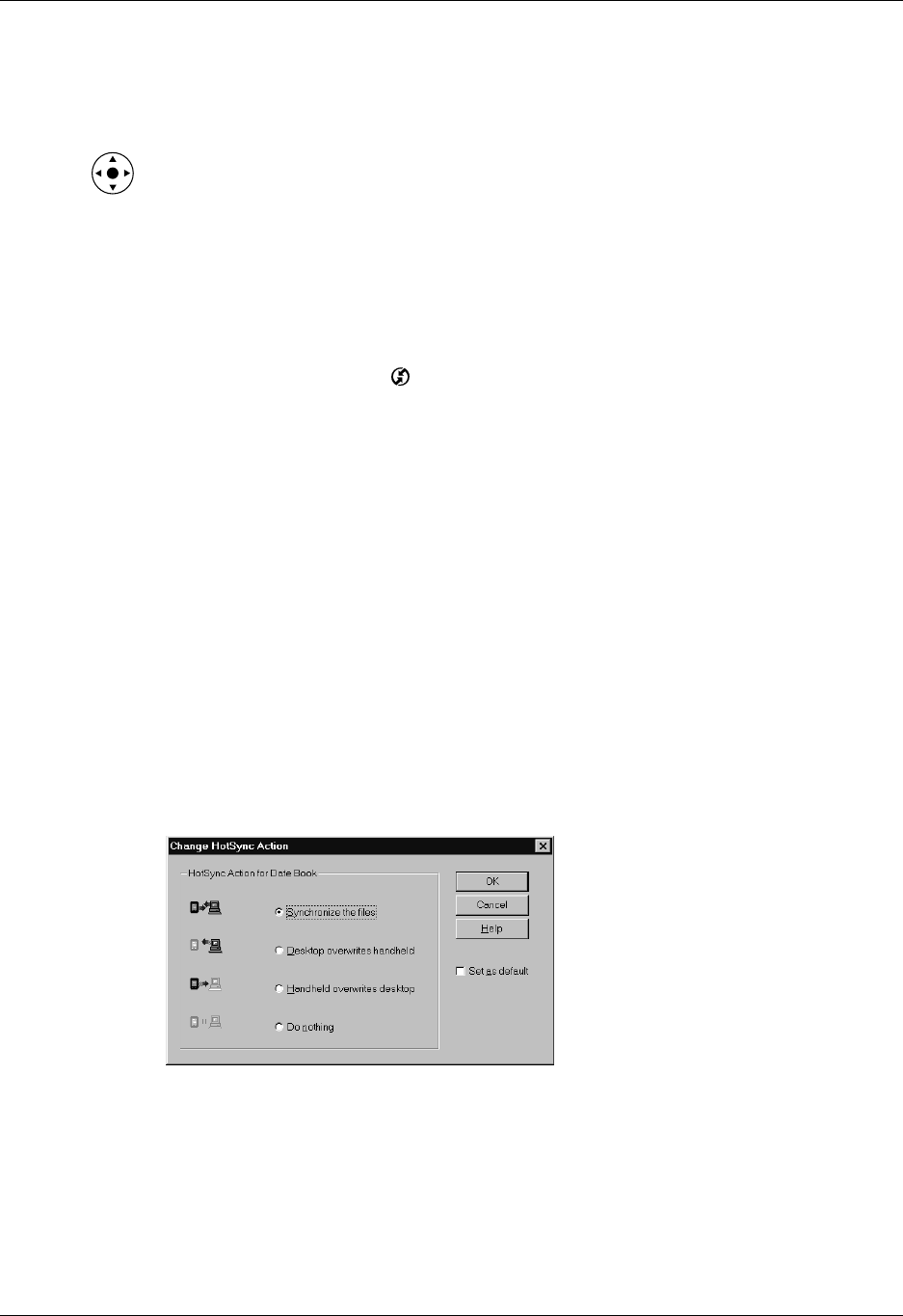
Appendix A Maintaining Your Handheld
244
4. Wait for the Palm Powered™ logo to appear; then release the power button.
5. When a message appears on the handheld screen warning that you are about to
erase all the data stored on your handheld, do one of the following:
– Press Up on the navigator to complete the hard reset and display the
Digitizer screen.
– Press any other button to perform a soft reset.
NOTE With a hard reset, the current date and time are retained. Formats
Preferences and other settings are restored to their factory default settings.
To restore your data from a Windows computer after a hard reset:
1. Click the HotSync icon ™ in the Windows system tray (bottom-right corner
of the taskbar).
You can also click the HotSync command on the Palm Desktop software
menu bar.
2. From the HotSync Manager menu, select Custom.
3. Select the appropriate user name from the list.
4. Select an application in the Conduit list.
5. Click Change.
6. Select Desktop overwrites handheld for each conduit.
Changing the HotSync setting from the default affects only the next HotSync
operation. Thereafter, the HotSync Actions revert to their default settings. To
use a new setting on an ongoing basis, select the Set As Default box. Thereafter,
whatever you selected as the default setting is used when you click the Default
button in the Custom dialog box.
7. Click OK.
8. Repeat steps 4 through 6 to change conduit settings for other applications.
9. Click Done to activate your settings.
10. Perform a HotSync operation.
Palm, Inc. Confidential
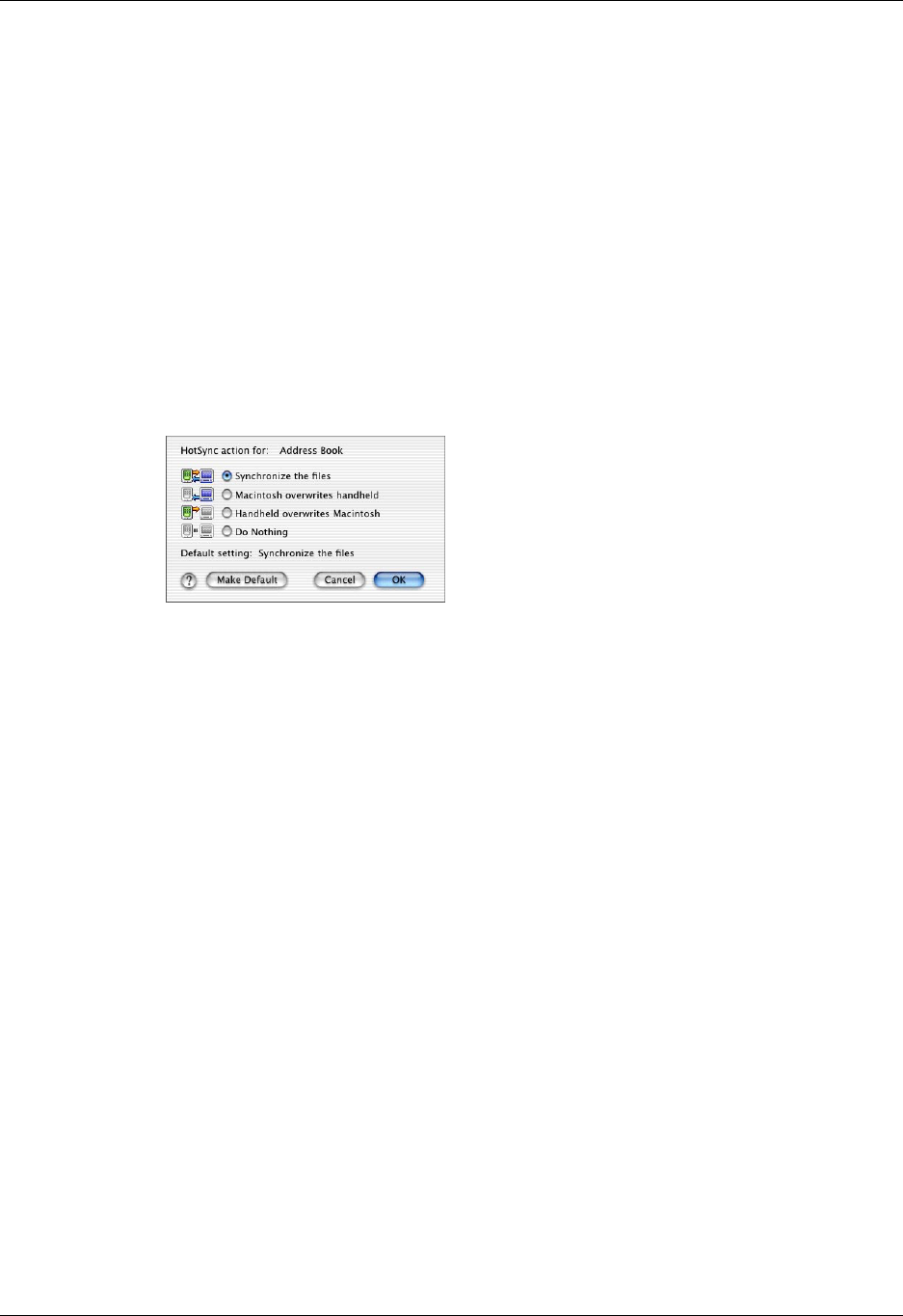
Resetting your handheld
245
To restore your data from a Mac computer after a hard reset:
1. Double-click the HotSync Manager in the Palm folder.
2. From the HotSync menu, select Conduit Settings.
3. From the Users pop-up menu, select the appropriate user name.
4. Select an application from the list.
5. Click Conduit Settings.
6. Click Macintosh overwrites handheld for each conduit.
Changing the HotSync setting from the default affects only the next HotSync
operation. Thereafter, the HotSync Actions revert to their default settings. To
use a new setting on an ongoing basis, click Make Default. Thereafter, whatever
you selected as the default setting is used for HotSync operations.
7. Click OK.
8. Repeat steps 4 through 6 to change conduit settings for other applications.
9. Close the Conduit Settings window.
10. Perform a HotSync operation.
Palm, Inc. Confidential

Appendix A Maintaining Your Handheld
246
Palm, Inc. Confidential

247
APPENDIX B
Frequently Asked Questions
If you encounter a problem with your handheld, do not call Technical Support
until you have reviewed the frequently asked questions in this appendix and you
have also reviewed the following:
■The README file located in the folder where you installed the Palm™ Desktop
software on your Windows computer or on your installation CD for Mac users
■The Palm Desktop online Help
■The Palm Desktop software for the Macintosh User’s Guide located in the
Documentation folder on your installation CD
■The Palm Knowledge Library, accessible at www.palm.com under the Support
section
■The most recent Palm™ Tungsten™ T handheld HelpNotes on your regional
web site
If you are still having problems, contact Technical Support or go to
www.palm.com/support.
NOTE Palm works with developers of third-party add-on applications to ensure the
compatibility of these applications with your new Palm™ handheld. Some third-party
applications, however, may not have been upgraded to be compatible with your new
Palm handheld.
If you suspect that a third-party application is adversely affecting the operation of
your handheld, contact the developer of the application. In addition, Palm, Inc. has
information about some applications' compatibility with your handheld. To find this
information, do one of the following:
■Go to www.palm.com/support. Click the link for information about your
handheld, and then find the information on compatibility of third-party
applications.
■Read the readme file for your handheld. After you install Palm Desktop
software on your computer, open the Palm folder. The readme file is located in
the Helpnote folder.
Palm, Inc. Confidential

Appendix B Frequently Asked Questions
248
Software installation problems
Problem Solution
The Palm Desktop Installer
menu did not appear when I
inserted the CD-ROM into my
Windows computer.
1. From the Windows desktop, click Start.
2. Select Run.
3. Click Browse.
4. Locate your CD-ROM drive, and select the Autorun file.
5. Click Open.
6. Click OK.
I cannot install Palm Desktop
software on my Windows
computer.
Try the following:
1. Disable any virus scanning software on your computer.
2. Close any open applications
3. Make sure your computer has at least 50MB of disk space
available.
4. Delete all temporary files.
5. Run ScanDisk (or another disk verification tool) on your
computer.
6. Uninstall, and then reinstall Palm Desktop software.
I cannot install Palm Desktop
software on my Mac computer.
Try the following:
1. Disable any virus scanning software on your computer.
2. Quit any open applications.
3. Make sure your computer has at least 50MB of disk space
available.
4. Uninstall, and then reinstall Palm Desktop software.
Palm, Inc. Confidential

Operating problems
249
Operating problems
Problem Solution
I don’t see anything on my
handheld’s screen.
Try each of these in turn:
■Press an application button to ensure that your handheld is
turned on.
■Tap the Brightness icon in the upper-right corner of the
Graffiti® writing area. If the Brightness dialog box appears,
adjust the brightness by pressing and holding Up on the
navigator for a few seconds. If this doesn’t work, press and
hold Down on the navigator for a few seconds.
■If your handheld was exposed to cold, make sure it is at
room temperature.
■Charge your handheld.
■Perform a soft reset. If your handheld still doesn’t turn on,
perform a hard reset. See “Resetting your handheld” in
Appendix A.
IMPORTANT With a hard reset, all records and entries stored
in your handheld are erased. Never perform a hard reset
unless a soft reset does not solve your problem. You can
restore any data previously synchronized with your computer
during the next HotSync® operation.
I get a warning message
telling me my handheld
memory is full.
■Purge records from Date Book and To Do List. This deletes
To Do List items and past Date Book events from the
memory of your handheld. See “Purging records” in
Chapter 4. You must perform a HotSync operation to
recover the memory.
■Delete unused memos and records. If necessary, you can
save these records. See “Deleting records” in Chapter 4. You
must perform a HotSync operation to recover the memory.
■If you have installed additional applications on your
handheld, remove them to recover memory. See “Removing
applications” in Chapter 4.
My handheld keeps turning
itself off.
Your handheld is designed to turn itself off after a period of
inactivity. This period can be set at 30 seconds or at one, two,
or three minutes. Check the Auto-off after setting on the Power
Preferences screen. See “Power Preferences” in Chapter 17.
Palm, Inc. Confidential

Appendix B Frequently Asked Questions
250
Tapping and writing problems
My handheld is not making any
sounds.
Check the System, Alarm, and Game Sound settings.
See “Sounds & Alerts Preferences” in Chapter 17.
My handheld’s indicator light is
not blinking when alarms
occur.
Check the Alarm indicator light setting. See “Alarm LED and
Alarm Vibrate settings” in Chapter 17.
My handheld does not vibrate
when alarms occur.
Check the Alarm Vibrate setting. See “Alarm LED and Alarm
Vibrate settings” in Chapter 17.
My handheld has frozen. ■If a network connection was improperly terminated, your
handheld may appear to be frozen for up to 30 seconds. If it
is still frozen after 30 seconds, perform a soft reset.
■Perform a soft reset. See “Resetting your handheld” in
Appendix A.
Problem Solution
When I tap the buttons or
screen icons, my handheld
activates the wrong feature.
Calibrate the screen. See “Digitizer Preferences” in Chapter 17.
When I tap the Menu icon ,
nothing happens.
Not all applications or screens have menus. Try changing to a
different application.
I can’t get my handheld to
recognize my handwriting.
■For your handheld to recognize handwriting input with the
stylus, you need to use Graffiti writing. See “Using Graffiti
writing to enter data” in Chapter 3.
■Make the Graffiti character strokes in the Graffiti writing
area, not on the display part of the screen.
■Write Graffiti strokes for letters in the left side and the
strokes for numbers in the right side of the Graffiti
writing area.
■Make sure that Graffiti is not shifted into extended or
punctuation modes. See “Using Graffiti writing to enter
data” in Chapter 3.
■See “Graffiti tips” in Chapter 3 for tips on increasing your
accuracy when you write Graffiti characters.
Palm, Inc. Confidential

Application problems
251
Application problems
Problem Solution
I tapped the Today button, but
it does not show the correct
date.
Your handheld is not set to the current date. Make sure the Set
Date box on the Date and Time Preferences screen displays the
current date. See “Date & Time Preferences” in Chapter 17 for
more information.
I know I entered some records,
but they do not appear in the
application.
■Check the Categories pick list (upper-right corner). Select
All to display all the records for the application.
■Check Security and confirm that Private Records is set to
Show private records.
■In To Do List, tap Show and see if Show Only Due Items is
selected.
I’m having problems listing
memos, notes, or voice memos
the way I want to see them.
■If you cannot manually arrange the order of memos, notes,
or voice memos on the list screen, select Preferences from
the Options menu and make sure that Sort by is set to
Manual.
■If you choose to view your memos, notes, or voice memos
alphabetically on Palm Desktop software and then perform
a HotSync operation, the memos on your handheld still
appear in the order defined in the Preferences setting. In
other words, the sort settings you use with Palm Desktop
software are not transferred to your handheld.
I created an event in Date Book,
but it doesn’t appear in the
Week View.
If you have two or more events with the same start time, the
first event created appears as a gray bar, and any subsequent
conflicting events appear as a single red bar. To see the
overlapping events select the Day View.
My vCard or vCal e-mail
attachment isn’t forwarding
correctly.
Palm Desktop software provides several features that interact
with e-mail client software on a Windows computer. For these
features to work correctly, the e-mail client software must be
properly configured. Follow these steps to check the
configuration:
1. Click the Windows Start menu, and then select Settings.
2. Select Control Panel.
3. Select Internet Options, and then click the Programs tab.
4. Make sure that the E-mail field is set to the correct e-mail
client software.
Palm, Inc. Confidential

Appendix B Frequently Asked Questions
252
HotSync problems
My vCard or vCal e-mail
attachment isn’t forwarding
correctly (continued).
5. Click OK.
6. Start the e-mail client software and make sure it is
configured as the default MAPI client. Consult the
documentation for your desktop e-mail application for
more information.
The current date and time are
incorrect.
The current date and time are tied to the Location setting. If
you change the date and time without changing the Location
setting, the current date and time may appear incorrect.
See “Date & Time Preferences” in Chapter 17 for information
on setting the current location, date, and time.
Problem Solution
I cannot perform a HotSync
operation. What should I check
to make sure I’m doing it
correctly?
■Make sure the HotSync cradle/cable is connected securely.
On a Windows computer try these steps:
1. Check the Windows system tray to make sure the HotSync
Manager is running. If it is not, click Start on the Windows
taskbar, and then select Programs. Navigate to the Palm
Desktop software program group, and select HotSync
Manager. You should also see “Selecting HotSync setup
options” in Chapter 16 for instructions on selecting the
correct HotSync Manager settings.
2. Make sure you selected Local USB or Local Serial, as
appropriate, from the HotSync Manager menu.
3. If you are using the serial cradle/cable, make sure you
selected the correct serial port on the Local tab in the Setup
dialog box. It should be set to the port where you connected
the HotSync cradle/cable.
Palm, Inc. Confidential

HotSync problems
253
I cannot perform a HotSync
operation. What should I check
to make sure I’m doing it
correctly (continued)?
On a Mac computer try these steps:
1. Make sure HotSync Manager is enabled. If it is not, double-
click the HotSync Manager icon in the Palm folder and
enable HotSync Manager on the HotSync Controls tab.
2. If you are using a USB cradle/cable, disconnect the cradle/
cable from your computer, and then reconnect the cradle/
cable and restart your computer.
3. If you are using the optional serial cradle/cable, double-
click the HotSync Manager icon in the Palm folder and then
click the Connection Settings tab. Make sure the port
selection matches the port where your HotSync cradle/
cable is attached.
I did a HotSync operation, but
one of my applications did not
synchronize.
■On a Windows computer, click the HotSync Manager and
select Custom. Check that the correct conduit is active.
■On a Mac computer, double-click the HotSync Manager
icon. From the HotSync menu, select Conduit Settings.
Select your user name from the User pop-up menu, and
check that the correct conduit is active.
I am using Outlook as my PIM,
but I cannot do a HotSync
operation.
■Click the HotSync Manager and select Custom. Check that
the correct conduit is active.
■Check that the correct conduit is installed. Reinstall the
HotSync Manager and make sure that the correct conduit is
selected.
■Reinstall Palm Desktop software and select the option to
synchronize with Microsoft Outlook.
I cannot launch the HotSync
Manager.
■If you are using the optional serial cradle/cable, or if you are
performing a HotSync operation using a modem, make sure
you are not running another program, such as America
Online, that uses the serial port you selected in the Setup
dialog box.
■Make a backup copy of your Palm Desktop data, and then
reinstall Palm Desktop software.
Palm, Inc. Confidential

Appendix B Frequently Asked Questions
254
I tried to do a local HotSync
operation, but it did not
complete successfully.
■Make sure your handheld is seated in the cradle/cable
correctly.
■Check the connection between the HotSync cradle/cable
and the USB or serial port on your computer.
■Make sure the user name you selected in Palm Desktop
software matches the user name assigned to your handheld.
■Make sure the date on your computer matches the date on
your handheld.
■Read the HotSync Log for the user account for which you
are performing a HotSync operation
On a Windows computer, try each step in turn:
■Make sure that HotSync Manager is running. If it is running,
close it and restart it.
■Make sure you selected Local USB or Local Serial, as
appropriate, from the HotSync Manager menu.
■If you are using the serial cradle/cable, make sure you
selected the correct serial port on the Local tab in the Setup
dialog box. It should be set to the port where you connected
the HotSync cradle/cable.
■If you are using the serial cradle/cable, try a lower baud rate
setting on the Local tab in the Setup dialog box.
■If you are using the serial cradle/cable, make sure you
aren’t running a program, such as America Online, that uses
the serial port you selected in the Setup dialog box.
On a Mac computer, try each step in turn:
■Make sure HotSync Manager is enabled on the HotSync
Controls tab in the HotSync Software Setup window.
■If you are using the optional serial cradle/cable, double-
click the HotSync Manager icon in the Palm folder and then
click the Connection Settings tab. Make sure the port
selection matches the port where your HotSync cradle/
cable is attached.
■If you are using the optional serial cradle/cable, try a lower
Speed setting on the Connection Settings tab
■If you are using the optional serial cradle/cable, make sure
you aren’t running a program, such as America Online, fax
or telephony software, or AppleTalk networking, that uses
the serial port you selected in the Connection Settings tab.
Palm, Inc. Confidential

HotSync problems
255
I tried to do a modem HotSync
operation, but it did not
complete successfully.
Check the following on your computer:
■Make sure your computer is turned on and that it does not
shut down automatically as part of an energy-saving
feature.
■Make sure the modem connected to your computer is
turned on and is connected to the outgoing phone line.
■Make sure the modem you are using with your handheld
has an on-off switch. Your handheld cannot “wake up” a
modem that has an auto-off feature.
■Make sure the modem is connected properly to your
computer and is connected to the incoming phone line.
On a Windows computer, check the following:
■Make sure that Modem is selected in the HotSync Manager
menu.
■Confirm that the Setup String in the Setup dialog box
configures your modem correctly. You may need to select a
different Modem Type or enter a custom setup string. Most
modems have a setup string that causes them to send initial
connection sounds to a speaker. You can use these sounds to
check the modem connection.
■Confirm that the Speed setting in the Setup dialog box
works for your modem. If you have problems using the As
Fast As Possible option or a specific speed, try using a
slower speed.
■Make sure you are not running another program, such as
WinFax, CompuServe, or America Online, that uses the
serial port you selected in the Setup dialog box.
■Make sure your modem resets before you try again. (Turn
off your modem, wait a minute, and then turn it back on.)
Palm, Inc. Confidential

Appendix B Frequently Asked Questions
256
I tried to do a modem HotSync
operation, but it did not
complete successfully
(continued).
On a Mac computer, check the following:
■Make sure that Internal Modem is selected on the
Connection Settings tab in the HotSync Software Setup
window.
■You may need to select a different modem type or enter a
custom setup string from the Connection Settings tab. Most
modems have a setup string that causes them to send initial
connection sounds to a speaker. You can turn on the Modem
Speaker option and use these sounds to check the modem
connection.
■Make sure you are not running another program, such as
America Online, fax or telephony software, or AppleTalk
networking, that uses the serial port you selected in the
Connection Settings tab.
■Make sure your modem resets before you try again. (Turn
off your modem, wait a minute, and then turn it back on.)
Check the following on your handheld:
■Confirm that the telephone cable is securely attached to
your modem.
■Make sure the dialing instruction specifies the correct phone
number.
■If you need to dial an outside line prefix, make sure you
selected the Dial Prefix option on your handheld and
entered the correct code.
■If the telephone line you are using has Call Waiting, make
sure you selected the Disable call waiting option under
Modem Sync Phone Setup on your handheld and entered
the correct code.
■Make sure the telephone line you are using is not noisy,
which can interrupt communications.
■Check the batteries in your modem, and replace them if
necessary.
Palm, Inc. Confidential

HotSync problems
257
I can’t perform an IR HotSync
operation.
■On a computer running Windows 98, be sure that the
HotSync Manager is running, that Infrared is selected on the
HotSync Manager menu, and that the Serial Port for local
operations is set to the simulated port for infrared
communication. See “Conducting IR HotSync operations”
in Chapter 16 for details.
■On a computer running Windows 2000/ME/XP, select IR in
the HotSync Manager. See “Preparing your computer for
infrared communication” in Chapter 16 for details.
■On a Mac computer, make sure the infrared
communications extensions have been installed in the
Extensions folder inside the System folder. Next, open the
HotSync Software Setup window, and be sure that HotSync
Manager is enabled and that the Local Setup Port is set to
Infrared Port. See “Conducting IR HotSync operations” in
Chapter 16 for more information.
■On your handheld, be sure the HotSync application is set to
Local, with the option IR to PC/Handheld.
■Be sure the IR port of your handheld is aligned directly
opposite to, and within a few inches of, the infrared device
of your computer.
■IR HotSync operations do not work after you receive a low
battery warning. Check the battery power of your
handheld. Recharge the internal battery.
My handheld appears to freeze
when I place it near my
computer.
Move your handheld away from the computer’s infrared port.
When I press the HotSync
button on the cradle/cable,
nothing happens on Palm
Desktop software, and my
handheld times out.
■Make a copy of your Palm folder. Uninstall, and then
reinstall Palm Desktop software.
■Turn on your handheld, and tap the Home icon . Select
the HotSync icon ™, and then tap Local.
Palm, Inc. Confidential

Appendix B Frequently Asked Questions
258
When I perform a HotSync
operation, my information does
not transfer to Palm Desktop
software.
■If you have performed a HotSync operation successfully but
you cannot find the data from your handheld on Palm
Desktop software, check to see that you have the correct
user name selected for viewing data.
■On a Windows computer, click the HotSync Manager and
select Custom. Check that all conduits are set to synchronize
files.
■On a Mac computer, double-click the HotSync Manager
icon. From the HotSync menu, select Conduit Settings.
Select your user name from the User pop-up menu, and
check that the correct conduit is active.
My handheld displays the
message “Waiting for sender”
when it’s near my computer’s
infrared port.
■Your computer’s infrared port may be set to search
automatically for the presence of other infrared devices.
Consult the documentation for your operating system for
information about turning off this option.
■In some cases simply moving your handheld away from the
computer’s infrared port solves the problem.
I want to synchronize my
computer with more than one
handheld.
■If the computer running Palm Desktop software
synchronizes with more than one handheld, each handheld
must have a unique name. Assign a user name to your
handheld the first time you perform a HotSync operation.
■Be aware that synchronizing more than one handheld with
the same user name causes unpredictable results and,
potentially, loss of your personal information.
I can’t perform a Bluetooth
HotSync operation.
■Make sure that Bluetooth communication is enabled on both
your handheld and your computer.
■When you perform a Bluetooth HotSync operation, your
handheld attempts to connect to a Bluetooth virtual serial
port on your computer. First it looks for a Bluetooth serial
HotSync port. If it cannot find that port, it then looks for a
generic Bluetooth serial port. However, some generic
Bluetooth serial ports do not support HotSync operations.
■Your handheld may not be able to recognize the virtual
serial port on your Windows computer. Try validating the
virtual serial port you’re using, or create a different virtual
port and change the HotSync Manager settings to use the
new virtual port. Refer to the documentation that came with
your computer operating system for instructions.
Palm, Inc. Confidential

Beaming and sending problems
259
Beaming and sending problems
I can’t perform a Bluetooth
HotSync operation (continued).
■Some computers have a dedicated virtual serial port
number, such as COM5, and other computers enable you to
choose a port number such as COM8 or COM12. Refer to the
documentation that came with your computer for
information on dedicated versus flexible virtual ports.
■If the virtual serial port you want to use is used by other
applications, exit those applications before setting up your
computer for a Bluetooth HotSync operation.
I receive an authentication error
when I try to perform a
HotSync operation using
Bluetooth and a wireless LAN
access point.
■Make sure you entered the correct user name and password
for the selected network service profile in the Network
Preferences screen. See “Network preferences” in
Chapter 17 for details.
When I try to perform a
HotSync operation using
Bluetooth and a wireless LAN
access point, it connects but
nothing happens.
■Make sure that Network is selected on the HotSync
Manager menu on your computer.
■Contact your system administrator to make sure you
network computer is properly set up.
Problem Solution
I cannot beam data to another
device with an IR port.
■If you are beaming to another Palm handheld, confirm that
your handheld and the other handheld are between ten
centimeters (approximately 4") and one meter
(approximately 39") apart and that the path between the two
handhelds is clear of obstacles. Beaming distance to other
devices with an IR port may be different.
■Move your handheld closer to the receiving device.
When someone beams data to
my handheld, I get a message
telling me it is out of memory.
■Your handheld requires at least twice the amount of
memory available as the data you are receiving. For
example, if you are receiving a 30KB application, you must
have at least 60KB free.
■Perform a soft reset. See “Performing a soft reset” in
Appendix A for more information.
I cannot send data to another
Bluetooth-enabled device.
■Make sure that Bluetooth communication is enabled on both
your handheld and the other device.
■Make sure that the receiving device has a compatible,
Bluetooth-enabled application installed.
Palm, Inc. Confidential

Appendix B Frequently Asked Questions
260
Phone connection problems
Problem Solution
My passkey is rejected when I
attempt to pair (or bond) my
mobile phone with my
handheld.
■Some mobile phones require that you enter the passkey
within a specific timeframe. Make sure you have a passkey
in mind and that you enter it immediately when prompted.
■If your passkey is rejected, your phone may have a
preassigned passkey; see the documentation included with
your phone for information. The documentation might
refer to a Bluetooth connection as a Bluetooth pair or a
Bluetooth link.
■If you need additional information about pairing your
phone and handheld, refer to the Phone Pairing Handbook for
Palm™ Tungsten™ T Handheld at www.palm.com/support.
My handheld cannot connect to
my mobile phone.
■Use the following steps to test the connection:
1. Tap the Home icon .
2. Select the Phone Link icon .
3. Tap Connect.
4. If the connection is successful, open the application that
requires the connection and complete the desired task.
If the connection is not successful, try the steps that follow.
■If you have a Bluetooth-enabled phone, you may need to go
through the pairing process on both your handheld and
your phone. See “Setting up a phone connection” in
Chapter 12 for information on completing the pairing
process on your handheld. See the documentation included
with your phone for assistance with completing the pairing
process on your phone. If you need additional information
about connecting your phone, refer to the Phone Pairing
Handbook for Palm™ Tungsten™ T Handheld at
www.palm.com/support.
■Make sure the Connection for your mobile phone is
selected in the Connection Preferences screen and the
Phone Preferences screen.
■If you are using a Bluetooth connection, make sure that
your phone is equipped with Bluetooth technology, that
Bluetooth is enabled, and that the power is on.
Palm, Inc. Confidential

Recharging problems
261
Recharging problems
My phone connection drops
before I finish using it.
■You need to increase the Idle timeout setting on the
Network Preferences Details screen. See “Adding detailed
information to a network service profile” in Chapter 17 for
instructions.
I get an error message when I try
to dial a phone number using
my handheld.
■Make sure that the proper phone driver is installed on your
handheld. See “Updating the phone files on your
handheld” in Chapter 12 for instructions.
■You may need to go through the pairing process on both
your handheld and your phone. See “Connection
Preferences” in Chapter 17 for information on completing
the pairing process on your handheld. See the
documentation included with your phone for assistance
with completing the pairing process on your phone.
■Check the Phone Preferences screen and make sure the
correct phone connection is selected.
Problem Solution
When I place my handheld in
the cradle/cable, the indicator
light does not go on.
■Confirm that your handheld is well seated in the cradle/
cable.
■Confirm that your recharger cable is properly connected to
the back of the cradle/cable’s USB or serial port connector
that plugs into your computer.
■Confirm that your recharger is plugged into an AC outlet
that has power.
■If you have not used your handheld for a long period, such
as an extended vacation, the battery may not contain
enough charge to power the indicator light. After your
handheld has recharged, the indicator light will function
normally.
Palm, Inc. Confidential

Appendix B Frequently Asked Questions
262
Password problems
Problem Solution
I forgot the password, and my
handheld is not locked.
■First, use the password hint to try and remember the
password. If this doesn’t help or if you do not have a
password hint, you can use Security to delete the password,
but your handheld deletes all entries marked as private.
However, if you perform a HotSync operation before you
delete the password; the HotSync process backs up all
entries, whether or not they are marked private. Then you
can follow these steps to restore your private entries:
a. Use the Palm Desktop software and the cradle/cable or
infrared communication to synchronize your data.
b. Tap Forgotten Password in Security to remove the
password and delete all private records.
c. Perform a HotSync operation to synchronize your data
and restore the private records by transferring them from
your computer to your handheld.
I forgot the password, and my
handheld is locked.
■First, use the password hint to try and remember the
password. If this doesn’t help or if you do not have a
password hint, you must perform a hard reset to continue
using your handheld. See “Performing a hard reset” in
Appendix A for more information.
Palm, Inc. Confidential

Technical support
263
Technical support
If, after reviewing the sources listed at the beginning of this appendix, you cannot
solve your problem, go to www.palm.com/support or send an e-mail to your
regional technical support office.
Before requesting support, please experiment a bit to reproduce and isolate the
problem. When you do contact support, please provide the following information:
■The name and version of the operating system you are using
■The actual error message or state you are experiencing
■The steps you take to reproduce the problem
■The version of handheld software you are using and available memory
To find version and memory information:
1. Tap the Home icon .
2. Tap the Menu icon .
3. Select Info from the App menu.
NOTE Palm works with developers of third-party add-on applications to
ensure the compatibility of these applications with your new Palm™ handheld.
Some third-party applications, however, may not have been upgraded to be
compatible with your new Palm handheld.
If you suspect that a third-party application is adversely affecting the operation
of your handheld, contact the developer of the application. In addition, Palm,
Inc. has information about some applications' compatibility with your
handheld. To find this information, do one of the following:
–Go to www.palm.com/support. Click the link for information about your
handheld, and then find the information on compatibility of third-party
applications.
– Read the readme file for your handheld. After you install Palm Desktop
software on your computer, open the Palm folder. The readme file is located
in the Helpnote folder.
4. Tap Version to see version numbers, and tap Size to see the amount of free
memory in kilobytes.
Palm, Inc. Confidential

Appendix B Frequently Asked Questions
264
Palm, Inc. Confidential

265
Product Regulatory Information
FCC Statement
This device complies with part 15 of the FCC rules. Operation is subject to the following two
conditions: (1) This device may not cause harmful interference, and (2) this device must accept any
interference received, including interference that may cause undesired operation.
NOTE This equipment has been tested and found to comply with the limits for a Class B digital device,
pursuant to Part 15 of the FCC rules. These limits are designed to provide reasonable protection against
harmful interference in a residential installation. This equipment generates, uses, and can radiate radio
frequency energy and, if not installed and used in accordance with the instructions, may cause harmful
interference to radio communications. However, there is no guarantee that interference will not occur in a
particular installation. If this equipment does cause harmful interference to radio or television reception,
which can be determined by turning the equipment off and on, the user is encouraged to try to correct the
interference by one or more of the following measures:
■Reorient or relocate the receiving antenna.
■Increase the separation between the equipment and receiver.
■Connect the equipment into an outlet on a circuit different from that to which the receiver is connected.
■Consult the dealer or an experienced radio/TV technician for help.
The use of shielded I/O cables is required when connecting this equipment to any and all optional
peripheral or host devices. Failure to do so may violate FCC rules.
CAUTION Changes or modifications not covered in this manual must be approved in writing by the
manufacturer’s Regulatory Engineering Department. Changes or modifications made without written
approval may void the user’s authority to operate this equipment.
Palm™ Tungsten™ T Product Family
Tested to Comply
With FCC Standards
FOR HOME OR OFFICE USE
Responsible Party:
Palm, Inc.
400 N. McCarthy Boulevard
Milpitas, California 95035
United States of America
(408) 878-9000
Palm, Inc. Confidential

Product Regulatory Information
266
MPE (Maximum Permissible Exposure) Statement
RF Exposure Compliance:
In order for this device to comply with FCC rules, under the provision of Part 15.247(b)(c), it must
operate in a manner that ensures that the public is not exposed to radio frequency energy levels in
excess of the Maximum Permissible Limits (MPE).
It is recommended that the antenna of this device be placed at 20 cm or more from its user and any
nearby persons, during continuous and extended data transmission. The users of this device should
ensure that the operation of this device is in compliance with these provisions.
Canadian IC Notice
Certification No: 3905-550007A
To prevent radio interference to the licensed service, this device is intended to be operated indoors
and away from windows to provide maximum shielding. Equipment that is installed outdoors is
subject to licensing.
Canadian ICES-003 Statement
This Class B digital apparatus meets all requirements of the Canadian Interference-Causing
Equipment Regulations.
Cet appareil numérique de la classe B respecte toutes les exigences du Réglement sur le matériel
brouilleur du Canada.
FAA Statement
Whenever you use the wireless features of your handheld, please observe the guidelines or
prohibitions on the use of wireless devices in your current location. For example, when you are on an
airplane, do not use the Bluetooth communication features of your handheld at times when
government or airline regulations prohibit the use of cellular phones. You can, of course, use all other
applications on your handheld in accordance with airline regulations for electronic devices.
Electrical Transmission Statement
This product has been certified as conforming to technological standards for a wireless device as a
small electrical data transmission under electrical transmission law. Therefore, you do not need a
license from a government agency to operate this product.
This product has been certified as conforming to technological standards. Therefore, the following
action are punishable by law:
Disassembly or modification of this product.
Removal of identification labels on the back of this product.
ARIB STD-T66 Statement (Japan)
This product uses a radio wave in the 2.4 GHz bandwidth. This frequency is also used by the
microwave ovens industry, scientific and medical devices, in addition to wireless transmitters for
motion detectors, such as those requiring licenses used on manufacturing lines or similar radio
transmitters. It is also used in specified amateur radio stations or small radio stations not requiring
licenses (all these wireless devices will be called “other wireless transmitters” below).
Palm, Inc. Confidential

Product Regulatory Information
267
1. Before using this product, confirm that other wireless transmitters are not in use nearby.
2. In the unlikely event that there is electronic interference between this product and other wireless
transmitters, quickly change the operating frequency of this product, change the location of
operation, or stop operating the product (cease transmission of a signal).
3. If other electrical interference or related problems should occur, contact the responsible party.
Europe R&TTE Directive (Europe)
Declaration of Conformity
Application of Council Directive(s):1999/5/EEC, R&TTE EU Directive
Standards to which Conformity is Declared:
EMC standard ETSI 300 826
Radio standard ETSI 300 328-2
Safety standard EN69950
Manufacturer’s Name: Palm, Inc.
Manufacturer’s Location: 400 N. McCarthy Boulevard
Milpitas, CA 95035
USA
Importer’s Name: Palm Germany GmbH
Importer’s Location: Landsberger Strasse 155
D-80687 Munchen, Germany
Type of Equipment: Palm handheld with Bluetooth capability
Model Number: m550
Year of Manufacture: 2002
Applicable countries complying with this declaration: Austria, Belgium, Denmark, Finland, France,
Germany, Greece, Iceland, Ireland, Italy, Luxembourg, Norway, Portugal, Spain, Sweden,
Switzerland, Holland, UK.
I, the undersigned hereby declare that the equipment specified above conforms to the above
Directive(s) and Standard(s)
Place: Milpitas, CA
Signature: _____________________________
Date: June, 29, 2002
Typed Name: David Woo
Title: Global Compliance Manager
Palm, Inc. Confidential

Product Regulatory Information
268
Taiwan Statement
Article 14: Unless approved, for any model accredited low power radio frequency electric machinery,
any company, trader, or user shall not change the frequency, increase the power, or change the
features and functions of the original design.
Article 17: Any use of lower power radio frequency electric machinery shall not affect the aviation
safety and interfere with legal communications. In even that any interference is found, the use of such
electric machinery shall be stopped immediately, and reusing of such products cannot be resumed
until no interference occurs after improvement.
The legal communications mentioned in the above item refer to radio communications operated in
accordance with telecommunication laws and regulations.
Low power radio frequency electric machinery shall resist against interference from legal
communications or from industrial, scientific, and medical radio electric machinery.
Battery Warning
Do not mutilate, puncture, or dispose of batteries in fire. The batteries can burst or explode, releasing
hazardous chemicals. Discard used batteries according to the manufacturer’s instructions and in
accordance with your local regulations.
Varning
Eksplosionsfara vid felaktigt batteribyte. Använd samma batterityp eller en ekvivalent typ som
rekommenderas av apparattillverkaren. Kassera använt batteri enligt fabrikantens instruktion.
Advarsel!
Lithiumbatteri—Eksplosionsfare ved fejlagtig håndtering. Udskiftning må kun ske med batteri af
samme fabrikat og type. Levér det brugte batteri tilbage tilleverandøren.
Varoitus
Paristo voi räjähtää, jos se on virheellisesti asennettu. Vaihda paristo ainoastaan valmistajan
suosittelemaan tyyppiin. Hävitä käytetty paristo valmistajan ohjeiden mukaisesti.
Advarsel
Eksplosjonsfare ved feilaktig skifte av batteri. Benytt samme batteritype eller en tilsvarende type
anbefait av apparatfabrikanten. Brukte batterier kasseres i henhold til fabrikantens instruksjoner.
Waarschuwing!
Bij dit produkt zijn batterijen geleverd. Wanneer deze leeg zijn, moet u ze niet weggooien maar
inleveren als KCA.
Palm, Inc. Confidential

Product Regulatory Information
269
Uwaga
Palm, Inc. Confidential

Product Regulatory Information
270
Palm, Inc. Confidential

271
Index
A
ABA. See Address Book archive files
Accented characters, Graffiti writing 28
Add-on applications 66–71
Address Book
*If Found Call* entry 75
adding custom fields 80
archive files (.aba) 38
business card for beaming 31
categorizing records 54
conduit for synchronizing 160
creating records 50
deleting records 52
displaying category 80
displaying data in the Address list 76
finding records 19–58
fonts 64
menus 79
notes for records 63–64
opening 73
overview 73
private records 200
sorting records 62
Agenda (Date Book view) 100
Alarm
indicator light 12
LED 12, 202
lists 65
preset 103
setting in Date Book 94
setting in Note Pad 120
setting in Voice Memo 144
setting in World Clock 155
sound 103, 156, 201, 250
Vibrate setting 202
Alphabet
Graffiti writing 24
onscreen keyboard 17
Application buttons 11, 41, 73, 89, 117, 133,
234
Applications
Address Book 73
beaming 30–32
Calculator 81
Card Info 85
categories 44–45
Date Book 89
Expense 105
font style 64
installing 66–70
Launcher 41–45
Memo Pad 113
Note Pad 117
opening 42
plug-in 231
preferences for 50
removing 70
sending 33, 34–35, 36–37
size in kilobytes 263
To Do List 133
version of 263
viewing as icons 45
viewing as list 45
Voice Memo 139
World Clock 149
See also Add-on applications
Archive files
importing data from 37
for main applications 38
saving deleted records 53
saving purged records 54
Automatic fill, in Expense 112
Auto-off delay 192
Autotext. See Graffiti ShortCuts
B
Backlight 12, 235
Battery
conserving power 192
disposal 268–269
Palm, Inc. Confidential

Index
272
gauge 41
life and use 242
recharging 6
recycling 242
warning 268–269
Beaming
information 30–32
location of IR port 12
pen stroke to activate 235
problems with 259
See also Infrared
Bluetooth
entering passkey 126, 260
HotSync operations 176–178
making connections 211
phone connection 123–132
Bluetooth preferences
adding trusted devices 207–208
allowing discovery 204–205
allowing wakeup 206–207
assigning device name 204
bonding devices 207
deleting trusted devices 209–210
enabling/disabling 203–204
enabling/disabling the user cache 210
Linking devices 207
pairing devices 207
using 203–210
viewing trusted devices 209
Bold font for text 64
Brightness control 13, 17
Business card for beaming 31
Buttons preferences 234–236
HotSync 236
HotSync buttons 236
pen 235
C
Calculator
buttons explained 81–82
memory 82
overview 81
recent calculations 81, 82
Calibration 16, 190
Call Waiting, disabling 174, 222
Calling card, using in phone settings 174,
222
Capital letters (Graffiti writing) 25
Card Info 85
Caring for the handheld 241
Categories
application 44–45
assigning records to 54–55
beaming 30–31
creating 56
default 44, 54
displaying 55, 80, 251
merging 57
renaming 57
sending 33, 36
using in Applications Launcher 44, 45
Chain calculations 82
Characters, Graffiti 22
Charging handheld 6
Check boxes 18
Clearing Calculator entries 81
Combining categories 57
Comma-delimited files, importing data
from 38
Command
buttons 18
equivalents (Graffiti writing) 49
stroke 32, 49, 60
toolbar 49
Communication preferences 187
Bluetooth 203–211
Connection 211–217
Network 217–233
Phone 233
Compressing Day view 102
Conduits
for modem HotSync operations 175
for synchronizing applications 253, 160–
161, 244, 245
for synchronizing applications,
Macintosh 161–162
Conflicting events 101
Connecting
service templates 218
to server or ISP 223
with a GPRS network 214–215, 217–226
with a non-GSM phone 215–217
with a phone 214–217
Connection preferences 211–217, 220
Continuous events
deleting from Date Book 53
scheduling 95
Palm, Inc. Confidential

Index
273
Contrast control. See Brightness control
Copying
notes into other applications 117
text 52
Country default setting 191
Cradle
connecting to computer 14
for local HotSync operations 163, 170
viewing data from 192
Creating
Address Book entries 74–75
categories 44–45, 56
currency symbols 109
custom fields in Address Book 80
Date Book events 89
Expense items 106
expense reports 111
notes for records 63
records 50
Currency
default 109
defining 109
for Expense items 108
Current date 251
Current time 41
Custom
currencies and symbols 109
fields in Address Book 80
Cutting text 52
Cycling through views 73, 89, 117, 133
D
Data entry. See Entering data
Date
displaying in World Clock 156
Expense item 107
setting current 151, 189, 251
To Do List record due 136–137
Date & Time preferences 189–190
Date Book
adding Address Book data to
records 60–61
Agenda view 100
alarm 94
archive files (.dba) 38
changing event time 93
changing event to untimed 93
conduit for synchronizing 160
conflicting events 101
continuous events 95–97
creating records 50, 90–93
Day view 97
deleting records 52
display options 102
end time for Day view 103
fonts 64
menus 101
Month view 99
notes for records 63–64
opening 89
overview 89
private records 200
purging records 53–54
repeating events 53, 95–97
scheduling events 89–93
selecting dates 91
start time for Day view 103
Sunday or Monday to start week 191
switching views 97
untimed events 90, 92
Week view 98, 191, 251
Day (Date Book view) 90, 102
DBA (Date Book archive file) 38
Decimal point 192
Default
categories 44, 54
currency in Expense 109
Deleted data, saving in archive files 53
Deleting
applications 70
Desktop software 71
Graffiti characters 24
passwords 194
records 52
service templates 231
text 52
See also Purging records
Desktop software
displaying euro 111
linking to external files 39, 181
removing 71, 72
saving deleted data in archive file 53
Device
assigning name 204
enabling/disabling the user cache 210
types with which you can connect 203
Digitizer 16, 190
Palm, Inc. Confidential

Index
274
Discovery
and connection process 205
defined 204
enabling/disabling the user cache 210
DNS 228
Domain name system. See DNS
Double-booked events 101
Dragging
memos into other applications 113
stylus to activate features 235
using the stylus 17
E
Editing records 51–52
E-mail addresses in Address Book 75
Entering data 21–40
importing from other applications 37–40
problems with 250
using Note Pad 40
using the computer keyboard 37
using the onscreen keyboard 21
Entries. See Address Book
Euro
displaying on desktop computer 111
in Expense 108, 109
in Graffiti writing 28
in onscreen keyboard 22
printing 111
Events. See Date Book
Exclamation marks in To Do List 137
Expansion
adding hardware 14
using cards 85–87
Expansion Card
applications 42
copying applications 46
described 15
formatting 86
renaming 86
Expense
adding Address Book data to records 61
categorizing records 54
creating records 106
currency 108
date of item 107
defining new currency 109
menus 112
overview 105
receipt details 107
reports 111
type 107, 112
vendor 108
External keyboard 40
F
FAQs. See Frequently asked questions
FCC Statement 265
Files, linking to external 39, 181
Finding
applications, using Graffiti writing 42
information in applications 57–61
phone numbers 60–61
using the Find application 59
Fonts 64, 111
Formats preferences 191
Frequently asked questions
application problems 251
beaming problems 259
HotSync problems 252
operating problems 249
password problems 262
phone connection problems 260
recharging problems 261
software installation problems 248
tapping and writing problems 250
Frozen handheld 250
G
Games 202
General preferences 188–202
alarm LED 202
alarm sounds 201
alarm vibrate 202
Date & Time 189–190
Digitizer 190
Formats 191–192
opening 188
Power 192–193
Sounds & Alerts 200–202
system sounds 201
Glossary. See Graffiti ShortCuts
GPRS network
connecting to 217–226
GPRS defined 214
loss of network connection 226
Palm, Inc. Confidential

Index
275
sending an INIT string 225–226
service limitations 226
Graffiti
accented characters 28
alphabet 22, 24
basic concepts 22
capital letters 25
Command stroke 49
how to write characters 23
menu commands 49
moving the cursor 29
numbers 26
online Help 52, 235
problems using 250
punctuation marks 27
ShortCuts for entering data 29, 237–239
symbols 28
tips 24
writing area 11, 23
GSM phones
accessing the Internet 224
and GPRS networks 214
connecting with 214–215
entering passkey 126, 260
H
Handheld, increasing space on 15
Hard reset 243, 249
Hardware add-ons 14
Help
Graffiti 52
online tips 18
Hiding records 198
HotSync
Bluetooth operations 176–178
buttons preferences 236
conduits for synchronizing
applications 160–161, 244, 245
conduits for synchronizing applications,
Mac 161
customizing 160, 161
first-time operation 162–167, 182–184
IR operation 167–170
linking to external files 39, 181
local operation 158, 163, 254
local operation on Mac 166
modem operation 158, 171–175, 255–256
modem settings 172
network operation 178–181
operations using cradle 170, 212
operations using IR port 167–169, 213
performing wireless HotSync
operation 178
problems with 252–258
problems with IR 257
restoring data 244–245
selecting HotSync operations on your
handheld 177–178
setting options 157–158
using with another PIM 71
I
Icons
alarm 94
application 17, 45
note 63
online Tips 18
repeating event 96
Idle timeout of ISP or server connection 227
Importing data 37–40
Indicator light 12, 202
Infrared
connections 212
HotSync operations 167–169, 213
port 12, 30, 167
problems with IR HotSync
operations 257
requirements for computer 167
INIT string, sending 225–226
Initialization string 213
Installing
applications 66–70
conduit to install applications 160
International characters, Graffiti writing 28
Internet
entering ISP information 224
using non-GSM phones to access 215
IP address 227, 228
IR port
See also Beaming and Infrared
IR. See Infrared
IrCOMM 30, 167, 212
IrDA (Infrared Data Association) 30, 167
ISP, entering ISP information 224
Items. See To Do List or Expense
Palm, Inc. Confidential

Index
276
K
Keyboard
computer 37
onscreen 17, 21, 235
portable 40
L
LED 12, 202
Letters
font style 64
Graffiti 22, 24
onscreen keyboard 21
Link. See Connection
List, in Applications Launcher 45
Location
adding 153–154
deleting 155
displaying secondary 156
modifying 154
setting primary 150, 152, 189
setting secondary 153
Locking the handheld with a password 195–
197, 235, 237
Login scripts 229–231
Looking up Address Book data
to add to other records 60–61
scrolling in Address list 58
Lost
handheld, contact for 75
records 251
Lotus Organizer, importing data from 38
M
Maintenance information 241
Memo Pad
adding Address Book data to
records 60–61
archive files (.mpa) 38
categorizing records 54
conduit for synchronizing 160
creating records 50
deleting records 52, 96
dragging memos into other
applications 113
fonts 64
menus 83, 115
opening 113
overview 113
private records 200
reviewing memos 114
sorting records 62, 251
Memory
amount of free 263
for beaming 259
Calculator 82
regaining 53, 249
Memos. See Memo Pad
Menus 48–50, 250
Address Book 79
choosing 49
command equivalents (Graffiti
writing) 49
command toolbar 49
Date Book 101, 156
Edit menu 51–52
Expense 112
Memo Pad 83, 115, 121
menu bar 17, 48
Network preferences 232
To Do List 138
Voice Memo 146
Microsoft Outlook, connecting to 253
Modem
HotSync operations via 171–175, 255–
256
initialization string 213
Monday, to start week 191
Month (Date Book view) 99, 102
Moving the cursor (Graffiti writing) 29
MPA (Memo Pad archive file) 38
MultiMediaCard 9
See also Expansion Card
N
Navigator 11, 19
Network
connecting 223
entering ISP information 224
HotSync operation 178–181
idle timeout 227
login scripts 229–231
password 219
phone settings 220
preferences 217–233
primary DNS 228
secondary DNS 228
Palm, Inc. Confidential

Index
277
selecting connection 220
selecting service 218
user name 219
Non-GSM phones, connecting 215–217
Note Pad
alarm 120
copying notes into other
applications 117
entering data 40
menus 121
opening 117
overview 117
reviewing notes 118
Notes, attaching to records 63–64
Numbers
decimal point and thousands
separator 192
Graffiti writing 26
onscreen keyboard 17, 21
O
Onscreen keyboard 21, 52
pen stroke to open 235
Opening
Address Book 73
applications 41
Calculator 81
Date Book 89
Expense 105
Memo Pad 113
Note Pad 117
To Do List 133
Voice Memo 139
World Clock 149, 150
Organizer (Lotus PIM) 38
Other preferences 188
Outlook, connecting to 253
Overlapping events 101
Owner preferences 236
P
Passkeys 126
entering to create a trusted pair with a
phone 126, 260
Passwords 194–198
changing 194
creating 194
deleting 194
for network 219
forgotten 198, 262
Pasting
notes into other applications 117
text 52
Payment, Expense item 108
Pen stroke, full-screen 235–236
Peripheral hardware 14
Personal preferences 188, 233–239
Buttons 234–236
Owner 236
Shortcut 237
Phone
connection problems 260–261
creating a trusted pair 215
entering ISP information 224
entering passkey 126, 260
Lookup 60–61
numbers, selecting for Address list 76
numbers, selecting types 75
preferences 233
settings for ISP or dial-in server 220–223
Phone Link
Bluetooth connection 123–132
creating connections with 124–130
entering passkey 260
overview 123–124
Pick lists 18
PIM (personal information manager), using
HotSync Manager with 71
Plug-in applications 231
Ports
IR on handheld 30, 167
serial 4, 5, 168, 170, 212
USB 4, 5, 168, 170, 212
Power button 12
Power preferences 192–193
auto-off delay 192
PPP 227
PRC (application file extension) 67, 231
Preferences
Bluetooth 203–211
Buttons 234–236
choosing 50
Communication 187
Connection 211–217
cradle setting 192
Date & Time 189–190
Palm, Inc. Confidential

Index
278
Digitizer 190
Formats 191
General 187, 188–202
Network 217–233
opening 188
Other 188
Owner 236
Personal 188
Phone 233
Power 192–193
Security 193
ShortCuts 237
Sounds & Alerts 200–202
Primary DNS 228
Printing expense reports 111
Prioritizing To Do List records 134, 138
Private records
displaying and creating 198–200, 251
lost with forgotten password 198
Problems
beaming information 259
Bluetooth 259, 260
entering data 250
operating handheld 249
performing HotSync operations 252–259
recharging handheld 261
software installation 248
using applications 251–252
using passwords 262
Profiles 182
Punctuation marks
Graffiti writing 27
onscreen keyboard 21
Purging records 53–54
See also Deleting
R
Range of times in Day view 103
Receipts, recording in Expense 107
Receiving data. See Beaming information
Receiving data. See Sending data
Recharging the battery 192
Records
beaming 30–31
choosing categories 54
creating 50
Date Book 90
defined 50
deleting 52, 96
displaying a category of 55
editing 51–52
Expense 106
fonts 64
hiding private 194, 198
lost 251
masking private 194
Memo Pad 113
notes for 63–64
number of 263
private 198–200
purging 53–54
sending 33, 36
sorting 62–63
To Do List 134
unmasking individual 200
Reminder lists 65
Removing
applications 70
Desktop software 71
Renaming categories 57
Repeating events
deleting from Date Book 53
scheduling 95
Rescheduling events 93
Resetting handheld
hard reset 243, 249
location of reset button 14, 243
soft reset 242
Restoring data
Mac 245
Windows 244
S
Saving
data 43, 50, 53
Scheduling events 89–93
Screen
backlight 12
blank 249
calibrating 16, 190
caring for 241
touching with your finger 11
Scroll bar 18
SD card 9
See also Expansion Card
Searching. See Finding
Palm, Inc. Confidential

Index
279
Secondary DNS 228
Secure Digital card 9
See also Expansion Card
Security preferences 193–198
changing password 194
deleting password 194
displaying owner’s name 237
forgotten password 198
private records 198–200
setting a password hint 194
unmasking individual records 200
Selecting
date for event 91
phone numbers in Address Book 75
text 51, 52
Sending data 33–37
Serial
cradle/cable 159, 168, 170, 212
port 4, 5, 158, 168, 170, 171, 172, 212
troubleshooting 252, 253, 254, 255, 256,
257, 261
Service
selecting for network 218
templates 218, 231
Settings. See Preferences
ShortCuts
backing up 160
managing 237–239
menu commands 49
predefined 30
using 29
Soft reset 243
Sorting
applications 44
records 62–63, 251
Sounds & Alerts preferences 200–202
Sounds. See Alarm and System sounds
Starting applications 42
Stylus
dragging with 17
pen stroke to activate a feature 235
tapping with 16
Sunday, to start week 191
Symbols
for currency 108
in Graffiti writing 28
System
conduit 160
sounds 201
T
Tab delimited files, importing data from 38
Tapping 16
TCP/IP 217, 232
TDA (To Do List archive file) 38
Technical Support 247, 263
Text
copying 52
cutting 52
entry. See Entering data
files, importing data from 38, 39
fonts for 64
selecting all 52
Thousands separator 192
Time
alarm setting 94
format 191
setting current 151, 190
setting event 90
start and end for Date Book Day
view 103
Time Zone 153
Tips, online 18
To Do List
adding Address Book data to
records 60–61
archive files (.tda) 38
categorizing records 54, 138
checking off items 135
completed items 137
completion date 137
conduit for synchronizing 160
creating records 50
deleting records 52, 96
due date 136–137
fonts 64
menus 138
notes for records 63–64
opening 133
overview 133
prioritizing records 134, 138
private records 200
purging records 53–54, 137
sorting records 62
Today. See Current date
Transmitting data. See Beaming information
Transmitting data. See Sending data
Troubleshooting 257
Palm, Inc. Confidential

Index
280
Trusted devices, adding trusted
devices 207–208
Trusted pairs, creating 215
Turning off handheld
automatically 192
pen stroke for 235
problems with 249
Turning on handheld
displaying owner’s name 237
power button 12
problems with 249
U
Undoing actions 52
Uninstalling Desktop software 71
Universal connector 14, 212
Unresponsive handheld 250
Untimed events 90, 92, 93, 95
USB
cradle/cable 158, 159, 168, 170, 212
port 4, 5, 168, 170, 212
troubleshooting 252, 253, 254, 261
User cache, enabling/disabling 210
User name
for ISP 219
identifying handheld 236
User profiles 182
HotSync operation with 184–185
V
vCal 38, 39
vCard 38, 39
Vendor for Expense item 108
Vibrate alarm 202
Voice Memo
alarms 144–146
creating voice memos 140–143
listening to voice memos 143–144
menus 146
opening 139
overview 139
reviewing voice memos 143
W
Week (Date Book view) 98–99, 191, 251
Wireless LAN access point locations 224
World Clock
adding locations 153–154
alarm 155
alarm preferences 156
display options 156
menus 156
opening 149, 150
Time Zone 153
Writing area 11
Writing. See Entering data
Palm, Inc. Confidential